Table of Contents
- GS1920v2 Series
- User’s Guide
- Technical Reference
- The Web Configurator
- Initial Setup Example
- Tutorials
- Status and ZON
- Basic Setting
- VLAN
- Static MAC Forwarding
- Static Multicast Forwarding
- Filtering
- Spanning Tree Protocol
- 13.1 Spanning Tree Protocol Overview
- 13.2 Spanning Tree Protocol Status Screen
- 13.3 Spanning Tree Configuration
- 13.4 Configure Rapid Spanning Tree Protocol
- 13.5 Rapid Spanning Tree Protocol Status
- 13.6 Configure Multiple Rapid Spanning Tree Protocol
- 13.7 Multiple Rapid Spanning Tree Protocol Status
- 13.8 Configure Multiple Spanning Tree Protocol
- 13.9 Multiple Spanning Tree Protocol Status
- 13.10 Technical Reference
- Bandwidth Control
- Broadcast Storm Control
- Mirroring
- Link Aggregation
- Port Authentication
- Port Security
- Time Range
- Classifier
- Policy Rule
- Queuing Method
- Multicast
- AAA
- IP Source Guard
- 26.1 IP Source Guard Overview
- 26.2 IP Source Guard Screen
- 26.3 IPv4 Source Guard Setup
- 26.4 IPv4 Source Guard Static Binding
- 26.5 DHCP Snooping
- 26.6 DHCP Snooping Configure
- 26.7 ARP Inspection Status
- 26.8 ARP Inspection VLAN Status
- 26.9 ARP Inspection Log Status
- 26.10 ARP Inspection Configure
- 26.11 Technical Reference
- Loop Guard
- Layer 2 Protocol Tunneling
- PPPoE
- Error Disable
- Private VLAN
- Green Ethernet
- Link Layer Discovery Protocol (LLDP)
- OAM
- Static Route
- Differentiated Services
- DHCP
- 37.1 DHCP Overview
- 37.2 DHCP Configuration
- 37.3 DHCPv4 Status
- 37.4 DHCPv4 Relay
- 37.4.1 DHCPv4 Relay Agent Information
- 37.4.2 DHCPv4 Option 82 Profile
- 37.4.3 Configuring DHCPv4 Global Relay
- 37.4.4 DHCPv4 Global Relay Port Configure
- 37.4.5 Global DHCP Relay Configuration Example
- 37.4.6 Configuring DHCP VLAN Settings
- 37.4.7 DHCPv4 VLAN Port Configure
- 37.4.8 Example: DHCP Relay for Two VLANs
- 37.5 DHCPv6 Relay
- ARP Setup
- Maintenance
- Access Control
- Diagnostic
- System Log
- Syslog Setup
- Cluster Management
- MAC Table
- ARP Table
- Path MTU Table
- Configure Clone
- IPv6 Neighbor Table
- Port Status
- Troubleshooting
- Customer Support
- Common Services
- IPv6
- Legal Information
- Index
Zyxel GS1920-24V2 User Manual
Displayed below is the user manual for GS1920-24V2 by Zyxel which is a product in the Network Switches category. This manual has pages.
Related Manuals

Default Login Details
User’s Guide
GS1920v2 Series
8/24/48-port GbE Smart Managed Switch
Copyright © 2018 Zyxel Communications Corporation
LAN IP Address http://DHCP-assigned
IP or 192.168.1.1
User Name admin
Password 1234
Version 4.50 Edition 2, 08/2018

GS1920v2 Series User’s Guide
2
IMPORTANT!
READ CAREFULLY BEFORE USE.
KEEP THIS GUIDE FOR FUTURE REFERENCE.
This is a User’s Guide for a series of products. Not all products support all firmware features. Screenshots
and graphics in this book may differ slightly from your product due to differences in your product
firmware or your computer operating system. Every effort has been made to ensure that the information
in this manual is accurate.
Related Documentation
•Quick Start Guide
The Quick Start Guide shows how to connect the Switch.
• Online Help
Click the help link for a description of the fields in the Switch menus.
• Nebula Switch User’s Guide
Go to support.zyxel.com to get this User’s Guide on how to configure the Switch using Nebula.
•More Information
Go to https://businessforum.zyxel.com for product discussions.
Go to support.zyxel.com to find other information on the Switch.

GS1920v2 Series User’s Guide
3
Document Conventions
Warnings and Notes
These are how warnings and notes are shown in this guide.
Warnings tell you about things that could harm you or your device.
Note: Notes tell you other important information (for example, other things you may need to
configure or helpful tips) or recommendations.
Syntax Conventions
• All models may be referred to as the “Switch” in this guide.
• Product labels, screen names, field labels and field choices are all in bold font.
• A right angle bracket ( > ) within a screen name denotes a mouse click. For example, Basic Setting >
Swtich Setup > Select VLAN Typemeans you first click Basic Setting in the navigation panel, then the
Switch Setup sub menu and finally the Select VLAN Type tab to get to that screen.
Icons Used in Figures
Figures in this user guide may use the following generic icons. The Switch icon is not an exact
representation of your device.
Switch Generic Router Wireless Router / Access Point
Generic Switch Smart TV Desktop
Laptop IP Camera Printer
Server

Contents Overview
GS1920v2 Series User’s Guide
4
Contents Overview
User’s Guide ......................................................................................................................................19
Getting to Know Your Switch .............................................................................................................. 20
Hardware Installation and Connection ............................................................................................. 28
Hardware Panels .................................................................................................................................. 35
Technical Reference ........................................................................................................................43
The Web Configurator ......................................................................................................................... 44
Initial Setup Example ............................................................................................................................ 56
Tutorials .................................................................................................................................................. 60
Status and ZON ..................................................................................................................................... 68
Basic Setting .......................................................................................................................................... 77
VLAN .................................................................................................................................................... 107
Static MAC Forwarding ...................................................................................................................... 127
Static Multicast Forwarding ............................................................................................................... 129
Filtering ................................................................................................................................................. 133
Spanning Tree Protocol ...................................................................................................................... 135
Bandwidth Control ............................................................................................................................. 156
Broadcast Storm Control ................................................................................................................... 158
Mirroring ............................................................................................................................................... 160
Link Aggregation ................................................................................................................................ 162
Port Authentication ............................................................................................................................ 170
Port Security ......................................................................................................................................... 180
Time Range ......................................................................................................................................... 183
Classifier ............................................................................................................................................... 185
Policy Rule ........................................................................................................................................... 194
Queuing Method ................................................................................................................................ 198
Multicast .............................................................................................................................................. 201
AAA ...................................................................................................................................................... 225
IP Source Guard .................................................................................................................................. 235
Loop Guard ......................................................................................................................................... 258
Layer 2 Protocol Tunneling ................................................................................................................ 262
PPPoE ................................................................................................................................................... 266
Error Disable ......................................................................................................................................... 274
Private VLAN ....................................................................................................................................... 281
Green Ethernet ................................................................................................................................... 283
Link Layer Discovery Protocol (LLDP) ................................................................................................ 285
OAM ..................................................................................................................................................... 308
Static Route ......................................................................................................................................... 316

Contents Overview
GS1920v2 Series User’s Guide
5
Differentiated Services ....................................................................................................................... 319
DHCP .................................................................................................................................................... 323
ARP Setup ............................................................................................................................................ 335
Maintenance ...................................................................................................................................... 339
Access Control .................................................................................................................................... 348
Diagnostic ........................................................................................................................................... 368
System Log .......................................................................................................................................... 371
Syslog Setup ........................................................................................................................................ 372
Cluster Management ......................................................................................................................... 375
MAC Table ........................................................................................................................................... 381
ARP Table ............................................................................................................................................ 384
Path MTU Table ................................................................................................................................... 386
Configure Clone ................................................................................................................................. 387
IPv6 Neighbor Table ........................................................................................................................... 390
Port Status ............................................................................................................................................ 392
Troubleshooting .................................................................................................................................. 398

Table of Contents
GS1920v2 Series User’s Guide
6
Table of Contents
Document Conventions ....... .... ... .... .................. .... .... .................. .... ... .... ................... ... .... ...................3
Contents Overview ..............................................................................................................................4
Table of Contents.................................................................................................................................6
Part I: User’s Guide..........................................................................................19
Chapter 1
Getting to Know Your Switch ............................................................................................................20
1.1 Introduction ..................................................................................................................................... 20
1.1.1 Management Modes ........................................................................................................... 20
1.1.2 Mode Changing ................................................................................................................... 21
1.1.3 ZON Utility ............................................................................................................................... 23
1.1.4 PoE .......................................................................................................................................... 23
1.2 Applications .................................................................................................................................... 23
1.2.1 Backbone Application ......................................................................................................... 24
1.2.2 Bridging Example .................................................................................................................. 24
1.2.3 High Performance Switching Example ............................................................................... 25
1.2.4 IEEE 802.1Q VLAN Application Examples ........................................................................... 25
1.3 Ways to Manage the Switch ......................................................................................................... 26
1.4 Good Habits for Managing the Switch ........................................................................................27
Chapter 2
Hardware Installation and Connection ...........................................................................................28
2.1 Installation Scenarios ...................................................................................................................... 28
2.2 Desktop Installation Procedure .................................................................................................... 28
2.3 Desk Mounting (GS1920-8HPv2 Only) ........................................................................................... 29
2.3.1 Installation Requirements ..................................................................................................... 29
2.3.2 Precautions ........................................................................................................................... 30
2.3.3 Attaching the Mounting Brackets to the Switch ............................................................... 30
2.3.4 Mounting the Switch under a Table ................................................................................... 30
2.4 Wall Mounting (GS1920-8HPv2 Only) ............................................................................................ 31
2.4.1 Installation Requirements ..................................................................................................... 31
2.5 Rack Mounting ............................................................................................................................... 32
2.5.1 Installation Requirements ..................................................................................................... 33
2.5.2 Precautions ........................................................................................................................... 33
2.5.3 Attaching the Mounting Brackets to the Switch ............................................................... 33

Table of Contents
GS1920v2 Series User’s Guide
7
2.5.4 Mounting the Switch on a Rack .......................................................................................... 33
Chapter 3
Hardware Panels................................................................................................................................35
3.1 Front Panel ...................................................................................................................................... 35
3.1.1 Gigabit Ethernet Ports .......................................................................................................... 35
3.1.2 PoE (GS1920-8HPv2 & GS1920-24HPv2 & GS1920-48HPv2) ............................................... 36
3.1.3 SFP Slots .................................................................................................................................. 36
3.1.4 PoE Mode (only available for GS1920-48HPv2) ................................................................. 38
3.2 Rear Panel ....................................................................................................................................... 38
3.2.1 Grounding .............................................................................................................................. 39
3.2.2 Power Connector ................................................................................................................. 40
3.3 LEDs ................................................................................................................................................ 40
Part II: Technical Reference...........................................................................43
Chapter 4
The Web Configurator........................................................................................................................44
4.1 Overview ......................................................................................................................................... 44
4.2 System Login ................................................................................................................................... 44
4.3 The Status Screen .......................................................................................................................... 48
4.3.1 Change Your Password ....................................................................................................... 52
4.4 Saving Your Configuration ............................................................................................................. 53
4.5 Switch Lockout ............................................................................................................................... 53
4.6 Resetting the Switch ...................................................................................................................... 54
4.6.1 The Restore Button ................................................................................................................ 54
4.6.2 Restore Custom Default ....................................................................................................... 54
4.6.3 Reboot the Switch ................................................................................................................ 54
4.7 Logging Out of the Web Configurator .......................................................................................54
4.8 Help ................................................................................................................................................. 55
Chapter 5
Initial Setup Example.........................................................................................................................56
5.1 Overview ......................................................................................................................................... 56
5.1.1 Creating a VLAN ................................................................................................................... 56
5.1.2 Setting Port VID ...................................................................................................................... 57
5.1.3 Configuring Switch Management IP Address .................................................................... 58
Chapter 6
Tutorials ...............................................................................................................................................60
6.1 Overview ......................................................................................................................................... 60

Table of Contents
GS1920v2 Series User’s Guide
8
6.2 How to Use DHCPv4 Snooping on the Switch ............................................................................. 60
6.3 How to Use DHCPv4 Relay on the Switch .................................................................................... 63
6.3.1 DHCP Relay Tutorial Introduction ........................................................................................ 64
6.3.2 Creating a VLAN ................................................................................................................... 64
6.3.3 Configuring DHCPv4 Relay .................................................................................................. 66
6.3.4 Troubleshooting ..................................................................................................................... 67
Chapter 7
Status and ZON...................................................................................................................................68
7.1 Overview ......................................................................................................................................... 68
7.1.1 What You Can Do ................................................................................................................. 68
7.2 Status ................................................................................................................................................ 68
7.3 Zyxel One Network (ZON) Utility .................................................................................................... 70
7.3.1 Requirements ......................................................................................................................... 70
7.3.2 Run the ZON Utility ................................................................................................................. 71
7.4 ZON Neighbor Management Screen .......................................................................................... 75
Chapter 8
Basic Setting .......................................................................................................................................77
8.1 Overview ......................................................................................................................................... 77
8.1.1 What You Can Do ................................................................................................................. 77
8.2 System Information ...................................................................................................................... 77
8.3 General Setup ............................................................................................................................... 79
8.4 Introduction to VLANs ................................................................................................................... 81
8.5 Switch Setup ................................................................................................................................... 82
8.6 IP Setup ........................................................................................................................................... 83
8.6.1 Management IP Addresses ..................................................................................................83
8.7 Port Setup ....................................................................................................................................... 85
8.8 PoE Status ....................................................................................................................................... 87
8.8.1 The PoE Status Screen ........................................................................................................... 88
8.8.2 PoE Time Range Status ......................................................................................................... 89
8.8.3 PoE Setup .............................................................................................................................. 90
8.9 Interface Setup ............................................................................................................................... 92
8.10 IPv6 ................................................................................................................................................. 93
8.10.1 IPv6 Interface Status ........................................................................................................... 94
8.10.2 IPv6 Configuration .............................................................................................................. 96
8.10.3 IPv6 Global Setup ................................................................................................................ 97
8.10.4 IPv6 Interface Setup ............................................................................................................ 98
8.10.5 IPv6 Link-Local Address Setup ............................................................................................ 98
8.10.6 IPv6 Global Address Setup ................................................................................................. 99
8.10.7 IPv6 Neighbor Discovery Setup ....................................................................................... 100
8.10.8 IPv6 Neighbor Setup ......................................................................................................... 101
8.10.9 DHCPv6 Client Setup ........................................................................................................ 102

Table of Contents
GS1920v2 Series User’s Guide
9
8.11 DNS ............................................................................................................................................... 104
8.12 Cloud Management .................................................................................................................. 104
8.12.1 Nebula Center Control Discovery ................................................................................... 105
8.12.2 Nebula Switch Registration ..............................................................................................105
Chapter 9
VLAN..................................................................................................................................................107
9.1 Overview ....................................................................................................................................... 107
9.1.1 What You Can Do ............................................................................................................... 107
9.1.2 What You Need to Know ................................................................................................... 107
9.2 VLAN Status .................................................................................................................................. 110
9.2.1 VLAN Details ....................................................................................................................... 111
9.3 VLAN Configuration .................................................................................................................... 112
9.4 Configure a Static VLAN ............................................................................................................ 112
9.5 Configure VLAN Port Setting ...................................................................................................... 114
9.6 Subnet Based VLANs ................................................................................................................... 115
9.6.1 Configuring Subnet Based VLAN ..................................................................................... 116
9.7 Protocol Based VLANs ................................................................................................................. 118
9.7.1 Configuring Protocol Based VLAN .................................................................................... 119
9.8 Voice VLAN ................................................................................................................................... 120
9.9 MAC Based VLAN ......................................................................................................................... 121
9.10 Port-Based VLAN Setup ............................................................................................................ 122
9.10.1 Configure a Port-Based VLAN ......................................................................................... 123
9.11 Technical Reference .................................................................................................................. 125
9.11.1 Create an IP-based VLAN Example ................................................................................ 125
Chapter 10
Static MAC Forwarding....................................................................................................................127
10.1 Overview ..................................................................................................................................... 127
10.1.1 What You Can Do ............................................................................................................. 127
10.2 Configuring Static MAC Forwarding ....................................................................................... 127
Chapter 11
Static Multicast Forwarding.............................................................................................................129
11.1 Static Multicast Forward Setup Overview ............................................................................... 129
11.1.1 What You Can Do ............................................................................................................. 129
11.1.2 What You Need To Know ................................................................................................. 129
11.2 Configuring Static Multicast Forwarding .................................................................................. 130
Chapter 12
Filtering..............................................................................................................................................133
12.1 Filtering Overview ...................................................................................................................... 133
12.1.1 What You Can Do ............................................................................................................. 133

Table of Contents
GS1920v2 Series User’s Guide
10
12.2 Configure a Filtering Rule .......................................................................................................... 133
Chapter 13
Spanning Tree Protocol ...................................................................................................................135
13.1 Spanning Tree Protocol Overview ........................................................................................... 135
13.1.1 What You Can Do ............................................................................................................. 135
13.1.2 What You Need to Know ................................................................................................. 135
13.2 Spanning Tree Protocol Status Screen ..................................................................................... 138
13.3 Spanning Tree Configuration ................................................................................................... 138
13.4 Configure Rapid Spanning Tree Protocol ............................................................................. 139
13.5 Rapid Spanning Tree Protocol Status ....................................................................................141
13.6 Configure Multiple Rapid Spanning Tree Protocol .............................................................. 142
13.7 Multiple Rapid Spanning Tree Protocol Status ....................................................................... 144
13.8 Configure Multiple Spanning Tree Protocol ......................................................................... 146
13.8.1 Multiple Spanning Tree Protocol Port Configuration .................................................... 149
13.9 Multiple Spanning Tree Protocol Status ...................................................................................150
13.10 Technical Reference ................................................................................................................ 153
13.10.1 MSTP Network Example .................................................................................................. 153
13.10.2 MST Region ....................................................................................................................... 154
13.10.3 MST Instance .................................................................................................................... 154
13.10.4 Common and Internal Spanning Tree (CIST) ............................................................... 154
Chapter 14
Bandwidth Control ...........................................................................................................................156
14.1 Bandwidth Control Overview ................................................................................................... 156
14.1.1 What You Can Do ............................................................................................................. 156
14.2 Bandwidth Control Setup .......................................................................................................... 156
Chapter 15
Broadcast Storm Control .................................................................................................................158
15.1 Broadcast Storm Control Overview .........................................................................................158
15.1.1 What You Can Do ............................................................................................................. 158
15.2 Broadcast Storm Control Setup ................................................................................................ 158
Chapter 16
Mirroring............................................................................................................................................160
16.1 Mirroring Overview .................................................................................................................... 160
16.1.1 What You Can Do ............................................................................................................. 160
16.2 Port Mirroring Setup .................................................................................................................... 160
Chapter 17
Link Aggregation .......... .... .... .... .................. .... ... ................... ... .... .................. .... ..............................162
17.1 Link Aggregation Overview ...................................................................................................... 162

Table of Contents
GS1920v2 Series User’s Guide
11
17.1.1 What You Can Do ............................................................................................................. 162
17.1.2 What You Need to Know ................................................................................................. 162
17.2 Link Aggregation Status ............................................................................................................. 163
17.3 Link Aggregation Setting .......................................................................................................... 164
17.3.1 Link Aggregation Control Protocol .............................................................................. 166
17.4 Technical Reference .................................................................................................................. 168
17.4.1 Static Trunking Example ................................................................................................... 168
Chapter 18
Port Authentication ..........................................................................................................................170
18.1 Port Authentication Overview ................................................................................................. 170
18.1.1 What You Can Do ............................................................................................................. 170
18.1.2 What You Need to Know ................................................................................................. 170
18.1.3 MAC Authentication ........................................................................................................ 171
18.2 Port Authentication Configuration ........................................................................................... 171
18.3 Activate IEEE 802.1x Security ................................................................................................... 172
18.3.1 Guest VLAN ....................................................................................................................... 173
18.4 Activate MAC Authentication ................................................................................................. 175
18.5 Technical Reference .................................................................................................................. 177
18.5.1 IEEE 802.1x .......................................................................................................................... 177
18.5.2 RADIUS ................................................................................................................................ 177
18.5.3 EAP (Extensible Authentication Protocol) Authentication ........................................... 178
Chapter 19
Port Security......................................................................................................................................180
19.1 Port Security Overview .............................................................................................................. 180
19.1.1 What You Can Do ............................................................................................................. 180
19.2 Port Security Setup ...................................................................................................................... 180
Chapter 20
Time Range.......................................................................................................................................183
20.1 Time Range Overview ............................................................................................................... 183
20.1.1 What You Can Do ............................................................................................................. 183
20.2 Configuring Time Range ............................................................................................................ 183
Chapter 21
Classifier............................................................................................................................................185
21.1 Classifier Overview ..................................................................................................................... 185
21.1.1 What You Can Do ............................................................................................................. 185
21.1.2 What You Need to Know ................................................................................................. 185
21.2 Classifier Status ............................................................................................................................ 186
21.3 Classifier Configuration ............................................................................................................. 186
21.3.1 Viewing and Editing Classifier Configuration Summary ............................................... 190

Table of Contents
GS1920v2 Series User’s Guide
12
21.4 Classifier Global Setting ............................................................................................................. 191
21.5 Classifier Example ....................................................................................................................... 192
Chapter 22
Policy Rule ........................................................................................................................................194
22.1 Policy Rules Overview ............................................................................................................... 194
22.1.1 What You Can Do ............................................................................................................. 194
22.2 Configuring Policy Rules ............................................................................................................ 194
22.3 Policy Example ............................................................................................................................ 197
Chapter 23
Queuing Method..............................................................................................................................198
23.1 Queuing Method Overview ..................................................................................................... 198
23.1.1 What You Can Do ............................................................................................................. 198
23.1.2 What You Need to Know ................................................................................................. 198
23.2 Configuring Queuing ................................................................................................................. 199
Chapter 24
Multicast............................................................................................................................................201
24.1 Multicast Overview ..................................................................................................................... 201
24.1.1 What You Can Do ............................................................................................................. 201
24.1.2 What You Need to Know ................................................................................................. 201
24.2 Multicast Setup ........................................................................................................................... 205
24.3 IPv4 Multicast Status .................................................................................................................. 205
24.3.1 IGMP Snooping ................................................................................................................. 206
24.3.2 IGMP Snooping VLAN ...................................................................................................... 208
24.3.3 IGMP Filtering Profile ........................................................................................................ 210
24.4 IPv6 Multicast Status .................................................................................................................. 211
24.4.1 MLD Snooping-proxy ........................................................................................................ 211
24.4.2 MLD Snooping-proxy VLAN .............................................................................................. 212
24.4.3 MLD Snooping-proxy VLAN Port Role Setting ................................................................. 214
24.4.4 MLD Snooping-proxy Filtering .......................................................................................... 215
24.4.5 MLD Snooping-proxy Filtering Profile ............................................................................... 217
24.5 General MVR Configuration ..................................................................................................... 218
24.5.1 MVR Group Configuration .............................................................................................. 220
24.5.2 MVR Configuration Example ........................................................................................... 222
Chapter 25
AAA...................................................................................................................................................225
25.1 AAA Overview ........................................................................................................................... 225
25.1.1 What You Can Do ............................................................................................................. 225
25.1.2 What You Need to Know ................................................................................................. 225
25.2 AAA Screens ............................................................................................................................... 226

Table of Contents
GS1920v2 Series User’s Guide
13
25.3 RADIUS Server Setup .................................................................................................................. 226
25.4 TACACS+ Server Setup .............................................................................................................. 228
25.5 AAA Setup .................................................................................................................................. 230
25.6 Technical Reference .................................................................................................................. 232
25.6.1 Vendor Specific Attribute ................................................................................................ 232
25.6.2 Supported RADIUS Attributes ........................................................................................... 233
25.6.3 Attributes Used for Authentication .................................................................................. 234
Chapter 26
IP Source Guard...............................................................................................................................235
26.1 IP Source Guard Overview ....................................................................................................... 235
26.1.1 What You Can Do ............................................................................................................. 235
26.1.2 What You Need to Know ................................................................................................. 236
26.2 IP Source Guard Screen ............................................................................................................ 236
26.3 IPv4 Source Guard Setup .......................................................................................................... 237
26.4 IPv4 Source Guard Static Binding ............................................................................................ 237
26.5 DHCP Snooping ......................................................................................................................... 239
26.6 DHCP Snooping Configure ....................................................................................................... 242
26.6.1 DHCP Snooping Port Configure ..................................................................................... 244
26.6.2 DHCP Snooping VLAN Configure ................................................................................... 245
26.6.3 DHCP Snooping VLAN Port Configure ............................................................................ 246
26.7 ARP Inspection Status ................................................................................................................ 248
26.8 ARP Inspection VLAN Status ...................................................................................................... 249
26.9 ARP Inspection Log Status ......................................................................................................... 249
26.10 ARP Inspection Configure ........................................................................................................ 251
26.10.1 ARP Inspection Port Configure ...................................................................................... 252
26.10.2 ARP Inspection VLAN Configure ................................................................................... 253
26.11 Technical Reference ................................................................................................................ 254
26.11.1 DHCP Snooping Overview ............................................................................................. 254
26.11.2 ARP Inspection Overview ............................................................................................... 256
Chapter 27
Loop Guard ......................................................................................................................................258
27.1 Loop Guard Overview .............................................................................................................. 258
27.1.1 What You Can Do ............................................................................................................. 258
27.1.2 What You Need to Know ................................................................................................. 258
27.2 Loop Guard Setup ...................................................................................................................... 260
Chapter 28
Layer 2 Protocol Tunneling..............................................................................................................262
28.1 Layer 2 Protocol Tunneling Overview ......................................................................................262
28.1.1 What You Can Do ............................................................................................................. 262
28.1.2 What You Need to Know ................................................................................................. 262

Table of Contents
GS1920v2 Series User’s Guide
14
28.2 Configuring Layer 2 Protocol Tunneling ................................................................................... 263
Chapter 29
PPPoE.................................................................................................................................................266
29.1 PPPoE Intermediate Agent Overview ..................................................................................... 266
29.1.1 What You Can Do ............................................................................................................. 266
29.1.2 What You Need to Know ................................................................................................. 266
29.2 PPPoE Screen .............................................................................................................................. 268
29.3 PPPoE Intermediate Agent ....................................................................................................... 269
29.3.1 PPPoE IA Per-Port .............................................................................................................. 270
29.3.2 PPPoE IA Per-Port Per-VLAN ............................................................................................ 271
29.3.3 PPPoE IA for VLAN ............................................................................................................ 272
Chapter 30
Error Disable......................................................................................................................................274
30.1 Error Disable Overview .............................................................................................................. 274
30.1.1 CPU Protection Overview ................................................................................................ 274
30.1.2 Error-Disable Recovery Overview .................................................................................... 274
30.1.3 What You Can Do ............................................................................................................. 274
30.2 Error Disable Screen .................................................................................................................... 275
30.3 Error-Disable Status .................................................................................................................... 275
30.4 CPU Protection Configuration .................................................................................................. 277
30.5 Error-Disable Detect Configuration ......................................................................................... 278
30.6 Error-Disable Recovery Configuration .....................................................................................279
Chapter 31
Private VLAN....... .... .... .................. .... .... .................. .... ... ................... ... .... .... .................. ...................281
31.1 Private VLAN Overview ............................................................................................................. 281
31.2 Configuring Private VLAN .......................................................................................................... 281
Chapter 32
Green Ethernet.............. ................... .... ... ................... ... ................... ... .... ................... ... ...................283
32.1 Green Ethernet Overview ......................................................................................................... 283
32.2 Configuring Green Ethernet ...................................................................................................... 283
Chapter 33
Link Layer Discovery Protocol (LLDP) .............................................................................................285
33.1 LLDP Overview ............................................................................................................................ 285
33.2 LLDP-MED Overview ................................................................................................................... 286
33.3 LLDP Screens ............................................................................................................................... 287
33.4 LLDP Local Status ....................................................................................................................... 288
33.4.1 LLDP Local Port Status Detail ..........................................................................................289
33.5 LLDP Remote Status ................................................................................................................... 292

Table of Contents
GS1920v2 Series User’s Guide
15
33.5.1 LLDP Remote Port Status Detail ...................................................................................... 293
33.6 LLDP Configuration .................................................................................................................... 299
33.6.1 Basic TLV Setting ............................................................................................................... 300
33.6.2 Org-specific TLV Setting .................................................................................................. 301
33.7 LLDP-MED Configuration ........................................................................................................... 302
33.8 LLDP-MED Network Policy ......................................................................................................... 303
33.9 LLDP-MED Location ................................................................................................................... 304
Chapter 34
OAM..................................................................................................................................................308
34.1 OAM Overview .......................................................................................................................... 308
34.1.1 What You Can Do ............................................................................................................. 308
34.2 OAM Status .................................................................................................................................. 308
34.2.1 OAM Details ....................................................................................................................... 309
34.3 OAM Configuration .................................................................................................................... 313
34.4 OAM Remote Loopback ........................................................................................................... 314
Chapter 35
Static Route.......................................................................................................................................316
35.1 Static Routing Overview .......................................................................................................... 316
35.1.1 What You Can Do ............................................................................................................. 316
35.2 Static Routing .............................................................................................................................. 316
35.3 IPv4 Static Route ........................................................................................................................ 317
Chapter 36
Differentiated Services ....................................................................................................................319
36.1 DiffServ Overview ...................................................................................................................... 319
36.1.1 What You Can Do ............................................................................................................. 319
36.1.2 What You Need to Know ................................................................................................. 319
36.2 Activating DiffServ ..................................................................................................................... 320
36.3 DSCP Settings ............................................................................................................................ 321
36.3.1 Configuring DSCP Settings ...............................................................................................322
Chapter 37
DHCP .................................................................................................................................................323
37.1 DHCP Overview .......................................................................................................................... 323
37.1.1 What You Can Do ............................................................................................................. 323
37.1.2 What You Need to Know ................................................................................................. 323
37.2 DHCP Configuration ................................................................................................................... 324
37.3 DHCPv4 Status ........................................................................................................................... 324
37.4 DHCPv4 Relay ............................................................................................................................ 324
37.4.1 DHCPv4 Relay Agent Information ................................................................................... 325
37.4.2 DHCPv4 Option 82 Profile ................................................................................................. 326

Table of Contents
GS1920v2 Series User’s Guide
16
37.4.3 Configuring DHCPv4 Global Relay ................................................................................. 327
37.4.4 DHCPv4 Global Relay Port Configure ........................................................................... 328
37.4.5 Global DHCP Relay Configuration Example .................................................................. 329
37.4.6 Configuring DHCP VLAN Settings ................................................................................. 330
37.4.7 DHCPv4 VLAN Port Configure ........................................................................................ 331
37.4.8 Example: DHCP Relay for Two VLANs ............................................................................. 332
37.5 DHCPv6 Relay ............................................................................................................................. 333
Chapter 38
ARP Setup..........................................................................................................................................335
38.1 ARP Overview ............................................................................................................................ 335
38.1.1 What You Can Do ............................................................................................................. 335
38.1.2 What You Need to Know ................................................................................................. 335
38.2 ARP Setup .................................................................................................................................... 337
38.2.1 ARP Learning .................................................................................................................... 337
Chapter 39
Maintenance....................................................................................................................................339
39.1 Overview ..................................................................................................................................... 339
39.1.1 What You Can Do ............................................................................................................. 339
39.2 The Maintenance Screen ........................................................................................................ 339
39.2.1 Erase Running-Configuration .......................................................................................... 340
39.2.2 Save Configuration ........................................................................................................... 341
39.2.3 Reboot System .................................................................................................................. 341
39.3 Firmware Upgrade ................................................................................................................... 342
39.4 Restore Configuration ................................................................................................................ 343
39.5 Backup Configuration ................................................................................................................ 344
39.6 Tech-Support .............................................................................................................................. 344
39.7 Technical Reference .................................................................................................................. 346
39.7.1 FTP Command Line ........................................................................................................... 346
39.7.2 Filename Conventions ..................................................................................................... 346
39.7.3 FTP Command Line Procedure ....................................................................................... 347
39.7.4 GUI-based FTP Clients ....................................................................................................... 347
39.7.5 FTP Restrictions .................................................................................................................. 347
Chapter 40
Access Control.................................................................................................................................348
40.1 Access Control Overview ......................................................................................................... 348
40.1.1 What You Can Do ............................................................................................................. 348
40.2 The Access Control Main Screen .............................................................................................. 348
40.3 Configuring SNMP .................................................................................................................... 349
40.3.1 Configuring SNMP Trap Group ..................................................................................... 350
40.3.2 Enabling/Disabling Sending of SNMP Traps on a Port ................................................... 351

Table of Contents
GS1920v2 Series User’s Guide
17
40.3.3 Configuring SNMP User .................................................................................................. 352
40.4 Setting Up Login Accounts ....................................................................................................... 354
40.5 Service Access Control ............................................................................................................ 355
40.6 Remote Management ......................................................................................................... 356
40.7 Technical Reference .................................................................................................................. 357
40.7.1 About SNMP ...................................................................................................................... 357
40.7.2 SSH Overview ..................................................................................................................... 360
40.7.3 Introduction to HTTPS ........................................................................................................ 362
40.7.4 Google Chrome Warning Messages .............................................................................. 366
Chapter 41
Diagnostic.........................................................................................................................................368
41.1 Overview ..................................................................................................................................... 368
41.2 Diagnostic .................................................................................................................................. 368
Chapter 42
System Log........................................................................................................................................371
42.1 Overview ..................................................................................................................................... 371
42.2 System Log .................................................................................................................................. 371
Chapter 43
Syslog Setup .....................................................................................................................................372
43.1 Syslog Overview .......................................................................................................................... 372
43.1.1 What You Can Do ............................................................................................................. 372
43.2 Syslog Setup ................................................................................................................................ 372
Chapter 44
Cluster Management.......................................................................................................................375
44.1 Cluster Management Overview ..............................................................................................375
44.1.1 What You Can Do ............................................................................................................. 375
44.2 Cluster Management Status ..................................................................................................... 376
44.3 Clustering Management Configuration ................................................................................ 377
44.4 Technical Reference .................................................................................................................. 378
44.4.1 Cluster Member Switch Management .......................................................................... 378
Chapter 45
MAC Table........................................................................................................................................381
45.1 MAC Table Overview ................................................................................................................ 381
45.1.1 What You Can Do ............................................................................................................. 381
45.1.2 What You Need to Know ................................................................................................. 381
45.2 Viewing the MAC Table ............................................................................................................ 382
Chapter 46
ARP Table..........................................................................................................................................384

Table of Contents
GS1920v2 Series User’s Guide
18
46.1 Overview ..................................................................................................................................... 384
46.1.1 What You Can Do ............................................................................................................. 384
46.1.2 What You Need to Know ................................................................................................. 384
46.2 Viewing the ARP Table ............................................................................................................... 384
Chapter 47
Path MTU Table.................................................................................................................................386
47.1 Path MTU Overview .................................................................................................................. 386
47.2 Viewing the Path MTU Table ..................................................................................................... 386
Chapter 48
Configure Clone............ ................... .... ... ................... ... .... .... .................. .... ... ..................................387
48.1 Overview ..................................................................................................................................... 387
48.2 Configure Clone ........................................................................................................................ 387
Chapter 49
IPv6 Neighbor Table.........................................................................................................................390
49.1 IPv6 Neighbor Table Overview ................................................................................................. 390
49.2 Viewing the IPv6 Neighbor Table ............................................................................................. 390
Chapter 50
Port Status .........................................................................................................................................392
50.1 Overview ..................................................................................................................................... 392
50.2 Port Status .................................................................................................................................... 392
50.2.1 Port Details ...................................................................................................................... 393
50.2.2 Port Utilization ................................................................................................................. 396
Chapter 51
Troubleshooting................................................................................................................................398
51.1 Power, Hardware Connections, and LEDs ............................................................................... 398
51.2 Switch Access and Login ........................................................................................................... 399
51.3 Switch Configuration .................................................................................................................. 401
Appendix A Customer Support ..................................................................................................... 402
Appendix B Common Services...................................................................................................... 408
Appendix C IPv6.............................................................................................................................. 411
Appendix D Legal Information ...................................................................................................... 419
Index .................................................................................................................................................423

19
PART I
User’s Guide

GS1920v2 Series User’s Guide
20
CHAPTER 1
Getting to Know Your Switch
1.1 Introduction
This chapter introduces the main features and applications of the Switch. The GS1920v2 Series consists of
the following models:
• GS1920-8HPv2
• GS1920-24v2
• GS1920-24HPv2
• GS1920-48v2
• GS1920-48HPv2
References to PoE model(s) in this User's Guide only apply to GS1920-8HPv2, GS1920-24HPv2 and
GS1920-48HPv2.
The following table describes the port features of the Switch by model.
1.1.1 Management Modes
NebulaFlex for ‘hybrid mode’ means you can set the Switch to operate in only one of either direct
standalone or cloud mode (not both at the same time). The Nebula Control Center (NCC) is an
alternative cloud-based network management system that allows you to remotely manage and
monitor the Switch.
Use the web configurator to configure and manage the Switch directly in standalone mode or use
Nebula Control Center (NCC) to configure and manage the Switch in cloud mode. You may also
access a minimized version of the web configurator in cloud mode.
Table 1 GS1920v2 Series Comparison Table
SWITCH MODELS GS1920-8HPV2 GS1920-24V2 GS1920-24HPV2 GS1920-48V2 GS1920-48HPV2
10/100/1000 Mbps
Ethernet Ports
8 24244444
10/100/1000 Mbps
PoE Ports
8-24-48
GbE Dual
Personality
Interface
24444
1 Gbps SFP
interface
---22
FAN - - 2 1 2
Wall-mount V - - - -
Rack-mount- VVVV
Desk-mountV----

Chapter 1 Getting to Know Your Switch
GS1920v2 Series User’s Guide
21
Nebula Cloud Management
To have Nebula manage the Switch, you must first register it at the Nebula web portal at http://
nebula.zyxel.com, and ensure that Nebula Control Center Discovery is enabled in Basic > Cloud
Management > Nebula Control Center Discovery in the Switch web configurator (enabled by default).
Note: See the Switch’s datasheet for the feature differences between standalone and
Nebula cloud management modes. You can find the Switch’s datasheet at the Zyxel
website.
See the NCC (Nebula Control Center) User’s Guide for how to configure the Switch using Nebula.
1.1.2 Mode Changing
This section describes how to change the Switch’s management mode.
Note: When you change the Switch’s management mode from standalone mode to Nebula-
manged mode, the configuration settings of the Switch will be overwritten with what
you have configured in Nebula.
When you change the Switch’s management mode from Nebula-manged mode to
standalone mode, the Switch will reset to its factory-default settings.

Chapter 1 Getting to Know Your Switch
GS1920v2 Series User’s Guide
22
From Standalone to Nebula Cloud Management
To manage your Switch via Nebula, connect the Switch to the Internet, and register it to a site and
organization at the Nebula web portal (http://nebula.zyxel.com).
See the following steps or the Switch Quick Start Guide for how to do device registration.
Go to the NCC to Register the Switch
1Go to the Nebula web portal in one of three ways.
• Type http://nebula.zyxel.com in a supported web browser. See the Nebula User’s Guide for more
information about supported browsers.
• Click the Visit button in the Switch’s login page.
• Click the Nebula icon in the upper right corner of the Switch’s web configurator.
2Click Login in the Nebula web portal. Enter your myZyxel account information. You’ll be redirected to
another screen where you can sign up for a myZyxel account if you don’t have one.
3Use the Nebula setup wizard to create an organization and a site.
4Register the Switch by entering its MAC address and serial number. The serial number and MAC address
can be found in the Status screen or the device back label on the Switch.
Use the Zyxel Nebula Mobile App to Register the Switch
1Download and open the Zyxel Nebula Mobile app in your mobile device. Click Sign Up to create a
myZyxel account or enter your existing account information to log in.
2You should already have created an organization and a site.
3Select a site and scan the Switch's QR code to add it to the site. You can find the QR code:
• On a label on the Switch or
• On its box or
• In the web configurator at Basic > Cloud Management > Nebula Switch Registration.
See Section 3.3 on page 40 for more information about the CLOUD LED or Section 7.2 on page 68 for
more information about the Hybrid Mode field in the Status screen to see if the Switch goes into Nebula
cloud management mode successfully.
Note: The Switch goes into Nebula-managed mode automatically after it can access the
Nebula web portal and is successfully registered there. Its login password and settings
are then overwritten with what you have configured in the Nebula web portal.
From Nebula-managed to Standalone
To return to direct management standalone mode, just click Unregister to remove the Switch from the
organization/site in the Nebula web portal. The Switch will reboot and restore the factory default
settings.

Chapter 1 Getting to Know Your Switch
GS1920v2 Series User’s Guide
23
1.1.3 ZON Utility
With its built-in web configurator, including the Zyxel One Network (ZON) Neighbor Management feature
(Section 7.4 on page 75), viewing, managing and configuring the Switch and its neighboring devices is
easy.
In addition, Zyxel offers a proprietary software program called Zyxel One Network (ZON) Utility, it is a
utility tool that assists you to set up and maintain network devices in a more simple and efficient way.
You can download the ZON Utility at www.zyxel.com and install it on a PC (Windows operating system).
For more information on ZON Utility see Section 7.3 on page 70.
The following table shows which firmware version supports ZON and Neighbor Management (Smart
Connect) for each Switch. The firmware on each Switch is identified by the firmware trunk version,
followed by a unique model code and release number in brackets. For example, 4.50(ABMK.0) is a
firmware version for GS1920-48HPv2 where 4.50 is the firmware trunk version, ABMK identifies the GS1920-
48HPv2 and .0 is the first release of trunk version 4.50.
1.1.4 PoE
The GS1920-8HPv2, GS1920-24HPv2, and GS1920-48HPv2 come with a Power-over-Ethernet (PoE)
feature. The GS1920-8HPv2, GS1920-24HPv2, and GS1920-48HPv2 support the IEEE 802.3at High Power
over Ethernet (PoE) standard and IEEE 802.3af PoE standard.
Key feature differences between Switch models are as follows. Other features are common to all
models
The following table describes the PoE features of the Switch by model.
1.2 Applications
This section shows a few examples of using the Switch in various network environments.
Table 2 Models and Firmware Version
SWITCH MODEL FIRMWARE VERSION
GS1920-8HPv2 4.50(ABKZ.0) and later
GS1920-24v2 4.50(ABMH.0) and later
GS1920-24HPv2 4.50(ABMI.0) and later
GS1920-48v2 4.50(ABMJ.0) and later
GS1920-48HPv2 4.50(ABMK.0) and later
Table 3 Models and PoE Features
SWITCH MODEL POE FEATURES
GS1920-8HPv2
GS1920-24HPv2
GS1920-48HPv2
IEEE 802.3af PoE
IEEE 802.3at High Power over Ethernet (PoE)
Power management mode - Classification
Power management mode - Consumption
Scheduled PoE (PoE Time Range)

Chapter 1 Getting to Know Your Switch
GS1920v2 Series User’s Guide
24
1.2.1 Backbone Application
The Switch is an ideal solution for small networks where rapid growth can be expected in the near future.
The Switch can be used standalone for a group of heavy traffic users. You can connect computers and
servers directly to the Switch’s port or connect other switches to the Switch.
In this example, all computers can share high-speed applications on the server. To expand the network,
simply add more networking devices such as switches, routers, computers, print servers etc.
Figure 1 Backbone Application
1.2.2 Bridging Example
In this example, the Switch connects different company departments (RD and Sales) to the corporate
backbone. It can alleviate bandwidth contention and eliminate server and network bottlenecks. All
users that need high bandwidth can connect to high-speed department servers via the Switch. You can
provide a super-fast uplink connection by using a Gigabit Ethernet/SFP port on the Switch.
Moreover, the Switch eases supervision and maintenance by allowing network managers to centralize
multiple servers at a single location.

Chapter 1 Getting to Know Your Switch
GS1920v2 Series User’s Guide
25
Figure 2 Bridging Application
1.2.3 High Performance Switching Example
The Switch is ideal for connecting two networks that need high bandwidth. In the following example, use
trunking to connect these two networks.
Switching to higher-speed LANs such as ATM (Asynchronous Transmission Mode) is not feasible for most
people due to the expense of replacing all existing Ethernet cables and adapter cards, restructuring
your network and complex maintenance. The Switch can provide the same bandwidth as ATM at much
lower cost while still being able to use existing adapters and switches. Moreover, the current LAN
structure can be retained as all ports can freely communicate with each other.
Figure 3 High Performance Switched Workgroup Application
1.2.4 IEEE 802.1Q VLAN Application Examples
A VLAN (Virtual Local Area Network) allows a physical network to be partitioned into multiple logical
networks. Stations on a logical network belong to one group. A station can belong to more than one
group. With VLAN, a station cannot directly talk to or hear from stations that are not in the same group(s)
unless such traffic first goes through a router.
For more information on VLANs, refer to Chapter 9 on page 107.

Chapter 1 Getting to Know Your Switch
GS1920v2 Series User’s Guide
26
1.2.4.1 Tag-based VLAN Example
Ports in the same VLAN group share the same frame broadcast domain thus increase network
performance through reduced broadcast traffic. VLAN groups can be modified at any time by adding,
moving or changing ports without any re-cabling.
Shared resources such as a server can be used by all ports in the same VLAN as the server. In the
following figure only ports that need access to the server need to be part of VLAN 1. Ports can belong to
other VLAN groups too.
Figure 4 Shared Server Using VLAN Example
1.3 Ways to Manage the Switch
Use any of the following methods to manage the Switch.
• Web Configurator. This is recommended for everyday management of the Switch using a (supported)
web browser. See Chapter 4 on page 44.
• FTP. Use FTP for firmware upgrades and configuration backup/restore. See Section 39.7.1 on page
346.
• SNMP. The Switch can be monitored by an SNMP manager. See Section 40.7.1 on page 357.
• Cluster Management. Cluster Management allows you to manage multiple switches through one
switch, called the cluster manager. See Chapter 43 on page 372.
• ZON Utility. ZON Utility is a program designed to help you deploy and perform initial setup on a
network more efficiently. See Section 7.3 on page 70.
• NCC (Zyxel Nebula Control Center). With the NCC, you can remotely manage and monitor the
Switch through a cloud-based network management system. See Section 8.12 on page 104 or the
NCC User’s Guide for detailed information about how to access the NCC and manage your Switch
via the NCC. See the NCC User’s Guide for how to configure Nebula managed devices.

Chapter 1 Getting to Know Your Switch
GS1920v2 Series User’s Guide
27
1.4 Good Habits for Managing the Switch
Do the following things regularly to make the Switch more secure and to manage the Switch more
effectively.
• Change the password. Use a password that’s not easy to guess and that consists of different types of
characters, such as numbers and letters.
• Write down the password and put it in a safe place.
• Back up the configuration (and make sure you know how to restore it). Restoring an earlier working
configuration may be useful if the device becomes unstable or even crashes. If you forget your
password, you will have to reset the Switch to its factory default settings. If you backed up an earlier
configuration file, you would not have to totally re-configure the Switch. You could simply restore your
last configuration.

GS1920v2 Series User’s Guide
28
CHAPTER 2
Hardware Installation and
Connection
2.1 Installation Scenarios
This chapter shows you how to install and connect the Switch.
The Switch can be:
• Placed on a desktop.
• Desk-mounted under a table.
• Wall-mounted on a wall
• Rack-mounted on a standard EIA rack.
Note: Ask an authorized technician to attach the Switch under a desk or to the rack/wall. See
the Installation Requirements sections in this chapter to know the types of screws and
screw drivers for each mounting method.
WARNING! Failure to use the proper screws may damage the unit.
See Table 1 on page 20 for the comparison table of the hardware installation methods for each model.
To start using the Switch, simply connect the power cables and turn it on.
WARNING! The surface of the Switch could be hot when it’s functioning.
Do NOT put your hands on it. You may get burned. This could happen
especially when you’re using the GS1920-8HPv2. It’s a compact and
fanless Switch capable of supplying Power over Ethernet (PoE).
WARNING! This Switch is not suitable for use in locations where children
are likely to be present.
2.2 Desktop Installation Procedure
1Make sure the Switch is clean and dry.
2Remove the adhesive backing from the rubber feet.

Chapter 2 Hardware Installation and Connection
GS1920v2 Series User’s Guide
29
3Attach the rubber feet to each corner on the bottom of the Switch. These rubber feet help protect the
Switch from shock or vibration and ensure space between devices when stacking.
Note: Rubber feet will be attached to the GS1920-8HPv2 by default. To make sure of air
circulation, do NOT remove them.
Figure 5 Attaching Rubber Feet
4Set the Switch on a smooth, level surface strong enough to support the weight of the Switch and the
connected cables. Make sure there is a power outlet nearby.
5Make sure there is at least 40 mm of clearance around and from the surface to the bottom of the Switch
to allow air circulation and the attachment of cables and the power cord.
Note: Make sure that you meet the requirements of clearance when you use the Switch for
stacking. It’s recommended to only use the Switch with Fans in a stack. See Table 1 on
page 20 to see whether your Switch has fans.
WARNING! Do NOT block the ventilation holes nor store things on the
Switch. Allow clearance for the ventilation holes to prevent your Switch
from overheating. This is especially crucial when your Switch doesn’t
have fans. Overheating could affect the performance of your Switch, or
even damage it.
2.3 Desk Mounting (GS1920-8HPv2 Only)
The GS1920-8HPv2 can be mounted under a table. Follow the steps below to mount your Switch under a
table.
2.3.1 Installation Requirements
• Two mounting brackets
• Eight M3 flat head screws and a #2 Philips screwdriver
• Four M4 flat head screws and a #2 Philips screwdriver
• Four washers (inside diameter: 3.5mm; outside diameter: 11.5mm)

Chapter 2 Hardware Installation and Connection
GS1920v2 Series User’s Guide
30
2.3.2 Precautio ns
• Make sure to place the Switch horizontally under a smooth level surface.
• Make sure the table is sturdy enough for desk mounting.
• Make sure there is enough table thickness to drill screws.
• Make sure there is sufficient space for port connections.
2.3.3 Attaching the Mounting Brackets to the Switch
1Position a mounting bracket on one side of the Switch, lining up the four screw holes on the bracket with
the screw holes on the side of the Switch.
Figure 6 Attaching the Mounting Brackets
2Using a #2 Philips screwdriver, install the M3 flat head screws through the mounting bracket holes into
the Switch.
3Repeat steps 1 and 2 to install the second mounting bracket on the other side of the Switch.
4You may now mount the Switch under a table. Proceed to the next section.
2.3.4 Mounting the Switch under a Table
1Determine where you want to mount the Switch under a table. See Section 2.3 on page 29 to choose a
suitable location.
2Position the Switch in place and mark the places for drilling with the attached brackets.
3Drill holes at the marked places under the table.
4Line up the two screw holes on the bracket with the screw holes under the table.

GS1920v2 Series User’s Guide
31
Figure 7 Mounting the Switch under a Table
5Place the washers on the screw holes of the bracket.
6Using a #2 Philips screwdriver, install the M4 flat head screws through the washers and mounting bracket
holes into the table. The washers should be in between the M4 flat head screws and the brackets.
7Repeat steps 1 and 6 to attach the second mounting bracket under the table.
2.4 Wall Mounting (GS1920-8HPv2 Only)
The GS1920-8HPv2 can be mounted on a wall. You may need screw anchors if mounting on a concrete
or brick wall.
2.4.1 Installation Requirements
• Distance between holes: 78mm
• Two M4 screws and a #2 Philips screwdriver
• Two screw anchors (optional)
1Select a position free of obstructions on a wall strong enough to hold the weight of the Switch.
2Mark two holes on the wall at the appropriate distance apart for the screws.
WARNING! Be careful to avoid damaging pipes or cables located inside
the wall when drilling holes for the screws.
3If using screw anchors, drill two holes for the screw anchors into the wall. Push the anchors into the full
depth of the holes, then insert the screws into the anchors. Do not insert the screws all the way in - leave
a small gap of about 0.5 cm.
If not using screw anchors, use a screwdriver to insert the screws into the wall. Do not insert the screws all
the way in - leave a gap of about 0.5 cm.
4Make sure the screws are fastened well enough to hold the weight of the Switch with the connection
cables.

Chapter 2 Hardware Installation and Connection
GS1920v2 Series User’s Guide
32
5Align the holes on the back of the Switch with the screws on the wall. Hang the Switch on the screws.
Note: Make sure there is enough clearance between the wall and the Switch to allow
ventilation.
WARNING! The Switch should be wall-mounted horizontally, and make sure
the front panel is facing down. The Switch's side panels with ventilation slots
should not be facing up or down as this position is less safe.
2.5 Rack Mounting
The Switch can be mounted on an EIA standard size, 19-inch rack or in a wiring closet with other
equipment. Follow the steps below to mount your Switch on a standard EIA rack using a rack-mounting
kit.

Chapter 2 Hardware Installation and Connection
GS1920v2 Series User’s Guide
33
Note: Make sure there is enough clearance between each equipment on the rack for air
circulation.
2.5.1 Installation Requirements
• Two mounting brackets.
• Eight M3 flat head screws and a #2 Philips screwdriver.
• Four M5 flat head screws and a #2 Philips screwdriver.
2.5.2 Precautio ns
• Make sure the rack will safely support the combined weight of all the equipment it contains.
• Make sure the position of the Switch does not make the rack unstable or top-heavy. Take all
necessary precautions to anchor the rack securely before installing the unit.
2.5.3 Attaching the Mounting Brackets to the Switch
1Position a mounting bracket on one side of the Switch, lining up the four screw holes on the bracket with
the screw holes on the side of the Switch.
Figure 8 Attaching the Mounting Brackets
2Using a #2 Philips screwdriver, install the M3 flat head screws through the mounting bracket holes into
the Switch.
3Repeat steps 1 and 2 to install the second mounting bracket on the other side of the Switch.
4You may now mount the Switch on a rack. Proceed to the next section.
2.5.4 Mounting the Switch on a Rack
1Position a mounting bracket (that is already attached to the Switch) on one side of the rack, lining up
the two screw holes on the bracket with the screw holes on the side of the rack.

Chapter 2 Hardware Installation and Connection
GS1920v2 Series User’s Guide
34
Figure 9 Mounting the Switch on a Rack
2Using a #2 Philips screwdriver, install the M5 flat head screws through the mounting bracket holes into
the rack.
Note: Make sure you tighten all the four screws to prevent the Switch from getting slanted.
3Repeat steps 1 and 6 to attach the second mounting bracket on the other side of the rack.

Chapter 3 Hardware Panels
GS1920v2 Series User’s Guide
35
CHAPTER 3
Hardware Panels
This chapter describes the front panel and rear panel of the Switch and shows you how to make the
hardware connections.
3.1 Front Panel
The following figures show the front panels of the Switch. Note that the front panels of the Switch don’t
state the v2 model names.
Figure 10 Front Panel: GS1920-8HPv2
Figure 11 Front Panel: GS1920-24v2
Figure 12 Front Panel: GS1920-24HPv2
Figure 13 Front Panel: GS1920-48v2
Figure 14 Front Panel: GS1920-48HPv2
3.1.1 Gigabit Ethernet Ports
The Switch has 1000Base-T auto-negotiating, auto-crossover Ethernet ports. In 10/100/1000 Mbps
Gigabit, the speed can be 10 Mbps, 100 Mbps or 1000 Mbps and the duplex mode can be half duplex
or full duplex.
An auto-negotiating port can detect and adjust to the optimum Ethernet speed (10/100/1000 Mbps)
and duplex mode (full duplex or half duplex) of the connected device.

Chapter 3 Hardware Panels
GS1920v2 Series User’s Guide
36
An auto-crossover (auto-MDI/MDI-X) port automatically works with a straight-through or crossover
Ethernet cable.
Four 1000Base-T Ethernet ports are paired with an SFP slot to create a dual personality interface. The
Switch uses up to one connection for each SFP and 1000Base-T Ethernet pair. The SFP slots have priority
over the Gigabit ports. This means that if an SFP slot and the corresponding GbE port are connected at
the same time, the GbE port will be disabled.
Note: The dual personality ports change to fiber mode directly when inserting the fiber
module.
When auto-negotiation is turned on, an Ethernet port negotiates with the peer automatically to
determine the connection speed and duplex mode. If the peer Ethernet port does not support auto-
negotiation or turns off this feature, the Switch determines the connection speed by detecting the signal
on the cable and using half duplex mode. When the Switch’s auto-negotiation is turned off, an Ethernet
port uses the pre-configured speed and duplex mode when making a connection, thus requiring you to
make sure that the settings of the peer Ethernet port are the same in order to connect.
3.1.1.1 Default Ethernet Negotiation Settings
The factory default negotiation settings for the Gigabit ports on the Switch are:
• Speed: Auto
•Duplex: Auto
• Flow control: Off
• Link Aggregation: Disabled
3.1.1.2 Auto-crossover
All ports are auto-crossover, that is auto-MDIX ports (Media Dependent Interface Crossover), so you may
use either a straight-through Ethernet cable or crossover Ethernet cable for all Gigabit port connections.
Auto-crossover ports automatically sense whether they need to function as crossover or straight ports, so
crossover cables can connect both computers and switches/hubs.
3.1.2 PoE (GS1920-8HPv2 & GS1920-24HPv2 & GS1920-48HPv2)
The Switch supports both the IEEE 802.3af Power over Ethernet (PoE) and IEEE 802.3at Power over
Ethernet (PoE) plus standards. The Switch is a Power Sourcing Equipment (PSE) because it provides a
source of power via its Ethernet ports. Each device that receives power through an Ethernet port is a
Powered Device (PD).
3.1.3 SFP Slots
These are slots for SFP (Small Form-Factor Pluggable) transceivers. A transceiver is a single unit that
houses a transmitter and a receiver. The Switch does not come with transceivers. You must use
transceivers that comply with the Small Form-factor Pluggable (SFP) Transceiver MultiSource Agreement
(MSA). See the SFF committee’s INF-8074i specification Rev 1.0 for details.
You can change transceivers while the Switch is operating. You can use different transceivers to
connect to Ethernet switches with different types of fiber-optic or even copper cable connectors.

Chapter 3 Hardware Panels
GS1920v2 Series User’s Guide
37
WARNING! To avoid possible eye injury, do not look into an operating
fiber-optic module’s connectors.
• Type: SFP connection interface
• Connection speed: 100/1000 Mbps per second
3.1.3.1 Transceiver Installation
Use the following steps to install an SFP transceiver.
1Insert the transceiver into the slot with the exposed section of PCB board facing down.
2Press the transceiver firmly until it clicks into place.
3The Switch automatically detects the installed transceiver. Check the LEDs to verify that it is functioning
properly.
4Close the transceiver’s latch (latch styles vary).
5Connect the fiber optic cables to the transceiver.
Figure 15 Transceiver Installation Example
Figure 16 Connecting the Fiber Optic Cables
3.1.3.2 Transceiver Removal
Use the following steps to remove an SFP transceiver.
1Remove the fiber optic cables from the transceiver.
2Open the transceiver’s latch (latch styles vary).
Note: Make sure the transceiver’s latch is pushed all the way down, so the transceiver can be
pulled out successfully.
3Pull the transceiver out of the slot.
Note: Do NOT pull the transceiver out by force. You could damage it.

Chapter 3 Hardware Panels
GS1920v2 Series User’s Guide
38
Figure 17 Removing the Fiber Optic Cables
Figure 18 Opening the Transceiver’s Latch Example
Figure 19 Transceiver Removal Example
3.1.4 PoE Mode (only available for GS1920-48HPv2)
Push or release this button (see Section Figure 14 on page 35) to change how the Link/ACT LED works.
• Each Ethernet port’s LED is changed to act as a PoE Mode LED by pushing the PoE MODE button on
the front panel.
• Each Ethernet port’s LED is changed back to act as a Link/ACT LED by releasing the PoE MODE button
on the front panel.
View the LEDs to ensure proper functioning of the Switch and as an aid in troubleshooting (see Section
3.3 on page 40).
3.2 Rear Panel
The following figures show the rear panels of the Switch.
Figure 20 Rear Panel: GS1920-8HPv2
Figure 21 Rear Panel: GS1920-24v2

Chapter 3 Hardware Panels
GS1920v2 Series User’s Guide
39
Figure 22 Rear Panel: GS1920-24HPv2
Figure 23 Rear Panel: GS1920-48v2
Figure 24 Rear Panel: GS1920-48HPv2
3.2.1 Grounding
Grounding is a safety measure to have unused electricity return to the ground. It prevents damage to
the Switch, and protects you from electrocution.
Any device that is located outdoors and connected to this product must be properly grounded and
surge protected. To the extent permissible by applicable law, failure to follow these guidelines could
result in damage to your ZyXEL Device which may not be covered by it’s warranty.
1Remove the M4 ground screw from the Switch’s rear panel.
2Secure a green/yellow ground cable (16 AWG or smaller) to the Switch's rear panel using the M4 ground
screw.
3Attach the other end of the cable to the ground, either to the same ground electrode as the rack you
installed the device on or to the main grounding electrode of the building.
Follow your country's regulations and safety instructions to electrically ground the device properly.
if you are uncertain that suitable grounding is available, contact the appropriate electrical inspection
authority or an electrician.
Warning! Connect the ground cable before you connect any other
cables or wiring.
Figure 25 Grounding

Chapter 3 Hardware Panels
GS1920v2 Series User’s Guide
40
3.2.2 Power Connector
Note: Make sure you are using the correct power source as shown on the panel.
To connect power to the Switch, insert the female end of the power cord to the AC power receptacle
on the rear panel. Connect the other end of the supplied power cord to a power outlet. Make sure that
no objects obstruct the airflow of the fans (located on the side of the unit).
See Chapter 51 on page 398 for information on the Switch’s power supply requirements.
3.3 LEDs
After you connect the power to the Switch, view the LEDs to ensure proper functioning of the Switch
and as an aid in troubleshooting.
Table 4 LED Descriptions
LED COLOR STATUS DESCRIPTION
PWR Green On The Switch is receiving power from the power module in the power slot.
Blinking The Switch is returning to the last-saved custom default configuration settings.
Amber On The Switch is returning to its factory default configuration settings.
Off The Switch is not receiving power from the power module in the power slot.
SYS Green On The Switch is on and functioning properly.
Blinking The Switch is rebooting and performing self-diagnostic tests.
Red On The Switch is functioning abnormally.
Off The power is off or the Switch is not ready/malfunctioning.
CLOUD Green On The Switch has successfully connected to the NCC (Nebula Control Center).
Blinking The Switch cannot connect to the NCC because it is not registered.
Amber On The Switch is registered at NCC but cannot connect to the NCC. Please
check the Internet connection of the Switch.
Blinking The Switch is not registered at NCC and cannot connect to the NCC. Please
check the Internet connection of the Switch and register the Switch at NCC.
Off The Switch is operating in standalone mode. Nebula Control Center
Discovery is disabled in Basic > Cloud Management > Nebula Control Center
Discovery in the Switch Web Configurator.
LOCATOR Blue On The Switch is uploading firmware. While the Switch is doing this, don’t turn off
the power.
Blinking Shows the actual location of the Switch between several devices in a rack.
The default timer is 30 minutes when you are configuring the Switch.
Off The locator is not functioning or malfunctioning.

Chapter 3 Hardware Panels
GS1920v2 Series User’s Guide
41
PoE Usage MAX
(GS1920-8HPv2)
Bar1 is the bar at
the bottom; bar
5 is the bar at
the top.
Green
(Bar1-Bar3)
On Each bar represents 20% of PoE Power consumption.
Bar 1: PoE power usage is below 20 percent of the power supplied budget.
Bar 2: PoE power usage is below 40 percent of the power supplied budget,
but over 20 percent of the power supplied budget.
Bar 3: PoE power usage is below 60 percent of the power supplied budget,
but over 40 percent of the power supplied budget.
Yellow
(Bar4)
On PoE power usage is below 80 percent of the power supplied budget, but
over 60 percent of the power supplied budget.
Red
(Bar5)
On PoE power usage is more than 80 percent of the power supplied budget.
Blinking Less than 5 percent of the power supplied budget remains. 5 percent is the
default value.
Off PoE power usage is 0 percent of the power supplied budget.
PoE MAX
(GS1920-24HPv2
& GS1920-
48HPv2)
Amber On Less than 5 percent of the power supplied budget remains. 5 percent is the
default value.
Off The Switch has a sufficient power supplied budget.
Ethernet Ports and PoE
LNK/ACT
1-8 (GS1920-
8HPv2)
1-24 (GS1920-
24v2/24HPv2)
and
1-48 (GS1920-
48v2/48HPv2)
Green Blinking The Switch is transmitting/receiving to/from a 1000 Mbps Ethernet network.
On The link to a 1000 Mbps Ethernet network is up.
Amber Blinking The Switch is transmitting/receiving to/from a 10 Mbps or a 100 Mbps Ethernet
network.
On The link to a 10 Mbps or a 100 Mbps Ethernet network is up.
Off The link to an Ethernet network is down.
PoE
1-8
(GS1920-8HPv2)
1-24
(GS1920-
24HPv2)
1-48
(GS1920-
48HPv2)
Green On Power supplied to all PoE Ethernet ports meets the IEEE 802.3at standard.
Amber On Power supplied to all PoE Ethernet ports meets the IEEE 802.3af standard.
Off There is no power supplied.
Dual Personality Interface
Ethernet Ports
9-10 (GS1920-
8HPv2)
25-28 (GS1920-
24v2/24HPv2)
45-48 (GS1920-
48v2/48HPv2)
Green Blinking The Switch is transmitting/receiving to/from a 1000 Mbps Ethernet network.
On The link to a 1000 Mbps Ethernet network is up.
Amber Blinking The Switch is transmitting/receiving to/from a 10 Mbps or a 100 Mbps Ethernet
network.
On The link to a 10 Mbps or a 100 Mbps Ethernet network is up.
Off The link to an Ethernet network is down.
Table 4 LED Descriptions (continued)
LED COLOR STATUS DESCRIPTION

Chapter 3 Hardware Panels
GS1920v2 Series User’s Guide
42
SFP Slots
9-10 (GS1920-
8HPv2)
25-28 (GS1920-
24v2/24HPv2)
45-48 (GS1920-
48v2/48HPv2)
Green On The uplink port is linking at 1000 Mbps.
Blinking The Switch is transmitting/receiving data 1000 Mbps.
Amber On The uplink port is linking at 100 Mbps.
Blinking The Switch is transmitting/receiving data 100 Mbps.
Off There is no link or port, the uplink port is shut down.
SFP Slots
49-50 (GS1920-
48v2/48HPv2)
Green On The uplink port is linking at 1000 Mbps.
Blinking The Switch is transmitting/receiving data 1000 Mbps.
Amber On The uplink port is linking at 100 Mbps.
Blinking The Switch is transmitting/receiving data 100 Mbps.
Off There is no link or port, the uplink port is shut down.
Table 4 LED Descriptions (continued)
LED COLOR STATUS DESCRIPTION

43
PART II
Technical Reference

GS1920v2 Series User’s Guide
44
CHAPTER 4
The Web Configurator
4.1 Overview
This section introduces the configuration and functions of the web configurator.
The web configurator is an HTML-based management interface that allows easy Switch setup and
management via Internet browser. Use Internet Explorer 9.0 and later versions, Mozilla Firefox 21 and
later versions, Safari 6.0 and later versions or Google Chrome 26.0 and later versions. The recommended
screen resolution is 1024 by 768 pixels.
In order to use the web configurator you need to allow:
• Web browser pop-up windows from your device. Web pop-up blocking is enabled by default in
Windows XP SP (Service Pack) 2.
• JavaScript (enabled by default).
• Java permissions (enabled by default).
4.2 System Login
1Start your web browser.
2The Switch is a DHCP client by default. Type “http://DHCP-assigned IP” in the Location or Address field.
Press [ENTER].
If the Switch is not connected to a DHCP server, type “http://” and the static IP address of the Switch (for
example, the default management IP address is 192.168.1.1 through an in-band port) in the Location or
Address field. Press [ENTER]. Your computer must be in the same subnet in order to access this website
address.
Also, you can use the ZON Utility to check your Switch’s IP address.
3The following screen appears.

Chapter 4 The Web Configurator
GS1920v2 Series User’s Guide
45
Figure 26 Web Configurator: Visit NCC & Login
4Click the Visit button if you want to open the Zyxel Nebula Control Center (NCC) login page in a new
tab or window. The NCC is an alternative cloud-based network management system that allows you to
remotely manage and monitor the Switch. (see Section 1.1.1 on page 20).
Figure 27 Visit NCC
5Alternatively, click Login to log into the web configurator to manage the Switch directly. The default
username is admin and associated default password is 1234.

Chapter 4 The Web Configurator
GS1920v2 Series User’s Guide
46
Figure 28 Web Configurator: Login
6After you log into the web configurator, you will see the following screen encouraging you to use NCC.
The screen has a QR code containing the Switch’s serial number and MAC address for handy NCC
registration of the Switch using the Nebula Mobile app. First, download the app from the Google Play
store for Android devices or the App Store for iOS devices and create an organization and site at NCC.
Figure 29 Web Configurator: Message
You may also access this screen at Basic Setting > Cloud Management > Nebula Switch Registration.
7If you didn’t change the default administrator password and/or SNMP community values, a warning
screen displays each time you log into the web configurator. Click Password / SNMP to open a screen
where you can change the administrator and SNMP passwords simultaneously. Otherwise, click Ignore
to close it.

Chapter 4 The Web Configurator
GS1920v2 Series User’s Guide
47
Figure 30 Web Configurator: Warning
Figure 31 Web Configurator: Password
Change the default administrator and/or SNMP passwords, and then click Apply to save your changes.
Table 5 Web Configurator: Password/SNMP
LABEL DESCRIPTION
Administrator
This is the default administrator account with the “admin” user name. You cannot change the default administrator
user name. Only the administrator has read/write access.
Old Password Type the existing system password (1234 is the default password when shipped).
New Password Enter your new system password.
Retype to confirm Retype your new system password for confirmation
General Setting
Use this section to specify the SNMP version and community (password) values.
Version Select the SNMP version for the Switch. The SNMP version on the Switch must match the version
on the SNMP manager. Choose SNMP version 2c (v2c), SNMP version 3 (v3) or both (v3v2c).
Note: SNMP version 2c is backwards compatible with SNMP version 1.
Get Community Enter the Get Community string, which is the password for the incoming Get- and GetNext-
requests from the management station.
The Get Community string is only used by SNMP managers using SNMP version 2c or lower.

Chapter 4 The Web Configurator
GS1920v2 Series User’s Guide
48
4.3 The Status Screen
The Status screen is the first screen that displays when you access the web configurator.
This guide uses PoE model(s) screens as an example. The screens may very slightly for different models.
The following figure shows the navigating components of a web configurator screen.
Figure 32 Web Configurator Home Screen for PoE model(s) (Status)
A - Click the menu items to open submenu links, and then click on a submenu link to open the screen in
the main window.
Set Community Enter the Set Community string, which is the password for the incoming Set- requests from the
management station.
The Set Community string is only used by SNMP managers using SNMP version 2c or lower.
Trap Community Enter the Trap Community string, which is the password sent with each trap to the SNMP
manager.
The Trap Community string is only used by SNMP managers using SNMP version 2c or lower.
Apply Click Apply to save your changes to the Switch’s run-time memory. The Switch loses these
changes if it is turned off or loses power, so use the Save link on the top navigation panel to
save your changes to the non-volatile memory when you are done configuring.
Cancel Click Cancel to begin configuring this screen afresh.
Table 5 Web Configurator: Password/SNMP (continued)
LABEL DESCRIPTION
A
BG
CD E F
H

Chapter 4 The Web Configurator
GS1920v2 Series User’s Guide
49
B, C, D, E, F, G - These are quick links which allow you to perform certain tasks no matter which screen
you are currently working in.
B - Click this link to update the information in the screen you are viewing currently.
C - Click this link to save your configuration into the Switch’s nonvolatile memory. Nonvolatile memory is
the configuration of your Switch that stays the same even if the Switch’s power is turned off.
D - Click this link to go to the status page of the Switch.
E - Click this link to log out of the web configurator.
F - Click this link to display web help pages. The help pages provide descriptions for all of the
configuration screens.
G - Click this link to go to the NCC (Nebula Control Center) portal website.
H - Click this link to go to the ZON Neighbor Management screen where you can see and manage
neighbor devices learned by the Switch.
In the navigation panel, click a main link to reveal a list of submenu links.

Chapter 4 The Web Configurator
GS1920v2 Series User’s Guide
50
The following table describes the links in the navigation panel.
Table 6 Navigation Panel Sub-links Overview
BASIC SETTING ADVANCED APPLICATION IP APPLICATION MANAGEMENT
Table 7 Navigation Panel Links
LINK DESCRIPTION
Basic Settings
System Info This link takes you to a screen that displays general system information.
General Setup This link takes you to a screen where you can configure general identification information
about the Switch.
Switch Setup This link takes you to a screen where you can set up global Switch parameters such as VLAN
type, GARP and priority queues.
IP Setup This link takes you to a screen where you can configure the IP address and subnet mask
(necessary for Switch management) and set up to 64 IP routing domains.
Port Setup This link takes you to a screen where you can configure settings for individual Switch ports.
PoE Setup For PoE model(s).
This link takes you to a screen where you can set priorities, PoE power-up settings and schedule
so that the Switch is able to reserve and allocate power to certain PDs.
Interface Setup This link takes you to a screen where you can configure settings for individual interface type
and ID.

Chapter 4 The Web Configurator
GS1920v2 Series User’s Guide
51
IPv6 This link takes you to a screen where you can view IPv6 status and configure IPv6 settings.
DNS This link takes you to a screen where you can configure DNS (domain name server) IP
addresses.
Cloud
Management
This screen displays a link to a screen where you can enable or disable the Nebula Center
Control Discovery feature. If it’s enabled, you can have the Switch search for the NCC (Nebula
Control Center). Another link takes you to a Nebula Switch Registration screen which has a QR
code containing the Switch’s serial number and MAC address for handy registration of the
Switch at NCC.
Advanced Application
VLAN This link takes you to screens where you can configure port-based or 802.1Q VLAN (depending
on what you configured in the Switch Setup menu). You can also configure a protocol based
VLAN or a subnet based VLAN in these screens.
Static MAC
Forwarding
This link takes you to a screen where you can configure static MAC addresses for a port. These
static MAC addresses do not age out.
Static Multicast
Forwarding
This link takes you to a screen where you can configure static multicast MAC addresses for
port(s). These static multicast MAC addresses do not age out.
Filtering This link takes you to a screen to set up filtering rules.
Spanning Tree
Protocol
This link takes you to screens where you can configure the RSTP/MRSTP/MSTP to prevent
network loops.
Bandwidth
Control
This link takes you to a screen where you can configure bandwidth limits on the Switch.
Broadcast Storm
Control
This link takes you to a screen to set up broadcast filters.
Mirroring This link takes you to screens where you can copy traffic from one port or ports to another port
in order that you can examine the traffic from the first port without interference.
Link Aggregation This link takes you to screens where you can logically aggregate physical links to form one
logical, higher-bandwidth link.
Port
Authentication
This link takes you to a screen where you can configure IEEE 802.1x port authentication for
clients communicating via the Switch.
Port Security This link takes you to screens where you can activate MAC address learning and set the
maximum number of MAC addresses to learn on a port.
Time Range This link takes you to a screen where you can define different schedules.
Classifier This link takes you to screens where you can configure the Switch to group packets based on
the specified criteria.
Policy Rule This link takes you to a screen where you can configure the Switch to perform special treatment
on the grouped packets.
Queuing Method This link takes you to a screen where you can configure queuing with associated queue
weights for each port.
Multicast This link takes you to screens where you can configure various multicast features, IGMP
snooping, MLD snooping-proxy and create multicast VLANs.
AAA This link takes you to a screen where you can configure authentication, authorization and
accounting services via external servers. The external servers can be either RADIUS (Remote
Authentication Dial-In User Service) or TACACS+ (Terminal Access Controller Access-Control
System Plus).
IP Source Guard This link takes you to screens where you can configure filtering of unauthorized DHCP and ARP
packets in your network.
Loop Guard This link takes you to a screen where you can configure protection against network loops that
occur on the edge of your network.
Layer 2 Protocol
Tunneling
This link takes you to a screen where you can configure L2PT (Layer 2 Protocol Tunneling)
settings on the Switch.
Table 7 Navigation Panel Links (continued)
LINK DESCRIPTION

Chapter 4 The Web Configurator
GS1920v2 Series User’s Guide
52
4.3.1 Change Your Password
After you log in for the first time, it is recommended you change the default administrator password.
Click Management > Access Control > Logins to display the next screen.
PPPoE This link takes you to screens where you can configure intermediate agent settings in port,
VLAN, and PPPoE.
Errdisable This link takes you to screens where you can view errdisable status and configure errdisable
settings in CPU protection, errdisable detect, and errdisable recovery.
Private VLAN This link takes you to a screen where you can configure private VLANs.
Green Ethernet This link takes you to a screen where you can configure green Ethernet settings in EEE, auto
power down, and short reach for each port.
LLDP This link takes you to screens where you can configure LLDP settings.
OAM This link takes you to screens where you can enable Ethernet OAM on the Switch, view the
configuration of ports on which Ethernet OAM is enabled and perform remote-loopback tests.
IP Application
Static Routing This link takes you to a screen where you can configure IPv4 static routes. A static route defines
how the Switch should forward traffic by configuring the TCP/IP parameters manually.
DiffServ This link takes you to screens where you can enable DiffServ, configure marking rules and set
DSCP-to-IEEE802.1p mappings.
DHCP This link takes you to screens where you can configure the DHCP settings.
ARP Setup This link takes you to screens where you can configure the ARP learning settings for each port.
Management
Maintenance This link takes you to screens where you can perform firmware and configuration file
maintenance as well as reboot the system.
Access Control This link takes you to screens where you can change the system login password and configure
SNMP and remote management.
Diagnostic This link takes you to a screen where you can ping IP addresses, run traceroute, test port(s) and
show the Switch’s location.
System Log This link takes you to a screen where you can view system logs.
Syslog Setup This link takes you to a screen where you can setup system logs and a system log server.
Cluster
Management
This link takes you to screens where you can configure clustering management and view its
status.
MAC Table This link takes you to a screen where you can view the MAC addresses (and types) of devices
attached to what ports and VLAN IDs.
ARP Table This link takes you to a screen where you can view the MAC addresses – IP address resolution
table.
Path MTU Table This link takes you to a screen where you can view the path MTU aging time, index, destination
address, MTU, and expire settings.
Configure Clone This link takes you to a screen where you can copy attributes of one port to other ports.
IPv6 Neighbor
Table
This link takes you to a screen where you can view the IPv6 neighbor table which includes
index, interface, neighbor address, MAC address, status and type.
Port Status This link takes you to a screen where you can view the port statistics.
Table 7 Navigation Panel Links (continued)
LINK DESCRIPTION

Chapter 4 The Web Configurator
GS1920v2 Series User’s Guide
53
Figure 33 Change Administrator Login Password
4.4 Saving Your Configuration
When you are done modifying the settings in a screen, click Apply to save your changes back to the
run-time memory. Settings in the run-time memory are lost when the Switch’s power is turned off.
Click the Save link in the upper right hand corner of the web configurator to save your configuration to
nonvolatile memory. Nonvolatile memory refers to the Switch’s storage that remains even if the Switch’s
power is turned off.
Note: Use the Save link when you are done with a configuration session.
4.5 Switch Lockout
You could block yourself (and all others) from managing the Switch if you do one of the following:
1Delete or modify the management VLAN (default is VLAN 1).
2Delete all port-based VLANs with the CPU port as a member. The “CPU port” is the management port of
the Switch.
3Filter all traffic to the CPU port.
4Disable all ports.
5Misconfigure the text configuration file.
6Forget the password and/or IP address.

GS1920v2 Series User’s Guide
54
7Prevent all services from accessing the Switch.
8Change a service port number but forget it.
9You forgot to log out of the Switch from a computer before logging in again on another computer.
Note: Be careful not to lock yourself and others out of the Switch.
4.6 Resetting the Switch
If you lock yourself (and others) from the Switch or forget the administrator password, you will need to
reload the factory-default configuration file or reset the Switch back to the factory defaults.
4.6.1 The Restore Button
Press the RESTORE button for more than seven seconds to have the Switch automatically reboot and
restore the factory default file. See Section 3.3 on page 40 for more information about the LED behavior.
4.6.2 Restore Custom Default
Press the RESTORE button for three to seven seconds to have the Switch automatically reboot and
restore the last-saved custom default file. See Section 3.3 on page 40 for more information about the
LED behavior.
4.6.3 Reboot the Switch
Press the RESET button to reboot the Switch without turning the power off. See Section 3.3 on page 40 for
more information about the LED behavior.
4.7 Logging Out of the Web Configurator
Click Logout in a screen to exit the web configurator. You have to log in with your password again after
you log out. This is recommended after you finish a management session for security reasons.
Figure 34 Web Configurator: Logout Screen

Chapter 4 The Web Configurator
GS1920v2 Series User’s Guide
55
4.8 Help
The web configurator’s online help has descriptions of individual screens and some supplementary
information.
Click the Help link from a web configurator screen to view an online help description of that screen.

Chapter 5 Initial Setup Example
GS1920v2 Series User’s Guide
56
CHAPTER 5
Initial Setup Example
5.1 Overview
This chapter shows how to set up the Switch for an example network.
The following lists the configuration steps for the initial setup:
•Creating a VLAN
•Setting Port VID
•Configuring Switch Management IP Address
5.1.1 Creating a VLAN
VLANs confine broadcast frames to the VLAN group in which the port(s) belongs. You can do this with
port-based VLAN or tagged static VLAN with fixed port members.
In this example, you want to configure port 1 as a member of VLAN 2.
Figure 35 Initial Setup Network Example: VLAN
1Click Advanced Application > VLAN > VLAN Configuration in the navigation panel and click the Static
VLAN Setup link.

Chapter 5 Initial Setup Example
GS1920v2 Series User’s Guide
57
2In the Static VLAN screen, select ACTIVE, enter a
descriptive name in the Name field and enter 2 in the
VLAN Group ID field for the VLAN2 network.
Note: The VLAN Group ID field in this screen and the VID field in the IP Setup screen refer to the
same VLAN ID.
3Since the VLAN2 network is connected to port 1 on the Switch, select Fixed to configure port 1 to be a
permanent member of the VLAN only.
4To ensure that VLAN-unaware devices (such as computers and hubs) can receive frames properly, clear
the TX Tagging check box to set the Switch to remove VLAN tags before sending.
5Click Add to save the settings to the run-time memory. Settings in the run-time memory are lost when the
Switch’s power is turned off.
5.1.2 Setting Port VID
Use PVID to add a tag to incoming untagged frames received on that port so that the frames are
forwarded to the VLAN group that the tag defines.
In the example network, configure 2 as the port VID on port 1 so that any untagged frames received on
that port get sent to VLAN 2.

GS1920v2 Series User’s Guide
58
Figure 36 Initial Setup Network Example: Port VID
1Click Advanced Applications > VLAN > VLAN
Configuration in the navigation panel. Then
click the VLAN Port Setup link.
2Enter 2 in the PVID field for port 2 and click
Apply to save your changes back to the run-
time memory. Settings in the run-time memory
are lost when the Switch’s power is turned off.
5.1.3 Configuring Switch Management IP Address
The default management IP address of the Switch is 192.168.1.1. You can configure another IP address in
a different subnet for management purposes. The following figure shows an example.

Chapter 5 Initial Setup Example
GS1920v2 Series User’s Guide
59
Figure 37 Initial Setup Example: Management IP Address
1Connect your computer to any Ethernet port on the Switch. Make sure your computer is in the same
subnet as the Switch.
2Open your web browser and enter 192.168.1.1 (the default IP address) in the address bar to access the
web configurator. See Section 4.2 on page 44 for more information.
3Click Basic Setting > IP Setup in the navigation
panel.
4Configure the related fields in the IP Setup screen.
5For the VLAN2 network, enter 192.168.2.1 as the IP
address and 255.255.255.0 as the subnet mask.
6In the VID field, enter the ID of the VLAN group to
which you want this management IP address to
belong. This is the same as the VLAN ID you
configure in the Static VLAN screen.
7Click Add to save your changes back to the run-
time memory. Settings in the run-time memory are
lost when the Switch’s power is turned off.

Chapter 6 Tutorials
GS1920v2 Series User’s Guide
60
CHAPTER 6
Tutorials
6.1 Overview
This chapter provides some examples of using the web configurator to set up and use the Switch. The
tutorials include:
•How to Use DHCPv4 Snooping on the Switch
•How to Use DHCPv4 Relay on the Switch
6.2 How to Use DHCPv4 Snooping on the Switch
You only want DHCP server A connected to port 5 to assign IP addresses to all devices in VLAN network
(V). Create a VLAN containing ports 5, 6 and 7. Connect a computer M to the Switch for management.
Figure 38 Tutorial: DHCP Snooping Tutorial Overview
Note: For related information about DHCP snooping, see Section 26.1 on page 235.
The settings in this tutorial are as the following.
1Access the Switch through http://192.168.1.1 by default. Log into the Switch by entering the username
(default: admin) and password (default: 1234).
Table 8 Tutorial: Settings in this Tutorial
HOST PORT CONNECTED VLAN PVID DHCP SNOOPING PORT TRUSTED
DHCP Server (A) 5 1 and 100 100 Yes
DHCP Client (B) 6 1 and 100 100 No
DHCP Client (C) 7 1 and 100 100 No

Chapter 6 Tutorials
GS1920v2 Series User’s Guide
61
2Go to Advanced Application > VLAN > VLAN Configuration > Static VLAN Setup, and create a VLAN with
ID of 100. Add ports 5, 6 and 7 in the VLAN by selecting Fixed in the Control field as shown.
Deselect Tx Tagging because you don’t want outgoing traffic to contain this VLAN tag.
Click Add.
Figure 39 Tutorial: Create a VLAN and Add Ports to It
3Go to Advanced Application > VLAN > VLAN Configuration > VLAN Port Setup, and set the PVID of the
ports 5, 6 and 7 to 100. This tags untagged incoming frames on ports 5, 6 and 7 with the tag 100.
Figure 40 Tutorial: Tag Untagged Frames

Chapter 6 Tutorials
GS1920v2 Series User’s Guide
62
4Go to Advanced Application > IP Source Guard > IPv4 Source Guard Setup > DHCP Snooping >
Configure, activate and specify VLAN 100 as the DHCP VLAN as shown. Click Apply.
Figure 41 Tutorial: Specify DHCP VLAN
5Click the Port link at the top right corner.
6The DH CP Snooping Port Configure screen appears. Select Trusted in the Server Trusted state field for port
5 because the DHCP server is connected to port 5. Keep ports 6 and 7 Untrusted because they are
connected to DHCP clients. Click Apply.
Figure 42 Tutorial: Set the DHCP Server Port to Trusted

Chapter 6 Tutorials
GS1920v2 Series User’s Guide
63
7Go to Advanced Application > IP Source Guard > IPv4 Source Guard Setup > DHCP Snooping >
Configure > VLAN, show VLAN 100 by entering 100 in the Start VID and End VID fields and click Apply.
Then select Yes in the Enabled field of the VLAN 100 entry shown at the bottom section of the screen.
If you want to add more information in the DHCP request packets such as source VLAN ID or system
name, you can also select an Option82 Profile in the entry. See Section 26.11.1.3 on page 256.
Figure 43 Tutorial: Enable DHCP Snooping on this VLAN
8Click Save at the top right corner of the web configurator to
save the configuration permanently.
9Connect your DHCP server to port 5 and a computer (as DHCP client) to either port 6 or 7. The computer
should be able to get an IP address from the DHCP server. If you put the DHCP server on port 6 or 7, the
computer will not able to get an IP address.
10 To check if DHCP snooping works, go to Advanced Application > IP Source Guard > IPv4 Source Guard
Setup, you should see an IP assignment with the type DHCP-Snooping as shown.
Figure 44 Tutorial: Check the Binding If DHCP Snooping Works
You can also telnet. Use the command “show dhcp snooping binding” to see the DHCP snooping
binding table as shown next.
6.3 How to Use DHCPv4 Relay on the Switch
This tutorial describes how to configure your Switch to forward DHCP client requests to a specific DHCP
server. The DHCP server can then assign a specific IP address based on the information in the DHCP
requests.
sysname# show dhcp snooping binding
MacAddress IpAddress Lease Type VLAN Port
----------------- --------------- ------------ ------------- ---- -----
00:02:00:00:00:1c 10.10.1.16 6d23h59m20s dhcp-snooping 100 7
Total number of bindings: 1

Chapter 6 Tutorials
GS1920v2 Series User’s Guide
64
6.3.1 DHCP Relay Tutorial Introduction
In this example, you have configured your DHCP server (192.168.2.3) and want to have it assign a
specific IP address (say 172.16.1.18) to DHCP client A based on the system name, VLAN ID and port
number in the DHCP request. Client A connects to the Switch’s port 2 in VLAN 102.
Figure 45 Tutorial: DHCP Relay Scenario
6.3.2 Creating a VLAN
Follow the steps below to configure port 2 as a member of VLAN 102.
1Access the web configurator through the Switch’s management port.
2Go to Basic Setting > Switch Setup and set the VLAN type to 802.1Q. Click Apply to save the settings to
the run-time memory.
Figure 46 Tutorial: Set VLAN Type to 802.1Q

Chapter 6 Tutorials
GS1920v2 Series User’s Guide
65
3Click Advanced Application > VLAN > VLAN Configuration > Static VLAN Setup.
4In the Static VLAN screen, select ACTIVE, enter a descriptive name (VLAN 102 for example) in the Name
field and enter 102 in the VLAN Group ID field.
5Select Fixed to configure port 2 to be a permanent member of this VLAN.
6Clear the TX Tagging check box to set the Switch to remove VLAN tags before sending.
7Click Add to save the settings to the run-time memory. Settings in the run-time memory are lost when the
Switch’s power is turned off.
Figure 47 Tutorial: Create a Static VLAN
8Click the VLAN Configuration link in the Static VLAN Setup screen and then the VLAN Port Setup link in the
VLAN Configuration screen.
Figure 48 Tutorial: Click the VLAN Port Setting Link
9Enter 102 in the PVID field for port 2 to add a tag to incoming untagged frames received on that port so
that the frames are forwarded to the VLAN group that the tag defines.
10 Click Apply to save your changes back to the run-time memory.

GS1920v2 Series User’s Guide
66
Figure 49 Tutorial: Add Tag for Frames Received on Port 2
11 Click the Save link in the upper right corner of the web configurator to save your configuration
permanently.
6.3.3 Configuring DHCPv4 Relay
Follow the steps below to enable DHCP relay on the Switch and allow the Switch to add relay agent
information (such as the VLAN ID) to DHCP requests.
1Click IP Application > DHCP > DHCPv4 and then the Global link to open the DHCP Relay screen.
2Select the Active check box.
3Enter the DHCP server’s IP address (192.168.2.3 in this example) in the Remote DHCP Server 1 field.
4Select default1 or default2 in the Option 82 Profile field.
5Click Apply to save your changes back to the run-time memory.
Figure 50 Tutorial: Set DHCP Server and Relay Information
6Click the Save link in the upper right corner of the web configurator to save your configuration
permanently.
7The DHCP server can then assign a specific IP address based on the DHCP request.

Chapter 6 Tutorials
GS1920v2 Series User’s Guide
67
6.3.4 Troubleshooting
Check the client A’s IP address. If it did not receive the IP address 172.16.1.18, make sure:
1Client A is connected to the Switch’s port 2 in VLAN 102.
2You configured the correct VLAN ID, port number and system name for DHCP relay on both the DHCP
server and the Switch.
3You clicked the Save link on the Switch to have your settings take effect.

Chapter 7 Status and ZON
GS1920v2 Series User’s Guide
68
CHAPTER 7
Status and ZON
7.1 Overview
This chapter describes the screens for System Status, ZON Utility, and ZON Neighbor Management.
7.1.1 What You Can Do
• Use the Status screen (Section 7.2 on page 68) to see the Switch’s general device information, system
status, and IP addresses. You can also display other status screens for more information.
• Use the ZON Utility screen (Section 7.3 on page 70) to deploy and manage network devices.
• Use the Neighbor screen (Section 7.4 on page 75) to view and manage Switch’s neighbor devices.
7.2 Status
The Status screen displays when you log into the Switch or click Status at the top right corner of the web
configurator. The Status screen displays general device information, system status, and its IP addresses.

Chapter 7 Status and ZON
GS1920v2 Series User’s Guide
69
Figure 51 Status (for PoE model(s))
The following table describes the labels in this screen.
Table 9 Status
LABEL DESCRIPTION
Device Information
Device Type This field displays the model name of this Switch.
System Name This field displays the name used to identify the Switch on any network.
Boot Version This field displays the version number and date of the boot module that is currently on the
Switch.
System Location This field displays the geographic location of your Switch. You can change the setting in the
Basic Setting > General Setup screen.
Firmware
Version
This field displays the version number and date of the firmware the Switch is currently running.
System Time This field displays the current date and time in the UAG. The format is mm-dd-yyyy hh:mm:ss.
Hardware
Version
This field displays the hardware version number of the Switch. The integer is the model version,
and the decimal is the version of the hardware change. For example, V2.0 is a hardware version
for the Switch where 2 identifies the GS1920v2 Series, and .0 is the first hardware change.
System Up Time This field displays how long the Switch has been running since it last restarted or was turned on.
MAC Address This field displays the MAC addresses of the Switch.
Login
Timeout(mins)
This field displays how many minutes a management session can be left idle before the session
times out. After it times out you have to log in with your password again.
Serial Number This field displays the serial number of this Switch. The serial number is used for device tracking
and control.
Registration
MAC Address
This field displays the MAC address of the Switch that you must use to register at myZyxel.com or
the NCC (Nebula Control Center).

Chapter 7 Status and ZON
GS1920v2 Series User’s Guide
70
7.3 Zyxel One Network (ZON) Utility
ZON Utility is a program designed to help you deploy and manage a network more efficiently. It detects
devices automatically and allows you to do basic settings on devices in the network without having to
be near it.
The ZON Utility issues requests via Zyxel Discovery Protocol (ZDP) and in response to the query, the device
responds back with basic information including IP address, firmware version, location, system and model
name in the same broadcast domain. The information is then displayed in the ZON Utility screen and you
can perform tasks like basic configuration of the devices and batch firmware upgrade in it. You can
download the ZON Utility at www.zyxel.com and install it on a PC (Windows operating system).
7.3.1 Requirements
Before installing the ZON Utility on your PC, please make sure it meets the requirements listed below.
Hybrid Mode This field displays whether the Switch is in standalone mode or cloud mode. In standalone mode
you can see a link to a QR code to register the Switch to use NCC (Nebula Control Center).
Cloud Control
Status
This field displays the registration and connection status between the Switch and the NCC
(Nebula Control Center). See Section 3.3 on page 40 for more information on the Cloud LED.
In standalone mode, the status will display Disconnected or Unregistered. In cloud mode the
status will display Connected or Disconnected.
Connected - The Switch is registered with and connected to the NCC.
Disconnected - The Switch is not connected to the NCC.
Unregistered - The Switch is not registered with the NCC.
PoE Usage This field displays the amount of power the Switch is currently supplying to the connected PoE-
enabled devices.
Detail Click this link to go to the Basic Setting > System Info screen to check other detailed information,
such as system resource usage and the Switch temperature, fan speeds or voltage.
IP Address Information
IPv4 Address This field displays the Switch’s current IPv4 address.
Subnet Mask This field displays the Switch’s subnet mask.
Default
Gateway
This field displays the IP address of the Switch’s default gateway.
IP Setup Click the link to go to the Basic Setting > IP Setup screen.
IPV6 Global
Unicast Address
This field displays the Switch’s IPv6 global unicast address
IPV6 Link-Local
Address
This field displays the Switch’s IPv6 link-local address.
IPv6
configuration
Click the link to go to the Basic Setting > IPv6 screen.
Device Status
and Quick
Configuration
This section shows whether a feature is enabled or not on the Switch. You can click a feature’s
Setting link to go to the configuration screen for the feature.
Hover your cursor over a red exclamation mark to display information about the feature.
Quick Links This section provides the shortcut link to a specific configuration screen.
Table 9 Status (continued)
LABEL DESCRIPTION

Chapter 7 Status and ZON
GS1920v2 Series User’s Guide
71
Operating System
At the time of writing, the ZON Utility is compatible with:
• Windows 7 (both 32-bit / 64-bit versions)
• Windows 8 (both 32-bit / 64-bit versions)
• Windows 8.1 (both 32-bit / 64-bit versions)
• Window 10 (both 32-bit / 64-bit versions)
Note: To check for your Windows operating system version, right-click on My Computer >
Properties. You should see this information in the General tab.
Hardware
Here are the minimum hardware requirements to use the ZON Utility on your PC.
• Core i3 processor
•2GB RAM
• 100MB free hard disk
• WXGA (Wide XGA 1280x800)
7.3.2 Run the ZON Utility
1Double-click the ZON Utility to run it.
2The first time you run the ZON Utility, you will see if your device and firmware version support the ZON
Utility. Click the OK button to close this screen.

Chapter 7 Status and ZON
GS1920v2 Series User’s Guide
72
Figure 52 Supported Devices and Versions
If you want to check the supported models and firmware versions later, you can click the Show
information about ZON icon in the upper right hand corner of the screen. Then select the Supported
model and firmware version link. If your device is not listed here, see the device release notes for ZON
utility support. The release notes are in the firmware zip file on the Zyxel web site.
Figure 53 ZON Utility Screen
3Select a network adapter to which your supported devices are connected.

Chapter 7 Status and ZON
GS1920v2 Series User’s Guide
73
Figure 54 Network Adapter
4Click the Go button for the ZON Utility to discover all supported devices in your network.
Figure 55 Discovery
5The ZON Utility screen shows the devices discovered.
Figure 56 ZON Utility Screen
6Select a device and then use the icons to perform actions. Some functions may not be available for
your devices.
Note: You must know the selected device admin password before taking actions on the
device using the ZON utility icons.
12345678910 11 12 13

Chapter 7 Status and ZON
GS1920v2 Series User’s Guide
74
Figure 57 Password Prompt
The following table describes the icons numbered from left to right in the ZON Utility screen.
The following table describes the fields in the ZON Utility main screen.
Table 10 ZON Utility Icons
ICON DESCRIPTION
1 IP configuration Change the selected device’s IP address.
2 Renew IP Address Update a DHCP-assigned dynamic IP address.
3 Reboot Device Use this icon to restart the selected device(s). This may be useful when troubleshooting
or upgrading new firmware.
4 Reset Configuration to
Default
Use this icon to reload the factory-default configuration file. This means that you will
lose all previous configurations.
5 Locator LED Use this icon to locate the selected device by causing its Locator LED to blink.
6 Web GUI Use this to access the selected device web configurator from your browser. You will
need a username and password to log in.
7 Firmware Upgrade Use this icon to upgrade new firmware to selected device(s) of the same model. Make
sure you have downloaded the firmware from the Zyxel website to your computer and
unzipped it in advance.
8 Change Password Use this icon to change the admin password of the selected device. You must know
the current admin password before changing to a new one.
9 Configure NCC
Discovery
You must have Internet access to use this feature. Use this icon to enable or disable
the Nebula Control Center (NCC) discovery feature on the selected device. If it’s
enabled, the selected device will try to connect to the NCC. Once the selected
device is connected to and has registered in the NCC, it’ll go into the Nebula cloud
management mode.
10 ZAC Use this icon to run the Zyxel AP Configurator of the selected AP.
11 Clear and Rescan Use this icon to clear the list and discover all devices on the connected network
again.
12 Save Configuration Use this icon to save configuration changes to permanent memory on a selected
device.
13 Settings Use this icon to select a network adaptor for the computer on which the ZON utility is
installed, and the utility language.
Table 11 ZON Utility Fields
LABEL DESCRIPTION
Type This field displays an icon of the kind of device discovered.
Model This field displays the model name of the discovered device.
Firmware Version This field displays the firmware version of the discovered device.

GS1920v2 Series User’s Guide
75
7.4 ZON Neighbor Management Screen
The ZON Neighbor Management screen allows you to view and manage the Switch’s neighboring
devices more conveniently. It uses Layer Link Discovery Protocol (LLDP) to discover all neighbor devices
connected to the Switch including non-Zyxel devices. You can perform tasks on the neighboring
devices like login, reboot (turn the power off and then back on again), and reset to factory default
settings in the Neighbor Management screen. For more information on LLDP, see (Section 33.1 on page
285).
Click Status > Neighbor to see the following screen.
Figure 58 Status > Neighbor
The following table describes the fields in the above screen.
MAC Address This field displays the MAC address of the discovered device.
IP Address This field displays the IP address of an internal interface on the discovered device that
first received an ZDP discovery request from the ZON utility.
System Name This field displays the system name of the discovered device.
Location This field displays where the discovered device is.
Status This field displays whether changes to the discovered device have been done
successfully. As the Switch does not support IP Config uration, Renew IP address and
Flash Locator LED, this field displays “Update failed”, “Not support Renew IP address”
and “Not support Flash Locator LED” respectively.
NCC Discovery This field displays if the discovered device supports the Nebula Control Center (NCC)
discovery feature. If it’s enabled, the selected device will try to connect to the NCC.
Once the selected device is connected to and has registered in the NCC, it’ll go into
the Nebula cloud management mode.
Serial Number Enter the admin password of the discovered device to display its serial number.
Hardware Version This field displays the hardware version of the discovered device.
Table 11 ZON Utility Fields
LABEL DESCRIPTION
Table 12 Status > Neighbor
LABEL DESCRIPTION
Local
Port This shows the port of the Switch, on which the neighboring device is discovered.
Desc. This shows the port description of the Switch.
PoE Draw This shows the consumption that the neighboring device connected to this port draws
from the Switch. This allows you to plan and use within the power budget of the Switch.
Remote
Port This show the number of the neighbor device’s port which is connected to the Switch.
Desc. This shows the description of the neighbor device’s port which is connected to the
Switch.

Chapter 7 Status and ZON
GS1920v2 Series User’s Guide
76
Model This shows the model name of the neighbor device. This field will show “-” for non-Zyxel
devices.
System Name This shows the system name of the neighbor device.
Location This shows the geographic location of the neighbor device.
Firmware This shows the firmware version of the neighbor device. This field will show “-” for non-Zyxel
devices.
IP This shows the IP address of the neighbor device. The IP address is a hyper link that you
can click to log into and manage the neighbor device through its web configurator. This
field will show “-” for non-Zyxel devices.
MAC This shows the MAC address of the neighbor device. This field will show “-” for non-Zyxel
devices.
PWR Cycle Click the Cycle button to turn OFF the power of the neighbor device and turn it back ON
again. A count down button (from 5 to 0) starts.
Note:
• The Switch must support power sourcing (PSE) or the network device is a powered
device (PD).
• If multiple neighbor devices use the same port, the Cycle button is displayed only on
the first device, others will show “-” instead.
Reset to Default Click the Reset button to reset the neighbor device to its factory default settings. A
warning message “Are you sure you want to load factory default?” appears prompting
you to confirm the action. After confirming the action a count down button (from 5 to 0)
starts.
Note:
• The Switch must support power sourcing (PSE) or the network device is a powered
device (PD).
• If multiple neighbor devices use the same port, the Reset button is not available and
will show “-” instead.
• You can only reset Zyxel products.
Table 12 Status > Neighbor
LABEL DESCRIPTION

Chapter 8 Basic Setting
GS1920v2 Series User’s Guide
77
CHAPTER 8
Basic Setting
8.1 Overview
This chapter describes how to configure the System Info, General Setup, Switch Setup, IP Setup, Port
Setup, PoE, Interface Setup and IPv6 screens.
8.1.1 What You Can Do
• Use the System Info screen (Section 8.2 on page 77) to check the firmware version number.
• Use the General Setup screen (Section 8.3 on page 79) to configure general settings such as the
system name and time.
• Use the Switch Setup screen (Section 8.5 on page 82) to choose your VLAN type, set the GARP timers
and assign priorities to queues.
• Use the IP Setup screen (Section 8.6 on page 83) to configure the Switch IP address, default gateway
device, and the management VLAN ID.
• Use the Port Setup screen (Section 8.7 on page 85) to configure Switch port settings.
• Use the PoE Status screens (Section 8.8 on page 87) to view the current amount of power that PDs are
receiving from the Switch and set the priority levels for the Switch in distributing power to PDs. This
screen is available for PoE model(s) only.
• Use the Interface Setup screens (Section 8.9 on page 92) to configure Switch interface type and
interface ID settings.
• Use the IPv6 screens (Section 8.10 on page 93) to view IPv6 status and IPv6 configuration.
• Use the DNS screen (Section 8.11 on page 104) to configure the default domain name server.
• Use the Cloud Management screen (Section 8.12 on page 104) to display links to Nebula Center
Control Discovery and Nebula Switch Registration screens.
8.2 System Information
In the navigation panel, click Basic Setting > System Info to display the screen as shown. Use this screen
to view general system information. You can check the firmware version number.

Chapter 8 Basic Setting
GS1920v2 Series User’s Guide
78
Figure 59 Basic Setting > System Info (for PoE model(s) only)
The following table describes the labels in this screen.
Table 13 Basic Setting > System Info
LABEL DESCRIPTION
System Name This field displays the descriptive name of the Switch for identification purposes.
Product Model This field displays the product model of the Switch. Use this information when searching for
firmware upgrade or looking for other support information in the website.
ZyNOS F/W
Version
This field displays the version number of the Switch 's current firmware including the date created.
Ethernet
Address
This field refers to the Ethernet MAC (Media Access Control) address of the Switch.
CPU Utilization CPU utilization quantifies how busy the system is. Current (%) displays the current percentage of
CPU utilization.
Memory
Utilization
Memory utilization shows how much DRAM memory is available and in use. It also displays the
current percentage of memory utilization.
Name This field displays the name of memory pool.
Total (byte) This field displays the total number of bytes in this memory pool.
Used (byte) This field displays the number of bytes being used in this memory pool.
Utilization
(%) This field displays the percentage (%) of memory being used in this memory pool.
Hardware Monitor
Temperature
Unit
The Switch has temperature sensors that are capable of detecting and reporting if the
temperature rises above the threshold. You may choose the temperature unit (Centigrade or
Fahrenheit) in this field.

Chapter 8 Basic Setting
GS1920v2 Series User’s Guide
79
8.3 General Setup
Use this screen to configure general settings such as the system name and time. Click Basic Setting >
General Setup in the navigation panel to display the screen as shown.
Temperature
(C)
BOARD, MAC and PHY refer to the location of the temperature sensors on the Switch printed
circuit board.
Current This shows the current temperature at this sensor.
MAX This field displays the maximum temperature measured at this sensor.
MIN This field displays the minimum temperature measured at this sensor.
Threshold This field displays the upper temperature limit at this sensor.
Status This field displays Normal for temperatures below the threshold and Error for those above.
Fan Speed
(RPM)
A properly functioning fan is an essential component (along with a sufficiently ventilated, cool
operating environment) in order for the device to stay within the temperature threshold. Each fan
has a sensor that is capable of detecting and reporting if the fan speed falls below the threshold
shown.
Current This field displays this fan's current speed in Revolutions Per Minute (RPM).
MAX This field displays this fan's maximum speed measured in Revolutions Per Minute (RPM).
MIN This field displays this fan's minimum speed measured in Revolutions Per Minute (RPM). "<41" is
displayed for speeds too small to measure (under 2000 RPM).
Threshold This field displays the minimum speed at which a normal fan should work.
Status Normal indicates that this fan is functioning above the minimum speed. Error indicates that this
fan is functioning below the minimum speed.
Voltage(V) The power supply for each voltage has a sensor that is capable of detecting and reporting if the
voltage falls out of the tolerance range.
Current This is the current voltage reading.
MAX This field displays the maximum voltage measured at this point.
MIN This field displays the minimum voltage measured at this point.
Threshold This field displays the percentage tolerance of the voltage with which the Switch still works.
Status Normal indicates that the voltage is within an acceptable operating range at this point;
otherwise Error is displayed.
Table 13 Basic Setting > System Info (continued)
LABEL DESCRIPTION

Chapter 8 Basic Setting
GS1920v2 Series User’s Guide
80
Figure 60 Basic Setting > General Setup
The following table describes the labels in this screen.
Table 14 Basic Setting > General Setup
LABEL DESCRIPTION
System Name Choose a descriptive name for identification purposes. This name consists of up to 64 printable
characters; spaces are allowed.
Location Enter the geographic location of your Switch. You can use up to 32 printable ASCII characters;
spaces are allowed.
Contact Person's
Name
Enter the name of the person in charge of this Switch. You can use up to 32 printable ASCII
characters; spaces are allowed.
Use Time Server
when Bootup
Enter the time service protocol that your time server uses. Not all time servers support all
protocols, so you may have to use trial and error to find a protocol that works. The main
differences between them are the time format.
When you select the Daytime (RFC 867) format, the Switch displays the day, month, year and
time with no time zone adjustment. When you use this format it is recommended that you use a
Daytime timeserver within your geographical time zone.
Time (RFC-868) format displays a 4-byte integer giving the total number of seconds since 2016/
1/1 at 0:0:0.
NTP (RFC-1305) is similar to Time (RFC-868).
None is the default value. Enter the time manually. Each time you turn on the Switch, the time
and date will be reset to 2016-1-1 0:0:0.
Time Server IP
Address
Enter the IP address or domain name of your timeserver. The Switch searches for the timeserver
for up to 60 seconds. If you select a timeserver that is unreachable, then this screen will appear
locked for 60 seconds. Please wait.
Current Time This field displays the time you open this menu (or refresh the menu).
New Time
(hh:min:ss)
Enter the new time in hour, minute and second format. The new time then appears in the
Current Time field after you click Apply.
Current Date This field displays the date you open this menu.
New Date (yyyy-
mm-dd)
Enter the new date in year, month and day format. The new date then appears in the Current
Date field after you click Apply.
Time Zone Select the time difference between UTC (Universal Time Coordinated, formerly known as GMT,
Greenwich Mean Time) and your time zone from the drop-down list box.

Chapter 8 Basic Setting
GS1920v2 Series User’s Guide
81
8.4 Introduction to VLANs
A VLAN (Virtual Local Area Network) allows a physical network to be partitioned into multiple logical
networks. Devices on a logical network belong to one group. A device can belong to more than one
group. With VLAN, a device cannot directly talk to or hear from devices that are not in the same
group(s); the traffic must first go through a router.
In MTU (Multi-Tenant Unit) applications, VLAN is vital in providing isolation and security among the
subscribers. When properly configured, VLAN prevents one subscriber from accessing the network
resources of another on the same LAN, thus a user will not see the printers and hard disks of another user
in the same building.
VLAN also increases network performance by limiting broadcasts to a smaller and more manageable
logical broadcast domain. In traditional switched environments, all broadcast packets go to each and
every individual port. With VLAN, all broadcasts are confined to a specific broadcast domain.
Note: VLAN is unidirectional; it only governs outgoing traffic.
See Chapter 9 on page 107 for information on port-based and 802.1Q tagged VLANs.
Daylight Saving
Time
Daylight saving is a period from late spring to early fall when many countries set their clocks
ahead of normal local time by one hour to give more daytime light in the evening.
Select this option if you use Daylight Saving Time.
Start Date Configure the day and time when Daylight Saving Time starts if you selected Daylight Saving
Time. The time is displayed in the 24 hour format. Here are a couple of examples:
Daylight Saving Time starts in most parts of the United States on the second Sunday of March.
Each time zone in the United States starts using Daylight Saving Time at 2 A.M. local time. So in
the United States you would select Second, Sunday, March and 2:00.
Daylight Saving Time starts in the European Union on the last Sunday of March. All of the time
zones in the European Union start using Daylight Saving Time at the same moment (1 A.M. GMT
or UTC). So in the European Union you would select Last, Sunday, March and the last field
depends on your time zone. In Germany for instance, you would select 2:00 because
Germany's time zone is one hour ahead of GMT or UTC (GMT+1).
End Date Configure the day and time when Daylight Saving Time ends if you selected Daylight Saving
Time. The time field uses the 24 hour format. Here are a couple of examples:
Daylight Saving Time ends in the United States on the first Sunday of November. Each time
zone in the United States stops using Daylight Saving Time at 2 A.M. local time. So in the United
States you would select First, Sunday, November and 2:00.
Daylight Saving Time ends in the European Union on the last Sunday of October. All of the time
zones in the European Union stop using Daylight Saving Time at the same moment (1 A.M. GMT
or UTC). So in the European Union you would select Last, Sunday, October and the last field
depends on your time zone. In Germany for instance, you would select 2:00 because
Germany's time zone is one hour ahead of GMT or UTC (GMT+1).
Apply Click Apply to save your changes to the Switch’s run-time memory. The Switch loses these
changes if it is turned off or loses power, so use the Save link on the top navigation panel to
save your changes to the non-volatile memory when you are done configuring.
Cancel Click Cancel to begin configuring this screen afresh.
Table 14 Basic Setting > General Setup (continued)
LABEL DESCRIPTION

Chapter 8 Basic Setting
GS1920v2 Series User’s Guide
82
8.5 Switch Setup
Click Basic Setting > Switch Setup in the navigation panel to display the screen as shown. The VLAN
setup screens change depending on whether you choose 802.1Q or Port Based in the VLAN Type field in
this screen. Refer to Chapter 9 on page 107 for more information on VLAN.
Figure 61 Basic Setting > Switch Setup
The following table describes the labels in this screen.
Table 15 Basic Setting > Switch Setup
LABEL DESCRIPTION
VLAN Type Choose 802.1Q or Port Based. The VLAN Setup screen changes depending on whether you
choose 802.1Q VLAN type or Port Based VLAN type in this screen. See Chapter 9 on page 107
for more information.
MAC Address
Learning
MAC address learning reduces outgoing traffic broadcasts. For MAC address learning to occur
on a port, the port must be active.
Aging Time Enter a time from 10 to 1000000 seconds. This is how long all dynamically learned MAC
addresses remain in the MAC address table before they age out (and must be relearned).
ARP Aging Time
Aging Time Enter a time from 60 to 1000000 seconds. This is how long dynamically learned ARP entries
remain in the ARP table before they age out (and must be relearned). The setting here applies
to ARP entries which are newly added in the ARP table after you click Apply.
GARP Timer: Switches join VLANs by making a declaration. A declaration is made by issuing a Join message using
GARP. Declarations are withdrawn by issuing a Leave message. A Leave All message terminates all registrations.
GARP timers set declaration timeout values. See the chapter on VLAN setup for more background information.
Join Timer Join Timer sets the duration of the Join Period timer for GVRP in milliseconds. Each port has a Join
Period timer. The allowed Join Time range is between 100 and 65535 milliseconds; the default is
200 milliseconds. See the chapter on VLAN setup for more background information.
Leave Timer Leave Time sets the duration of the Leave Period timer for GVRP in milliseconds. Each port has a
single Leave Period timer. Leave Time must be two times larger than Join Timer; the default is 600
milliseconds.
Leave All Timer Leave All Timer sets the duration of the Leave All Period timer for GVRP in milliseconds. Each port
has a single Leave All Period timer. Leave All Timer must be larger than Leave Timer.

Chapter 8 Basic Setting
GS1920v2 Series User’s Guide
83
8.6 IP Setup
Use the IP Setup screen to configure the Switch IP address, default gateway device, and the
management VLAN ID. The default gateway specifies the IP address of the default gateway (next hop)
for outgoing traffic.
8.6.1 Management IP Addresses
The Switch needs an IP address for it to be managed over the network. The factory default IP address is
192.168.1.1. The subnet mask specifies the network number portion of an IP address. The factory default
subnet mask is 255.255.255.0.
You can configure up to 64 IP addresses which are used to access and manage the Switch from the
ports belonging to the pre-defined VLAN(s).
Note: You must configure a VLAN first. Each VLAN can only have one management IP
address.
Priority Queue Assignment
IEEE 802.1p defines up to eight separate traffic types by inserting a tag into a MAC-layer frame that contains bits to
define class of service. Frames without an explicit priority tag are given the default priority of the ingress port. Use
the next fields to configure the priority level-to-physical queue mapping.
The Switch has eight physical queues that you can map to the 8 priority levels. On the Switch, traffic assigned to
higher index queues gets through faster while traffic in lower index queues is dropped if the network is congested.
Priority Level (The following descriptions are based on the traffic types defined in the IEEE 802.1d standard (which
incorporates the 802.1p).
To map a priority level to a physical queue, select a physical queue from the drop-down menu on the right.
Priority 7 Typically used for network control traffic such as router configuration messages.
Priority 6 Typically used for voice traffic that is especially sensitive to jitter (jitter is the variations in delay).
Priority 5 Typically used for video that consumes high bandwidth and is sensitive to jitter.
Priority 4 Typically used for controlled load, latency-sensitive traffic such as SNA (Systems Network
Architecture) transactions.
Priority 3 Typically used for “excellent effort” or better than best effort and would include important
business traffic that can tolerate some delay.
Priority 2 This is for “spare bandwidth”.
Priority 1 This is typically used for non-critical “background” traffic such as bulk transfers that are allowed
but that should not affect other applications and users.
Priority 0 Typically used for best-effort traffic.
Apply Click Apply to save your changes to the Switch’s run-time memory. The Switch loses these
changes if it is turned off or loses power, so use the Save link on the top navigation panel to save
your changes to the non-volatile memory when you are done configuring.
Cancel Click Cancel to reset the fields.
Table 15 Basic Setting > Switch Setup (continued)
LABEL DESCRIPTION

Chapter 8 Basic Setting
GS1920v2 Series User’s Guide
84
Figure 62 Basic Setting > IP Setup
The following table describes the labels in this screen.
Table 16 Basic Setting > IP Setup
LABEL DESCRIPTION
Default Management IP Address
DHCP Client Select this option if you have a DHCP server that can assign the Switch an IP address,
subnet mask, a default gateway IP address and a domain name server IP address
automatically.
Static IP Address Select this option if you don’t have a DHCP server or if you wish to assign static IP address
information to the Switch. You need to fill in the following fields when you select this option.
IP Address Enter the IP address of your Switch in dotted decimal notation for example 192.168.1.1.
IP Subnet Mask Enter the IP subnet mask of your Switch in dotted decimal notation for example
255.255.255.0.
Default Gateway Enter the IP address of the default outgoing gateway in dotted decimal notation, for
example 192.168.1.254.
VID Enter the VLAN identification number associated with the Switch IP address. This is the VLAN
ID of the CPU and is used for management only. The default is "1". All ports, by default, are
fixed members of this "management VLAN" in order to manage the device from any port. If
a port is not a member of this VLAN, then users on that port cannot access the device. To
access the Switch make sure the port that you are connected to is a member of
Management VLAN.
Apply Click Apply to save your changes to the Switch’s run-time memory. The Switch loses these
changes if it is turned off or loses power, so use the Save link on the top navigation panel to
save your changes to the non-volatile memory when you are done configuring.
Cancel Click Cancel to reset the fields to your previous configuration.

Chapter 8 Basic Setting
GS1920v2 Series User’s Guide
85
8.7 Port Setup
Use this screen to configure Switch port settings. Click Basic Setting > Port Setup in the navigation panel
to display the configuration screen.
Management IP Addresses
You can create up to 64 IP addresses, which are used to access and manage the Switch from the ports belonging
to the pre-defined VLAN(s). You must configure a VLAN first.
IP Address Enter the IP address for managing the Switch by the members of the VLAN specified in the
VID field below.
IP Subnet Mask Enter the IP subnet mask in dotted decimal notation.
VID Type the VLAN group identification number.
Default Gateway Enter the IP address of the default outgoing gateway in dotted decimal notation.
Add Click Add to insert the entry to the summary table below and save your changes to the
Switch’s run-time memory. The Switch loses these changes if it is turned off or loses power, so
use the Save link on the top navigation panel to save your changes to the non-volatile
memory when you are done configuring.
Cancel Click Cancel to reset the fields to your previous configuration.
Index This field displays the index number of the rule. Click an index number to edit the rule.
IP Address This field displays the IP address.
IP Subnet Mask This field displays the subnet mask.
VID This field displays the ID number of the VLAN group.
Default Gateway This field displays the IP address of the default gateway.
Delete Check the management IP addresses that you want to remove in the Delete column, then
click the Delete button.
Cancel Click Cancel to clear the selected check boxes in the Delete column.
Table 16 Basic Setting > IP Setup (continued)
LABEL DESCRIPTION

Chapter 8 Basic Setting
GS1920v2 Series User’s Guide
86
Figure 63 Basic Setting > Port Setup
The following table describes the labels in this screen.
Table 17 Basic Setting > Port Setup
LABEL DESCRIPTION
Port This is the port index number.
* Settings in this row apply to all ports.
Use this row only if you want to make some settings the same for all ports. Use this row first to set
the common settings and then make adjustments on a port-by-port basis.
Note: Changes in this row are copied to all the ports as soon as you make them.
Active Select this check box to enable a port. The factory default for all ports is enabled. A port must be
enabled for data transmission to occur.
Name Enter a descriptive name that identifies this port. You can enter up to 64 alpha-numerical
characters.
Note: Due to space limitation, the port name may be truncated in some web
configurator screens.
Type This field displays the capacity that the port can support.
Speed/Duplex Select the speed and the duplex mode of the Ethernet connection on this port. The choices are:
•10M/Half Duplex, 100M/Half Duplex, 10M/Full Duplex and 100M/Full Duplex for a 100Base-T
connection
•Auto-1000M and 1000M/Full Duplex for 1000Base-T and 1000Base-X connections.
Selecting Auto-1000M (auto-negotiation) allows one port to negotiate with a peer port
automatically to obtain the connection speed (of up to 1000M) and duplex mode that both ends
support. When auto-negotiation is turned on, a port on the Switch negotiates with the peer
automatically to determine the connection speed and duplex mode. If the peer port does not
support auto-negotiation or turns off this feature, the Switch determines the connection speed by
detecting the signal on the cable and using half duplex mode. When the Switch’s auto-
negotiation is turned off, a port uses the pre-configured speed and duplex mode when making a
connection, thus requiring you to make sure that the settings of the peer port are the same in
order to connect.

Chapter 8 Basic Setting
GS1920v2 Series User’s Guide
87
8.8 PoE Status
Note: The following screens are available for the PoE model(s) only. Some features are only
available for the Ethernet ports (1 to 8 for GS1920-8HPv2, 1 to 24 for GS1920-24HPv2, and
1 to 48 for GS1920-48HPv2).
Overview
The PoE model(s) supports the IEEE 802.3at High Power over Ethernet (PoE) standard.
A powered device (PD) is a device such as an access point or a switch, that supports PoE (Power over
Ethernet) so that it can receive power from another device through an Ethernet port.
In the figure below, the IP camera and IP phone get their power directly from the Switch. Aside from
minimizing the need for cables and wires, PoE removes the hassle of trying to find a nearby electric
outlet to power up devices.
Figure 64 Powered Device Examples
You can also set priorities so that the Switch is able to reserve and allocate power to certain PDs.
Flow Control A concentration of traffic on a port decreases port bandwidth and overflows buffer memory
causing packet discards and frame losses. Flow Control is used to regulate transmission of signals
to match the bandwidth of the receiving port.
The Switch uses IEEE802.3x flow control in full duplex mode and backpressure flow control in half
duplex mode.
IEEE802.3x flow control is used in full duplex mode to send a pause signal to the sending port,
causing it to temporarily stop sending signals when the receiving port memory buffers fill.
Back Pressure flow control is typically used in half duplex mode to send a "collision" signal to the
sending port (mimicking a state of packet collision) causing the sending port to temporarily stop
sending signals and resend later. Select Flow Control to enable it.
802.1p Priority This priority value is added to incoming frames without a (802.1p) priority queue tag. See Priority
Queue Assignment in Table 15 on page 82 for more information.
Apply Click Apply to save your changes to the Switch’s run-time memory. The Switch loses these
changes if it is turned off or loses power, so use the Save link on the top navigation panel to save
your changes to the non-volatile memory when you are done configuring.
Cancel Click Cancel to begin configuring this screen afresh.
Table 17 Basic Setting > Port Setup (continued)
LABEL DESCRIPTION

Chapter 8 Basic Setting
GS1920v2 Series User’s Guide
88
Note: The PoE (Power over Ethernet) devices that supply or receive power and their
connected Ethernet cables must all be completely indoors.
The PoE-Disabled Mechanism for GS1920-8HPv2
The GS1920-8HPv2 is a compact and fanless Switch capable of supplying Power over Ethernet (PoE).
Certain action will be taken when the temperature of the GS1920-8HPv2 reaches the temperature
thresholds. Please see the table below for how the mechanism works.
Note: The GS1920-8HPv2 will generate logs messages for the situations listed in the System Log
screen. They will also be sent to the syslog server.
8.8.1 The PoE Status Screen
To view the current amount of power that PDs are receiving from the Switch, click Basic Setting > PoE
Setup.
Figure 65 Basic Setting > PoE Setup
Table 18 Temperature and Action
TEMPERATURE ACTION
74°C/165.2.°F When the temperature of the GS1920-8HPv2 reaches this temperature threshold, the SYS
LED will become steady red. See Section 3.3 on page 40 for more information on the LEDs.
To cool down the GS1920-8HPv2, make sure there is enough clearance for ventilation. See
Chapter 2 on page 28 for more information. You can also relocate the GS1920-8HPv2 to a
cooler place.
79°C/174.2.°F If the temperature keeps climbing and reaches this temperature threshold, PoE will be
turned off automatically.
Below 74°C/165.2.°F PoE will be turned on again when the temperature drops and remains below this
temperature threshold for a 30-minute period.

Chapter 8 Basic Setting
GS1920v2 Series User’s Guide
89
The following table describes the labels in this screen.
8.8.2 PoE Time Range Status
Use this screen to see whether PoE is scheduled to be enabled on a port.
Click the PoE Time Range Status link in the Basic Setting > PoE Setup screen. The following screen opens.
Table 19 Basic Setting > PoE Setup
LABEL DESCRIPTION
PoE Mode This field displays the power management mode used by the Switch, whether it is in
Classification or Consumption mode.
Total Power (W) This field displays the total power the Switch can provide to the connected PoE-enabled
devices on the PoE ports.
Consuming
Power (W)
This field displays the amount of power the Switch is currently supplying to the connected PoE-
enabled devices.
Allocated Power
(W)
This field displays the total amount of power the Switch has reserved for PoE after negotiating
with the connected PoE device(s).
Consuming Power (W) can be less than or equal but not more than the Allocated Power (W).
Remaining
Power (W)
This field displays the amount of power the Switch can still provide for PoE.
Note: The Switch must have at least 16 W of remaining power in order to supply
power to a PoE device, even if the PoE device needs less than 16W.
Port This is the port index number.
State This field shows which ports can receive power from the Switch. You can set this in Section 8.8.3
on page 90.
•Disable - The PD connected to this port cannot get power supply.
•Enable - The PD connected to this port can receive power.
Class This shows the power classification of the PD.
This is a number from 0 to 4, where each value represents a range of power (W) and power
current (mA) that the PD requires to function. The ranges are as follows.
•Class 0 - Default, 0.44 to 12.94
•Class 1 - Optional, 0.44 to 3.84
•Class 2 - Optional, 3.84 to 6.49
•Class 3 - Optional, 6.49 to 12.95
•Class 4 - Reserved (PSEs classify as Class 0) in a Switch that supports IEEE 802.3af only.
Optional, 12.95 to 25.50 in a Switch that supports IEEE 802.3at.
PD Priority When the total power requested by the PDs exceeds the total PoE power budget on the Switch,
you can set the PD priority to allow the Switch to provide power to ports with higher priority first.
•Critical has the highest priority.
•High has the Switch assign power to the port after all critical priority ports are served.
•Low has the Switch assign power to the port after all critical and high priority ports are
served.
Power-Up This field displays the PoE standard the Switch uses to provide power on this port.
Consuming
Power (mW)
This field displays the current amount of power consumed by the PD from the Switch on this port.
Max Power
(mW)
This field displays the maximum amount of power the PD could use from the Switch on this port.

Chapter 8 Basic Setting
GS1920v2 Series User’s Guide
90
Figure 66 Basic Setting > PoE Setup > PoE Time Range Status
The following table describes the labels in this screen.
8.8.3 PoE Se tup
Use this screen to set the priority levels, power-up mode and schedule for the Switch in distributing power
to PDs.
Click the PoE Setup link in the Basic Setting > PoE Setup screen. The following screen opens.
Table 20 Basic Setting > PoE Setup > PoE Time Range Status
LABEL DESCRIPTION
Port This is the number of the port on the Switch.
Time Range This field displays the name of the schedule which is applied to the port. PoE is enabled at the
specified time/date.
state This field displays whether the port can receive power from the Switch (In) or not (Out) currently.
It shows - if there is no schedule applied to the port.

Chapter 8 Basic Setting
GS1920v2 Series User’s Guide
91
Figure 67 Basic Setting > PoE Setup > PoE Setup
The following table describes the labels in this screen.
Table 21 Basic Setting > PoE Setup
LABEL DESCRIPTION
PoE Mode Select the power management mode you want the Switch to use.
•Classification - Select this if you want the Switch to reserve the Max Power (mW) to each PD
according to the priority level. If the total power supply runs out, PDs with lower priority do not
get power to function.
•Consumption - Select this if you want the Switch to manage the total power supply so that
each connected PD gets a resource. However, the power allocated by the Switch may be
less than the Max Power (mW) of the PD. PDs with higher priority also get more power than
those with lower priority levels.
Pre-Allocate Select this to have the Switch pre-allocate power to each port based on the classification of the
PD device.
Dual Detection Select this to have the Switch run another detecting procedure between the detection and
classification stages. This helps check if the power interface (PI) range of the connected PD is
within the IEEE 802.3AF/AT standard range and ensures it is an IEEE PD.
Power Up
Sequence
Delay
Select this to allow PoE ports to be powered up one-by-one randomly or clear to allow them all to
be powered up at the same time.
Port This is the port index number.
* Settings in this row apply to all ports.
Use this row only if you want to make some settings the same for all ports. Use this row first to set
the common settings and then make adjustments on a port-by-port basis.
Note: Changes in this row are copied to all the ports as soon as you make them.
PD Select this to provide power to a PD connected to the port.
If left unchecked, the PD connected to the port cannot receive power from the Switch.

Chapter 8 Basic Setting
GS1920v2 Series User’s Guide
92
8.9 Interface Setup
An IPv6 address is configured on a per-interface basis. The interface can be a physical interface (for
example, an Ethernet port) or a virtual interface (for example, a VLAN). The Switch supports the VLAN
interface type for IPv6 at the time of writing.
PD Priority When the total power requested by the PDs exceeds the total PoE power budget on the Switch,
you can set the PD priority to allow the Switch to provide power to ports with higher priority.
Select Critical to give the highest PD priority on the port.
Select High to set the Switch to assign the remaining power to the port after all critical priority
ports are served.
Select Low to set the Switch to assign the remaining power to the port after all critical and high
priority ports are served.
Power-Up Set how the Switch provides power to a connected PD at power-up.
802.3af - the Switch follows the IEEE 802.3af Power over Ethernet standard to supply power to the
connected PDs during power-up.
Legacy - the Switch can provide power to the connected PDs that require high inrush currents at
power-up. Inrush current is the maximum, instantaneous input current drawn by the PD when first
turned on.
Pre-802.3at - the Switch initially offers power on the port according to the IEEE 802.3af standard,
and then switches to support the IEEE 802.3at standard within 75 milliseconds after a PD is
connected to the port. Select this option if the Switch is performing 2-event Layer-1 classification
(PoE+ hardware classification) or the connected PD is NOT performing Layer 2 power
classification using Link Layer Discovery Protocol (LLDP).
802.3at - the Switch supports the IEEE 802.3at High Power over Ethernet standard and can supply
power of up to 30W per Ethernet port. IEEE 802.3at is also known as PoE+ or PoE Plus. An IEEE
802.3at compatible device is referred to as Type 2. Power Class 4 (High Power) can only be used
by Type 2 devices. If the connected PD requires a Class 4 current when it is turned on, it will be
powered up in this mode.
Max Power
(mW)
Specify the maximum amount of power the PD could use from the Switch on this port.
Wide Range
Detection
Select this to let the Switch have a wider detection range for the PD.
The Switch detects whether a connected device is a powered device or not before supplying
power to the port. For the PD detection, the Switch applies a fixed voltage to the device and
then receives returned current. If the returned current is within the IEEE 802.3AF/AT standard
range, the device will be considered as a valid PD by the Switch.
However, in real cases, environmental interferences might easily cause the returned current to be
out of the standard range.
Time Range Select a pre-defined schedule (created using the Advanced Application > Time Range screen)
to control when the Switch enables PoE to provide power on the port.
If you leave this field blank, PoE is disabled on the port.
Apply Click Apply to save your changes to the Switch’s run-time memory. The Switch loses these
changes if it is turned off or loses power, so use the Save link on the top navigation panel to save
your changes to the non-volatile memory when you are done configuring.
Cancel Click Cancel to begin configuring this screen afresh.
Table 21 Basic Setting > PoE Setup (continued)
LABEL DESCRIPTION

Chapter 8 Basic Setting
GS1920v2 Series User’s Guide
93
Use this screen to set IPv6 interfaces on which you can configure an IPv6 address to access and
manage the Switch. Click Basic Setting > Interface Setup in the navigation panel to display the
configuration screen.
Figure 68 Basic Setting > Interface Setup
The following table describes the labels in this screen.
8.10 IPv6
Use this screen to view the IPv6 interface status and configure Switch’s management IPv6 addresses.
Click Basic Setting > IPv6 in the navigation panel to display the IPv6 status screen as shown next.
Table 22 Basic Setting > Interface Setup
LABEL DESCRIPTION
Interface Type Select the type of IPv6 interface for which you want to configure. The Switch supports the VLAN
interface type for IPv6 at the time of writing.
Interface ID Specify a unique identification number (from 1 to 4094) for the interface.
To have IPv6 function properly, you should configure a static VLAN with the same ID number in the
Advanced Application > VLAN screens.
Add Click this to create a new entry.
This saves your changes to the Switch’s run-time memory. The Switch loses these changes if it is
turned off or loses power, so use the Save link on the top navigation panel to save your changes
to the non-volatile memory when you are done configuring.
Cancel Click Cancel to reset the fields to your previous configuration.
Index This field displays the index number of an entry.
Interface Type This field displays the type of interface.
Interface ID This field displays the identification number of the interface.
Interface This field displays the interface’s descriptive name which is generated automatically by the
Switch. The name is from a combination of the interface type and ID number.
Select an entry’s check box to select a specific entry. Otherwise, select the check box in the
table heading row to select all entries.
Delete Click Delete to remove the selected entry from the summary table.
Cancel Click Cancel to clear the check boxes.

Chapter 8 Basic Setting
GS1920v2 Series User’s Guide
94
Figure 69 Basic Setting > IPv6
The following table describes the labels in this screen.
8.10.1 IPv6 Interface Status
Use this screen to view a specific IPv6 interface status and detailed information. Click an interface index
number in the Basic Setting > IPv6 screen. The following screen opens.
Figure 70 Basic Setting > IPv6 > IPv6 Interface Status
Table 23 Basic Setting > IPv6
LABEL DESCRIPTION
Index This field displays the index number of an IPv6 interface. Click on an index number to view more
interface details.
Interface This is the name of the IPv6 interface you created.
Active This field displays whether the IPv6 interface is activated or not.

Chapter 8 Basic Setting
GS1920v2 Series User’s Guide
95
The following table describes the labels in this screen.
Table 24 Basic Setting > IPv6 > IPv6 Interface Status
LABEL DESCRIPTION
IPv6 Active This field displays whether the IPv6 interface is activated or not.
MTU Size This field displays the Maximum Transmission Unit (MTU) size for IPv6 packets on this interface.
ICMPv6 Rate
Limit Bucket
Size
This field displays the maximum number of ICMPv6 error messages which are allowed to transmit
in a given time interval. If the bucket is full, subsequent error messages are suppressed.
ICMPv6 Rate
Limit Error
Interval
This field displays the time period (in milliseconds) during which ICMPv6 error messages of up to
the bucket size can be transmitted. 0 means no limit.
Stateless
Address
Autoconfig
This field displays whether the Switch’s interface can automatically generate a link-local address
via stateless autoconfiguration.
Link Local
Address
This field displays the Switch’s link-local IP address and prefix generated by the interface. It also
shows whether the IP address is preferred, which means it is a valid address and can be used as a
sender or receiver address.
Global Unicast
Address(es)
This field displays the Switch’s global unicast address to identify this interface.
Joined Group
Address(es)
This field displays the IPv6 multicast addresses of groups the Switch’s interface joins.
ND DAD Active This field displays whether Neighbor Discovery (ND) Duplicate Address Detection (DAD) is
enabled on the interface.
Number of
DAD Attempts
This field displays the number of consecutive neighbor solicitations the Switch sends for this
interface.
NS-Interval
(millisecond)
This field displays the time interval (in milliseconds) at which neighbor solicitations are re-sent for
this interface.
ND Reachable
Time
(millisecond)
This field displays how long (in milliseconds) a neighbor is considered reachable for this interface.
DHCPv6 Client
Active
This field displays whether the Switch acts as a DHCPv6 client to get an IPv6 address from a
DHCPv6 server.
Identity
Association
An Identity Association (IA) is a collection of addresses assigned to a DHCP client, through which
the server and client can manage a set of related IP addresses. Each IA must be associated with
exactly one interface.
IA Type The IA type is the type of address in the IA. Each IA holds one type of address. IA_NA means an
identity association for non-temporary addresses and IA_TA is an identity association for
temporary addresses.
IAID Each IA consists of a unique IAID and associated IP information.
T1 This field displays the DHCPv6 T1 timer. After T1, the Switch sends the DHCPv6 server a Renew
message.
An IA_NA option contains the T1 and T2 fields, but an IA_TA option does not. The DHCPv6 server
uses T1 and T2 to control the time at which the client contacts with the server to extend the
lifetimes on any addresses in the IA_NA before the lifetimes expire.
T2 This field displays the DHCPv6 T2 timer. If the time T2 is reached and the server does not respond,
the Switch sends a Rebind message to any available server.

Chapter 8 Basic Setting
GS1920v2 Series User’s Guide
96
8.10.2 IPv6 Configuration
Use this screen to configure IPv6 settings on the Switch. Click the IPv6 Configuration link in the Basic
Setting > IPv6 screen. The following screen opens.
Figure 71 Basic Setting > IPv6 > IPv6 Configuration
The following table describes the labels in this screen.
State This field displays the state of the TA. It shows
Active when the Switch obtains addresses from a DHCpv6 server and the TA is created.
Renew when the TA’s address lifetime expires and the Switch sends out a Renew message.
Rebind when the Switch doesn’t receive a response from the original DHCPv6 server and sends
out a Rebind message to another DHCPv6 server.
SID This field displays the DHCPv6 server’s unique ID.
Address This field displays the Switch’s global address which is assigned by the DHCPv6 server.
Preferred
Lifetime This field displays how long (in seconds) that the global address remains preferred.
Valid
Lifetime This field displays how long (in seconds) that the global address is valid.
DNS This field displays the DNS server address assigned by the DHCPv6 server.
Domain List This field displays the address record when the Switch queries the DNS server to resolve domain
names.
Restart
DHCPv6 Client
Click Click Here to send a new DHCP request to the DHCPv6 server and update the IPv6 address
and DNS information for this interface.
Table 24 Basic Setting > IPv6 > IPv6 Interface Status (continued)
LABEL DESCRIPTION
Table 25 Basic Setting > IPv6 > IPv6 Configuration
LABEL DESCRIPTION
IPv6 Global
Setup
Click the link to go to a screen where you can configure the global IPv6 settings on the Switch.
IPv6 Interface
Setup
Click the link to go to a screen where you can enable an IPv6 interface on the Switch.
IPv6
Addressing
IPv6 Link-
Local
Address
Setup
Click the link to go to a screen where you can configure the IPv6 link-local address for an
interface.

Chapter 8 Basic Setting
GS1920v2 Series User’s Guide
97
8.10.3 IPv6 Global Setup
Use this screen to configure the global IPv6 settings. Click the link next to IPv6 Global Setup in the IPv6
Configuration screen to display the screen as shown next.
Figure 72 Basic Setting > IPv6 > IPv6 Configuration > IPv6 Global Setup
The following table describes the labels in this screen.
IPv6 Global
Address
Setup
Click the link to go to a screen where you can configure the IPv6 global address for an interface.
IPv6 Neighbor
Discovery
IPv6
Neighbor
Discovery
Setup
Click the link to go to a screen where you can configure the IPv6 neighbor discovery settings.
IPv6 Neighbor
Setup
Click the link to go to a screen where you can create a static IPv6 neighbor entry in the Switch’s
IPv6 neighbor table.
DHCPv6 Client
Setup
Click the link to go to a screen where you can configure the Switch DHCP settings.
Table 25 Basic Setting > IPv6 > IPv6 Configuration (continued)
LABEL DESCRIPTION
Table 26 Basic Setting > IPv6 > IPv6 Configuration > IPv6 Global Setup
LABEL DESCRIPTION
IPv6 Hop Limit Specify the maximum number of hops (from 1 to 255) in router advertisements. This is the
maximum number of hops on which an IPv6 packet is allowed to transmit before it is discarded by
an IPv6 router, which is similar to the TTL field in IPv4.
ICMPv6 Rate
Limit Bucket
Size
Specify the maximum number of ICMPv6 error messages (from 1 to 200) which are allowed to
transmit in a given time interval. If the bucket is full, subsequent error messages are suppressed.
ICMPv6 Rate
Limit Error
Interval
Specify the time period (from 0 to 2147483647 milliseconds) during which ICMPv6 error messages
of up to the bucket size can be transmitted. 0 means no limit.
Apply Click Apply to save your changes to the Switch’s run-time memory. The Switch loses these
changes if it is turned off or loses power, so use the Save link on the top navigation panel to save
your changes to the nonvolatile memory when you are done configuring.
Cancel Click Cancel to begin configuring this screen afresh.
Clear Click Clear to reset the fields to the factory defaults.

Chapter 8 Basic Setting
GS1920v2 Series User’s Guide
98
8.10.4 IPv6 Interface Setup
Use this screen to turn on or off an IPv6 interface and enable stateless autoconfiguration on it. Click the
link next to IPv6 Interface Setup in the IPv6 Configuration screen to display the screen as shown next.
Figure 73 Basic Setting > IPv6 > IPv6 Configuration > IPv6 Interface Setup
The following table describes the labels in this screen.
8.10.5 IPv6 Link-Local Address Setup
A link-local address uniquely identifies a device on the local network (the LAN). It is similar to a “private IP
address” in IPv4. You can have the same link-local address on multiple interfaces on a device. A link-
local unicast address has a predefined prefix of fe80::/10.
Use this screen to configure the interface’s link-local address and default gateway. Click the link next to
IPv6 Link-Local Address Setup in the IPv6 Configuration screen to display the screen as shown next.
Table 27 Basic Setting > IPv6 > IPv6 Configuration > IPv6 Interface Setup
LABEL DESCRIPTION
Interface Select the IPv6 interface you want to configure.
Active Select this option to enable the interface.
Address
Autoconfig
Select this option to allow the interface to automatically generate a link-local address via
stateless autoconfiguration.
Apply Click Apply to save your changes to the Switch’s run-time memory. The Switch loses these
changes if it is turned off or loses power, so use the Save link on the top navigation panel to save
your changes to the nonvolatile memory when you are done configuring.
Cancel Click Cancel to begin configuring this screen afresh.
Clear Click Clear to reset the fields to the factory defaults.
Index This is the interface index number. Click on an index number to change the settings.
Interface This is the name of the IPv6 interface you created.
Active This field displays whether the IPv6 interface is activated or not.
Address
Autoconfig
This field displays whether stateless autoconfiguration is enabled on the interface.

Chapter 8 Basic Setting
GS1920v2 Series User’s Guide
99
Figure 74 Basic Setting > IPv6 > IPv6 Configuration > IPv6 Link-Local Address Setup
The following table describes the labels in this screen.
8.10.6 IPv6 Global Address Setup
Use this screen to configure the interface’s IPv6 global address. Click the link next to IPv6 Global Address
Setup in the IPv6 Configuration screen to display the screen as shown next.
Figure 75 Basic Setting > IPv6 > IPv6 Configuration > IPv6 Global Address Setup
Table 28 Basic Setting > IPv6 > IPv6 Configuration > IPv6 Link-Local Address Setup
LABEL DESCRIPTION
Interface Select the IPv6 interface you want to configure.
Link-Local
Address
Manually configure a static IPv6 link-local address for the interface.
Default
Gateway
Set the default gateway IPv6 address for the interface. When an interface cannot find a routing
information for a frame’s destination, it forwards the packet to the default gateway.
Apply Click Apply to save your changes to the Switch’s run-time memory. The Switch loses these
changes if it is turned off or loses power, so use the Save link on the top navigation panel to save
your changes to the nonvolatile memory when you are done configuring.
Cancel Click Cancel to begin configuring this screen afresh.
Clear Click Clear to reset the fields to the factory defaults.
Index This is the interface index number. Click on an index number to change the settings.
Interface This is the name of the IPv6 interface you created.
IPv6 Link-Local
Address
This is the static IPv6 link-local address for the interface.
IPv6 Default
Gateway
This is the default gateway IPv6 address for the interface.

Chapter 8 Basic Setting
GS1920v2 Series User’s Guide
100
The following table describes the labels in this screen.
8.10.7 IPv6 Neighbor Discovery Setup
Use this screen to configure neighbor discovery settings for each interface. Click the link next to IPv6
Neighbor Discovery Setup in the IPv6 Configuration screen to display the screen as shown next.
Figure 76 Basic Setting > IPv6 > IPv6 Configuration > IPv6 Neighbor Discovery Setup
Table 29 Basic Setting > IPv6 > IPv6 Configuration > IPv6 Global Address Setup
LABEL DESCRIPTION
Interface Select the IPv6 interface you want to configure.
IPv6 Global
Address
Manually configure a static IPv6 global address for the interface.
Prefix Length Specify an IPv6 prefix length that specifies how many most significant bits (start from the left) in
the address compose the network address.
EUI-64 Select this option to have the interface ID be generated automatically using the EUI-64 format.
Add Click Add to save your changes to the Switch’s run-time memory. The Switch loses these changes
if it is turned off or loses power, so use the Save link on the top navigation panel to save your
changes to the nonvolatile memory when you are done configuring.
Cancel Click Cancel to begin configuring this screen afresh.
Clear Click Clear to reset the fields to the factory defaults.
Index This is the interface index number. Click on an index number to change the settings.
Interface This is the name of the IPv6 interface you created.
IPv6 Global
Address/Prefix
Length
This field displays the IPv6 global address and prefix length for the interface.
EUI-64 This shows whether the interface ID of the global address is generated using the EUI-64 format.
Select an entry’s check box to select a specific entry. Otherwise, select the check box in the
table heading row to select all entries.
Delete Check the entry(ies) that you want to remove and then click Delete to remove the selected
entry(ies) from the summary table.
Cancel Click Cancel to clear the check boxes.

Chapter 8 Basic Setting
GS1920v2 Series User’s Guide
101
The following table describes the labels in this screen.
8.10.8 IPv6 Neighbor Setup
Use this screen to create a static IPv6 neighbor entry in the Switch’s IPv6 neighbor table to store the
neighbor information permanently. Click the link next to IPv6 Neighbor Setup in the IPv6 Configuration
screen to display the screen as shown next.
Figure 77 Basic Setting > IPv6 > IPv6 Configuration > IPv6 Neighbor Setup
Table 30 Basic Setting > IPv6 > IPv6 Configuration > IPv6 Neighbor Discovery Setup
LABEL DESCRIPTION
Interface Select the IPv6 interface you want to configure.
DAD Attempts The Switch uses Duplicate Address Detection (DAD) with neighbor solicitation and advertisement
messages to check whether an IPv6 address is already in use before assigning it to an interface,
such as the link-local address it creates through stateless address autoconfiguration.
Specify the number of consecutive neighbor solicitations (from 0 to 600) the Switch sends for this
interface. Enter 0 to turn off DAD.
NS Interval Specify the time interval (from 1000 to 3600000 milliseconds) at which neighbor solicitations are re-
sent for this interface.
Reachable
Time
Specify how long (from 1000 to 3600000 milliseconds) a neighbor is considered reachable for this
interface.
Apply Click Apply to save your changes to the Switch’s run-time memory. The Switch loses these
changes if it is turned off or loses power, so use the Save link on the top navigation panel to save
your changes to the nonvolatile memory when you are done configuring.
Cancel Click Cancel to begin configuring this screen afresh.
Clear Click Clear to reset the fields to the factory defaults.
Index This is the interface index number. Click on an index number to change the settings.
Interface This is the name of the IPv6 interface you created.
DAD Attempts This field displays the number of consecutive neighbor solicitations the Switch sends for this
interface.
NS Interval This field displays the time interval (in milliseconds) at which neighbor solicitations are re-sent for
this interface.
Reachable
Time
This field displays how long (in milliseconds) a neighbor is considered reachable for this interface.

Chapter 8 Basic Setting
GS1920v2 Series User’s Guide
102
The following table describes the labels in this screen.
8.10.9 DHCPv6 Client Setup
Use this screen to configure the Switch’s DHCP settings when it is acting as a DHCPv6 client. Click the link
next to DHCPv6 Client Setup in the IPv6 Configuration screen to display the screen as shown next.
Table 31 Basic Setting > IPv6 > IPv6 Configuration > IPv6 Neighbor Setup
LABEL DESCRIPTION
Interface Type Select the type of IPv6 interface for which you want to configure. The Switch supports the VLAN
interface type for IPv6 at the time of writing.
Interface ID Specify a unique identification number (from 1 to 4094) for the interface.
A static IPv6 neighbor entry displays in the Management > Neighbor Table screen only when the
interface ID is also created in the Basic Setup > Interface Setup screen.
To have IPv6 function properly, you should configure a static VLAN with the same ID number in the
Advanced Application > VLAN screens.
Neighbor
Address
Specify the IPv6 address of the neighboring device which can be reached through the interface.
MAC Specify the MAC address of the neighboring device which can be reached through the
interface.
Add Click this to create a new entry or to update an existing one.
This saves your changes to the Switch’s run-time memory. The Switch loses these changes if it is
turned off or loses power, so use the Save link on the top navigation panel to save your changes
to the nonvolatile memory when you are done configuring.
Cancel Click Cancel to begin configuring this screen afresh.
Clear Click Clear to reset the fields to the factory defaults.
Index This is the interface index number. Click on an index number to change the settings.
Interface This is the name of the IPv6 interface you created.
Neighbor
Address
This field displays the IPv6 address of the neighboring device which can be reached through the
interface
MAC This field displays the MAC address of the neighboring device which can be reached through the
interface.
Select an entry’s check box to select a specific entry. Otherwise, select the check box in the table
heading row to select all entries.
Delete Check the entry(ies) that you want to remove and then click Delete to remove the selected
entry(ies) from the summary table.
Cancel Click Cancel to clear the check boxes.

Chapter 8 Basic Setting
GS1920v2 Series User’s Guide
103
Figure 78 Basic Setting > IPv6 > IPv6 Configuration > DHCPv6 Client Setup
The following table describes the labels in this screen.
Table 32 Basic Setting > IPv6 > IPv6 Configuration > DHCPv6 Client Setup
LABEL DESCRIPTION
Interface Select the IPv6 interface you want to configure.
IA Type Select IA-NA to set the Switch to get a non-temporary IP address from the DHCPv6 server for this
interface.
Optionally, you can also select Rapid-Commit to have the Switch send its DHCPv6 Solicit message
with a Rapid Commit option to obtain information from the DHCPv6 server by a rapid two-
message exchange. The Switch discards any Reply messages that do not include a Rapid
Commit option. The DHCPv6 server should also support the Rapid Commit option to have it work
well.
Options Select DNS to have the Switch obtain DNS server IPv6 addresses and/or select Domain-List to
have the Switch obtain a list of domain names from the DHCP server.
Information
Refresh
Minimum
Specify the time interval (from 600 to 4294967295 seconds) at which the Switch exchanges other
configuration information with a DHCPv6 server again.
Apply Click Apply to save your changes to the Switch’s run-time memory. The Switch loses these
changes if it is turned off or loses power, so use the Save link on the top navigation panel to save
your changes to the nonvolatile memory when you are done configuring.
Cancel Click Cancel to begin configuring this screen afresh.
Clear Click Clear to reset the fields to the factory defaults.
Index This is the interface index number. Click on an index number to change the settings.
Interface This is the name of the IPv6 interface you created.
IA-NA This field displays whether the Switch obtains a non-temporary IP address from the DHCPv6 server.
Rapid-Commit This field displays whether the Switch obtains information from the DHCPv6 server by a rapid two-
message exchange.
DNS This field displays whether the Switch obtains DNS server IPv6 addresses from the DHCPv6 server.
Domain-List This field displays whether the Switch obtains a list of domain names from the DHCP server.
Information
Refresh
Minimum
This field displays the time interval (in seconds) at which the Switch exchanges other configuration
information with a DHCPv6 server again.

Chapter 8 Basic Setting
GS1920v2 Series User’s Guide
104
8.11 DNS
DNS (Domain Name System) is for mapping a domain name to its corresponding IP address and vice
versa. Use the DNS screen to configure and view the default DNS servers on the Switch.
Figure 79 Basic Setting > DNS
The following table describes the labels in this screen.
8.12 Cloud Management
The Zyxel Nebula Control Center (NCC) is a cloud-based network management system that allows you
to remotely manage and monitor Zyxel Nebula APs, Ethernet switches and security gateways.
The Switch is managed and provisioned automatically by the NCC (Nebula Control Center) when:
• It is connected to the Internet
• The Nebula Control Center Discovery feature is enabled
• It has been registered in the NCC.
Table 33 Basic Setting > DNS
LABEL DESCRIPTION
Static Domain Name Server
Preference This is the priority of the DNS server address.
Server Address Enter a domain name server IPv6/IPv4 address in order to be able to use a domain name
instead of an IP address.
Apply Click Apply to save your changes to the Switch’s run-time memory. The Switch loses these
changes if it is turned off or loses power, so use the Save link on the top navigation panel to
save your changes to the nonvolatile memory when you are done configuring.
Cancel Click Cancel to reset the fields to your previous configuration.
Domain Name Server Table
Index This field displays priority of the DNS server address.
Server Address This field displays the IP address of the DNS server.
Source This field displays whether the DNS server address is configured manually (Static) or
obtained automatically using DHCP/DHCPv6 (Dynamic).

Chapter 8 Basic Setting
GS1920v2 Series User’s Guide
105
This screen displays links to Nebula Center Control Discovery where you can have the Switch search for
the NCC (Nebula Control Center) and to Nebula Switch Registration which has a QR code containing
the Switch’s serial number and MAC address for handy registration of the Switch at NCC.
Click Basic Setting > Cloud Management in the navigation panel to display this screen.
Figure 80 Basic Setting > Cloud Management
8.12.1 Nebula Center Control Discovery
Click Basic Setting > Cloud Management > Nebula Center Control Discovery to display this screen.
Figure 81 Basic Setting > Cloud Management > Nebula Center Control Discovery
Select Active to turn on NCC discovery on the Switch. If the Switch has Internet access and has been
registered in the NCC, it will go into cloud management mode.
In cloud management mode, then NCC will first check if the firmware on the Switch needs to be
upgraded. If it does, the Switch will upgrade the firmware immediately. If the firmware doesn’t need to
be upgraded, but there is newer firmware available for the Switch, then it will be upgraded according
to the firmware upgrade schedule for the Switch on the NCC. Below is the process for upgrading
firmware:
1Download firmware via the NCC
2Upgrade the firmware and reboot.
Note: While the Switch is rebooting, don’t turn off the power.
Clear Active to turn off NCC discovery on the Switch. The Switch will not discover the NCC and remain in
standalone mode. See Section 1.1.1 on page 20 for more information.
8.12.2 Nebula Switch Registration
Click Basic Setting > Cloud Management > Nebula Switch Registration to display this screen.

Chapter 8 Basic Setting
GS1920v2 Series User’s Guide
106
Figure 82 Basic Setting > Cloud Management > Nebula Switch Registration
This screen has a QR code containing the Switch’s serial number and MAC address for handy NCC
registration of the Switch using the Nebula Mobile app. First, download the app from the Google Play
store for Android devices or the App Store for iOS devices and create an organization and site.

GS1920v2 Series User’s Guide
107
CHAPTER 9
VLAN
9.1 Overview
This chapter shows you how to configure 802.1Q tagged and port-based VLANs. The type of screen you
see here depends on the VLAN Type you selected in the Switch Setup screen.
9.1.1 What You Can Do
• Use the VLAN Status screen (Section 9.2 on page 110) to view and search all VLAN groups.
• Use the VLAN Detail screen (Section 9.2.1 on page 111) to view detailed port settings and status of the
VLAN group.
• Use the Static VLAN Setup screen (Section 9.4 on page 112) to configure and view 802.1Q VLAN
parameters for the Switch.
• Use the VLAN Port Setup screen (Section 9.5 on page 114) to configure the static VLAN (IEEE 802.1Q)
settings on a port.
• Use the Subnet Based VLAN Setup screen (Section 9.6 on page 115) to set up VLANs that allow you to
group traffic into logical VLANs based on the source IP subnet you specify.
• Use the Protocol Based VLAN Setup screen (Section 9.7 on page 118) to set up VLANs that allow you
to group traffic into logical VLANs based on the protocol you specify.
• Use the Voice VLAN Setup screen (Section 9.8 on page 120) to set up VLANs that allow you to group
voice traffic with defined priority and enable the switch port to carry the voice traffic separately from
data traffic to ensure the sound quality does not deteriorate.
• Use the MAC Based VLAN Setup screen (Section 9.9 on page 121) to set up VLANs that allow you to
group untagged packets into logical VLANs based on the source MAC address of the packet. This
eliminates the need to reconfigure the switch when you change ports. The switch will forward the
packets based on the source MAC address you setup previously.
• Use the Port-Based VLAN Setup screen (Section 9.10 on page 122) to set up VLANs where the packet
forwarding decision is based on the destination MAC address and its associated port.
9.1.2 What You Need to Know
Read this section to know more about VLAN and how to configure the screens.
IEEE 802.1Q Tagged VLANs
A tagged VLAN uses an explicit tag (VLAN ID) in the MAC header to identify the VLAN membership of a
frame across bridges - they are not confined to the switch on which they were created. The VLANs can
be created statically by hand or dynamically through GVRP. The VLAN ID associates a frame with a
specific VLAN and provides the information that switches need to process the frame across the network.
A tagged frame is four bytes longer than an untagged frame and contains two bytes of TPID (Tag
Protocol Identifier, residing within the type/length field of the Ethernet frame) and two bytes of TCI (Tag
Control Information, starts after the source address field of the Ethernet frame).

Chapter 9 VLAN
GS1920v2 Series User’s Guide
108
The CFI (Canonical Format Indicator) is a single-bit flag, always set to zero for Ethernet switches. If a
frame received at an Ethernet port has a CFI set to 1, then that frame should not be forwarded as it is to
an untagged port. The remaining twelve bits define the VLAN ID, giving a possible maximum number of
4,096 VLANs. Note that user priority and VLAN ID are independent of each other. A frame with VID
(VLAN Identifier) of null (0) is called a priority frame, meaning that only the priority level is significant and
the default VID of the ingress port is given as the VID of the frame. Of the 4096 possible VIDs, a VID of 0 is
used to identify priority frames and value 4095 (FFF) is reserved, so the maximum possible VLAN
configurations are 4,094.
Forwarding Tagged and Untagged Frames
Each port on the Switch is capable of passing tagged or untagged frames. To forward a frame from an
802.1Q VLAN-aware switch to an 802.1Q VLAN-unaware switch, the Switch first decides where to
forward the frame and then strips off the VLAN tag. To forward a frame from an 802.1Q VLAN-unaware
switch to an 802.1Q VLAN-aware switch, the Switch first decides where to forward the frame, and then
inserts a VLAN tag reflecting the ingress port's default VID. The default PVID is VLAN 1 for all ports, but this
can be changed.
A broadcast frame (or a multicast frame for a multicast group that is known by the system) is duplicated
only on ports that are members of the VID (except the ingress port itself), thus confining the broadcast to
a specific domain.
9.1.2.1 Automatic VLAN Registration
GARP and GVRP are the protocols used to automatically register VLAN membership across switches.
GARP
GARP (Generic Attribute Registration Protocol) allows network switches to register and de-register
attribute values with other GARP participants within a bridged LAN. GARP is a protocol that provides a
generic mechanism for protocols that serve a more specific application, for example, GVRP.
GARP Timers
Switches join VLANs by making a declaration. A declaration is made by issuing a Join message using
GARP. Declarations are withdrawn by issuing a Leave message. A Leave All message terminates all
registrations. GARP timers set declaration timeout values.
GVRP
GVRP (GARP VLAN Registration Protocol) is a registration protocol that defines a way for switches to
register necessary VLAN members on ports across the network. Enable this function to permit VLAN
groups beyond the local Switch.
TPID
2 Bytes
User Priority
3 Bits
CFI
1 Bit
VLAN ID
12 bits

Chapter 9 VLAN
GS1920v2 Series User’s Guide
109
Please refer to the following table for common IEEE 802.1Q VLAN terminology.
9.1.2.2 Port VLAN Trunking
Enable VLAN Trunking on a port to allow frames belonging to unknown VLAN groups to pass through
that port. This is useful if you want to set up VLAN groups on end devices without having to configure the
same VLAN groups on intermediary devices.
Refer to the following figure. Suppose you want to create VLAN groups 1 and 2 (V1 and V2) on devices
A and B. Without VLAN Trunking, you must configure VLAN groups 1 and 2 on all intermediary switches C,
D and E; otherwise they will drop frames with unknown VLAN group tags. However, with VLAN Trunking
enabled on a port(s) in each intermediary switch you only need to create VLAN groups in the end
devices (A and B). C, D and E automatically allow frames with VLAN group tags 1 and 2 (VLAN groups
that are unknown to those switches) to pass through their VLAN trunking port(s).
Figure 83 Port VLAN Trunking
9.1.2.3 Select the VLAN Type
Select a VLAN type in the Basic Setting > Switch Setup screen.
Table 34 IEEE 802.1Q VLAN Terminology
VLAN PARAMETER TERM DESCRIPTION
VLAN Type Permanent VLAN This is a static VLAN created manually.
Dynamic VLAN This is a VLAN configured by a GVRP registration/deregistration
process.
VLAN Administrative
Control
Registration Fixed Fixed registration ports are permanent VLAN members.
Registration
Forbidden
Ports with registration forbidden are forbidden to join the specified
VLAN.
Normal Registration Ports dynamically join a VLAN using GVRP.
VLAN Tag Control Tagged Ports belonging to the specified VLAN tag all outgoing frames
transmitted.
Untagged Ports belonging to the specified VLAN don't tag all outgoing frames
transmitted.
VLAN Port Port VID This is the VLAN ID assigned to untagged frames that this port
received.
Acceptable Frame
Type
You may choose to accept both tagged and untagged incoming
frames, just tagged incoming frames or just untagged incoming
frames on a port.
Ingress filtering If set, the Switch discards incoming frames for VLANs that do not
have this port as a member

Chapter 9 VLAN
GS1920v2 Series User’s Guide
110
Figure 84 Basic Setting > Switch Setup > Select VLAN Type
Static VLAN
Use a static VLAN to decide whether an incoming frame on a port should be
• sent to a VLAN group as normal depending on its VLAN tag.
• sent to a group whether it has a VLAN tag or not.
• blocked from a VLAN group regardless of its VLAN tag.
You can also tag all outgoing frames (that were previously untagged) from a port with the specified
VID.
9.2 VLAN Status
Use this screen to view and search all VLAN groups. Click Advanced Application > VLAN from the
navigation panel to display the VLAN Status screen as shown next.
Figure 85 Advanced Application > VLAN: VLAN Status
The following table describes the labels in this screen.
Table 35 Advanced Application > VLAN: VLAN Status
LABEL DESCRIPTION
VLAN Search by
VID
Enter an existing VLAN ID number(s) (separated by a comma) and click Search to display only
the specified VLAN(s) in the list below.
Leave this field blank and click Search to display all VLANs configured on the Switch.
The Number of
VLAN
This is the number of VLANs configured on the Switch.
The Number of
Search Results
This is the number of VLANs that match the searching criteria and display in the list below.
This field displays only when you use the Search button to look for certain VLANs.

Chapter 9 VLAN
GS1920v2 Series User’s Guide
111
9.2.1 VLAN Details
Use this screen to view detailed port settings and status of the VLAN group. Click on an index number in
the VLAN Status screen to display VLAN details.
Figure 86 Advanced Application > VLAN > VLAN Detail
The following table describes the labels in this screen.
Index This is the VLAN index number. Click on an index number to view more VLAN details.
VID This is the VLAN identification number that was configured in the Static VLAN screen.
Elapsed Time This field shows how long it has been since a normal VLAN was registered or a static VLAN was
set up.
Status This field shows how this VLAN was added to the Switch.
Dynamic: using GVRP
Static: added as a permanent entry
Voice: manually added as a Voice VLAN
MVR: added via multicast VLAN registration
MAC-based: manually added as MAC-based VLAN
Change Pages Click Previous or Next to show the previous/next screen if all status information cannot be seen in
one screen.
Table 35 Advanced Application > VLAN: VLAN Status (continued)
LABEL DESCRIPTION
Table 36 Advanced Application > VLAN > VLAN Detail
LABEL DESCRIPTION
VLAN Status Click this to go to the VLAN Status screen.
VID This is the VLAN identification number that was configured in the Static VLAN screen.
Port Number This column displays the ports that are participating in a VLAN. A tagged port is marked as T, an
untagged port is marked as U and ports not participating in a VLAN are marked as “–“.
Elapsed Time This field shows how long it has been since a normal VLAN was registered or a static VLAN was
set up.
Status This field shows how this VLAN was added to the Switch.
Dynamic: using GVRP
Static: added as a permanent entry
Voice: manually added as a Voice VLAN
MVR: added via multicast VLAN registration
MAC-based: manually added as MAC-based VLAN

Chapter 9 VLAN
GS1920v2 Series User’s Guide
112
9.3 VLAN Configuration
Use this screen to view IEEE 802.1Q VLAN parameters for the Switch. Click Advanced Application > VLAN
> VLAN Configuration to see the following screen.
Figure 87 Advanced Application > VLAN > VLAN Configuration
The following table describes the labels in the above screen.
9.4 Configure a Static VLAN
Use this screen to configure a static VLAN for the Switch. Click the Static VLAN Setup link in the VLAN
Configuration screen to display the screen as shown next.
Table 37 Advanced Application > VLAN > VLAN Configuration
LABEL DESCRIPTION
Static VLAN Setup Click Click Here to configure the Static VLAN for the Switch.
VLAN Port Setup Click Click Here to configure the VLAN Port for the Switch.
Subnet Based VLAN Setup Click Click Here to configure the Subnet Based VLAN for the Switch.
Protocol Based VLAN Setup Click Click Here to configure the Protocol Based VLAN for the Switch.
Voice VLAN Setup Click Click Here to configure the Voice VLAN for the Switch.
MAC Based VLAN Setup Click Click Here to configure the MAC Based VLAN for the Switch.

Chapter 9 VLAN
GS1920v2 Series User’s Guide
113
Figure 88 Advanced Application > VLAN > VLAN Configuration > Static VLAN Setup
The following table describes the related labels in this screen.
Table 38 Advanced Application > VLAN > VLAN Configuration > Static VLAN Setup
LABEL DESCRIPTION
ACTIVE Select this check box to activate the VLAN settings.
Name Enter a descriptive name for the VLAN group for identification purposes. This name consists of up
to 64 printable characters. Spaces are allowed.
VLAN Group ID Enter the VLAN ID for this static entry; the valid range is between 1 and 4094.
Port The port number identifies the port you are configuring.
* Settings in this row apply to all ports.
Use this row only if you want to make some settings the same for all ports. Use this row first to set
the common settings and then make adjustments on a port-by-port basis.
Note: Changes in this row are copied to all the ports as soon as you make them.
Control Select Normal for the port to dynamically join this VLAN group using GVRP. This is the default
selection.
Select Fixed for the port to be a permanent member of this VLAN group.
Select Forbidden if you want to prohibit the port from joining this VLAN group.
Tagging Select TX Tagging if you want the port to tag all outgoing frames transmitted with this VLAN
Group ID.

Chapter 9 VLAN
GS1920v2 Series User’s Guide
114
9.5 Configure VLAN Port Setting
Use the VLAN Port Setup screen to configure the static VLAN (IEEE 802.1Q) settings on a port. Click the
VLAN Port Setup link in the VLAN Configuration screen.
Figure 89 Advanced Application > VLAN > VLAN Configuration > VLAN Port Setup
Add Click Add to save your changes to the Switch’s run-time memory. The Switch loses these
changes if it is turned off or loses power, so use the Save link on the top navigation panel to save
your changes to the non-volatile memory when you are done configuring.
Cancel Click Cancel to change the fields back to their last saved values.
Clear Click Clear to start configuring the screen again.
VID This field displays the ID number of the VLAN group. Click the number to edit the VLAN settings.
Active This field indicates whether the VLAN settings are enabled (Yes) or disabled (No).
Name This field displays the descriptive name for this VLAN group.
Select an entry’s check box to select a specific entry. Otherwise, select the check box in the
table heading row to select all entries.
Delete Click Delete to remove the selected entry from the summary table.
Cancel Click Cancel to clear the check boxes.
Table 38 Advanced Application > VLAN > VLAN Configuration > Static VLAN Setup (continued)
LABEL DESCRIPTION

Chapter 9 VLAN
GS1920v2 Series User’s Guide
115
The following table describes the labels in this screen.
9.6 Subnet Based VLANs
Subnet based VLANs allow you to group traffic into logical VLANs based on the source IP subnet you
specify. When a frame is received on a port, the Switch checks if a tag is added already and the IP
subnet it came from. The untagged packets from the same IP subnet are then placed in the same
subnet based VLAN. One advantage of using subnet based VLANs is that priority can be assigned to
traffic from the same IP subnet.
For example, an ISP (Internet Services Provider) may divide different types of services it provides to
customers into different IP subnets. Traffic for voice services is designated for IP subnet 172.16.1.0/24,
Table 39 Advanced Application > VLAN > VLAN Configuration> VLAN Port Setup
LABEL DESCRIPTION
GVRP GVRP (GARP VLAN Registration Protocol) is a registration protocol that defines a way for
switches to register necessary VLAN members on ports across the network.
Select this check box to permit VLAN groups beyond the local Switch.
Port This field displays the port number.
* Settings in this row apply to all ports.
Use this row only if you want to make some settings the same for all ports. Use this row first to set
the common settings and then make adjustments on a port-by-port basis.
Note: Changes in this row are copied to all the ports as soon as you make them.
Ingress Check If this check box is selected, the Switch discards incoming frames on a port for VLANs that do
not include this port in its member set.
Clear this check box to disable ingress filtering.
PVID A PVID (Port VLAN ID) is a tag that adds to incoming untagged frames received on a port so
that the frames are forwarded to the VLAN group that the tag defines.
Enter a number between 1and 4094 as the port VLAN ID.
GVRP Select this check box to allow GVRP on this port.
Acceptable
Frame Type
Specify the type of frames allowed on a port. Choices are All, Tag Only and Untag Only.
Select All from the drop-down list box to accept all untagged or tagged frames on this port.
This is the default setting.
Select Tag Only to accept only tagged frames on this port. All untagged frames will be
dropped.
Select Untag Only to accept only untagged frames on this port. All tagged frames will be
dropped.
VLAN Trunking Enable VLAN Trunking on ports connected to other switches or routers (but not ports directly
connected to end users) to allow frames belonging to unknown VLAN groups to pass through
the Switch.
Isolation Select this to allows this port to communicate only with the CPU management port and the
ports on which the isolation feature is not enabled.
Apply Click Apply to save your changes to the Switch’s run-time memory. The Switch loses these
changes if it is turned off or loses power, so use the Save link on the top navigation panel to
save your changes to the non-volatile memory when you are done configuring.
Cancel Click Cancel to begin configuring this screen afresh.

Chapter 9 VLAN
GS1920v2 Series User’s Guide
116
video for 192.168.1.0/24 and data for 10.1.1.0/24. The Switch can then be configured to group incoming
traffic based on the source IP subnet of incoming frames.
You configure a subnet based VLAN with priority 6 and VID of 100 for traffic received from IP subnet
172.16.1.0/24 (voice services). You also have a subnet based VLAN with priority 5 and VID of 200 for
traffic received from IP subnet 192.168.1.0/24 (video services). Lastly, you configure VLAN with priority 3
and VID of 300 for traffic received from IP subnet 10.1.1.0/24 (data services). All untagged incoming
frames will be classified based on their source IP subnet and prioritized accordingly. That is video
services receive the highest priority and data the lowest.
Figure 90 Subnet Based VLAN Application Example
9.6.1 Configuring Subnet Based VLAN
Click the Subnet Based VLAN Setup link in the VLAN Configuration screen to display the configuration
screen as shown.
Note: Subnet based VLAN applies to un-tagged packets and is applicable only when you use
IEEE 802.1Q tagged VLAN.

Chapter 9 VLAN
GS1920v2 Series User’s Guide
117
Figure 91 Advanced Application > VLAN > VLAN Configuration > Subnet Based VLAN Setup
Note: The following table describes the labels in this screen.
Table 40 Advanced Application > VLAN > VLAN Configuration > Subnet Based VLAN Setup
LABEL DESCRIPTION
Active Check this box to activate this subnet based VLANs on the Switch.
DHCP-Vlan
Override
When DHCP snooping is enabled DHCP clients can renew their IP address through the DHCP VLAN
or via another DHCP server on the subnet based VLAN.
Select this checkbox to force the DHCP clients in this IP subnet to obtain their IP addresses through
the DHCP VLAN.
Apply Click Apply to save your changes to the Switch’s run-time memory. The Switch loses these
changes if it is turned off or loses power, so use the Save link on the top navigation panel to save
your changes to the non-volatile memory when you are done configuring.
Active Check this box to activate the IP subnet VLAN you are creating or editing.
Name Enter up to 32 alpha numeric characters to identify this subnet based VLAN.
IP Enter the IP address of the subnet for which you want to configure this subnet based VLAN.
Mask-Bits Enter the bit number of the subnet mask. To find the bit number, convert the subnet mask to
binary format and add all the 1’s together. Take “255.255.255.0” for example. 255 converts to
eight 1s in binary. There are three 255s, so add three eights together and you get the bit number
(24).
VID Enter the ID of a VLAN with which the untagged frames from the IP subnet specified in this subnet
based VLAN are tagged. This must be an existing VLAN which you defined in the Advanced
Applications > VLAN screens.
Priority Select the priority level that the Switch assigns to frames belonging to this VLAN.
Add Click Add to save your changes to the Switch’s run-time memory. The Switch loses these changes
if it is turned off or loses power, so use the Save link on the top navigation panel to save your
changes to the non-volatile memory when you are done configuring.
Cancel Click Cancel to begin configuring this screen afresh.
Index This is the index number identifying this subnet based VLAN. Click on any of these numbers to edit
an existing subnet based VLAN.

Chapter 9 VLAN
GS1920v2 Series User’s Guide
118
9.7 Protocol Based VLANs
Protocol based VLANs allow you to group traffic into logical VLANs based on the protocol you specify.
When an upstream frame is received on a port (configured for a protocol based VLAN), the Switch
checks if a tag is added already and its protocol. The untagged packets of the same protocol are then
placed in the same protocol based VLAN. One advantage of using protocol based VLANs is that priority
can be assigned to traffic of the same protocol.
Note: Protocol based VLAN applies to un-tagged packets and is applicable only when you
use IEEE 802.1Q tagged VLAN.
For example, port 1, 2, 3 and 4 belong to static VLAN 100, and port 4, 5, 6, 7 belong to static VLAN 120.
You configure a protocol based VLAN A with priority 3 for ARP traffic received on port 1, 2 and 3. You
also have a protocol based VLAN B with priority 2 for Apple Talk traffic received on port 6 and 7. All
upstream ARP traffic from port 1, 2 and 3 will be grouped together, and all upstream Apple Talk traffic
from port 6 and 7 will be in another group and have higher priority than ARP traffic, when they go
through the uplink port to a backbone switch C.
Figure 92 Protocol Based VLAN Application Example
Active This field shows whether the subnet based VLAN is active or not.
Name This field shows the name the subnet based VLAN.
IP This field shows the IP address of the subnet for this subnet based VLAN.
Mask-Bits This field shows the subnet mask in bit number format for this subnet based VLAN.
VID This field shows the VLAN ID of the frames which belong to this subnet based VLAN.
Priority This field shows the priority which is assigned to frames belonging to this subnet based VLAN.
Select an entry’s check box to select a specific entry. Otherwise, select the check box in the table
heading row to select all entries.
Delete Click this to delete the subnet based VLANs which you marked for deletion.
Cancel Click Cancel to clear the check boxes.
Table 40 Advanced Application > VLAN > VLAN Configuration > Subnet Based VLAN Setup
LABEL DESCRIPTION

Chapter 9 VLAN
GS1920v2 Series User’s Guide
119
9.7.1 Configuring Protocol Based VLAN
Click the Protocol Based VLAN Setup link in the VLAN Configuration screen to display the configuration
screen as shown.
Note: Protocol-based VLAN applies to un-tagged packets and is applicable only when you
use IEEE 802.1Q tagged VLAN.
Figure 93 Advanced Application > VLAN > VLAN Configuration > Protocol Based VLAN Setup
Note: The following table describes the labels in this screen.
Table 41 Advanced Application > VLAN > VLAN Configuration > Protocol Based VLAN Setup
LABEL DESCRIPTION
Active Check this box to activate this protocol based VLAN.
Port Type a port to be included in this protocol based VLAN.
This port must belong to a static VLAN in order to participate in a protocol based VLAN. See
Chapter 9 on page 107 for more details on setting up VLANs.
Name Enter up to 32 alpha numeric characters to identify this protocol based VLAN.
Ethernet-type Use the drop down list box to select a predefined protocol to be included in this protocol based
VLAN or select Others and type the protocol number in hexadecimal notation. For example the IP
protocol in hexadecimal notation is 0800, and Novell IPX protocol is 8137.
Note: Protocols in the hexadecimal number range of 0x0000 to 0x05ff are not allowed
to be used for protocol based VLANs.
VID Enter the ID of a VLAN to which the port belongs. This must be an existing VLAN which you defined
in the Advanced Applications > VLAN screens.
Priority Select the priority level that the Switch will assign to frames belonging to this VLAN.
Add Click Add to save your changes to the Switch’s run-time memory. The Switch loses these changes
if it is turned off or loses power, so use the Save link on the top navigation panel to save your
changes to the non-volatile memory when you are done configuring.
Cancel Click Cancel to begin configuring this screen afresh.
Index This is the index number identifying this protocol based VLAN. Click on any of these numbers to
edit an existing protocol based VLAN.
Active This field shows whether the protocol based VLAN is active or not.

Chapter 9 VLAN
GS1920v2 Series User’s Guide
120
9.8 Voice VLAN
Voice VLAN ensures that the sound quality of an IP phone is preserved from deteriorating when the data
traffic on the Switch ports is high. It groups the voice traffic with defined priority into an assigned VLAN
which enables the separation of voice and data traffic coming onto the Switch port.
You can set priority level to the Voice VLAN and add MAC address of IP phones from specific
manufacturers by using its ID from the Organizationally Unique Identifiers (OUI).
Click the Voice VLAN Setup link in the VLAN Configuration screen to display the configuration screen as
shown.
Figure 94 Advanced Application > VLAN > VLAN Configuration > Voice VLAN Setup
Port This field shows which port belongs to this protocol based VLAN.
Name This field shows the name the protocol based VLAN.
Ethernet-type This field shows which Ethernet protocol is part of this protocol based VLAN.
VID This field shows the VLAN ID of the port.
Priority This field shows the priority which is assigned to frames belonging to this protocol based VLAN.
Select an entry’s check box to select a specific entry. Otherwise, select the check box in the table
heading row to select all entries.
Delete Click this to delete the protocol based VLANs which you marked for deletion.
Cancel Click Cancel to clear the check boxes.
Table 41 Advanced Application > VLAN > VLAN Configuration > Protocol Based VLAN Setup
LABEL DESCRIPTION

Chapter 9 VLAN
GS1920v2 Series User’s Guide
121
The following table describes the fields in the above screen.
9.9 MAC Based VLAN
The MAC-based VLAN feature assigns incoming untagged packets to a VLAN and classifies the traffic
based on the source MAC address of the packet. When untagged packets arrive at the switch, the
source MAC address of the packet is looked up in a MAC to VLAN mapping table. If an entry is found,
the corresponding VLAN ID is assigned to the packet. The assigned VLAN ID is verified against the VLAN
table. If the VLAN is valid, ingress processing on the packet continues; otherwise, the packet is dropped.
This feature allows users to change ports without having to reconfigure the VLAN. You can assign priority
to the MAC-based VLAN and define a MAC to VLAN mapping table by entering a specified source
MAC address in the MAC-based VLAN setup screen. You can also delete a MAC-based VLAN entry in
the same screen.
Click the MAC Based VLAN Setup link in the VLAN Configuration screen to see the following screen.
Table 42 Advanced Application > VLAN > VLAN Configuration > Voice VLAN Setup
LABEL DESCRIPTION
Voice VLAN Global Setup
Voice VLAN Click the Voice VLAN radio button if you want to enable the Voice VLAN feature. Type a
VLAN ID number in the box next to the radio button that is associated with the Voice
VLAN. Click Disable radio button if you do not want to enable the Voice VLAN feature.
Priority Select the priority level of the Voice VLAN from 0 to 7. Default setting is 5.The higher the
numeric value you assign, the higher the priority for this Voice VLAN.
Apply Click Apply to save your changes to the Switch’s run-time memory. The Switch loses these
changes if it is turned off or loses power, so use the Save link on the top navigation panel
to save your changes to the non-volatile memory when you are done configuring.
Cancel Click Cancel to begin configuring this screen afresh.
Clear Click Clear to reset the fields to default settings.
Voice VLAN OUI Setup
OUI address Type the IP Phone manufacturer’s OUI MAC address. The first three byes is the
manufacturer identifier, the last three bytes is a unique station ID.
OUI mask Type the IP Phone manufacturer's OUI mask address.
Description Type an description up to 32 characters for the Voice VLAN device. For example:
Siemens.
Add Click Add to save your changes to the Switch’s run-time memory. The Switch loses these
changes if it is turned off or loses power, so use the Save link on the top navigation panel
to save your changes to the non-volatile memory when you are done configuring.
Cancel Click Cancel to begin configuring this screen afresh.
Index This field displays the index number of the Voice VLAN.
OUI address This field displays the OUI address of the Voice VLAN.
OUI mask This field displays the OUI mask address of the Voice VLAN.
Description This field displays the description of the Voice VLAN with OUI address.
Select an entry’s check box to select a specific entry. Otherwise, select the check box in
the table heading row to select all entries.
Delete Click Delete to remove the selected entry from the summary table.
Cancel Click Cancel to clear the check boxes.

Chapter 9 VLAN
GS1920v2 Series User’s Guide
122
Figure 95 Advanced Application > VLAN > VLAN Configuration > MAC Based VLAN Setup
The following table describes the fields in the above screen.
9.10 Port-Based VLAN Setup
Port-based VLANs are VLANs where the packet forwarding decision is based on the destination MAC
address and its associated port.
Port-based VLANs require allowed outgoing ports to be defined for each port. Therefore, if you wish to
allow two subscriber ports to talk to each other, for example, between conference rooms in a hotel, you
must define the egress (an egress port is an outgoing port, that is, a port through which a data packet
leaves) for both ports.
Table 43 Advanced Application > VLAN > VLAN Configuration > MAC Based VLAN Setup
LABEL DESCRIPTION
Name Type a name up to 32 alpha numeric characters for the MAC-based VLAN entry.
MAC Address Type a MAC address that is bind to the MAC-based VLAN entry. This is the source MAC
address of the data packet that is looked up when untagged packets arrive at the Switch.
VID Type an ID (from 1 to 4094) for the VLAN ID that is associated with the MAC-based VLAN
entry.
Priority Type a priority (0-7) for the MAC-based VLAN entry.The higher the numeric value you assign,
the higher the priority for this MAC-based VLAN entry.
Add Click Add to save the new MAC-based VLAN entry.
Cancel Click Cancel to clear the fields in the MAC-based VLAN entry.
Index This field displays the index number of the MAC-based VLAN entry.
Name This field displays the name of the MAC-based VLAN entry.
MAC Address This field displays the source MAC address that is bind to the MAC-based VLAN entry.
VID This field displays the VLAN ID of the MAC-based VLAN entry.
Priority This field displays the priority level of the MAC-based VLAN entry.
Select an entry’s check box to select a specific entry. Otherwise, select the check box in
the table heading row to select all entries.
Delete Click Delete to remove the selected entry from the summary table.
Cancel Click Cancel to clear the check boxes.

Chapter 9 VLAN
GS1920v2 Series User’s Guide
123
Port-based VLANs are specific only to the Switch on which they were created.
Note: When you activate port-based VLAN, the Switch uses a default VLAN ID of 1. You
cannot change it.
Note: In screens (such as IP Setup and Filtering) that require a VID, you must enter 1 as the VID.
The port-based VLAN setup screen is shown next. The CPU management port forms a VLAN with all
Ethernet ports.
9.10.1 Configure a Port-Based VLAN
Select Port Based as the VLAN Type in the Basic Setting > Switch Setup screen and then click Advanced
Application > VLAN from the navigation panel to display the next screen.
Figure 96 Advanced Application > VLAN: Port Based VLAN Setup (All Connected)

Chapter 9 VLAN
GS1920v2 Series User’s Guide
124
Figure 97 Advanced Application > VLAN: Port Based VLAN Setup (Port Isolation)

Chapter 9 VLAN
GS1920v2 Series User’s Guide
125
The following table describes the labels in this screen.
9.11 Technical Reference
This section provides technical background information on the topics discussed in this chapter.
9.11.1 Create an IP-based VLAN Example
This example shows you how to create an IP VLAN which includes ports 1, 4 and 8. Follow these steps:
1Activate this protocol based VLAN.
2Type the port number you want to include in this protocol based VLAN. Type 1.
3Give this protocol-based VLAN a descriptive name. Type IP-VLAN.
4Select the protocol. Leave the default value IP.
5Type the VLAN ID of an existing VLAN. In our example we already created a static VLAN with an ID of 5.
Type 5.
6Leave the priority set to 0 and click Add.
Table 44 Advanced Application > VLAN: Port Based VLAN Setup
label Description
Setting Wizard Choose All connected or Port isolation.
All connected means all ports can communicate with each other, that is, there are no virtual
LANs. All incoming and outgoing ports are selected. This option is the most flexible but also the
least secure.
Port isolation means that each port can only communicate with the CPU management port and
cannot communicate with each other. All incoming ports are selected while only the CPU
outgoing port is selected. This option is the most limiting but also the most secure.
After you make your selection, click Apply (top right of screen) to display the screens as
mentioned above. You can still customize these settings by adding/deleting incoming or
outgoing ports, but you must also click Apply at the bottom of the screen.
Incoming These are the ingress ports; an ingress port is an incoming port, that is, a port through which a data
packet enters. If you wish to allow two subscriber ports to talk to each other, you must define the
ingress port for both ports. The numbers in the top row denote the incoming port for the
corresponding port listed on the left (its outgoing port). CPU refers to the Switch management
port. By default it forms a VLAN with all Ethernet ports. If it does not form a VLAN with a particular
port then the Switch cannot be managed from that port.
Outgoing These are the egress ports; an egress port is an outgoing port, that is, a port through which a data
packet leaves. If you wish to allow two subscriber ports to talk to each other, you must define the
egress port for both ports. CPU refers to the Switch management port. By default it forms a VLAN
with all Ethernet ports. If it does not form a VLAN with a particular port then the Switch cannot be
managed from that port.
Apply Click Apply to save your changes to the Switch’s run-time memory. The Switch loses these
changes if it is turned off or loses power, so use the Save link on the top navigation panel to save
your changes to the non-volatile memory when you are done configuring.
Cancel Click Cancel to begin configuring this screen afresh.

Chapter 9 VLAN
GS1920v2 Series User’s Guide
126
Figure 98 Protocol Based VLAN Configuration Example
To add more ports to this protocol based VLAN.
1Click the index number of the protocol based VLAN entry. Click 1.
2Change the value in the Port field to the next port you want to add.
3Click Add.

Chapter 10 Static MAC Forwarding
GS1920v2 Series User’s Guide
127
CHAPTER 10
Static MAC Forwarding
10.1 Overview
This chapter discusses how to configure forwarding rules based on MAC addresses of devices on your
network.
Use these screens to configure static MAC address forwarding.
10.1.1 What You Can Do
Use the Static MAC Forwarding screen (Section 10.2 on page 127) to assign static MAC addresses for a
port.
10.2 Configuring Static MAC Forwarding
A static MAC address is an address that has been manually entered in the MAC address table. Static
MAC addresses do not age out. When you set up static MAC address rules, you are setting static MAC
addresses for a port. This may reduce the need for broadcasting.
Static MAC address forwarding together with port security allow only computers in the MAC address
table on a port to access the Switch. See Chapter 19 on page 180 for more information on port security.
Click Advanced Application > Static MAC Forwarding in the navigation panel to display the
configuration screen as shown.

GS1920v2 Series User’s Guide
128
Figure 99 Advanced Application > Static MAC Forwarding
The following table describes the labels in this screen.
Table 45 Advanced Application > Static MAC Forwarding
LABEL DESCRIPTION
Active Select this check box to activate your rule. You may temporarily deactivate a rule without
deleting it by clearing this check box.
Name Enter a descriptive name for identification purposes for this static MAC address forwarding rule.
MAC Address Enter the MAC address in valid MAC address format, that is, six hexadecimal character pairs.
Note: Static MAC addresses do not age out.
VID Enter the VLAN identification number.
Port Enter the port where the MAC address entered in the previous field will be automatically
forwarded.
Add Click Add to save your rule to the Switch’s run-time memory. The Switch loses this rule if it is turned
off or loses power, so use the Save link on the top navigation panel to save your changes to the
non-volatile memory when you are done configuring.
Cancel Click Cancel to reset the fields to their last saved values.
Clear Click Clear to begin configuring this screen afresh.
Index Click an index number to modify a static MAC address rule for a port.
Active This field displays whether this static MAC address forwarding rule is active (Yes) or not (No). You
may temporarily deactivate a rule without deleting it.
Name This field displays the descriptive name for identification purposes for this static MAC address-
forwarding rule.
MAC Address This field displays the MAC address that will be forwarded and the VLAN identification number to
which the MAC address belongs.
VID This field displays the ID number of the VLAN group.
Port This field displays the port where the MAC address shown in the next field will be forwarded.
Select an entry’s check box to select a specific entry. Otherwise, select the check box in the table
heading row to select all entries.
Delete Click Delete to remove the selected entry from the summary table.
Cancel Click Cancel to clear the check boxes.

Chapter 11 Static Multicast Forwarding
GS1920v2 Series User’s Guide
129
CHAPTER 11
Static Multicast Forwarding
11.1 Static Multicast Forward Setup Overview
This chapter discusses how to configure forwarding rules based on multicast MAC addresses of devices
on your network.
Use these screens to configure static multicast address forwarding.
11.1.1 What You Can Do
Use the Static Multicast Forwarding screen (Section 11.2 on page 130) to configure rules to forward
specific multicast frames, such as streaming or control frames, to specific port(s).
11.1.2 What You Need To Know
A multicast MAC address is the MAC address of a member of a multicast group. A static multicast
address is a multicast MAC address that has been manually entered in the multicast table. Static
multicast addresses do not age out. Static multicast forwarding allows you (the administrator) to forward
multicast frames to a member without the member having to join the group first.
If a multicast group has no members, then the switch will either flood the multicast frames to all ports or
drop them. Figure 100 on page 129 shows such unknown multicast frames flooded to all ports. With static
multicast forwarding, you can forward these multicasts to port(s) within a VLAN group. Figure 101 on
page 130 shows frames being forwarded to devices connected to port 3. Figure 102 on page 130 shows
frames being forwarded to ports 2 and 3 within VLAN group 4.
Figure 100 No Static Multicast Forwarding

GS1920v2 Series User’s Guide
130
Figure 101 Static Multicast Forwarding to A Single Port
Figure 102 Static Multicast Forwarding to Multiple Ports
11.2 Configuring Static Multicast Forwarding
Use this screen to configure rules to forward specific multicast frames, such as streaming or control
frames, to specific port(s).
Click Advanced Application > Static Multicast Forwarding to display the configuration screen as shown.

Chapter 11 Static Multicast Forwarding
GS1920v2 Series User’s Guide
131
Figure 103 Advanced Application > Static Multicast Forwarding
The following table describes the labels in this screen.
Table 46 Advanced Application > Static Multicast Forwarding
LABEL DESCRIPTION
Active Select this check box to activate your rule. You may temporarily deactivate a rule without
deleting it by clearing this check box.
Name Type a descriptive name (up to 32 printable ASCII characters) for this static multicast MAC
address forwarding rule. This is for identification only.
MAC Address Enter a multicast MAC address which identifies the multicast group. The last binary bit of the first
octet pair in a multicast MAC address must be 1. For example, the first octet pair 00000001 is 01
and 00000011 is 03 in hexadecimal, so 01:00:5e:00:00:0A and 03:00:5e:00:00:27 are valid multicast
MAC addresses.
VID You can forward frames with matching destination MAC address to port(s) within a VLAN group.
Enter the ID that identifies the VLAN group here. If you don’t have a specific target VLAN, enter 1.
Port Enter the port(s) where frames with destination MAC address that matched the entry above are
forwarded. You can enter multiple ports separated by (no space) comma (,) or hyphen (-). For
example, enter “3-5” for ports 3, 4, and 5. Enter “3,5,7” for ports 3, 5, and 7.
Add Click Add to save your rule to the Switch’s run-time memory. The Switch loses this rule if it is turned
off or loses power, so use the Save link on the top navigation panel to save your changes to the
non-volatile memory when you are done configuring.
Cancel Click Cancel to reset the fields to their last saved values.
Clear Click Clear to begin configuring this screen afresh.
Index Click an index number to modify a static multicast MAC address rule for port(s).
Active This field displays whether a static multicast MAC address forwarding rule is active (Yes) or not
(No). You may temporarily deactivate a rule without deleting it.
Name This field displays the descriptive name for identification purposes for a static multicast MAC
address-forwarding rule.
MAC Address This field displays the multicast MAC address that identifies a multicast group.
VID This field displays the ID number of a VLAN group to which frames containing the specified
multicast MAC address will be forwarded.
Port This field displays the port(s) within a identified VLAN group to which frames containing the
specified multicast MAC address will be forwarded.
Select an entry’s check box to select a specific entry. Otherwise, select the check box in the
table heading row to select all entries.

Chapter 11 Static Multicast Forwarding
GS1920v2 Series User’s Guide
132
Delete Click Delete to remove the selected entry from the summary table.
Cancel Click Cancel to clear the check boxes.
Table 46 Advanced Application > Static Multicast Forwarding (continued)
LABEL DESCRIPTION

GS1920v2 Series User’s Guide
133
CHAPTER 12
Filtering
12.1 Filtering Overview
This chapter discusses MAC address port filtering.
Filtering means sifting traffic going through the Switch based on the source and/or destination MAC
addresses and VLAN group (ID).
12.1.1 What You Can Do
Use the Filtering screen (Section 12.2 on page 133) to create rules for traffic going through the Switch.
12.2 Configure a Filtering Rule
Use this screen to create rules for traffic going through the Switch. Click Advanced Application > Filtering
in the navigation panel to display the screen as shown next.
Figure 104 Advanced Application > Filtering

Chapter 12 Filtering
GS1920v2 Series User’s Guide
134
The following table describes the related labels in this screen.
Table 47 Advanced Application > Filtering
LABEL DESCRIPTION
Active Make sure to select this check box to activate your rule. You may temporarily deactivate a rule
without deleting it by deselecting this check box.
Name Type a descriptive name (up to 32 printable ASCII characters) for this rule. This is for identification
only.
Action Select Discard source to drop the frames from the source MAC address (specified in the MAC field).
The Switch can still send frames to the MAC address.
Select Discard destination to drop the frames to the destination MAC address (specified in the MAC
address). The Switch can still receive frames originating from the MAC address.
Select Discard source and Discard destination to block traffic to/from the MAC address specified in
the MAC field.
MAC Type a MAC address in valid MAC address format, that is, six hexadecimal character pairs.
VID Type the VLAN group identification number.
Add Click Add to save your changes to the Switch’s run-time memory. The Switch loses these changes if
it is turned off or loses power, so use the Save link on the top navigation panel to save your changes
to the non-volatile memory when you are done configuring.
Cancel Click Cancel to reset the fields to your previous configuration.
Clear Click Clear to clear the fields to the factory defaults.
Index This field displays the index number of the rule. Click an index number to change the settings.
Active This field displays Yes when the rule is activated and No when is it deactivated.
Name This field displays the descriptive name for this rule. This is for identification purpose only.
MAC Address This field displays the source/destination MAC address with the VLAN identification number to
which the MAC address belongs.
VID This field displays the VLAN group identification number.
Action This field displays Discard source, Discard destination, or Discard both depending on what you
configured above.
Select an entry’s check box to select a specific entry. Otherwise, select the check box in the table
heading row to select all entries.
Delete Check the rule(s) that you want to remove and then click the Delete button.
Cancel Click Cancel to clear the selected checkbox(es).

GS1920v2 Series User’s Guide
135
CHAPTER 13
Spanning Tree Protocol
13.1 Spanning Tree Protocol Overview
The Switch supports Spanning Tree Protocol (STP), Rapid Spanning Tree Protocol (RSTP) and Multiple
Spanning Tree Protocol (MSTP) as defined in the following standards.
• IEEE 802.1D Spanning Tree Protocol
• IEEE 802.1w Rapid Spanning Tree Protocol
• IEEE 802.1s Multiple Spanning Tree Protocol
The Switch also allows you to set up multiple STP configurations (or trees). Ports can then be assigned to
the trees.
13.1.1 What You Can Do
• Use the Spanning Tree Protocol Status screen (Section 13.2 on page 138) to view the STP status in the
different STP modes (RSTP, MRSTP or MSTP) you can configure on the Switch.
• Use the Spanning Tree Configuration screen (Section 13.3 on page 138) to activate one of the STP
modes on the Switch.
• Use the Rapid Spanning Tree Protocol screen (Section 13.4 on page 139) to configure RSTP settings.
• Use the Rapid Spanning Tree Protocol Status screen (Section 13.5 on page 141) to view the RSTP status
.
• Use the Multiple Rapid Spanning Tree Protocol screen (Section 13.6 on page 142) to configure MRSTP.
• Use the Multiple Rapid Spanning Tree Protocol Status screen (Section 13.7 on page 144) to view the
MRSTP status.
• Use the Multiple Spanning Tree Protocol screen (Section 13.8 on page 146) to configure MSTP.
• Use the Multiple Spanning Tree Protocol Status screen (Section 13.9 on page 150) to view the MSTP
status.
13.1.2 What You Need to Know
Read on for concepts on STP that can help you configure the screens in this chapter.
(Rapid) Spanning Tree Protocol
(R)STP detects and breaks network loops and provides backup links between switches, bridges or
routers. It allows a switch to interact with other (R)STP -compliant switches in your network to ensure that
only one path exists between any two stations on the network.
The Switch uses IEEE 802.1w RSTP (Rapid Spanning Tree Protocol) that allows faster convergence of the
spanning tree than STP (while also being backwards compatible with STP-only aware bridges). In RSTP,
topology change information is directly propagated throughout the network from the device that

Chapter 13 Spanning Tree Protocol
GS1920v2 Series User’s Guide
136
generates the topology change. In STP, a longer delay is required as the device that causes a topology
change first notifies the root bridge that then notifies the network. Both RSTP and STP flush unwanted
learned addresses from the filtering database. In RSTP, the port states are Discarding, Learning, and
Forwarding.
Note: In this user’s guide, “STP” refers to both STP and RSTP.
STP Terminology
The root bridge is the base of the spanning tree.
Path cost is the cost of transmitting a frame onto a LAN through that port. The recommended cost is
assigned according to the speed of the link to which a port is attached. The slower the media, the
higher the cost.
On each bridge, the root port is the port through which this bridge communicates with the root. It is the
port on this switch with the lowest path cost to the root (the root path cost). If there is no root port, then
this switch has been accepted as the root bridge of the spanning tree network.
For each LAN segment, a designated bridge is selected. This bridge has the lowest cost to the root
among the bridges connected to the LAN.
How STP Works
After a bridge determines the lowest cost-spanning tree with STP, it enables the root port and the ports
that are the designated ports for connected LANs, and disables all other ports that participate in STP.
Network packets are therefore only forwarded between enabled ports, eliminating any possible
network loops.
STP-aware switches exchange Bridge Protocol Data Units (BPDUs) periodically. When the bridged LAN
topology changes, a new spanning tree is constructed.
Once a stable network topology has been established, all bridges listen for Hello BPDUs (Bridge Protocol
Data Units) transmitted from the root bridge. If a bridge does not get a Hello BPDU after a predefined
interval (Max Age), the bridge assumes that the link to the root bridge is down. This bridge then initiates
negotiations with other bridges to reconfigure the network to re-establish a valid network topology.
Table 48 STP Path Costs
LINK SPEED RECOMMENDED VALUE RECOMMENDED RANGE ALLOWED RANGE
Path Cost 4Mbps 250 100 to 1000 1 to 65535
Path Cost 10Mbps 100 50 to 600 1 to 65535
Path Cost 16Mbps 62 40 to 400 1 to 65535
Path Cost 100Mbps 19 10 to 60 1 to 65535
Path Cost 1Gbps 4 3 to 10 1 to 65535
Path Cost 10Gbps 2 1 to 5 1 to 65535

Chapter 13 Spanning Tree Protocol
GS1920v2 Series User’s Guide
137
STP Port States
STP assigns five port states to eliminate packet looping. A bridge port is not allowed to go directly from
blocking state to forwarding state so as to eliminate transient loops.
Multiple RSTP
MRSTP (Multiple RSTP) is Zyxel’s proprietary feature that is compatible with RSTP and STP. With MRSTP, you
can have more than one spanning tree on your Switch and assign port(s) to each tree. Each spanning
tree operates independently with its own bridge information.
In the following example, there are two RSTP instances (MRSTP 1 and MRSTP2) on switch A.
To set up MRSTP, activate MRSTP on the Switch and specify which port(s) belong to which spanning tree.
Note: Each port can belong to one STP tree only.
Figure 105 MRSTP Network Example
Multiple STP
Multiple Spanning Tree Protocol (IEEE 802.1s) is backward compatible with STP/RSTP and addresses the
limitations of existing spanning tree protocols (STP and RSTP) in networks to include the following
features:
• One Common and Internal Spanning Tree (CIST) that represents the entire network’s connectivity.
• Grouping of multiple bridges (or switching devices) into regions that appear as one single bridge on
the network.
• A VLAN can be mapped to a specific Multiple Spanning Tree Instance (MSTI). MSTI allows multiple
VLANs to use the same spanning tree.
Table 49 STP Port States
PORT STATE DESCRIPTION
Disabled STP is disabled (default).
Blocking Only configuration and management BPDUs are received and processed.
Listening All BPDUs are received and processed.
Note: The listening state does not exist in RSTP.
Learning All BPDUs are received and processed. Information frames are submitted to the learning process
but not forwarded.
Forwarding All BPDUs are received and processed. All information frames are received and forwarded.

Chapter 13 Spanning Tree Protocol
GS1920v2 Series User’s Guide
138
• Load-balancing is possible as traffic from different VLANs can use distinct paths in a region.
13.2 Spanning Tree Protocol Status Screen
The Spanning Tree Protocol status screen changes depending on what standard you choose to
implement on your network. Click Advanced Application > Spanning Tree Protocol to see the screen as
shown.
Figure 106 Advanced Application > Spanning Tree Protocol
This screen differs depending on which STP mode (RSTP, MRSTP or MSTP) you configure on the Switch. This
screen is described in detail in the section that follows the configuration section for each STP mode.
Click Configuration to activate one of the STP standards on the Switch.
13.3 Spanning Tree Configuration
Use the Spanning Tree Configuration screen to activate one of the STP modes on the Switch. Click
Configuration in the Advanced Application > Spanning Tree Protocol.
Figure 107 Advanced Application > Spanning Tree Protocol > Configuration

Chapter 13 Spanning Tree Protocol
GS1920v2 Series User’s Guide
139
The following table describes the labels in this screen.
13.4 Configure Rapid Spanning Tree Protocol
Use this screen to configure RSTP settings, see Section 13.1 on page 135 for more information on RSTP.
Click RSTP in the Advanced Application > Spanning Tree Protocol screen.
Figure 108 Advanced Application > Spanning Tree Protocol > RSTP
Table 50 Advanced Application > Spanning Tree Protocol > Configuration
LABEL DESCRIPTION
Spanning Tree
Mode
You can activate one of the STP modes on the Switch.
Select Rapid Spanning Tree, Multiple Rapid Spanning Tree or Multiple Spanning Tree. See
Section 13.1 on page 135 for background information on STP.
Apply Click Apply to save your changes to the Switch’s run-time memory. The Switch loses these
changes if it is turned off or loses power, so use the Save link on the top navigation panel to
save your changes to the non-volatile memory when you are done configuring.
Cancel Click Cancel to begin configuring this screen afresh.

Chapter 13 Spanning Tree Protocol
GS1920v2 Series User’s Guide
140
The following table describes the labels in this screen.
Table 51 Advanced Application > Spanning Tree Protocol > RSTP
LABEL DESCRIPTION
Status Click Status to display the RSTP Status screen (see Figure 109 on page 141).
Active Select this check box to activate RSTP. Clear this checkbox to disable RSTP.
Note: You must also activate Rapid Spanning Tree in the Advanced Application >
Spanning Tree Protocol > Configuration screen to enable RSTP on the Switch.
Bridge Priority Bridge priority is used in determining the root switch, root port and designated port. The switch
with the highest priority (lowest numeric value) becomes the STP root switch. If all switches
have the same priority, the switch with the lowest MAC address will then become the root
switch. Select a value from the drop-down list box.
The lower the numeric value you assign, the higher the priority for this bridge.
Bridge Priority determines the root bridge, which in turn determines Hello Time, Max Age and
Forwarding Delay.
Hello Time This is the time interval in seconds between BPDU (Bridge Protocol Data Units) configuration
message generations by the root switch. The allowed range is 1 to 10 seconds.
Max Age This is the maximum time (in seconds) the Switch can wait without receiving a BPDU before
attempting to reconfigure. All Switch ports (except for designated ports) should receive BPDUs
at regular intervals. Any port that ages out STP information (provided in the last BPDU)
becomes the designated port for the attached LAN. If it is a root port, a new root port is
selected from among the Switch ports attached to the network. The allowed range is 6 to 40
seconds.
Forwarding Delay This is the maximum time (in seconds) the Switch will wait before changing states. This delay is
required because every switch must receive information about topology changes before it
starts to forward frames. In addition, each port needs time to listen for conflicting information
that would make it return to a blocking state; otherwise, temporary data loops might result.
The allowed range is 4 to 30 seconds.
As a general rule:
Note: 2 * (Forward Delay - 1) >= Max Age >= 2 * (Hello Time + 1)
Port This field displays the port number.
* Settings in this row apply to all ports.
Use this row only if you want to make some settings the same for all ports. Use this row first to set
the common settings and then make adjustments on a port-by-port basis.
Note: Changes in this row are copied to all the ports as soon as you make them.
Active Select this check box to activate RSTP on this port.
Edge Select this check box to configure a port as an edge port when it is directly attached to a
computer. An edge port changes its initial STP port state from blocking state to forwarding
state immediately without going through listening and learning states right after the port is
configured as an edge port or when its link status changes.
Note: An edge port becomes a non-edge port as soon as it receives a Bridge
Protocol Data Unit (BPDU).
Priority Configure the priority for each port here.
Priority decides which port should be disabled when more than one port forms a loop in a
switch. Ports with a higher priority numeric value are disabled first. The allowed range is
between 0 and 255 and the default value is 128.
Path Cost Path cost is the cost of transmitting a frame on to a LAN through that port. It is recommended
to assign this value according to the speed of the bridge. The slower the media, the higher the
cost - see Table 48 on page 136 for more information.

Chapter 13 Spanning Tree Protocol
GS1920v2 Series User’s Guide
141
13.5 Rapid Spanning Tree Protocol Status
Click Advanced Application > Spanning Tree Protocol in the navigation panel to display the status
screen as shown next. See Section 13.1 on page 135 for more information on RSTP.
Note: This screen is only available after you activate RSTP on the Switch.
Figure 109 Advanced Application > Spanning Tree Protocol > Status: RSTP
The following table describes the labels in this screen.
Apply Click Apply to save your changes to the Switch’s run-time memory. The Switch loses these
changes if it is turned off or loses power, so use the Save link on the top navigation panel to
save your changes to the non-volatile memory when you are done configuring.
Cancel Click Cancel to begin configuring this screen afresh.
Table 51 Advanced Application > Spanning Tree Protocol > RSTP (continued)
LABEL DESCRIPTION
Table 52 Advanced Application > Spanning Tree Protocol > Status: RSTP
LABEL DESCRIPTION
Configuration Click Configuration to specify which STP mode you want to activate. Click RSTP to edit RSTP
settings on the Switch.
Bridge Root refers to the base of the spanning tree (the root bridge). Our Bridge is this switch. This
Switch may also be the root bridge.
Bridge ID This is the unique identifier for this bridge, consisting of bridge priority plus MAC address. This ID
is the same for Root and Our Bridge if the Switch is the root switch.
Hello Time
(second)
This is the time interval (in seconds) at which the root switch transmits a configuration
message. The root bridge determines Hello Time, Max Age and Forwarding Delay.
Max Age (second) This is the maximum time (in seconds) the Switch can wait without receiving a configuration
message before attempting to reconfigure.
Forwarding Delay
(second)
This is the time (in seconds) the root switch will wait before changing states (that is, listening to
learning to forwarding).
Note: The listening state does not exist in RSTP.
Cost to Bridge This is the path cost from the root port on this Switch to the root switch.
Port ID This is the priority and number of the port on the Switch through which this Switch must
communicate with the root of the Spanning Tree.

Chapter 13 Spanning Tree Protocol
GS1920v2 Series User’s Guide
142
13.6 Configure Multiple Rapid Spanning Tree Protocol
To configure MRSTP, click MRSTP in the Advanced Application > Spanning Tree Protocol screen. See
Section 13.1 on page 135 for more information on MRSTP.
Topology
Changed Times
This is the number of times the spanning tree has been reconfigured.
Time Since Last
Change
This is the time since the spanning tree was last reconfigured.
Port This field displays the number of the port on the Switch.
Port State This field displays the port state in STP.
•Discarding - The port does not forward/process received frames or learn MAC addresses,
but still listens for BPDUs.
•Learning - The port learns MAC addresses and processes BPDUs, but does not forward
frames yet.
•Forwarding - The port is operating normally. It learns MAC addresses, processes BPDUs and
forwards received frames.
Port Role This field displays the role of the port in STP.
•Root - A forwarding port on a non-root bridge, which has the lowest path cost and is the
best port from the non-root bridge to the root bridge. A root bridge does not have a root
port.
•Designated - A forwarding port on the designated bridge for each connected LAN
segment. A designated bridge has the lowest path cost to the root bridge among the
bridges connected to the LAN segment. All the ports on a root bridge (root switch) are
designated ports.
•Alternate - A blocked port, which has a best alternate path to the root bridge. This path is
different from using the root port. The port moves to the forwarding state when the
designated port for the LAN segment fails.
•Backup - A blocked port, which has a backup/redundant path to a LAN segment where
a designated port is already connected when a switch has two links to the same LAN
segment.
•Disabled - Not strictly part of STP. The port can be disabled manually.
Designated Bridge
ID
This field displays the identifier of the designated bridge to which this port belongs when the
port is a designated port. Otherwise, it displays the identifier of the designated bridge for the
LAN segment to which this port is connected.
Designated Port ID This field displays the priority and number of the bridge port (on the designated bridge),
through which the designated bridge transmits the stored configuration messages.
Designated Cost This field displays the path cost to the LAN segment to which the port is connected when the
port is a designated port. Otherwise, it displays the path cost to the root bridge from the
designated port for the LAN segament to which this port is connected,
Table 52 Advanced Application > Spanning Tree Protocol > Status: RSTP (continued)
LABEL DESCRIPTION

Chapter 13 Spanning Tree Protocol
GS1920v2 Series User’s Guide
143
Figure 110 Advanced Application > Spanning Tree Protocol > MRSTP
The following table describes the labels in this screen.
Table 53 Advanced Application > Spanning Tree Protocol > MRSTP
LABEL DESCRIPTION
Status Click Status to display the MRSTP Status screen (see Figure 111 on page 145).
Tree This is a read only index number of the STP trees.
Active Select this check box to activate an STP tree. Clear this checkbox to disable an STP tree.
Note: You must also activate Multiple Rapid Spanning Tree in the Advanced
Application > Spanning Tree Protocol > Configuration screen to enable MRSTP
on the Switch.
Bridge Priority Bridge priority is used in determining the root switch, root port and designated port. The switch
with the highest priority (lowest numeric value) becomes the STP root switch. If all switches
have the same priority, the switch with the lowest MAC address will then become the root
switch. Select a value from the drop-down list box.
The lower the numeric value you assign, the higher the priority for this bridge.
Bridge Priority determines the root bridge, which in turn determines Hello Time, Max Age and
Forwarding Delay.
Hello Time This is the time interval in seconds between BPDU (Bridge Protocol Data Units) configuration
message generations by the root switch. The allowed range is 1 to 10 seconds.
Max Age This is the maximum time (in seconds) the Switch can wait without receiving a BPDU before
attempting to reconfigure. All Switch ports (except for designated ports) should receive BPDUs
at regular intervals. Any port that ages out STP information (provided in the last BPDU)
becomes the designated port for the attached LAN. If it is a root port, a new root port is
selected from among the Switch ports attached to the network. The allowed range is 6 to 40
seconds.

Chapter 13 Spanning Tree Protocol
GS1920v2 Series User’s Guide
144
13.7 Multiple Rapid Spanning Tree Protocol Status
Click Advanced Application > Spanning Tree Protocol in the navigation panel to display the status
screen as shown next. See Section 13.1 on page 135 for more information on MRSTP.
Note: This screen is only available after you activate MRSTP on the Switch.
Forwarding Delay This is the maximum time (in seconds) the Switch will wait before changing states. This delay is
required because every switch must receive information about topology changes before it
starts to forward frames. In addition, each port needs time to listen for conflicting information
that would make it return to a blocking state; otherwise, temporary data loops might result.
The allowed range is 4 to 30 seconds.
As a general rule:
Note: 2 * (Forward Delay - 1) >= Max Age >= 2 * (Hello Time + 1)
Port This field displays the port number.
* Settings in this row apply to all ports.
Use this row only if you want to make some settings the same for all ports. Use this row first to set
the common settings and then make adjustments on a port-by-port basis.
Note: Changes in this row are copied to all the ports as soon as you make them.
Active Select this check box to activate STP on this port.
Edge Select this check box to configure a port as an edge port when it is directly attached to a
computer. An edge port changes its initial STP port state from blocking state to forwarding
state immediately without going through listening and learning states right after the port is
configured as an edge port or when its link status changes.
Note: An edge port becomes a non-edge port as soon as it receives a Bridge
Protocol Data Unit (BPDU).
Priority Configure the priority for each port here.
Priority decides which port should be disabled when more than one port forms a loop in a
switch. Ports with a higher priority numeric value are disabled first. The allowed range is
between 0 and 255 and the default value is 128.
Path Cost Path cost is the cost of transmitting a frame on to a LAN through that port. It is recommended
to assign this value according to the speed of the bridge. The slower the media, the higher the
cost - see Table 48 on page 136 for more information.
Tree Select which STP tree configuration this port should participate in.
Apply Click Apply to save your changes to the Switch’s run-time memory. The Switch loses these
changes if it is turned off or loses power, so use the Save link on the top navigation panel to
save your changes to the non-volatile memory when you are done configuring.
Cancel Click Cancel to begin configuring this screen afresh.
Table 53 Advanced Application > Spanning Tree Protocol > MRSTP (continued)
LABEL DESCRIPTION

Chapter 13 Spanning Tree Protocol
GS1920v2 Series User’s Guide
145
Figure 111 Advanced Application > Spanning Tree Protocol > Status: MRSTP
Note: The following table describes the labels in this screen.
Table 54 Advanced Application > Spanning Tree Protocol > Status: MRSTP
LABEL DESCRIPTION
Configuration Click Configuration to specify which STP mode you want to activate. Click MRSTP to edit
MRSTP settings on the Switch.
Tree Select which STP tree configuration you want to view.
Bridge Root refers to the base of the spanning tree (the root bridge). Our Bridge is this switch. This
Switch may also be the root bridge.
Bridge ID This is the unique identifier for this bridge, consisting of bridge priority plus MAC address. This ID
is the same for Root and Our Bridge if the Switch is the root switch.
Hello Time
(second)
This is the time interval (in seconds) at which the root switch transmits a configuration
message. The root bridge determines Hello Time, Max Age and Forwarding Delay.
Max Age (second) This is the maximum time (in seconds) the Switch can wait without receiving a configuration
message before attempting to reconfigure.
Forwarding Delay
(second)
This is the time (in seconds) the root switch will wait before changing states (that is, listening to
learning to forwarding).
Note: The listening state does not exist in RSTP.
Cost to Bridge This is the path cost from the root port on this Switch to the root switch.
Port ID This is the priority and number of the port on the Switch through which this Switch must
communicate with the root of the Spanning Tree.
Topology
Changed Times
This is the number of times the spanning tree has been reconfigured.
Time Since Last
Change
This is the time since the spanning tree was last reconfigured.
Port This field displays the number of the port on the Switch.
Port State This field displays the port state in STP.
•Discarding - The port does not forward/process received frames or learn MAC addresses,
but still listens for BPDUs.
•Learning - The port learns MAC addresses and processes BPDUs, but does not forward
frames yet.
•Forwarding - The port is operating normally. It learns MAC addresses, processes BPDUs and
forwards received frames.

Chapter 13 Spanning Tree Protocol
GS1920v2 Series User’s Guide
146
13.8 Configure Multiple Spanning Tree Protocol
To configure MSTP, click MSTP in the Advanced Application > Spanning Tree Protocol screen. See
Multiple STP on page 137 for more information on MSTP.
Port Role This field displays the role of the port in STP.
•Root - A forwarding port on a non-root bridge, which has the lowest path cost and is the
best port from the non-root bridge to the root bridge. A root bridge does not have a root
port.
•Designated - A forwarding port on the designated bridge for each connected LAN
segment. A designated bridge has the lowest path cost to the root bridge among the
bridges connected to the LAN segment. All the ports on a root bridge (root switch) are
designated ports.
•Alternate - A blocked port, which has a best alternate path to the root bridge. This path is
different from using the root port. The port moves to the forwarding state when the
designated port for the LAN segment fails.
•Backup - A blocked port, which has a backup/redundant path to a LAN segment where
a designated port is already connected when a switch has two links to the same LAN
segment.
•Disabled - Not strictly part of STP. The port can be disabled manually.
Designated Bridge
ID
This field displays the identifier of the designated bridge to which this port belongs when the
port is a designated port. Otherwise, it displays the identifier of the designated bridge for the
LAN segment to which this port is connected.
Designated Port ID This field displays the priority and number of the bridge port (on the designated bridge),
through which the designated bridge transmits the stored configuration messages.
Designated Cost This field displays the path cost to the LAN segment to which the port is connected when the
port is a designated port. Otherwise, it displays the path cost to the root bridge from the
designated port for the LAN segament to which this port is connected,
Table 54 Advanced Application > Spanning Tree Protocol > Status: MRSTP (continued)
LABEL DESCRIPTION

Chapter 13 Spanning Tree Protocol
GS1920v2 Series User’s Guide
147
Figure 112 Advanced Application > Spanning Tree Protocol > MSTP

Chapter 13 Spanning Tree Protocol
GS1920v2 Series User’s Guide
148
The following table describes the labels in this screen.
Table 55 Advanced Application > Spanning Tree Protocol > MSTP
LABEL DESCRIPTION
Status Click Status to display the MSTP Status screen (see Figure 114 on page 151).
Port Click Port to display the MSTP Po rt screen (see Figure 113 on page 149).
Active Select this to activate MSTP on the Switch. Clear this to disable MSTP on the Switch.
Note: You must also activate Multip le Spanning Tree in the Advanced Application >
Spanning Tree Protocol > Configuration screen to enable MSTP on the Switch.
Hello Time This is the time interval in seconds between BPDU (Bridge Protocol Data Units) configuration
message generations by the root switch. The allowed range is 1 to 10 seconds.
Max Age This is the maximum time (in seconds) the Switch can wait without receiving a BPDU before
attempting to reconfigure. All Switch ports (except for designated ports) should receive BPDUs
at regular intervals. Any port that ages out STP information (provided in the last BPDU)
becomes the designated port for the attached LAN. If it is a root port, a new root port is
selected from among the Switch ports attached to the network. The allowed range is 6 to 40
seconds.
Forwarding Delay This is the maximum time (in seconds) the Switch will wait before changing states. This delay is
required because every switch must receive information about topology changes before it
starts to forward frames. In addition, each port needs time to listen for conflicting information
that would make it return to a blocking state; otherwise, temporary data loops might result.
The allowed range is 4 to 30 seconds. As a general rule:
Note: 2 * (Forward Delay - 1) >= Max Age >= 2 * (Hello Time + 1)
Maximum hops Enter the number of hops (between 1 and 255) in an MSTP region before the BPDU is discarded
and the port information is aged.
Configuration
Name
Enter a descriptive name (up to 32 characters) of an MST region.
Revision Number Enter a number to identify a region’s configuration. Devices must have the same revision
number to belong to the same region.
Apply Click Apply to save your changes to the Switch’s run-time memory. The Switch loses these
changes if it is turned off or loses power, so use the Save link on the top navigation panel to
save your changes to the non-volatile memory when you are done configuring.
Cancel Click Cancel to begin configuring this screen afresh.
Instance Use this section to configure MSTI (Multiple Spanning Tree Instance) settings.
Instance Enter the number you want to use to identify this MST instance on the Switch. The Switch
supports instance numbers 0-15.
Bridge Priority Set the priority of the Switch for the specific spanning tree instance. The lower the number, the
more likely the Switch will be chosen as the root bridge within the spanning tree instance.
Enter priority values between 0 and 61440 in increments of 4096 (thus valid values are 4096,
8192, 12288, 16384, 20480, 24576, 28672, 32768, 36864, 40960, 45056, 49152, 53248, 57344 and
61440).
VLAN Range Enter the start of the VLAN ID range that you want to add or remove from the VLAN range edit
area in the Start field. Enter the end of the VLAN ID range that you want to add or remove
from the VLAN range edit area in the End field.
Next click:
•Add - to add this range of VLAN(s) to be mapped to the MST instance.
•Remove - to remove this range of VLAN(s) from being mapped to the MST instance.
•Clear - to remove all VLAN(s) from being mapped to this MST instance.
Enabled VLAN(s) This field displays which VLAN(s) are mapped to this MST instance.
Port This field displays the port number.

Chapter 13 Spanning Tree Protocol
GS1920v2 Series User’s Guide
149
13.8.1 Multiple Spanning Tree Protocol Port Configuration
Click Advanced Application > Spanning Tree Protocol > MSTP > Port in the navigation panel to display
the status screen as shown next. See Multiple STP on page 137 for more information on MSTP.
Figure 113 Advanced Application > Spanning Tree Protocol > MSTP > Port
* Settings in this row apply to all ports.
Use this row only if you want to make some settings the same for all ports. Use this row first to set
the common settings and then make adjustments on a port-by-port basis.
Note: Changes in this row are copied to all the ports as soon as you make them.
Active Select this check box to add this port to the MST instance.
Priority Configure the priority for each port here.
Priority decides which port should be disabled when more than one port forms a loop in a
switch. Ports with a higher priority numeric value are disabled first. The allowed range is
between 0 and 255 and the default value is 128.
Path Cost Path cost is the cost of transmitting a frame on to a LAN through that port. It is recommended
to assign this value according to the speed of the bridge. The slower the media, the higher the
cost - see Table 48 on page 136 for more information.
Add Click Add to save this MST instance to the Switch’s run-time memory. The Switch loses this
change if it is turned off or loses power, so use the Save link on the top navigation panel to
save your changes to the non-volatile memory when you are done configuring.
Cancel Click Cancel to begin configuring this screen afresh.
Instance This field displays the ID of an MST instance.
VLAN This field displays the VID (or VID ranges) to which the MST instance is mapped.
Active Port This field display the ports configured to participate in the MST instance.
Select an entry’s check box to select a specific entry.
Delete Check the rule(s) that you want to remove and then click the Delete button.
Cancel Click Cancel to clear the selected checkbox(es).
Table 55 Advanced Application > Spanning Tree Protocol > MSTP (continued)
LABEL DESCRIPTION

Chapter 13 Spanning Tree Protocol
GS1920v2 Series User’s Guide
150
The following table describes the labels in this screen.
13.9 Multiple Spanning Tree Protocol Status
Click Advanced Application > Spanning Tree Protocol in the navigation panel to display the status
screen as shown next. See Multiple STP on page 137 for more information on MSTP.
Note: This screen is only available after you activate MSTP on the Switch.
Table 56 Advanced Application > Spanning Tree Protocol > MSTP > Port
LABEL DESCRIPTION
MSTP Click MSTP to edit MSTP settings on the Switch.
Port This field displays the port number.
* Settings in this row apply to all ports.
Use this row only if you want to make some settings the same for all ports. Use this row first to
set the common settings and then make adjustments on a port-by-port basis.
Note: Changes in this row are copied to all the ports as soon as you make them.
Edge Select this check box to configure a port as an edge port when it is directly attached to a
computer. An edge port changes its initial STP port state from blocking state to forwarding
state immediately without going through listening and learning states right after the port is
configured as an edge port or when its link status changes.
Note: An edge port becomes a non-edge port as soon as it receives a Bridge
Protocol Data Unit (BPDU).
Apply Click Apply to save your changes to the Switch’s run-time memory. The Switch loses these
changes if it is turned off or loses power, so use the Save link on the top navigation panel to
save your changes to the non-volatile memory when you are done configuring.
Cancel Click Cancel to begin configuring this screen afresh.

Chapter 13 Spanning Tree Protocol
GS1920v2 Series User’s Guide
151
Figure 114 Advanced Application > Spanning Tree Protocol > Status: MSTP
The following table describes the labels in this screen.
Table 57 Advanced Application > Spanning Tree Protocol > Status: MSTP
LABEL DESCRIPTION
Configuration Click Configuration to specify which STP mode you want to activate. Click MSTP to edit MSTP
settings on the Switch.
CST This section describes the Common Spanning Tree settings.
Bridge Root refers to the base of the spanning tree (the root bridge). Our Bridge is this switch. This
Switch may also be the root bridge.
Bridge ID This is the unique identifier for this bridge, consisting of bridge priority plus MAC address. This ID
is the same for Root and Our Bridge if the Switch is the root switch.
Hello Time
(second)
This is the time interval (in seconds) at which the root switch transmits a configuration
message. The root bridge determines Hello Time, Max Age and Forwarding Delay.
Max Age (second) This is the maximum time (in seconds) the Switch can wait without receiving a configuration
message before attempting to reconfigure.
Forwarding Delay
(second)
This is the time (in seconds) the root switch will wait before changing states (that is, listening to
learning to forwarding).
Cost to Bridge This is the path cost from the root port on this Switch to the root switch.
Port ID This is the priority and number of the port on the Switch through which this Switch must
communicate with the root of the Spanning Tree.
Configuration
Name
This field displays the configuration name for this MST region.
Revision Number This field displays the revision number for this MST region.

Chapter 13 Spanning Tree Protocol
GS1920v2 Series User’s Guide
152
Configuration
Digest
A configuration digest is generated from the VLAN-MSTI mapping information.
This field displays the 16-octet signature that is included in an MSTP BPDU. This field displays the
digest when MSTP is activated on the system.
Topology
Changed Times
This is the number of times the spanning tree has been reconfigured.
Time Since Last
Change
This is the time since the spanning tree was last reconfigured.
Instance: These fields display the MSTI to VLAN mapping. In other words, which VLANs run on each
spanning tree instance.
Instance This field displays the MSTI ID.
VLAN This field displays which VLANs are mapped to an MSTI.
MSTI Select the MST instance settings you want to view.
Bridge Root refers to the base of the MST instance. Our Bridge is this switch. This Switch may also be
the root bridge.
Bridge ID This is the unique identifier for this bridge, consisting of bridge priority plus MAC address. This ID
is the same for Root and Our Bridge if the Switch is the root switch.
Internal Cost This is the path cost from the root port in this MST instance to the regional root switch.
Port ID This is the priority and number of the port on the Switch through which this Switch must
communicate with the root of the MST instance.
Port This field displays the number of the port on the Switch.
Port State This field displays the port state in STP.
•Discarding - The port does not forward/process received frames or learn MAC addresses,
but still listens for BPDUs.
•Learning - The port learns MAC addresses and processes BPDUs, but does not forward
frames yet.
•Forwarding - The port is operating normally. It learns MAC addresses, processes BPDUs and
forwards received frames.
Port Role This field displays the role of the port in STP.
•Root - A forwarding port on a non-root bridge, which has the lowest path cost and is the
best port from the non-root bridge to the root bridge. A root bridge does not have a root
port.
•Designated - A forwarding port on the designated bridge for each connected LAN
segment. A designated bridge has the lowest path cost to the root bridge among the
bridges connected to the LAN segment. All the ports on a root bridge (root switch) are
designated ports.
•Alternate - A blocked port, which has a best alternate path to the root bridge. This path is
different from using the root port. The port moves to the forwarding state when the
designated port for the LAN segment fails.
•Backup - A blocked port, which has a backup/redundant path to a LAN segment where
a designated port is already connected when a switch has two links to the same LAN
segment.
•Disabled - Not strictly part of STP. The port can be disabled manually.
Designated Bridge
ID
This field displays the identifier of the designated bridge to which this port belongs when the
port is a designated port. Otherwise, it displays the identifier of the designated bridge for the
LAN segment to which this port is connected.
Designated Port ID This field displays the priority and number of the bridge port (on the designated bridge),
through which the designated bridge transmits the stored configuration messages.
Designated Cost This field displays the path cost to the LAN segment to which the port is connected when the
port is a designated port. Otherwise, it displays the path cost to the root bridge from the
designated port for the LAN segament to which this port is connected,
Table 57 Advanced Application > Spanning Tree Protocol > Status: MSTP (continued)
LABEL DESCRIPTION

Chapter 13 Spanning Tree Protocol
GS1920v2 Series User’s Guide
153
13.10 Technical Reference
This section provides technical background information on the topics discussed in this chapter.
13.10.1 MSTP Network Example
The following figure shows a network example where two VLANs are configured on the two switches. If
the switches are using STP or RSTP, the link for VLAN 2 will be blocked as STP and RSTP allow only one link
in the network and block the redundant link.
Figure 115 STP/RSTP Network Example
With MSTP, VLANs 1 and 2 are mapped to different spanning trees in the network. Thus traffic from the
two VLANs travel on different paths. The following figure shows the network example using MSTP.
Figure 116 MSTP Network Example
A
B
VLAN 1 VLAN 2
A
B
VLAN 1 VLAN 2

Chapter 13 Spanning Tree Protocol
GS1920v2 Series User’s Guide
154
13.10.2 MST Region
An MST region is a logical grouping of multiple network devices that appears as a single device to the
rest of the network. Each MSTP-enabled device can only belong to one MST region. When BPDUs enter
an MST region, external path cost (of paths outside this region) is increased by one. Internal path cost (of
paths within this region) is increased by one when BPDUs traverse the region.
Devices that belong to the same MST region are configured to have the same MSTP configuration
identification settings. These include the following parameters:
• Name of the MST region
• Revision level as the unique number for the MST region
• VLAN-to-MST Instance mapping
13.10.3 MST Instance
An MST Instance (MSTI) is a spanning tree instance. VLANs can be configured to run on a specific MSTI.
Each created MSTI is identified by a unique number (known as an MST ID) known internally to a region.
Thus an MSTI does not span across MST regions.
The following figure shows an example where there are two MST regions. Regions 1 and 2 have 2
spanning tree instances.
Figure 117 MSTIs in Different Regions
13.10.4 Common and Internal Spanning Tree (CIST)
A CIST represents the connectivity of the entire network and it is equivalent to a spanning tree in an STP/
RSTP. The CIST is the default MST instance (MSTID 0). Any VLANs that are not members of an MST instance
are members of the CIST. In an MSTP-enabled network, there is only one CIST that runs between MST
regions and single spanning tree devices. A network may contain multiple MST regions and other
network segments running RSTP.

Chapter 13 Spanning Tree Protocol
GS1920v2 Series User’s Guide
155
Figure 118 MSTP and Legacy RSTP Network Example

GS1920v2 Series User’s Guide
156
CHAPTER 14
Bandwidth Control
14.1 Bandwidth Control Overview
This chapter shows you how you can cap the maximum bandwidth using the Bandwidth Control screen.
Bandwidth control means defining a maximum allowable bandwidth for incoming and/or out-going
traffic flows on a port.
14.1.1 What You Can Do
Use the Bandwidth Control screen (Section 14.2 on page 156) to limit the bandwidth for traffic going
through the Switch.
14.2 Bandwidth Control Setup
Click Advanced Application > Bandwidth Control in the navigation panel to bring up the screen as
shown next.
Figure 119 Advanced Application > Bandwidth Control

Chapter 14 Bandwidth Control
GS1920v2 Series User’s Guide
157
The following table describes the related labels in this screen.
Table 58 Advanced Application > Bandwidth Control
LABEL DESCRIPTION
Active Select this check box to enable bandwidth control on the Switch.
Port This field displays the port number.
* Settings in this row apply to all ports.
Use this row only if you want to make some settings the same for all ports. Use this row first to set the
common settings and then make adjustments on a port-by-port basis.
Note: Changes in this row are copied to all the ports as soon as you make them.
Active Select this check box to activate ingress rate limits on this port.
Ingress Rate Specify the maximum bandwidth allowed in kilobits per second (Kbps) for the incoming traffic flow
on a port.
Note: Ingress rate bandwidth control applies to layer 2 traffic only.
Active Select this check box to activate egress rate limits on this port.
Egress Rate Specify the maximum bandwidth allowed in kilobits per second (Kbps) for the out-going traffic
flow on a port.
Apply Click Apply to save your changes to the Switch’s run-time memory. The Switch loses these changes
if it is turned off or loses power, so use the Save link on the top navigation panel to save your
changes to the non-volatile memory when you are done configuring.
Cancel Click Cancel to reset the fields.

GS1920v2 Series User’s Guide
158
CHAPTER 15
Broadcast Storm Control
15.1 Broadcast Storm Control Overview
This chapter introduces and shows you how to configure the broadcast storm control feature.
Broadcast storm control limits the number of broadcast, multicast and destination lookup failure (DLF)
packets the Switch receives per second on the ports. When the maximum number of allowable
broadcast, multicast and/or DLF packets is reached per second, the subsequent packets are
discarded. Enable this feature to reduce broadcast, multicast and/or DLF packets in your network. You
can specify limits for each packet type on each port.
15.1.1 What You Can Do
Use the Broadcast Storm Control screen (Section 15.2 on page 158) to limit the number of broadcast,
multicast and destination lookup failure (DLF) packets the Switch receives per second on the ports.
15.2 Broadcast Storm Control Setup
Click Advanced Application > Broadcast Storm Control in the navigation panel to display the screen as
shown next.

Chapter 15 Broadcast Storm Control
GS1920v2 Series User’s Guide
159
Figure 120 Advanced Application > Broadcast Storm Control
The following table describes the labels in this screen.
Table 59 Advanced Application > Broadcast Storm Control
LABEL DESCRIPTION
Active Select this check box to enable traffic storm control on the Switch. Clear this check box to
disable this feature.
Port This field displays the port number.
* Settings in this row apply to all ports.
Use this row only if you want to make some settings the same for all ports. Use this row first to set
the common settings and then make adjustments on a port-by-port basis.
Note: Changes in this row are copied to all the ports as soon as you make them.
Broadcast (pkt/s) Select this option and specify how many broadcast packets the port receives per second.
Multicast (pkt/s) Select this option and specify how many multicast packets the port receives per second.
DLF (pkt/s) Select this option and specify how many destination lookup failure (DLF) packets the port
receives per second.
Apply Click Apply to save your changes to the Switch’s run-time memory. The Switch loses these
changes if it is turned off or loses power, so use the Save link on the top navigation panel to
save your changes to the non-volatile memory when you are done configuring.
Cancel Click Cancel to reset the fields.

GS1920v2 Series User’s Guide
160
CHAPTER 16
Mirroring
16.1 Mirroring Overview
This chapter discusses port mirroring setup screens.
Port mirroring allows you to copy a traffic flow to a monitor port (the port you copy the traffic to) in order
that you can examine the traffic from the monitor port without interference.
16.1.1 What You Can Do
Use the Mirroring screen (Section 16.2 on page 160) to select a monitor port and specify the traffic flow
to be copied to the monitor port.
16.2 Port Mirroring Setup
Click Advanced Application > Mirroring in the navigation panel to display the Mirroring screen. Use this
screen to select a monitor port and specify the traffic flow to be copied to the monitor port.
Figure 121 Advanced Application > Mirroring

Chapter 16 Mirroring
GS1920v2 Series User’s Guide
161
The following table describes the labels in this screen.
Table 60 Advanced Application > Mirroring
LABEL DESCRIPTION
Active Select this check box to activate port mirroring on the Switch. Clear this check box to disable the
feature.
Monitor
Port
The monitor port is the port you copy the traffic to in order to examine it in more detail without
interfering with the traffic flow on the original port(s). Enter the port number of the monitor port.
Port This field displays the port number.
* Settings in this row apply to all ports.
Use this row only if you want to make some settings the same for all ports. Use this row first to set the
common settings and then make adjustments on a port-by-port basis.
Note: Changes in this row are copied to all the ports as soon as you make them.
Mirrored Select this option to mirror the traffic on a port.
Direction Specify the direction of the traffic to mirror by selecting from the drop-down list box. Choices are
Egress (outgoing), Ingress (incoming) and Both.
Apply Click Apply to save your changes to the Switch’s run-time memory. The Switch loses these changes if
it is turned off or loses power, so use the Save link on the top navigation panel to save your changes
to the non-volatile memory when you are done configuring.
Cancel Click Cancel to reset the fields.

GS1920v2 Series User’s Guide
162
CHAPTER 17
Link Aggregation
17.1 Link Aggregation Overview
This chapter shows you how to logically aggregate physical links to form one logical, higher-bandwidth
link.
Link aggregation (trunking) is the grouping of physical ports into one logical higher-capacity link. You
may want to trunk ports if for example, it is cheaper to use multiple lower-speed links than to under-utilize
a high-speed, but more costly, single-port link. However, the more ports you aggregate then the fewer
available ports you have. A trunk group is one logical link containing multiple ports.
The beginning port of each trunk group must be physically connected to form a trunk group.
17.1.1 What You Can Do
• Use the Link Aggregation Status screen (Section 17.2 on page 163) to view ports you have configured
to be in the trunk group, ports that are currently transmitting data as one logical link in the trunk group
and so on.
• Use the Link Aggregation Setting screen (Section 17.3 on page 164) to configure to enable static link
aggregation.
• Use the Link Aggregation Control Protocol screen (Section 17.3.1 on page 166) to enable Link
Aggregation Control Protocol (LACP).
17.1.2 What You Need to Know
The Switch supports both static and dynamic link aggregation.
Note: In a properly planned network, it is recommended to implement static link aggregation
only. This ensures increased network stability and control over the trunk groups on your
Switch.
See Section 17.4.1 on page 168 for a static port trunking example.
Dynamic Link Aggregation
The Switch adheres to the IEEE 802.3ad standard for static and dynamic (LACP) port trunking.
The IEEE 802.3ad standard describes the Link Aggregation Control Protocol (LACP) for dynamically
creating and managing trunk groups.
When you enable LACP link aggregation on a port, the port can automatically negotiate with the ports
at the remote end of a link to establish trunk groups. LACP also allows port redundancy, that is, if an
operational port fails, then one of the “standby” ports become operational without user intervention.
Please note that:

Chapter 17 Link Aggregation
GS1920v2 Series User’s Guide
163
• You must connect all ports point-to-point to the same Ethernet switch and configure the ports for
LACP trunking.
• LACP only works on full-duplex links.
• All ports in the same trunk group must have the same media type, speed, duplex mode and flow
control settings.
Configure trunk groups or LACP before you connect the Ethernet switch to avoid causing network
topology loops.
Link Aggregation ID
LACP aggregation ID consists of the following information1:
17.2 Link Aggregation Status
Click Advanced Application > Link Aggregation in the navigation panel. The Link Aggregation Status
screen displays by default. See Section 17.1 on page 162 for more information.
Figure 122 Advanced Application > Link Aggregation Status
Table 61 Link Aggregation ID: Local Switch
SYSTEM PRIORITY MAC ADDRESS KEY PORT PRIORITY PORT NUMBER
0000 00-00-00-00-00-00 0000 00 0000
Table 62 Link Aggregation ID: Peer Switch
SYSTEM PRIORITY MAC ADDRESS KEY PORT PRIORITY PORT NUMBER
0000 00-00-00-00-00-00 0000 00 0000
1. Port Priority and Port Number are 0 as it is the aggregator ID for the trunk group, not the individual port.

Chapter 17 Link Aggregation
GS1920v2 Series User’s Guide
164
The following table describes the labels in this screen.
17.3 Link Aggregation Setting
Click Advanced Application > Link Aggregation > Link Aggregation Setting to display the screen shown
next. See Section 17.1 on page 162 for more information on link aggregation.
Table 63 Advanced Application > Link Aggregation Status
LABEL DESCRIPTION
Group ID This field displays the group ID to identify a trunk group, that is, one logical link containing multiple
ports.
Enabled Ports These are the ports you have configured in the Link Aggregation screen to be in the trunk group.
The port number(s) displays only when this trunk group is activated and there is a port belonging
to this group.
Synchronized
Ports
These are the ports that are currently transmitting data as one logical link in this trunk group.
Aggregator ID Link Aggregator ID consists of the following: system priority, MAC address, key, port priority and
port number. Refer to Link Aggregation ID on page 163 for more information on this field.
The ID displays only when there is a port belonging to this trunk group and LACP is also enabled
for this group.
Criteria This shows the outgoing traffic distribution algorithm used in this trunk group. Packets from the
same source and/or to the same destination are sent over the same link within the trunk.
src-mac means the Switch distributes traffic based on the packet’s source MAC address.
dst-mac means the Switch distributes traffic based on the packet’s destination MAC address.
src-dst-mac means the Switch distributes traffic based on a combination of the packet’s source
and destination MAC addresses.
src-ip means the Switch distributes traffic based on the packet’s source IP address.
dst-ip means the Switch distributes traffic based on the packet’s destination IP address.
src-dst-ip means the Switch distributes traffic based on a combination of the packet’s source
and destination IP addresses.
Status This field displays how these ports were added to the trunk group. It displays:
•Static - if the ports are configured as static members of a trunk group.
•LACP - if the ports are configured to join a trunk group via LACP.

Chapter 17 Link Aggregation
GS1920v2 Series User’s Guide
165
Figure 123 Advanced Application > Link Aggregation > Link Aggregation Setting
The following table describes the labels in this screen.
Table 64 Advanced Application > Link Aggregation > Link Aggregation Setting
LABEL DESCRIPTION
Link
Aggregation
Setting
This is the only screen you need to configure to enable static link aggregation.
Group ID The field identifies the link aggregation group, that is, one logical link containing multiple ports.
Active Select this option to activate a trunk group.

Chapter 17 Link Aggregation
GS1920v2 Series User’s Guide
166
17.3.1 Link Aggregation Control Protocol
Click Advanced Application > Link Aggregation > Link Aggregation Setting > LAC P to display the screen
shown next. See Dynamic Link Aggregation on page 162 for more information on dynamic link
aggregation.
Criteria Select the outgoing traffic distribution type. Packets from the same source and/or to the same
destination are sent over the same link within the trunk. By default, the Switch uses the src-dst-mac
distribution type. If the Switch is behind a router, the packet’s destination or source MAC address
will be changed. In this case, set the Switch to distribute traffic based on its IP address to make
sure port trunking can work properly.
Select src-mac to distribute traffic based on the packet’s source MAC address.
Select dst-mac to distribute traffic based on the packet’s destination MAC address.
Select src-dst-mac to distribute traffic based on a combination of the packet’s source and
destination MAC addresses.
Select src-ip to distribute traffic based on the packet’s source IP address.
Select dst-ip to distribute traffic based on the packet’s destination IP address.
Select src-dst-ip to distribute traffic based on a combination of the packet’s source and
destination IP addresses.
Port This field displays the port number.
Group Select the trunk group to which a port belongs.
Note: When you enable the port security feature on the Switch and configure port
security settings for a port, you cannot include the port in an active trunk group.
Apply Click Apply to save your changes to the Switch’s run-time memory. The Switch loses these
changes if it is turned off or loses power, so use the Save link on the top navigation panel to save
your changes to the non-volatile memory when you are done configuring.
Cancel Click Cancel to begin configuring this screen afresh.
Table 64 Advanced Application > Link Aggregation > Link Aggregation Setting (continued)
LABEL DESCRIPTION

Chapter 17 Link Aggregation
GS1920v2 Series User’s Guide
167
Figure 124 Advanced Application > Link Aggregation > Link Aggregation Setting > LACP
The following table describes the labels in this screen.
Table 65 Advanced Application > Link Aggregation > Link Aggregation Setting > LACP
LABEL DESCRIPTION
Link
Aggregation
Control
Protocol
Note: Do not configure this screen unless you want to enable dynamic link
aggregation.
Active Select this checkbox to enable Link Aggregation Control Protocol (LACP).

Chapter 17 Link Aggregation
GS1920v2 Series User’s Guide
168
17.4 Technical Reference
This section provides technical background information on the topics discussed in this chapter.
17.4.1 Static Trunking Example
This example shows you how to create a static port trunk group for ports 2-5.
1Make your physical connections - make sure that the ports that you want to belong to the trunk group
are connected to the same destination. The following figure shows ports 2-5 on switch A connected to
switch B.
Figure 125 Trunking Example - Physical Connections
System Priority LACP system priority is a number between 1 and 65,535. The switch with the lowest system priority
(and lowest port number if system priority is the same) becomes the LACP “server”. The LACP
“server” controls the operation of LACP setup. Enter a number to set the priority of an active port
using Link Aggregation Control Protocol (LACP). The smaller the number, the higher the priority
level.
Group ID The field identifies the link aggregation group, that is, one logical link containing multiple ports.
LACP Active Select this option to enable LACP for a trunk.
Port This field displays the port number.
* Settings in this row apply to all ports.
Use this row only if you want to make some settings the same for all ports. Use this row first to set
the common settings and then make adjustments on a port-by-port basis.
Note: Changes in this row are copied to all the ports as soon as you make them.
LACP Timeout Timeout is the time interval between the individual port exchanges of LACP packets in order to
check that the peer port in the trunk group is still up. If a port does not respond after three tries,
then it is deemed to be “down” and is removed from the trunk. Set a short timeout (one second)
for busy trunked links to ensure that disabled ports are removed from the trunk group as soon as
possible.
Select either 1 second or 30 seconds.
Apply Click Apply to save your changes to the Switch’s run-time memory. The Switch loses these
changes if it is turned off or loses power, so use the Save link on the top navigation panel to save
your changes to the non-volatile memory when you are done configuring.
Cancel Click Cancel to begin configuring this screen afresh.
Table 65 Advanced Application > Link Aggregation > Link Aggregation Setting > LACP (continued)
LABEL DESCRIPTION

Chapter 17 Link Aggregation
GS1920v2 Series User’s Guide
169
2Configure static trunking - Click Advanced Application > Link Aggreg ation > Link Aggregation Setting. In
this screen activate trunk group T1, select the traffic distribution algorithm used by this group and select
the ports that should belong to this group as shown in the figure below. Click Apply when you are done.
Figure 126 Trunking Example - Configuration Screen
Your trunk group 1 (T1) configuration is now complete.

Chapter 18 Port Authentication
GS1920v2 Series User’s Guide
170
CHAPTER 18
Port Authentication
18.1 Port Authentication Overview
This chapter describes the IEEE 802.1x and MAC authentication methods.
Port authentication is a way to validate access to ports on the Switch to clients based on an external
server (authentication server). The Switch supports the following methods for port authentication:
•IEEE 802.1x2 - An authentication server validates access to a port based on a username and
password provided by the user.
•MAC Authentication - An authentication server validates access to a port based on the MAC address
and password of the client.
Both types of authentication use the RADIUS (Remote Authentication Dial In User Service, RFC 2138,
2139) protocol to validate users. See RADIUS and TACACS+ on page 226 for more information on
configuring your RADIUS server settings.
Note: If you enable IEEE 802.1x authentication and MAC authentication on the same port, the
Switch performs IEEE 802.1x authentication first. If a user fails to authenticate via the IEEE
802.1x method, then access to the port is denied.
18.1.1 What You Can Do
• Use the Port Authentication screen (Section 18.2 on page 171) to display the links to the configuration
screens where you can enable the port authentication methods.
• Use the 802.1x screen (Section 18.3 on page 172) to activate IEEE 802.1x security.
• Use the MAC Authentication screen (Section 18.4 on page 175) to activate MAC authentication.
18.1.2 What You Need to Know
IEEE 802.1x Authentication
The following figure illustrates how a client connecting to a IEEE 802.1x authentication enabled port goes
through a validation process. The Switch prompts the client for login information in the form of a user
name and password. When the client provides the login credentials, the Switch sends an authentication
request to a RADIUS server. The RADIUS server validates whether this client is allowed access to the port.
2. At the time of writing, IEEE 802.1x is not supported by all operating systems. See your operating system
documentation. If your operating system does not support 802.1x, then you may need to install 802.1x client
software.

GS1920v2 Series User’s Guide
171
Figure 127 IEEE 802.1x Authentication Process
18.1.3 MAC Authentication
MAC authentication works in a very similar way to IEEE 802.1x authentication. The main difference is that
the Switch does not prompt the client for login credentials. The login credentials are based on the
source MAC address of the client connecting to a port on the Switch along with a password configured
specifically for MAC authentication on the Switch.
Figure 128 MAC Authentication Process
18.2 Port Authentication Configuration
To enable port authentication, first activate the port authentication method(s) (both on the Switch and
the port(s)), then configure the RADIUS server settings in the AAA > RADIUS Server Setup screen.

Chapter 18 Port Authentication
GS1920v2 Series User’s Guide
172
Click Advanced Application > Port Authentication in the navigation panel to display the screen as
shown. Select a port authentication method’s link in the screen that appears.
Figure 129 Advanced Application > Port Authentication
18.3 Activate IEEE 802.1x Security
Use this screen to activate IEEE 802.1x security. In the Port Authentication screen click 802.1x to display
the configuration screen as shown.
Figure 130 Advanced Application > Port Authentication > 802.1x

Chapter 18 Port Authentication
GS1920v2 Series User’s Guide
173
The following table describes the labels in this screen.
18.3.1 Guest VLAN
When 802.1x port authentication is enabled on the Switch and its ports, clients that do not have the
correct credentials are blocked from using the port(s). You can configure your Switch to have one VLAN
that acts as a guest VLAN. If you enable the guest VLAN (102 in the example) on a port (2 in the
example), the user (A in the example) that is not IEEE 802.1x capable or fails to enter the correct
username and password can still access the port, but traffic from the user is forwarded to the guest
VLAN. That is, unauthenticated users can have access to limited network resources in the same guest
VLAN, such as the Internet. The rights granted to the Guest VLAN depends on how the network
administrator configures switches or routers with the guest network feature.
Table 66 Advanced Application > Port Authentication > 802.1x
LABEL DESCRIPTION
Active Select this check box to permit 802.1x authentication on the Switch.
Note: You must first enable 802.1x authentication on the Switch before configuring it
on each port.
Port This field displays the port number.
* Settings in this row apply to all ports.
Use this row only if you want to make some settings the same for all ports. Use this row first to set
the common settings and then make adjustments on a port-by-port basis.
Note: Changes in this row are copied to all the ports as soon as you make them.
Active Select this to permit 802.1x authentication on this port. You must first allow 802.1x
authentication on the Switch before configuring it on each port.
Max-Req Specify the number of times the Switch tries to authenticate client(s) before sending
unresponsive ports to the Guest VLAN.
This is set to 2 by default. That is, the Switch attempts to authenticate a client twice. If the client
does not respond to the first authentication request, the Switch tries again. If the client still does
not respond to the second request, the Switch sends the client to the Guest VLAN. The client
needs to send a new request to be authenticated by the Switch again.
Reauth Specify if a subscriber has to periodically re-enter his or her username and password to stay
connected to the port.
Reauth-period
secs
Specify the length of time required to pass before a client has to re-enter his or her username
and password to stay connected to the port.
Quiet-period secs Specify the number of seconds the port remains in the HELD state and rejects further
authentication requests from the connected client after a failed authentication exchange.
Tx-period secs Specify the number of seconds the Switch waits for client’s response before re-sending an
identity request to the client.
Supp-Timeout
secs
Specify the number of seconds the Switch waits for client’s response to a challenge request
before sending another request.
Apply Click Apply to save your changes to the Switch’s run-time memory. The Switch loses these
changes if it is turned off or loses power, so use the Save link on the top navigation panel to
save your changes to the non-volatile memory when you are done configuring.
Cancel Click Cancel to begin configuring this screen afresh.

Chapter 18 Port Authentication
GS1920v2 Series User’s Guide
174
Figure 131 Guest VLAN Example
Use this screen to enable and assign a guest VLAN to a port. In the Port Authentication > 802.1x screen
click Guest Vlan to display the configuration screen as shown.
Figure 132 Advanced Application > Port Authentication > 802.1x > Guest VLAN
The following table describes the labels in this screen.
Table 67 Advanced Application > Port Authentication > 802.1x > Guest VLAN
LABEL DESCRIPTION
Port This field displays a port number.
* Settings in this row apply to all ports.
Use this row only if you want to make some settings the same for all ports. Use this row first to set
the common settings and then make adjustments on a port-by-port basis.
Changes in this row are copied to all the ports as soon as you make them.

Chapter 18 Port Authentication
GS1920v2 Series User’s Guide
175
18.4 Activate MAC Authentication
Use this screen to activate MAC authentication. In the Port Authentication screen click MAC
Authentication to display the configuration screen as shown.
Active Select this checkbox to enable the guest VLAN feature on this port.
Clients that fail authentication are placed in the guest VLAN and can receive limited services.
Guest Vlan A guest VLAN is a pre-configured VLAN on the Switch that allows non-authenticated users to
access limited network resources through the Switch. You must also enable IEEE 802.1x
authentication on the Switch and the associated ports. Enter the number that identifies the
guest VLAN.
Make sure this is a VLAN recognized in your network.
Host-mode Specify how the Switch authenticates users when more than one user connect to the port
(using a hub).
Select Multi-Host to authenticate only the first user that connects to this port. If the first user
enters the correct credential, any other users are allowed to access the port without
authentication. If the first user fails to enter the correct credential, they are all put in the guest
VLAN. Once the first user who did authentication logs out or disconnects from the port, rest of
the users are blocked until a user does the authentication process again.
Select Multi-Secure to authenticate each user that connects to this port.
Multi-Secure Num If you set Host-mode to Multi-Secure, specify the maximum number of users that the Switch will
authenticate on this port.
Apply Click Apply to save your changes to the Switch’s run-time memory. The Switch loses these
changes if it is turned off or loses power, so use the Save link on the top navigation panel to
save your changes to the non-volatile memory when you are done configuring.
Cancel Click Cancel to begin configuring this screen afresh.
Table 67 Advanced Application > Port Authentication > 802.1x > Guest VLAN (continued)
LABEL DESCRIPTION

Chapter 18 Port Authentication
GS1920v2 Series User’s Guide
176
Figure 133 Advanced Application > Port Authentication > MAC Authentication
The following table describes the labels in this screen.
Table 68 Advanced Application > Port Authentication > MAC Authentication
LABEL DESCRIPTION
Active Select this check box to permit MAC authentication on the Switch.
Note: You must first enable MAC authentication on the Switch before configuring it
on each port.
Name Prefix Type the prefix that is appended to all MAC addresses sent to the RADIUS server for
authentication. You can enter up to 32 printable ASCII characters.
If you leave this field blank, then only the MAC address of the client is forwarded to the RADIUS
server.
Password Type the password the Switch sends along with the MAC address of a client for authentication
with the RADIUS server. You can enter up to 32 printable ASCII characters.
Timeout Specify the amount of time before the Switch allows a client MAC address that fails
authentication to try and authenticate again. Maximum time is 3000 seconds.
When a client fails MAC authentication, its MAC address is learned by the MAC address table
with a status of denied. The timeout period you specify here is the time the MAC address entry
stays in the MAC address table until it is cleared. If you specify 0 for the timeout value, the
Switch uses the Aging Time configured in the Switch Setup screen.
Note: If the Aging Time in the Switch Setup screen is set to a lower value, then it
supersedes this setting. See Section 8.5 on page 82.
Port This field displays a port number.

Chapter 18 Port Authentication
GS1920v2 Series User’s Guide
177
18.5 Technical Reference
This section provides technical background information on the topics discussed in this chapter.
18.5.1 IEEE 802.1x
The IEEE 802.1x is a standard for authentication as well as providing additional accounting and control
features. It can be implemented both on wired and wireless networks. It is supported by Windows XP and
a number of network devices. Some advantages of IEEE 802.1x are:
• User based identification
• Support for RADIUS (Remote Authentication Dial In User Service, RFC 2138, 2139) for centralized user
profile and accounting management on a network RADIUS server.
• Support for EAP (Extensible Authentication Protocol, RFC 2486) that allows additional authentication
methods to be deployed with no changes to the switch or the wired clients.
18.5.2 RADIUS
RADIUS is based on a client-server model that supports authentication, authorization and accounting.
The switch is the client and the server is the RADIUS server. The RADIUS server handles the following tasks:
• Authentication
Determines the identity of the users.
•Authorization
Determines the network services available to authenticated users once they are connected to the
network.
• Accounting
Keeps track of the client’s network activity.
RADIUS is a simple package exchange in which your switch acts as a message relay between the wired
client and the network RADIUS server.
* Use this row to make the setting the same for all ports. Use this row first and then make
adjustments on a port-by-port basis.
Note: Changes in this row are copied to all the ports as soon as you make them.
Active Select this check box to permit MAC authentication on this port. You must first allow MAC
authentication on the Switch before configuring it on each port.
Apply Click Apply to save your changes to the Switch’s run-time memory. The Switch loses these
changes if it is turned off or loses power, so use the Save link on the top navigation panel to
save your changes to the non-volatile memory when you are done configuring.
Cancel Click Cancel to begin configuring this screen afresh.
Table 68 Advanced Application > Port Authentication > MAC Authentication (continued)
LABEL DESCRIPTION

Chapter 18 Port Authentication
GS1920v2 Series User’s Guide
178
18.5.2.1 Types of RADIUS Messages
The following types of RADIUS messages are exchanged between the switch and the RADIUS server for
user authentication:
• Access-Request
Sent by an switch requesting authentication.
• Access-Reject
Sent by a RADIUS server rejecting access.
• Access-Accept
Sent by a RADIUS server allowing access.
• Access-Challenge
Sent by a RADIUS server requesting more information in order to allow access. The switch sends a proper
response from the user and then sends another Access-Request message.
The following types of RADIUS messages are exchanged between the switch and the RADIUS server for
user accounting:
• Accounting-Request
Sent by the switch requesting accounting.
• Accounting-Response
Sent by the RADIUS server to indicate that it has started or stopped accounting.
In order to ensure network security, the switch and the RADIUS server use a shared secret key, which is a
password, they both know. The key is not sent over the network. In addition to the shared key, password
information exchanged is also encrypted to protect the network from unauthorized access.
18.5.3 EAP (Extensible Authentication Protocol) Authentication
This section discusses some popular authentication types: EAP-MD5, EAP-TLS, EAP-TTLS, PEAP and LEAP.
Your wired LAN device may not support all authentication types.
EAP (Extensible Authentication Protocol) is an authentication protocol that runs on top of the IEEE 802.1x
transport mechanism in order to support multiple types of user authentication. By using EAP to interact
with an EAP-compatible RADIUS server, an switch helps a wired station and a RADIUS server perform
authentication.
The type of authentication you use depends on the RADIUS server and an intermediary switch(es) that
supports IEEE 802.1x.
For EAP-TLS authentication type, you must first have a wired connection to the network and obtain the
certificate(s) from a certificate authority (CA). A certificate (also called digital IDs) can be used to
authenticate users and a CA issues certificates and guarantees the identity of each certificate owner.
• EAP-MD5 (Message-Digest Algorithm 5)

GS1920v2 Series User’s Guide
179
MD5 authentication is the simplest one-way authentication method. The authentication server sends a
challenge to the wired client. The wired client ‘proves’ that it knows the password by encrypting the
password with the challenge and sends back the information. Password is not sent in plain text.
However, MD5 authentication has some weaknesses. Since the authentication server needs to get the
plaintext passwords, the passwords must be stored. Thus someone other than the authentication server
may access the password file. In addition, it is possible to impersonate an authentication server as MD5
authentication method does not perform mutual authentication. Finally, MD5 authentication method
does not support data encryption with dynamic session key. You must configure WEP encryption keys for
data encryption.
• EAP-TLS (Transport Layer Security)
With EAP-TLS, digital certifications are needed by both the server and the wired clients for mutual
authentication. The server presents a certificate to the client. After validating the identity of the server,
the client sends a different certificate to the server. The exchange of certificates is done in the open
before a secured tunnel is created. This makes user identity vulnerable to passive attacks. A digital
certificate is an electronic ID card that authenticates the sender’s identity. However, to implement
EAPTLS, you need a Certificate Authority (CA) to handle certificates, which imposes a management
overhead.
• EAP-TTLS (Tunneled Transport Layer Service)
EAP-TTLS is an extension of the EAP-TLS authentication that uses certificates for only the server-side
authentications to establish a secure connection. Client authentication is then done by sending
username and password through the secure connection, thus client identity is protected. For client
authentication, EAP-TTLS supports EAP methods and legacy authentication methods such as PAP, CHAP,
MS-CHAP and MS-CHAP v2.
•PEAP (Protected EAP)
Like EAP-TTLS, server-side certificate authentication is used to establish a secure connection, then use
simple username and password methods through the secured connection to authenticate the clients,
thus hiding client identity. However, PEAP only supports EAP methods, such as EAP-MD5, EAP-MSCHAPv2
and EAP-GTC (EAP-Generic Token Card), for client authentication. EAP-GTC is implemented only by
Cisco.
•LEAP
LEAP (Lightweight Extensible Authentication Protocol) is a Cisco implementation of IEEE 802.1x.

Chapter 19 Port Security
GS1920v2 Series User’s Guide
180
CHAPTER 19
Port Security
19.1 Port Security Overview
This chapter shows you how to set up port security.
Port security allows only packets with dynamically learned MAC addresses and/or configured static
MAC addresses to pass through a port on the Switch. The Switch can learn up to 16K MAC addresses in
total with no limit on individual ports other than the sum cannot exceed 16K.
For maximum port security, enable this feature, disable MAC address learning and configure static MAC
address(es) for a port. It is not recommended you disable port security together with MAC address
learning as this will result in many broadcasts. By default, MAC address learning is still enabled even
though the port security is not activated.
19.1.1 What You Can Do
Use the Port Security screen (Section 19.2 on page 180) to enable port security and disable MAC
address learning. You can also enable the port security feature on a port.
19.2 Port Security Setup
Click Advanced Application > Port Security in the navigation panel to display the screen as shown.

Chapter 19 Port Security
GS1920v2 Series User’s Guide
181
Figure 134 Advanced Application > Port Security
The following table describes the labels in this screen.
Table 69 Advanced Application > Port Security
LABEL DESCRIPTION
Port List Enter the number of the port(s) (separated by a comma) on which you want to enable port
security and disable MAC address learning. After you click MAC freeze, all previously learned
MAC addresses on the specified port(s) will become static MAC addresses and display in the
Static MAC Forwarding screen.
MAC freeze Click MA C freeze to have the Switch automatically select the Active check boxes and clear the
Address Learning check boxes only for the ports specified in the Port list.
Active Select this option to enable port security on the Switch.
Port This field displays the port number.
* Settings in this row apply to all ports.
Use this row only if you want to make some settings the same for all ports. Use this row first to set
the common settings and then make adjustments on a port-by-port basis.
Note: Changes in this row are copied to all the ports as soon as you make them.
Active Select this check box to enable the port security feature on this port. The Switch forwards
packets whose MAC address(es) is in the MAC address table on this port. Packets with no
matching MAC address(es) are dropped.
Clear this check box to disable the port security feature. The Switch forwards all packets on this
port.

GS1920v2 Series User’s Guide
182
Address
Learning
MAC address learning reduces outgoing broadcast traffic. For MAC address learning to occur
on a port, the port itself must be active with address learning enabled.
Limited Number
of Learned MAC
Address
Use this field to limit the number of (dynamic) MAC addresses that may be learned on a port. For
example, if you set this field to "5" on port 2, then only the devices with these five learned MAC
addresses may access port 2 at any one time. A sixth device would have to wait until one of the
five learned MAC addresses aged out. MAC address aging out time can be set in the Switch
Setup screen. The valid range is from “0” to “16384”. “0” means this feature is disabled.
Apply Click Apply to save your changes to the Switch’s run-time memory. The Switch loses these
changes if it is turned off or loses power, so use the Save link on the top navigation panel to save
your changes to the non-volatile memory when you are done configuring.
Cancel Click Cancel to begin configuring this screen afresh.
Table 69 Advanced Application > Port Security (continued)
LABEL DESCRIPTION

Chapter 20 Time Range
GS1920v2 Series User’s Guide
183
CHAPTER 20
Time Range
20.1 Time Range Overview
You can set up one-time and recurring schedules for time-oriented features, such as PoE and classifier.
The UAG supports one-time and recurring schedules. One-time schedules are effective only once, while
recurring schedules usually repeat. Both types of schedules are based on the current date and time in
the Switch.
20.1.1 What You Can Do
Use the Time Range screen (Section 20.2 on page 183) to view or define a schedule on the Switch.
20.2 Configuring Time Range
Click Advanced Application > Time Range in the navigation panel to display the screen as shown.
Figure 135 Advanced Application > Time Range

GS1920v2 Series User’s Guide
184
The following table describes the labels in this screen.
Table 70 Advanced Application > Time Range
LABEL DESCRIPTION
Name Enter a descriptive name for this rule for identifying purposes.
Type Select Absolute to create a one-time schedule. One-time schedules begin on a specific start
date and time and end on a specific stop date and time. One-time schedules are useful for
long holidays and vacation periods.
Alternatively, select Periodic to create a recurring schedule. Recurring schedules begin at a
specific start time and end at a specific stop time on selected days of the week (Sunday,
Monday, Tuesday, Wednesday, Thursday, Friday, and Saturday). Recurring schedules are useful
for defining the workday and off-work hours.
Absolute This section is available only when you set Type to Absolute.
Start Specify the year, month, day, hour and minute when the schedule begins.
End Specify the year, month, day, hour and minute when the schedule ends.
Periodic This section is available only when you set Type to Periodic.
Select the first option if you want to define a recurring schedule for a consecutive time period.
You then select the day of the week, hour and minute when the schedule begins and ends
respectively.
Select the second option if you want to define a recurring schedule for multiple non-
consecutive time periods. You need to select each day of the week the recurring schedule is
effective. You also need to specify the hour and minute when the schedule begins and ends
each day. The schedule begins and ends in the same day.
Add Click Add to save your changes to the Switch’s run-time memory. The Switch loses these
changes if it is turned off or loses power, so use the Save link on the top navigation panel to save
your changes to the non-volatile memory when you are done configuring.
Cancel Click Cancel to reset the fields to your previous configuration.
Clear Click Clear to clear the fields to the factory defaults.
Index This field displays the index number of the rule. Click an index number to change the settings.
Name This field displays the descriptive name for this rule. This is for identification purpose only.
Type This field displays the type of the schedule.
Range This field displays the the time period(s) to which this schedule applies.
Select an entry’s check box to select a specific entry. Otherwise, select the check box in the
table heading row to select all entries.
Delete Check the rule(s) that you want to remove and then click the Delete button.
Cancel Click Cancel to clear the selected checkbox(es).

Chapter 21 Classifier
GS1920v2 Series User’s Guide
185
CHAPTER 21
Classifier
21.1 Classifier Overview
This chapter introduces and shows you how to configure the packet classifier on the Switch. It also
discusses Quality of Service (QoS) and classifier concepts as employed by the Switch.
21.1.1 What You Can Do
• Use the Classifier Status screen (Section 21.2 on page 186) to view the classifiers configured on the
Switch and how many times the traffic matches the rules.
• Use the Classifier Configuration screen (Section 21.3 on page 186) to define the classifiers and view a
summary of the classifier configuration. After you define the classifier, you can specify actions (or
policy) to act upon the traffic that matches the rules.
• Use the Classifier Global Setting screen (Section 21.4 on page 191) to configure the match order and
enable +logging on the Switch.
21.1.2 What You Need to Know
Quality of Service (QoS) refers to both a network's ability to deliver data with minimum delay, and the
networking methods used to control the use of bandwidth. Without QoS, all traffic data is equally likely
to be dropped when the network is congested. This can cause a reduction in network performance and
make the network inadequate for time-critical application such as video-on-demand.
A classifier groups traffic into data flows according to specific criteria such as the source address,
destination address, source port number, destination port number or incoming port number. For
example, you can configure a classifier to select traffic from the same protocol port (such as Telnet) to
form a flow.
Configure QoS on the Switch to group and prioritize application traffic and fine-tune network
performance. Setting up QoS involves two separate steps:
1Configure classifiers to sort traffic into different flows.
2Configure policy rules to define actions to be performed on a classified traffic flow (refer to Chapter 22
on page 194 to configure policy rules).

Chapter 21 Classifier
GS1920v2 Series User’s Guide
186
21.2 Classifier Status
Use this screen to view the classifiers configured on the Switch and how many times the traffic matches
the rules.
Click Advanced Application > Classifier in the navigation panel to display the configuration screen as
shown.
Figure 136 Advanced Application > Classifier > Classifier Status
The following table describes the labels in this screen.
21.3 Classifier Configuration
Use the Classifier Configuration screen to define the classifiers. After you define the classifier, you can
specify actions (or policy) to act upon the traffic that matches the rules. To configure policy rules, refer
to Chapter 22 on page 194.
In the Classifier Status screen click Classifier Configuration to display the configuration screen as shown.
Table 71 Advanced Application > Classifier > Classifier Status
LABEL DESCRIPTION
Index This field displays the index number of the rule. Click an index number to edit the rule.
Active This field displays Yes when the rule is activated and No when it is deactivated.
Weight This field displays the rule’s weight. This is to indicate a rule’s priority when the match order is set
to manual in the Classifier > Classifier Global Setting screen.
The higher the number, the higher the rule’s priority.
Name This field displays the descriptive name for this rule. This is for identification purpose only.
Match Count This field displays the number of times a rule is applied. It displays '-' if the rule does not have
count enabled.
Rule This field displays a summary of the classifier rule’s settings.
Clear Select Classifier, enter a classifier rule name and then click Clear to erase the recorded
statistical information for that classifier, or select Any to clear statistics for all classifiers.

Chapter 21 Classifier
GS1920v2 Series User’s Guide
187
Figure 137 Advanced Application > Classifier > Classifier Configuration

Chapter 21 Classifier
GS1920v2 Series User’s Guide
188
The following table describes the labels in this screen.
Table 72 Advanced Application > Classifier > Classifier Configuration
LABEL DESCRIPTION
Active Select this option to enable this rule.
Name Enter a descriptive name for this rule for identifying purposes.
Weight Enter a number between 0 and 65535 to specify the rule’s weight. When the match order is in manual
mode in the Classifier Global Setting screen, a higher weight means a higher priority.
Log Select this option to have the Switch create a log message when the rule is applied and record the
number of matched packets in a particular time interval.
Note: Make sure you also enable logging in the Classifier Global Setting screen.
Count Select this option to have the Switch count how many times the rule is applied.
Time
Range
Select the name of the pre-configued schedule that you want to apply to the rule. The rule will be
active only at the scheduled date and/or time.
If you select None, the rule will be active all the time.
Ingress Port
Port Type the port number to which the rule should be applied. You may choose one port only or all ports
(Any).
Trunk Select Any to apply the rule to all trunk groups.
To specify a trunk group, select the second choice and type a trunk group ID.
Layer 2
Specify the fields below to configure a layer 2 classifier.
VLAN Select Any to classify traffic from any VLAN or select the second option and specify the source VLAN
ID in the field provided.
Priority Select Any to classify traffic from any priority level or select the second option and specify a priority
level in the field provided.
Ethernet
Type
Select an Ethernet type or select Other and enter the Ethernet type number in hexadecimal value.
Refer to Table 74 on page 190 for information.
Source
MAC
Address
Select Any to apply the rule to all MAC addresses.
To specify a source, select MAC/Mask to enter the source MAC address of the packet in valid MAC
address format (six hexadecimal character pairs) and type the mask for the specified MAC address to
determine which bits a packet’s MAC address should match.
Enter “f” for each bit of the specified MAC address that the traffic’s MAC address should match. Enter
“0” for the bit(s) of the matched traffic’s MAC address, which can be of any hexadecimal
character(s). For example, if you set the MAC address to 00:13:49:00:00:00 and the mask to
ff:ff:ff:00:00:00, a packet with a MAC address of 00:13:49:12:34:56 matches this criteria. If you leave the
Mask field blank, the Switch automatically sets the mask to ff:ff:ff:ff:ff:ff.
Destination
MAC
Address
Select Any to apply the rule to all MAC addresses.
To specify a destination, select MAC/Mask to enter the destination MAC address of the packet in
valid MAC address format (six hexadecimal character pairs) and type the mask for the specified MAC
address to determine which bits a packet’s MAC address should match.
Enter “f” for each bit of the specified MAC address that the traffic’s MAC address should match. Enter
“0” for the bit(s) of the matched traffic’s MAC address, which can be of any hexadecimal
character(s). For example, if you set the MAC address to 00:13:49:00:00:00 and the mask to
ff:ff:ff:00:00:00, a packet with a MAC address of 00:13:49:12:34:56 matches this criteria. If you leave the
Mask field blank, the Switch automatically sets the mask to ff:ff:ff:ff:ff:ff.

Chapter 21 Classifier
GS1920v2 Series User’s Guide
189
Layer 3
Specify the fields below to configure a layer 3 classifier.
DSCP
IPv4/IPv6
Select Any to classify traffic from any DSCP or select the second option and specify a DSCP (DiffServ
Code Point) number between 0 and 63 in the field provided.
Preceden
ce
Select Any to classify traffic from any precedence or select the second option and specify an IP
Precedence (the first 3 bits of of the 8-bit ToS field) value between 0 and 7 in the field provided.
ToS Select Any to classify traffic from any ToS or select the second option and specify Type of Service (the
last 5 bits of the 8-bit ToS field) value between 0 and 255 in the field provided.
IP Protocol Select an IPv4 protocol type or select Other and enter the protocol number in decimal value. Refer to
Table 75 on page 191 for more information.
You may select Establish Only for TCP protocol type. This means that the Switch will pick out the
packets that are sent to establish TCP connections.
IPv6 Next
Header
Select an IPv6 protocol type or select Other and enter an 8-bit next header in the IPv6 packet. The
Next Header field is similar to the IPv4 Protocol field. The IPv6 protocol number ranges from 1 to 255.
You may select Establish Only for TCP protocol type. This means that the Switch will identify packets
that initiate or acknowledge (establish) TCP connections.
Source
IP
Address/
Address
Prefix
Enter a source IP address in dotted decimal notation.
Specify the address prefix by entering the number of ones in the subnet mask.
A subnet mask can be represented in a 32-bit notation. For example, the subnet mask “255.255.255.0”
can be represented as “11111111.11111111.11111111.00000000”, and counting up the number of
ones in this case results in 24.
Destination
IP
Address/
Address
Prefix
Enter a destination IP address in dotted decimal notation.
Specify the address prefix by entering the number of ones in the subnet mask.
Layer 4
Specify the fields below to configure a layer-4 classifier.
Source
Socket
Number Note: You must select either UDP or TCP in the IP Protocol field before you configure the
socket numbers.
Select Any to apply the rule to all TCP/UDP protocol port numbers or select the second option and
enter a TCP/UDP protocol port number. Refer to Table 76 on page 191 for more information.
Destination
Socket
Number Note: You must select either UDP or TCP in the IP Protocol field before you configure the
socket numbers.
Select Any to apply the rule to all TCP/UDP protocol port numbers or select the second option and
enter a TCP/UDP protocol port number. Refer to Table 76 on page 191 for more information.
Add Click Add to insert the entry in the summary table below and save your changes to the Switch’s run-
time memory. The Switch loses these changes if it is turned off or loses power, so use the Save link on
the top navigation panel to save your changes to the non-volatile memory when you are done
configuring.
Table 72 Advanced Application > Classifier > Classifier Configuration (continued)
LABEL DESCRIPTION

Chapter 21 Classifier
GS1920v2 Series User’s Guide
190
21.3.1 Viewing and Editing Classifier Configuration Summary
To view a summary of the classifier configuration, scroll down to the summary table at the bottom of the
Classifier screen. To change the settings of a rule, click a number in the Index field.
Note: When two rules conflict with each other, a higher layer rule has priority over lower layer
rule.
Figure 138 Advanced Application > Classifier > Classifier Configuration: Summary Table
The following table describes the labels in this screen.
The following table shows some other common Ethernet types and the corresponding protocol number.
Cancel Click Cancel to reset the fields back to your previous configuration.
Clear Click Clear to set the above fields back to the factory defaults.
Table 72 Advanced Application > Classifier > Classifier Configuration (continued)
LABEL DESCRIPTION
Table 73 Advanced Application > Classifier > Classifier Configuration: Summary Table
LABEL DESCRIPTION
Index This field displays the index number of the rule. Click an index number to edit the rule.
Active This field displays Yes when the rule is activated and No when it is deactivated.
Weight The field displays the priority of the rule when the match order is in manual mode. A higher weight
means a higher priority.
Name This field displays the descriptive name for this rule. This is for identification purpose only.
Rule This field displays a summary of the classifier rule’s settings.
Select an entry’s check box to select a specific entry. Otherwise, select the check box in the table
heading row to select all entries.
Delete Click Delete to remove the selected entry from the summary table.
Cancel Click Cancel to clear the check boxes.
Table 74 Common Ethernet Types and Protocol Numbers
ETHERNET TYPE PROTOCOL NUMBER
IP ETHII 0800
X.75 Internet 0801
NBS Internet 0802
ECMA Internet 0803
Chaosnet 0804
X.25 Level 3 0805
XNS Compat 0807
Banyan Systems 0BAD
BBN Simnet 5208

Chapter 21 Classifier
GS1920v2 Series User’s Guide
191
In the Internet Protocol there is a field, called “Protocol”, to identify the next level protocol. The following
table shows some common protocol types and the corresponding protocol number. Refer to http://
www.iana.org/assignments/protocol-numbers for a complete list.
Some of the most common TCP and UDP port numbers are:
See Appendix B on page 408 for information on commonly used port numbers.
21.4 Classifier Global Setting
Use this screen to configure the match order and enable logging on the Switch. In the Classifier
Configuration screen click Classifier Global Setting to display the configuration screen as shown.
Figure 139 Advanced Application > Classifier > Classifier Configuration > Classifier Global Setting
IBM SNA 80D5
AppleTalk AARP 80F3
Table 75 Common IP Protocol Types and Protocol Numbers
PROTOCOL TYPE PROTOCOL NUMBER
ICMP 1
TCP 6
UDP 17
EGP 8
L2TP 115
Table 76 Common TCP and UDP Port Numbers
PROTOCOL NAME TCP/UDP PORT NUMBER
FTP 21
Telnet 23
SMTP 25
DNS 53
HTTP 80
POP3 110
Table 74 Common Ethernet Types and Protocol Numbers
ETHERNET TYPE PROTOCOL NUMBER

Chapter 21 Classifier
GS1920v2 Series User’s Guide
192
The following table describes the labels in this screen.
21.5 Classifier Example
The following screen shows an example where you configure a classifier that identifies all traffic from
MAC address 00:50:ba:ad:4f:81 on port 2.
After you have configured a classifier, you can configure a policy (in the Policy screen) to define
action(s) on the classified traffic flow.
Table 77 Advanced Application > Classifier > Classifier Configuration > Classifier Global Setting
LABEL DESCRIPTION
Match
Order
Select manual to have classifier rules applied according to the weight of each rule you configured in
Advanced Application > Classifier > Classifier Configuration.
Alternatively, select auto to have classifier rules applied according to the layer of the item configured
in the rule. Layer-4 items have the highest priority, and layer-2 items has the lowest priority. For
example, you configure a layer-2 item (VLAN ID) in classifier A and configure a layer-3 item (source IP
address) in classifier B. When an incoming packet matches both classifier rules, classifier B has priority
over classifer A.
Logging
Active Select this to allow the Switch to create a log when packets match a classifier rule during a defined
time interval.
Interval Select the length of the time period (in seconds) to count matched packets for a classifier rule. Enter
an integer from 0-65535. 0 means that no logging is done.
Apply Click Apply to save your changes to the Switch’s run-time memory. The Switch loses these changes if it
is turned off or loses power, so use the Save link on the top navigation panel to save your changes to
the non-volatile memory when you are done configuring.
Cancel Click Cancel to begin configuring this screen afresh.

GS1920v2 Series User’s Guide
193
Figure 140 Classifier: Example

Chapter 22 Policy Rule
GS1920v2 Series User’s Guide
194
CHAPTER 22
Policy Rule
22.1 Policy Rules Overview
This chapter shows you how to configure policy rules.
A classifier distinguishes traffic into flows based on the configured criteria (refer to Chapter 21 on page
185 for more information). A policy rule ensures that a traffic flow gets the requested treatment in the
network.
22.1.1 What You Can Do
Use the Policy Rule screen (Section 22.2 on page 194) to enable the policy and display the active
classifier(s) you configure in the Classifier screen.
22.2 Configuring Policy Rules
You must first configure a classifier in the Classifier screen. Refer to Section 21.3 on page 186 for more
information.
Click Advanced Applications > Policy Rule in the navigation panel to display the screen as shown.
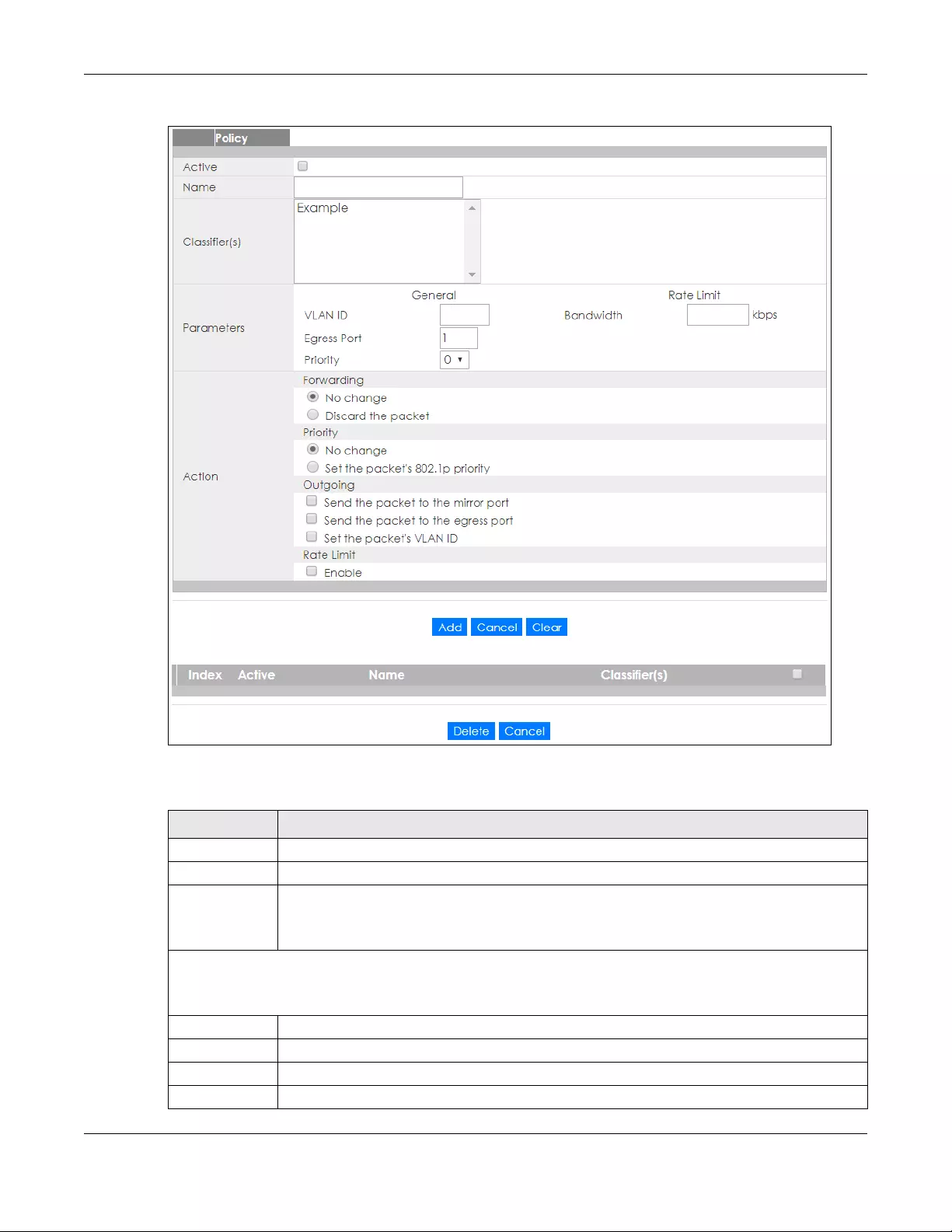
Chapter 22 Policy Rule
GS1920v2 Series User’s Guide
195
Figure 141 Advanced Application > Policy Rule
The following table describes the labels in this screen.
Table 78 Advanced Application > Policy Rule
LABEL DESCRIPTION
Active Select this option to enable the policy.
Name Enter a descriptive name for identification purposes.
Classifier(s) This field displays the active classifier(s) you configure in the Classifier screen.
Select the classifier(s) to which this policy rule applies. To select more than one classifier, press
[SHIFT] and select the choices at the same time.
Parameters
Set the fields below for this policy. You only have to set the field(s) that is related to the action(s) you configure in
the Action field.
General
VLAN ID Specify a VLAN ID number.
Egress Port Type the number of an outgoing port.
Priority Specify a priority level.

Chapter 22 Policy Rule
GS1920v2 Series User’s Guide
196
Rate Limit You can configure the desired bandwidth available to a traffic flow. Traffic that exceeds the
maximum bandwidth allocated (in cases where the network is congested) is dropped.
Bandwidth Specify the bandwidth in kilobit per second (Kbps). Enter a number between 64 and 1000000.
Action
Specify the action(s) the Switch takes on the associated classified traffic flow.
Note: You can specify only one action (pair) in a policy rule. To have the Switch take multiple actions
on the same traffic flow, you need to define multiple classifiers with the same criteria and apply
different policy rules.
Say you have several classifiers that identify the same traffic flow and you specify a different policy rule for each. If
their policy actions conflict (Discard the packet, Send the packet to the egress port and Rate Limit), the Switch only
applies the policy rules with the Discard the packet and Send the packet to the egress port actions depending on
the classifier names. The longer the classifier name, the higher the classifier priority. If two classifier names are the
same length, the bigger the character, the higher the classifier priority. The lowercase letters (such as a and b)
have higher priority than the capitals (such as A and B) in the classifier name. For example, the classifier with the
name of class 2, class a or class B takes priority over the classifier with the name of class 1 or class A.
Let’s say you set two classifiers (Class 1 and Class 2) and both identify all traffic from MAC address 11:22:33:44:55:66
on port 3.
If Policy 1 applies to Class 1 and the action is to drop the packets, Policy 2 applies to Class 2 and the action is to
forward the packets to the egress port, the Switch will forward the packets.
If Policy 1 applies to Class 1 and the action is to drop the packets, Policy 2 applies to Class 2 and the action is to
enable bandwidth limitation, the Switch will discard the packets immediately.
If Policy 1 applies to Class 1 and the action is to forward the packets to the egress port, Policy 2 applies to Class 2
and the action is to enable bandwidth limitation, the Switch will forward the packets.
Forwarding Select No change to forward the packets.
Select Discard the packet to drop the packets.
Priority Select No change to keep the priority setting of the frames.
Select Set the packet’s 802.1 priority to replace the packet’s 802.1 priority field with the value you
set in the Priority field.
Outgoing Select Send the packet to the mirror port to send the packet to the mirror port.
Select Send the packet to the egress port to send the packet to the egress port.
Select Set the packet's VLAN ID to replace the VLAN ID of the packets with the value you
configure in the VLAN ID field.
Rate Limit Select Enable to activate bandwidth limitation on the traffic flow(s).
Add Click Add to inset the entry to the summary table below and save your changes to the Switch’s
run-time memory. The Switch loses these changes if it is turned off or loses power, so use the Save
link on the top navigation panel to save your changes to the non-volatile memory when you are
done configuring.
Cancel Click Cancel to reset the fields back to your previous configuration.
Clear Click Clear to set the above fields back to the factory defaults.
Index This field displays the policy index number. Click an index number to edit the policy.
Active This field displays Yes when policy is activated and No when is it deactivated.
Name This field displays the name you have assigned to this policy.
Classifier(s) This field displays the name(s) of the classifier to which this policy applies.
Select an entry’s check box to select a specific entry. Otherwise, select the check box in the
table heading row to select all entries.
Table 78 Advanced Application > Policy Rule (continued)
LABEL DESCRIPTION

GS1920v2 Series User’s Guide
197
22.3 Policy Example
The figure below shows an example Policy screen where you configure a policy to limit bandwidth on a
traffic flow classified using the Example classifier (refer to Section 21.5 on page 192).
Figure 142 Policy Example
Delete Click Delete to remove the selected entry from the summary table.
Cancel Click Cancel to clear the check boxes.
Table 78 Advanced Application > Policy Rule (continued)
LABEL DESCRIPTION

Chapter 23 Queuing Method
GS1920v2 Series User’s Guide
198
CHAPTER 23
Queuing Method
23.1 Queuing Method Overview
This chapter introduces the queuing methods supported.
Queuing is used to help solve performance degradation when there is network congestion. Use the
Queuing Method screen to configure queuing algorithms for outgoing traffic. See also Priority Queue
Assignment in Switch Setup and 802.1p Priority in Port Setup for related information.
23.1.1 What You Can Do
Use the Queueing Method screen (Section 23.2 on page 199) set priorities for the queues of the Switch.
This distributes bandwidth across the different traffic queues.
23.1.2 What You Need to Know
Queuing algorithms allow switches to maintain separate queues for packets from each individual
source or flow and prevent a source from monopolizing the bandwidth.
Strictly Priority Queuing
Strictly Priority Queuing (SPQ) services queues based on priority only. As traffic comes into the Switch,
traffic on the highest priority queue, Q7 is transmitted first. When that queue empties, traffic on the next
highest-priority queue, Q6 is transmitted until Q6 empties, and then traffic is transmitted on Q5 and so on.
If higher priority queues never empty, then traffic on lower priority queues never gets sent. SPQ does not
automatically adapt to changing network requirements.
Weighted Fair Queuing
Weighted Fair Queuing is used to guarantee each queue's minimum bandwidth based on its bandwidth
weight (portion) (the number you configure in the Weight field) when there is traffic congestion. WFQ is
activated only when a port has more traffic than it can handle. Queues with larger weights get more
guaranteed bandwidth than queues with smaller weights. This queuing mechanism is highly efficient in
that it divides any available bandwidth across the different traffic queues. By default, the weight for Q0
is 1, for Q1 is 2, for Q2 is 3, and so on.
Weighted Round Robin Scheduling (WRR)
Round Robin Scheduling services queues on a rotating basis and is activated only when a port has more
traffic than it can handle. A queue is a given an amount of bandwidth irrespective of the incoming
traffic on that port. This queue then moves to the back of the list. The next queue is given an equal

Chapter 23 Queuing Method
GS1920v2 Series User’s Guide
199
amount of bandwidth, and then moves to the end of the list; and so on, depending on the number of
queues being used. This works in a looping fashion until a queue is empty.
Weighted Round Robin Scheduling (WRR) uses the same algorithm as round robin scheduling, but
services queues based on their priority and queue weight (the number you configure in the queue
Weight field) rather than a fixed amount of bandwidth. WRR is activated only when a port has more
traffic than it can handle. Queues with larger weights get more service than queues with smaller
weights. This queuing mechanism is highly efficient in that it divides any available bandwidth across the
different traffic queues and returns to queues that have not yet emptied.
23.2 Configuring Queuing
Use this screen to set priorities for the queues of the Switch. This distributes bandwidth across the different
traffic queues.
Click Advanced Application > Queuing Method in the navigation panel.
Figure 143 Advanced Application > Queuing Method

GS1920v2 Series User’s Guide
200
The following table describes the labels in this screen.
Table 79 Advanced Application > Queuing Method
LABEL DESCRIPTION
Port This label shows the port you are configuring.
* Settings in this row apply to all ports.
Use this row only if you want to make some settings the same for all ports. Use this row first to set the
common settings and then make adjustments on a port-by-port basis.
Note: Changes in this row are copied to all the ports as soon as you make them.
Method Select SPQ (Strictly Priority Queuing), WFQ (Weighted Fair Queuing) or WRR (Weighted Round Robin).
Strictly Priority Queuing services queues based on priority only. When the highest priority queue
empties, traffic on the next highest-priority queue begins. Q7 has the highest priority and Q0 the
lowest.
Weighted Fair Queuing is used to guarantee each queue's minimum bandwidth based on their
bandwidth portion (weight) (the number you configure in the Weight field). Queues with larger
weights get more guaranteed bandwidth than queues with smaller weights.
Weighted Round Robin Scheduling services queues on a rotating basis based on their queue weight
(the number you configure in the queue Weight field). Queues with larger weights get more service
than queues with smaller weights.
Weight When you select WFQ or WRR enter the queue weight here. Bandwidth is divided across the different
traffic queues according to their weights.
Hybrid-
SPQ
Lowest-
Queue
This field is applicable only when you select WFQ or WRR.
Select a queue (Q0 to Q7) to have the Switch use SPQ to service the subsequent queue(s) after and
including the specified queue for the port. For example, if you select Q5, the Switch services traffic on
Q5, Q6 and Q7 using SPQ.
Select None to always use WFQ or WRR for the port.
Apply Click Apply to save your changes to the Switch’s run-time memory. The Switch loses these changes if
it is turned off or loses power, so use the Save link on the top navigation panel to save your changes to
the non-volatile memory when you are done configuring.
Cancel Click Cancel to begin configuring this screen afresh.

Chapter 24 Multicast
GS1920v2 Series User’s Guide
201
CHAPTER 24
Multicast
24.1 Multicast Overview
This chapter shows you how to configure various multicast features.
Traditionally, IP packets are transmitted in one of either two ways - Unicast (1 sender to 1 recipient) or
Broadcast (1 sender to everybody on the network). Multicast delivers IP packets to just a group of hosts
on the network.
IGMP (Internet Group Management Protocol) is a network-layer protocol used to establish membership
in a multicast group - it is not used to carry user data. Refer to RFC 1112, RFC 2236 and RFC 3376 for
information on IGMP versions 1, 2 and 3 respectively.
24.1.1 What You Can Do
• Use the Multicast Setup screen (Section 24.2 on page 205) to display the links to the configuration
screens where you can configure IPv4 or IPv6 multicast settings.
• Use the IPv4 Multicast Status screen (Section 24.3 on page 205) to view multicast group information.
• Use the IGMP Snooping screen (Section 24.3.1 on page 206) to enable IGMP snooping to forward
group multicast traffic only to ports that are members of that group.
• Use the IPv6 Multicast Status screen (Section 24.4 on page 211) to view multicast group information,
• Use the MLD Snooping-proxy screen (Section 24.4.1 on page 211) to enable the upstream port to
report group changes to a connected multicast router and forward MLD messages to other upstream
ports.
• Use the MVR screens (Section 24.5 on page 218) to create multicast VLANs and select the receiver
port(s) and a source port for each multicast VLAN.
24.1.2 What You Need to Know
Read on for concepts on Multicasting that can help you configure the screens in this chapter.
IP Multicast Addresses
In IPv4, a multicast address allows a device to send packets to a specific group of hosts (multicast
group) in a different subnetwork. A multicast IP address represents a traffic receiving group, not
individual receiving devices. IP addresses in the Class D range (224.0.0.0 to 239.255.255.255) are used for
IP multicasting. Certain IP multicast numbers are reserved by IANA for special purposes (see the IANA
website for more information).

Chapter 24 Multicast
GS1920v2 Series User’s Guide
202
IGMP Snooping
A Switch can passively snoop on IGMP packets transferred between IP multicast routers/switches and IP
multicast hosts to learn the IP multicast group membership. It checks IGMP packets passing through it,
picks out the group registration information, and configures multicasting accordingly. IGMP snooping
allows the Switch to learn multicast groups without you having to manually configure them.
The Switch forwards multicast traffic destined for multicast groups (that it has learned from IGMP
snooping or that you have manually configured) to ports that are members of that group. IGMP
snooping generates no additional network traffic, allowing you to significantly reduce multicast traffic
passing through your Switch.
IGMP Snooping and VLANs
The Switch can perform IGMP snooping on up to 16 VLANs. You can configure the Switch to
automatically learn multicast group membership of any VLANs. The Switch then performs IGMP
snooping on the first 16 VLANs that send IGMP packets. This is referred to as auto mode. Alternatively,
you can specify the VLANs that IGMP snooping should be performed on. This is referred to as fixed
mode. In fixed mode the Switch does not learn multicast group membership of any VLANs other than
those explicitly added as an IGMP snooping VLAN.
MLD Snooping-proxy
MLD snooping-proxy is a Zyxel-proprietary feature. IPv6 MLD proxy allows only one upstream interface on
a switch, while MLD snooping-proxy supports more than one upstream port on a switch. The upstream
port in MLD snooping-proxy can report group changes to a connected multicast router and forward
MLD messages to other upstream ports. This helps especially when you want to have a network that uses
STP to provide backup links between switches and also performs MLD snooping and proxy functions.
MLD snooping-proxy, like MLD proxy, can minimize MLD control messages and allow better network
performance.
In MLD snooping-proxy, if one upstream port is learned via snooping, all other upstream ports on the
same device will be added to the same group. If one upstream port requests to leave a group, all other
upstream ports on the same device will also be removed from the group.
In the following MLD snooping-proxy example, all connected upstream ports (1 ~7) are treated as one
interface. The connection between ports 8 and 9 is blocked by STP to break the loop. If there is one
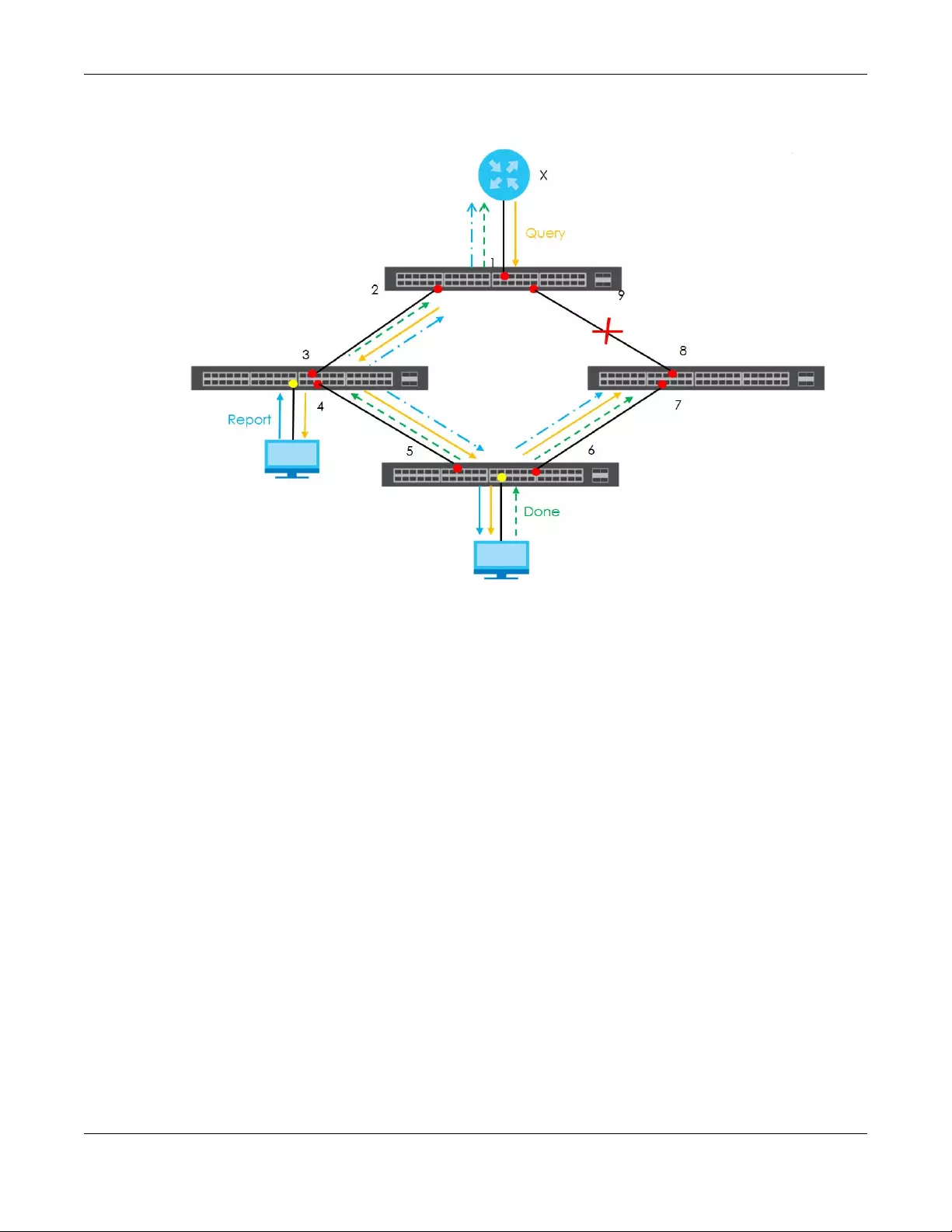
Chapter 24 Multicast
GS1920v2 Series User’s Guide
203
query from a router (X) or MLD Done or Report message from any upstream port, it will be broadcast to
all connected upstream ports.
MLD Messages
A multicast router or switch periodically sends general queries to MLD hosts to update the multicast
forwarding table. When an MLD host wants to join a multicast group, it sends an MLD Report message
for that address.
An MLD Done message is similar to an IGMP Leave message. When an MLD host wants to leave a
multicast group, it can send a Done message to the router or switch. If the leave mode is not set to
Immediate, the router or switch sends a group-specific query to the port on which the Done message is
received to determine if other devices connected to this port should remain in the group.
MVR Overview
Multicast VLAN Registration (MVR) is designed for applications (such as Media-on-Demand (MoD)) that
use multicast traffic across an Ethernet ring-based service provider network.
MVR allows one single multicast VLAN to be shared among different subscriber VLANs on the network.
While isolated in different subscriber VLANs, connected devices can subscribe to and unsubscribe from
the multicast stream in the multicast VLAN. This improves bandwidth utilization with reduced multicast
traffic in the subscriber VLANs and simplifies multicast group management.
MVR only responds to IGMP join and leave control messages from multicast groups that are configured
under MVR. Join and leave reports from other multicast groups are managed by IGMP snooping.
The following figure shows a network example. The subscriber VLAN (1, 2 and 3) information is hidden
from the streaming media server, S. In addition, the multicast VLAN information is only visible to the
Switch and S.

Chapter 24 Multicast
GS1920v2 Series User’s Guide
204
Figure 144 MVR Network Example
Types of MVR Ports
In MVR, a source port is a port on the Switch that can send and receive multicast traffic in a multicast
VLAN while a receiver port can only receive multicast traffic. Once configured, the Switch maintains a
forwarding table that matches the multicast stream to the associated multicast group.
MVR Modes
You can set your Switch to operate in either dynamic or compatible mode.
In dynamic mode, the Switch sends IGMP leave and join reports to the other multicast devices (such as
multicast routers or servers) in the multicast VLAN. This allows the multicast devices to update the
multicast forwarding table to forward or not forward multicast traffic to the receiver ports.
In compatible mode, the Switch does not send any IGMP reports. In this case, you must manually
configure the forwarding settings on the multicast devices in the multicast VLAN.
How MVR Works
The following figure shows a multicast television example where a subscriber device (such as a
computer) in VLAN 1 receives multicast traffic from the streaming media server, S, via the Switch.
Multiple subscriber devices can connect through a port configured as the receiver on the Switch.
When the subscriber selects a television channel, computer A sends an IGMP report to the Switch to join
the appropriate multicast group. If the IGMP report matches one of the configured MVR multicast group
addresses on the Switch, an entry is created in the forwarding table on the Switch. This maps the
subscriber VLAN to the list of forwarding destinations for the specified multicast traffic.
When the subscriber changes the channel or turns off the computer, an IGMP leave message is sent to
the Switch to leave the multicast group. The Switch sends a query to VLAN 1 on the receiver port (in this
case, an uplink port on the Switch). If there is another subscriber device connected to this port in the
same subscriber VLAN, the receiving port will still be on the list of forwarding destination for the multicast
traffic. Otherwise, the Switch removes the receiver port from the forwarding table.

Chapter 24 Multicast
GS1920v2 Series User’s Guide
205
Figure 145 MVR Multicast Television Example
24.2 Multicast Setup
Use this screen to configure IGMP for IPv4 or MLD for IPv6 and set up multicast VLANs. Click Advanced
Application > Multicast in the navigation panel.
Figure 146 Advanced Application > Multicast Setup
The following table describes the labels in this screen.
24.3 IPv4 Multicast Status
Click Advanced Application > Multicast > IPv4 Multicast to display the screen as shown. This screen
shows the IPv4 multicast group information. See Section 24.1 on page 201 for more information on
multicasting.
Figure 147 Advanced Application > Multicast > IPv4 Multicast
Table 80 Advanced Application > Multicast Setup
LABEL DESCRIPTION
IPv4 Multicast Click the link to open screens where you can configure IGMP snooping and IGMP filtering for
IPv4.
IPv6 Multicast Click the link to open screens where you can configure MLD snooping-proxy and MLD filtering
for IPv6.
MVR Click the link to open screens where you can create multicast VLANs.
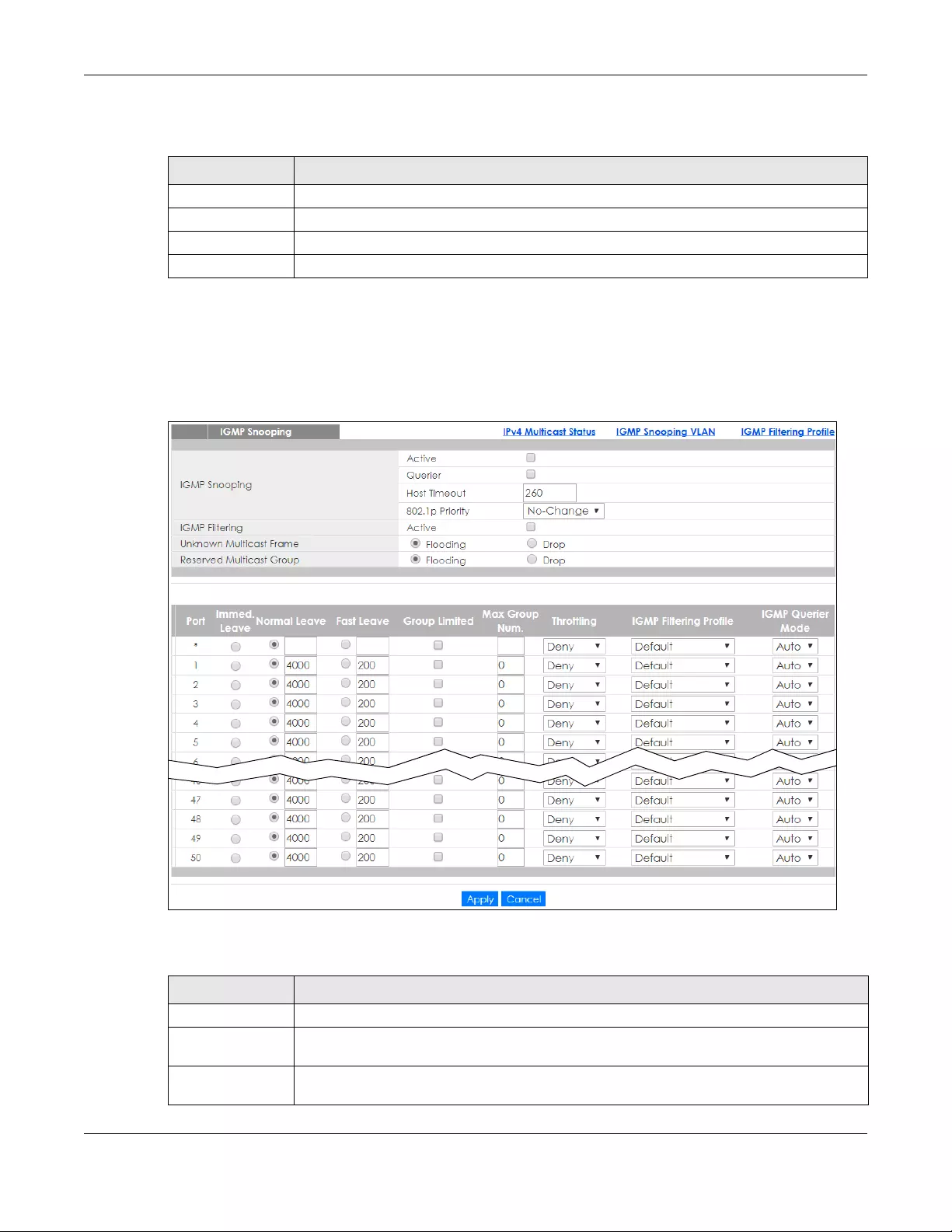
Chapter 24 Multicast
GS1920v2 Series User’s Guide
206
The following table describes the labels in this screen.
24.3.1 IGMP Snooping
Click the IGMP Snooping link in the Advanced Application > Multicast > IPv4 Multicast screen to display
the screen as shown. See Section 24.1 on page 201 for more information on multicasting.
Figure 148 Advanced Application > Multicast > IPv4 Multicast > IGMP Snooping
The following table describes the labels in this screen.
Table 81 Advanced Application > Multicast > IPv4 Multicast
LABEL DESCRIPTION
Index This is the index number of the entry.
VID This field displays the multicast VLAN ID.
Port This field displays the port number that belongs to the multicast group.
Multicast Group This field displays IP multicast group addresses.
Table 82 Advanced Application > Multicast > IPv4 Multicast > IGMP Snooping
LABEL DESCRIPTION
IGMP Snooping Use these settings to configure IGMP snooping.
Active Select Active to enable IGMP Snooping to forward group multicast traffic only to ports that
are members of that group.
Querier Select this option to allow the Switch to send IGMP General Query messages to the VLANs with
the multicast hosts attached.

Chapter 24 Multicast
GS1920v2 Series User’s Guide
207
Host Timeout Specify the time (from 1 to 16 711 450) in seconds that elapses before the Switch removes an
IGMP group membership entry if it does not receive report messages from the port.
802.1p Priority Select a priority level (0-7) to which the Switch changes the priority in outgoing IGMP control
packets. Otherwise, select No-Change to not replace the priority.
IGMP Filtering Select Active to enable IGMP filtering to control which IGMP groups a subscriber on a port
can join.
If you enable IGMP filtering, you must create and assign IGMP filtering profiles for the ports that
you want to allow to join multicast groups.
Unknown Multicast
Frame
Specify the action to perform when the Switch receives an unknown multicast frame. Select
Drop to discard the frame(s). Select Flooding to send the frame(s) to all ports.
Reserved Multicast
Group
The IP address range of 224.0.0.0 to 224.0.0.255 are reserved for multicasting on the local
network only. For example, 224.0.0.1 is for all hosts on a local network segment and 224.0.0.9 is
used to send RIP routing information to all RIP v2 routers on the same network segment. A
multicast router will not forward a packet with the destination IP address within this range to
other networks. See the IANA web site for more information.
The layer-2 multicast MAC addresses used by Cisco layer-2 protocols, 01:00:0C:CC:CC:CC
and 01:00:0C:CC:CC:CD, are also included in this group.
Specify the action to perform when the Switch receives a frame with a reserved multicast
address. Select Drop to discard the frame(s). Select Flooding to send the frame(s) to all ports.
Port This field displays the port number.
* Settings in this row apply to all ports.
Use this row only if you want to make some settings the same for all ports. Use this row first to set
the common settings and then make adjustments on a port-by-port basis.
Changes in this row are copied to all the ports as soon as you make them.
Immed. Leave Select this option to set the Switch to remove this port from the multicast tree when an IGMP
version 2 leave message is received on this port.
Select this option if there is only one host connected to this port.
Normal Leave Enter an IGMP normal leave timeout value (from 200 to 6,348,800) in miliseconds. Select this
option to have the Switch use this timeout to update the forwarding table for the port.
In normal leave mode, when the Switch receives an IGMP leave message from a host on a
port, it forwards the message to the multicast router. The multicast router then sends out an
IGMP Group-Specific Query (GSQ) message to determine whether other hosts connected to
the port should remain in the specific multicast group. The Switch forwards the query message
to all hosts connected to the port and waits for IGMP reports from hosts to update the
forwarding table.
This defines how many seconds the Switch waits for an IGMP report before removing an IGMP
snooping membership entry when an IGMP leave message is received on this port from a
host.
Fast Leave Enter an IGMP fast leave timeout value (from 200 to 6,348,800) in miliseconds. Select this
option to have the Switch use this timeout to update the forwarding table for the port.
In fast leave mode, right after receiving an IGMP leave message from a host on a port, the
Switch itself sends out an IGMP Group-Specific Query (GSQ) message to determine whether
other hosts connected to the port should remain in the specific multicast group. This helps
speed up the leave process.
This defines how many seconds the Switch waits for an IGMP report before removing an IGMP
snooping membership entry when an IGMP leave message is received on this port from a
host.
Group Limited Select this option to limit the number of multicast groups this port is allowed to join.
Table 82 Advanced Application > Multicast > IPv4 Multicast > IGMP Snooping (continued) (continued)
LABEL DESCRIPTION

Chapter 24 Multicast
GS1920v2 Series User’s Guide
208
24.3.2 IGMP Snooping VLAN
Click Advanced Application > Multicast > IPv4 Multicast in the navigation panel. Click the IGMP
Snooping link and then the IGMP Snooping VLAN link to display the screen as shown. See IGMP Snooping
and VLANs on page 202 for more information on IGMP Snooping VLAN.
Max Group Num. Enter the number of multicast groups this port is allowed to join. Once a port is registered in the
specified number of multicast groups, any new IGMP join report frame(s) is dropped on this
port.
Throttling IGMP throttling controls how the Switch deals with the IGMP reports when the maximum
number of the IGMP groups a port can join is reached.
Select Deny to drop any new IGMP join report received on this port until an existing multicast
forwarding table entry is aged out.
Select Replace to replace an existing entry in the multicast forwarding table with the new
IGMP report(s) received on this port.
IGMP Filtering
Profile
Select the name of the IGMP filtering profile to use for this port. Otherwise, select Default to
prohibit the port from joining any multicast group.
You can create IGMP filtering profiles in the Multicast > IPv4 Multicast > IGMP Snooping > IGMP
Filtering Profile screen.
IGMP Querier
Mode
The Switch treats an IGMP query port as being connected to an IGMP multicast router (or
server). The Switch forwards IGMP join or leave packets to an IGMP query port.
Select Auto to have the Switch use the port as an IGMP query port if the port receives IGMP
query packets.
Select Fixed to have the Switch always use the port as an IGMP query port. Select this when
you connect an IGMP multicast server to the port.
Select Edge to stop the Switch from using the port as an IGMP query port. The Switch will not
keep any record of an IGMP router being connected to this port. The Switch does not forward
IGMP join or leave packets to this port.
Apply Click Apply to save your changes to the Switch’s run-time memory. The Switch loses these
changes if it is turned off or loses power, so use the Save link on the top navigation panel to
save your changes to the non-volatile memory when you are done configuring.
Cancel Click Cancel to begin configuring this screen afresh.
Table 82 Advanced Application > Multicast > IPv4 Multicast > IGMP Snooping (continued) (continued)
LABEL DESCRIPTION
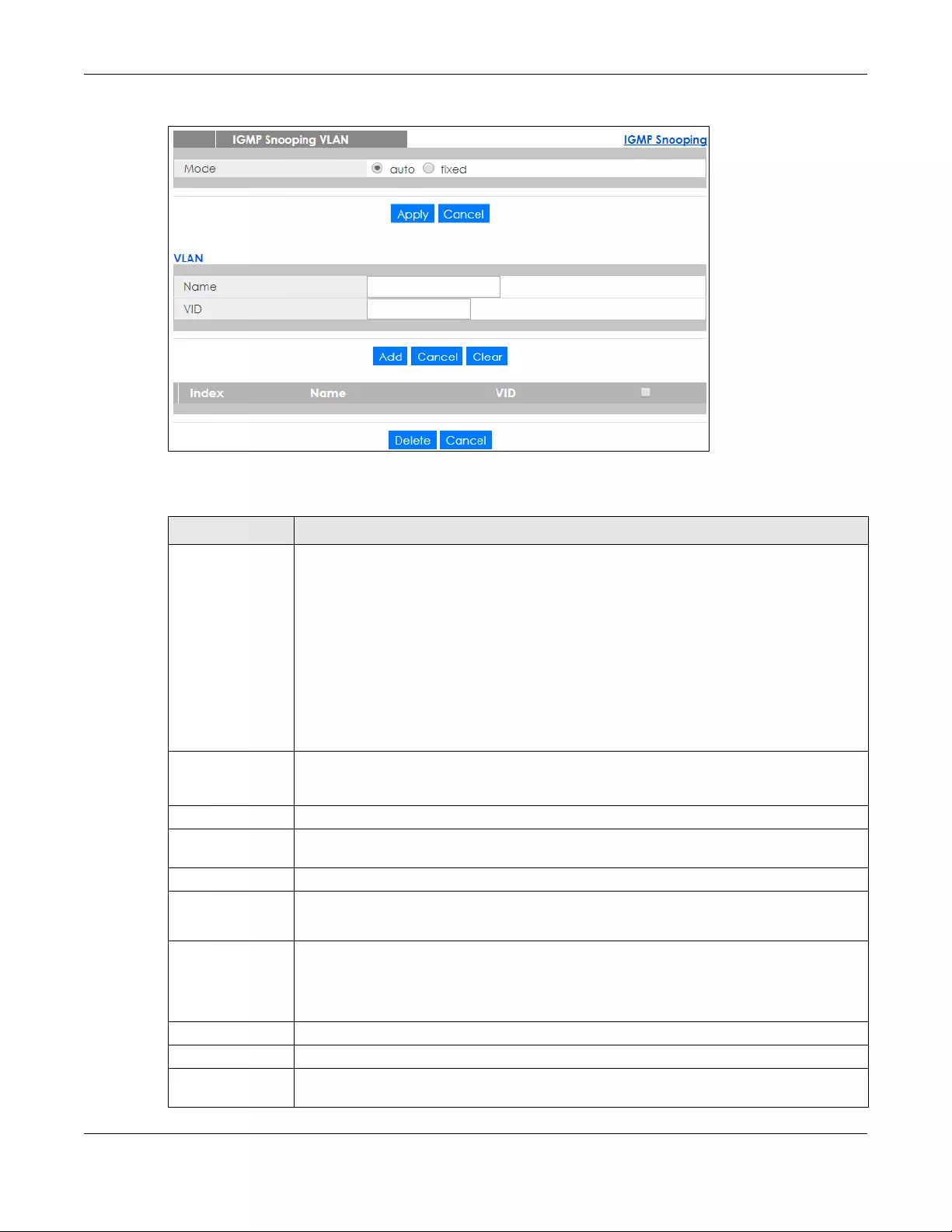
Chapter 24 Multicast
GS1920v2 Series User’s Guide
209
Figure 149 Advanced Application > Multicast > IPv4 Multicast > IGMP Snooping > IGMP Snooping VLAN
The following table describes the labels in this screen.
Table 83 Advanced Application > Multicast > IPv4 Multicast > IGMP Snooping > IGMP Snooping VLAN
LABEL DESCRIPTION
Mode Select auto to have the Switch learn multicast group membership information of any VLANs
automatically.
Select fixed to have the Switch only learn multicast group membership information of the
VLAN(s) that you specify below.
In either auto or fixed mode, the Switch can learn up to 16 VLANs (including up to five VLANs
you configured in the MVR screen). For example, if you have configured one multicast VLAN
in the MVR screen, you can only specify up to 15 VLANs in this screen.
The Switch drops any IGMP control messages which do not belong to these 16 VLANs.
You must also enable IGMP snooping in the Multicast > IPv4 Multicast > IGMP Snooping screen
first.
Apply Click Apply to save your changes to the Switch’s run-time memory. The Switch loses these
changes if it is turned off or loses power, so use the Save link on the top navigation panel to
save your changes to the non-volatile memory when you are done configuring.
Cancel Click Cancel to begin configuring this screen afresh.
VLAN Use this section of the screen to add VLANs upon which the Switch is to perform IGMP
snooping.
Name Enter the descriptive name of the VLAN for identification purposes.
VID Enter the ID of a static VLAN; the valid range is between 1 and 4094.
You cannot configure the same VLAN ID as in the MVR screen.
Add Click this to create a new entry or to update an existing one.
This saves your changes to the Switch’s run-time memory. The Switch loses these changes if it is
turned off or loses power, so use the Save link on the top navigation panel to save your
changes to the non-volatile memory when you are done configuring.
Cancel Click Cancel to reset the fields to your previous configuration.
Clear Click Clear to reset the fields to the factory defaults.
Index This is the index number of the IGMP snooping VLAN entry in the table. Click on an index
number to view more details or change the settings.
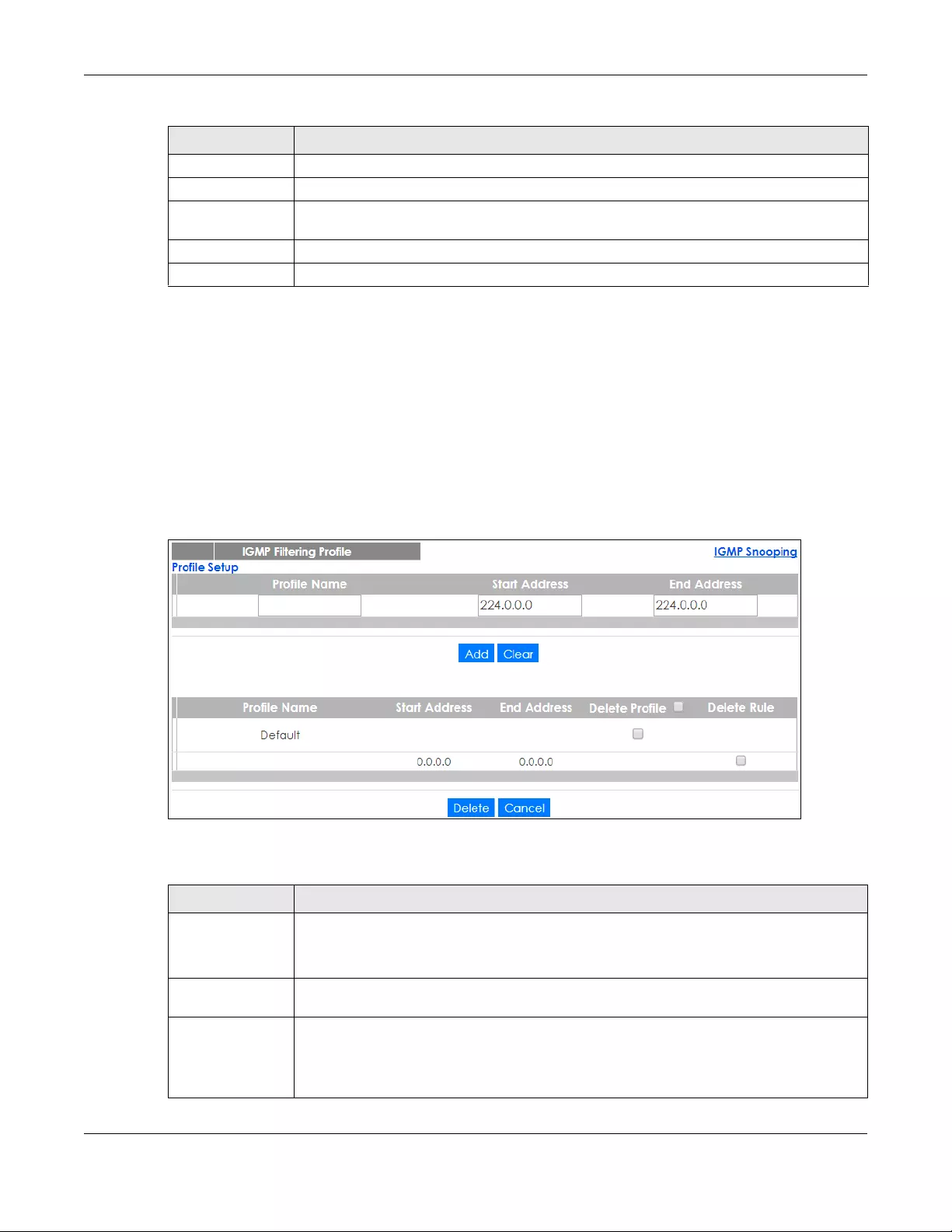
Chapter 24 Multicast
GS1920v2 Series User’s Guide
210
24.3.3 IGMP Filtering Profile
An IGMP filtering profile specifies a range of multicast groups that clients connected to the Switch are
able to join. A profile contains a range of multicast IP addresses which you want clients to be able to
join. Profiles are assigned to ports (in the IGMP Snooping screen). Clients connected to those ports are
then able to join the multicast groups specified in the profile. Each port can be assigned a single profile.
A profile can be assigned to multiple ports.
Click Advanced Application > Multicast > IPv4 Multicast in the navigation panel. Click the IGMP
Snooping link and then the IGMP Filtering Profile link to display the screen as shown.
Figure 150 Advanced Application > Multicast > IPv4 Multicast > IGMP Snooping > IGMP Filtering Profile
The following table describes the labels in this screen.
Name This field displays the descriptive name for this VLAN group.
VID This field displays the ID number of the VLAN group.
Select an entry’s check box to select a specific entry. Otherwise, select the check box in the
table heading row to select all entries.
Delete Check the entry(ies) that you want to remove, then click the Delete button.
Cancel Click Cancel to clear the check boxes.
Table 83 Advanced Application > Multicast > IPv4 Multicast > IGMP Snooping > IGMP Snooping VLAN
LABEL DESCRIPTION
Table 84 Advanced Application > Multicast > IPv4 Multicast > IGMP Snooping > IGMP Filtering Profile
LABEL DESCRIPTION
Profile Name Enter a descriptive name for the profile for identification purposes.
To configure additional rule(s) for a profile that you have already added, enter the profile
name and specify a different IP multicast address range.
Start Address Type the starting multicast IP address for a range of multicast IP addresses that you want to
belong to the IGMP filter profile.
End Address Type the ending multicast IP address for a range of IP addresses that you want to belong to
the IGMP filter profile.
If you want to add a single multicast IP address, enter it in both the Start Address and End
Address fields.

Chapter 24 Multicast
GS1920v2 Series User’s Guide
211
24.4 IPv6 Multicast Status
Click Advanced Application > Multicast > IPv6 Multicast to display the screen as shown. This screen
shows the IPv6 multicast group information. See Section 24.1 on page 201 for more information on
multicasting.
Figure 151 Advanced Application > Multicast > IPv6 Multicast
The following table describes the fields in the above screen.
24.4.1 MLD Snooping-proxy
Click the MLD Snooping-proxy link in the Advanced Application > Multicast > IPv6 Multicast screen to
display the screen as shown. See Section 24.1 on page 201 for more information on multicasting.
Add Click this to create a new entry.
This saves your changes to the Switch’s run-time memory. The Switch loses these changes if it is
turned off or loses power, so use the Save link on the top navigation panel to save your
changes to the non-volatile memory when you are done configuring.
Clear Click Clear to reset the fields to the factory defaults.
Profile Name This field displays the descriptive name of the profile.
Start Address This field displays the start of the multicast address range.
End Address This field displays the end of the multicast address range.
Delete Profile Select a profile’s check box to select a specific profile. Otherwise, select the check box in the
table heading row to select all profiles.
Delete Rule Select the check box(es) of the rule(s) that you want to remove from a profile.
Delete To delete the profile(s) and all the accompanying rules, select the profile(s) that you want to
remove in the Delete Profile column, then click the Delete button.
To delete a rule(s) from a profile, select the rule(s) that you want to remove in the Delete Rule
column, then click the Delete button.
Cancel Click Cancel to clear the Delete Profile/Delete Rule check boxes.
Table 84 Advanced Application > Multicast > IPv4 Multicast > IGMP Snooping > IGMP Filtering Profile
LABEL DESCRIPTION
Table 85 Advanced Application > Multicast > IPv6 Multicast
LABEL DESCRIPTION
Index This is the index number of the entry.
VID This field displays the multicast VLAN ID.
Port This field displays the port number that belongs to the multicast group.
Multicast Group This field displays IP multicast group addresses.
Group Timeout This field displays the time (in seconds) that elapses before the Switch removes a MLD group
membership entry if it does not receive report messages from the port.

Chapter 24 Multicast
GS1920v2 Series User’s Guide
212
Figure 152 Advanced Application > Multicast > IPv6Multicast > MLD Snooping-proxy
The following table describes the fields in the above screen.
24.4.2 MLD Snooping-proxy VLAN
Click the VLAN link in the Advanced Application > Multicast > IPv6 Multicast > MLD Snooping-proxy
screen to display the screen as shown. See Section 24.1 on page 201 for more information on
multicasting.
Figure 153 Advanced Application > Multicast > IPv6 Multicast > MLD Snooping-proxy > VLAN
Table 86 Advanced Application > Multicast > IPv6 Multicast > MLD Snooping-proxy
LABEL DESCRIPTION
MLD Snooping-proxy Use these settings to configure MLD snooping-proxy.
Active Select Active to enable MLD snooping-proxy on the Switch to minimize MLD control
messages and allow better network performance.
802.1p Priority Select a priority level (0-7) to which the Switch changes the priority in outgoing MLD
messages.
Apply Click Apply to save your changes to the Switch’s run-time memory. The Switch loses these
changes if it is turned off or loses power, so use the Save link on the top navigation panel
to save your changes to the non-volatile memory when you are done configuring.
Cancel Click Cancel to begin configuring this screen afresh.

Chapter 24 Multicast
GS1920v2 Series User’s Guide
213
The following table describes the fields in the above screen.
Table 87 Advanced Application > Multicast > IPv6 Multicast > MLD Snooping-proxy > VLAN
LABEL DESCRIPTION
VID Enter the ID number of the VLAN on which you want to enable MLD snooping-proxy and
configure related settings.
Upstream
Query Interval Enter the amount of time (in miliseconds) between general query messages sent by the
router connected to the upstream port. This value should be exactly the same as what’s
configured in the connected multicast router.
This value is used to calculate the amount of time an MLD snooping membership entry
(learned only on the upstream port) can remain in the forwarding table.
When an MLD Report message is received, the Switch sets the timeout period of the entry
to be T = (QI*RV) + MRD, where T = Timeout, QI = Query Interval, RV = Robustness Variable,
and MRD = Maximum Response Delay.
Maximum Response
Delay
Enter the amount of time (in miliseconds) the router connected to the upstream port waits
for a response to an MLD general query message. This value should be exactly the same
as what’s configured in the connected multicast router.
This value is used to calculate the amount of time an MLD snooping membership entry
(learned only on the upstream port) can remain in the forwarding table.
When an MLD Report message is received, the Switch sets the timeout period of the entry
to be T = (QI*RV) + MRD, where T = Timeout, QI = Query Interval, RV = Robustness Variable,
and MRD = Maximum Response Delay.
When an MLD Done message is received, the Switch sets the entry’s lifetime to be the
product of Last Member Query Interval and Robustness Variable.
Robustness Variable Enter the number of queries. A multicast address entry (learned only on an upstream port
by snooping) is removed from the forwarding table when there is no response to the
configured number of queries sent by the router connected to the upstream port. This
value should be exactly the same as what’s configured in the connected multicast
router.
This value is used to calculate the amount of time an MLD snooping membership entry
(learned only on the upstream port) can remain in the forwarding table.
Last Member Query
Interval
Enter the amount of time (in miliseconds) between the MLD group-specific queries sent by
an upstream port when an MLD Done message is received. This value should be exactly
the same as what’s configured in the connected multicast router.
This value is used to calculate the amount of time an MLD snooping membership entry
(learned only on the upstream port) can remain in the forwarding table after a Done
message is received.
When an MLD Done message is received, the Switch sets the entry’s lifetime to be the
product of Last Member Query Interval and Robustness Variable.
Downstream
Query Interval Enter the amount of time (in miliseconds) between general query messages sent by the
downstream port.
Maximum Response
Delay
Enter the maximum time (in miliseconds) that the Switch waits for a response to a general
query message sent by the downstream port.
Add Click this to create a new entry or to update an existing one.
This saves your changes to the Switch’s run-time memory. The Switch loses these changes
if it is turned off or loses power, so use the Save link on the top navigation panel to save
your changes to the non-volatile memory when you are done configuring.
Cancel Click Cancel to reset the fields to your previous configuration.
Clear Click Clear to reset the fields to the factory defaults.
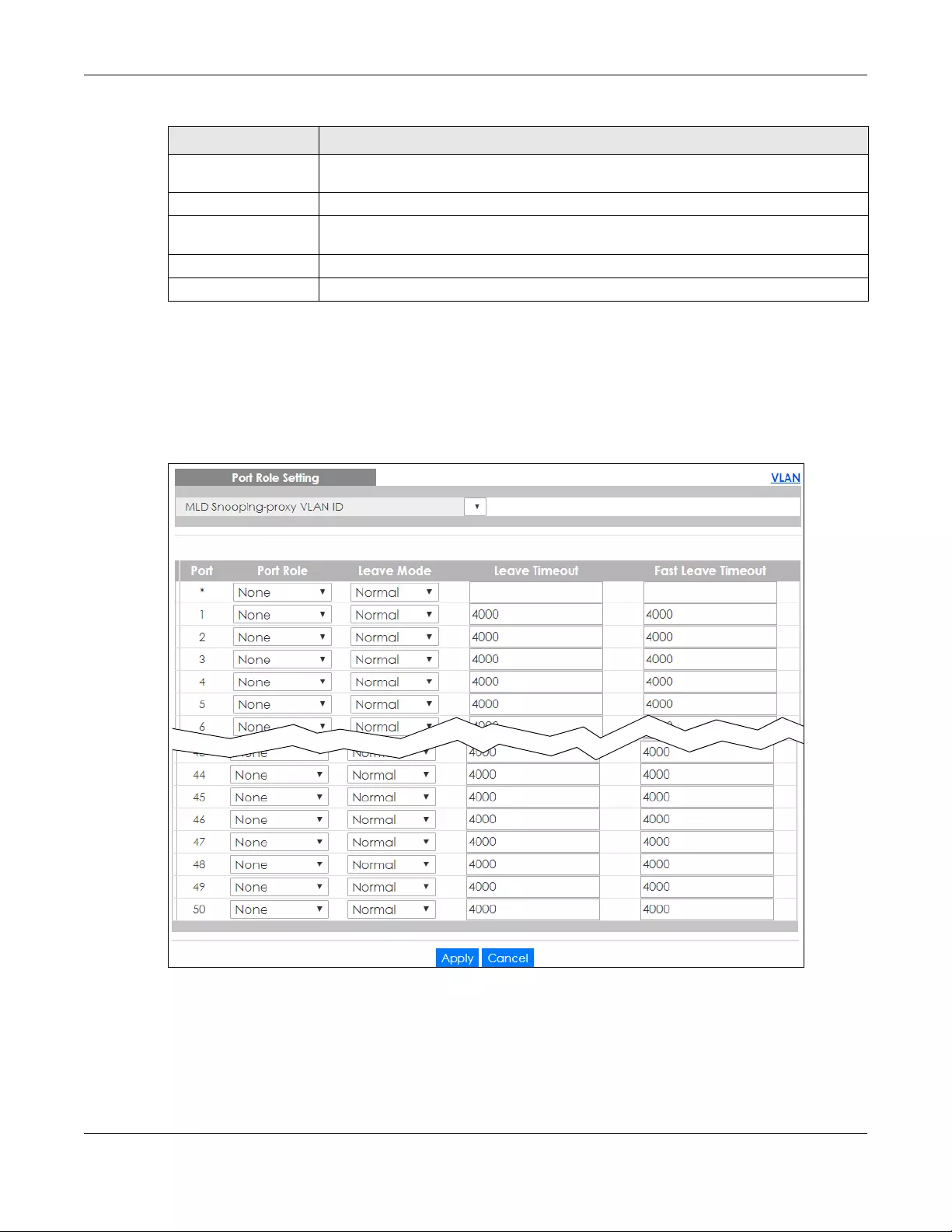
Chapter 24 Multicast
GS1920v2 Series User’s Guide
214
24.4.3 MLD Snooping-proxy VLAN Port Role Setting
Click the Port Role Setting link in the Advanced Application > Multicast > IPv6 Multicast > MLD Snooping-
proxy > VLAN screen to display the screen as shown. See Section 24.1 on page 201 for more information
on multicasting.
Figure 154 Advanced Application > Multicast > IPv6 Multicast > MLD Snooping-proxy > Port Role Setting
Index This is the index number of the MLD snooping-proxy VLAN entry in the table. Click on an
index number to view more details or change the settings.
VID This field displays the ID number of the VLAN group.
Select an entry’s check box to select a specific entry. Otherwise, select the check box in
the table heading row to select all entries.
Delete Click Delete to remove the selected entry(ies) permanently.
Cancel Click Cancel to clear the check boxes.
Table 87 Advanced Application > Multicast > IPv6 Multicast > MLD Snooping-proxy > VLAN
LABEL DESCRIPTION

Chapter 24 Multicast
GS1920v2 Series User’s Guide
215
The following table describes the fields in the above screen.
24.4.4 MLD Snooping-proxy Filtering
Use this screen to configure the Switch’s MLD filtering settings. Click the Filtering link in the Advanced
Application > Multicast > IPv6 Multicast > MLD Snooping-proxy screen to display the screen as shown.
Table 88 Advanced Application > Multicast > IPv6 Multicast > MLD Snooping-proxy > Port Role Setting
LABEL DESCRIPTION
MLD Snooping-proxy
VLAN ID
Select the VLAN ID for which you want to configure a port’s MLD snooping-proxy settings.
Port This field displays the port number.
* Settings in this row apply to all ports.
Use this row only if you want to make some settings the same for all ports. Use this row first
to set the common settings and then make adjustments on a port-by-port basis.
Changes in this row are copied to all the ports as soon as you make them.
Port Role A port on the Switch can be either a Downstream port or Upstream port in MLD. A
downstream port connects to MLD hosts and acts as a multicast router to send MLD
queries and listen to the MLD host’s Report and Done messages. An upstream port
connects to a multicast router and works as a host to send Report or Done messages
when receiving queries from a multicast router.
Otherwise, select None if the port is not joining a multicast group or does not belong to
this VLAN.
Leave Mode Select the leave mode for the specified downstream port(s) in this VLAN.
This specifies whether the Switch removes an MLD snooping membership entry (learned
on a downstream port) immediately (Immediate) or wait for an MLD report before the
leave timeout (Normal) or fast leave timeout (Fast) when an MLD leave message is
received on this port from a host.
Leave Timeout Enter the MLD snooping normal leave timeout (in milliseconds) the Switch uses to update
the forwarding table for the specified downstream port(s).
This defines how many seconds the Switch waits for an MLD report before removing an
MLD snooping membership entry (learned on a downstream port) when an MLD Done
message is received on this port from a host.
Fast Leave Timeout Enter the fast leave timeout (in milliseconds) for the specified downstream port(s).
This defines how many seconds the Switch waits for an MLD report before removing an
MLD snooping membership entry (learned on a downstream port) when an MLD Done
message is received on this port from a host.
Apply Click Apply to save your changes to the Switch’s run-time memory. The Switch loses
these changes if it is turned off or loses power, so use the Save link on the top navigation
panel to save your changes to the non-volatile memory when you are done configuring.
Cancel Click Cancel to reset the fields to your previous configuration.
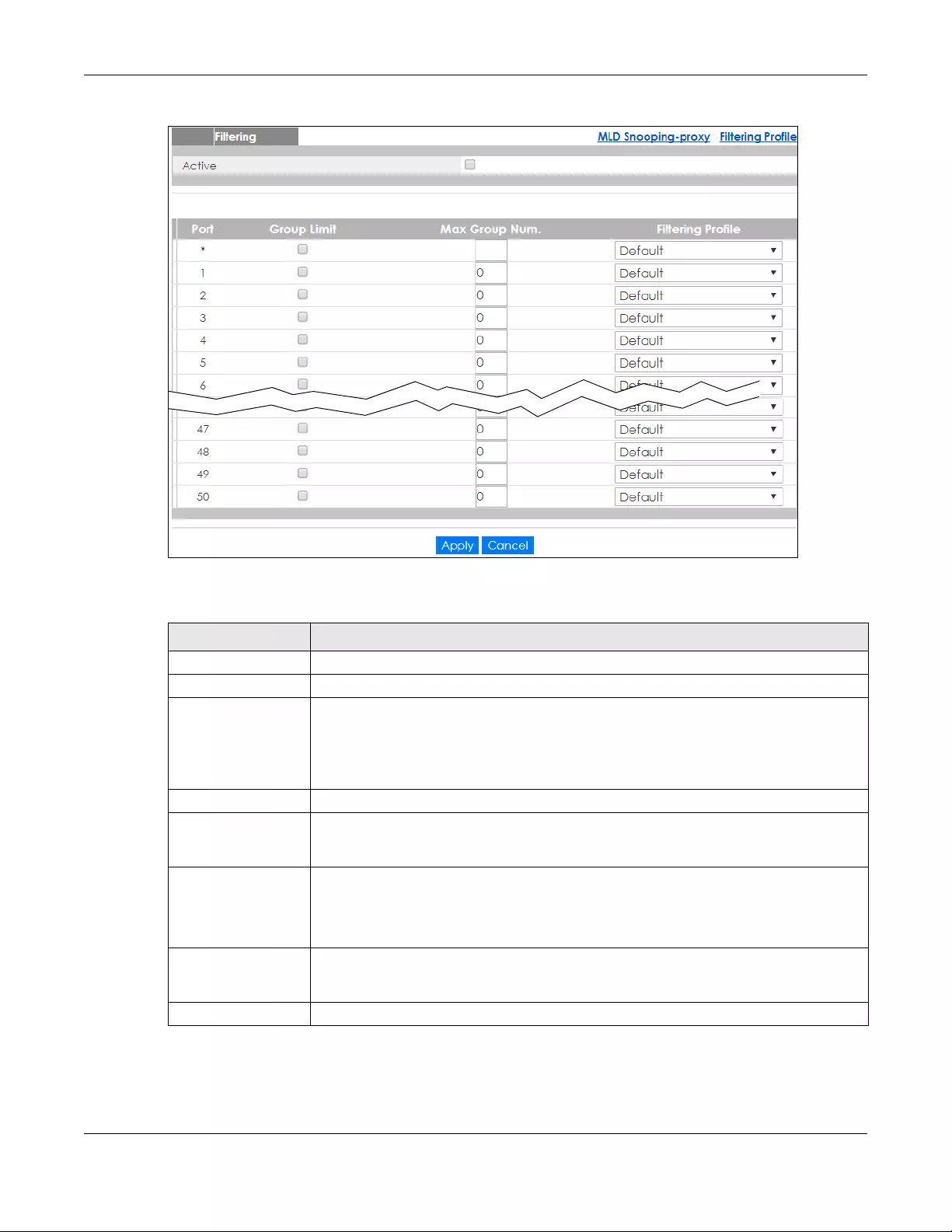
Chapter 24 Multicast
GS1920v2 Series User’s Guide
216
Figure 155 Advanced Application > Multicast > IPv6 Multicast > MLD Snooping-proxy > Filtering
The following table describes the fields in the above screen.
Table 89 Advanced Application > Multicast > IPv6 Multicast > MLD Snooping-proxy > Filtering
LABEL DESCRIPTION
Active Select this option to enable MLD filtering on the Switch.
Port This field displays the port number.
* Settings in this row apply to all ports.
Use this row only if you want to make some settings the same for all ports. Use this row first to
set the common settings and then make adjustments on a port-by-port basis.
Changes in this row are copied to all the ports as soon as you make them.
Group Limit Select this option to limit the number of multicast groups this port is allowed to join.
Max Group Num. Enter the number of multicast groups this port is allowed to join. Once a port is registered in
the specified number of multicast groups, any new MLD Report message is dropped on this
port.
Filtering Profile Select the name of the MLD filtering profile to use for this port. Otherwise, select Default to
prohibit the port from joining any multicast group.
You can create MLD filtering profiles in the Multicast > IPv6 Multicast > MLD Snooping-proxy
> Filtering > Filtering Profile screen.
Apply Click Apply to save your changes to the Switch’s run-time memory. The Switch loses these
changes if it is turned off or loses power, so use the Save link on the top navigation panel to
save your changes to the non-volatile memory when you are done configuring.
Cancel Click Cancel to reset the fields to your previous configuration.
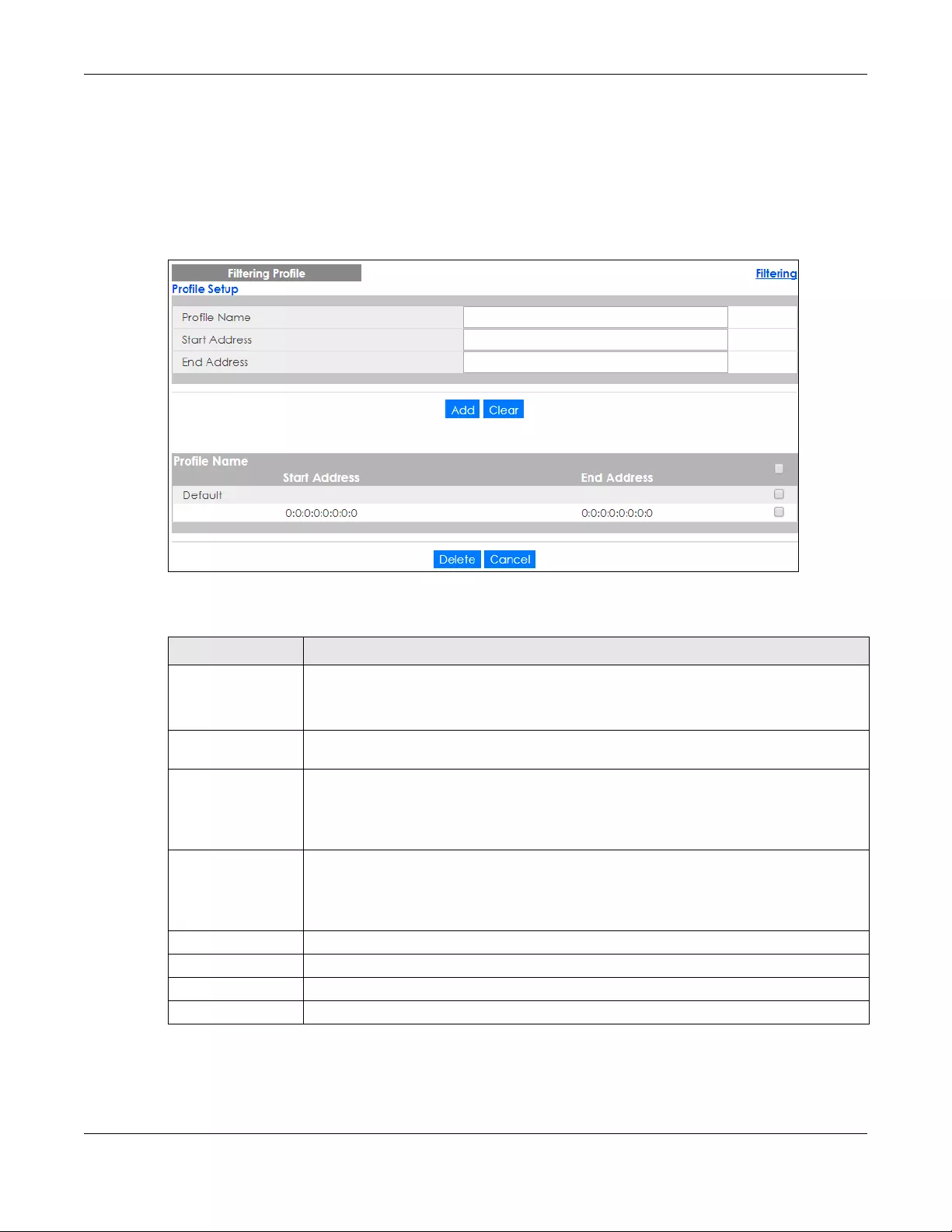
Chapter 24 Multicast
GS1920v2 Series User’s Guide
217
24.4.5 MLD Snooping-proxy Filtering Profile
Use this screen to create an MLD filtering profile and set the range of the multicast address(es). Click the
Filtering Profile link in the Advanced Application > Multicast > IPv6 Multicast > MLD Snooping-proxy >
Filtering screen to display the screen as shown.
Figure 156 Advanced Application > Multicast > IPv6 Multicast > MLD Snooping-proxy > Filtering >
Filtering Profile
The following table describes the fields in the above screen.
Table 90 Advanced Application > Multicast > IPv6 Multicast > MLD Snooping-proxy > Filtering Profile
LABEL DESCRIPTION
Profile Name Enter a descriptive name for the profile for identification purposes.
To configure additional rule(s) for a profile that you have already added, enter the profile
name and specify a different IP multicast address range.
Start Address Type the starting multicast IPv6 address for a range of multicast IPv6 addresses that you want
to belong to the MLD filtering profile.
End Address Type the ending multicast IPv6 address for a range of IPv6 addresses that you want to
belong to the MLD filtering profile.
If you want to add a single multicast IPv6 address, enter it in both the Start Address and End
Address fields.
Add Click this to create a new entry.
This saves your changes to the Switch’s run-time memory. The Switch loses these changes if it
is turned off or loses power, so use the Save link on the top navigation panel to save your
changes to the non-volatile memory when you are done configuring.
Clear Click Clear to reset the fields to the factory defaults.
Profile Name This field displays the descriptive name of the profile.
Start Address This field displays the start of the multicast IPv6 address range.
End Address This field displays the end of the multicast IPv6 address range.

Chapter 24 Multicast
GS1920v2 Series User’s Guide
218
24.5 General MVR Configuration
Use the MVR screen to create multicast VLANs and select the receiver port(s) and a source port for
each multicast VLAN. Click Advanced Application > Multicast > MVR to display the screen as shown
next.
Note: You can create up to five multicast VLANs and up to 256 multicast rules on the Switch.
Note: Your Switch automatically creates a static VLAN (with the same VID) when you create
a multicast VLAN in this screen.
To delete the profile(s) and all the accompanying rules, select the profile(s) that you want to
remove, then click the Delete button. You can select the check box in the table heading
row to select all profiles.
To delete a rule(s) from a profile, select the rule(s) that you want to remove , then click the
Delete button.
Delete Click Delete button to permanently delete the entries you selected.
Cancel Click Cancel to clear the check boxes.
Table 90 Advanced Application > Multicast > IPv6 Multicast > MLD Snooping-proxy > Filtering Profile
LABEL DESCRIPTION

Chapter 24 Multicast
GS1920v2 Series User’s Guide
219
Figure 157 Advanced Application > Multicast > MVR
The following table describes the related labels in this screen.
Table 91 Advanced Application > Multicast > MVR
LABEL DESCRIPTION
Active Select this check box to enable MVR to allow one single multicast VLAN to be shared among
different subscriber VLANs on the network.
Group Name Enter a descriptive name (up to 32 printable ASCII characters) for identification purposes.
Multicast VLAN ID Enter the VLAN ID (1 to 4094) of the multicast VLAN.
802.1p Priority Select a priority level (0-7) with which the Switch replaces the priority in outgoing IGMP or MLD
control packets (belonging to this multicast VLAN).
Mode Specify the MVR mode on the Switch. Choices are Dynamic and Compatible.
Select Dynamic to send IGMP reports or MLD messages to all MVR source ports in the multicast
VLAN.
Select Compatible to set the Switch not to send IGMP reports or MLD messages.
Port This field displays the port number on the Switch.

Chapter 24 Multicast
GS1920v2 Series User’s Guide
220
24.5.1 MVR Group Configuration
All source ports and receiver ports belonging to a multicast group can receive multicast data sent to this
multicast group.
Use this screen to configure MVR IP multicast group address(es). Click the Group Configuration link in the
MVR screen.
Note: A port can belong to more than one multicast VLAN. However, IP multicast group
addresses in different multicast VLANs cannot overlap.
* Settings in this row apply to all ports.
Use this row only if you want to make some settings the same for all ports. Use this row first to
set the common settings and then make adjustments on a port-by-port basis.
Changes in this row are copied to all the ports as soon as you make them.
Source Port Select this option to set this port as the MVR source port that sends and receives multicast
traffic. All source ports must belong to a single multicast VLAN.
Receiver Port Select this option to set this port as a receiver port that only receives multicast traffic.
None Select this option to set the port not to participate in MVR. No MVR multicast traffic is sent or
received on this port.
Tagging Select this checkbox if you want the port to tag the VLAN ID in all outgoing frames
transmitted.
Add Click this to create a new entry or to update an existing one.
This saves your changes to the Switch’s run-time memory. The Switch loses these changes if it is
turned off or loses power, so use the Save link on the top navigation panel to save your
changes to the non-volatile memory when you are done configuring.
Cancel Click Cancel to begin configuring this screen afresh.
VLAN This field displays the multicast VLAN ID. Click on an index number to change the settings.
Active This field displays whether the multicast group is enabled or not.
Name This field displays the descriptive name for this setting.
Mode This field displays the MVR mode.
Source Port This field displays the source port number(s).
Receiver Port This field displays the receiver port number(s).
802.1p This field displays the priority level.
Select an entry’s check box to select a specific entry. Otherwise, select the check box in the
table heading row to select all entries.
Delete To delete a multicast VLAN(s), select the rule(s) that you want to remove, then click the Delete
button.
Cancel Click Cancel to clear the check boxes.
Table 91 Advanced Application > Multicast > MVR (continued)
LABEL DESCRIPTION
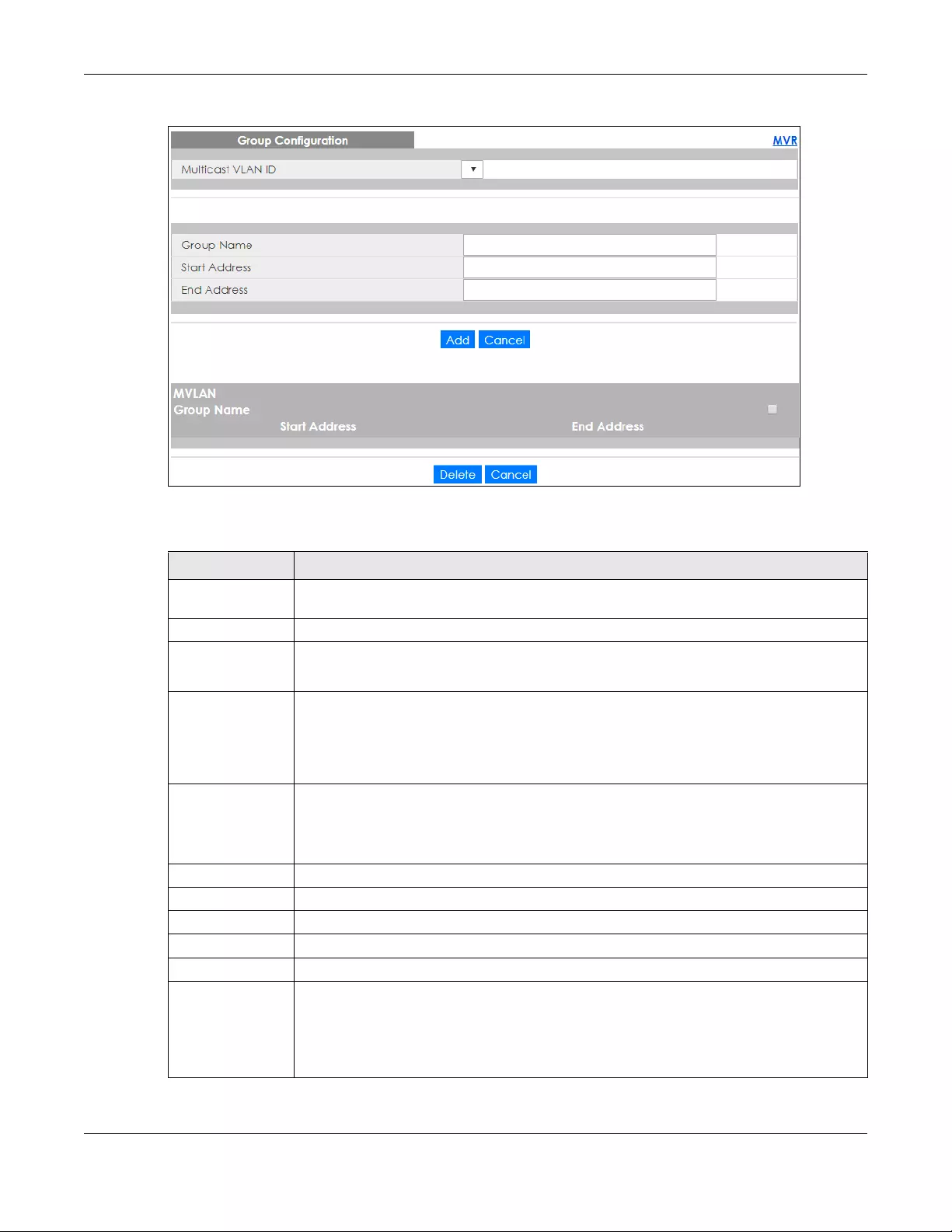
Chapter 24 Multicast
GS1920v2 Series User’s Guide
221
Figure 158 Advanced Application > Multicast > MVR > Group Configuration
The following table describes the labels in this screen.
Table 92 Advanced Application > Multicast > MVR > Group Configuration
LABEL DESCRIPTION
Multicast VLAN ID Select a multicast VLAN ID (that you configured in the MVR screen) from the drop-down list
box.
Group Name Enter a descriptive name for identification purposes.
Start Address Enter the starting IP multicast address of the multicast group in dotted decimal notation.
Refer to IP Multicast Addresses on page 201 for more information on IP multicast addresses.
End Address Enter the ending IP multicast address of the multicast group in dotted decimal notation.
Enter the same IP address as the Start Address field if you want to configure only one IP
address for a multicast group.
Refer to IP Multicast Addresses on page 201 for more information on IP multicast addresses.
Add Click this to create a new entry.
This saves your changes to the Switch’s run-time memory. The Switch loses these changes if it is
turned off or loses power, so use the Save link on the top navigation panel to save your
changes to the non-volatile memory when you are done configuring.
Cancel Click Cancel to begin configuring this screen afresh.
MVLAN This field displays the multicast VLAN ID.
Group Name This field displays the descriptive name for this setting.
Start Address This field displays the starting IP address of the multicast group.
End Address This field displays the ending IP address of the multicast group.
To delete the profile(s) and all the accompanying rules, select the profile(s) that you want to
remove, then click the Delete button. You can select the check box in the table heading row
to select all profiles.
To delete a rule(s) from a profile, select the rule(s) that you want to remove , then click the
Delete button.
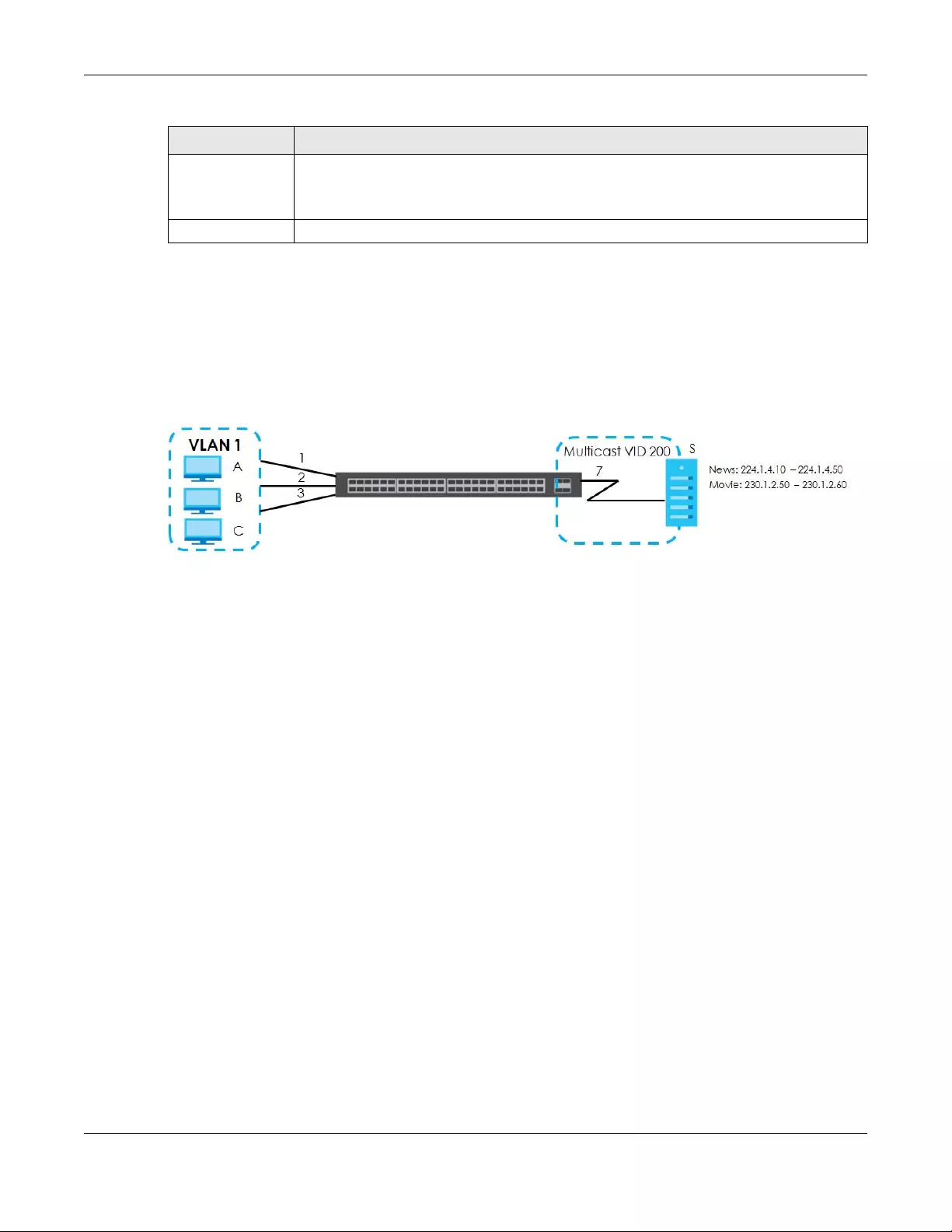
Chapter 24 Multicast
GS1920v2 Series User’s Guide
222
24.5.2 MVR Configuration Example
The following figure shows a network example where ports 1, 2 and 3 on the Switch belong to VLAN 1. In
addition, port 7 belongs to the multicast group with VID 200 to receive multicast traffic (the News and
Movie channels) from the remote streaming media server, S. Computers A, B and C in VLAN 1 are able
to receive the traffic.
Figure 159 MVR Configuration Example
To configure the MVR settings on the Switch, create a multicast VLAN in the MVR screen and set the
receiver and source ports.
Delete Select the entry(ies) that you want to remove, then click the Delete button to remove the
selected entry(ies) from the table.
If you delete a multicast VLAN, all multicast groups in this VLAN will also be removed.
Cancel Select Cancel to clear the checkbox(es) in the table.
Table 92 Advanced Application > Multicast > MVR > Group Configuration (continued)
LABEL DESCRIPTION

Chapter 24 Multicast
GS1920v2 Series User’s Guide
223
Figure 160 MVR Configuration Example
To set the Switch to forward the multicast group traffic to the subscribers, configure multicast group
settings in the Group Configuration screen. The following figure shows an example where two IPv4
multicast groups (News and Movie) are configured for the multicast VLAN 200.
Figure 161 MVR Group Configuration Example-1
EXAMPLE
EXAMPLE
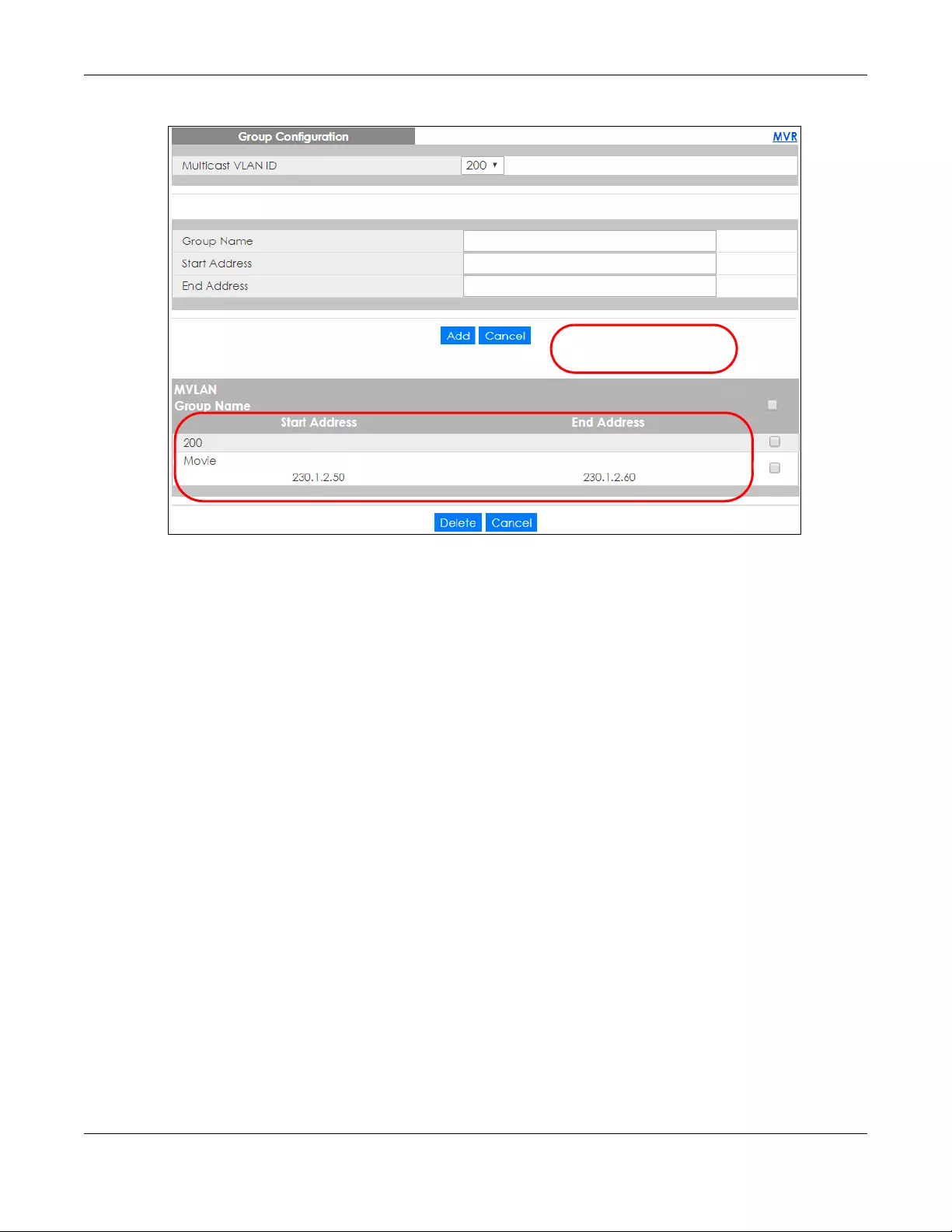
Chapter 24 Multicast
GS1920v2 Series User’s Guide
224
Figure 162 MVR Group Configuration Example-2
EXAMPLE

GS1920v2 Series User’s Guide
225
CHAPTER 25
AAA
25.1 AAA Overview
This chapter describes how to configure authentication, authorization and accounting settings on the
Switch.
The external servers that perform authentication, authorization and accounting functions are known as
AAA servers. The Switch supports RADIUS (Remote Authentication Dial-In User Service, see RADIUS and
TACACS+ on page 226) and TACACS+ (Terminal Access Controller Access-Control System Plus, see
RADIUS and TACACS+ on page 226) as external authentication and authorization servers.
Figure 163 AAA Server
25.1.1 What You Can Do
• Use the AAA screen (Section 25.2 on page 226) to display the links to the screens where you can
enable authentication and authorization or both of them on the Switch.
• use the RADIUS Server Setup screen (Section 25.3 on page 226) to configure your RADIUS server
settings.
• Use the TACACS+ Server Setup screen (Section 25.4 on page 228) to configure your TACACS+
authentication settings.
• Use the AAA Setup screen (Section 25.5 on page 230) to configure authentication, authorization and
accounting settings, such as the methods used to authenticate users accessing the Switch and which
database the Switch should use first.
25.1.2 What You Need to Know
Authentication is the process of determining who a user is and validating access to the Switch. The
Switch can authenticate users who try to log in based on user accounts configured on the Switch itself.
The Switch can also use an external authentication server to authenticate a large number of users.
Authorization is the process of determining what a user is allowed to do. Different user accounts may
have higher or lower privilege levels associated with them. For example, user A may have the right to
create new login accounts on the Switch but user B cannot. The Switch can authorize users based on
user accounts configured on the Switch itself or it can use an external server to authorize a large number
of users.

Chapter 25 AAA
GS1920v2 Series User’s Guide
226
Accounting is the process of recording what a user is doing. The Switch can use an external server to
track when users log in, log out, execute commands and so on. Accounting can also record system
related actions such as boot up and shut down times of the Switch.
Local User Accounts
By storing user profiles locally on the Switch, your Switch is able to authenticate and authorize users
without interacting with a network AAA server. However, there is a limit on the number of users you may
authenticate in this way (See Section 40.4 on page 354).
RADIUS and TACACS+
RADIUS and TACACS+ are security protocols used to authenticate users by means of an external server
instead of (or in addition to) an internal device user database that is limited to the memory capacity of
the device. In essence, RADIUS and TACACS+ authentication both allow you to validate an unlimited
number of users from a central location.
The following table describes some key differences between RADIUS and TACACS+.
25.2 AAA Screens
The AAA screens allow you to enable authentication and authorization or both of them on the Switch.
First, configure your authentication server settings (RADIUS, TACACS+ or both) and then set up the
authentication priority, activate authorization.
Click Advanced Application > AAA in the navigation panel to display the screen as shown.
Figure 164 Advanced Application > AAA
25.3 RADIUS Server Setup
Use this screen to configure your RADIUS server settings. See RADIUS and TACACS+ on page 226 for more
information on RADIUS servers and Section 25.6.2 on page 233 for RADIUS attributes utilized by the
authentication features on the Switch. Click on the RADIUS Server Setup link in the AAA screen to view
the screen as shown.
Table 93 RADIUS vs. TACACS+
RADIUS TACACS+
Transport
Protocol
UDP (User Datagram Protocol) TCP (Transmission Control Protocol)
Encryption Encrypts the password sent for
authentication.
All communication between the client (the Switch)
and the TACACS server is encrypted.
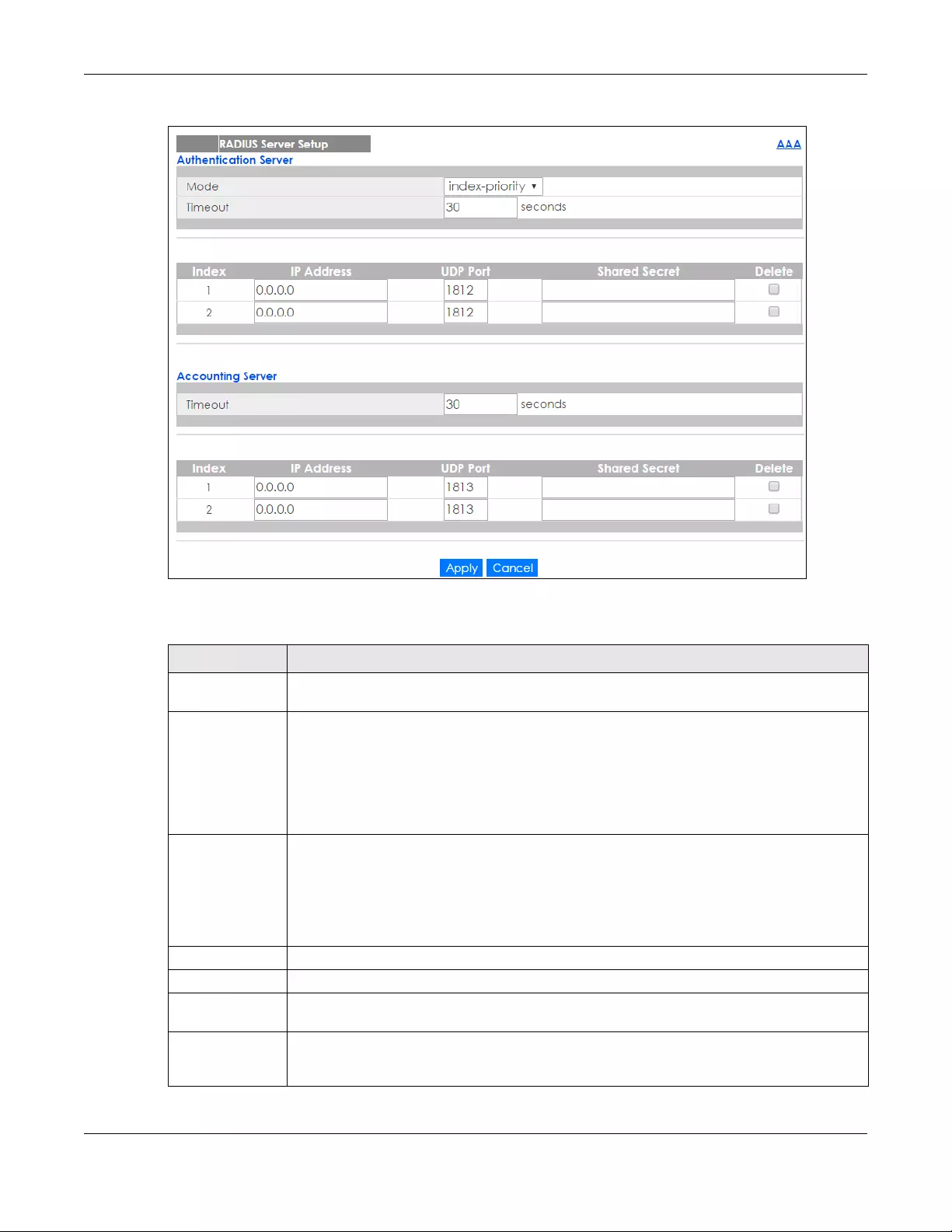
Chapter 25 AAA
GS1920v2 Series User’s Guide
227
Figure 165 Advanced Application > AAA > RADIUS Server Setup
The following table describes the labels in this screen.
Table 94 Advanced Application > AAA > RADIUS Server Setup
LABEL DESCRIPTION
Authentication
Server
Use this section to configure your RADIUS authentication settings.
Mode This field is only valid if you configure multiple RADIUS servers.
Select index-priority and the Switch tries to authenticate with the first configured RADIUS server,
if the RADIUS server does not respond then the Switch tries to authenticate with the second
RADIUS server.
Select round-robin to alternate between the RADIUS servers that it sends authentication
requests to.
Timeout Specify the amount of time in seconds that the Switch waits for an authentication request
response from the RADIUS server.
If you are using index-priority for your authentication and you are using two RADIUS servers
then the timeout value is divided between the two RADIUS servers. For example, if you set the
timeout value to 30 seconds, then the Switch waits for a response from the first RADIUS server for
15 seconds and then tries the second RADIUS server.
Index This is a read-only number representing a RADIUS server entry.
IP Address Enter the IP address of an external RADIUS server in dotted decimal notation.
UDP Port The default port of a RADIUS server for authentication is 1812. You need not change this value
unless your network administrator instructs you to do so.
Shared Secret Specify a password (up to 32 alphanumeric characters) as the key to be shared between the
external RADIUS server and the Switch. This key is not sent over the network. This key must be the
same on the external RADIUS server and the Switch.

Chapter 25 AAA
GS1920v2 Series User’s Guide
228
25.4 TACACS+ Server Setup
Use this screen to configure your TACACS+ server settings. See RADIUS and TACACS+ on page 226 for
more information on TACACS+ servers. Click on the TACACS+ Server Setup link in the AAA screen to view
the screen as shown.
Delete Check this box if you want to remove an existing RADIUS server entry from the Switch. This entry
is deleted when you click Apply.
Accounting
Server
Use this section to configure your RADIUS accounting server settings.
Timeout Specify the amount of time in seconds that the Switch waits for an accounting request
response from the RADIUS accounting server.
Index This is a read-only number representing a RADIUS accounting server entry.
IP Address Enter the IP address of an external RADIUS accounting server in dotted decimal notation.
UDP Port The default port of a RADIUS accounting server for accounting is 1813. You need not change
this value unless your network administrator instructs you to do so.
Shared Secret Specify a password (up to 32 alphanumeric characters) as the key to be shared between the
external RADIUS accounting server and the Switch. This key is not sent over the network. This key
must be the same on the external RADIUS accounting server and the Switch.
Delete Check this box if you want to remove an existing RADIUS accounting server entry from the
Switch. This entry is deleted when you click Apply.
Apply Click Apply to save your changes to the Switch’s run-time memory. The Switch loses these
changes if it is turned off or loses power, so use the Save link on the top navigation panel to
save your changes to the non-volatile memory when you are done configuring.
Cancel Click Cancel to begin configuring this screen afresh.
Table 94 Advanced Application > AAA > RADIUS Server Setup (continued)
LABEL DESCRIPTION
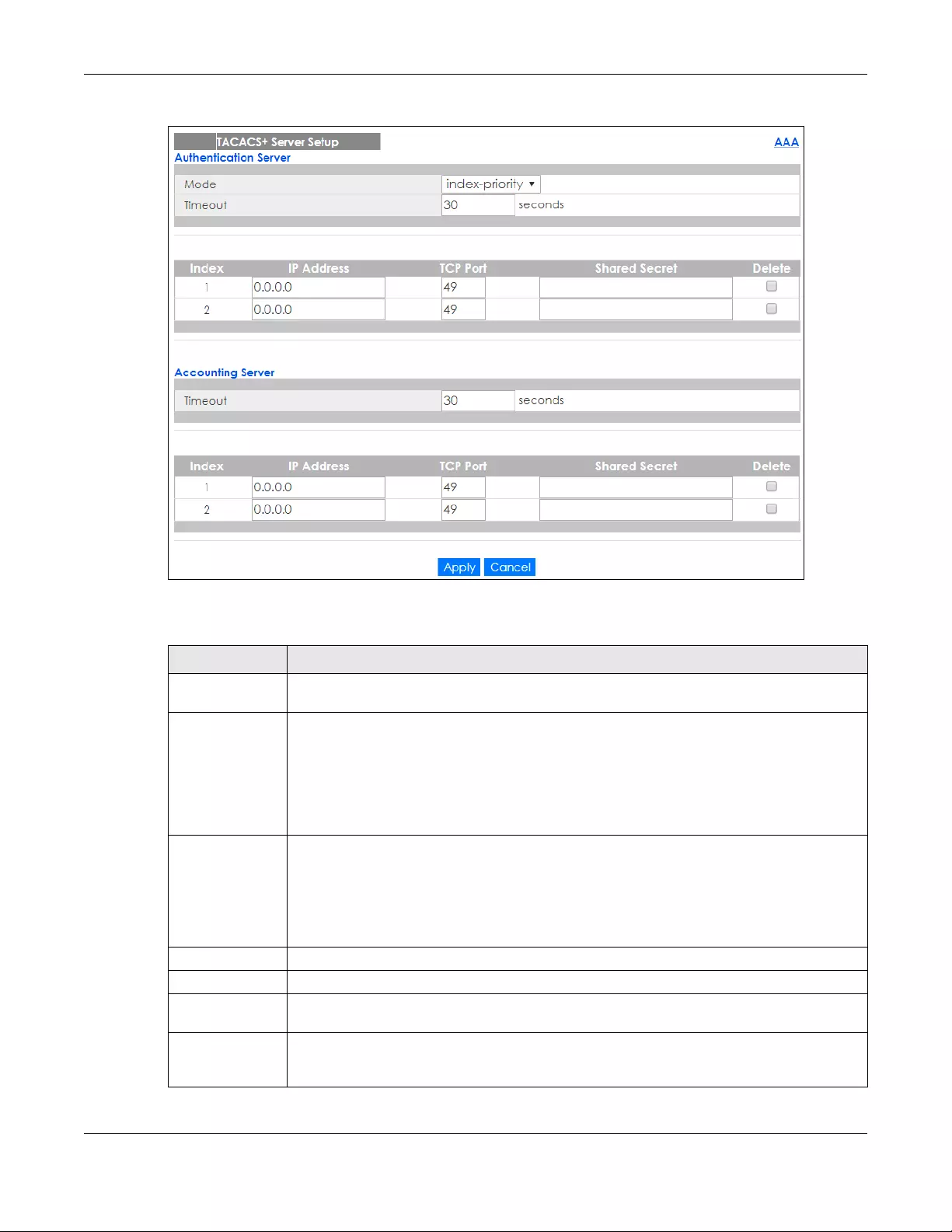
Chapter 25 AAA
GS1920v2 Series User’s Guide
229
Figure 166 Advanced Application > AAA > TACACS+ Server Setup
The following table describes the labels in this screen.
Table 95 Advanced Application > AAA > TACACS+ Server Setup
LABEL DESCRIPTION
Authentication
Server
Use this section to configure your TACACS+ authentication settings.
Mode This field is only valid if you configure multiple TACACS+ servers.
Select index-priority and the Switch tries to authenticate with the first configured TACACS+
server, if the TACACS+ server does not respond then the Switch tries to authenticate with the
second TACACS+ server.
Select round-robin to alternate between the TACACS+ servers that it sends authentication
requests to.
Timeout Specify the amount of time in seconds that the Switch waits for an authentication request
response from the TACACS+ server.
If you are using index-priority for your authentication and you are using two TACACS+ servers
then the timeout value is divided between the two TACACS+ servers. For example, if you set
the timeout value to 30 seconds, then the Switch waits for a response from the first TACACS+
server for 15 seconds and then tries the second TACACS+ server.
Index This is a read-only number representing a TACACS+ server entry.
IP Address Enter the IP address of an external TACACS+ server in dotted decimal notation.
TCP Port The default port of a TACACS+ server for authentication is 49. You need not change this value
unless your network administrator instructs you to do so.
Shared Secret Specify a password (up to 32 alphanumeric characters) as the key to be shared between the
external TACACS+ server and the Switch. This key is not sent over the network. This key must be
the same on the external TACACS+ server and the Switch.
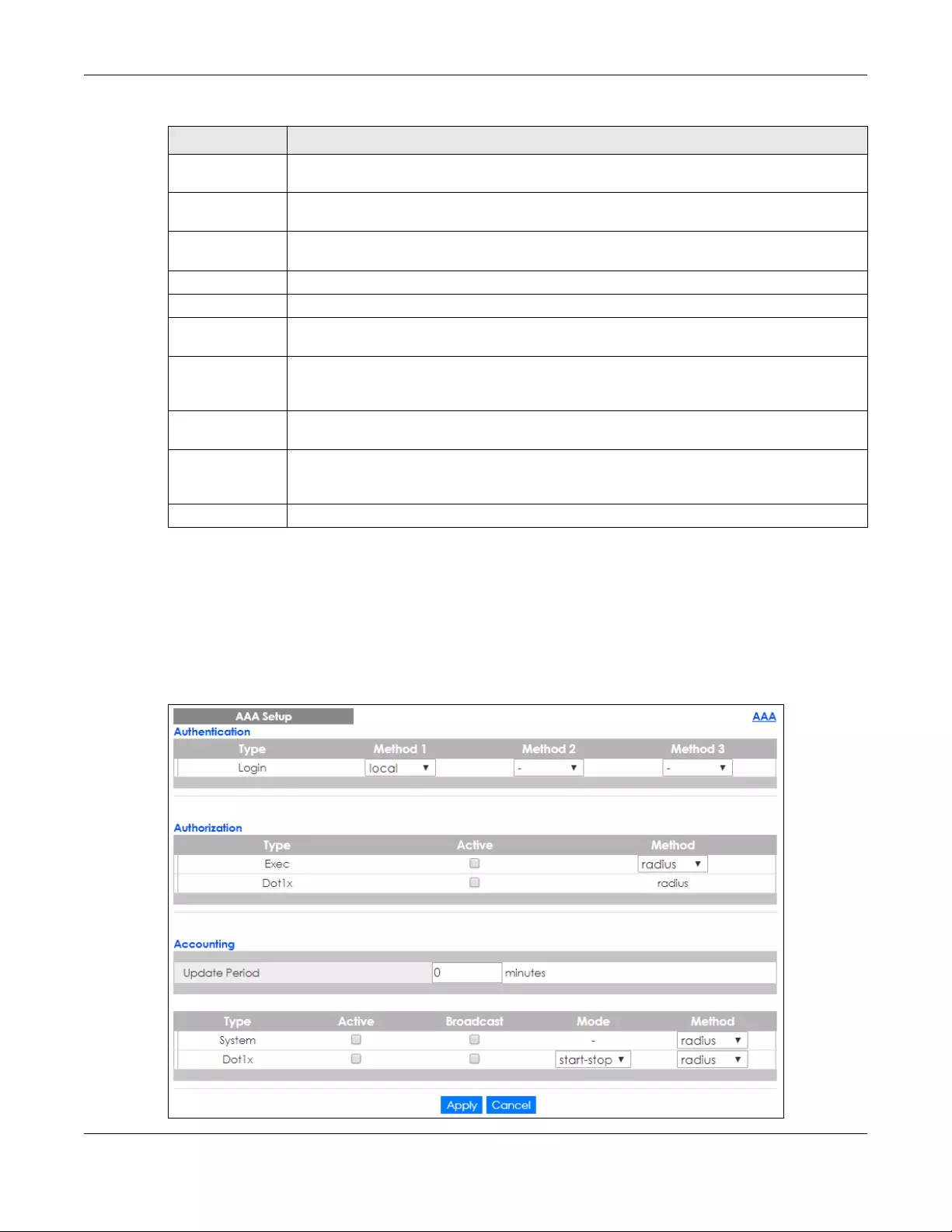
Chapter 25 AAA
GS1920v2 Series User’s Guide
230
25.5 AAA Setup
Use this screen to configure authentication, authorization and accounting settings on the Switch. Click
on the AAA Setup link in the AAA screen to view the screen as shown.
Figure 167 Advanced Application > AAA > AAA Setup
Delete Check this box if you want to remove an existing TACACS+ server entry from the Switch. This
entry is deleted when you click Apply.
Accounting
Server
Use this section to configure your TACACS+ accounting settings.
Timeout Specify the amount of time in seconds that the Switch waits for an accounting request
response from the TACACS+ server.
Index This is a read-only number representing a TACACS+ accounting server entry.
IP Address Enter the IP address of an external TACACS+ accounting server in dotted decimal notation.
TCP Port The default port of a TACACS+ accounting server is 49. You need not change this value unless
your network administrator instructs you to do so.
Shared Secret Specify a password (up to 32 alphanumeric characters) as the key to be shared between the
external TACACS+ accounting server and the Switch. This key is not sent over the network. This
key must be the same on the external TACACS+ accounting server and the Switch.
Delete Check this box if you want to remove an existing TACACS+ accounting server entry from the
Switch. This entry is deleted when you click Apply.
Apply Click Apply to save your changes to the Switch’s run-time memory. The Switch loses these
changes if it is turned off or loses power, so use the Save link on the top navigation panel to
save your changes to the non-volatile memory when you are done configuring.
Cancel Click Cancel to begin configuring this screen afresh.
Table 95 Advanced Application > AAA > TACACS+ Server Setup (continued)
LABEL DESCRIPTION

Chapter 25 AAA
GS1920v2 Series User’s Guide
231
The following table describes the labels in this screen.
Table 96 Advanced Application > AAA > AAA Setup
LABEL DESCRIPTION
Authentication Use this section to specify the methods used to authenticate users accessing the Switch.
Login These fields specify which database the Switch should use (first, second and third) to
authenticate administrator accounts (users for Switch management).
Configure the local user accounts in the Access Control > Logins screen. The TACACS+ and
RADIUS are external servers. Before you specify the priority, make sure you have set up the
corresponding database correctly first.
You can specify up to three methods for the Switch to authenticate administrator accounts.
The Switch checks the methods in the order you configure them (first Method 1, then Method 2
and finally Method 3). You must configure the settings in the Method 1 field. If you want the
Switch to check other sources for administrator accounts, specify them in Method 2 and
Method 3 fields.
Select local to have the Switch check the administrator accounts configured in the Access
Control > Logins screen.
Select radius to have the Switch check the administrator accounts configured via your RADIUS
server.
Select tacacs+ to have the Switch check the administrator accounts configured via your
TACACS+ server.
Authorization Use this section to configure authorization settings on the Switch.
Type Set whether the Switch provides the following services to a user.
•Exec: Allow an administrator which logs into the Switch through Telnet or SSH to have a
different access privilege level assigned via the external server.
•Dot1x: Allow an IEEE 802.1x client to have different bandwidth limit or VLAN ID assigned via
the external server.
Active Select this to activate authorization for a specified event types.
Method Select whether you want to use RADIUS or TACACS+ for authorization of specific types of
events.
RADIUS is the only method for IEEE 802.1x authorization.
Accounting Use this section to configure accounting settings on the Switch.
Update Period This is the amount of time in minutes before the Switch sends an update to the accounting
server. This is only valid if you select the start-stop option for the Exec or Dot1x entries.
Type The Switch supports the following types of events to be sent to the accounting server(s):
• System - Configure the Switch to send information when the following system events occur:
system boots up, system shuts down, system accounting is enabled, system accounting is
disabled
• Exec - Configure the Switch to send information when an administrator logs in and logs out
via telnet or SSH.
• Dot1x - Configure the Switch to send information when an IEEE 802.1x client begins a session
(authenticates via the Switch), ends a session as well as interim updates of a session.
• Commands - Configure the Switch to send information when commands of specified
privilege level and higher are executed on the Switch.
Active Select this to activate accounting for a specified event types.
Broadcast Select this to have the Switch send accounting information to all configured accounting
servers at the same time.
If you don’t select this and you have two accounting servers set up, then the Switch sends
information to the first accounting server and if it doesn’t get a response from the accounting
server then it tries the second accounting server.

Chapter 25 AAA
GS1920v2 Series User’s Guide
232
25.6 Technical Reference
This section provides technical background information on the topics discussed in this chapter.
25.6.1 Vendor Specific Attribute
RFC 2865 standard specifies a method for sending vendor-specific information between a RADIUS server
and a network access device (for example, the Switch). A company can create Vendor Specific
Attributes (VSAs) to expand the functionality of a RADIUS server.
The Switch supports VSAs that allow you to perform the following actions based on user authentication:
• Limit bandwidth on incoming or outgoing traffic for the port the user connects to.
• Assign account privilege levels for the authenticated user.
The VSAs are composed of the following:
•Vendor-ID: An identification number assigned to the company by the IANA (Internet Assigned
Numbers Authority). Zyxel’s vendor ID is 890.
•Vendor-Type: A vendor specified attribute, identifying the setting you want to modify.
•Vendor-data: A value you want to assign to the setting.
Note: Refer to the documentation that comes with your RADIUS server on how to configure
VSAs for users authenticating via the RADIUS server.
Mode The Switch supports two modes of recording login events. Select:
• start-stop - to have the Switch send information to the accounting server when a user begins
a session, during a user’s session (if it lasts past the Update Period), and when a user ends a
session.
• stop-only - to have the Switch send information to the accounting server only when a user
ends a session.
Method Select whether you want to use RADIUS or TACACS+ for accounting of specific types of events.
TACACS+ is the only method for recording Commands type of event.
Apply Click Apply to save your changes to the Switch’s run-time memory. The Switch loses these
changes if it is turned off or loses power, so use the Save link on the top navigation panel to
save your changes to the non-volatile memory when you are done configuring.
Cancel Click Cancel to begin configuring this screen afresh.
Table 96 Advanced Application > AAA > AAA Setup (continued)
LABEL DESCRIPTION

Chapter 25 AAA
GS1920v2 Series User’s Guide
233
The following table describes the VSAs supported on the Switch.
25.6.1.1 Tunnel Protocol Attribute
You can configure tunnel protocol attributes on the RADIUS server (refer to your RADIUS server
documentation) to assign a port on the Switch to a VLAN based on IEEE 802.1x authentication. The port
VLAN settings are fixed and untagged. This will also set the port’s VID. The following table describes the
values you need to configure. Note that the bolded values in the table are fixed values as defined in
RFC 3580.
25.6.2 Supported RADIUS Attributes
Remote Authentication Dial-In User Service (RADIUS) attributes are data used to define specific
authentication elements in a user profile, which is stored on the RADIUS server. This appendix lists the
RADIUS attributes supported by the Switch.
Refer to RFC 2865 for more information about RADIUS attributes used for authentication.
This section lists the attributes used by authentication functions on the Switch. In cases where the
attribute has a specific format associated with it, the format is specified.
Table 97 Supported VSAs
FUNCTION ATTRIBUTE
Ingress Bandwidth
Assignment Vendor-Id = 890
Vendor-Type = 1
Vendor-data = ingress rate (Kbps in decimal format)
Egress Bandwidth
Assignment Vendor-Id = 890
Vendor-Type = 2
Vendor-data = egress rate (Kbps in decimal format)
Privilege Assignment Vendor-ID = 890
Vendor-Type = 3
Vendor-Data = "shell:priv-lvl=N"
or
Vendor-ID = 9 (CISCO)
Vendor-Type = 1 (CISCO-AVPAIR)
Vendor-Data = "shell:priv-lvl=N"
where N is a privilege level (from 0 to 14).
Note: If you set the privilege level of a login account differently on the RADIUS
server(s) and the Switch, the user is assigned a privilege level from the
database (RADIUS or local) the Switch uses first for user authentication.
Table 98 Supported Tunnel Protocol Attribute
FUNCTION ATTRIBUTE
VLAN Assignment Tunnel-Type = VLAN(13)
Tunnel-Medium-Type = 802(6)
Tunnel-Private-Group-ID = VLAN ID
Note: You must also create a VLAN with the specified VID on the Switch.

Chapter 25 AAA
GS1920v2 Series User’s Guide
234
25.6.3 Attributes Used for Authentication
The following sections list the attributes sent from the Switch to the RADIUS server when performing
authentication.
25.6.3.1 Attributes Used for Authenticating Privilege Access
User-Name
- The format of the User-Name attribute is $enab#$, where # is the privilege level (1-14).
User-Password
NAS-Identifier
NAS-IP-Address
25.6.3.2 Attributes Used to Login Users
User-Name
User-Password
NAS-Identifier
NAS-IP-Address
25.6.3.3 Attributes Used by the IEEE 802.1x Authentication
User-Name
NAS-Identifier
NAS-IP-Address
NAS-Port
NAS-Port-Type
- This value is set to Ethernet(15) on the Switch.
Calling-Station-Id
Frame-MTU
EAP-Message
State
Message-Authenticator

Chapter 26 IP Source Guard
GS1920v2 Series User’s Guide
235
CHAPTER 26
IP Source Guard
26.1 IP Source Guard Overview
Use IPv4 source guard to filter unauthorized DHCP and ARP packets in your network.
IP source guard uses a binding table to distinguish between authorized and unauthorized DHCP and
ARP packets in your network. A binding contains these key attributes:
• MAC address
• VLAN ID
• IP address
• Port number
When the Switch receives a DHCP or ARP packet, it looks up the appropriate MAC address, VLAN ID, IP
address, and port number in the binding table. If there is a binding, the Switch forwards the packet. If
there is not a binding, the Switch discards the packet.
26.1.1 What You Can Do
• Use the IP Source Guard screen (Section 26.2 on page 236) to display the links to the configuration
screens where you can configure IPv4 source guard settings.
• Use the IPv4 Source Guard Setup screen (Section 26.3 on page 237) to look at the current bindings for
DHCP snooping and ARP inspection.
• Use the IP Source Guard Static Binding screen (Section 26.4 on page 237) to manage static bindings
for DHCP snooping and ARP inspection.
• Use the DHCP Snooping screen (Section 26.5 on page 239) to look at various statistics about the DHCP
snooping database.
• Use this DHCP Snooping Configure screen (Section 26.6 on page 242) to enable DHCP snooping on
the Switch (not on specific VLAN), specify the VLAN where the default DHCP server is located, and
configure the DHCP snooping database.
• Use the DHCP Snooping Port Configure screen (Section 26.6.1 on page 244) to specify whether ports
are trusted or untrusted ports for DHCP snooping.
• Use the DHCP Snooping VLAN Configure screen (Section 26.6.2 on page 245) to enable DHCP
snooping on each VLAN and to specify whether or not the Switch adds DHCP relay agent option 82
information to DHCP requests that the Switch relays to a DHCP server for each VLAN.
• Use the DHCP Snooping VLAN Port Configure screen (Section 26.6.3 on page 246) to apply a different
DHCP option 82 profile to certain ports in a VLAN.
• Use the ARP Inspection Status screen (Section 26.7 on page 248) to look at the current list of MAC
address filters that were created because the Switch identified an unauthorized ARP packet.

GS1920v2 Series User’s Guide
236
• Use the ARP Inspection VLAN Status screen (Section 26.8 on page 249) to look at various statistics
about ARP packets in each VLAN.
• Use the ARP Inspection Log Status screen (Section 26.9 on page 249) to look at log messages that
were generated by ARP packets and that have not been sent to the syslog server yet.
• Use the ARP Inspection Configure screen (Section 26.10 on page 251) to enable ARP inspection on
the Switch. You can also configure the length of time the Switch stores records of discarded ARP
packets and global settings for the ARP inspection log.
• Use the ARP Inspection Port Configure screen (Section 26.10.1 on page 252) to specify whether ports
are trusted or untrusted ports for ARP inspection.
• Use the ARP Inspection VLAN Configure screen (Section 26.10.2 on page 253) to enable ARP
inspection on each VLAN and to specify when the Switch generates log messages for receiving ARP
packets from each VLAN.
26.1.2 What You Need to Know
The Switch builds the binding table by snooping DHCP packets (dynamic bindings) and from information
provided manually by administrators (static bindings).
IP source guard consists of the following features:
• Static bindings. Use this to create static bindings in the binding table.
• DHCP snooping. Use this to filter unauthorized DHCP packets on the network and to build the binding
table dynamically.
• ARP inspection. Use this to filter unauthorized ARP packets on the network.
If you want to use dynamic bindings to filter unauthorized ARP packets (typical implementation), you
have to enable DHCP snooping before you enable ARP inspection.
26.2 IP Source Guard Screen
Use this screen to go to the configuration screens where you can configure IPv4 source guard settings.
Click Advanced Application > IP Source Guard in the navigation panel.
Figure 168 Advanced Application > IP Source Guard
The following table describes the labels in this screen.
Table 99 Advanced Application > IP Source Guard
LABEL DESCRIPTION
IPv4 Source Guard
Setup
Click the link to open screens where you can view and manage static bindings, configure
DHCP snooping or ARP inspection and look at various statistics.
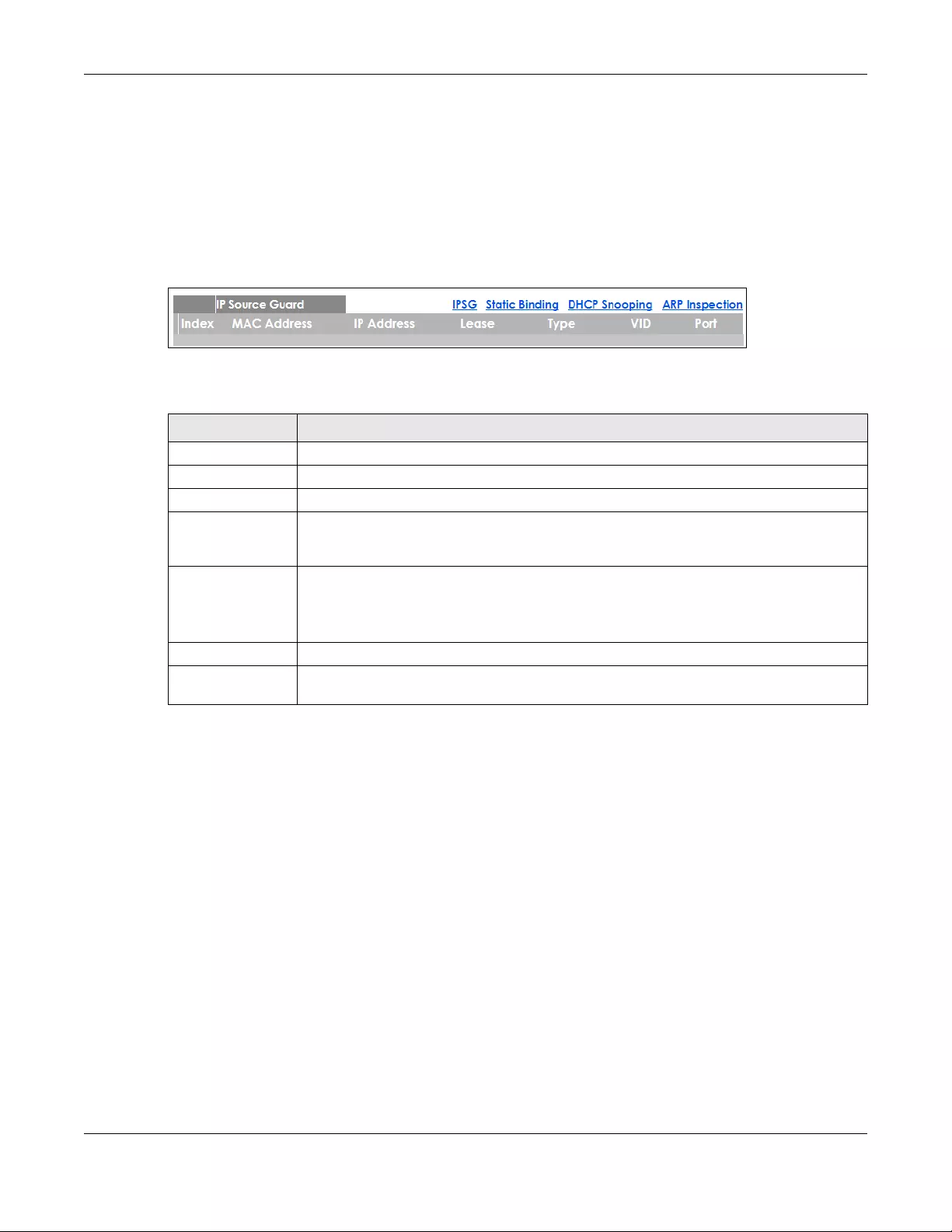
Chapter 26 IP Source Guard
GS1920v2 Series User’s Guide
237
26.3 IPv4 Source Guard Setup
Use this screen to look at the current bindings for DHCP snooping and ARP inspection. Bindings are used
by DHCP snooping and ARP inspection to distinguish between authorized and unauthorized packets in
the network. The Switch learns the bindings by snooping DHCP packets (dynamic bindings) and from
information provided manually by administrators (static bindings). To open this screen, click Advanced
Application > IP Source Guard > IPv4 Source Guard Setup.
Figure 169 Advanced Application > IP Source Guard > IPv4 Source Guard Setup
The following table describes the labels in this screen.
26.4 IPv4 Source Guard Static Binding
Use this screen to manage static bindings for DHCP snooping and ARP inspection. Static bindings are
uniquely identified by the MAC address and VLAN ID. Each MAC address and VLAN ID can only be in
one static binding. If you try to create a static binding with the same MAC address and VLAN ID as an
existing static binding, the new static binding replaces the original one. To open this screen, click
Advanced Application > IP Source Guard > IPv4 Source Guard Setup > Static Binding.
Table 100 Advanced Application > IP Source Guard > IPv4 Source Guard Setup
LABEL DESCRIPTION
Index This field displays a sequential number for each binding.
MAC Address This field displays the source MAC address in the binding.
IP Address This field displays the IP address assigned to the MAC address in the binding.
Lease This field displays how many days, hours, minutes, and seconds the binding is valid; for
example, 2d3h4m5s means the binding is still valid for 2 days, 3 hours, 4 minutes, and 5
seconds. This field displays infinity if the binding is always valid (for example, a static binding).
Type This field displays how the Switch learned the binding.
static: This binding was learned from information provided manually by an administrator.
dhcp-snooping: This binding was learned by snooping DHCP packets.
VID This field displays the source VLAN ID in the binding.
Port This field displays the port number in the binding. If this field is blank, the binding applies to all
ports.

Chapter 26 IP Source Guard
GS1920v2 Series User’s Guide
238
Figure 170 Advanced Application > IP Source Guard > IPv4 Source Guard Setup > Static Binding
The following table describes the labels in this screen.
Table 101 Advanced Application > IP Source Guard > IPv4 Source Guard Setup > Static Binding
LABEL DESCRIPTION
ARP Freeze ARP Freeze allows you to automatically create static bindings from the current ARP entries
(either dynamically learned or static ARP entries) until the Switch’s binding table is full.
Note: The ARP learning mode should be set to ARP-Request in the IP Application >
ARP Setup > ARP Learning screen before you use the ARP Freeze feature.
Condition All - Select this and click ARP Freeze to have the Switch automatically add all the current
ARP entries to the static bindings table.
Port List - Select this and enter the number of the port(s) (separated by a comma). ARP
entries learned on the specified port(s) are added to the static bindings table after you click
ARP Freeze.
VLAN List - Select this and enter the ID number of the VLAN(s) (separated by a comma). ARP
entries for the specified VLAN(s) are added to the static bindings table after you click ARP
Freeze.
Static Binding
MAC Address Enter the source MAC address in the binding.
IP Address Enter the IP address assigned to the MAC address in the binding.
VLAN Enter the source VLAN ID in the binding.
Port Specify the port(s) in the binding. If this binding has one port, select the first radio button and
enter the port number in the field to the right. If this binding applies to all ports, select Any.
Add Click this to create the specified static binding or to update an existing one.
Cancel Click this to reset the values above based on the last selected static binding or, if not
applicable, to clear the fields above.
Clear Click this to clear the fields above.

Chapter 26 IP Source Guard
GS1920v2 Series User’s Guide
239
26.5 DHCP Snooping
Use this screen to look at various statistics about the DHCP snooping database. To open this screen, click
Advanced Application > IP Source Guard > IPv4 Source Guard Setup > DHCP Snooping.
Index This field displays a sequential number for each binding.
MAC Address This field displays the source MAC address in the binding.
IP Address This field displays the IP address assigned to the MAC address in the binding.
Lease This field displays how long the binding is valid.
Type This field displays how the Switch learned the binding.
static: This binding was learned from information provided manually by an administrator.
VLAN This field displays the source VLAN ID in the binding.
Port This field displays the port number in the binding. If this field is blank, the binding applies to all
ports.
Select an entry’s check box to select a specific entry. Otherwise, select the check box in
the table heading row to select all entries.
Delete Check the entry(ies) that you want to remove and then click Delete to remove the selected
entry(ies) from the summary table.
Cancel Click Cancel to clear the check boxes.
Table 101 Advanced Application > IP Source Guard > IPv4 Source Guard Setup > Static Binding
LABEL DESCRIPTION
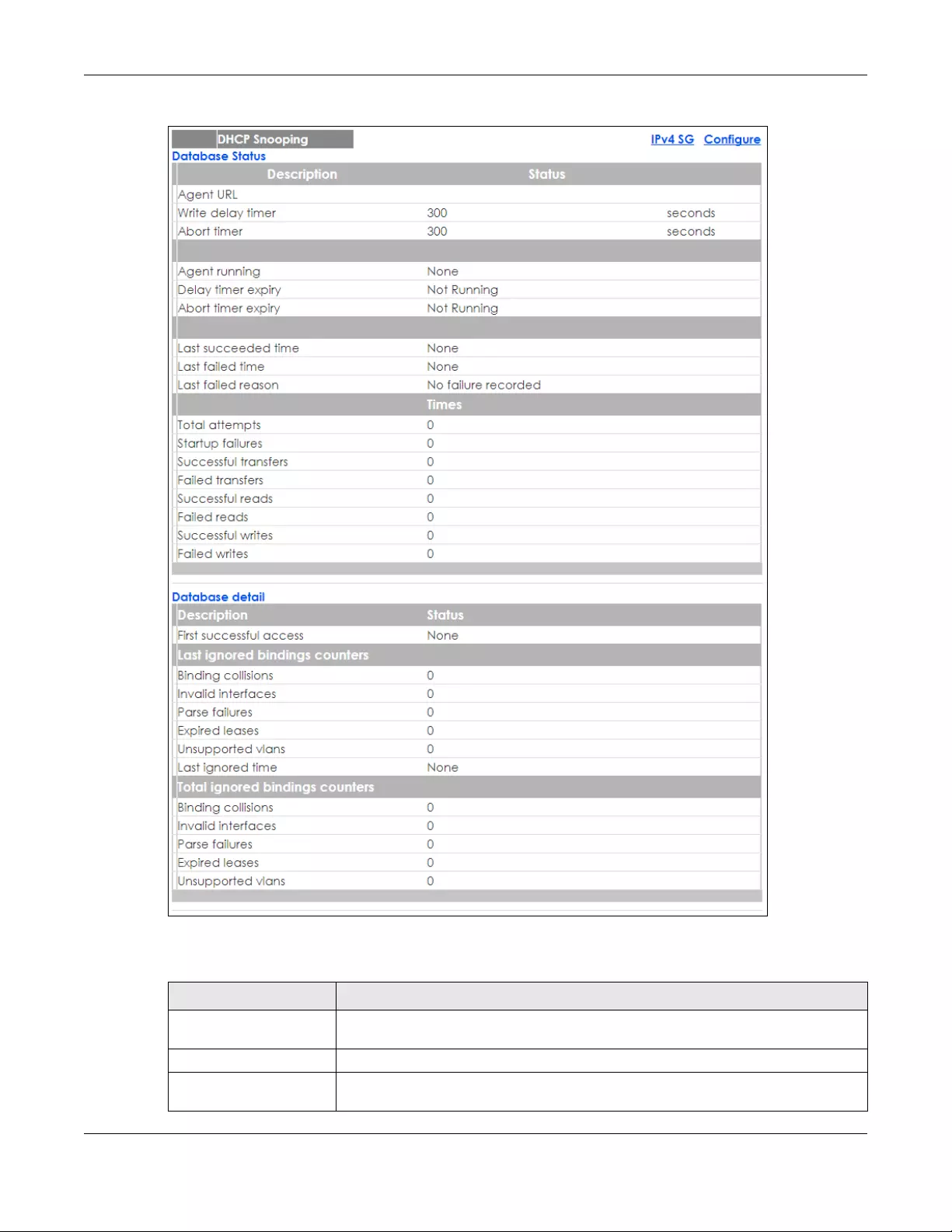
Chapter 26 IP Source Guard
GS1920v2 Series User’s Guide
240
Figure 171 Advanced Application > IP Source Guard > IPv4 Source Guard Setup > DHCP Snooping
The following table describes the labels in this screen.
Table 102 Advanced Application > IP Source Guard > IPv4 Source Guard Setup > DHCP Snooping
LABEL DESCRIPTION
Database Status This section displays the current settings for the DHCP snooping database. You can
configure them in the DHCP Snooping Configure screen. See Section 26.6 on page 242.
Agent URL This field displays the location of the DHCP snooping database.
Write delay timer This field displays how long (in seconds) the Switch tries to complete a specific update
in the DHCP snooping database before it gives up.

Chapter 26 IP Source Guard
GS1920v2 Series User’s Guide
241
Abort timer This field displays how long (in seconds) the Switch waits to update the DHCP snooping
database after the current bindings change.
This section displays information about the current update and the next update of the
DHCP snooping database.
Agent running This field displays the status of the current update or access of the DHCP snooping
database.
none: The Switch is not accessing the DHCP snooping database.
read: The Switch is loading dynamic bindings from the DHCP snooping database.
write: The Switch is updating the DHCP snooping database.
Delay timer expiry This field displays how much longer (in seconds) the Switch tries to complete the
current update before it gives up. It displays Not Running if the Switch is not updating
the DHCP snooping database right now.
Abort timer expiry This field displays when (in seconds) the Switch is going to update the DHCP snooping
database again. It displays Not Running if the current bindings have not changed
since the last update.
This section displays information about the last time the Switch updated the DHCP
snooping database.
Last succeeded time This field displays the last time the Switch updated the DHCP snooping database
successfully.
Last failed time This field displays the last time the Switch updated the DHCP snooping database
unsuccessfully.
Last failed reason This field displays the reason the Switch updated the DHCP snooping database
unsuccessfully.
This section displays historical information about the number of times the Switch
successfully or unsuccessfully read or updated the DHCP snooping database.
Total attempts This field displays the number of times the Switch has tried to access the DHCP
snooping database for any reason.
Startup failures This field displays the number of times the Switch could not create or read the DHCP
snooping database when the Switch started up or a new URL is configured for the
DHCP snooping database.
Successful transfers This field displays the number of times the Switch read bindings from or updated the
bindings in the DHCP snooping database successfully.
Failed transfers This field displays the number of times the Switch was unable to read bindings from or
update the bindings in the DHCP snooping database.
Successful reads This field displays the number of times the Switch read bindings from the DHCP
snooping database successfully.
Failed reads This field displays the number of times the Switch was unable to read bindings from the
DHCP snooping database.
Successful writes This field displays the number of times the Switch updated the bindings in the DHCP
snooping database successfully.
Failed writes This field displays the number of times the Switch was unable to update the bindings in
the DHCP snooping database.
Database detail
First successful access This field displays the first time the Switch accessed the DHCP snooping database for
any reason.
Last ignored bindings
counters
This section displays the number of times and the reasons the Switch ignored bindings
the last time it read bindings from the DHCP binding database. You can clear these
counters by restarting the Switch.
Table 102 Advanced Application > IP Source Guard > IPv4 Source Guard Setup > DHCP Snooping
LABEL DESCRIPTION

Chapter 26 IP Source Guard
GS1920v2 Series User’s Guide
242
26.6 DHCP Snooping Configure
Use this screen to enable DHCP snooping on the Switch (not on specific VLAN), specify the VLAN where
the default DHCP server is located, and configure the DHCP snooping database. The DHCP snooping
database stores the current bindings on a secure, external TFTP server so that they are still available after
a restart. To open this screen, click Advanced Application > IP Source Guard > IPv4 Sou rce Guard Setup
> DHCP Snooping > Configure.
Binding collisions This field displays the number of bindings the Switch ignored because the Switch
already had a binding with the same MAC address and VLAN ID.
Invalid interfaces This field displays the number of bindings the Switch ignored because the port number
was a trusted interface or does not exist anymore.
Parse failures This field displays the number of bindings the Switch ignored because the Switch was
unable to understand the binding in the DHCP binding database.
Expired leases This field displays the number of bindings the Switch ignored because the lease time
had already expired.
Unsupported vlans This field displays the number of bindings the Switch ignored because the VLAN ID does
not exist anymore.
Last ignored time This field displays the last time the Switch ignored any bindings for any reason from the
DHCP binding database.
Total ignored bindings
counters
This section displays the reasons the Switch has ignored bindings any time it read
bindings from the DHCP binding database. You can clear these counters by restarting
the Switch.
Binding collisions This field displays the number of bindings the Switch has ignored because the Switch
already had a binding with the same MAC address and VLAN ID.
Invalid interfaces This field displays the number of bindings the Switch has ignored because the port
number was a trusted interface or does not exist anymore.
Parse failures This field displays the number of bindings the Switch has ignored because the Switch
was unable to understand the binding in the DHCP binding database.
Expired leases This field displays the number of bindings the Switch has ignored because the lease
time had already expired.
Unsupported vlans This field displays the number of bindings the Switch has ignored because the VLAN ID
does not exist anymore.
Table 102 Advanced Application > IP Source Guard > IPv4 Source Guard Setup > DHCP Snooping
LABEL DESCRIPTION

Chapter 26 IP Source Guard
GS1920v2 Series User’s Guide
243
Figure 172 Advanced Application > IP Source Guard > IPv4 Source Guard Setup > DHCP Snooping >
Configure
The following table describes the labels in this screen.
Table 103 Advanced Application > IP Source Guard > IPv4 Source Guard Setup > DHCP Snooping >
Configure
LABEL DESCRIPTION
Active Select this to enable DHCP snooping on the Switch. You still have to enable DHCP
snooping on specific VLAN and specify trusted ports.
Note: If DHCP is enabled and there are no trusted ports, DHCP requests will
not succeed.
DHCP Vlan Select a VLAN ID if you want the Switch to forward DHCP packets to DHCP servers on a
specific VLAN.
Note: You have to enable DHCP snooping on the DHCP VLAN too.
You can enable Option82 in the DHCP Snooping VLAN Configure screen (Section 26.6.2
on page 245) to help the DHCP servers distinguish between DHCP requests from
different VLAN.
Select Disable if you do not want the Switch to forward DHCP packets to a specific
VLAN.
Database If Timeout interval is greater than Write delay interval, it is possible that the next update
is scheduled to occur before the current update has finished successfully or timed out.
In this case, the Switch waits to start the next update until it completes the current one.
Agent URL Enter the location of the DHCP snooping database. The location should be expressed
like this: tftp://{domain name or IP address}/directory, if applicable/file name; for
example, tftp://192.168.10.1/database.txt.
Timeout interval Enter how long (10-65535 seconds) the Switch tries to complete a specific update in
the DHCP snooping database before it gives up.
Write delay interval Enter how long (10-65535 seconds) the Switch waits to update the DHCP snooping
database the first time the current bindings change after an update. Once the next
update is scheduled, additional changes in current bindings are automatically
included in the next update.

Chapter 26 IP Source Guard
GS1920v2 Series User’s Guide
244
26.6.1 DHCP Snooping Port Configure
Use this screen to specify whether ports are trusted or untrusted ports for DHCP snooping.
Note: If DHCP snooping is enabled but there are no trusted ports, DHCP requests cannot
reach the DHCP server.
You can also specify the maximum number for DHCP packets that each port (trusted or untrusted) can
receive each second. To open this screen, click Advanced Application > IP Source Guard > IPv4 Source
Guard Setup > DHCP Snooping > Configure > Port.
Figure 173 Advanced Application > IP Source Guard > IPv4 Source Guard Setup > DHCP Snooping >
Configure > Port
Renew DHCP
Snooping URL Enter the location of a DHCP snooping database, and click Renew if you want the
Switch to load it. You can use this to load dynamic bindings from a different DHCP
snooping database than the one specified in Agent URL.
When the Switch loads dynamic bindings from a DHCP snooping database, it does not
discard the current dynamic bindings first. If there is a conflict, the Switch keeps the
dynamic binding in volatile memory and updates the Binding collisions counter in the
DHCP Snooping screen (Section 26.5 on page 239).
Apply Click Apply to save your changes to the Switch’s run-time memory. The Switch loses
these changes if it is turned off or loses power, so use the Save link on the top
navigation panel to save your changes to the non-volatile memory when you are
done configuring.
Cancel Click this to reset the values in this screen to their last-saved values.
Table 103 Advanced Application > IP Source Guard > IPv4 Source Guard Setup > DHCP Snooping >
Configure (continued) (continued)
LABEL DESCRIPTION

Chapter 26 IP Source Guard
GS1920v2 Series User’s Guide
245
The following table describes the labels in this screen.
26.6.2 DHCP Snooping VLAN Configure
Use this screen to enable DHCP snooping on each VLAN and to specify whether or not the Switch adds
DHCP relay agent option 82 information (Chapter 37 on page 323) to DHCP requests that the Switch
relays to a DHCP server for each VLAN. To open this screen, click Advanced Application > IP Source
Guard > IPv4 Source Guard Setup > DHCP Snooping > Configure > VLAN.
Table 104 Advanced Application > IP Source Guard > IPv4 Source Guard Setup > DHCP Snooping >
Configure > Port
LABEL DESCRIPTION
Port This field displays the port number. If you configure the * port, the settings are applied
to all of the ports.
* Settings in this row apply to all ports.
Use this row only if you want to make some settings the same for all ports. Use this row
first to set the common settings and then make adjustments on a port-by-port basis.
Note: Changes in this row are copied to all the ports as soon as you make
them.
Server Trusted state Select whether this port is a trusted port (Trusted) or an untrusted port (Untrusted).
Trusted ports are connected to DHCP servers or other switches, and the Switch discards
DHCP packets from trusted ports only if the rate at which DHCP packets arrive is too
high.
Untrusted ports are connected to subscribers, and the Switch discards DHCP packets
from untrusted ports in the following situations:
• The packet is a DHCP server packet (for example, OFFER, ACK, or NACK).
• The source MAC address and source IP address in the packet do not match any of
the current bindings.
• The packet is a RELEASE or DECLINE packet, and the source MAC address and
source port do not match any of the current bindings.
• The rate at which DHCP packets arrive is too high.
Rate (pps) Specify the maximum number for DHCP packets (1-2048) that the Switch receives from
each port each second. The Switch discards any additional DHCP packets. Enter 0 to
disable this limit, which is recommended for trusted ports.
Apply Click Apply to save your changes to the Switch’s run-time memory. The Switch loses
these changes if it is turned off or loses power, so use the Save link on the top
navigation panel to save your changes to the non-volatile memory when you are
done configuring.
Cancel Click this to reset the values in this screen to their last-saved values.
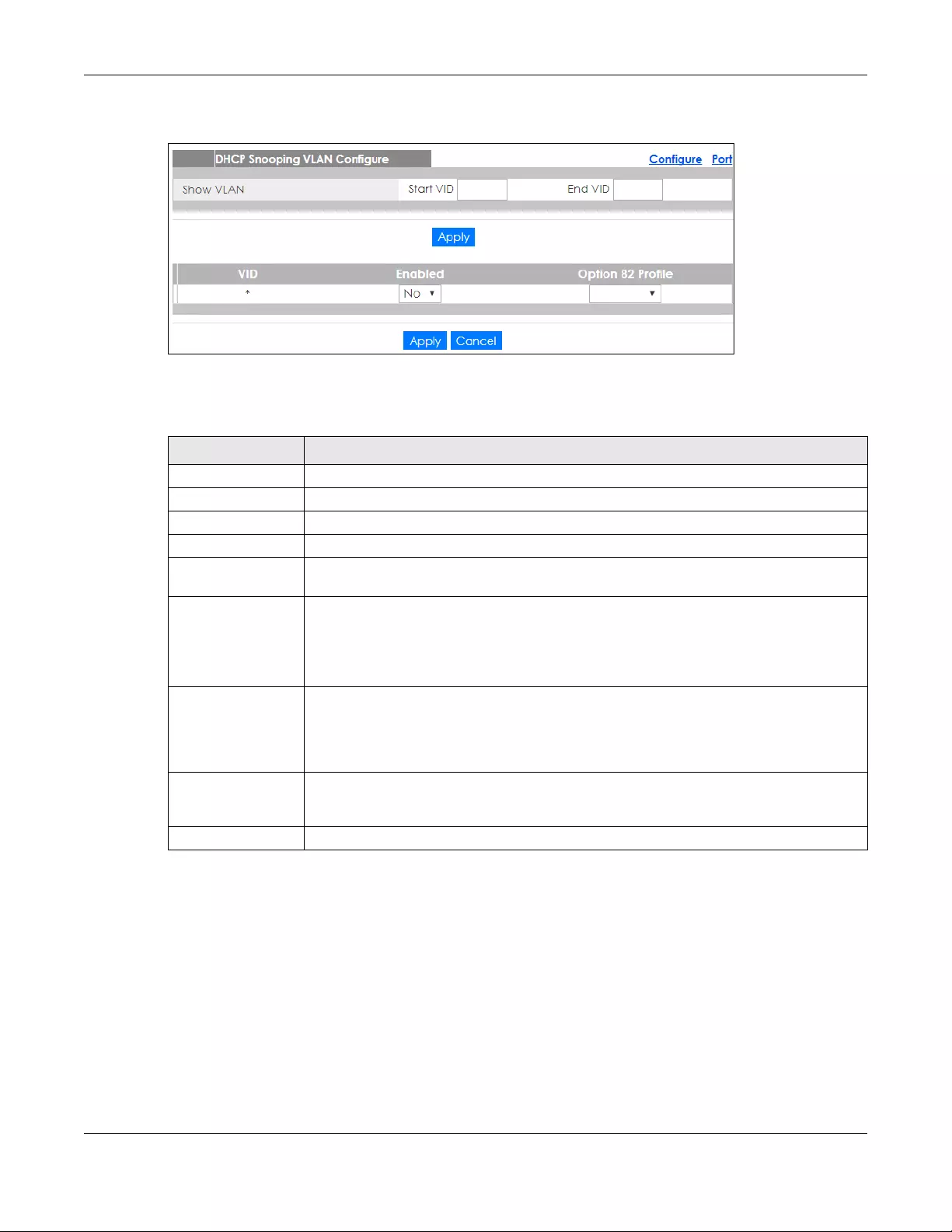
Chapter 26 IP Source Guard
GS1920v2 Series User’s Guide
246
Figure 174 Advanced Application > IP Source Guard > IPv4 Source Guard Setup > DHCP Snooping >
Configure > VLAN
The following table describes the labels in this screen.
26.6.3 DHCP Snooping VLAN Port Configure
Use this screen to apply a different DHCP option 82 profile to certain ports in a VLAN. To open this screen,
click Advanced Application > IP Source Guard > IPv4 Source Guard Setup > DHCP Snooping > Configure
> VLAN > Port.
Table 105 Advanced Application > IP Source Guard > IPv4 Source Guard Setup > DHCP Snooping >
Configure > VLAN
LABEL DESCRIPTION
Show VLAN Use this section to specify the VLANs you want to manage in the section below.
Start VID Enter the lowest VLAN ID you want to manage in the section below.
End VID Enter the highest VLAN ID you want to manage in the section below.
Apply Click this to display the specified range of VLANs in the section below.
VID This field displays the VLAN ID of each VLAN in the range specified above. If you configure
the * VLAN, the settings are applied to all VLANs.
Enabled Select Yes to enable DHCP snooping on the VLAN. You still have to enable DHCP snooping
on the Switch and specify trusted ports.
Note: If DHCP is enabled and there are no trusted ports, DHCP requests will not
succeed.
Option 82 Profile Select a pre-defined DHCP option 82 profile that the Switch applies to all ports in the
specified VLAN(s). The Switch adds the information (such as slot number, port number, VLAN
ID and/or system name) specified in the profile to DHCP requests that it broadcasts to the
DHCP VLAN, if specified, or VLAN. You can specify the DHCP VLAN in the DHCP Snooping
Configure screen (see Section 26.6 on page 242).
Apply Click Apply to save your changes to the Switch’s run-time memory. The Switch loses these
changes if it is turned off or loses power, so use the Save link on the top navigation panel to
save your changes to the non-volatile memory when you are done configuring.
Cancel Click this to reset the values in this screen to their last-saved values.
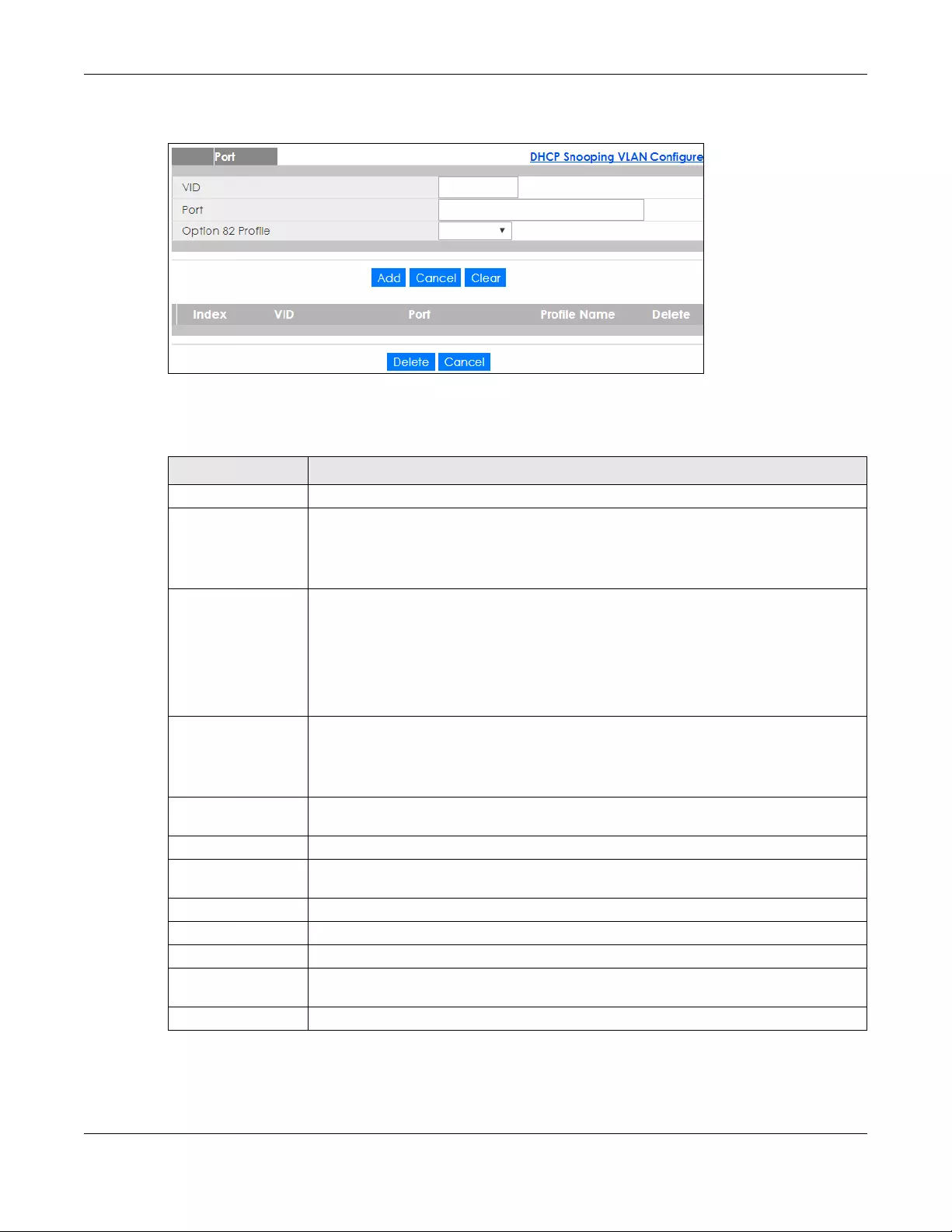
Chapter 26 IP Source Guard
GS1920v2 Series User’s Guide
247
Figure 175 Advanced Application > IP Source Guard > IPv4 Source Guard Setup > DHCP Snooping >
Configure > VLAN > Port
The following table describes the labels in this screen.
Table 106 Advanced Application > IP Source Guard > IPv4 Source Guard Setup > DHCP Snooping >
Configure > VLAN > Port
LABEL DESCRIPTION
VID Enter the ID number of the VLAN you want to configure here.
Port Enter the number of port(s) to which you want to apply the specified DHCP option 82
profile.
You can enter multiple ports separated by (no space) comma (,) or hyphen (-). For
example, enter “3-5” for ports 3, 4, and 5. Enter “3,5,7” for ports 3, 5, and 7.
Option 82 Profile Select a pre-defined DHCP option 82 profile that the Switch applies to the specified port(s)
in this VLAN. The Switch adds the information (such as slot number, port number, VLAN ID
and/or system name) specified in the profile to DHCP requests that it broadcasts to the
DHCP VLAN, if specified, or VLAN. You can specify the DHCP VLAN in the DHCP Snooping
Configure screen (see Section 26.6 on page 242).
The profile you select here has priority over the one you select in the DHCP Snooping >
Configure > VLAN screen.
Add Click this to create a new entry or to update an existing one.
This saves your changes to the Switch’s run-time memory. The Switch loses these changes if
it is turned off or loses power, so use the Save link on the top navigation panel to save your
changes to the non-volatile memory when you are done configuring.
Cancel Click this to reset the values above based on the last selected entry or, if not applicable, to
clear the fields above.
Clear Click Clear to reset the fields to the factory defaults.
Index This field displays a sequential number for each entry. Click an index number to change the
settings.
VID This field displays the VLAN to which the port(s) belongs.
Port This field displays the port(s) to which the Switch applies the settings.
Profile Name This field displays the DHCP option 82 profile that the Switch applies to the port(s).
Delete Select the entry(ies) that you want to remove in the Delete column, then click the Delete
button to remove the selected entry(ies) from the table.
Cancel Click this to clear the Delete check boxes above.
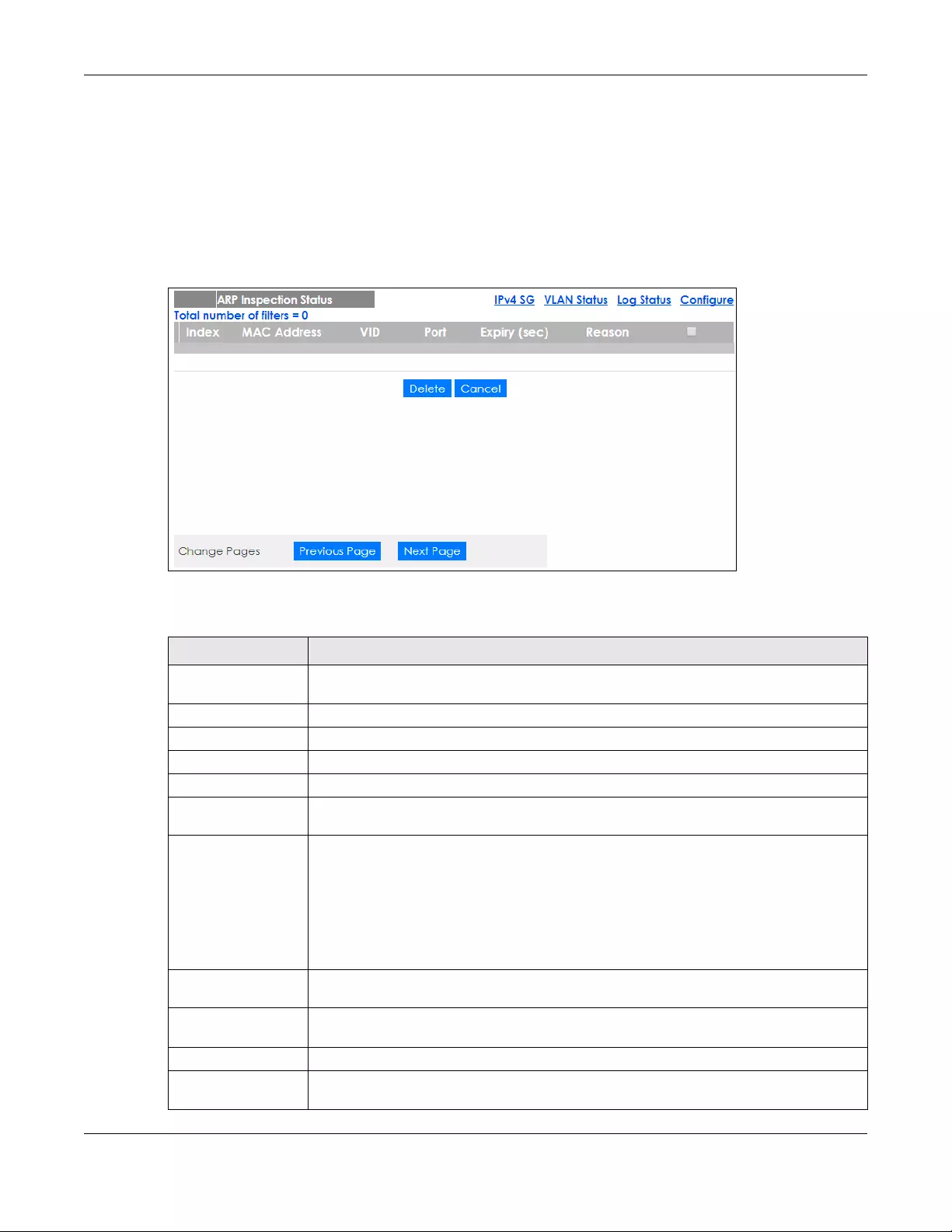
Chapter 26 IP Source Guard
GS1920v2 Series User’s Guide
248
26.7 ARP Inspection Status
Use this screen to look at the current list of MAC address filters that were created because the Switch
identified an unauthorized ARP packet. When the Switch identifies an unauthorized ARP packet, it
automatically creates a MAC address filter to block traffic from the source MAC address and source
VLAN ID of the unauthorized ARP packet. To open this screen, click Advanced Application > IP Source
Guard > IPv4 Source Guard Setup > ARP Inspection.
Figure 176 Advanced Application > IP Source Guard > IPv4 Source Guard Setup > ARP Inspection
The following table describes the labels in this screen.
Table 107 Advanced Application > IP Source Guard > IPv4 Source Guard Setup > ARP Inspection
LABEL DESCRIPTION
Total number of filters This field displays the current number of MAC address filters that were created because the
Switch identified unauthorized ARP packets.
Index This field displays a sequential number for each MAC address filter.
MAC Address This field displays the source MAC address in the MAC address filter.
VID This field displays the source VLAN ID in the MAC address filter.
Port This field displays the source port of the discarded ARP packet.
Expiry (sec) This field displays how long (in seconds) the MAC address filter remains in the Switch. You
can also delete the record manually (Delete).
Reason This field displays the reason the ARP packet was discarded.
MAC+VLAN: The MAC address and VLAN ID were not in the binding table.
IP: The MAC address and VLAN ID were in the binding table, but the IP address was not
valid.
Port: The MAC address, VLAN ID, and IP address were in the binding table, but the port
number was not valid.
Select an entry’s check box to select a specific entry. Otherwise, select the check box in
the table heading row to select all entries.
Delete Check the entry(ies) that you want to remove and then click Delete to remove the selected
entry(ies) from the summary table.
Cancel Click Cancel to clear the check boxes.
Change Pages Click Previous Page or Next Page to show the previous/next screen if all status information
cannot be seen in one screen.
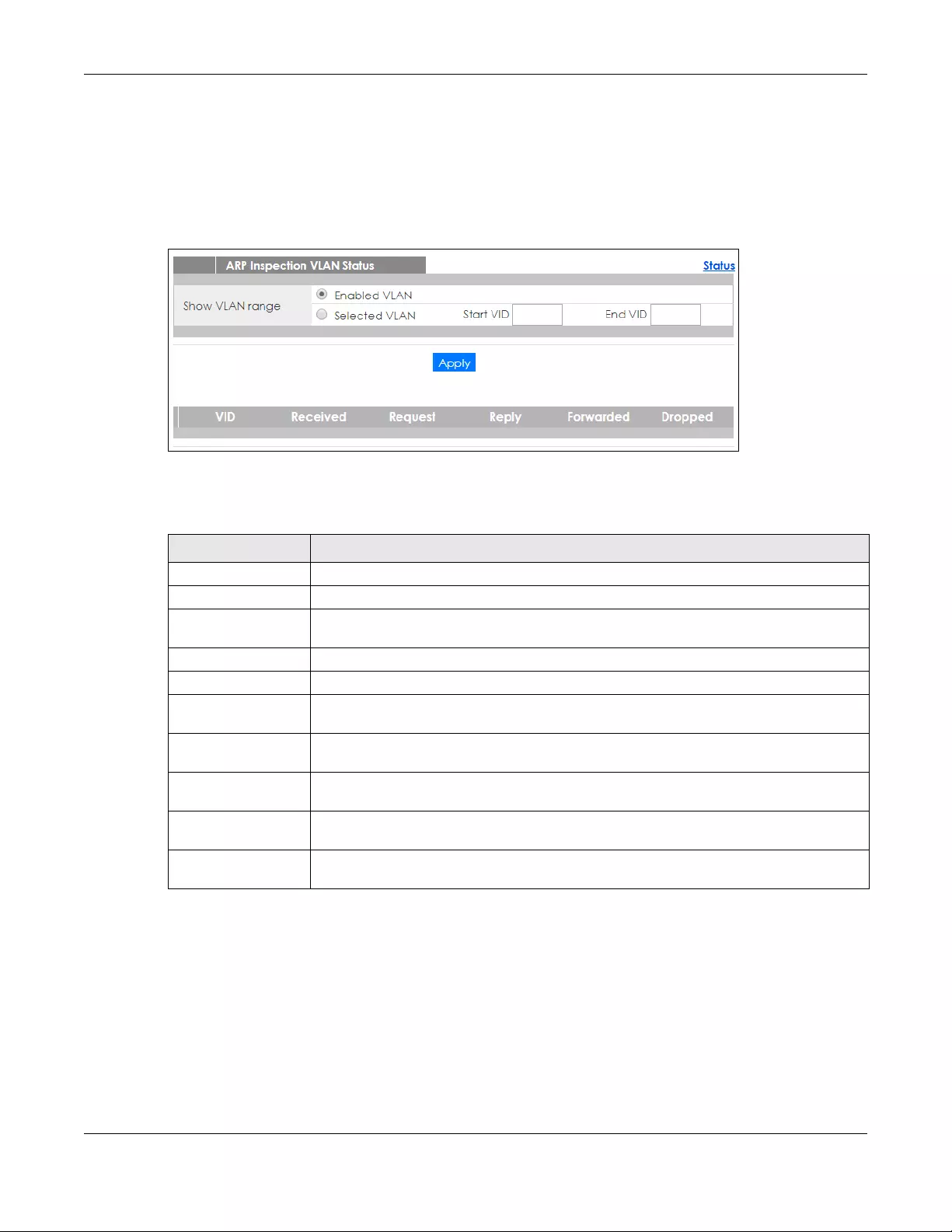
Chapter 26 IP Source Guard
GS1920v2 Series User’s Guide
249
26.8 ARP Inspection VLAN Status
Use this screen to look at various statistics about ARP packets in each VLAN. To open this screen, click
Advanced Application > IP Source Guard > IPv4 Source Guard Setup > ARP Inspection > VLAN Status.
Figure 177 Advanced Application > IP Source Guard > IPv4 Source Guard Setup > ARP Inspection >
VLAN Status
The following table describes the labels in this screen.
26.9 ARP Inspection Log Status
Use this screen to look at log messages that were generated by ARP packets and that have not been
sent to the syslog server yet. To open this screen, click Advanced Application > IP Source Guard > IPv4
Source Guard Setup > ARP Inspection > Log Status.
Table 108 Advanced Application > IP Source Guard > IPv4 Source Guard Setup > ARP Inspection >
VLAN Status
LABEL DESCRIPTION
Show VLAN range Use this section to specify the VLANs you want to look at in the section below.
Enabled VLAN Select this to look at all the VLANs on which ARP inspection is enabled in the section below.
Selected VLAN Select this to look at all the VLANs in a specific range in the section below. Then, enter the
lowest VLAN ID (Start VID) and the highest VLAN ID (End VID) you want to look at.
Apply Click this to display the specified range of VLANs in the section below.
VID This field displays the VLAN ID of each VLAN in the range specified above.
Received This field displays the total number of ARP packets received from the VLAN since the Switch
last restarted.
Request This field displays the total number of ARP Request packets received from the VLAN since
the Switch last restarted.
Reply This field displays the total number of ARP Reply packets received from the VLAN since the
Switch last restarted.
Forwarded This field displays the total number of ARP packets the Switch forwarded for the VLAN since
the Switch last restarted.
Dropped This field displays the total number of ARP packets the Switch discarded for the VLAN since
the Switch last restarted.

Chapter 26 IP Source Guard
GS1920v2 Series User’s Guide
250
Figure 178 Advanced Application > IP Source Guard > IPv4 Source Guard Setup > ARP Inspection > Log
Status
The following table describes the labels in this screen.
Table 109 Advanced Application > IP Source Guard > IPv4 Source Guard Setup > ARP Inspection > Log
Status
LABEL DESCRIPTION
Clearing log status
table
Click Apply to remove all the log messages that were generated by ARP packets and
that have not been sent to the syslog server yet.
Total number of logs This field displays the number of log messages that were generated by ARP packets and
that have not been sent to the syslog server yet. If one or more log messages are
dropped due to unavailable buffer, there is an entry called overflow with the current
number of dropped log messages.
Index This field displays a sequential number for each log message.
Port This field displays the source port of the ARP packet.
VID This field displays the source VLAN ID of the ARP packet.
Sender MAC This field displays the source MAC address of the ARP packet.
Sender IP This field displays the source IP address of the ARP packet.
Num Pkts This field displays the number of ARP packets that were consolidated into this log
message. The Switch consolidates identical log messages generated by ARP packets in
the log consolidation interval into one log message. You can configure this interval in the
ARP Inspection Configure screen. See Section 26.10 on page 251.
Reason This field displays the reason the log message was generated.
dhcp deny: An ARP packet was discarded because it violated a dynamic binding with
the same MAC address and VLAN ID.
static deny: An ARP packet was discarded because it violated a static binding with the
same MAC address and VLAN ID.
deny: An ARP packet was discarded because there were no bindings with the same
MAC address and VLAN ID.
dhcp permit: An ARP packet was forwarded because it matched a dynamic binding.
static permit: An ARP packet was forwarded because it matched a static binding.
In the ARP Inspection VLAN Configure screen, you can configure the Switch to generate
log messages when ARP packets are discarded or forwarded based on the VLAN ID of
the ARP packet. See Section 26.10.2 on page 253.
Time This field displays when the log message was generated.
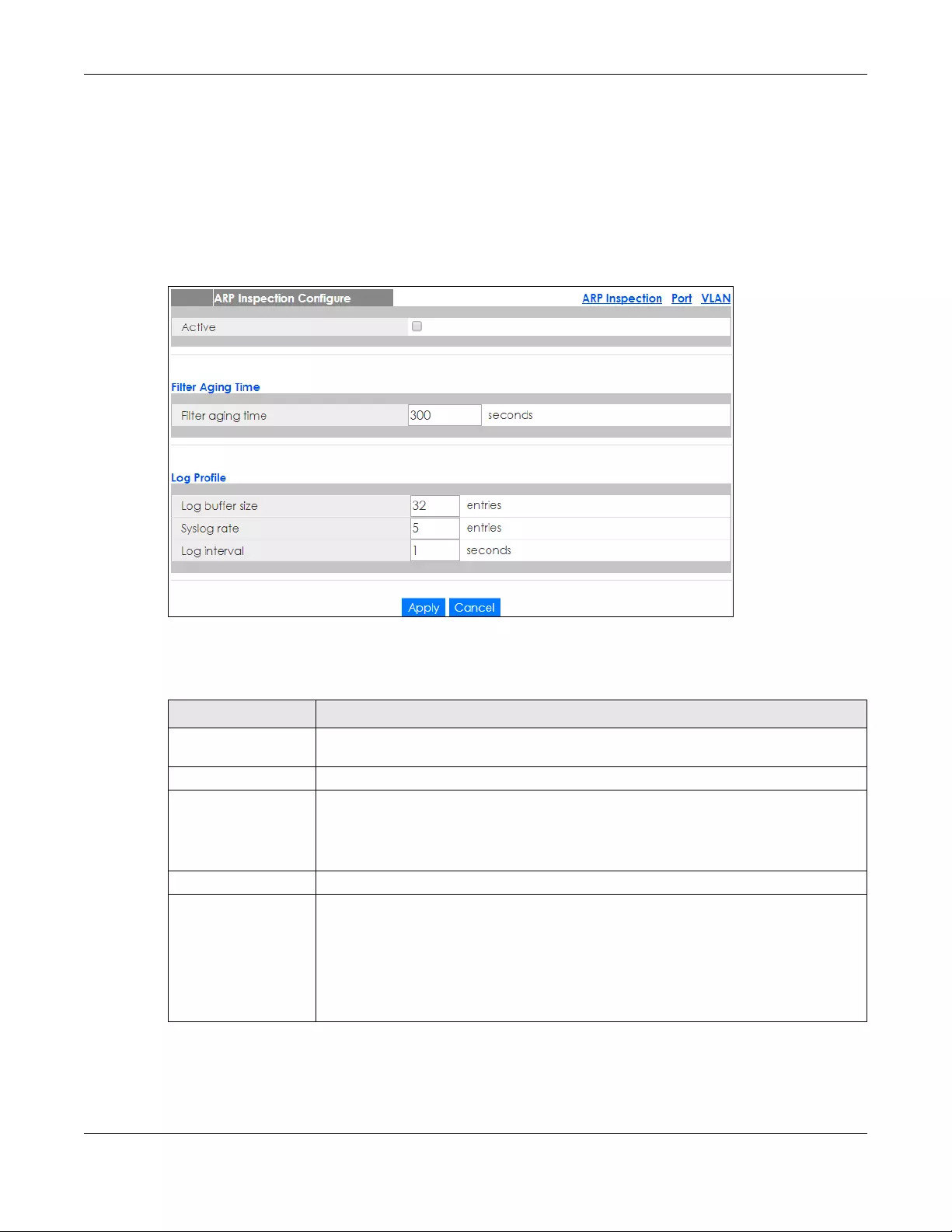
Chapter 26 IP Source Guard
GS1920v2 Series User’s Guide
251
26.10 ARP Inspection Configure
Use this screen to enable ARP inspection on the Switch. You can also configure the length of time the
Switch stores records of discarded ARP packets and global settings for the ARP inspection log. To open
this screen, click Advanced Application > IP Source Guard > IPv4 Sour ce Guard Setup > ARP Inspection >
Configure.
Figure 179 Advanced Application > IP Source Guard > IPv4 Source Guard Setup > ARP Inspection >
Configure
The following table describes the labels in this screen.
Table 110 Advanced Application > IP Source Guard > IPv4 Source Guard Setup > ARP Inspection >
Configure
LABEL DESCRIPTION
Active Select this to enable ARP inspection on the Switch. You still have to enable ARP inspection
on specific VLAN and specify trusted ports.
Filter Aging Time
Filter aging time This setting has no effect on existing MAC address filters.
Enter how long (1~2147483647 seconds) the MAC address filter remains in the Switch after
the Switch identifies an unauthorized ARP packet. The Switch automatically deletes the
MAC address filter afterwards. Enter 0 if you want the MAC address filter to be permanent.
Log Profile
Log buffer size Enter the maximum number (1~1024) of log messages that were generated by ARP
packets and have not been sent to the syslog server yet. Make sure this number is
appropriate for the specified Syslog rate and Log interval.
If the number of log messages in the Switch exceeds this number, the Switch stops
recording log messages and simply starts counting the number of entries that were
dropped due to unavailable buffer. Click Clearing log status table in the ARP Inspection
Log Status screen to clear the log and reset this counter. See Section 26.9 on page 249.
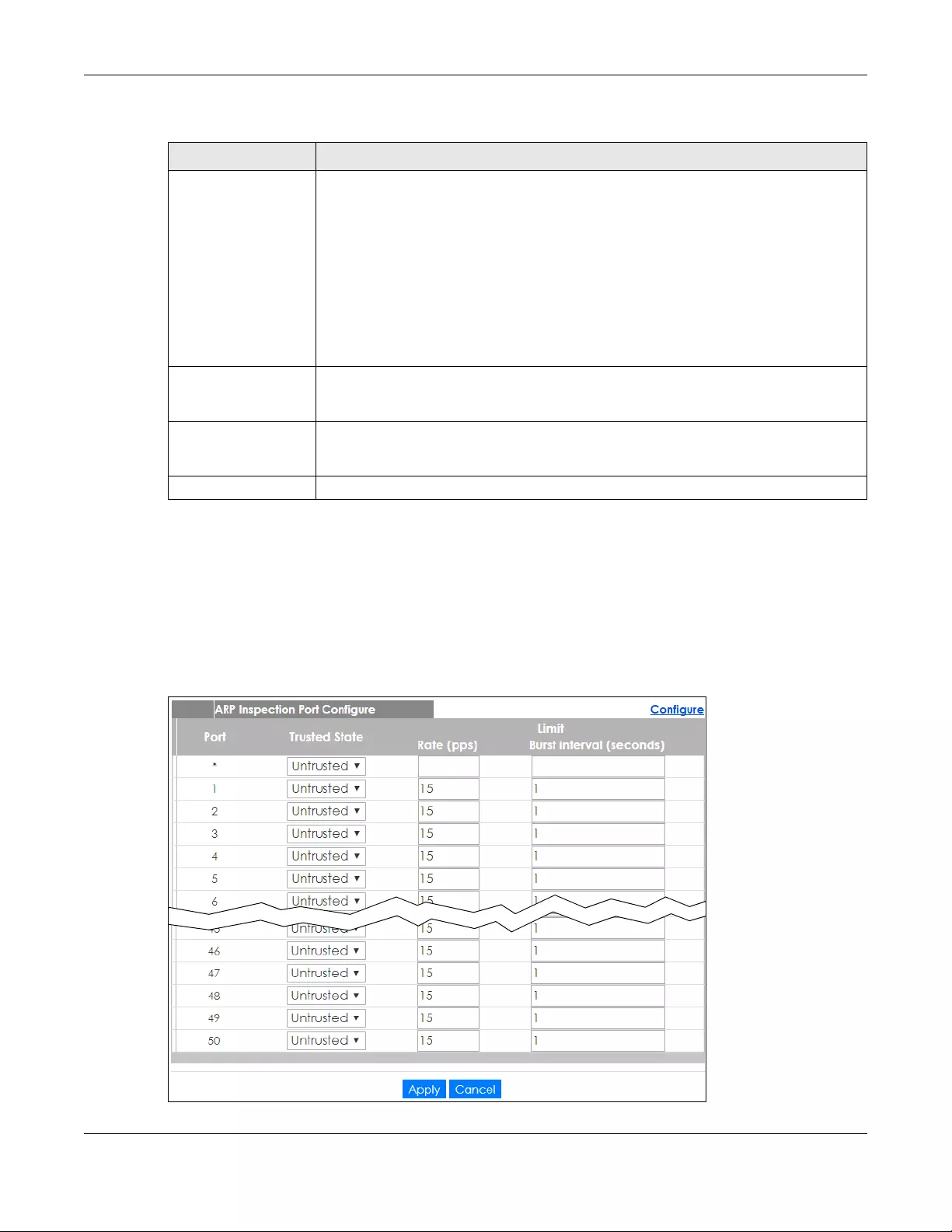
Chapter 26 IP Source Guard
GS1920v2 Series User’s Guide
252
26.10.1 ARP Inspection Port Configure
Use this screen to specify whether ports are trusted or untrusted ports for ARP inspection. You can also
specify the maximum rate at which the Switch receives ARP packets on each untrusted port. To open
this screen, click Advanced Application > IP Source Guard > IPv4 Sour ce Guard Setup > ARP Inspection >
Configure > Port.
Figure 180 Advanced Application > IP Source Guard > IPv4 Source Guard Setup > ARP Inspection >
Configure > Port
Syslog rate Enter the maximum number of syslog messages the Switch can send to the syslog server in
one batch. This number is expressed as a rate because the batch frequency is
determined by the Log Interval. You must configure the syslog server (Chapter 43 on page
372) to use this. Enter 0 if you do not want the Switch to send log messages generated by
ARP packets to the syslog server.
The relationship between Syslog rate and Log interval is illustrated in the following
examples:
• 4 invalid ARP packets per second, Syslog rate is 5, Log interval is 1: the Switch sends 4
syslog messages every second.
• 6 invalid ARP packets per second, Syslog rate is 5, Log interval is 2: the Switch sends 5
syslog messages every 2 seconds.
Log interval Enter how often (1-86400 seconds) the Switch sends a batch of syslog messages to the
syslog server. Enter 0 if you want the Switch to send syslog messages immediately. See
Syslog rate for an example of the relationship between Syslog rate and Log interval.
Apply Click Apply to save your changes to the Switch’s run-time memory. The Switch loses these
changes if it is turned off or loses power, so use the Save link on the top navigation panel
to save your changes to the non-volatile memory when you are done configuring.
Cancel Click this to reset the values in this screen to their last-saved values.
Table 110 Advanced Application > IP Source Guard > IPv4 Source Guard Setup > ARP Inspection >
Configure (continued)
LABEL DESCRIPTION

Chapter 26 IP Source Guard
GS1920v2 Series User’s Guide
253
The following table describes the labels in this screen.
26.10.2 ARP Inspection VLAN Configure
Use this screen to enable ARP inspection on each VLAN and to specify when the Switch generates log
messages for receiving ARP packets from each VLAN. To open this screen, click Advanced Application
> IP Source Guard > IPv4 Source Guard Setup > ARP Inspection > Configure > VLAN.
Table 111 Advanced Application > IP Source Guard > IPv4 Source Guard Setup > ARP Inspection >
Configure > Port
LABEL DESCRIPTION
Port This field displays the port number. If you configure the * port, the settings are applied
to all of the ports.
* Settings in this row apply to all ports.
Use this row only if you want to make some settings the same for all ports. Use this row
first to set the common settings and then make adjustments on a port-by-port basis.
Note: Changes in this row are copied to all the ports as soon as you make
them.
Trusted State Select whether this port is a trusted port (Trusted) or an untrusted port (Untrusted).
The Switch does not discard ARP packets on trusted ports for any reason.
The Switch discards ARP packets on untrusted ports in the following situations:
• The sender’s information in the ARP packet does not match any of the current
bindings.
• The rate at which ARP packets arrive is too high. You can specify the maximum
rate at which ARP packets can arrive on untrusted ports.
Limit These settings have no effect on trusted ports.
Rate (pps) Specify the maximum rate (1-2048 packets per second) at which the Switch receives
ARP packets from each port. The Switch discards any additional ARP packets. Enter 0
to disable this limit.
Burst interval
(seconds) The burst interval is the length of time over which the rate of ARP packets is monitored
for each port. For example, if the rate is 15 pps and the burst interval is 1 second, then
the Switch accepts a maximum of 15 ARP packets in every one-second interval. If the
burst interval is 5 seconds, then the Switch accepts a maximum of 75 ARP packets in
every five-second interval.
Enter the length (1-15 seconds) of the burst interval.
Apply Click Apply to save your changes to the Switch’s run-time memory. The Switch loses
these changes if it is turned off or loses power, so use the Save link on the top
navigation panel to save your changes to the non-volatile memory when you are
done configuring.
Cancel Click this to reset the values in this screen to their last-saved values.
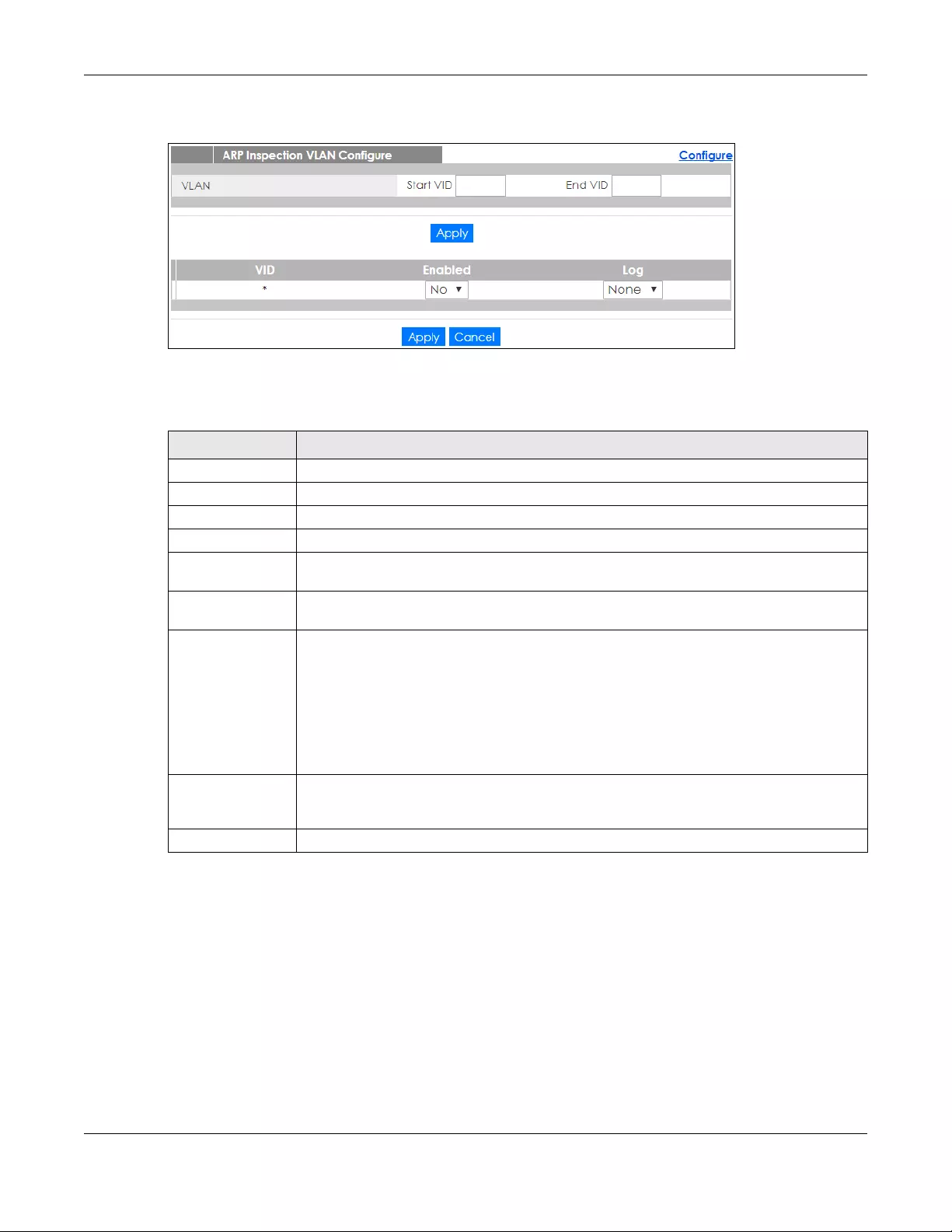
Chapter 26 IP Source Guard
GS1920v2 Series User’s Guide
254
Figure 181 Advanced Application > IP Source Guard > IPv4 Source Guard Setup > ARP Inspection >
Configure > VLAN
The following table describes the labels in this screen.
26.11 Technical Reference
This section provides technical background information on the topics discussed in this chapter.
26.11.1 DHCP Snooping Overview
Use DHCP snooping to filter unauthorized DHCP packets on the network and to build the binding table
dynamically. This can prevent clients from getting IP addresses from unauthorized DHCP servers.
Table 112 Advanced Application > IP Source Guard > IPv4 Source Guard Setup > ARP Inspection >
Configure > VLAN
LABEL DESCRIPTION
VLAN Use this section to specify the VLANs you want to manage in the section below.
Start VID Enter the lowest VLAN ID you want to manage in the section below.
End VID Enter the highest VLAN ID you want to manage in the section below.
Apply Click this to display the specified range of VLANs in the section below.
VID This field displays the VLAN ID of each VLAN in the range specified above. If you configure the
* VLAN, the settings are applied to all VLANs.
Enabled Select Yes to enable ARP inspection on the VLAN. Select No to disable ARP inspection on the
VLAN.
Log Specify when the Switch generates log messages for receiving ARP packets from the VLAN.
None: The Switch does not generate any log messages when it receives an ARP packet from
the VLAN.
Deny: The Switch generates log messages when it discards an ARP packet from the VLAN.
Permit: The Switch generates log messages when it forwards an ARP packet from the VLAN.
All: The Switch generates log messages every time it receives an ARP packet from the VLAN.
Apply Click Apply to save your changes to the Switch’s run-time memory. The Switch loses these
changes if it is turned off or loses power, so use the Save link on the top navigation panel to
save your changes to the non-volatile memory when you are done configuring.
Cancel Click this to reset the values in this screen to their last-saved values.

Chapter 26 IP Source Guard
GS1920v2 Series User’s Guide
255
26.11.1.1 Trusted vs. Untrusted Ports
Every port is either a trusted port or an untrusted port for DHCP snooping. This setting is independent of
the trusted/untrusted setting for ARP inspection. You can also specify the maximum number for DHCP
packets that each port (trusted or untrusted) can receive each second.
Trusted ports are connected to DHCP servers or other switches. The Switch discards DHCP packets from
trusted ports only if the rate at which DHCP packets arrive is too high. The Switch learns dynamic
bindings from trusted ports.
Note: If DHCP is enabled and there are no trusted ports, DHCP requests will not succeed.
Untrusted ports are connected to subscribers. The Switch discards DHCP packets from untrusted ports in
the following situations:
• The packet is a DHCP server packet (for example, OFFER, ACK, or NACK).
• The source MAC address and source IP address in the packet do not match any of the current
bindings.
• The packet is a RELEASE or DECLINE packet, and the source MAC address and source port do not
match any of the current bindings.
• The rate at which DHCP packets arrive is too high.
26.11.1.2 DHCP Snooping Database
The Switch stores the binding table in volatile memory. If the Switch restarts, it loads static bindings from
permanent memory but loses the dynamic bindings, in which case the devices in the network have to
send DHCP requests again. As a result, it is recommended you configure the DHCP snooping database.
The DHCP snooping database maintains the dynamic bindings for DHCP snooping and ARP inspection
in a file on an external TFTP server. If you set up the DHCP snooping database, the Switch can reload the
dynamic bindings from the DHCP snooping database after the Switch restarts.
You can configure the name and location of the file on the external TFTP server. The file has the following
format:
Figure 182 DHCP Snooping Database File Format
The <initial-checksum> helps distinguish between the bindings in the latest update and the bindings
from previous updates. Each binding consists of 72 bytes, a space, and another checksum that is used
to validate the binding when it is read. If the calculated checksum is not equal to the checksum in the
file, that binding and all others after it are ignored.
<initial-checksum>
TYPE DHCP-SNOOPING
VERSION 1
BEGIN
<binding-1> <checksum-1>
<binding-2> <checksum-1-2>
...
...
<binding-n> <checksum-1-2-..-n>
END
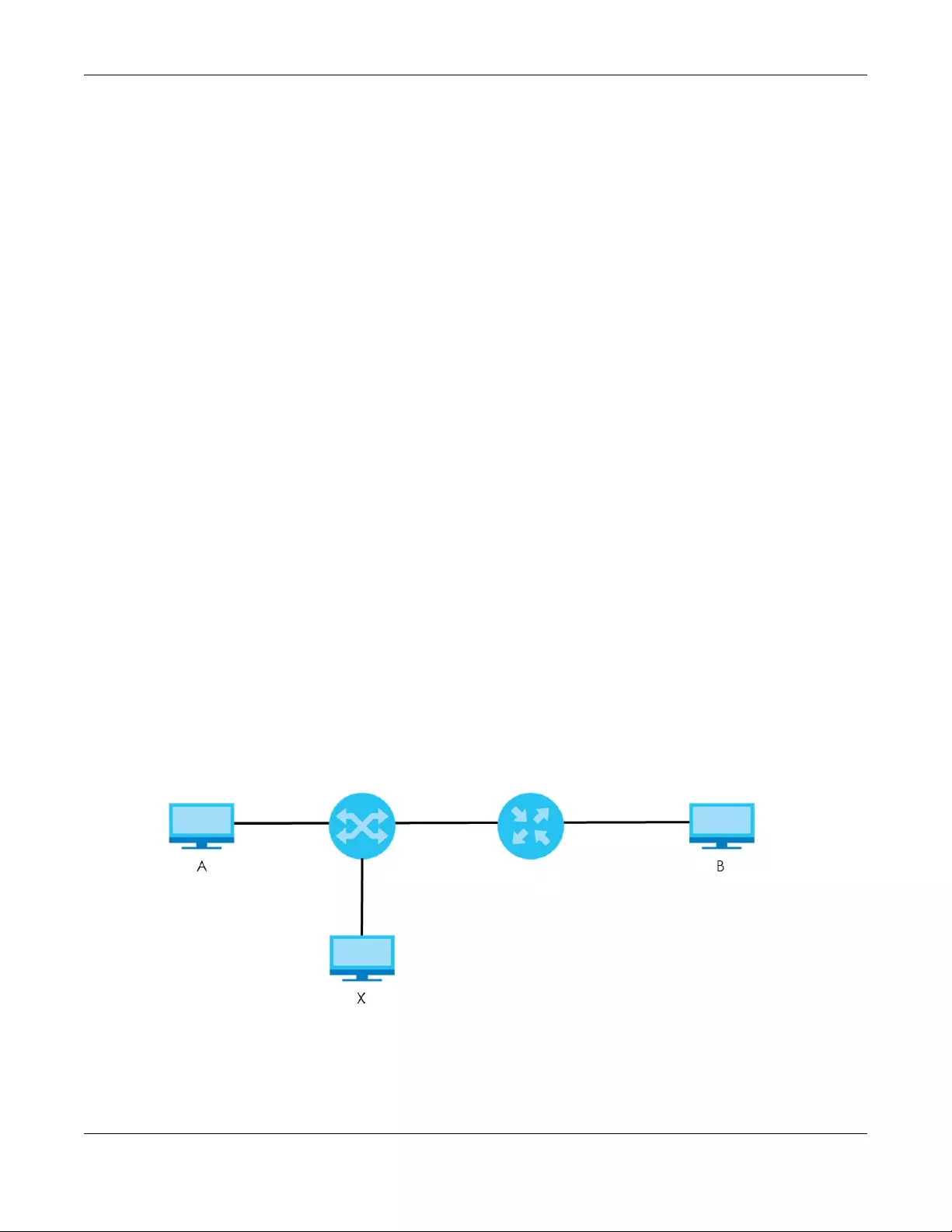
Chapter 26 IP Source Guard
GS1920v2 Series User’s Guide
256
26.11.1.3 DHCP Relay Option 82 Information
The Switch can add information to DHCP requests that it does not discard. This provides the DHCP server
more information about the source of the requests. The Switch can add the following information:
• Slot ID (1 byte), port ID (1 byte), and source VLAN ID (2 bytes)
• System name (up to 32 bytes)
This information is stored in an Agent Information field in the option 82 field of the DHCP headers of client
DHCP request frames. See Chapter 37 on page 323 for more information about DHCP relay option 82.
When the DHCP server responds, the Switch removes the information in the Agent Information field
before forwarding the response to the original source.
You can configure this setting for each source VLAN. This setting is independent of the DHCP relay
settings (Chapter 37 on page 323).
26.11.1.4 Configuring DHCP Snooping
Follow these steps to configure DHCP snooping on the Switch.
1Enable DHCP snooping on the Switch.
2Enable DHCP snooping on each VLAN, and configure DHCP relay option 82.
3Configure trusted and untrusted ports, and specify the maximum number of DHCP packets that each
port can receive per second.
4Configure static bindings.
26.11.2 ARP Inspection Overview
Use ARP inspection to filter unauthorized ARP packets on the network. This can prevent many kinds of
man-in-the-middle attacks, such as the one in the following example.
Figure 183 Example: Man-in-the-middle Attack
In this example, computer B tries to establish a connection with computer A. Computer X is in the same
broadcast domain as computer A and intercepts the ARP request for computer A. Then, computer X
does the following things:
• It pretends to be computer A and responds to computer B.

Chapter 26 IP Source Guard
GS1920v2 Series User’s Guide
257
• It pretends to be computer B and sends a message to computer A.
As a result, all the communication between computer A and computer B passes through computer X.
Computer X can read and alter the information passed between them.
26.11.2.1 ARP Inspection and MAC Address Filters
When the Switch identifies an unauthorized ARP packet, it automatically creates a MAC address filter to
block traffic from the source MAC address and source VLAN ID of the unauthorized ARP packet. You
can configure how long the MAC address filter remains in the Switch.
These MAC address filters are different than regular MAC address filters (Chapter 12 on page 133).
• They are stored only in volatile memory.
• They do not use the same space in memory that regular MAC address filters use.
• They appear only in the ARP Inspection screens and commands, not in the MAC Address Filter screens
and commands.
26.11.2.2 Trusted vs. Untrusted Ports
Every port is either a trusted port or an untrusted port for ARP inspection. This setting is independent of
the trusted/untrusted setting for DHCP snooping. You can also specify the maximum rate at which the
Switch receives ARP packets on untrusted ports.
The Switch does not discard ARP packets on trusted ports for any reason.
The Switch discards ARP packets on untrusted ports in the following situations:
• The sender’s information in the ARP packet does not match any of the current bindings.
• The rate at which ARP packets arrive is too high.
26.11.2.3 Syslog
The Switch can send syslog messages to the specified syslog server (Chapter 43 on page 372) when it
forwards or discards ARP packets. The Switch can consolidate log messages and send log messages in
batches to make this mechanism more efficient.
26.11.2.4 Configuring ARP Inspection
Follow these steps to configure ARP inspection on the Switch.
1Configure DHCP snooping. See Section 26.11.1.4 on page 256.
Note: It is recommended you enable DHCP snooping at least one day before you enable
ARP inspection so that the Switch has enough time to build the binding table.
2Enable ARP inspection on each VLAN.
3Configure trusted and untrusted ports, and specify the maximum number of ARP packets that each port
can receive per second.
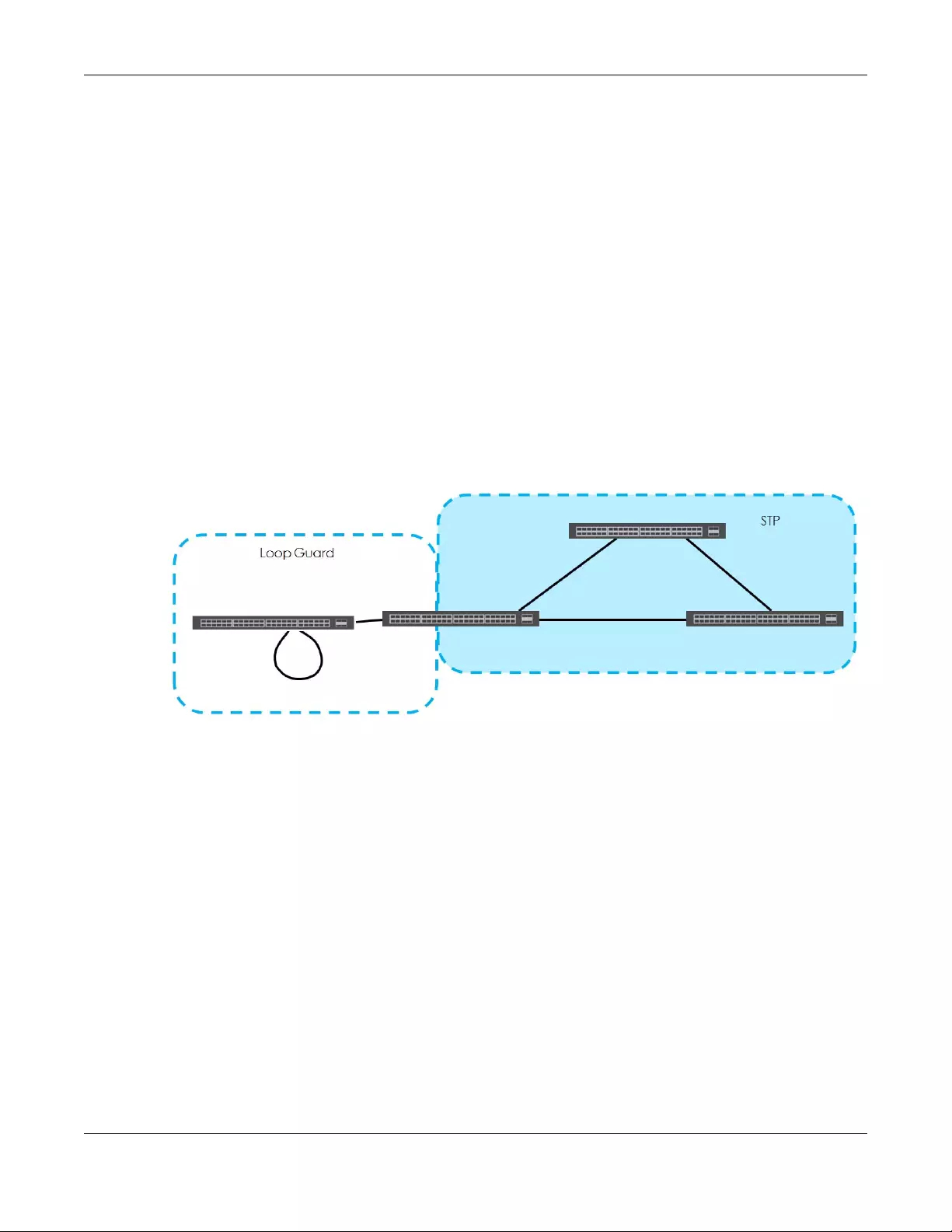
Chapter 27 Loop Guard
GS1920v2 Series User’s Guide
258
CHAPTER 27
Loop Guard
27.1 Loop Guard Overview
This chapter shows you how to configure the Switch to guard against loops on the edge of your network.
Loop guard allows you to configure the Switch to shut down a port if it detects that packets sent out on
that port loop back to the Switch. While you can use Spanning Tree Protocol (STP) to prevent loops in the
core of your network. STP cannot prevent loops that occur on the edge of your network.
Figure 184 Loop Guard vs. STP
Refer to Section 27.1.2 on page 258 for more information.
27.1.1 What You Can Do
Use the Loop Guard screen (Section 27.2 on page 260) to enable loop guard on the Switch and in
specific ports.
27.1.2 What You Need to Know
Loop guard is designed to handle loop problems on the edge of your network. This can occur when a
port is connected to a Switch that is in a loop state. Loop state occurs as a result of human error. It
happens when two ports on a switch are connected with the same cable. When a switch in loop state
sends out broadcast messages the messages loop back to the switch and are re-broadcast again and
again causing a broadcast storm.
If a switch (not in loop state) connects to a switch in loop state, then it will be affected by the switch in
loop state in the following way:
• It will receive broadcast messages sent out from the switch in loop state.
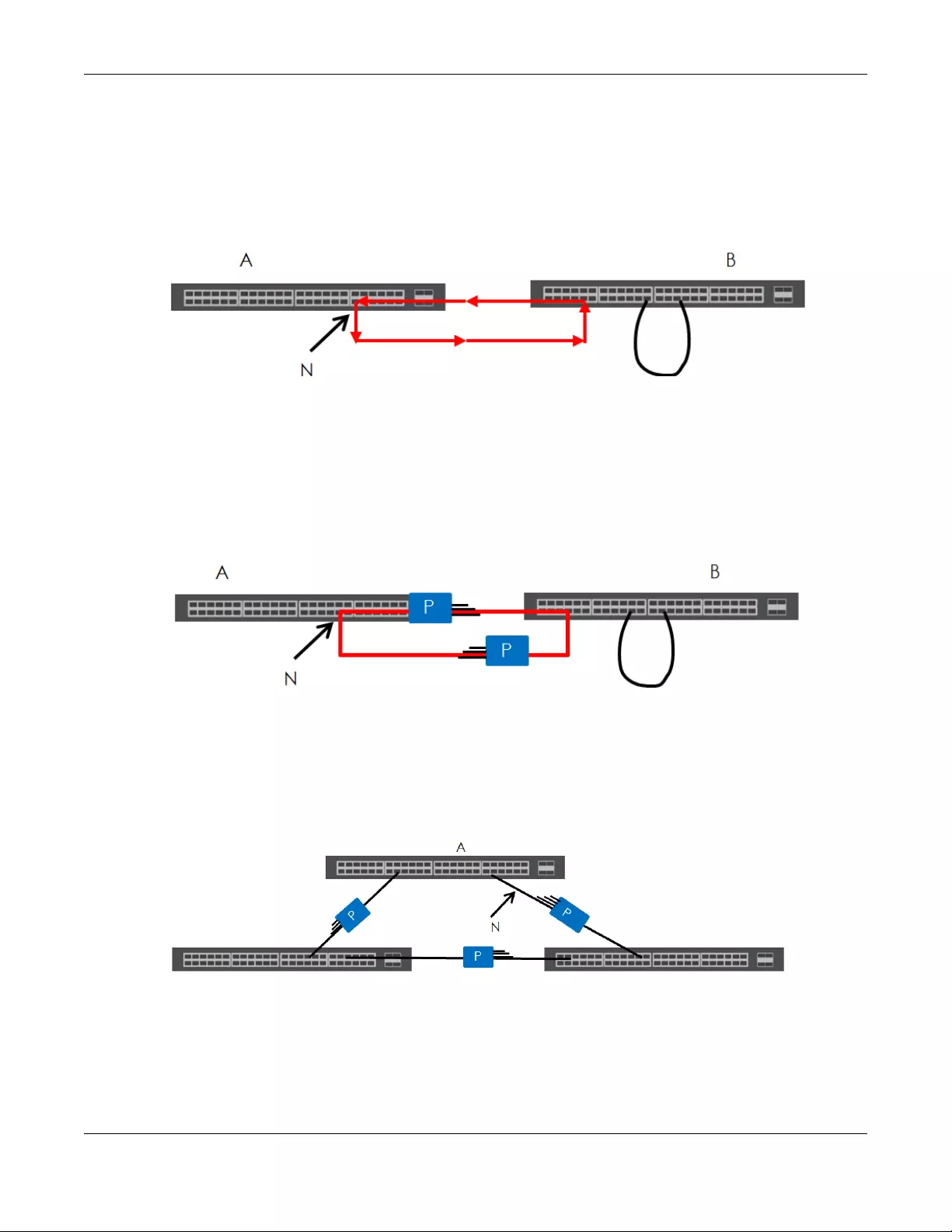
Chapter 27 Loop Guard
GS1920v2 Series User’s Guide
259
• It will receive its own broadcast messages that it sends out as they loop back. It will then re-broadcast
those messages again.
The following figure shows port N on switch A connected to switch B. Switch B is in loop state. When
broadcast or multicast packets leave port N and reach switch B, they are sent back to port N on A as
they are rebroadcast from B.
Figure 185 Switch in Loop State
The loop guard feature checks to see if a loop guard enabled port is connected to a switch in loop
state. This is accomplished by periodically sending a probe packet and seeing if the packet returns on
the same port. If this is the case, the Switch will shut down the port connected to the switch in loop state.
The following figure shows a loop guard enabled port N on switch A sending a probe packet P to switch
B. Since switch B is in loop state, the probe packet P returns to port N on A. The Switch then shuts down
port N to ensure that the rest of the network is not affected by the switch in loop state.
Figure 186 Loop Guard - Probe Packet
The Switch also shuts down port N if the probe packet returns to switch A on any other port. In other
words loop guard also protects against standard network loops. The following figure illustrates three
switches forming a loop. A sample path of the loop guard probe packet is also shown. In this example,
the probe packet is sent from port N and returns on another port. As long as loop guard is enabled on
port N. The Switch will shut down port N if it detects that the probe packet has returned to the Switch.
Figure 187 Loop Guard - Network Loop
Note: After resolving the loop problem on your network you can re-activate the disabled port
via the web configurator (see Section 8.7 on page 85).

Chapter 27 Loop Guard
GS1920v2 Series User’s Guide
260
27.2 Loop Guard Setup
Click Advanced Application > Loop Guard in the navigation panel to display the screen as shown.
Note: The loop guard feature can not be enabled on the ports that have Spanning Tree
Protocol (RSTP, MRSTP or MSTP) enabled.
Figure 188 Advanced Application > Loop Guard
The following table describes the labels in this screen.
Table 113 Advanced Application > Loop Guard
LABEL DESCRIPTION
Active Select this option to enable loop guard on the Switch.
The Switch generates syslog, internal log messages as well as SNMP traps when it shuts down a
port via the loop guard feature.
Port This field displays the port number.
* Settings in this row apply to all ports.
Use this row only if you want to make some settings the same for all ports. Use this row first to set
the common settings and then make adjustments on a port-by-port basis.
Note: Changes in this row are copied to all the ports as soon as you make them.
Active Select this check box to enable the loop guard feature on this port. The Switch sends probe
packets from this port to check if the switch it is connected to is in loop state. If the switch that
this port is connected is in loop state the Switch will shut down this port.
Clear this check box to disable the loop guard feature.

Chapter 27 Loop Guard
GS1920v2 Series User’s Guide
261
Apply Click Apply to save your changes to the Switch’s run-time memory. The Switch loses these
changes if it is turned off or loses power, so use the Save link on the top navigation panel to save
your changes to the non-volatile memory when you are done configuring.
Cancel Click Cancel to begin configuring this screen afresh.
Table 113 Advanced Application > Loop Guard (continued)
LABEL DESCRIPTION

Chapter 28 Layer 2 Protocol Tunneling
GS1920v2 Series User’s Guide
262
CHAPTER 28
Layer 2 Protocol Tunneling
28.1 Layer 2 Protocol Tunneling Overview
This chapter shows you how to configure layer 2 protocol tunneling on the Switch.
28.1.1 What You Can Do
Use the Layer 2 Protocol Tunnel screen (Section 28.2 on page 263) to enable layer 2 protocol tunneling
on the Switch and specify a MAC address with which the Switch uses to encapsulate the layer 2
protocol packets by replacing the destination MAC address in the packets.
28.1.2 What You Need to Know
Layer 2 protocol tunneling (L2PT) is used on the service provider's edge devices.
L2PT allows edge switches (1 and 2 in the following figure) to tunnel layer 2 STP (Spanning Tree Protocol),
CDP (Cisco Discovery Protocol) and VTP (VLAN Trunking Protocol) packets between customer switches
(A, B and C in the following figure) connected through the service provider’s network. The edge switch
encapsulates layer 2 protocol packets with a specific MAC address before sending them across the
service provider’s network to other edge switches.
Figure 189 Layer 2 Protocol Tunneling Network Scenario
In the following example, if you enable L2PT for STP, you can have switches A, B, C and D in the same
spanning tree, even though switch A is not directly connected to switches B, C and D. Topology change
information can be propagated throughout the service provider’s network.

Chapter 28 Layer 2 Protocol Tunneling
GS1920v2 Series User’s Guide
263
To emulate a point-to-point topology between two customer switches at different sites, such as A and B,
you can enable protocol tunneling on edge switches 1 and 2 for PAgP (Port Aggregation Protocol),
LACP or UDLD (UniDirectional Link Detection).
Figure 190 L2PT Network Example
28.1.2.1 Layer 2 Protocol Tunneling Mode
Each port can have two layer 2 protocol tunneling modes, Access and Tunnel.
• The Access port is an ingress port on the service provider's edge device (1 or 2 in Figure 190 on page
263) and connected to a customer switch (A or B). Incoming layer 2 protocol packets received on an
access port are encapsulated and forwarded to the tunnel ports.
• The Tunnel port is an egress port at the edge of the service provider's network and connected to
another service provider’s switch. Incoming encapsulated layer 2 protocol packets received on a
tunnel port are decapsulated and sent to an access port.
28.2 Configuring Layer 2 Protocol Tunneling
Click Advanced Application > Layer 2 Protocol Tunneling in the navigation panel to display the screen
as shown.
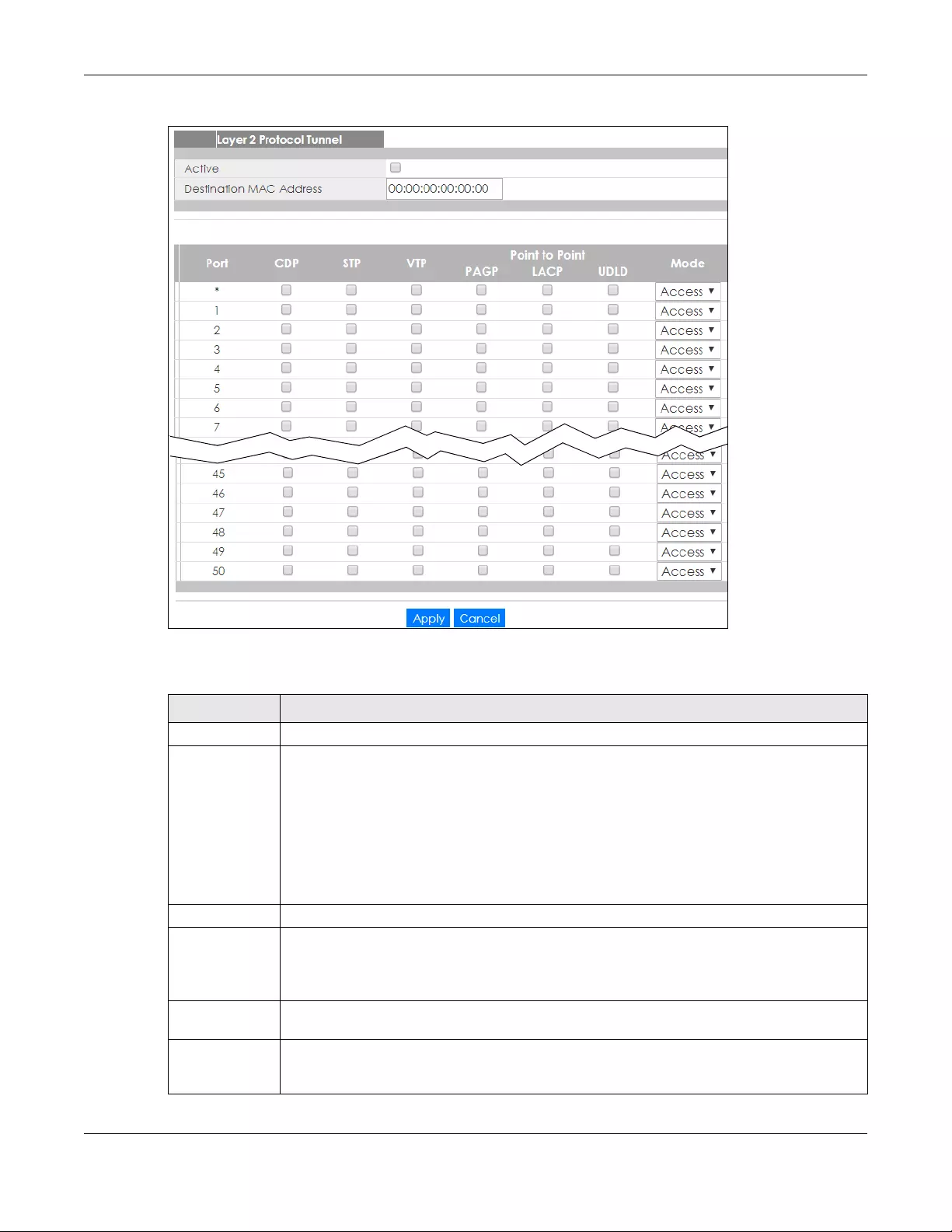
Chapter 28 Layer 2 Protocol Tunneling
GS1920v2 Series User’s Guide
264
Figure 191 Advanced Application > Layer 2 Protocol Tunneling
The following table describes the labels in this screen.
Table 114 Advanced Application > Layer 2 Protocol Tunneling
LABEL DESCRIPTION
Active Select this to enable layer 2 protocol tunneling on the Switch.
Destination
MAC Address
Specify a MAC address with which the Switch uses to encapsulate the layer 2 protocol packets
by replacing the destination MAC address in the packets.
Note: The MAC address can be either a unicast MAC address or multicast MAC
address. If you use a unicast MAC address, make sure the MAC address does
not exist in the address table of a switch on the service provider’s network.
Note: All the edge switches in the service provider’s network should be set to use the
same MAC address for encapsulation.
Port This field displays the port number.
* Use this row to make the setting the same for all ports. Use this row first and then make
adjustments on a port-by-port basis.
Note: Changes in this row are copied to all the ports as soon as you make them.
CDP Select this option to have the Switch tunnel CDP (Cisco Discovery Protocol) packets so that
other Cisco devices can be discovered through the service provider’s network.
STP Select this option to have the Switch tunnel STP (Spanning Tree Protocol) packets so that STP can
run properly across the service provider’s network and spanning trees can be set up based on
bridge information from all (local and remote) networks.

Chapter 28 Layer 2 Protocol Tunneling
GS1920v2 Series User’s Guide
265
VTP Select this option to have the Switch tunnel VTP (VLAN Trunking Protocol) packets so that all
customer switches can use consistent VLAN configuration through the service provider’s
network.
Point to Point The Switch supports PAgP (Port Aggregation Protocol), LACP (Link Aggregation Control
Protocol) and UDLD (UniDirectional Link Detection) tunneling for a point-to-point topology.
Both PAgP and UDLD are Cisco’s proprietary data link layer protocols. PAgP is similar to LACP
and used to set up a logical aggregation of Ethernet ports automatically. UDLD is to determine
the link’s physical status and detect a unidirectional link.
PAGP Select this option to have the Switch send PAgP packets to a peer to automatically negotiate
and build a logical port aggregation.
LACP Select this option to have the Switch send LACP packets to a peer to dynamically creates and
manages trunk groups.
UDLD Select this option to have the Switch send UDLD packets to a peer’s port it connected to
monitor the physical status of a link.
Mode Select Access to have the Switch encapsulate the incoming layer 2 protocol packets and
forward them to the tunnel port(s). Select Access for ingress ports at the edge of the service
provider's network.
Note: You can enable L2PT services for STP, LACP, VTP, CDP, UDLD, and PAGP on the
access port(s) only.
Select Tunnel for egress ports at the edge of the service provider's network. The Switch
decapsulates the encapsulated layer 2 protocol packets received on a tunnel port by
changing the destination MAC address to the original one, and then forward them to an access
port. If the service(s) is not enabled on an access port, the protocol packets are dropped.
Apply Click Apply to save your changes to the Switch’s run-time memory. The Switch loses these
changes if it is turned off or loses power, so use the Save link on the top navigation panel to save
your changes to the non-volatile memory when you are done configuring.
Cancel Click Cancel to begin configuring this screen afresh.
Table 114 Advanced Application > Layer 2 Protocol Tunneling (continued)
LABEL DESCRIPTION

Chapter 29 PPPoE
GS1920v2 Series User’s Guide
266
CHAPTER 29
PPPoE
29.1 PPPoE Intermediate Agent Overview
This chapter describes how the Switch gives a PPPoE termination server additional information that the
server can use to identify and authenticate a PPPoE client.
A PPPoE Intermediate Agent (PPPoE IA) is deployed between a PPPoE server and PPPoE clients. It helps
the PPPoE server identify and authenticate clients by adding subscriber line specific information to
PPPoE discovery packets from clients on a per-port or per-port-per-VLAN basis before forwarding them
to the PPPoE server.
29.1.1 What You Can Do
• Use the PPPoE screen (Section 29.2 on page 268) to display the main PPPoE screen.
• Use the Intermediate Agent screen (Section 29.3 on page 269) to enable the PPPoE Intermediate
Agent on the Switch.
• Use the PPPoE IA Per-Port screen (Section 29.3.1 on page 270) to set the port state and configure
PPPoE intermediate agent sub-options on a per-port basis.
• Use the PPPoE IA Per-Port Per-VLAN screen (Section 29.3.2 on page 271) to configure PPPoE IA settings
that apply to a specific VLAN on a port.
• Use the PPPoE IA for VLAN (Section 29.3.3 on page 272) to enable the PPPoE Intermediate Agent on a
VLAN.
29.1.2 What You Need to Know
Read on for concepts on ARP that can help you configure the screen in this chapter.
29.1.2.1 PPPoE Intermediate Agent Tag Format
If the PPPoE Intermediate Agent is enabled, the Switch adds a vendor-specific tag to PADI (PPPoE
Active Discovery Initialization) and PADR (PPPoE Active Discovery Request) packets from PPPoE clients.
This tag is defined in RFC 2516 and has the following format for this feature.
Table 115 PPPoE Intermediate Agent Vendor-specific Tag Format
Tag_Type
(0x0105)
Tag_Len Value i1 i2

Chapter 29 PPPoE
GS1920v2 Series User’s Guide
267
The Tag_Type is 0x0105 for vendor-specific tags, as defined in RFC 2516. The Tag_Len indicates the
length of Value, i1 and i2. The Value is the 32-bit number 0x00000DE9, which stands for the “ADSL Forum”
IANA entry. i1 and i2 are PPPoE intermediate agent sub-options, which contain additional information
about the PPPoE client.
29.1.2.2 Sub-Option Format
There are two types of sub-option: “Agent Circuit ID Sub-option” and “Agent Remote ID Sub-option”.
They have the following formats.
The 1 in the first field identifies this as an Agent Circuit ID sub-option and 2 identifies this as an Agent
Remote ID sub-option. The next field specifies the length of the field. The Switch takes the Circuit ID string
you manually configure for a VLAN on a port as the highest priority and the Circuit ID string for a port as
the second priority. In addition, the Switch puts the PPPoE client’s MAC address into the Agent Remote
ID Sub-option if you do not specify any user-defined string.
Flexible Circuit ID Syntax with Identifier String and Variables
If you do not configure a Circuit ID string for a VLAN on a specific port or for a specific port, the Switch
adds the user-defined identifier string and variables into the Agent Circuit ID Sub-option. The variables
can be the slot ID of the PPPoE client, the port number of the PPPoE client and/or the VLAN ID on the
PPPoE packet.
The identifier-string, slot ID, port number and VLAN ID are separated from each other by a pound key
(#), semi-colon (;), period (.), comma (,), forward slash (/) or space. An Agent Circuit ID Sub-option
example is “Switch/07/0123” and indicates the PPPoE packets come from a PPPoE client which is
connected to the Switch’s port 7 and belong to VLAN 123.
WT-101 Default Circuit ID Syntax
If you do not configure a Circuit ID string for a specific VLAN on a port or for a specific port, and disable
the flexible Circuit ID syntax in the PPPoE > Intermediate Agent screen, the Switch automatically
generates a Circuit ID string according to the default Circuit ID syntax which is defined in the DSL Forum
Table 116 PPPoE IA Circuit ID Sub-option Format: User-defined String
SubOpt Length Value
0x01
(1 byte)
N
(1 byte)
String
(63 bytes)
Table 117 PPPoE IA Remote ID Sub-option Format
SubOpt Length Value
0x02
(1 byte)
N
(1 byte)
MAC Address or String
(63 bytes)
Table 118 PPPoE IA Circuit ID Sub-option Format: Using Identifier String and Variables
SubOpt Length Value
0x01
(1 byte)
N
(1 byte)
Identifier
String
(53 byte)
delimiter
(1 byte)
Slot ID
(1 byte)
delimiter
(1 byte)
Port No
(2 byte)
delimiter
(1 byte)
VLAN ID
(4
bytes)

Chapter 29 PPPoE
GS1920v2 Series User’s Guide
268
Working Text (WT)-101. The default access node identifier is the host name of the PPPoE intermediate
agent and the eth indicates “Ethernet”.
29.1.2.3 Port State
Every port is either a trusted port or an untrusted port for the PPPoE intermediate agent. This setting is
independent of the trusted/untrusted setting for DHCP snooping or ARP inspection. You can also specify
the agent sub-options (circuit ID and remote ID) that the Switch adds to PADI and PADR packets from
PPPoE clients.
Trusted ports are connected to PPPoE servers.
• If a PADO (PPPoE Active Discovery Offer), PADS (PPPoE Active Discovery Session-confirmation), or
PADT (PPPoE Active Discovery Terminate) packet is sent from a PPPoE server and received on a
trusted port, the Switch forwards it to all other ports.
• If a PADI or PADR packet is sent from a PPPoE client but received on a trusted port, the Switch
forwards it to other trusted port(s).
Note: The Switch will drop all PPPoE discovery packets if you enable the PPPoE intermediate
agent and there are no trusted ports.
Untrusted ports are connected to subscribers.
• If a PADI, PADR, or PADT packet is sent from a PPPoE client and received on an untrusted port, the
Switch adds a vendor-specific tag to the packet and then forwards it to the trusted port(s).
• The Switch discards PADO and PADS packets which are sent from a PPPoE server but received on an
untrusted port.
29.2 PPPoE Screen
Use this screen to configure the PPPoE Intermediate Agent on the Switch.
Click Ad vanced Application > PPPoE in the navigation panel to display the screen as shown. Click Click
Here to go to the Intermediate Agent screen.
Figure 192 Advanced Application > PPPoE Intermediate Agent
Table 119 PPPoE IA Circuit ID Sub-option Format: Defined in WT-101
SubOpt Length Value
0x01
(1 byte)
N
(1 byte)
Access
Node
Identifier
(20 byte)
Space
(1
byte)
eth
(3
byte)
Space
(1
byte)
Slot ID
(1
byte)
/
(1
byte)
Port No
(2 byte)
:
(1
byte)
VLAN ID
(4
bytes)

Chapter 29 PPPoE
GS1920v2 Series User’s Guide
269
29.3 PPPoE Intermediate Agent
Use this screen to configure the Switch to give a PPPoE termination server additional subscriber
information that the server can use to identify and authenticate a PPPoE client.
Click Advanced Application > PPPoE > Intermediate Agent in the navigation panel to display the screen
as shown.
Figure 193 Advanced Application > PPPoE > Intermediate Agent
The following table describes the labels in this screen.
Table 120 Advanced Application > PPPoE > Intermediate Agent
LABEL DESCRIPTION
Active Select this option to enable the PPPoE intermediate agent globally on the Switch.
access-node-
identifier
Enter up to 20 ASCII characters to identify the PPPoE intermediate agent. Hyphens (-) and
spaces are also allowed. The default is the Switch’s host name.
circuit-id Use this section to configure the Circuit ID field in the PADI and PADR packets.
The Circuit ID you configure for a specific port or for a specific VLAN on a port has priority over
this.
The Circuit ID you configure for a specific port (in the Advanced Application > PPPoE >
Intermediate Agent > Port screen) or for a specific VLAN on a port (in the Advanced Application
> PPPoE > Intermediate Agent > Port > VLAN screen) has priority over this. That means, if you also
want to configure PPPoE IA Per-Port or Per-Port Per-VLAN setting, leave the fields here empty
and configure circuit-id and remote-id in the Per-Port or Per-Port Per-VLAN screen.
Active Select this option to have the Switch add the user-defined identifier string and variables
(specified in the option field) to PADI or PADR packets from PPPoE clients.
If you leave this option unselected and do not configure any Circuit ID string on the Switch, the
Switch will use the string specified in the access-node-identifier field.
identifier-
string Specify a string that the Switch adds in the Agent Circuit ID sub-option. You can enter up to 53
ASCII characters. Spaces are allowed.
option Select the variables that you want the Switch to generate and add in the Agent Circuit ID sub-
option. The variable options include sp, sv, pv and spv which indicate combinations of slot-port,
slot-VLAN, port-VLAN and slot-port-VLAN respectively. The Switch enters a zero into the PADI and
PADR packets for the slot value.
delimiter Select a delimiter to separate the identifier-string, slot ID, port number and/or VLAN ID from each
other. You can use a pound key (#), semi-colon (;), period (.), comma (,), forward slash (/) or
space.
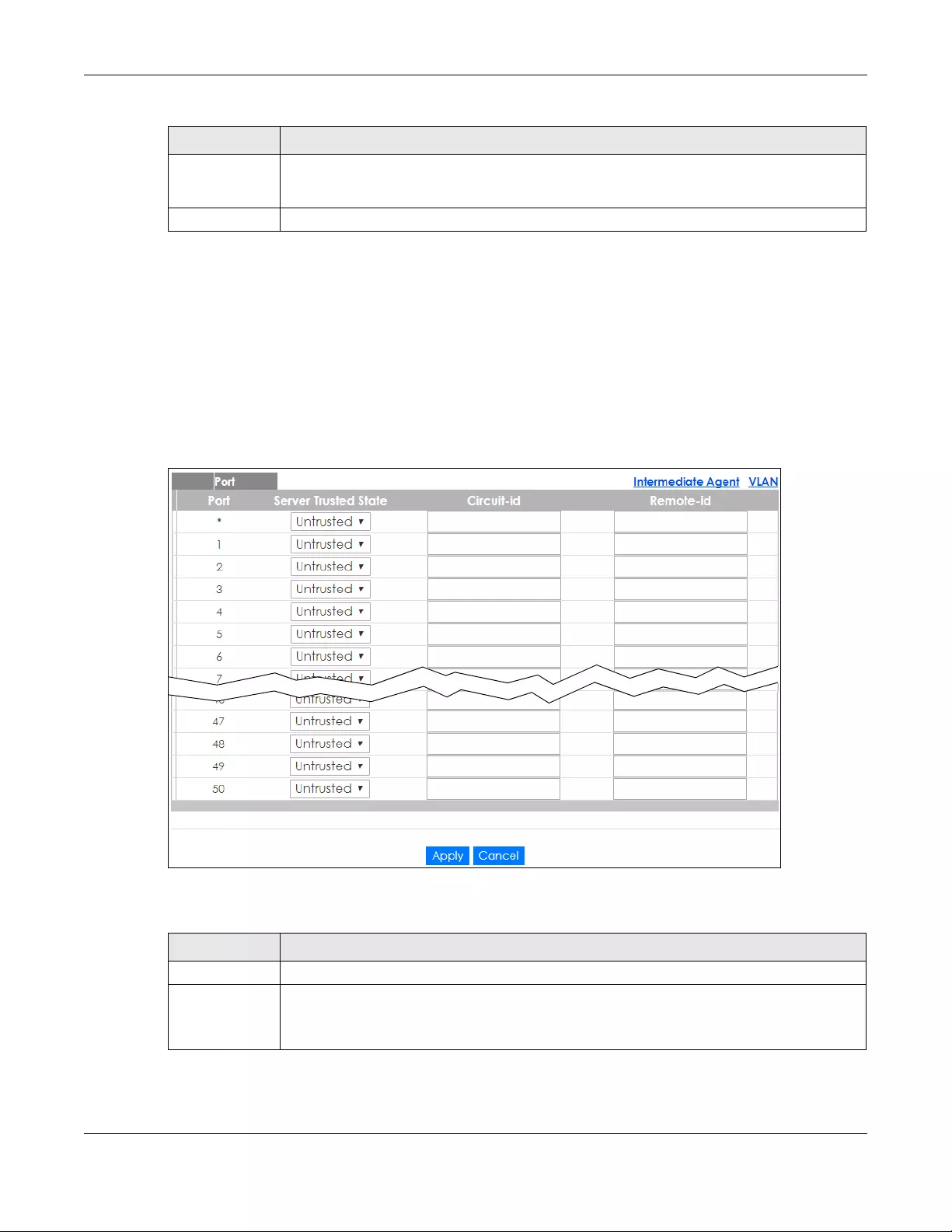
Chapter 29 PPPoE
GS1920v2 Series User’s Guide
270
29.3.1 PPPoE IA Per-Port
Use this screen to specify whether individual ports are trusted or untrusted ports and have the Switch
add extra information to PPPoE discovery packets from PPPoE clients on a per-port basis.
Note: The Switch will drop all PPPoE packets if you enable the PPPoE Intermediate Agent on
the Switch and there are no trusted ports.
Click the Port link in the Intermediate Agent screen to display the screen as shown.
Figure 194 Advanced Application > PPPoE > Intermediate Agent > Port
The following table describes the labels in this screen.
Apply Click Apply to save your changes to the Switch’s run-time memory. The Switch loses these
changes if it is turned off or loses power, so use the Save link on the top navigation panel to save
your changes to the non-volatile memory when you are done configuring.
Cancel Click Cancel to begin configuring this screen afresh.
Table 120 Advanced Application > PPPoE > Intermediate Agent (continued)
LABEL DESCRIPTION
Table 121 Advanced Application > PPPoE > Intermediate Agent > Port
LABEL DESCRIPTION
Port This field displays the port number.
* Use this row to make the setting the same for all ports. Use this row first and then make
adjustments on a port-by-port basis.
Changes in this row are copied to all the ports as soon as you make them.

GS1920v2 Series User’s Guide
271
29.3.2 PPPoE IA Per-Port Per-VLAN
Use this screen to configure PPPoE IA settings that apply to a specific VLAN on a port.
Click the VLAN link in the Intermediate Agent > Port screen to display the screen as shown.
Figure 195 Advanced Application > PPPoE > Intermediate Agent > Port > VLAN
Server Trusted
State
Select whether this port is a trusted port (Trusted) or an untrusted port (Untrusted).
Trusted ports are uplink ports connected to PPPoE servers.
If a PADO (PPPoE Active Discovery Offer), PADS (PPPoE Active Discovery Session-confirmation),
or PADT (PPPoE Active Discovery Terminate) packet is sent from a PPPoE server and received on
a trusted port, the Switch forwards it to all other ports.
If a PADI or PADR packet is sent from a PPPoE client but received on a trusted port, the Switch
forwards it to other trusted port(s).
Untrusted ports are downlink ports connected to subscribers.
If a PADI, PADR, or PADT packet is sent from a PPPoE client and received on an untrusted port,
the Switch adds a vendor-specific tag to the packet and then forwards it to the trusted port(s).
The Switch discards PADO and PADS packets which are sent from a PPPoE server but received
on an untrusted port.
Circuit-id Enter a string of up to 63 ASCII characters that the Switch adds into the Agent Circuit ID sub-
option for PPPoE discovery packets received on this port. Spaces are allowed.
The Circuit ID you configure for a specific VLAN on a port (in the Advanced Application > PPPoE
> Intermediate Agent > Port > VLAN screen) has the highest priority.
Remote-id Enter a string of up to 63 ASCII characters that the Switch adds into the Agent Remote ID sub-
option for PPPoE discovery packets received on this port. Spaces are allowed.
If you do not specify a string here or in the Remote-id field for a VLAN on a port, the Switch
automatically uses the PPPoE client’s MAC address.
The Remote ID you configure for a specific VLAN on a port (in the Advanced Application >
PPPoE > Intermediate Agent > Port > VLAN screen) has the highest priority.
Apply Click Apply to save your changes to the Switch’s run-time memory. The Switch loses these
changes if it is turned off or loses power, so use the Save link on the top navigation panel to save
your changes to the non-volatile memory when you are done configuring.
Cancel Click Cancel to begin configuring this screen afresh.
Table 121 Advanced Application > PPPoE > Intermediate Agent > Port (continued)
LABEL DESCRIPTION

Chapter 29 PPPoE
GS1920v2 Series User’s Guide
272
The following table describes the labels in this screen.
29.3.3 PPPoE IA for VLAN
Use this screen to set whether the PPPoE Intermediate Agent is enabled on a VLAN and whether the
Switch appends the Circuit ID and/or Remote ID to PPPoE discovery packets from a specific VLAN.
Click the VLAN link in the Intermediate Agent screen to display the screen as shown.
Figure 196 Advanced Application > PPPoE > Intermediate Agent > VLAN
Table 122 Advanced Application > PPPoE > Intermediate Agent > Port > VLAN
LABEL DESCRIPTION
Show Port Enter a port number to show the PPPoE Intermediate Agent settings for the specified VLAN(s) on
the port.
Show VLAN Use this section to specify the VLANs you want to configure in the section below.
Start VID Enter the lowest VLAN ID you want to configure in the section below.
End VID Enter the highest VLAN ID you want to configure in the section below.
Apply Click Apply to display the specified range of VLANs in the section below.
Port This field displays the port number specified above.
VID This field displays the VLAN ID of each VLAN in the range specified above. If you configure the *
VLAN, the settings are applied to all VLANs.
* Use this row to make the setting the same for all VLANs. Use this row first and then make
adjustments on a VLAN-by-VLAN basis.
Changes in this row are copied to all the VLANs as soon as you make them.
Circuit-id Enter a string of up to 63 ASCII characters that the Switch adds into the Agent Circuit ID sub-
option for this VLAN on the specified port. Spaces are allowed.
The Circuit ID you configure here has the highest priority.
Remote-id Enter a string of up to 63 ASCII characters that the Switch adds into the Agent Remote ID sub-
option for this VLAN on the specified port. Spaces are allowed.
If you do not specify a string here or in the Remote-id field for a specific port, the Switch
automatically uses the PPPoE client’s MAC address.
The Remote ID you configure here has the highest priority.
Apply Click Apply to save your changes to the Switch’s run-time memory. The Switch loses these
changes if it is turned off or loses power, so use the Save link on the top navigation panel to save
your changes to the non-volatile memory when you are done configuring.
Cancel Click Cancel to begin configuring this screen afresh.

Chapter 29 PPPoE
GS1920v2 Series User’s Guide
273
The following table describes the labels in this screen.
Table 123 Advanced Application > PPPoE > Intermediate Agent > VLAN
LABEL DESCRIPTION
Show VLAN Use this section to specify the VLANs you want to configure in the section below.
Start VID Enter the lowest VLAN ID you want to configure in the section below.
End VID Enter the highest VLAN ID you want to configure in the section below.
Apply Click Apply to display the specified range of VLANs in the section below.
VID This field displays the VLAN ID of each VLAN in the range specified above. If you configure the *
VLAN, the settings are applied to all VLANs.
* Use this row to make the setting the same for all VLANs. Use this row first and then make
adjustments on a VLAN-by-VLAN basis.
Changes in this row are copied to all the VLANs as soon as you make them.
Enabled Select this option to turn on the PPPoE Intermediate Agent on a VLAN.
Circuit-id Select this option to make the Circuit ID settings for a specific VLAN take effect.
Remote-id Select this option to make the Remote ID settings for a specific VLAN take effect.
Apply Click Apply to save your changes to the Switch’s run-time memory. The Switch loses these
changes if it is turned off or loses power, so use the Save link on the top navigation panel to save
your changes to the non-volatile memory when you are done configuring.
Cancel Click Cancel to begin configuring this screen afresh.

Chapter 30 Error Disable
GS1920v2 Series User’s Guide
274
CHAPTER 30
Error Disable
30.1 Error Disable Overview
This chapter shows you how to configure the rate limit for control packets on a port, and set the Switch
to take an action (such as to shut down a port or stop sending packets) on a port when the Switch
detects a pre-configured error. It also shows you how to configure the Switch to automatically undo the
action after the error is gone.
30.1.1 CPU Protection Overview
Switches exchange protocol control packets in a network to get the latest networking information. If a
switch receives large numbers of control packets, such as ARP, BPDU or IGMP packets, which are to be
processed by the CPU, the CPU may become overloaded and be unable to handle regular tasks
properly.
The CPU protection feature allows you to limit the rate of ARP, BPDU and IGMP packets to be delivered
to the CPU on a port. This enhances the CPU efficiency and protects against potential DoS attacks or
errors from other network(s). You then can choose to drop control packets that exceed the specified
rate limit or disable a port on which the packets are received.
30.1.2 Error-Disable Recovery Overview
Some features, such as loop guard or CPU protection, allow the Switch to shut down a port or discard
specific packets on a port when an error is detected on the port. For example, if the Switch detects that
packets sent out the port(s) loop back to the Switch, the Switch can shut down the port(s)
automatically. After that, you need to enable the port(s) or allow the packets on a port manually via the
web configurator or the commands. With error-disable recovery, you can set the disabled port(s) to
become active or start receiving the packets again after the time interval you specify.
30.1.3 What You Can Do
• Use the Errdisable Status screen (Section 30.3 on page 275) to view whether the Switch detected that
control packets exceeded the rate limit configured for a port or a port is disabled according to the
feature requirements and what action you configure, and related information.
• Use the CPU Protection screen (Section 30.4 on page 277) to limit the maximum number of control
packets (ARP, BPDU and/or IGMP) that the Switch can receive or transmit on a port.
• Use the Errdisable Detect screen (Section 30.5 on page 278) to have the Switch detect whether the
control packets exceed the rate limit configured for a port and configure the action to take once the
limit is exceeded.
• Use the Errdisable Recovery screen (Section 30.6 on page 279) to set the Switch to automatically
undo an action after the error is gone.
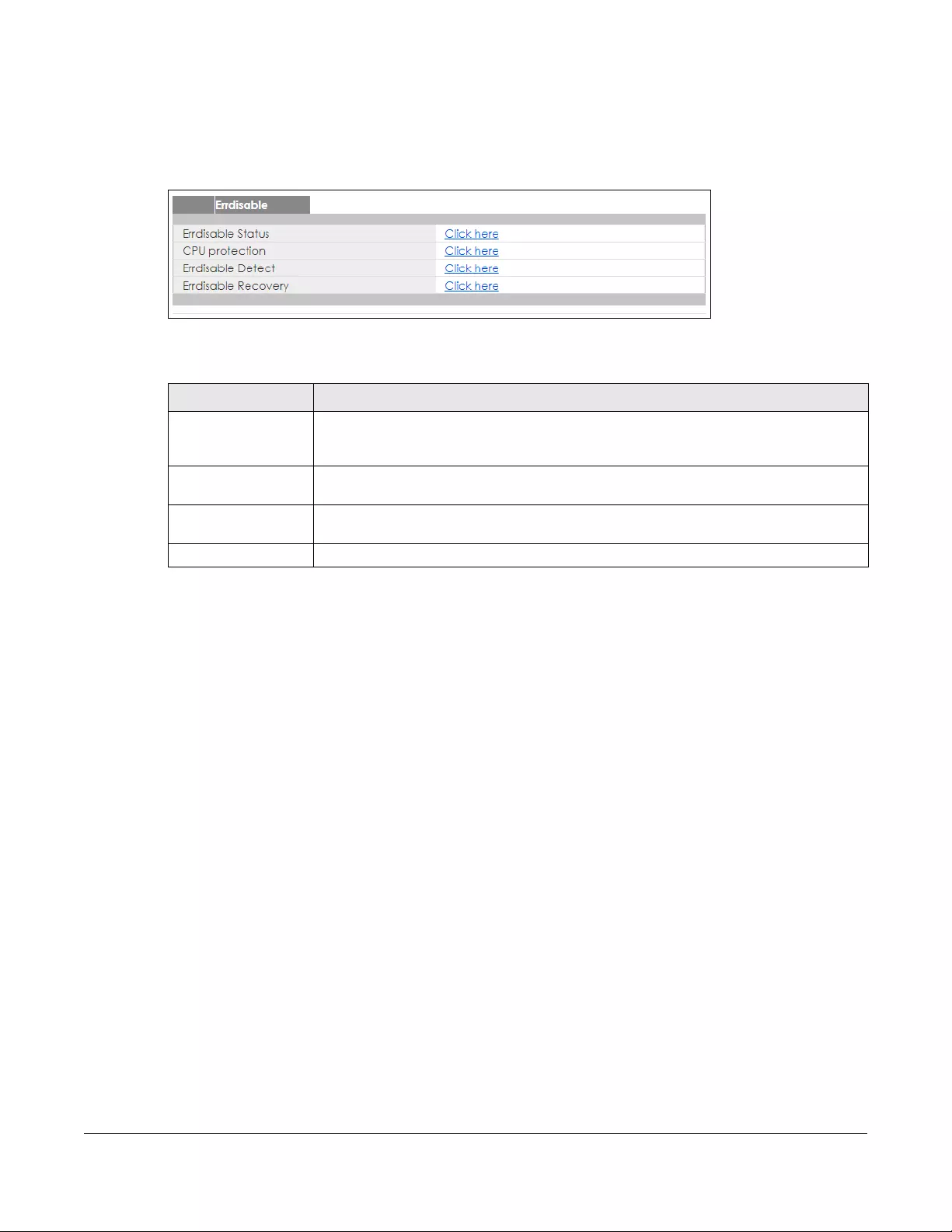
GS1920v2 Series User’s Guide
275
30.2 Error Disable Screen
Use this screen to go to the screens where you can configure error disable related settings. Click
Advanced Application > Errdisable in the navigation panel to open the following screen.
Figure 197 Advanced Application > Errdisable
The following table describes the labels in this screen.
30.3 Error-Disable Status
Use this screen to view whether the Switch detected that control packets exceeded the rate limit
configured for a port or a port is disabled according to the feature requirements and what action you
configure, and related information. Click the Click here link next to Errdisable Status in the Advanced
Application > Errdisable screen to display the screen as shown.
Table 124 Advanced Application > Errdisable
LABEL DESCRIPTION
Errdisable Status Click this link to view whether the Switch detected that control packets exceeded the rate
limit configured for a port or a port is disabled according to the feature requirements and
what action you configure, and related information.
CPU protection Click this link to limit the maximum number of control packets (ARP, BPDU and/or IGMP)
that the Switch can receive or transmit on a port.
Errdisable Detect Click this link to have the Switch detect whether the control packets exceed the rate limit
configured for a port and configure the action to take once the limit is exceeded.
Errdisable Recovery Click this link to set the Switch to automatically undo an action after the error is gone.
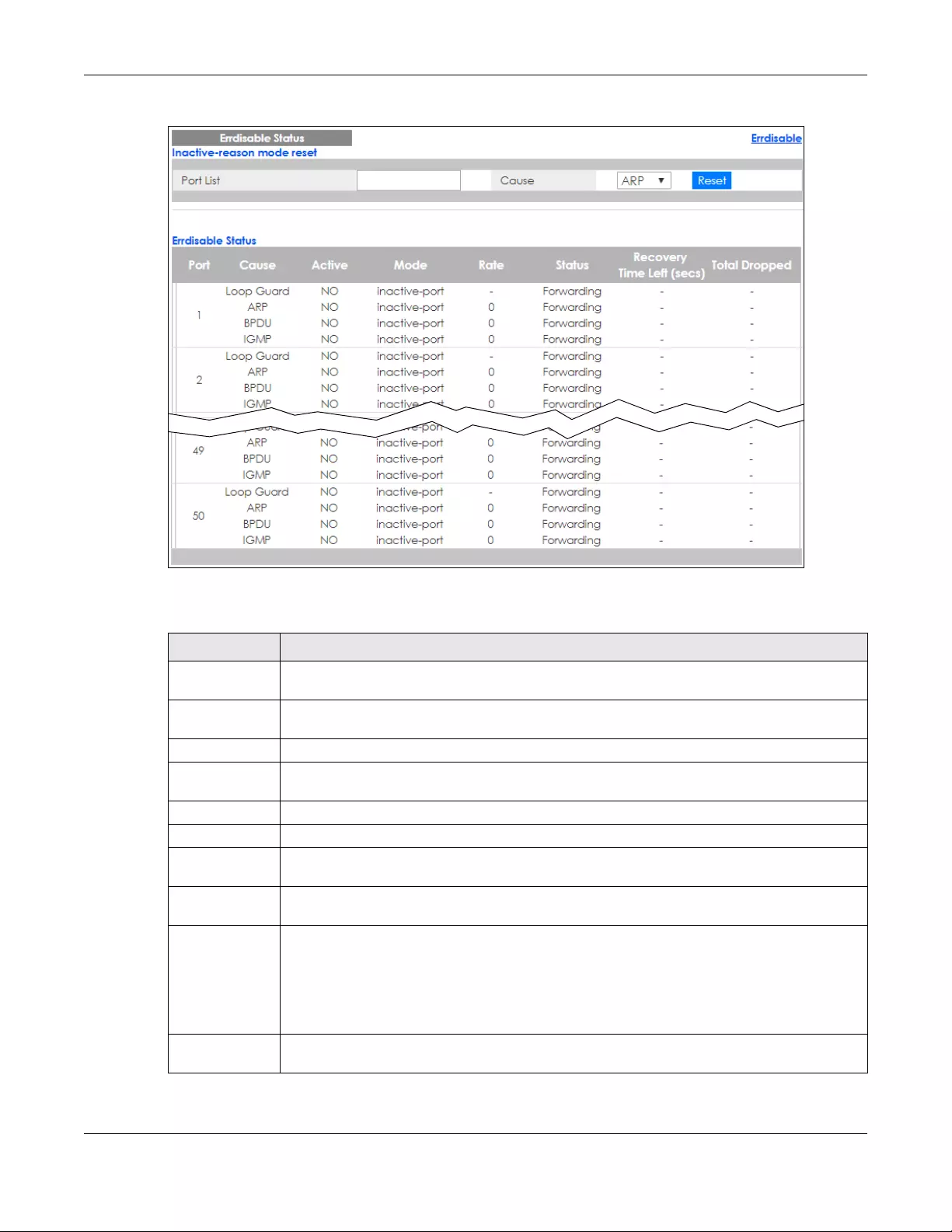
Chapter 30 Error Disable
GS1920v2 Series User’s Guide
276
Figure 198 Advanced Application > Errdisable > Errdisable Status
The following table describes the labels in this screen.
Table 125 Advanced Application > Errdisable > Errdisable Status
LABEL DESCRIPTION
Inactive-reason
mode reset
Port List Enter the number of the port(s) (separated by a comma) on which you want to reset inactive-
reason status.
Cause Select the cause of inactive-reason mode you want to reset here.
Reset Press to reset the specified port(s) to handle ARP, BPDU or IGMP packets instead of ignoring
them, if the port(s) is in inactive-reason mode.
Errdisable Status
Port This is the number of the port on which you want to configure Errdisable Status.
Cause This displays the type of the control packet received on the port or the feature enabled on the
port and causing the Switch to take the specified action.
Active This field displays whether the control packets (ARP, BPDU, and/or IGMP) on the port is being
detected or not. It also shows whether loop guard is enabled on the port.
Mode This field shows the action that the Switch takes for the cause.
•inactive-port - The Switch disables the port.
•inactive-reason - The Switch drops all the specified control packets (such as BPDU) on the
port.
•rate-limitation - The Switch drops the additional control packets the port(s) has to handle in
every one second.
Rate This field displays how many control packets this port can receive or transmit per second. It can
be adjusted in CPU Protection. 0 means no rate limit.

Chapter 30 Error Disable
GS1920v2 Series User’s Guide
277
30.4 CPU Protection Configuration
Use this screen to limit the maximum number of control packets (ARP, BPDU and/or IGMP) that the
Switch can receive or transmit on a port. Click the Click Here link next to CPU protection in the
Advanced Application > Errdisable screen to display the screen as shown.
Note: After you configure this screen, make sure you also enable error detection for the
specific control packets in the Advanced Application > Errdisable > Errdisable D etect
screen.
Figure 199 Advanced Application > Errdisable > CPU protection
Status This field displays the errdisable status
•Forwarding: The Switch is forwarding packets. Rate-limitation mode is always in Forwarding
status.
•Err-disable: The Switch disables the port on which the control packets are received
(inactive-port) or drops specified control packets on the port (inactive-reason)
Recovery
Time Left This field displays the time (seconds) left before the port(s) becomes active of Errdisable
Recovery.
Total
Dropped This field displays the total packet number dropped by this port where the packet rate exceeds
the rate of mode rate-limitation.
Table 125 Advanced Application > Errdisable > Errdisable Status (continued)
LABEL DESCRIPTION
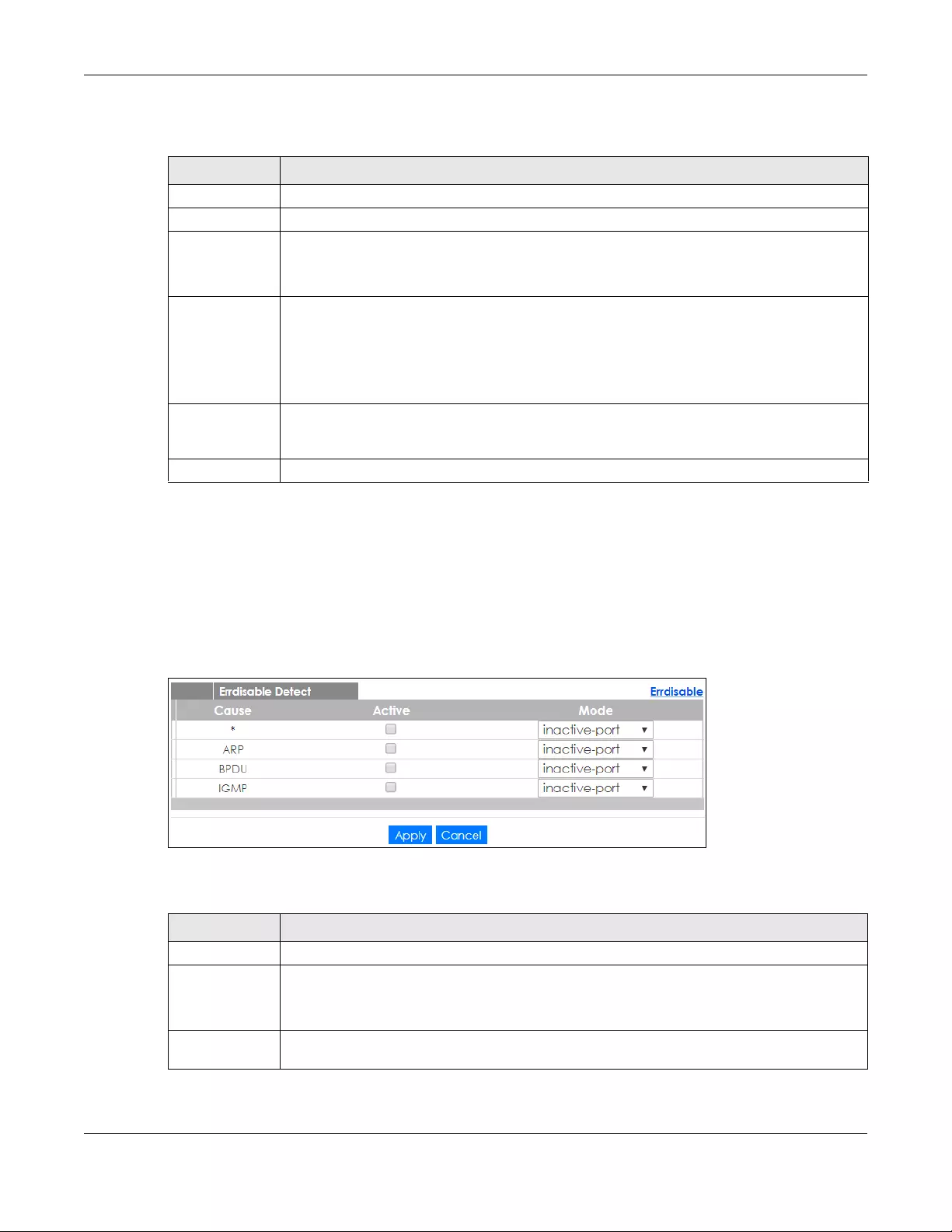
Chapter 30 Error Disable
GS1920v2 Series User’s Guide
278
The following table describes the labels in this screen.
30.5 Error-Disable Detect Configuration
Use this screen to have the Switch detect whether the control packets exceed the rate limit configured
for a port and configure the action to take once the limit is exceeded. Click the Click Here link next to
Errdisable Detect link in the Advanced Application > Errdisable screen to display the screen as shown.
Figure 200 Advanced Application > Errdisable > Errdisable Detect
The following table describes the labels in this screen.
Table 126 Advanced Application > Errdisable > CPU protection
LABEL DESCRIPTION
Reason Select the type of control packet you want to configure here.
Port This field displays the port number.
* Use this row to make the setting the same for all ports. Use this row first and then make
adjustments to each port if necessary.
Changes in this row are copied to all the ports as soon as you make them.
Rate Limit (pkt/s) Enter a number from 0 to 256 to specify how many control packets this port can receive or
transmit per second.
0 means no rate limit.
You can configure the action that the Switch takes when the limit is exceeded. See Section 30.5
on page 278 for detailed information.
Apply Click Apply to save your changes to the Switch’s run-time memory. The Switch loses these
changes if it is turned off or loses power, so use the Save link on the top navigation panel to save
your changes to the non-volatile memory when you are done configuring.
Cancel Click Cancel to begin configuring this screen afresh.
Table 127 Advanced Application > Errdisable > Errdisable Detect
LABEL DESCRIPTION
Cause This field displays the types of control packet that may cause CPU overload.
* Use this row to make the setting the same for all entries. Use this row first and then make
adjustments to each entry if necessary.
Changes in this row are copied to all the entries as soon as you make them.
Active Select this option to have the Switch detect if the configured rate limit for a specific control
packet is exceeded and take the action selected below.

GS1920v2 Series User’s Guide
279
30.6 Error-Disable Recovery Configuration
Use this screen to configure the Switch to automatically undo an action after the error is gone. Click the
Click Here link next to Errdisable Recovery in the Advanced Application > Errdisable screen to display
the screen as shown.
Figure 201 Advanced Application > Errdisable > Errdisable Recovery
The following table describes the labels in this screen.
Mode Select the action that the Switch takes when the number of control packets exceed the rate
limit on a port, set in the Advanced Application > Errdisable > CPU protection screen.
•inactive-port - The Switch disables the port on which the control packets are received.
•inactive-reason - The Switch drops all the specified control packets (such as BPDU) on the
port.
•rate-limitation - The Switch drops the additional control packets the port(s) has to handle in
every one second.
Apply Click Apply to save your changes to the Switch’s run-time memory. The Switch loses these
changes if it is turned off or loses power, so use the Save link on the top navigation panel to save
your changes to the non-volatile memory when you are done configuring.
Cancel Click Cancel to begin configuring this screen afresh.
Table 127 Advanced Application > Errdisable > Errdisable Detect (continued)
LABEL DESCRIPTION
Table 128 Advanced Application > Errdisable > Errdisable Recovery
LABEL DESCRIPTION
Active Select this option to turn on the error-disable recovery function on the Switch.
Reason This field displays the supported features that allow the Switch to shut down a port or discard
packets on a port according to the feature requirements and what action you configure.
* Use this row to make the setting the same for all entries. Use this row first and then make
adjustments to each entry if necessary.
Changes in this row are copied to all the entries as soon as you make them.
Timer Status Select this option to allow the Switch to wait for the specified time interval to activate a port or
allow specific packets on a port, after the error was gone. Deselect this option to turn off this
rule.
Interval Enter the number of seconds (from 30 to 2592000) for the time interval.

Chapter 30 Error Disable
GS1920v2 Series User’s Guide
280
Apply Click Apply to save your changes to the Switch’s run-time memory. The Switch loses these
changes if it is turned off or loses power, so use the Save link on the top navigation panel to save
your changes to the non-volatile memory when you are done configuring.
Cancel Click Cancel to begin configuring this screen afresh.
Table 128 Advanced Application > Errdisable > Errdisable Recovery (continued)
LABEL DESCRIPTION

Chapter 31 Private VLAN
GS1920v2 Series User’s Guide
281
CHAPTER 31 30
Private VLAN
This chapter shows you how to configure the Switch to prevent communications between
ports in a VLAN.
31.1 Private VLAN Overview
Private VLAN allows you to do port isolation within a VLAN in a simple way. You specify which port(s) in a
VLAN is not isolated by adding it to the promiscuous port list. The Switch automatically adds other ports
in this VLAN to the isolated port list and blocks traffic between the isolated ports. A promiscuous port can
communicate with any port in the same VLAN. An isolated port can communicate with the promiscuous
port(s) only.
Note: You can have up to one private VLAN rule for each VLAN.
Figure 202 Private VLAN Example
Note: Make sure you keep at least one port in the promiscuous port list for a VLAN with private
VLAN enabled. Otherwise, this VLAN is blocked from the whole network.
31.2 Configuring Private VLAN
Click Advanced Application > Private VLAN in the navigation panel to display the screen as shown.

Chapter 31 Private VLAN
GS1920v2 Series User’s Guide
282
Figure 203 Advanced Application > Private VLAN
The following table describes the labels in this screen.
Table 129 Advanced Application > Private VLAN
LABEL DESCRIPTION
Active Check this box to enable private VLAN in a VLAN.
Name Enter a descriptive name (up to 32 printable ASCII characters) for identification purposes.
VLAN ID Enter a VLAN ID from 1 to 4094. This is the VLAN to which this rule applies.
Promiscuous Ports Enter the number of the port(s) that can communicate with any ports in the same VLAN. Other
ports belonging to this VLAN will be added to the isolation list and can only send and receive
traffic from the port(s) you specify here.
Add Click Add to insert the entry in the summary table below and save your changes to the Switch’s
run-time memory. The Switch loses these changes if it is turned off or loses power, so use the
Save link on the top navigation panel to save your changes to the non-volatile memory when
you are done configuring.
Cancel Click Cancel to reset the fields to your previous configuration.
Clear Click Clear to clear the fields to the factory defaults.
Index This is the index number of the rule.
Active This shows whether this rule is activated or not.
Name This is the descriptive name for this rule.
VLAN This is the VLAN to which this rule is applied.
Promiscuous Ports This shows the port(s) that can communicate with any ports in the same VLAN.
Select an entry’s check box to select a specific entry. Otherwise, select the check box in the
table heading row to select all entries.
Delete Check the rule(s) that you want to remove and then click the Delete button.
Cancel Click Cancel to clear the check boxes.

Chapter 32 Green Ethernet
GS1920v2 Series User’s Guide
283
CHAPTER 32
Green Ethernet
This chapter shows you how to configure the Switch to reduce the power consumed by switch ports.
32.1 Green Ethernet Overview
Green Ethernet reduces switch port power consumption in the following ways.
IEEE 802.3az Energy Efficient Ethernet (EEE)
If EEE is enabled, both sides of a link support EEE and there is no traffic, the port enters Low Power Idle
(LPI) mode. LPI mode turns off some functions of the physical layer (becomes quiet) to save power.
Periodically the port transmits a REFRESH signal to allow the link partner to keep the link alive. When there
is traffic to be sent, a WAKE signal is sent to the link partner to return the link to active mode.
Auto Power Down
Auto Power Down turns off almost all functions of the port’s physical layer functions when the link is
down, so the port only uses power to check for a link up pulse from the link partner. After the link up
pulse is detected, the port wakes up from Auto Power Down and operates normally.
Short Reach
Traditional Ethernet transmits all data with enough power to reach the maximum cable length. Shorter
cables lose less power, so Short Reach saves power by adjusting the transmit power of each port
according to the length of cable attached to that port.
32.2 Configuring Green Ethernet
Click Advanced Application > Green Ethernet in the navigation panel to display the screen as shown.
Note: EEE, Auto Power Down and Short Reach are not supported on an uplink port.
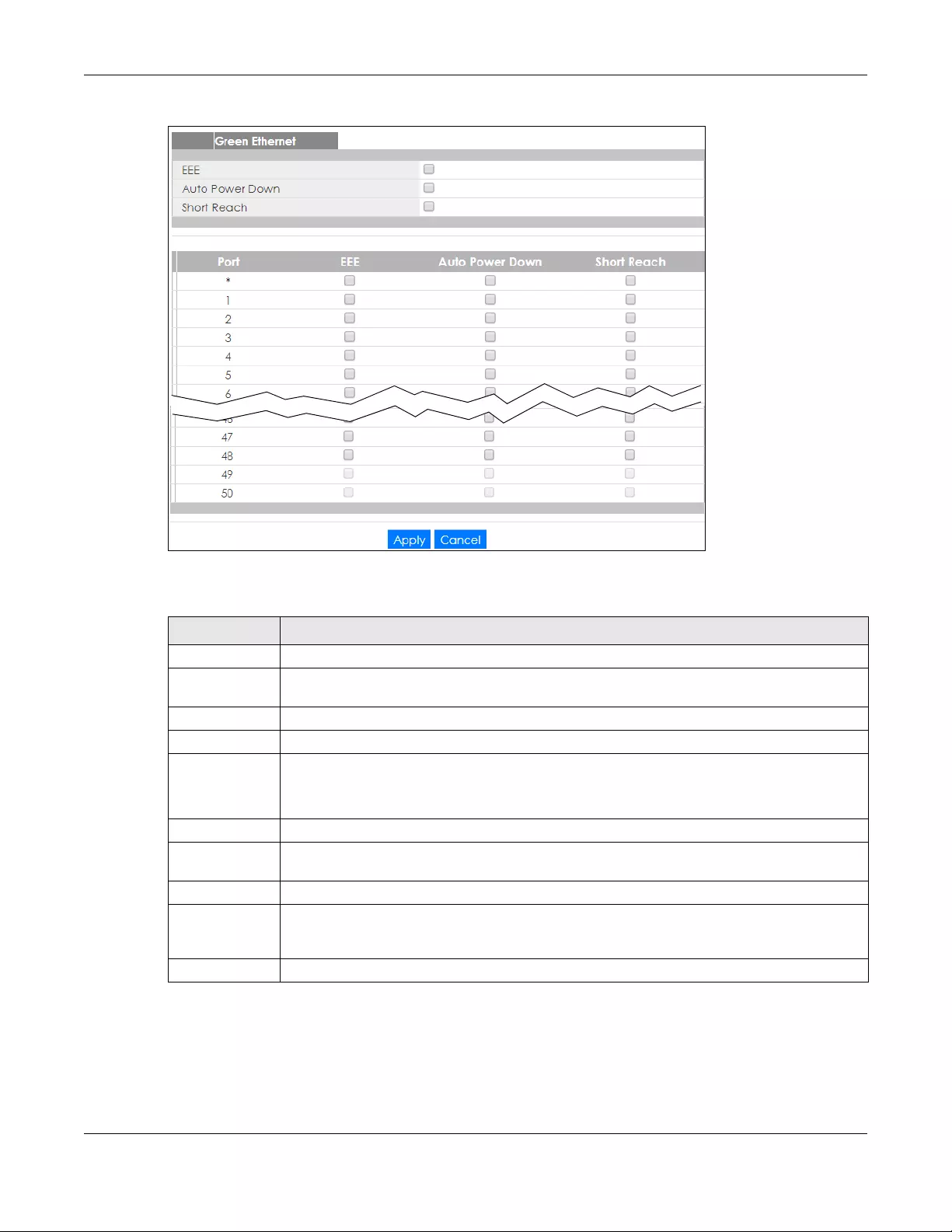
Chapter 32 Green Ethernet
GS1920v2 Series User’s Guide
284
Figure 204 Advanced Application > Green Ethernet
The following table describes the labels in this screen.
Table 130 Advanced Application > Green Ethernet
LABEL DESCRIPTION
EEE Select this to activate Energy Efficient Ethernet globally.
Auto Power
Down
Select this to activate Auto Power Down globally.
Short Reach Select this to activate Short Reach globally.
Port This field displays the port number.
* Use this row to make the setting the same for all ports. Use this row first and then make
adjustments to each port if necessary.
Changes in this row are copied to all the ports as soon as you make them.
EEE Select this to activate Energy Efficient Ethernet on this port.
Auto Power
Down
Select this to activate Auto Power Down on this port.
Short Reach Select this to activate Short Reach on this port.
Apply Click Apply to save your changes to the Switch’s run-time memory. The Switch loses these
changes if it is turned off or loses power, so use the Save link on the top navigation panel to save
your changes to the non-volatile memory when you are done configuring.
Cancel Click Cancel to begin configuring this screen afresh.

Chapter 33 Link Layer Discovery Protocol (LLDP)
GS1920v2 Series User’s Guide
285
CHAPTER 33 31
Link Layer Discovery Protocol
(LLDP)
33.1 LLDP Overview
The LLDP (Link Layer Discovery Protocol) is a layer 2 protocol. It allows a network device to advertise its
identity and capabilities on the local network. It also allows the device to maintain and store information
from adjacent devices which are directly connected to the network device. This helps an administrator
discover network changes and perform necessary network reconfiguration and management. The
device information is encapsulated in the LLDPDUs (LLDP data units) in the form of TLV (Type, Length,
Value). Device information carried in the received LLDPDUs is stored in the standard MIB.
The Switch supports these basic management TLVs.
• End of LLDPDU (mandatory)
•Chassis ID (mandatory)
•Port ID (mandatory)
• Time to Live (mandatory)
• Port Description (optional)
• System Name (optional)
• System Description (optional)
• System Capabilities (optional)
• Management Address (optional)
The Switch also supports the IEEE 802.1 and IEEE 802.3 organizationally-specific TLVs.
IEEE 802.1 specific TLVs:
• Port VLAN ID TLV (optional)
• Port and Protocol VLAN ID TLV (optional)
IEEE 802.3 specific TLVs:
• MAC/PHY Configuration/Status TLV (optional)
• Power via MDI TLV (optional, For PoE models only)
• Link Aggregation TLV (optional)
• Maximum Frame Size TLV (optional)
The optional TLVs are inserted between the Time To Live TLV and the End of LLDPDU TLV.

Chapter 33 Link Layer Discovery Protocol (LLDP)
GS1920v2 Series User’s Guide
286
The next figure demonstrates that the network devices Switches and Routers (S and R) transmit and
receive device information via LLDPDU and the network manager can query the information using
Simple Network Management Protocol (SNMP).
Figure 205 LLDP Overview
33.2 LLDP-MED Overview
LLDP-MED (Link Layer Discovery Protocol for Media Endpoint Devices) is an extension to the standard
LLDP developed by the Telecommunications Industry Association (TIA) TR-41.4 subcommittee which
defines the enhanced discovery capabilities, such as VoIP applications, to enable network
administrators manage their network topology application more efficiently. Unlike the traditional LLDP,
which has some limitations when handling multiple application devices, the LLDP-MED offers display of
accurate physical topology, interoperability of devices, and easy trouble shooting for misconfigured IP
addresses. There are three classes of endpoint devices that the LLDP-MED supports:
Class I: IP Communications Controllers or other communication related servers
Class II: Voice Gateways, Conference Bridges or Media Servers
Class III: IP-Phones, PC-based Softphones, End user Communication Appliances supporting IP Media
The following figure shows that with the LLDP-MED, network connectivity devices (NCD) like Switches
and Routers will transmit LLDP TLV to endpoint device (ED) like IP Phone first (1), to get its device type
and capabilities information, then it will receive that information in LLDP-MED TLV back from endpoint
devices (2), after that the network connectivity devices will transmit LLDP-MED TLV (3) to provision the
endpoint device to such that the endpoint device’s network policy and location identification
information is updated. Since LLDPDU updates status and configuration information periodically,
network managers may check the result of provision via remote status. The remote status is updated by
receiving LLDP-MED TLVs from endpoint devices.
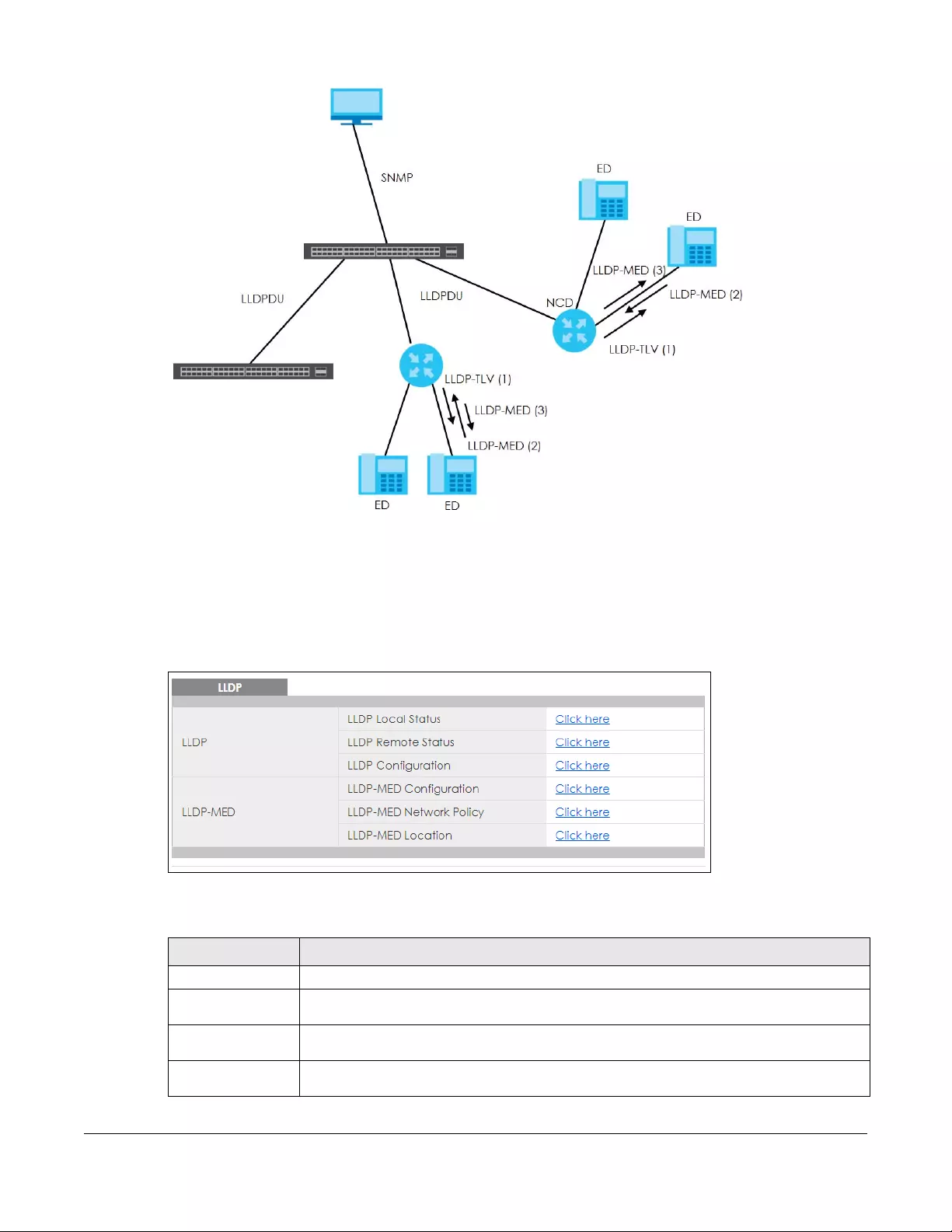
GS1920v2 Series User’s Guide
287
Figure 206 LLDP-MED Overview
33.3 LLDP Screens
Click Advanced Application > LLDP in the navigation panel to display the screen as shown next.
Figure 207 Advanced Application > LLDP
The following table describes the labels in this screen.
Table 131 Advanced Application > LLDP
LABEL DESCRIPTION
LLDP
LLDP Local
Status Click here to show a screen with the Switch’s LLDP information.
LLDP Remote
Status Click here to show a screen with LLDP information from the neighboring devices.
LLDP
Configuration Click here to show a screen to configure LLDP parameters.
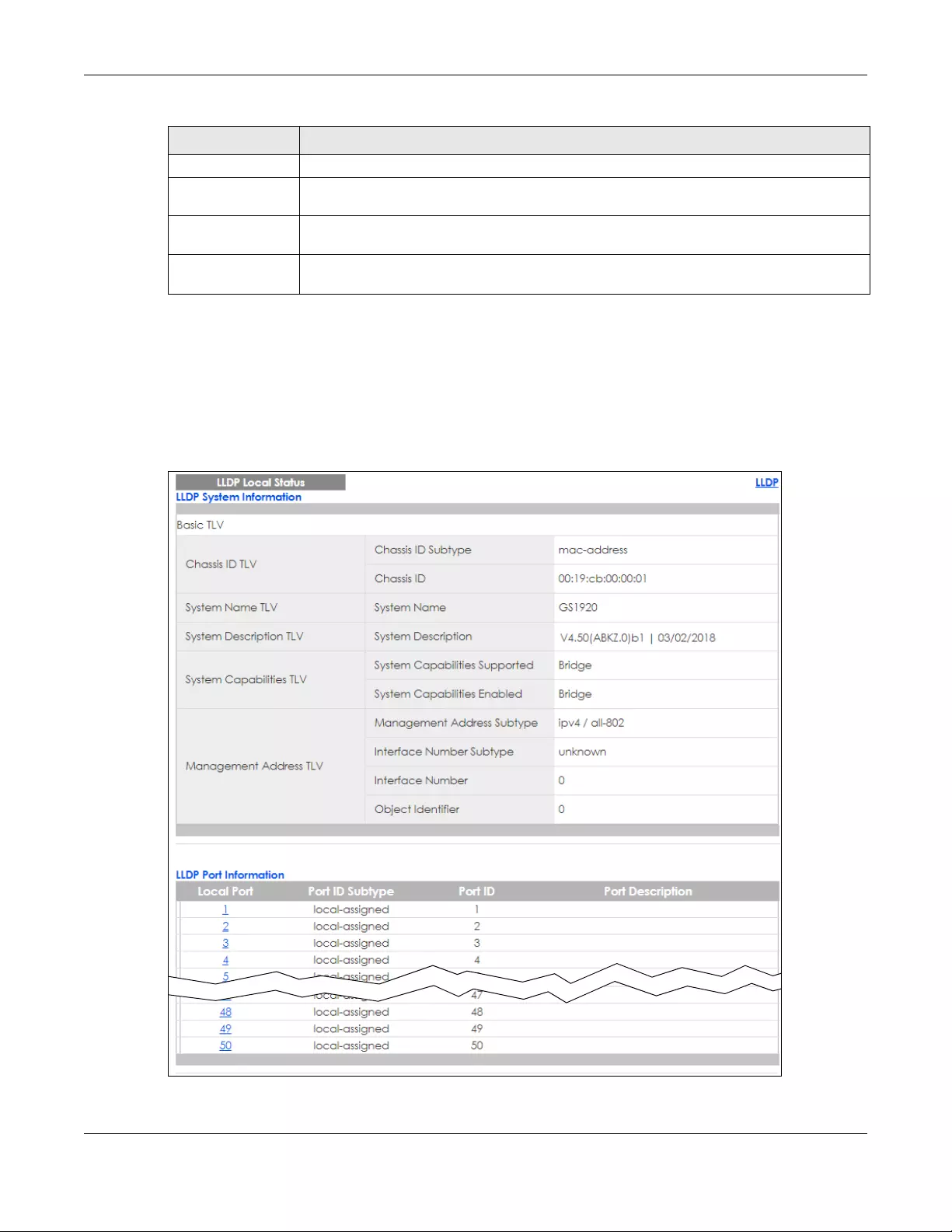
Chapter 33 Link Layer Discovery Protocol (LLDP)
GS1920v2 Series User’s Guide
288
33.4 LLDP Local Status
This screen displays a summary of LLDP status on this Switch. Click Advanced Application > LLDP > LLDP
Local Status to display the screen as shown next.
Figure 208 Advanced Application > LLDP > LLDP Local Status
LLDP-MED
LLDP-MED
Configuration Click here to show a screen to configure LLDP-MED (Link Layer Discovery Protocol for Media
Endpoint Devices) parameters.
LLDP-MED
Network Policy Click here to show a screen to configure LLDP-MED (Link Layer Discovery Protocol for Media
Endpoint Devices) network policy parameters.
LLDP-MED
Location Click here to show a screen to configure LLDP-MED (Link Layer Discovery Protocol for Media
Endpoint Devices) location parameters.
Table 131 Advanced Application > LLDP (continued)
LABEL DESCRIPTION

Chapter 33 Link Layer Discovery Protocol (LLDP)
GS1920v2 Series User’s Guide
289
The following table describes the labels in this screen.
33.4.1 LLDP Local Port Status Detail
This screen displays detailed LLDP status for each port on this Switch. Click Advanced Application > LLDP
> LLDP Local Status and then, click a port number, for example 1 in the local port column to display the
screen as shown next.
Table 132 Advanced Application > LLDP > LLDP Local Status
LABEL DESCRIPTION
Basic TLV
Chassis ID TLV This displays the chassis ID of the local Switch, that is the Switch you’re configuring. The
chassis ID is identified by the chassis ID subtype.
Chassis ID Subtype - this displays how the chassis of the Switch is identified.
Chassis ID - This displays the chassis ID of the local Switch.
System Name
TLV This shows the host name of the Switch.
System
Description TLV This shows the firmware version of the Switch.
System
Capabilities TLV This shows the System Capabilities enabled and supported on the local Switch.
•System Capabilities Supported - Bridge
•System Capabilities Enabled - Bridge
Management
Address TLV The Management Address TLV identifies an address associated with the local LLDP agent
that may be used to reach higher layer entities to assist discovery by network management.
The TLV may also include the system interface number and an object identifier (OID) that are
associated with this management address
This field displays the Management Address settings on the specified port(s).
•Management Address Subtype - ipv4 / all-802
•Interface Number Subtype - unknown
•Interface Number - 0 (not supported)
•Object Identifier - 0 (not supported)
LLDP Port
Information
This displays the local port information.
Local Port This displays the number of the Switch port which receives the LLDPDU from the remote
device. Click a port number to view the detailed LLDP status on this port at LLDP Local Port
Status Detail screen.
Port ID Subtype This indicates how the port ID field is identified.
Port ID This is an alpha-numeric string that contains the specific identifier for the port from which this
LLDPDU was transmitted.
Port Description This shows the port description that the Switch will advertise from this port.
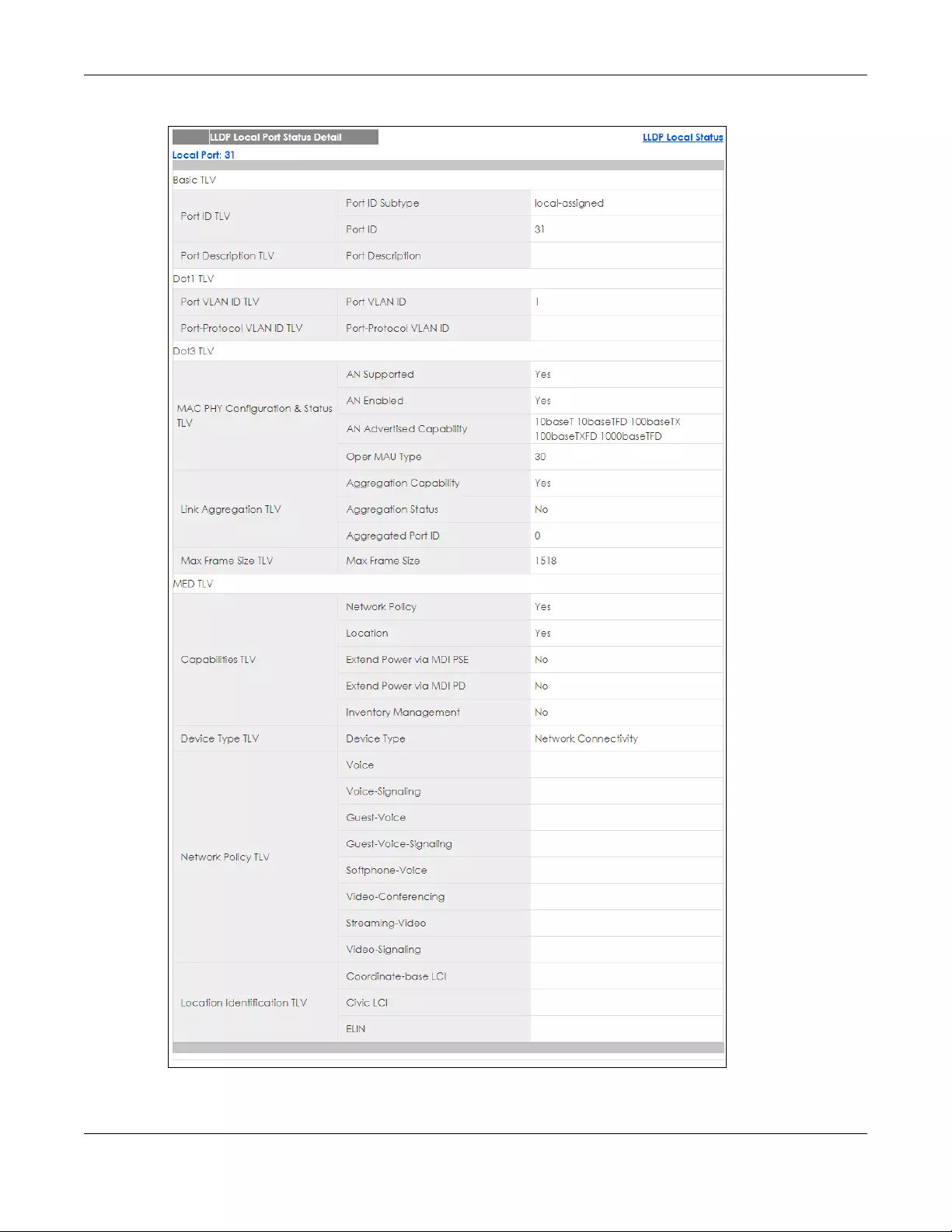
Chapter 33 Link Layer Discovery Protocol (LLDP)
GS1920v2 Series User’s Guide
290
Figure 209 Advanced Application > LLDP > LLDP Local Status > LLDP Local Port Status Detail

Chapter 33 Link Layer Discovery Protocol (LLDP)
GS1920v2 Series User’s Guide
291
The following table describes the labels in this screen.
Table 133 Advanced Application > LLDP > LLDP Local Status > LLDP Local Port Status Detail
LABEL DESCRIPTION
Basic TLV These are the Basic TLV flags
Port ID TLV The port ID TLV identifies the specific port that transmitted the LLDP frame.
•Port ID Subtype: This shows how the port is identified.
•Port ID: This is the ID of the port.
Port Description
TLV This displays the local port description.
Dot1 TLV
Port VLAN ID
TLV This displays the VLAN ID sent by the IEEE 802.1 Port VLAN ID TLV.
Port-Protocol
VLAN ID TLV This displays the IEEE 802.1 Port Protocol VLAN ID TLVs, which indicates whether the VLAN is
enabled and supported.
Dot3 TLV
MAC PHY
Configuration &
Status TLV
The MAC/PHY Configuration/Status TLV advertises the bit-rate and duplex capability of the
sending 802.3 node. It also advertises the current duplex and bit-rating of the sending node.
Lastly, it advertises whether these setting were the result of auto-negotiation during link
initiation or manual override.
•AN Supported - Displays if the port supports or does not support auto-negotiation.
•AN Enabled - The current auto-negotiation status of the port.
•AN Advertised Capability - The auto-negotiation capabilities of the port.
•Oper MAU Type - The current Medium Attachment Unit (MAU) type of the port
Link
Aggregation
TLV
The Link Aggregation TLV indicates whether the link is capable of being aggregated,
whether the link is currently in an aggregation, and if in an aggregation, the port
identification of the aggregation.
•Aggregation Capability — The current aggregation capability of the port.
•Aggregation Status — The current aggregation status of the port.
•Aggregation Port ID — The aggregation ID of the current port.
Max Frame Size
TLV This displays the maximum supported frame size in octets.
MED TLV LLDP Media Endpoint Discovery (MED) is an extension of LLDP that provides additional
capabilities to support media endpoint devices. MED enables advertisement and discovery
of network policies, device location discovery to allow creation of location databases, and
information for troubleshooting.
Capabilities TLV This field displays which LLDP-MED TLV are capable to transmit on the Switch.
• Network Policy
• Location
• Extend Power via MDI PSE
• Extend Power via MDI PD
• Inventory Management
Device Type
TLV This is the LLDP-MED device class. The Zyxel Switch device type is:
• Network Connectivity

Chapter 33 Link Layer Discovery Protocol (LLDP)
GS1920v2 Series User’s Guide
292
33.5 LLDP Remote Status
This screen displays a summary of LLDP status for each LLDP connection to a neighboring Switch. Click
Advanced Application > LLDP > LLDP Remote Status (Click Here) to display the screen as shown next.
Figure 210 Advanced Application > LLDP > LLDP Remote Status
The following table describes the labels in this screen.
Network Policy
TLV This displays a network policy for the specified application.
•Voice
• Voice-Signaling
•Guest-Voice
• Guest-Voice-Signaling
• Softphone-Voice
• Video-Conferencing
•Streaming-Video
• Video-Signaling
Location
Identification
TLV
This shows the location information of a caller by its ELIN (Emergency Location Identifier
Number) or the IETF Geopriv Civic Address based Location Configuration Information (Civic
Address LCI).
•Coordinate-based LCI - latitude, longitude and altitude coordinates of the location
Configuration Information (LCI)
•Civic LCI - IETF Geopriv Civic Address based Location Configuration Information
•ELIN - (Emergency Location Identifier Number)
Table 133 Advanced Application > LLDP > LLDP Local Status > LLDP Local Port Status Detail
LABEL DESCRIPTION
Table 134 Advanced Application > LLDP > LLDP Remote Status
LABEL DESCRIPTION
Index The index number shows the number of remote devices that are connected to the Switch.
Click on an index number to view the detailed LLDP status for this remote device in the LLDP
Remote Port Status Detail screen.
Local Port This is the number of the Switch’s port that received LLDPDU from the remote device.
Chassis ID This displays the chassis ID of the remote device associated with the transmitting LLDP agent.
The chassis ID is identified by the chassis ID subtype. For example, the MAC address of the
remote device.
Port ID This is an alpha-numeric string that contains the specific identifier for the port from which this
LLDPDU was transmitted. The port ID is identified by the port ID subtype.
Port Description This displays a description for the port from which this LLDPDU was transmitted.
System Name This displays the system name of the remote device.
Management
Address
This displays the management address of the remote device. It could be the MAC address or
IP address. You can click on the IP address hyperlink directly.
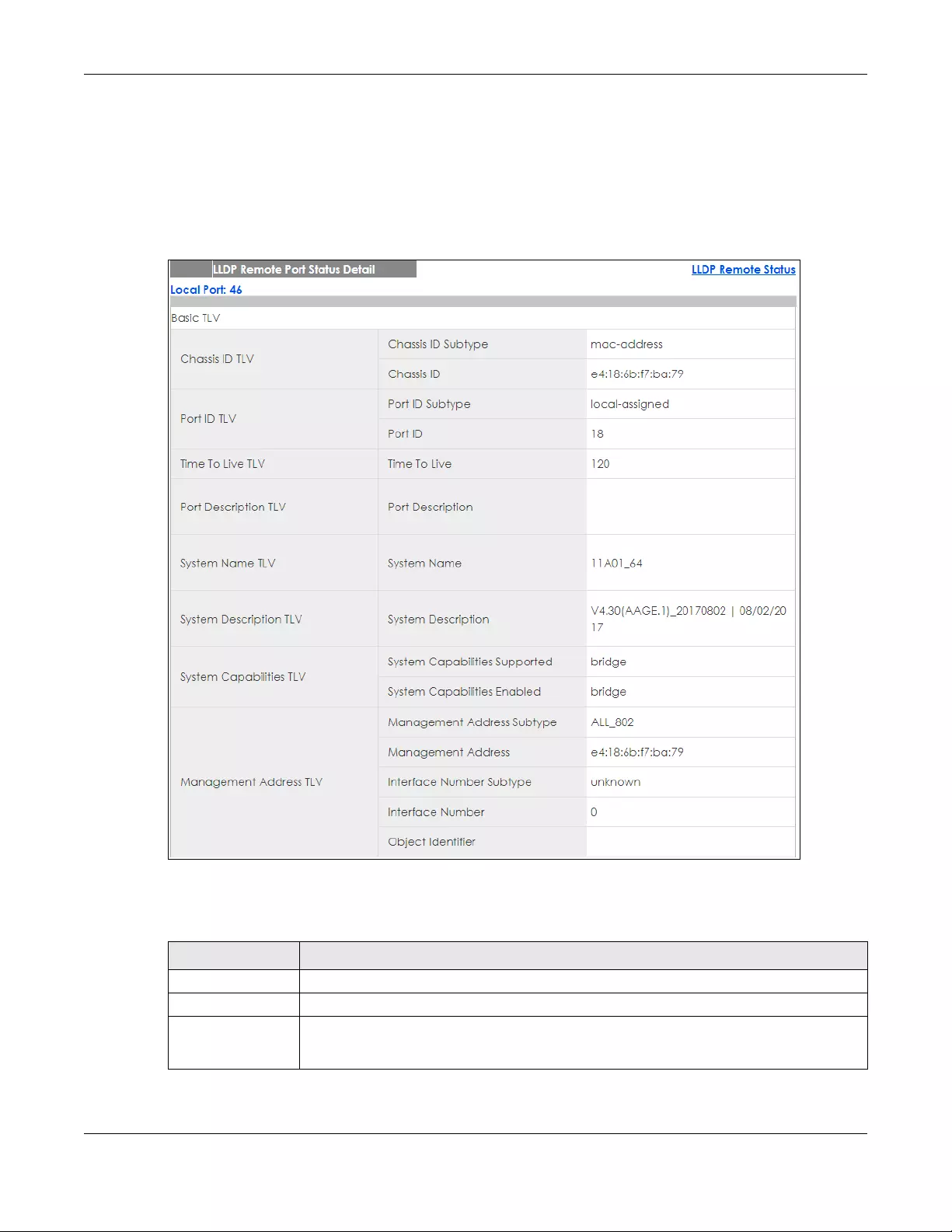
Chapter 33 Link Layer Discovery Protocol (LLDP)
GS1920v2 Series User’s Guide
293
33.5.1 LLDP Remote Port Status Detail
This screen displays detailed LLDP status of the remote device connected to the Switch. Click Advanced
Application > LLDP > LLDP Remote Status (Click Here) and then click an index number, for example 1, in
the Index column in the LLDP Remote Status screen to display the screen as shown next.
Figure 211 Advanced Application > LLDP > LLDP Remote Status > LLDP Remote Port Status Detail (Basic
TLV)
The following table describes the labels in Basic TLV part of the screen.
Table 135 Advanced Application > LLDP > LLDP Remote Status > LLDP Remote Port Status Detail (Basic
TLV)
LABEL DESCRIPTION
Local Port This displays the number of the Switch’s port to which the remote device is connected.
Basic TLV
Chassis ID TLV • Chassis ID Subtype - this displays how the chassis of the remote device is identified.
•Chassis ID - this displays the chassis ID of the remote device. The chassis ID is identified by
the chassis ID subtype.

GS1920v2 Series User’s Guide
294
Port ID TLV • Port ID Subtype - this displays how the port of the remote device is identified.
•Port ID - this displays the port ID of the remote device. The port ID is identified by the port
ID subtype.
Time To Live TLV This displays the time-to-live (TTL) multiplier of LLDP frames. The device information on the
neighboring devices ages out and is discarded when its corresponding TTL expires. The TTL
value is to multiply the TTL multiplier by the LLDP frames transmitting interval.
Port Description
TLV This displays the remote port description.
System Name
TLV This displays the system name of the remote device.
System
Description TLV This displays the system description of the remote device.
System
Capabilities TLV This displays whether the system capabilities are enabled and supported on the remote
device.
• System Capabilities Supported
• System Capabilities Enabled
Management
Address TLV This displays the following management address parameters of the remote device.
• Management Address Subtype
• Management Address
• Interface Number Subtype
• Interface Number
• Object Identifier
Table 135 Advanced Application > LLDP > LLDP Remote Status > LLDP Remote Port Status Detail (Basic
TLV)
LABEL DESCRIPTION
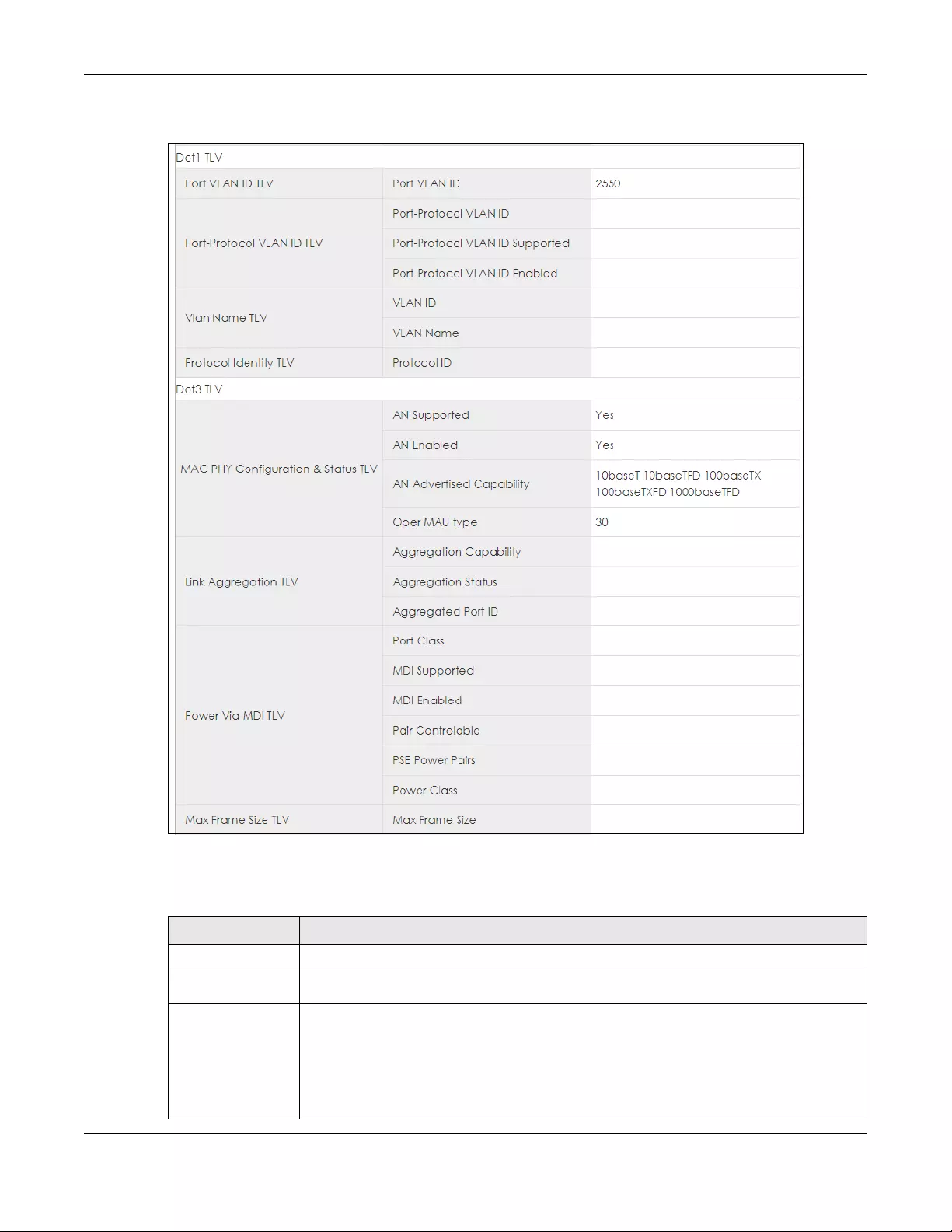
Chapter 33 Link Layer Discovery Protocol (LLDP)
GS1920v2 Series User’s Guide
295
Figure 212 Advanced Application > LLDP > LLDP Remote Status > LLDP Remote Port Status Detail> (Dot
1 and Dot3 TLV)
The following table describes the labels in the Dot1 and Dot3 parts of the screen.
Table 136 Advanced Application > LLDP > LLDP Remote Status > LLDP Remote Port Status Detail (Dot1
and Dot3 TLV)
LABEL DESCRIPTION
Dot1 TLV
Port VLAN ID
TLV This displays the VLAN ID of this port on the remote device.
Port-Protocol
VLAN ID TLV This displays the IEEE 802.1 Port Protocol VLAN ID TLV, which indicates whether the VLAN ID
and whether it is enabled and supported on the port of remote Switch which sent the
LLDPDU.
• Port-Protocol VLAN ID
• Port-Protocol VLAN ID Supported
• Port-Protocol VLAN ID Enabled

GS1920v2 Series User’s Guide
296
Vlan Name TLV This shows the VLAN ID and name for remote device port.
•VLAN ID
• VLAN Name
Protocol
Identity TLV The Protocol Identity TLV allows the Switch to advertise the particular protocols that are
accessible through its port.
Dot3 TLV
MAC PHY
Configuration &
Status TLV
The MAC/PHY Configuration/Status TLV advertises the bit-rate and duplex capability of the
sending 802.3 node. It also advertises the current duplex and bit-rating of the sending node.
Lastly, it advertises whether these setting were the result of auto-negotiation during link
initiation or manual override.
•AN Supported - Displays if the port supports or does not support auto-negotiation.
•AN Enabled - The current auto-negotiation status of the port.
•AN Advertised Capability - The auto-negotiation capabilities of the port.
•Oper MAU Type - The current Medium Attachment Unit (MAU) type of the port
Link
Aggregation
TLV
The Link Aggregation TLV indicates whether the link is capable of being aggregated,
whether the link is currently in an aggregation, and if in an aggregation, the port
identification of the aggregation.
•Aggregation Capability - The current aggregation capability of the port.
•Aggregation Status - The current aggregation status of the port.
•Aggregation Port ID - The aggregation ID of the current port.
Power Via MDI
TLV The Power Via MDI TLV allows network management to advertise and discover the MDI
power support capabilities of the sending port on the remote device.
•Port Class
• MDI Supported
• MDI Enabled
• Pair Controlable
• PSE Power Pairs
•Power Class
Max Frame Size
TLV This displays the maximum supported frame size in octets.
Table 136 Advanced Application > LLDP > LLDP Remote Status > LLDP Remote Port Status Detail (Dot1
and Dot3 TLV)
LABEL DESCRIPTION

Chapter 33 Link Layer Discovery Protocol (LLDP)
GS1920v2 Series User’s Guide
297
Figure 213 Advanced Application > LLDP > LLDP Remote Status > LLDP Remote Port Status Detail (MED
TLV)

GS1920v2 Series User’s Guide
298
The following table describes the labels in the MED TLV part of the screen.
Table 137 Advanced Application > LLDP > LLDP Remote Status > LLDP Remote Port Status Detail (MED
TLV)
LABEL DESCRIPTION
MED TLV LLDP Media Endpoint Discovery (MED) is an extension of LLDP that provides additional
capabilities to support media endpoint devices. MED enables advertisement and discovery
of network policies, device location discovery to allow creation of location databases, and
information for troubleshooting.
Capabilities TLV This displays the MED capabilities the remote port supports.
• Network Policy
• Location
• Extend Power via MDI PSE
• Extend Power via MDI PD
• Inventory Management
Device Type
TLV LLDP-MED endpoint device classes:
• Endpoint Class I
• Endpoint Class II
• Endpoint Class III
• Network Connectivity
Network Policy
TLV This displays a network policy for the specified application.
•Voice
• Voice-Signaling
•Guest-Voice
• Guest-Voice-Signaling
• Softphone-Voice
• Video-Conferencing
•Streaming-Video
• Video-Signaling
Location
Identification
TLV
This shows the location information of a caller by its:
•Coordinate-base LCI - latitude and longitude coordinates of the Location Configuration
Information (LCI)
•Civic LCI - IETF Geopriv Civic Address based Location Configuration Information
•ELIN - (Emergency Location Identifier Number)
Inventory TLV The majority of IP Phones lack support of management protocols such as SNMP, so LLDP-MED
inventory TLVs are used to provide their inventory information to the Network Connectivity
Devices such as the Switch. The Inventory TLV may contain the following information.
• Hardware Revision
• Software Revision
•Firmware Revision
• Model Name
• Manufacturer
• Serial Number
•Asset ID
Extended
Power via MDI
TLV
Extended Power Via MDI Discovery enables detailed power information to be advertised by
Media Endpoints, such as IP phones and Network Connectivity Devices such as the Switch.
•Power Type - whether it is currently operating from primary power or is on backup power
(backup power may indicate to the Endpoint Device that it should move to a power
conservation mode).
•Power Source - whether or not the Endpoint is currently operating from an external power
source.
•Power Priority - the Endpoint Device’s power priority (which the Network Connectivity
Device may use to prioritize which devices will remain in service during power shortages)
•Power Value - power requirement, in fractions of Watts, in current configuration
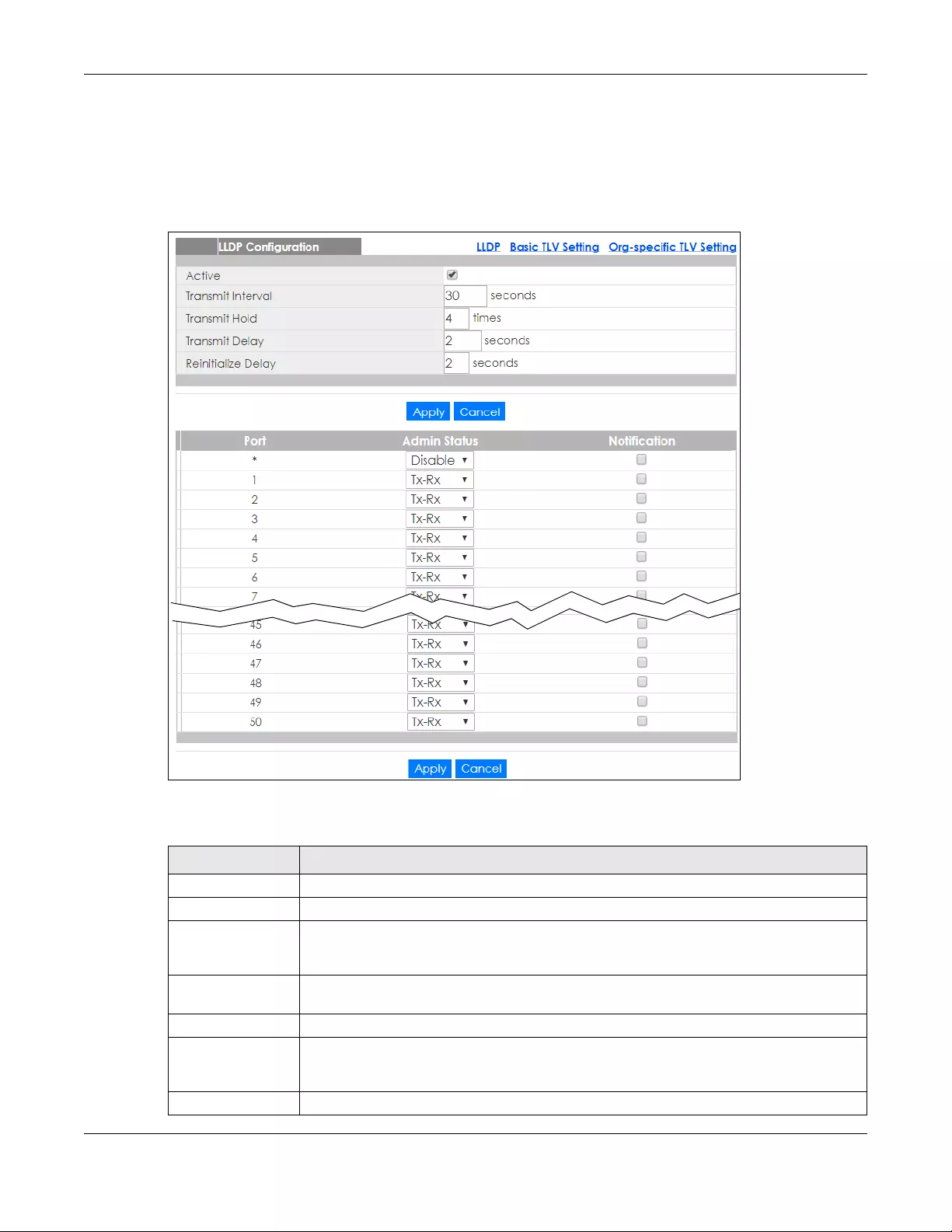
Chapter 33 Link Layer Discovery Protocol (LLDP)
GS1920v2 Series User’s Guide
299
33.6 LLDP Configuration
Use this screen to configure global LLDP settings on the Switch. Click Advanced Application > LLDP >
LLDP Configuration (Click Here) to display the screen as shown next.
Figure 214 Advanced Application > LLDP > LLDP Configuration
The following table describes the labels in this screen.
Table 138 Advanced Application > LLDP > LLDP Configuration
LABEL DESCRIPTION
Active Select to enable LLDP on the Switch. It is enabled by default.
Transmit Interval Enter how many seconds the Switch waits before sending LLDP packets.
Transmit Hold Enter the time-to-live (TTL) multiplier of LLDP frames. The device information on the
neighboring devices ages out and is discarded when its corresponding TTL expires. The TTL
value is to multiply the TTL multiplier by the LLDP packets transmitting interval.
Transmit Delay Enter the delay (in seconds) between successive LLDPDU transmissions initiated by value or
status changes in the Switch MIB.
Reinitialize Delay Enter the number of seconds for LLDP to wait before initializing on a port.
Apply Click Apply to save your changes to the Switch’s run-time memory. The Switch loses these
changes if it is turned off or loses power, so use the Save link on the top navigation panel to
save your changes to the non-volatile memory when you are done configuring.
Cancel Click Cancel to begin configuring this screen afresh.

Chapter 33 Link Layer Discovery Protocol (LLDP)
GS1920v2 Series User’s Guide
300
33.6.1 Basic TLV Setting
Use this screen to configure Basic TLV settings. Click Advanced Application > LLDP > LLDP Configuration
(Click Here) > Basic TLV Setting to display the screen as shown next.
Figure 215 Advanced Application > LLDP > LLDP Configuration> Basic TLV Setting
The following table describes the labels in this screen.
Port This displays the Switch’s port number. * means all ports.
* Use this row to make the setting the same for all ports. Use this row first and then make
adjustments to each port if necessary.
Changes in this row are copied to all the ports as soon as you make them.
Admin Status Select whether LLDP transmission and/or reception is allowed on this port.
• Disable - not allowed
• Tx-Only - transmit only
• Rx-Only - receive only
• Tx-Rx - transmit and receive
Notification Select whether LLDP notification is enabled on this port.
Apply Click Apply to save your changes to the Switch’s run-time memory. The Switch loses these
changes if it is turned off or loses power, so use the Save link on the top navigation panel to
save your changes to the non-volatile memory when you are done configuring.
Cancel Click Cancel to begin configuring this screen afresh.
Table 138 Advanced Application > LLDP > LLDP Configuration
LABEL DESCRIPTION
Table 139 Advanced Application > LLDP > LLDP Configuration > Basic TLV Setting
LABEL DESCRIPTION
Port This displays the Switch’s port number.
* Use this row to make the setting the same for all ports. Use this row first and then make
adjustments to each port if necessary.
Changes in this row are copied to all the ports as soon as you make them.
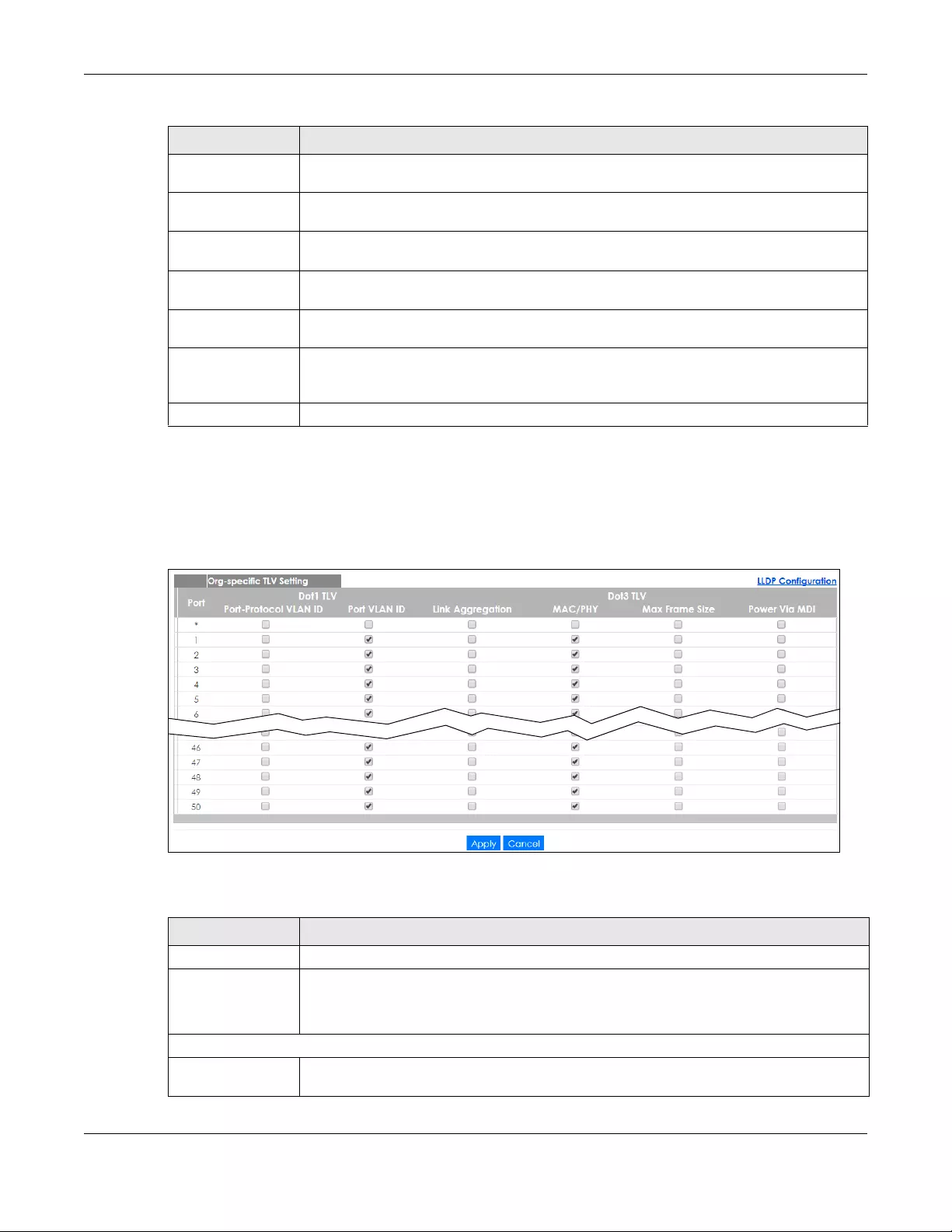
Chapter 33 Link Layer Discovery Protocol (LLDP)
GS1920v2 Series User’s Guide
301
33.6.2 Org-specific TLV Setting
Use this screen to configure organization-specific TLV settings. Click Advanced Application > LLDP > LLDP
Configuration (Click Here) > Org-specific TLV Setting to display the screen as shown next.
Figure 216 Advanced Application > LLDP > LLDP Configuration> Org-specific TLV Setting
The following table describes the labels in this screen.
Management
Address
Select the check box(es) to enable or disable the sending of Management Address TLVs on
the port(s).
Port Description Select the check box(es) to enable or disable the sending of Port Description TLVs on the
port(s).
System Capabilities Select the check box(es) to enable or to disable the sending of System Capabilities TLVs on
the port(s).
System Description Select the check box(es) to enable or to disable the sending of System Description TLVs on
the port(s).
System Name Select the check box(es) to enable or to disable the sending of System Name TLVs on the
port(s).
Apply Click Apply to save your changes to the Switch’s run-time memory. The Switch loses these
changes if it is turned off or loses power, so use the Save link on the top navigation panel to
save your changes to the non-volatile memory when you are done configuring.
Cancel Click Cancel to begin configuring this screen afresh.
Table 139 Advanced Application > LLDP > LLDP Configuration > Basic TLV Setting
LABEL DESCRIPTION
Table 140 Advanced Application > LLDP > LLDP Configuration > Org-specific TLV Setting
LABEL DESCRIPTION
Port This displays the Switch’s port number.
* Use this row to make the setting the same for all ports. Use this row first and then make
adjustments to each port if necessary.
Changes in this row are copied to all the ports as soon as you make them.
Dot1 TLV
Port-Protocol
VLAN ID Select the check box(es) to enable or disable the sending of IEEE 802.1 Port and Protocol
VLAN ID TLVs on the port(s).

Chapter 33 Link Layer Discovery Protocol (LLDP)
GS1920v2 Series User’s Guide
302
33.7 LLDP-MED Configuration
Click Advanced Application > LLDP > LLDP-MED Configuration to display the screen as shown next.
Figure 217 Advanced Application > LLDP > LLDP-MED Configuration
Port VLAN ID Select the check box(es) to enable or disable the sending of IEEE 802.1 Port VLAN ID TLVs on
the port(s). All check boxes in this column are enabled by default.
Dot3 TLV
Link
Aggregation Select the check box(es) to enable or disable the sending of IEEE 802.3 Link Aggregation TLVs
on the port(s).
MAC/PHY Select the check box(es) to enable or disable the sending of IEEE 802.3 MAC/PHY
Configuration/Status TLVs on the port(s). All check boxes in this column are enabled by
default.
Max Frame Size Select the check box(es) to enable or disable the sending of IEEE 802.3 Max Frame Size TLVs
on the port(s).
Power Via MDI Note: For PoE models only. The Power Via MDI TLV allows network management to advertise
and discover the MDI power support capabilities of the sending port on the remote device.
• Port Class
• MDI Supported
•MDI Enabled
•Pair Controlable
•PSE Power Pairs
•Power Class
Apply Click Apply to save your changes to the Switch’s run-time memory. The Switch loses these
changes if it is turned off or loses power, so use the Save link on the top navigation panel to
save your changes to the non-volatile memory when you are done configuring.
Cancel Click Cancel to begin configuring this screen afresh.
Table 140 Advanced Application > LLDP > LLDP Configuration > Org-specific TLV Setting
LABEL DESCRIPTION

Chapter 33 Link Layer Discovery Protocol (LLDP)
GS1920v2 Series User’s Guide
303
The following table describes the labels in this screen.
33.8 LLDP-MED Network Policy
Click Advanced Application > LLDP > LLDP-MED Network Policy (Click Here) to display the screen as
shown next.
Figure 218 Advanced Application > LLDP > LLDP-MED Network Policy
Table 141 Advanced Application > LLDP > LLDP-MED Configuration
LABEL DESCRIPTION
Port This displays the Switch’s port number. Select * to configure all ports simultaneously.
* Use this row to make the setting the same for all ports. Use this row first and then make
adjustments to each port if necessary.
Changes in this row are copied to all the ports as soon as you make them.
Notification
Topology
Change Select to enable LLDP-MED topology change traps on this port.
MED TLV Setting
Location Select to enable transmitting LLDP-MED location TLV.
Network Policy Select to enable transmitting LLDP-MED Network Policy TLV.
Apply Click Apply to save the changes to the Switch’s run-time memory. The Switch loses these
changes if it is turned off or loses power, so use the Save link on the top navigation panel to
save your changes to the non-volatile memory when you are done configuring.
Cancel Click Cancel to begin configuring this screen afresh.

Chapter 33 Link Layer Discovery Protocol (LLDP)
GS1920v2 Series User’s Guide
304
The following table describes the labels in this screen.
33.9 LLDP-MED Location
Click Advanced Application > LLDP > LLDP-MED Location (Click Here) to display the screen as shown
next.
Table 142 Advanced Application > LLDP > LLDP-MED Network Policy
LABEL DESCRIPTION
Port Enter the port number to set up the LLDP-MED network policy.
Application Type Select the type of application used in the network policy.
• voice
• voice-signaling
•guest-voice
• guest-voice-signaling
• softphone-voice
• video-conferencing
• streaming-video
• video-signaling
Tag Select to tag or untag in the network policy.
•tagged
• untagged
VLAN Enter the VLAN ID number. It should be from 1 to 4094. For priority tagged frames, enter “0”.
DSCP Enter the DSCP value of the network policy. The value is defined from 0 through 63 with the 0
representing use of the default DSCP value.
Priority Enter the priority value for the network policy.
Add Click Add after finish entering the network policy information. A summary table will list all the
Switch you’ve added.
Cancel Click Cancel to begin entering the information afresh.
Index This field displays the of index number of the network policy. Click an index number to edit
the rule.
Port This field displays the port number of the network policy.
Application Type This field displays the application type of the network policy.
Tag This field displays the Tag Status of the network policy.
VLAN This field displays the VLANID of the network policy.
Priority This field displays the priority value of the network policy.
DSCP This field displays the DSCP value of the network policy.
Select an entry’s check box to select a specific entry. Otherwise, select the check box in the
table heading row to select all entries.
Delete Check the rules that you want to remove, then click the Delete button.
Cancel Click Cancel to clear the selected check boxes.

Chapter 33 Link Layer Discovery Protocol (LLDP)
GS1920v2 Series User’s Guide
305
Figure 219 Advanced Application > LLDP > LLDP-MED Location
The following table describes the labels in this screen.
Table 143 Advanced Application > LLDP > LLDP-MED Location
LABEL DESCRIPTION
Port Enter the port number you want to set up the location within the LLDP-MED network.
Location
Coordinates
The LLDP-MED uses geographical coordinates and Civic Address to set the location
information of the remote device. Geographical based coordinates includes latitude,
longitude, altitude and datum. Civic Address includes Country, State, County, City, Street
and other related information.
Latitude Enter the latitude information. The value should be from 0º to 90º. The negative value
represents the South.
•north
•south
Longitude Enter the longitude information. The value should be from 0º to 180º. The negative value
represents the West.
•west
•east

Chapter 33 Link Layer Discovery Protocol (LLDP)
GS1920v2 Series User’s Guide
306
Altitude Enter the altitude information. The value should be from -2097151 to 2097151 in meters or in
floors.
•meters
•floor
Datum Select the appropriate geodetic datum used by GPS.
•WGS84
• NAD83-NAVD88
• NAD83-MLLW
Civic Address Enter the Civic Address by providing information such as Country, State, County, City,
Street, Number, ZIP code and other additional information. Enter at least two field in this
configuration including the Country. The valid length of the Country field is 2 characters
and all other fields are up to 32 characters.
• Country
• State
• County
• City
• Division
• Neighbor
• Street
• Leading-Street-Direction
• Street-Suffix
• Trailing-Street-Suffix
•House-Number
• House-Number-Suffix
• Landmark
• Additional-Location
•Name
•Zip-Code
• Building
•Unit
• Floor
• Room-Number
• Place-Type
• Postal-Community-Name
• Post-Office-Box
• Additional-Code
ELIN Number Enter a numerical digit string, corresponding to the ELIN identifier which is used during
emergency call setup to a traditional CAMA or ISDN trunk-based PSAP. The valid length is
from 10 to 25 characters.
Add Click Add after finish entering the location information.
Cancel Click Cancel to begin entering the location information afresh.
Index This lists the index number of the location configuration. Click an index number to view or edit
the location.
Port This lists the port number of the location configuration.
Location
Coordinates
This field displays the location configuration information based on geographical coordinates
that includes longitude, latitude, altitude and datum.
Civic Address This field displays the Civic Address for the remote device using information such as Country,
State, County, City, Street, Number, ZIP code and additional information.
ELIN Number This field shows the Emergency Location Identification Number (ELIN), which is used to
identify endpoint devices when they issue emergency call services. The valid length is form
10 to 25 characters.
Table 143 Advanced Application > LLDP > LLDP-MED Location
LABEL DESCRIPTION

Chapter 33 Link Layer Discovery Protocol (LLDP)
GS1920v2 Series User’s Guide
307
Select an entry’s check box to select a specific entry. Otherwise, select the check box in the
table heading row to select all entries.
Delete Check the locations that you want to remove, then click the Delete button.
Cancel Click Cancel to clear the selected check boxes.
Table 143 Advanced Application > LLDP > LLDP-MED Location
LABEL DESCRIPTION

Chapter 34 OAM
GS1920v2 Series User’s Guide
308
CHAPTER 34
OAM
34.1 OAM Overview
Link layer Ethernet OAM (Operations, Administration and Maintenance) as described in IEEE 802.3ah is a
link monitoring protocol. It utilizes OAM Protocol Data Units or OAM PDUs to transmit link status
information between directly connected Ethernet devices. Both devices must support IEEE 802.3ah.
Because link layer Ethernet OAM operates at layer two of the OSI (Open Systems Interconnection Basic
Reference) model, neither IP or SNMP are necessary to monitor or troubleshoot network connection
problems.
The Switch supports the following IEEE 802.3ah features:
• Discovery - this identifies the devices on each end of the Ethernet link and their OAM configuration.
• Remote Loopback - this can initiate a loopback test between Ethernet devices.
34.1.1 What You Can Do
• Use the OAM Status screen (Section 34.2 on page 308) to view the configuration of ports on which
Ethernet OAM is enabled.
• Use the OAM Configuration screen (Section 34.3 on page 313) to enable Ethernet OAM on the Switch.
• Use the OAM Remote Loopback screen (Section 34.4 on page 314) to perform remote-loopback tests.
34.2 OAM Status
Use this screen to view the configuration of ports on which Ethernet OAM is enabled. Click Advanced
Application > OAM in the navigation panel.

Chapter 34 OAM
GS1920v2 Series User’s Guide
309
Figure 220 Advanced Application > OAM Status
The following table describes the labels in this screen.
34.2.1 OAM Details
Use this screen to view OAM configuration details and operational status of a specific port. Click a
number in the Port column in the OAM Status screen to display the screen as shown next.
Table 144 Advanced Application > OAM Status
LABEL DESCRIPTION
Local
This section displays information about the ports on the Switch.
Port This field displays the number of the port on the Switch.
Mode This field displays the operational state of the port when OAM is enabled on the port.
Active - Allows the port to issue and respond to Ethernet OAM commands.
Passive - Allows the port to respond to Ethernet OAM commands.
Remote
This section displays information about the remote device.
Mac Address This field displays the MAC address of the remote device.
OUI This field displays the OUI (first three bytes of the MAC address) of the remote device.
Mode This field displays the operational state of the port when OAM is enabled on the port.
Active - Allows the port to issue and respond to Ethernet OAM commands.
Passive - Allows the port to respond to Ethernet OAM commands.
Config This field displays the capabilities of the Switch and remote device.

Chapter 34 OAM
GS1920v2 Series User’s Guide
310
Figure 221 Advanced Application > OAM Status > OAM Details
The following table describes the labels in this screen.
Table 145 Advanced Application > OAM Status > OAM Details
LABEL DESCRIPTION
Discovery
This section displays OAM configuration details and operational status of the port on the Switch and/or the remote
device.
Local Client/
Remote Client
OAM
configurations

Chapter 34 OAM
GS1920v2 Series User’s Guide
311
Mode This field displays the OAM mode. The device in active mode (typically the service provider's
device) controls the device in passive mode (typically the subscriber's device).
Active: The port initiates OAM discovery; sends information PDUs; and may send event
notification PDUs, variable request/response PDUs, or loopback control PDUs.
Passive: The port waits for the remote device to initiate OAM discovery; sends information
PDUs; may send event notification PDUs; and may respond to variable request PDUs or
loopback control PDUs.
The Switch might not support some types of PDUs, as indicated in the fields below.
Unidirectional This field indicates whether or not the port can send information PDUs to transmit fault
information when the receive path is non-operational.
Remote
loopback This field indicates whether or not the port can use loopback control PDUs to put the remote
device into loopback mode.
Link events This field indicates whether or not the port can interpret link events, such as link fault and dying
gasp. Link events are sent in event notification PDUs and indicate when the number of errors
in a given interval (time, number of frames, number of symbols, or number of errored frame
seconds) exceeds a specified threshold. Organizations may create organization-specific link
event TLVs as well.
Variable
retrieval This field indicates whether or not the port can respond to requests for more information, such
as requests for Ethernet counters and statistics, about link events.
Max. OAMPDU
size This field displays the maximum size of PDU for receipt and delivery.
Local Client/
Remote Client
Operational status
Link status This field indicates that the link between the Switch port and a connected IEEE 802.3ah-
enabled remote Ethernet device is up or down.
Info. revision This field displays the current version of local state and configuration. This two-octet value
starts at zero and increments every time the local state or configuration changes.
Parser state This field indicates the current state of the parser.
Forward: The port is forwarding packets normally.
Loopback: The port is in loopback mode.
Discard: The port is discarding non-OAMPDUs because it is trying to or has put the remote
device into loopback mode.
Table 145 Advanced Application > OAM Status > OAM Details (continued)
LABEL DESCRIPTION

Chapter 34 OAM
GS1920v2 Series User’s Guide
312
Discovery state This field indicates the state in the OAM discovery process. OAM-enabled devices use this
process to detect each other and to exchange information about their OAM configuration
and capabilities. OAM discovery is a handshake protocol.
Fault: One of the devices is transmitting OAM PDUs with link fault information, or the interface is
not operational.
Active Send Local: The port is in active mode and is trying to see if the remote device supports
OAM.
Passive Wait: The port is in passive mode and is waiting for the remote device to begin OAM
discovery.
Send Local Remote: This state occurs in the following circumstances.
• The port has discovered the remote device but has not accepted or rejected the
connection yet.
• The port has discovered the remote device and rejected the connection.
Send Local Remote OK: The port has discovered the remote device and has accepted the
connection. In addition, the remote device has not accepted or rejected the connection
yet, or the remote device has rejected the connected.
Send Any: The port and the remote device have accepted the connection. This is the
operating state for OAM links that are fully operational.
Remote Client
MAC address This field displays the MAC address of the IEEE 802.3ah-enabled remote Ethernet device that is
connected to the Switch.
Vendor(oui) This field displays the Organizationally Unique Identifiers (OUI) representing the vendor of the
IEEE 802.3ah-enabled remote Ethernet device that is connected to the Switch.
Statistics
This section displays the number of OAM packets transferred on the port of the Switch.
Information
OAMPDU Tx
This field displays the number of OAM PDUs sent on the port.
Information
OAMPDU Rx
This field displays the number of OAM PDUs received on the port.
Event Notification
OAMPDU Tx
This field displays the number of unique or duplicate OAM event notification PDUs sent on the
port.
Event Notification
OAMPDU Rx
This field displays the number of unique or duplicate OAM event notification PDUs received on
the port.
Loopback Control
OAMPDU Tx
This field displays the number of loopback control OAM PDUs sent on the port.
Loopback Control
OAMPDU Rx
This field displays the number of loopback control OAM PDUs received on the port.
Variable Request
OAMPDU Tx
This field displays the number of OAM PDUs sent to request MIB objects on the remote device.
Variable Request
OAMPDU Rx
This field displays the number of OAM PDUs received requesting MIB objects on the Switch.
Variable Response
OAMPDU Tx
This field displays the number of OAM PDUs sent by the Switch in response to requests.
Variable Response
OAMPDU Rx
This field displays the number of OAM PDUs sent by the remote device in response to requests.
Table 145 Advanced Application > OAM Status > OAM Details (continued)
LABEL DESCRIPTION
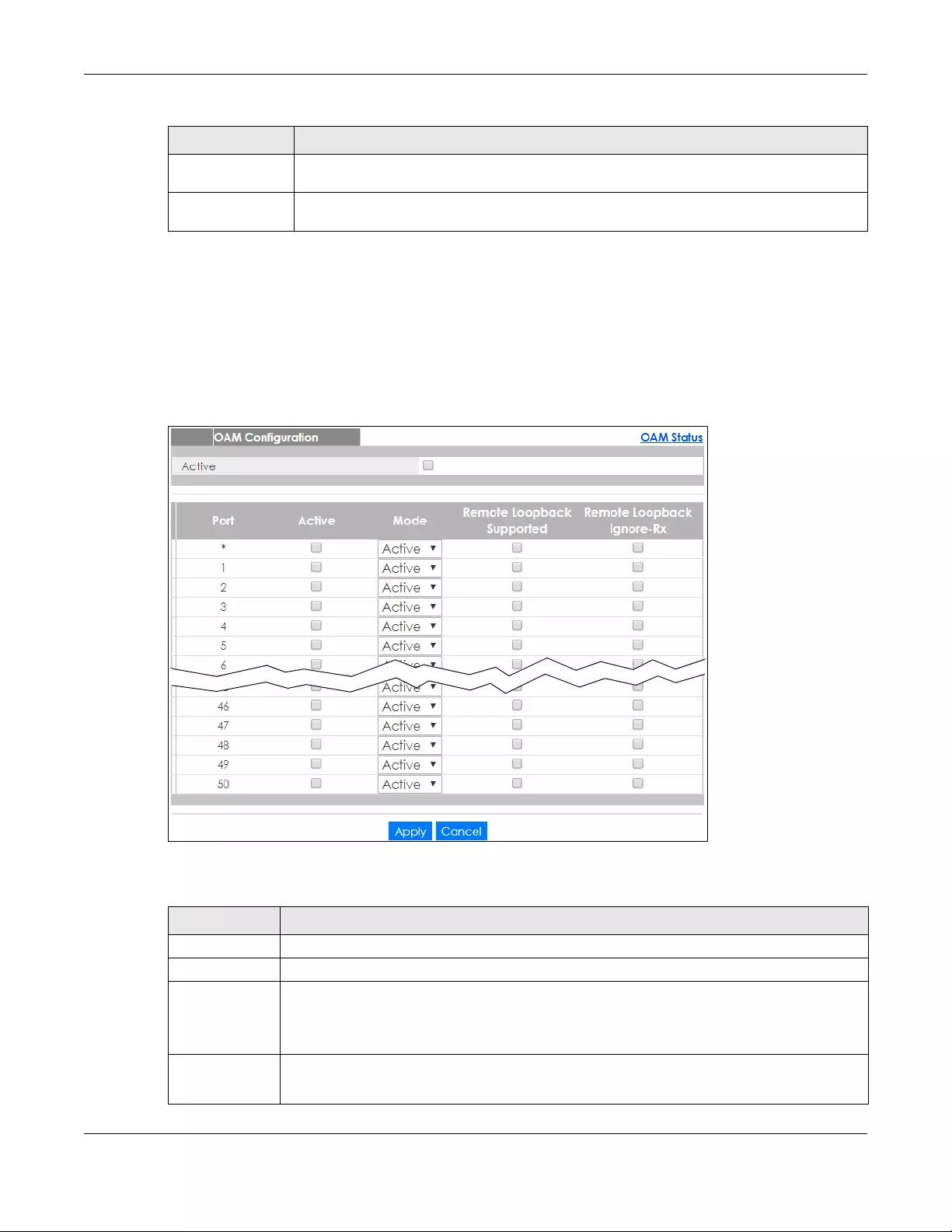
Chapter 34 OAM
GS1920v2 Series User’s Guide
313
34.3 OAM Configuration
Use this screen to turn on Ethernet OAM on the Switch and port(s) and configure the related settings.
In the OAM Status screen click Configuration to display the configuration screen as shown.
Figure 222 Advanced Application > OAM > OAM Configuration
The following table describes the labels in this screen.
Unsupported
OAMPDU Tx
This field displays the number of unsupported OAM PDUs sent on the port.
Unsupported
OAMPDU Rx
This field displays the number of unsupported OAM PDUs received on the port.
Table 145 Advanced Application > OAM Status > OAM Details (continued)
LABEL DESCRIPTION
Table 146 Advanced Application > OAM > OAM Configuration
LABEL DESCRIPTION
Active Select this option to enable Ethernet OAM on the Switch.
Port This field displays the Switch’s port number.
* Use this row to make the setting the same for all ports. Use this row first and then make
adjustments on a port-by-port basis.
Note: Changes in this row are copied to all the ports as soon as you make them.
Active Select this check box to enable Ethernet OAM on this port.
Clear this check box to disable Ethernet OAM on the port.

Chapter 34 OAM
GS1920v2 Series User’s Guide
314
34.4 OAM Remote Loopback
Use this screen to perform a remote-loopback test. In the OAM Status screen click Remote Loopback to
display the screen as shown.
Figure 223 Advanced Application > OAM > OAM Remote Loopback
The following table describes the labels in this screen.
Mode Specify the OAM mode on the port.
Select Active to allow the port to issue and respond to Ethernet OAM commands.
Select Passive to allow the port to respond to Ethernet OAM commands.
Remote
Loopback
Supported
Select this check box to enable the remote loopback feature on the port. Otherwise, clear the
check box to disable it.
Remote
Loopback
Ignore-Rx
Select this check box to set the Switch to process loopback commands received on the port.
Otherwise, clear the check box to have the Switch ignore loopback commands received on the
port.
Apply Click Apply to save your changes to the Switch’s run-time memory. The Switch loses these
changes if it is turned off or loses power, so use the Save link on the top navigation panel to save
your changes to the non-volatile memory when you are done configuring.
Cancel Click Cancel to begin configuring this screen afresh.
Table 146 Advanced Application > OAM > OAM Configuration (continued)
LABEL DESCRIPTION
Table 147 Advanced Application > OAM > OAM Remote Loopback
LABEL DESCRIPTION
Remote
Loopback Test
Port Enter the number of the port from which the Switch performs a remote-loopback test.
Number of
Packet Define the allowable packet number of the loopback test frames.

Chapter 34 OAM
GS1920v2 Series User’s Guide
315
Packet Size Define the allowable packet size of the loopback test frames.
Test Click Test to begin the test.
Remote
Loopback
Mode
Port Enter the number of the port from which the Switch sends loopback control PDUs to initiate or
terminate a remote-loopack test.
Start Click Start to initiate a remote-loopback test from the specified port by sending Enable
Loopback Control PDUs to the remote device.
Stop Click Stop to terminate a remote-loopback test from the specified port by sending Disable
Loopback Control PDUs to the remote device.
Table 147 Advanced Application > OAM > OAM Remote Loopback (continued)
LABEL DESCRIPTION

GS1920v2 Series User’s Guide
316
CHAPTER 35
Static Route
35.1 Static Routing Overview
This chapter shows you how to configure static routes.
The Switch uses IP for communication with management computers, for example using HTTP, Telnet, SSH,
or SNMP. Use IP static routes to have the Switch respond to remote management stations that are not
reachable through the default gateway. The Switch can also use static routes to send data to a server
or device that is not reachable through the default gateway, for example when sending SNMP traps or
using ping to test IP connectivity.
This figure shows a Telnet session coming in from network N1. The Switch sends reply traffic to default
gateway R1 which routes it back to the manager’s computer. The Switch needs a static route to tell it to
use router R2 to send traffic to an SNMP trap server on network N2.
Figure 224 Static Routing Overview
35.1.1 What You Can Do
• Use the Static Routing screen (Section 35.2 on page 316) to display the link to the IPv4 Static Route
screen.
• Use the IPv4 Static Route screen (Section 35.3 on page 317) to configure and enable an IPv4 static
route.
35.2 Static Routing
Click IP Application > Static Routing in the navigation panel to display the screen as shown.
N1 N2

Chapter 35 Static Route
GS1920v2 Series User’s Guide
317
Figure 225 IP Application > Static Routing
To enable IPv4 static route, configure the static route settings in the IP Application > Static Routing > IPv4
Static Route screen.
35.3 IPv4 Static Route
Click IP Application > Static Routing > IPv4 Static Route in the navigation panel to display the screen as
shown.
Figure 226 IP Application > Static Routing > IPv4 Static Route
The following table describes the related labels you use to create a static route.
Table 148 IP Application > Static Routing > IPv4 Static Route
LABEL DESCRIPTION
Active This field allows you to activate/deactivate this static route.
Name Enter a descriptive name (up to 10 printable ASCII characters) for identification purposes.
Destination IP
Address
This parameter specifies the IP network address of the final destination.
IP Subnet Mask Enter the subnet mask for this destination. Routing is always based on network number. If you
need to specify a route to a single host, use a subnet mask of 255.255.255.255 in the subnet mask
field to force the network number to be identical to the host ID.
Gateway IP
Address
Enter the IP address of the gateway. The gateway is an immediate neighbor of your Switch that
will forward the packet to the destination. The gateway must be a router on the same segment
as your Switch.

Chapter 35 Static Route
GS1920v2 Series User’s Guide
318
Metric The metric represents the “cost” of transmission for routing purposes. IP routing uses hop count as
the measurement of cost, with a minimum of 1 for directly connected networks. Enter a number
that approximates the cost for this link. The number need not be precise, but it must be between
1 and 15. In practice, 2 or 3 is usually a good number.
Add Click Add to insert a new static route to the Switch’s run-time memory. The Switch loses these
changes if it is turned off or loses power, so use the Save link on the top navigation panel to save
your changes to the non-volatile memory when you are done configuring.
Cancel Click Cancel to reset the above fields to your previous configuration.
Clear Click Clear to set the above fields back to the factory defaults.
Index This field displays the index number of the route. Click a number to edit the static route entry.
Active This field displays Yes when the static route is activated and NO when it is deactivated.
Name This field displays the descriptive name for this route. This is for identification purposes only.
Destination
Address
This field displays the IP network address of the final destination.
Subnet Mask This field displays the subnet mask for this destination.
Gateway
Address
This field displays the IP address of the gateway. The gateway is an immediate neighbor of your
Switch that will forward the packet to the destination.
Metric This field displays the cost of transmission for routing purposes.
Select an entry’s check box to select a specific entry. Otherwise, select the check box in the
table heading row to select all entries.
Delete Click Delete to remove the selected entry from the summary table.
Cancel Click Cancel to clear the check boxes.
Table 148 IP Application > Static Routing > IPv4 Static Route (continued)
LABEL DESCRIPTION

GS1920v2 Series User’s Guide
319
CHAPTER 36
Differentiated Services
36.1 DiffServ Overview
This chapter shows you how to configure Differentiated Services (DiffServ) on the Switch.
Quality of Service (QoS) is used to prioritize source-to-destination traffic flows. All packets in the flow are
given the same priority. You can use CoS (class of service) to give different priorities to different packet
types.
DiffServ is a class of service (CoS) model that marks packets so that they receive specific per-hop
treatment at DiffServ-compliant network devices along the route based on the application types and
traffic flow. Packets are marked with DiffServ Code Points (DSCPs) indicating the level of service desired.
This allows the intermediary DiffServ-compliant network devices to handle the packets differently
depending on the code points without the need to negotiate paths or remember state information for
every flow. In addition, applications do not have to request a particular service or give advanced
notice of where the traffic is going.
36.1.1 What You Can Do
• Use the DiffServ screen (Section 36.2 on page 320) to activate DiffServ to apply marking rules or IEEE
802.1p priority mapping on the Switch.
• Use the DSCP Setting screen (Section 36.3.1 on page 322) to change the DSCP-IEEE 802.1p mapping.
36.1.2 What You Need to Know
Read on for concepts on Differentiated Services that can help you configure the screens in this chapter.
DSCP and Per-Hop Behavior
DiffServ defines a new DS (Differentiated Services) field to replace the Type of Service (ToS) field in the IP
header. The DS field contains a 6-bit DSCP field which can define up to 64 service levels and the
remaining 2 bits are defined as currently unused (CU). The following figure illustrates the DS field.
Figure 227 DiffServ: Differentiated Service Field
DSCP is backward compatible with the three precedence bits in the ToS octet so that non-DiffServ
compliant, ToS-enabled network device will not conflict with the DSCP mapping.
The DSCP value determines the PHB (Per-Hop Behavior), that each packet gets as it is forwarded across
the DiffServ network. Based on the marking rule different kinds of traffic can be marked for different
priorities of forwarding. Resources can then be allocated according to the DSCP values and the
configured policies.
DSCP (6 bits) CU (2 bits)
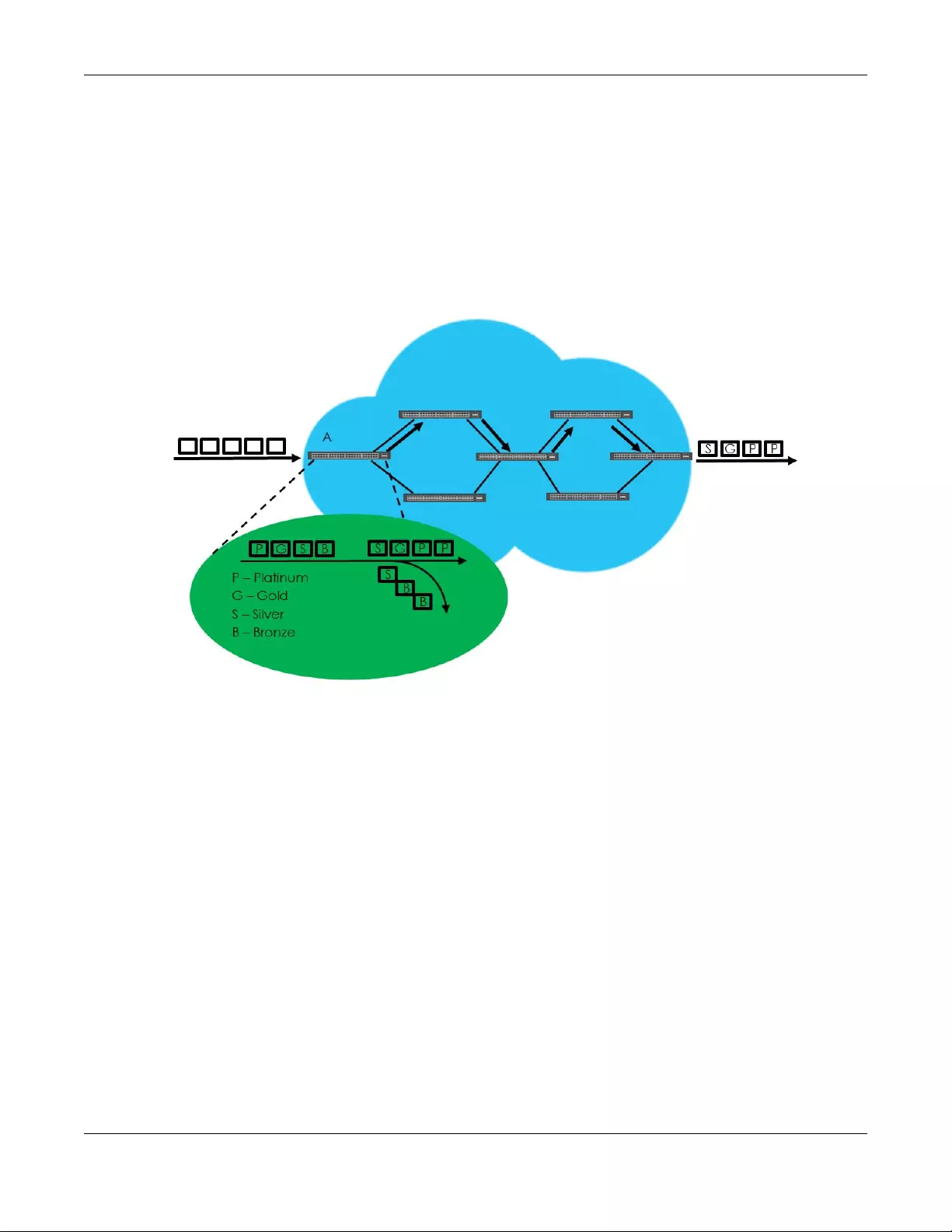
Chapter 36 Differentiated Services
GS1920v2 Series User’s Guide
320
DiffServ Network Example
The following figure depicts a DiffServ network consisting of a group of directly connected DiffServ-
compliant network devices. The boundary node (A in Figure 228) in a DiffServ network classifies (marks
with a DSCP value) the incoming packets into different traffic flows (Platinum, Gold, Silver, Bronze)
based on the configured marking rules. A network administrator can then apply various traffic policies to
the traffic flows. An example traffic policy, is to give higher drop precedence to one traffic flow over
others. In our example, packets in the Bronze traffic flow are more likely to be dropped when congestion
occurs than the packets in the Platinum traffic flow as they move across the DiffServ network.
Figure 228 DiffServ Network
36.2 Activating DiffServ
Activate DiffServ to apply marking rules or IEEE 802.1p priority mapping on the Switch.
Click IP Application > DiffServ in the navigation panel to display the screen as shown.

Chapter 36 Differentiated Services
GS1920v2 Series User’s Guide
321
Figure 229 IP Application > DiffServ
The following table describes the labels in this screen.
36.3 DSCP Settings
You can configure the DSCP to IEEE 802.1p mapping to allow the Switch to prioritize all traffic based on
the incoming DSCP value according to the DiffServ to IEEE 802.1p mapping table.
Table 149 IP Application > DiffServ
LABEL DESCRIPTION
Active Select this option to enable DiffServ on the Switch.
Port This field displays the index number of a port on the switch.
* Settings in this row apply to all ports.
Use this row only if you want to make some settings the same for all ports. Use this row first to set the
common settings and then make adjustments on a port-by-port basis.
Changes in this row are copied to all the ports as soon as you make them.
Active Select Active to enable Diffserv on the port.
Apply Click Apply to save your changes to the Switch’s run-time memory. The Switch loses these
changes if it is turned off or loses power, so use the Save link on the top navigation panel to save
your changes to the non-volatile memory when you are done configuring.
Cancel Click Cancel to begin configuring this screen afresh.

Chapter 36 Differentiated Services
GS1920v2 Series User’s Guide
322
The following table shows the default DSCP-to-IEEE802.1p mapping.
36.3.1 Configuring DSCP Settings
To change the DSCP-IEEE 802.1p mapping click the DSCP Setting link in the DiffServ screen to display the
screen as shown next.
Figure 230 IP Application > DiffServ > DSCP Setting
The following table describes the labels in this screen.
Table 150 Default DSCP-IEEE 802.1p Mapping
DSCP VALUE 0 – 7 8 – 15 16 – 23 24 – 31 32 – 39 40 – 47 48 – 55 56 – 63
IEEE 802.1p01234567
Table 151 IP Application > DiffServ > DSCP Setting
LABEL DESCRIPTION
0 … 63 This is the DSCP classification identification number.
To set the IEEE 802.1p priority mapping, select the priority level from the drop-down list box.
Apply Click Apply to save your changes to the Switch’s run-time memory. The Switch loses these changes if it
is turned off or loses power, so use the Save link on the top navigation panel to save your changes to
the non-volatile memory when you are done configuring.
Cancel Click Cancel to begin configuring this screen afresh.

GS1920v2 Series User’s Guide
323
CHAPTER 37
DHCP
37.1 DHCP Overview
This chapter shows you how to configure the DHCP feature.
DHCP (Dynamic Host Configuration Protocol RFC 2131 and RFC 2132) allows individual computers to
obtain TCP/IP configuration at start-up from a server. If you configure the Switch as a DHCP relay agent,
then the Switch forwards DHCP requests to DHCP server on your network. If you don’t configure the
Switch as a DHCP relay agent then you must have a DHCP server in the broadcast domain of the client
computers or else the client computers must be configured manually.
37.1.1 What You Can Do
• Use the DHCPv4 Status screen (Section 37.3 on page 324) to display the relay mode.
• Use the DHCPv4 Relay screen (Section 37.4 on page 324) to enable and configure global DHCPv4
relay.
• Use the VLAN Setting screen (Section 37.4.6 on page 330) to configure your DHCPv4 settings based on
the VLAN domain of the DHCPv4 clients.
• Use the DHCPv6 Relay screen (Section 37.5 on page 333) to enable and configure DHCPv6 relay.
37.1.2 What You Need to Know
Read on for concepts on DHCP that can help you configure the screens in this chapter.
DHCP Modes
If there is already a DHCP server on your network, then you can configure the Switch as a DHCP relay
agent. When the Switch receives a request from a computer on your network, it contacts the DHCP
server for the necessary IP information, and then relays the assigned information back to the computer.
DHCPv4 Configuration Options
The DHCPv4 configuration on the Switch is divided into Global and VLAN screens. The screen you should
use for configuration depends on the DHCP services you want to offer the DHCP clients on your network.
Choose the configuration screen based on the following criteria:
•Global - The Switch forwards all DHCP requests to the same DHCP server.
•VLAN - The Switch is configured on a VLAN by VLAN basis. The Switch can be configured to relay
DHCP requests to different DHCP servers for clients in different VLAN.
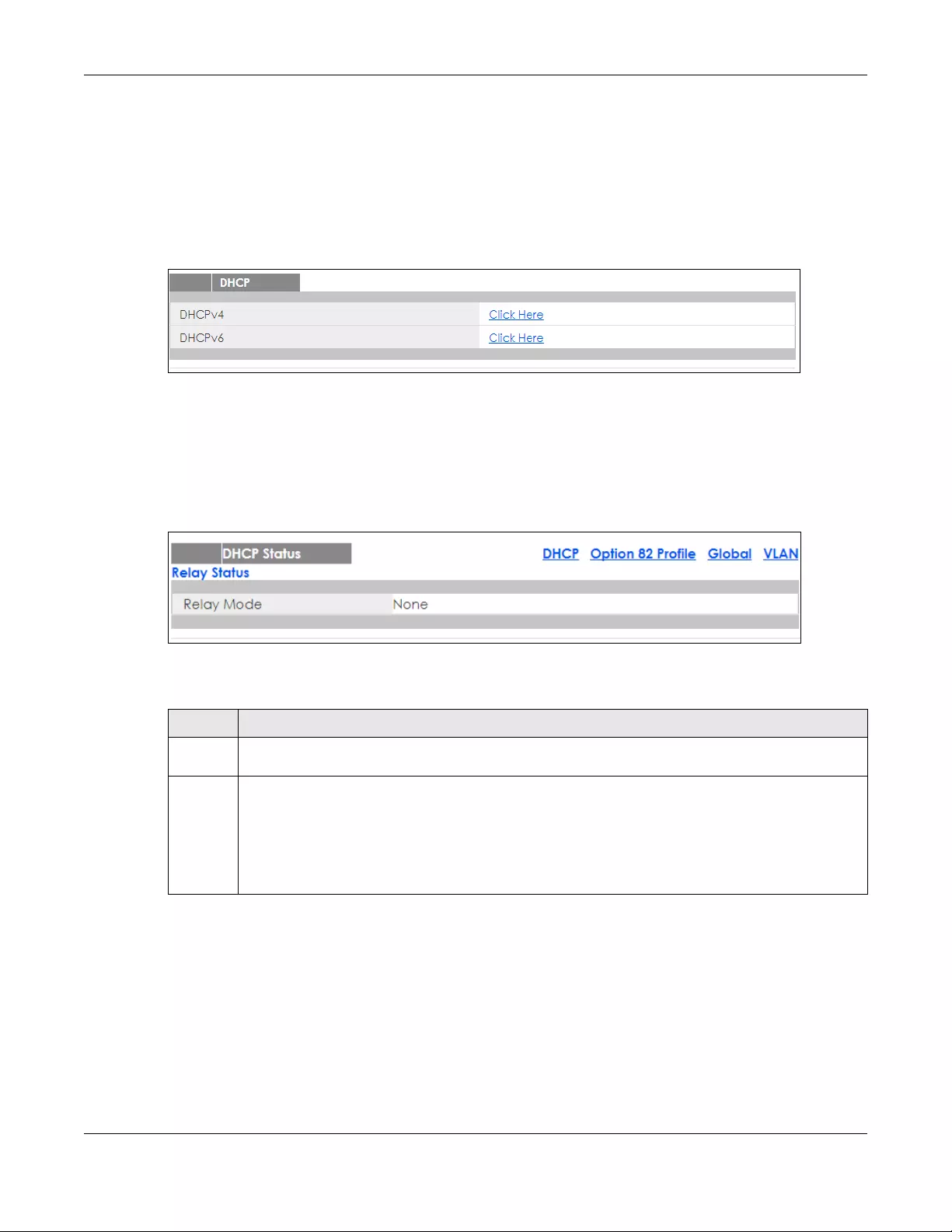
Chapter 37 DHCP
GS1920v2 Series User’s Guide
324
37.2 DHCP Configuration
Click IP Application > DHCP in the navigation panel to display the screen as shown. Click the link next to
DHCPv4 to open screens where you can enable and configure DHCPv4 relay settings and create option
82 profiles. Click the link next to DHCPv6 to open a screen where you can configure DHCPv6 relay
settings.
Figure 231 IP Application > DHCP
37.3 DHCPv4 Status
Click IP Application > DHCP > DHCPv4 in the navigation panel. The DHCP Status screen displays.
Figure 232 IP Application > DHCP > DHCPv4
The following table describes the labels in this screen.
37.4 DHCPv4 Relay
Configure DHCP relay on the Switch if the DHCP clients and the DHCP server are not in the same
broadcast domain. During the initial IP address leasing, the Switch helps to relay network information
(such as the IP address and subnet mask) between a DHCP client and a DHCP server. Once the DHCP
client obtains an IP address and can connect to the network, network information renewal is done
between the DHCP client and the DHCP server without the help of the Switch.
Table 152 IP Application > DHCP > DHCPv4
LABEL DESCRIPTION
Relay
Status
This section displays configuration settings related to the Switch’s DHCP relay mode.
Relay
Mode
This field displays:
None - if the Switch is not configured as a DHCP relay agent.
Global - if the Switch is configured as a DHCP relay agent only.
VLAN - followed by a VLAN ID or multiple VLAN IDs if it is configured as a relay agent for specific
VLAN(s).

Chapter 37 DHCP
GS1920v2 Series User’s Guide
325
The Switch can be configured as a global DHCP relay. This means that the Switch forwards all DHCP
requests from all domains to the same DHCP server. You can also configure the Switch to relay DHCP
information based on the VLAN membership of the DHCP clients.
37.4.1 DHCPv4 Relay Agent Information
The Switch can add information about the source of client DHCP requests that it relays to a DHCP server
by adding Relay Agent Information. This helps provide authentication about the source of the requests.
The DHCP server can then provide an IP address based on this information. Please refer to RFC 3046 for
more details.
The DHCP Relay Agent Information feature adds an Agent Information field (also known as the Option
82 field) to DHCP requests. The Option 82 field is in the DHCP headers of client DHCP request frames that
the Switch relays to a DHCP server.
Relay Agent Information can include the System Name of the Switch if you select this option. You can
change the System Name in Basic Settings > General Setup.
The following describes the DHCP relay agent information that the Switch sends to the DHCP server:
37.4.1.1 DHCPv4 Relay Agent Information Format
A DHCP Relay Agent Information option has the following format.
i1, i2 and iN are DHCP relay agent sub-options, which contain additional information about the DHCP
client. You need to define at least one sub-option.
37.4.1.2 Sub-Option Format
There are two types of sub-option: “Agent Circuit ID Sub-option” and “Agent Remote ID Sub-option”.
They have the following formats.
Table 153 Relay Agent Information
FIELD LABELS DESCRIPTION
Slot ID (1 byte) This value is always 0 for stand-alone switches.
Port ID (1 byte) This is the port that the DHCP client is connected to.
VLAN ID (2 bytes) This is the VLAN that the port belongs to.
Information (up to 64 bytes) This optional, read-only field is set according to system name set in Basic
Settings > General Setup.
Table 154 DHCP Relay Agent Information Option Format
Code
(82)
Length
(N)
i1 i2
...
iN
Table 155 DHCP Relay Agent Circuit ID Sub-option Format
SubOpt Code Length Value
1
(1 byte)
N
(1 byte)
Slot ID, Port ID, VLAN ID, System Name or String
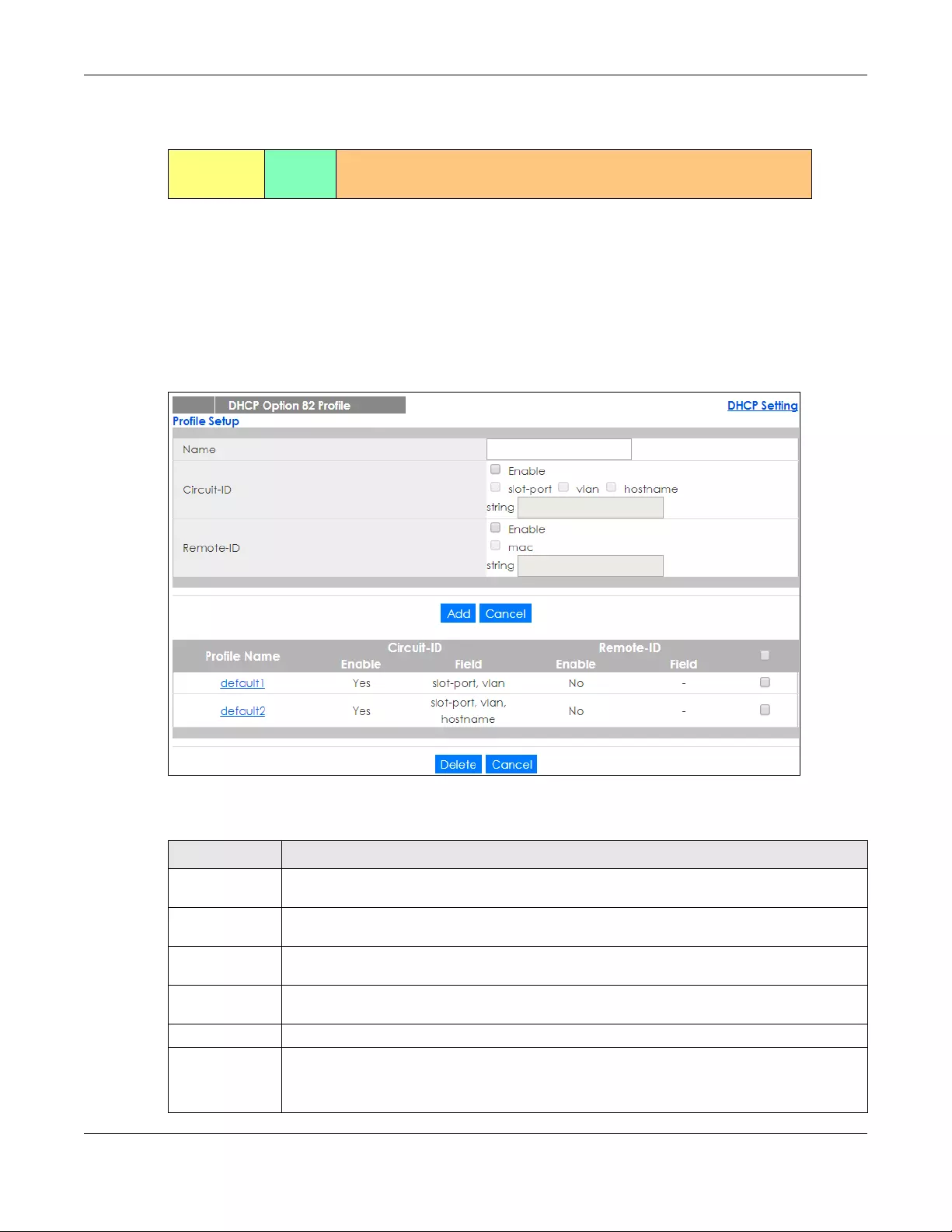
Chapter 37 DHCP
GS1920v2 Series User’s Guide
326
The 1 in the first field identifies this as an Agent Circuit ID sub-option and 2 identifies this as an Agent
Remote ID sub-option. The next field specifies the length of the field.
37.4.2 DHCPv4 Option 82 Profile
Use this screen to create DHCPv4 option 82 profiles. Click IP Application > DHCP > DHCPv4 in the
navigation panel and click the Option 82 Profile link to display the screen as shown.
Figure 233 IP Application > DHCP > DHCPv4 > Option 82 Profile
The following table describes the labels in this screen.
Table 156 DHCP Relay Agent Remote ID Sub-option Format
SubOpt Code Length Value
2
(1 byte)
N
(1 byte)
MAC Address or String
Table 157 IP Application > DHCP > DHCPv4 > Option 82 Profile
LABEL DESCRIPTION
Name Enter a descriptive name for the profile for identification purposes. You can use up to 32 ASCII
characters. Spaces are allowed.
Circuit-ID Use this section to configure the Circuit ID sub-option to include information that is specific to
the relay agent (the Switch).
Enable Select this option to have the Switch add the Circuit ID sub-option to client DHCP requests that it
relays to a DHCP server.
slot-port Select this option to have the Switch add the number of port that the DHCP client is connected
to.
vlan Select this option to have the Switch add the ID of VLAN which the port belongs to.
hostname This is the system name you configure in the Basic Setting > General Setup screen.
Select this option for the Switch to add the system name to the client DHCP requests that it
relays to a DHCP server.

Chapter 37 DHCP
GS1920v2 Series User’s Guide
327
37.4.3 Configuring DHCPv4 Global Relay
Use this screen to configure global DHCPv4 relay. Click IP Application > DHCP > DHCPv4 in the
navigation panel and click the Global link to display the screen as shown.
Figure 234 IP Application > DHCP > DHCPv4 > Global
string Enter a string of up to 64 ASCII characters that the Switch adds into the client DHCP requests.
Spaces are allowed.
Remote-ID Use this section to configure the Remote ID sub-option to include information that identifies the
relay agent (the Switch).
Enable Select this option to have the Switch append the Remote ID sub-option to the option 82 field of
DHCP requests.
mac Select this option to have the Switch add its MAC address to the client DHCP requests that it
relays to a DHCP server.
string Enter a string of up to 64 ASCII characters for the remote ID information in this field. Spaces are
allowed.
Add Click this to create a new entry or to update an existing one.
This saves your changes to the Switch’s run-time memory. The Switch loses these changes if it is
turned off or loses power, so use the Save link on the top navigation panel to save your changes
to the non-volatile memory when you are done configuring.
Cancel Click Cancel to reset the fields to their last saved values.
Profile Name This field displays the descriptive name of the profile. Click the name to change the settings.
Circuit-ID
Enable This field displays whether the Circuit ID sub-option is added to client DHCP requests.
Field This field displays the information that is included in the Circuit ID sub-option.
Remote-ID
Enable This field displays whether the Remote ID sub-option is added to client DHCP requests.
Field This field displays the information that is included in the Remote ID sub-option.
Select an entry’s check box to select a specific entry. Otherwise, select the check box in the
table heading row to select all entries.
Delete Check the entry(ies) that you want to remove and then click the Delete button.
Cancel Click Cancel to clear the selected check box(es).
Table 157 IP Application > DHCP > DHCPv4 > Option 82 Profile (continued)
LABEL DESCRIPTION
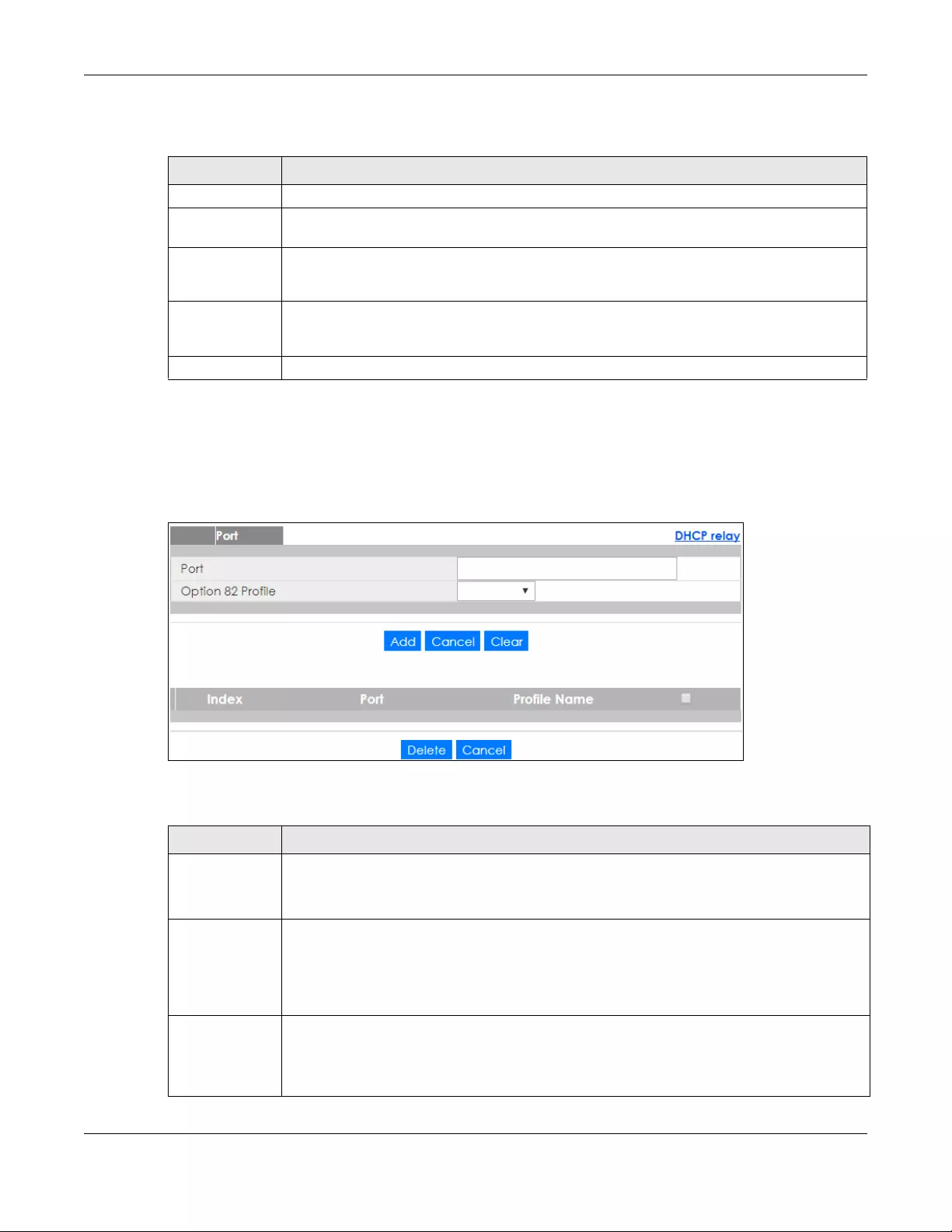
Chapter 37 DHCP
GS1920v2 Series User’s Guide
328
The following table describes the labels in this screen.
37.4.4 DHCPv4 Global Relay Port Configure
Use this screen to apply a different DHCP option 82 profile to certain ports on the Switch. To open this
screen, click IP Application > DHCP > DHCPv4 > Global > Port.
Figure 235 IP Application > DHCP > DHCPv4 > Global > Port
The following table describes the labels in this screen.
Table 158 IP Application > DHCP > DHCPv4 > Global
LABEL DESCRIPTION
Active Select this check box to enable DHCPv4 relay.
Remote DHCP
Server 1 .. 3
Enter the IP address of a DHCPv4 server in dotted decimal notation.
Option 82 Profile Select a pre-defined DHCPv4 option 82 profile that the Switch applies to all ports. The Switch
adds the Circuit ID sub-option and/or Remote ID sub-option specified in the profile to DHCP
requests that it relays to a DHCP server.
Apply Click Apply to save your changes to the Switch’s run-time memory. The Switch loses these
changes if it is turned off or loses power, so use the Save link on the top navigation panel to save
your changes to the non-volatile memory when you are done configuring.
Cancel Click Cancel to begin configuring this screen afresh.
Table 159 IP Application > DHCP > DHCPv4 > Global > Port
LABEL DESCRIPTION
Port Enter the number of port(s) to which you want to apply the specified DHCP option 82 profile.
You can enter multiple ports separated by (no space) comma (,) or hyphen (-). For example,
enter “3-5” for ports 3, 4, and 5. Enter “3,5,7” for ports 3, 5, and 7.
Option 82 Profile Select a pre-defined DHCP option 82 profile that the Switch applies to the specified port(s). The
Switch adds the Circuit ID sub-option and/or Remote ID sub-option specified in the profile to
DHCP requests that it relays to a DHCP server.
The profile you select here has priority over the one you select in the DHCP > DHCPv4 > Global
screen.
Add Click this to create a new entry or to update an existing one.
This saves your changes to the Switch’s run-time memory. The Switch loses these changes if it is
turned off or loses power, so use the Save link on the top navigation panel to save your changes
to the non-volatile memory when you are done configuring.

Chapter 37 DHCP
GS1920v2 Series User’s Guide
329
37.4.5 Global DHCP Relay Configuration Example
The follow figure shows a network example where the Switch is used to relay DHCP requests for the
VLAN1 and VLAN2 domains. There is only one DHCP server that services the DHCP clients in both
domains.
Figure 236 Global DHCP Relay Network Example
Configure the DHCP Relay screen as shown. Make sure you select a DHCP option 82 profile (default1 in
this example) to set the Switch to send additional information (such as the VLAN ID) together with the
DHCP requests to the DHCP server. This allows the DHCP server to assign the appropriate IP address
according to the VLAN ID.
Cancel Click this to reset the values above based on the last selected entry or, if not applicable, to clear
the fields above.
Clear Click Clear to reset the fields to the factory defaults.
Index This field displays a sequential number for each entry. Click an index number to change the
settings.
Port This field displays the port(s) to which the Switch applies the settings.
Profile Name This field displays the DHCP option 82 profile that the Switch applies to the port(s).
Select an entry’s check box to select a specific entry. Otherwise, select the check box in the
table heading row to select all entries.
Delete Select the entry(ies) that you want to remove, then click the Delete button to remove the
selected entry(ies) from the table.
Cancel Click this to clear the check boxes above.
Table 159 IP Application > DHCP > DHCPv4 > Global > Port (continued)
LABEL DESCRIPTION

Chapter 37 DHCP
GS1920v2 Series User’s Guide
330
Figure 237 DHCP Relay Configuration Example
37.4.6 Configuring DHCP VLAN Settings
Use this screen to configure your DHCP settings based on the VLAN domain of the DHCP clients. Click IP
Application > DHCP > DHCPv4 in the navigation panel, then click the VLAN link In the DHCP Status screen
that displays.
Note: You must set up a management IP address for each VLAN that you want to configure
DHCP settings for on the Switch. See Section 5.1.3 on page 58 for information on how to
do this.
Figure 238 IP Application > DHCP > DHCPv4 > VLAN
The following table describes the labels in this screen.
EXAMPLE
Table 160 IP Application > DHCP > DHCPv4 > VLAN
LABEL DESCRIPTION
VID Enter the ID number of the VLAN to which these DHCP settings apply.
Remote DHCP
Server 1 .. 3
Enter the IP address of a DHCP server in dotted decimal notation.
Option 82 Profile Select a pre-defined DHCP option 82 profile that the Switch applies to all ports in this VLAN. The
Switch adds the Circuit ID sub-option and/or Remote ID sub-option specified in the profile to
DHCP requests that it relays to a DHCP server.
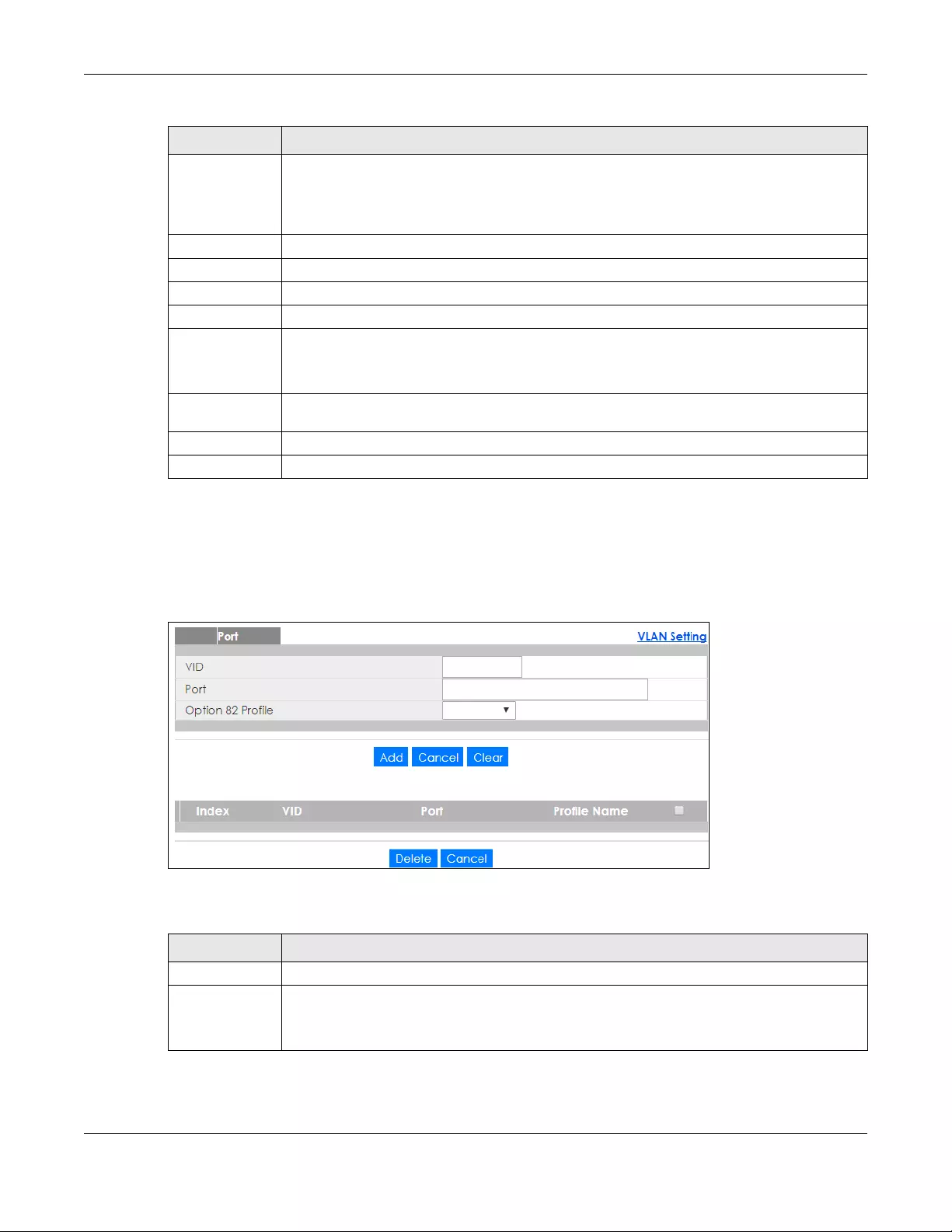
Chapter 37 DHCP
GS1920v2 Series User’s Guide
331
37.4.7 DHCPv4 VLAN Port Configure
Use this screen to apply a different DHCP option 82 profile to certain ports in a VLAN. To open this screen,
click IP Application > DHCP > DHCPv4 > VLAN > Port.
Figure 239 IP Application > DHCP > DHCPv4 > VLAN > Port
The following table describes the labels in this screen.
Add Click this to create a new entry or to update an existing one.
This saves your changes to the Switch’s run-time memory. The Switch loses these changes if it is
turned off or loses power, so use the Save link on the top navigation panel to save your changes
to the non-volatile memory when you are done configuring.
Cancel Click Cancel to begin configuring this screen afresh.
Clear Click Clear to reset the fields to the factory defaults.
VID This field displays the ID number of the VLAN group to which this DHCP settings apply.
Type This field displays Relay for the DHCP mode.
DHCP Status For DHCP server configuration, this field displays the starting IP address and the size of the IP
address pool.
For DHCP relay configuration, this field displays the first remote DHCP server IP address.
Select an entry’s check box to select a specific entry. Otherwise, select the check box in the
table heading row to select all entries.
Delete Select the configuration entries you want to remove and click Delete to remove them.
Cancel Click Cancel to clear the check boxes.
Table 160 IP Application > DHCP > DHCPv4 > VLAN (continued)
LABEL DESCRIPTION
Table 161 IP Application > DHCP > DHCPv4 > VLAN > Port
LABEL DESCRIPTION
VID Enter the ID number of the VLAN you want to configure here.
Port Enter the number of port(s) to which you want to apply the specified DHCP option 82 profile.
You can enter multiple ports separated by (no space) comma (,) or hyphen (-). For example,
enter “3-5” for ports 3, 4, and 5. Enter “3,5,7” for ports 3, 5, and 7.
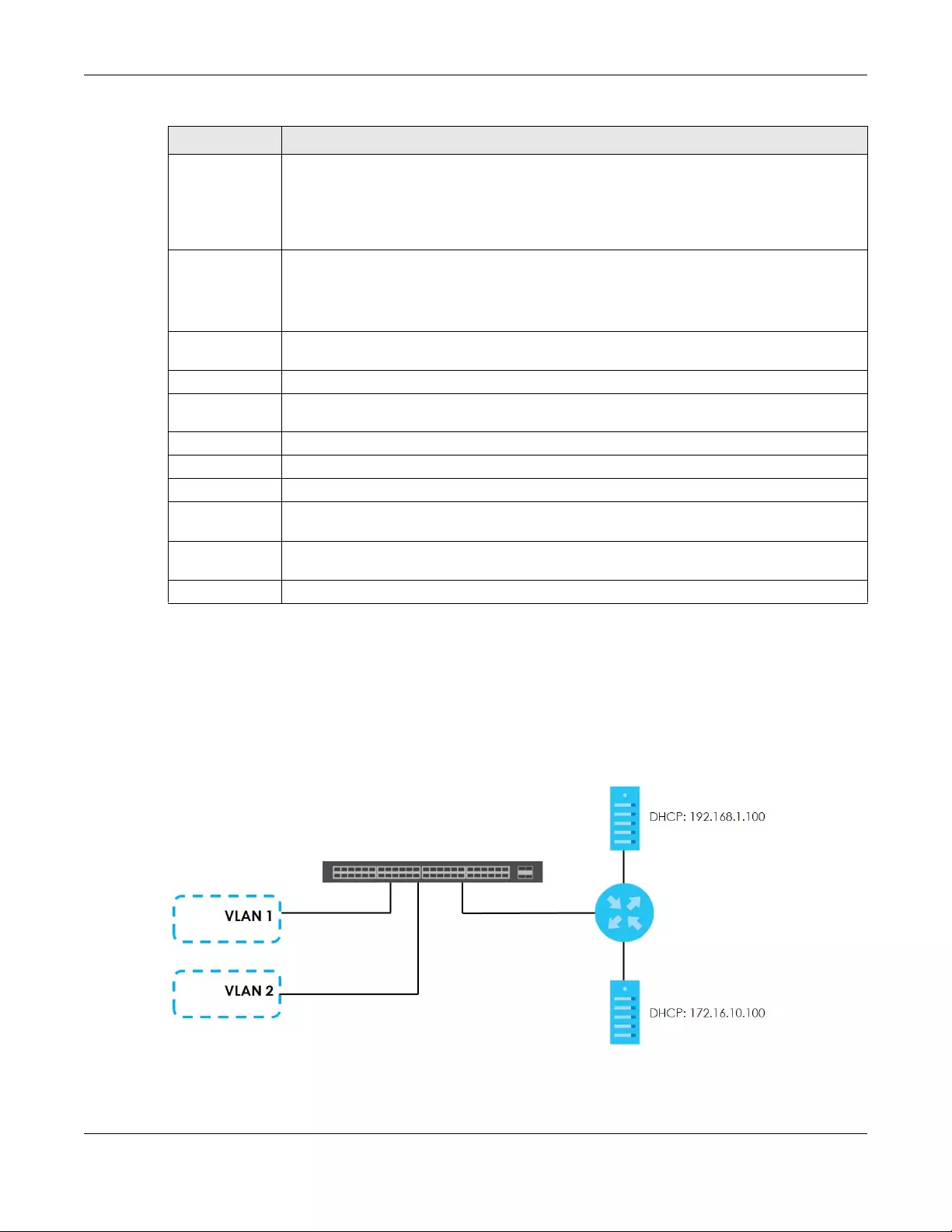
Chapter 37 DHCP
GS1920v2 Series User’s Guide
332
37.4.8 Example: DHCP Relay for Two VLANs
The following example displays two VLANs (VIDs 1 and 2) for a campus network. Two DHCP servers are
installed to serve each VLAN. The system is set up to forward DHCP requests from the dormitory rooms
(VLAN 1) to the DHCP server with an IP address of 192.168.1.100. Requests from the academic buildings
(VLAN 2) are sent to the other DHCP server with an IP address of 172.16.10.100.
Figure 240 DHCP Relay for Two VLANs
For the example network, configure the VLAN Setting screen as shown.
Option 82 Profile Select a pre-defined DHCP option 82 profile that the Switch applies to the specified port(s) in this
VLAN. The Switch adds the Circuit ID sub-option and/or Remote ID sub-option specified in the
profile to DHCP requests that it relays to a DHCP server.
The profile you select here has priority over the one you select in the DHCP > DHCPv4 > VLAN
screen.
Add Click this to create a new entry or to update an existing one.
This saves your changes to the Switch’s run-time memory. The Switch loses these changes if it is
turned off or loses power, so use the Save link on the top navigation panel to save your changes
to the non-volatile memory when you are done configuring.
Cancel Click this to reset the values above based on the last selected entry or, if not applicable, to
clear the fields above.
Clear Click Clear to reset the fields to the factory defaults.
Index This field displays a sequential number for each entry. Click an index number to change the
settings.
VID This field displays the VLAN to which the port(s) belongs.
Port This field displays the port(s) to which the Switch applies the settings.
Profile Name This field displays the DHCP option 82 profile that the Switch applies to the port(s) in this VLAN.
Select an entry’s check box to select a specific entry. Otherwise, select the check box in the
table heading row to select all entries.
Delete Select the entry(ies) that you want to remove, then click the Delete button to remove the
selected entry(ies) from the table.
Cancel Click this to clear the check boxes above.
Table 161 IP Application > DHCP > DHCPv4 > VLAN > Port (continued)
LABEL DESCRIPTION
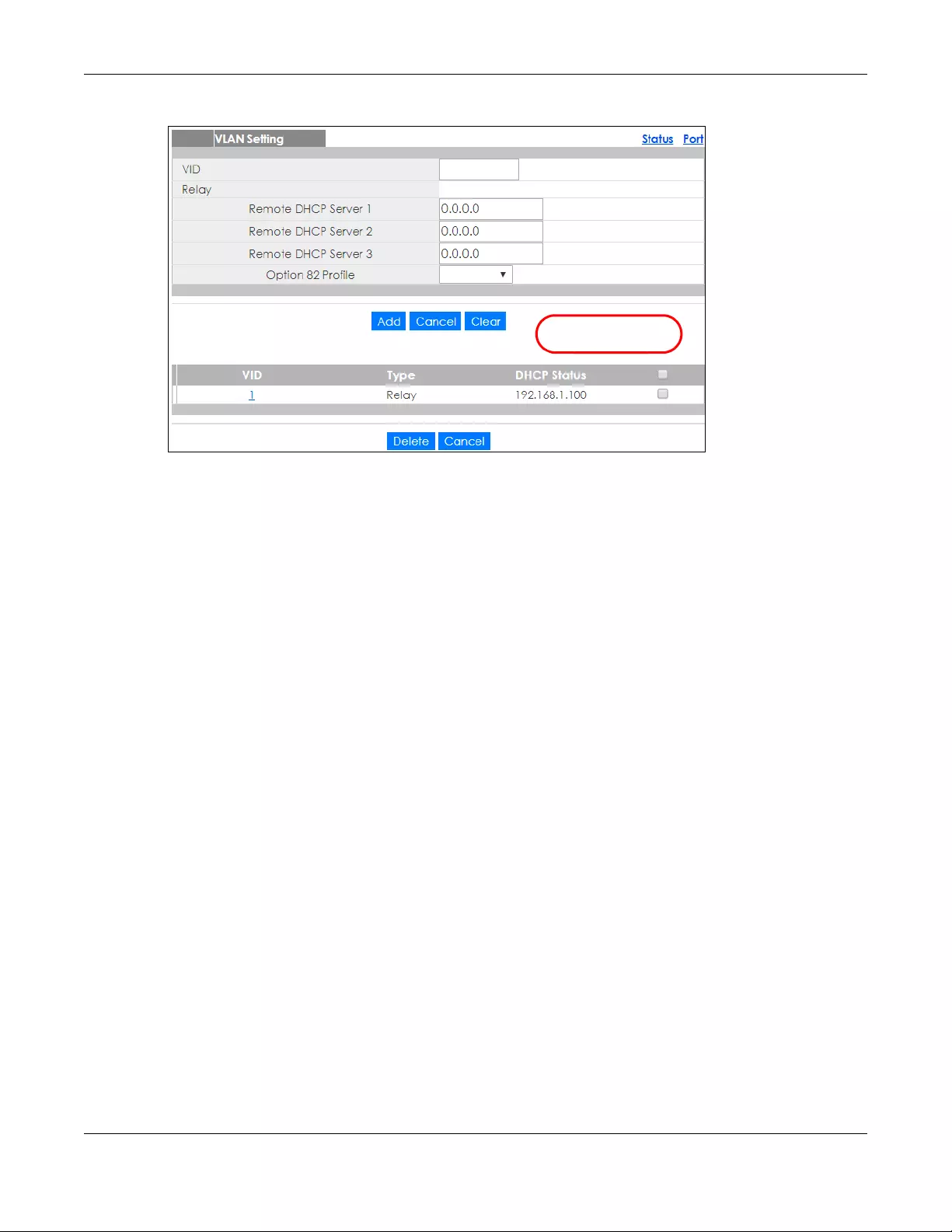
Chapter 37 DHCP
GS1920v2 Series User’s Guide
333
Figure 241 DHCP Relay for Two VLANs Configuration Example
37.5 DHCPv6 Relay
A DHCPv6 relay agent is on the same network as the DHCPv6 clients and helps forward messages
between the DHCPv6 server and clients. When a client cannot use its link-local address and a well-
known multicast address to locate a DHCPv6 server on its network, it then needs a DHCPv6 relay agent
to send a message to a DHCPv6 server that is not attached to the same network.
The DHCPv6 relay agent can add the remote identification (remote-ID) option and the interface-ID
option to the Relay-Forward DHCPv6 messages. The remote-ID option carries a user-defined string, such
as the system name. The interface-ID option provides slot number, port information and the VLAN ID to
the DHCPv6 server. The remote-ID option (if any) is stripped from the Relay-Reply messages before the
relay agent sends the packets to the clients. The DHCPv6 server copies the interface-ID option from the
Relay-Forward message into the Relay-Reply message and sends it to the relay agent. The interface-ID
should not change even after the relay agent restarts.
Use this screen to configure DHCPv6 relay settings for a specific VLAN on the Switch. Click IP Application
> DHCP > DHCPv6 in the navigation panel to display the screen as shown.
EXAMPLE

Chapter 37 DHCP
GS1920v2 Series User’s Guide
334
Figure 242 IP Application > DHCP > DHCPv6
The following table describes the labels in this screen.
Table 162 IP Application > DHCP > DHCPv6
LABEL DESCRIPTION
VID Enter the ID number of the VLAN you want to configure here.
Helper Address Enter the remote DHCPv6 server address for the specified VLAN.
Options
Interface ID Select this option to have the Switch add the interface-ID option in the DHCPv6 requests from
the clients in the specified VLAN before the Switch forwards them to a DHCPv6 server.
Remote ID Enter a string of up to 64 printable characters to be carried in the remote-ID option. The Switch
adds the remote-ID option in the DHCPv6 requests from the clients in the specified VLAN before
the Switch forwards them to a DHCPv6 server.
Add Click this to create a new entry or to update an existing one.
This saves your changes to the Switch’s run-time memory. The Switch loses these changes if it is
turned off or loses power, so use the Save link on the top navigation panel to save your changes
to the non-volatile memory when you are done configuring.
Cancel Click Cancel to reset the fields to their last saved values.
Clear Click Clear to reset the fields to the factory defaults.
VID This field displays the VLAN ID number. Click the VLAN ID to change the settings.
Helper Address This field displays the IPv6 address of the remote DHCPv6 server for this VLAN.
Interface ID This field displays whether the interface-ID option is added to DHCPv6 requests from clients in this
VLAN.
Remote ID This field displays whether the remote-ID option is added to DHCPv6 requests from clients in this
VLAN.
Select an entry’s check box to select a specific entry. Otherwise, select the check box in the
table heading row to select all entries.
Delete Check the entry(ies) that you want to remove and then click the Delete button.
Cancel Click Cancel to clear the selected check boxes.

GS1920v2 Series User’s Guide
335
CHAPTER 38
ARP Setup
38.1 ARP Overview
Address Resolution Protocol (ARP) is a protocol for mapping an Internet Protocol address (IP address) to
a physical machine address, also known as a Media Access Control or MAC address, on the local area
network.
An IP (version 4) address is 32 bits long. In an Ethernet LAN, MAC addresses are 48 bits long. The ARP
table maintains an association between each MAC address and its corresponding IP address.
38.1.1 What You Can Do
Use the ARP Learning screen (Section 38.2.1 on page 337) to configure ARP learning mode on a per-port
basis.
38.1.2 What You Need to Know
Read on for concepts on ARP that can help you configure the screen in this chapter.
38.1.2.1 How ARP Works
When an incoming packet destined for a host device on a local area network arrives at the Switch, the
Switch looks in the ARP Table and if it finds the address, it sends it to the device.
If no entry is found for the IP address, ARP broadcasts the request to all the devices on the LAN. The
Switch fills in its own MAC and IP address in the sender address fields, and puts the known IP address of
the target in the target IP address field. In addition, the Switch puts all ones in the target MAC field
(FF.FF.FF.FF.FF.FF is the Ethernet broadcast address). The replying device (which is either the IP address of
the device being sought or the router that knows the way) replaces the broadcast address with the
target's MAC address, swaps the sender and target pairs, and unicasts the answer directly back to the
requesting machine. ARP updates the ARP Table for future reference and then sends the packet to the
MAC address that replied.
38.1.2.2 ARP Learning Mode
The Switch supports three ARP learning modes: ARP-Reply, Gratuitous-ARP, and ARP-Request.
ARP-Reply
The Switch in ARP-Reply learning mode updates the ARP table only with the ARP replies to the ARP
requests sent by the Switch. This can help prevent ARP spoofing.
In the following example, the Switch does not have IP address and MAC address mapping information
for hosts A and B in its ARP table, and host A wants to ping host B. Host A sends an ARP request to the

Chapter 38 ARP Setup
GS1920v2 Series User’s Guide
336
Switch and then sends an ICMP request after getting the ARP reply from the Switch. The Switch finds no
matched entry for host B in the ARP table and broadcasts the ARP request to all the devices on the LAN.
When the Switch receives the ARP reply from host B, it updates its ARP table and also forwards host A’s
ICMP request to host B. After the Switch gets the ICMP reply from host B, it sends out an ARP request to
get host A’s MAC address and updates the ARP table with host A’s ARP reply. The Switch then can
forward host B’s ICMP reply to host A.
Gratuitous-ARP
A gratuitous ARP is an ARP request in which both the source and destination IP address fields are set to
the IP address of the device that sends this request and the destination MAC address field is set to the
broadcast address. There will be no reply to a gratuitous ARP request.
A device may send a gratuitous ARP packet to detect IP collisions. If a device restarts or its MAC address
is changed, it can also use gratuitous ARP to inform other devices in the same network to update their
ARP table with the new mapping information.
In Gratuitous-ARP learning mode, the Switch updates its ARP table with either an ARP reply or a
gratuitous ARP request.
ARP-Request
When the Switch is in ARP-Request learning mode, it updates the ARP table with both ARP replies,
gratuitous ARP requests and ARP requests.
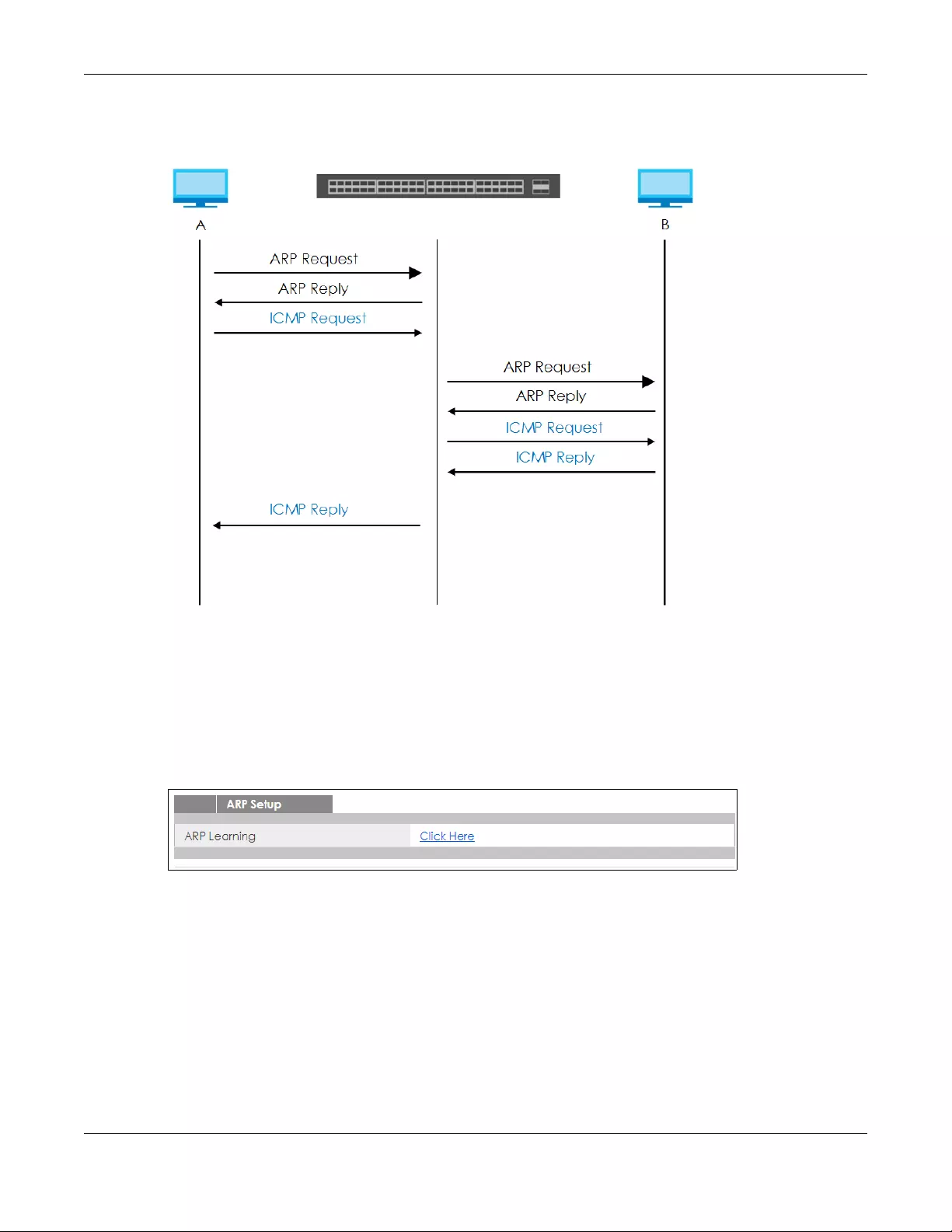
Chapter 38 ARP Setup
GS1920v2 Series User’s Guide
337
Therefore in the following example, the Switch can learn host A’s MAC address from the ARP request
sent by host A. The Switch then forwards host B’s ICMP reply to host A right after getting host B’s MAC
address and ICMP reply.
38.2 ARP Setup
Click IP Application > ARP Setup in the navigation panel to display the screen as shown. Click the link
next to ARP Learning to open a screen where you can set the ARP learning mode for each port.
Figure 243 IP Application > ARP Setup
38.2.1 ARP Learning
Use this screen to configure each port’s ARP learning mode. Click the link next to ARP Learning in the IP
Application > ARP Setup screen to display the screen as shown next.

Chapter 38 ARP Setup
GS1920v2 Series User’s Guide
338
Figure 244 IP Application > ARP Setup > ARP Learning
The following table describes the labels in this screen.
Table 163 IP Application > ARP Setup > ARP Learning
LABEL DESCRIPTION
Port This field displays the port number.
* Settings in this row apply to all ports.
Use this row only if you want to make some settings the same for all ports. Use this row first to set
the common settings and then make adjustments on a port-by-port basis.
Changes in this row are copied to all the ports as soon as you make them.
ARP Learning
Mode
Select the ARP learning mode the Switch uses on the port.
Select ARP-Reply to have the Switch update the ARP table only with the ARP replies to the ARP
requests sent by the Switch.
Select Gratuitous-ARP to have the Switch update its ARP table with either an ARP reply or a
gratuitous ARP request.
Select ARP-Request to have the Switch update the ARP table with both ARP replies, gratuitous
ARP requests and ARP requests.
Apply Click Apply to save your changes to the Switch’s run-time memory. The Switch loses these
changes if it is turned off or loses power, so use the Save link on the top navigation panel to save
your changes to the non-volatile memory when you are done configuring.
Cancel Click Cancel to begin configuring this screen afresh.
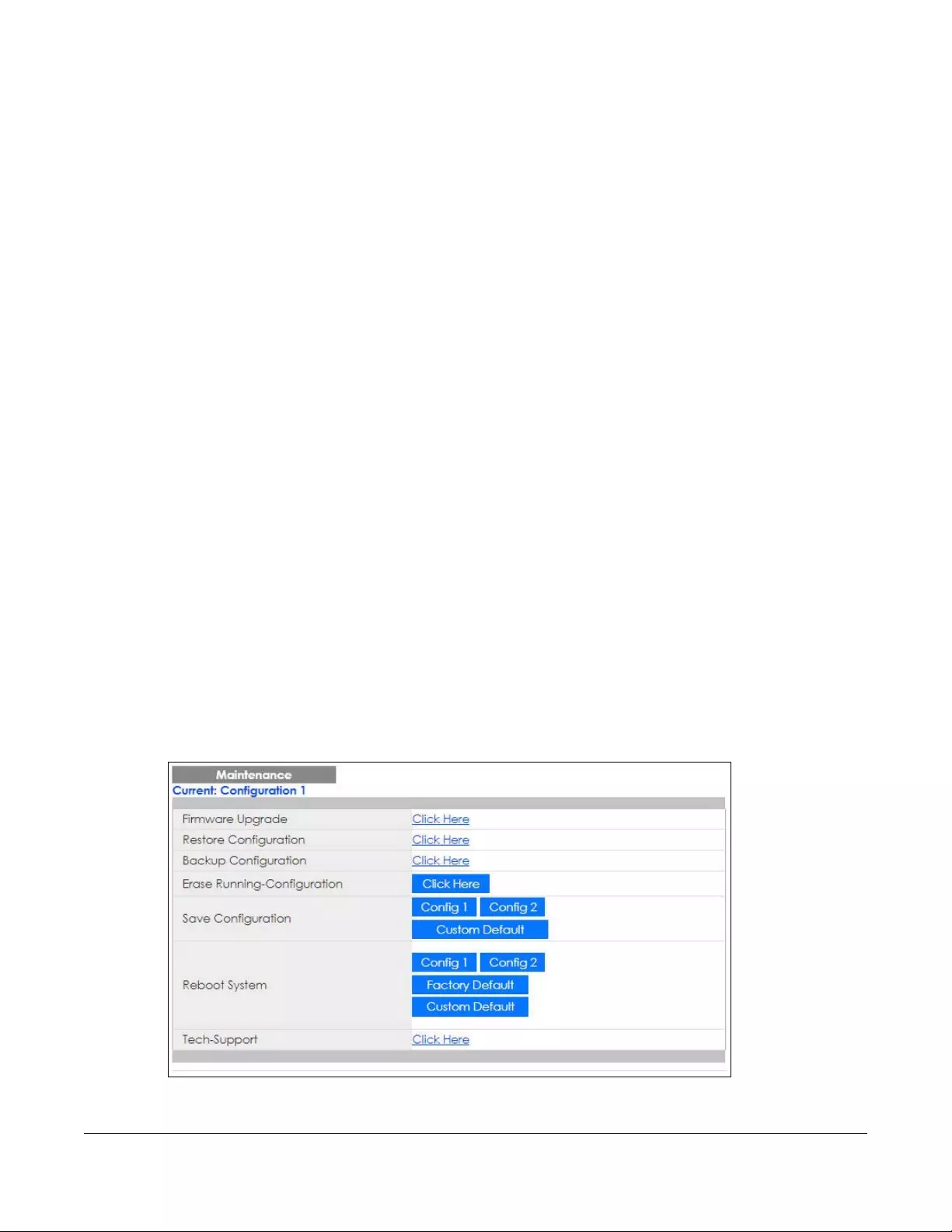
GS1920v2 Series User’s Guide
339
CHAPTER 39
Maintenance
39.1 Overview
This chapter explains how to configure the screens that let you maintain the firmware and configuration
files.
39.1.1 What You Can Do
• Use the Maintenance screen (Section 39.2 on page 339) to upload the latest firmware.
• Use the Firmware Upgrade screen (Section 39.3 on page 342) to upload the latest firmware.
• Use the Restore Configuration screen (Section 39.4 on page 343) to upload a stored device
configuration file.
• Use the Backup Configuration screen (Section 39.5 on page 344) to save your configurations for later
use.
• Use the Tech-Support screen (Section 39.6 on page 344) to create reports for customer support if
there are problems with the Switch.
39.2 The Maintenance Screen
Use this screen to manage firmware and your configuration files. Click Management > Maintenance in
the navigation panel to open the following screen.
Figure 245 Management > Maintenance

Chapter 39 Maintenance
GS1920v2 Series User’s Guide
340
The following table describes the labels in this screen.
39.2.1 Erase Running-Configuration
Follow the steps below to reset the Switch back to the Zyxel default configuration settings.
1In the Maintenance screen, click the Click Here button next to Erase Running-Configuration to clear all
Switch configuration information you configured and return to the Zyxel default configuration settings.
2 Click OK to reset all Switch configurations to the Zyxel default configuration settings.
Figure 246 Erase Running-Configuration: Confirmation
Table 164 Management > Maintenance
LABEL DESCRIPTION
Current This field displays which configuration (Configuration 1 or Configuration 2) is currently operating
on the Switch.
Firmware
Upgrade
Click Click Here to go to the Firmware Upgrade screen.
Restore
Configuration
Click Click Here to go to the Restore Configuration screen.
Backup
Configuration
Click Click Here to go to the Backup Configuration screen.
Erase Running-
Configuration
Click Click Here to reset the configuration to the Zyxel default configuration settings.
Save
Configuration
Click Config 1 to save the current configuration settings to Configuration 1 on the Switch.
Click Config 2 to save the current configuration settings to Configuration 2 on the Switch.
Click Custom Default to save the current configuration settings to a custom default file on the
Switch. This file can be used instead of the Zyxel factory default configuration file.
Reboot System Click Config 1 to reboot the Switch and load Configuration 1 on the Switch.
Click Config 2 to reboot the Switch and load Configuration 2 on the Switch.
Click Factory Default to reboot the Switch and load the Zyxel factory default configuration
settings on the Switch.
Click Custom Default to reboot the Switch and load the last-saved custom default file on the
Switch.
Note: Make sure to click the Save button in any screen to save your settings to the
current configuration on the Switch.
Tech-Support Click Click Here to see the Tech-Support screen. You can set CPU and memory thresholds for
log reports and download related log reports for issue analysis. Log reports include CPU history
and utilization, crash and memory.

Chapter 39 Maintenance
GS1920v2 Series User’s Guide
341
3In the web configurator, click the Save button in the top of the screen to make the changes take effect.
If you want to access the Switch web configurator again, you may need to change the IP address of
your computer to be in the same subnet as that of the default Switch IP address (192.168.1.1).
39.2.2 Save Configuration
Click Config 1 to save the current configuration settings to Configuration 1 on the Switch. These
configurations are set up according to your network environment.
Click Config 2 to save the current configuration settings to Configuration 2 on the Switch. These
configurations are set up according to your network environment.
Click Custom Default to save the current configuration settings to a custom default file on the Switch.
Alternatively, click Save on the top right-hand corner in any screen to save the configuration changes
to the current configuration.
Note: Clicking the Apply or Add button does NOT save the changes permanently. All
unsaved changes are erased after you reboot the Switch.
39.2.3 Reboot System
Reboot System allows you to restart the Switch without physically turning the power off. It also allows you
to load configuration one (Config 1), configuration two (Config 2), a Custom Default or the factory
deault configuration when you reboot. Follow the steps below to reboot the Switch.
1In the Maintenance screen, click a configuration button next to Reboot System to reboot and load that
configuration file. The following screen displays.
Figure 247 Reboot System: Confirmation
2Click OK again and then wait for the Switch to restart. This takes up to two minutes. This does not affect
the Switch’s configuration.
Click Config 1 and follow steps 1 to 2 to reboot and load configuration one on the Switch.
Click Config 2 and follow steps 1 to 2 to reboot and load configuration two on the Switch.
Click Factory Default and follow steps 1 to 2 to reboot and load Zyxel factory default configuration
settings on the Switch.
Click Custom Default and follow steps 1 to 2 to reboot and load the last-saved custom default file on the
Switch. If you did not save a Custom Default file in the web configurator, then the factory default file is

Chapter 39 Maintenance
GS1920v2 Series User’s Guide
342
restored after you press click Custom Default (next to Reboot System) on the Switch. You will then have
to make all your configurations again on the Switch.
39.3 Firmware Upgrade
Use the following screen to upgrade your Switch to the latest firmware. The Switch supports dual
firmware images, Firmware 1 and Firmware 2. Use this screen to specify which image is updated when
firmware is uploaded using the web configurator and to specify which image is loaded when the Switch
starts up.
You can check the Hardware Version of your Switch in the Status screen to determine which model
firmware to upgrade to the Switch. You should see V2.x in the Hardware Version field. The integer, 2,
identifies the GS1920v2 Series. See Section 7.2 on page 68 for more information about the Hardware
Version field. Go to the Zyxel website to download the correct model firmware.
Make sure you have downloaded (and unzipped) the correct model firmware and version to your
computer before uploading to the device.
WARNING! Be sure to upload the correct model firmware as uploading
the wrong model firmware may damage your device.
Click Management > Maintenance > Firmware Upgrade to view the screen as shown next.
Figure 248 Management > Maintenance > Firmware Upgrade
Type the path and file name of the firmware file you wish to upload to the Switch in the File Path text box
or click Choose File to locate it. Firmware upgrades are only applied after a reboot. Click Upgrade to
load the new firmware.

Chapter 39 Maintenance
GS1920v2 Series User’s Guide
343
After the firmware upgrade process is complete, see the System Info screen to verify your current
firmware version number.
39.4 Restore Configuration
Use this screen to restore a previously saved configuration from your computer to the Switch.
Figure 249 Management > Maintenance > Restore Configuration
Type the path and file name of the configuration file you wish to restore in the File Path text box or click
Choose File to locate it. After you have specified the file, click Restore. "config" is the name of the
configuration file on the Switch, so your backup configuration file is automatically renamed when you
restore using this screen.
Table 165 Management > Maintenance > Firmware Upgrade
LABEL DESCRIPTION
Name This is the name of the Switch that you’re configuring.
Version The Switch has two firmware sets, Firmware 1 and Firmware 2, residing in flash.
•Running shows the version number (and model code) and MM/DD/YYYY creation date
of the firmware currently in use on the Switch (Firmware 1 or Firmware 2). The firmware
information is also displayed at System Information in Basic Settings.
•Firmware 1 shows its version number (and model code) and MM/DD/YYYY creation
date.
•Firmware 2 shows its version number (and model code) and MM/DD/YYYY creation
date.
Current Boot Image This displays which firmware is currently in use on the Switch (Firmware 1 or Firmware 2).
Config Boot Image Select which firmware (Firmware 1 or Firmware 2) should load, click Apply and reboot the
Switch to see changes, you will also see changes in the Current Boot Image field above as
well.
Apply Click Apply to save your changes to the Switch’s run-time memory. The Switch loses these
changes if it is turned off or loses power, so use the Save link on the top navigation panel to
save your changes to the non-volatile memory when you are done configuring.
Cancel Click Cancel to begin configuring this screen afresh.
Firmware Choose to upload the new firmware to (Firmware) 1 or (Firmware) 2.
File Path Type the path and file name of the firmware file you wish to upload to the Switch in the File
Path text box or click Choose File to locate it.
Upgrade Click Upgrade to load the new firmware. Firmware upgrades are only applied after a
reboot. To reboot, go to Management > Maintenance > Reboot System and click Config 1,
Config 2 or Factory Default (Config 1, Config 2 and Factory Default are the configuration
files you want the Switch to use when it restarts).

Chapter 39 Maintenance
GS1920v2 Series User’s Guide
344
39.5 Backup Configuration
Use this screen to save and store your current Switch settings.
Backing up your Switch configurations allows you to create various “snap shots” of your Switch from
which you may restore at a later date.
Back up your current Switch configuration to a computer using the Backup Configuration screen.
Figure 250 Management > Maintenance > Backup Configuration
Follow the steps below to back up the current Switch configuration to your computer in this screen.
1Click Backup.
2If the current configuration file is open and/or downloaded to your computer automatically, you can
click File > Save As to save the file to a specific place.
If a dialog box pops up asking whether you want to open or save the file, click Save or Save File to
download it to the default downloads folder on your computer. If a Save As screen displays after you
click Save or Save Fil e, choose a location to save the file on your computer from the Save in drop-down
list box and type a descriptive name for it in the File name list box. Click Save to save the configuration
file to your computer.
39.6 Tech-Support
The Tech-Support feature is a log enhancement tool that logs useful information such as CPU utilization
history, memory and Mbuf (Memory Buffer) log and crash reports for issue analysis by customer support
should you have difficulty with your Switch. The Tech Support menu eases your effort in obtaining reports
and it is also available in CLI command by typing “Show tech-support” command.
Click Management > Maintenance > Tech-Support to see the following screen.

Chapter 39 Maintenance
GS1920v2 Series User’s Guide
345
Figure 251 Management > Maintenance > Tech-Support
You may need WordPad or similar software to see the log report correctly. The table below describes
the fields in the above screen.
Table 166 Management > Maintenance > Tech-Support
LABEL DESCRIPTION
CPU Type a number ranging from 50 to 100 in the CPU threshold box, and type another
number ranging from 5 to 60 in the seconds box then click Apply.
For example, 80 for CPU threshold and 5 for seconds means a log will be created when
CPU utilization reaches over 80% and lasts for 5 seconds.
The log report holds 7 days of CPU log data and is stored in volatile memory (RAM). The
data is lost if the Switch is turned off or in event of power outage. After 7 days, the logs
wrap around and new ones and replace the earliest ones.
The higher the CPU threshold number, the fewer logs will be created, and the less data
technical support will have to analyze and vice versa.
Mbuf Type a number ranging from 50 to 100 in the Mbuf (Memory Buffer) threshold box. The
Mbuf log report is stored in flash (permanent) memory.
For example, Mbuf 50 means a log will be created when the Mbuf utilization is over 50%.
The higher the Mbuf threshold number, the fewer logs will be created, and the less data
technical support will have to analyze and vice versa.
Apply Click Apply to save your changes to the Switch’s run-time memory. The Switch loses
these changes if it is turned off or loses power, so use the Save link on the top navigation
panel to save your changes to the non-volatile memory when you are done configuring.
Cancel Click Cancel to begin configuring this screen afresh.
All Click Download to see all the log report and system status. This log report is stored in flash
memory. If the All log report is too large, you can download the log reports separately
below.
Crash Click Download to see the crash log report. The log will include information of the last
crash and is stored in flash memory.
CPU history Click Download to see the CPU history log report. The 7-days log is stored in RAM and you
will need to save it, otherwise it will be lost when the Switch is shutdown or during power
outage.
Memory Section Click Download to see the memory section log report. This log report is stored in flash
memory.

Chapter 39 Maintenance
GS1920v2 Series User’s Guide
346
39.7 Technical Reference
This section provides technical background information on the topics discussed in this chapter.
39.7.1 FTP Command Line
This section shows some examples of uploading to or downloading files from the Switch using FTP
commands. First, understand the filename conventions.
39.7.2 Filename Conventions
The configuration file (also known as the romfile or ROM) contains the Zyxel factory default configuration
settings in the screens such as password, Switch setup, IP Setup, and so on. Once you have customized
the Switch’s settings, they can be saved back to your computer under a filename of your choosing.
ZyNOS (Zyxel Network Operating System sometimes referred to as the “ras” file) is the system firmware
and has a “bin” filename extension.
39.7.2.1 Example FTP Commands
ftp> put firmware.bin ras
This is a sample FTP session showing the transfer of the computer file "firmware.bin" to the Switch.
ftp> get config config.cfg
This is a sample FTP session saving the current configuration to a file called “config.cfg” on your
computer.
If your (T)FTP client does not allow you to have a destination filename different than the source, you will
need to rename them as the Switch only recognizes “config” and “ras”. Be sure you keep unaltered
copies of both files for later use.
Mbuf Click Download to see the Mbuf log report. The log includes Mbuf over threshold
information. This log report is stored in flash memory.
ROM Click Download to see the Read Only Memory (ROM) log report. This report is stored in
flash memory.
Table 166 Management > Maintenance > Tech-Support
LABEL DESCRIPTION
Table 167 Filename Conventions
FILE TYPE INTERNAL NAME EXTERNAL NAME DESCRIPTION
Configuration File config *.cfg This is the configuration filename on the
Switch. Uploading the config file replaces
the specified configuration file system,
including your Switch configurations,
system-related data (including the default
password), the error log and the trace log.
Firmware ras *.bin This is the generic name for the ZyNOS
firmware on the Switch.

Chapter 39 Maintenance
GS1920v2 Series User’s Guide
347
WARNING! Be sure to upload the correct model firmware as uploading
the wrong model firmware may damage your device.
39.7.3 FTP Command Line Procedure
1Launch the FTP client on your computer.
2Enter open, followed by a space and the IP address of your Switch.
3Press [ENTER] when prompted for a username.
4Enter your password as requested (the default is “1234”).
5Enter bin to set transfer mode to binary.
6Use put to transfer files from the computer to the Switch, for example, put firmware.bin ras transfers
the firmware on your computer (firmware.bin) to the Switch and renames it to “ras”. Similarly, put
config.cfg config transfers the configuration file on your computer (config.cfg) to the Switch and
renames it to “config”. Likewise get config config.cfg transfers the configuration file on the Switch
to your computer and renames it to “config.cfg”. See Table 167 on page 346 for more information on
filename conventions.
7Enter quit to exit the ftp prompt.
39.7.4 GUI-based FTP Clients
The following table describes some of the commands that you may see in GUI-based FTP clients.
39.7.5 FTP Restrictions
FTP will not work when:
• FTP service is disabled in the Service Access Control screen.
• The IP address(es) in the Remote Management screen does not match the client IP address. If it does
not match, the Switch will disconnect the FTP session immediately.
General Commands for GUI-based FTP Clients
COMMAND DESCRIPTION
Host Address Enter the address of the host server.
Login Type Anonymous.
This is when a user I.D. and password is automatically supplied to the server for
anonymous access. Anonymous logins will work only if your ISP or service administrator
has enabled this option.
Normal.
The server requires a unique User ID and Password to login.
Transfer Type Transfer files in either ASCII (plain text format) or in binary mode. Configuration and
firmware files should be transferred in binary mode.
Initial Remote Directory Specify the default remote directory (path).
Initial Local Directory Specify the default local directory (path).

GS1920v2 Series User’s Guide
348
CHAPTER 40
Access Control
40.1 Access Control Overview
This chapter describes how to control access to the Switch.
FTP is allowed one session each, Telnet and SSH share nine sessions, up to five Web sessions (five different
user names and passwords) and/or limitless SNMP access control sessions are allowed.
Telnet access control session cannot coexist when multi-login is disabled.
40.1.1 What You Can Do
• Use the Access Control screen (Section 40.2 on page 348) to display the main screen.
• Use the SNMP screen (Section 40.3 on page 349) to configure your SNMP settings.
• Use the Trap Group screen (Section 40.3.1 on page 350) to specify the types of SNMP traps that should
be sent to each SNMP manager.
• Use the User Information screen (Section 40.3.3 on page 352) to create SNMP users for authentication
with managers using SNMP v3 and associate them to SNMP groups.
• Use the Logins screens (Section 40.4 on page 354) to assign which users can access the Switch via
web configurator at any one time.
• Use the Service Access Control screen (Section 40.5 on page 355) to decide what services you may
use to access the Switch.
• Use the Remote Management screen (Section 40.6 on page 356) to specify a group of one or more
“trusted computers” from which an administrator may use a service to manage the Switch.
40.2 The Access Control Main Screen
Use this screen to display the main screen.
Click Management > Access Control in the navigation panel to display the main screen as shown.
Table 168 Access Control Overview
SSH Telnet FTP Web SNMP
Share up to nine sessions One session Up to five accounts No limit

Chapter 40 Access Control
GS1920v2 Series User’s Guide
349
Figure 252 Management > Access Control
The following table describes the labels in this screen.
40.3 Configuring SNMP
Use this screen to configure your SNMP settings.
Click Management > Access Control > SNMP to view the screen as shown.
Figure 253 Management > Access Control > SNMP
Table 169 Management > Access Control
LABEL DESCRIPTION
SNMP Click this link to configure your SNMP settings.
Logins Click this link to assign which users can access the Switch via web configurator at any one
time.
Service Access
Control
Click this link to decide what services you may use to access the Switch.
Remote
Management
Click this link to specify a group of one or more “trusted computers” from which an
administrator may use a service to manage the Switch.
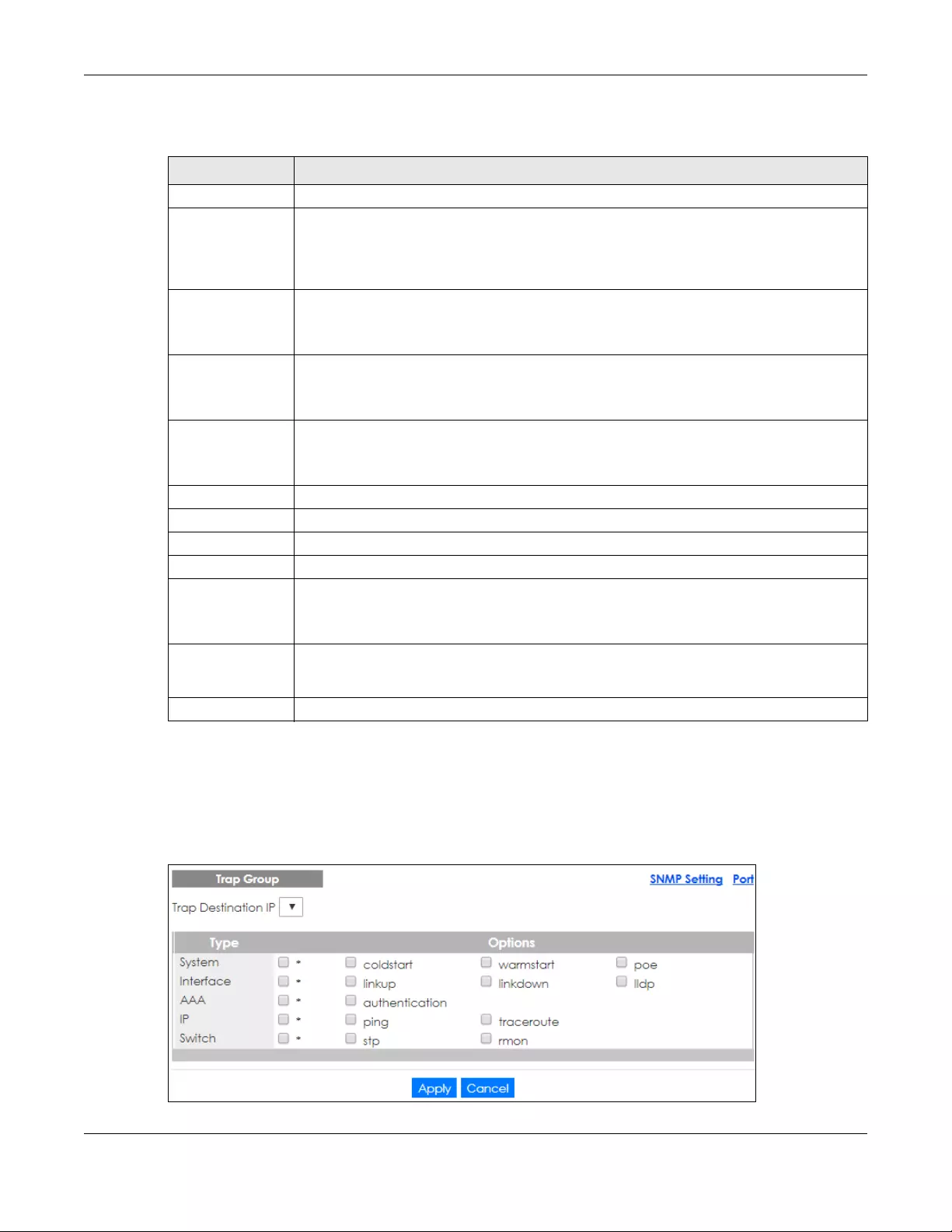
Chapter 40 Access Control
GS1920v2 Series User’s Guide
350
The following table describes the labels in this screen.
40.3.1 Configuring SNMP Trap Group
From the SNMP screen, click Trap Group to view the screen as shown. Use the Trap Group screen to
specify the types of SNMP traps that should be sent to each SNMP manager.
Figure 254 Management > Access Control > SNMP > Trap Group
Table 170 Management > Access Control > SNMP
LABEL DESCRIPTION
General Setting Use this section to specify the SNMP version and community (password) values.
Version Select the SNMP version for the Switch. The SNMP version on the Switch must match the
version on the SNMP manager. Choose SNMP version 2c (v2c), SNMP version 3 (v3) or both
(v3v2c).
SNMP version 2c is backwards compatible with SNMP version 1.
Get Community Enter the Get Community string, which is the password for the incoming Get- and GetNext-
requests from the management station.
The Get Community string is only used by SNMP managers using SNMP version 2c or lower.
Set Community Enter the Set Community, which is the password for incoming Set- requests from the
management station.
The Set Community string is only used by SNMP managers using SNMP version 2c or lower.
Trap Community Enter the Trap Community string, which is the password sent with each trap to the SNMP
manager.
The Trap Community string is only used by SNMP managers using SNMP version 2c or lower.
Trap Destination Use this section to configure where to send SNMP traps from the Switch.
Version Specify the version of the SNMP trap messages.
IP Enter the IP addresses of up to four managers to send your SNMP traps to.
Port Enter the port number upon which the manager listens for SNMP traps.
Username Enter the username to be sent to the SNMP manager along with the SNMP v3 trap.
This username must match an existing account on the Switch (configured in Management >
Access Control > Logins screen).
Apply Click Apply to save your changes to the Switch’s run-time memory. The Switch loses these
changes if it is turned off or loses power, so use the Save link on the top navigation panel to
save your changes to the non-volatile memory when you are done configuring.
Cancel Click Cancel to begin configuring this screen afresh.

Chapter 40 Access Control
GS1920v2 Series User’s Guide
351
The following table describes the labels in this screen.
40.3.2 Enabling/Disabling Sending of SNMP Traps on a Port
From the SNMP > Trap Group screen, click Port to view the screen as shown. Use this screen to set
whether a trap received on the port(s) would be sent to the SNMP manager.
Figure 255 Management > Access Control > SNMP > Trap Group > Port
Table 171 Management > Access Control > SNMP > Trap Group
LABEL DESCRIPTION
Trap Destination IP Select one of your configured trap destination IP addresses. These are the IP addresses of the
SNMP managers. You must first configure a trap destination IP address in the SNMP Setting
screen.
Use the rest of the screen to select which traps the Switch sends to that SNMP manager.
Type Select the categories of SNMP traps that the Switch is to send to the SNMP manager.
Options Select the individual SNMP traps that the Switch is to send to the SNMP station. See SNMP Traps
on page 359 for individual trap descriptions.
The traps are grouped by category. Selecting a category automatically selects all of the
category’s traps. Clear the check boxes for individual traps that you do not want the Switch
to send to the SNMP station. Clearing a category’s check box automatically clears all of the
category’s trap check boxes (the Switch only sends traps from selected categories).
Apply Click Apply to save your changes to the Switch’s run-time memory. The Switch loses these
changes if it is turned off or loses power, so use the Save link on the top navigation panel to
save your changes to the non-volatile memory when you are done configuring.
Cancel Click Cancel to begin configuring this screen afresh.
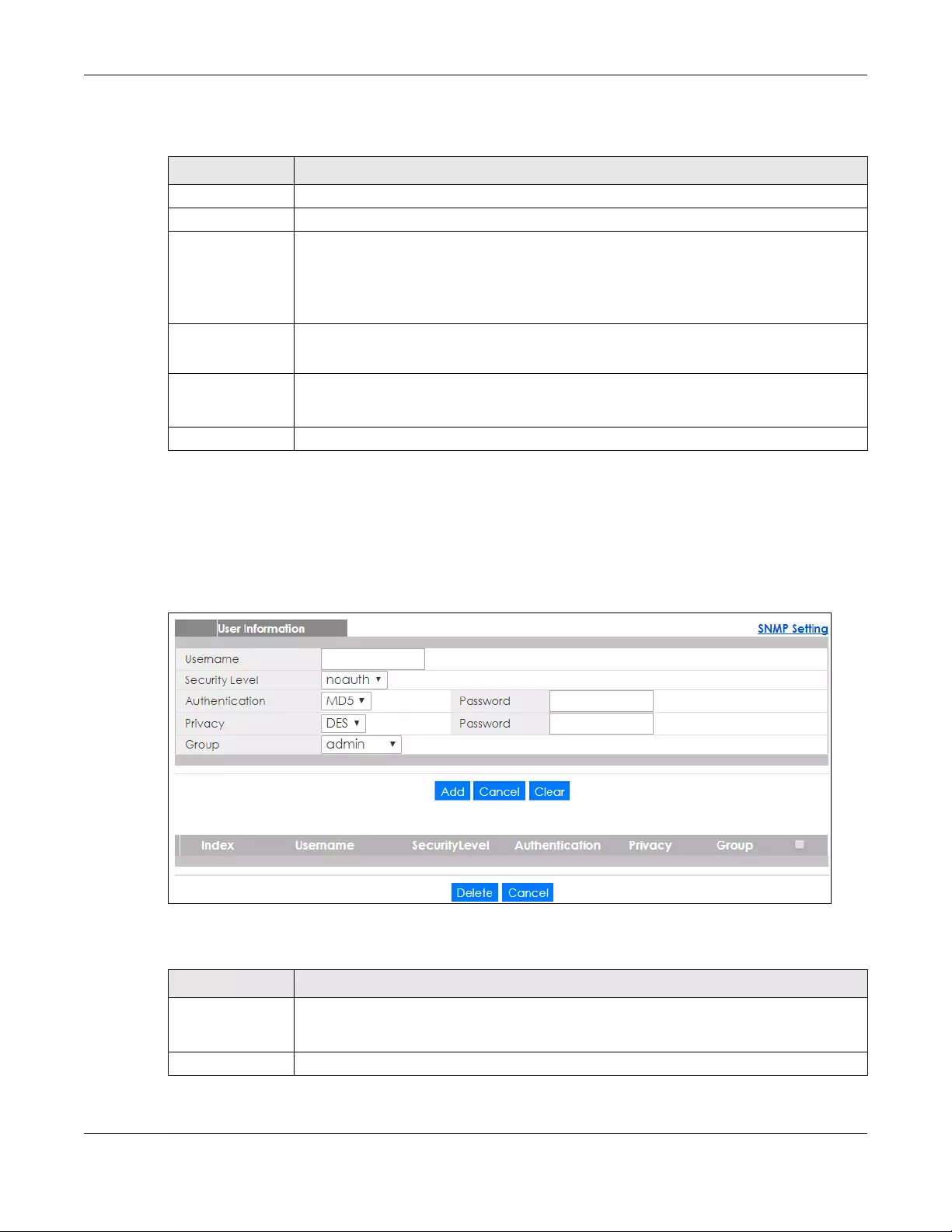
Chapter 40 Access Control
GS1920v2 Series User’s Guide
352
The following table describes the labels in this screen.
40.3.3 Configuring SNMP User
From the SNMP screen, click User to view the screen as shown. Use the User screen to create SNMP users
for authentication with managers using SNMP v3 and associate them to SNMP groups. An SNMP user is
an SNMP manager.
Figure 256 Management > Access Control > SNMP > User
The following table describes the labels in this screen.
Table 172 Management > Access Control > SNMP > Trap Group > Port
LABEL DESCRIPTION
Option Select the trap type you want to configure here.
Port This field displays a port number.
* Settings in this row apply to all ports.
Use this row only if you want to make some of the settings the same for all ports. Use this row
first to set the common settings and then make adjustments on a port-by-port basis.
Changes in this row are copied to all the ports as soon as you make them.
Active Select this check box to enable the trap type of SNMP traps on this port.
Clear this check box to disable the sending of SNMP traps on this port.
Apply Click Apply to save your changes to the Switch’s run-time memory. The Switch loses these
changes if it is turned off or loses power, so use the Save link on the top navigation panel to
save your changes to the non-volatile memory when you are done configuring.
Cancel Click Cancel to begin configuring this screen afresh.
Table 173 Management > Access Control > SNMP > User
LABEL DESCRIPTION
User Information Note: Use the username and password of the login accounts you specify in this
screen to create accounts on the SNMP v3 manager.
Username Specify the username of a login account on the Switch.

Chapter 40 Access Control
GS1920v2 Series User’s Guide
353
Security Level Select whether you want to implement authentication and/or encryption for SNMP
communication from this user. Choose:
•noauth -to use the username as the password string to send to the SNMP manager. This is
equivalent to the Get, Set and Trap Community in SNMP v2c. This is the lowest security
level.
•auth - to implement an authentication algorithm for SNMP messages sent by this user.
•priv - to implement authentication and encryption for SNMP messages sent by this user.
This is the highest security level.
Note: The settings on the SNMP manager must be set at the same security level or
higher than the security level settings on the Switch.
Authentication Select an authentication algorithm. MD5 (Message Digest 5) and SHA (Secure Hash Algorithm)
are hash algorithms used to authenticate SNMP data. SHA authentication is generally
considered stronger than MD5, but is slower.
Password Enter the password of up to 32 ASCII characters for SNMP user authentication.
Privacy Specify the encryption method for SNMP communication from this user. You can choose one
of the following:
•DES - Data Encryption Standard is a widely used (but breakable) method of data
encryption. It applies a 56-bit key to each 64-bit block of data.
•AES - Advanced Encryption Standard is another method for data encryption that also uses
a secret key. AES applies a 128-bit key to 128-bit blocks of data.
Password Enter the password of up to 32 ASCII characters for encrypting SNMP packets.
Group SNMP v3 adopts the concept of View-based Access Control Model (VACM) group. SNMP
managers in one group are assigned common access rights to MIBs. Specify in which SNMP
group this user is.
admin - Members of this group can perform all types of system configuration, including the
management of administrator accounts.
readwrite - Members of this group have read and write rights, meaning that the user can
create and edit the MIBs on the Switch, except the user account and AAA configuration.
readonly - Members of this group have read rights only, meaning the user can collect
information from the Switch.
Add Click this to create a new entry or to update an existing one.
This saves your changes to the Switch’s run-time memory. The Switch loses these changes if it is
turned off or loses power, so use the Save link on the top navigation panel to save your
changes to the non-volatile memory when you are done configuring.
Cancel Click Cancel to reset the fields to your previous configuration.
Clear Click Clear to reset the fields to the factory defaults.
Index This is a read-only number identifying a login account on the Switch. Click on an index number
to view more details and edit an existing account.
Username This field displays the username of a login account on the Switch.
Security Level This field displays whether you want to implement authentication and/or encryption for SNMP
communication with this user.
Authentication This field displays the authentication algorithm used for SNMP communication with this user.
Privacy This field displays the encryption method used for SNMP communication with this user.
Group This field displays the SNMP group to which this user belongs.
Select an entry’s check box to select a specific entry. Otherwise, select the check box in the
table heading row to select all entries.
Delete Click Delete to remove the selected entry from the summary table.
Cancel Click Cancel to begin configuring this screen afresh.
Table 173 Management > Access Control > SNMP > User (continued)
LABEL DESCRIPTION
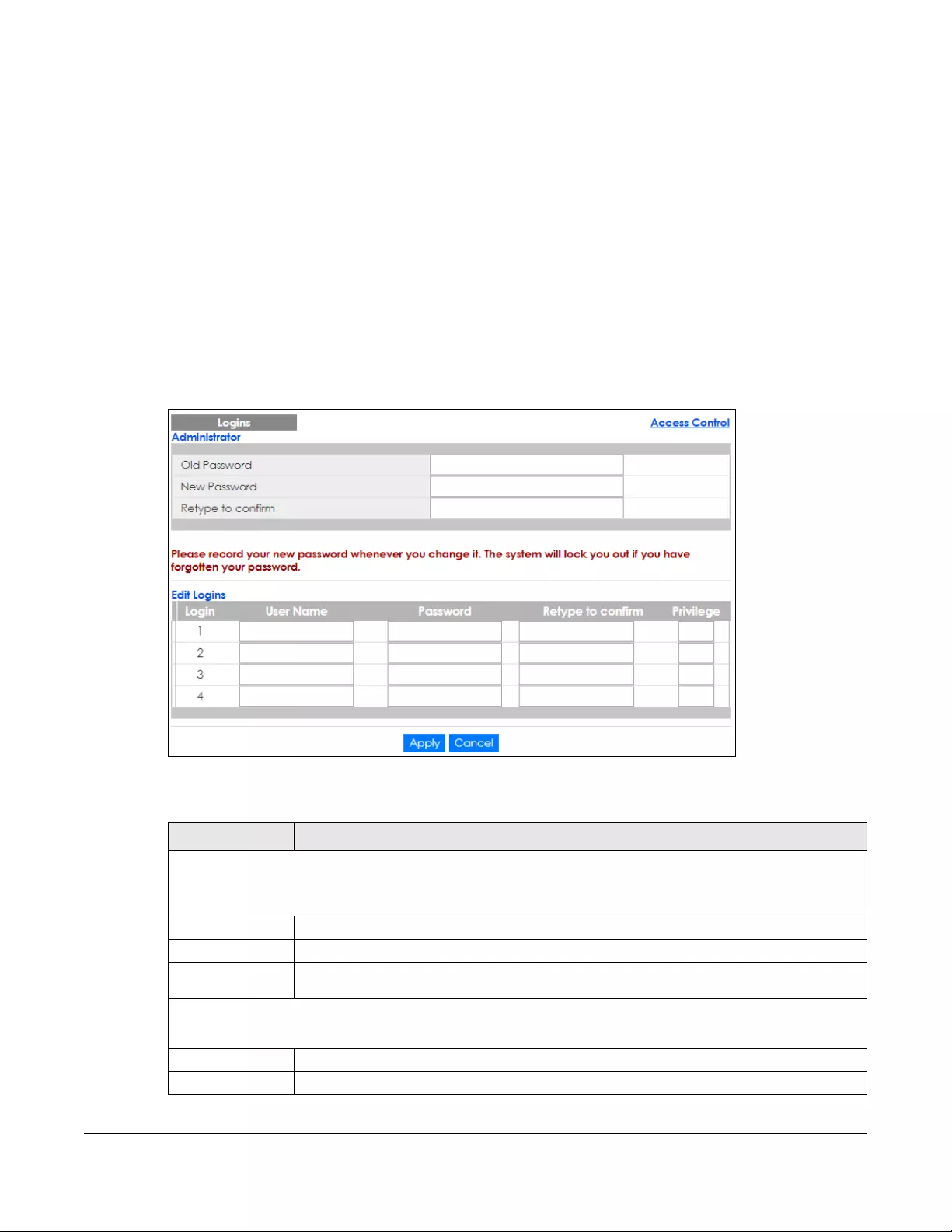
Chapter 40 Access Control
GS1920v2 Series User’s Guide
354
40.4 Setting Up Login Accounts
Up to five people (one administrator and four non-administrators) may access the Switch via web
configurator at any one time.
• An administrator is someone who can both view and configure Switch changes. The username for the
Administrator is always admin. The default administrator password is 1234.
Note: It is highly recommended that you change the default administrator password (1234).
• A non-administrator (username is something other than admin) is someone who can view but not
configure Switch settings.
Click Management > Access Control > Logins to view the screen as shown.
Figure 257 Management > Access Control > Logins
The following table describes the labels in this screen.
Table 174 Management > Access Control > Logins
LABEL DESCRIPTION
Administrator
This is the default administrator account with the “admin” user name. You cannot change the default
administrator user name. Only the administrator has read/write access.
Old Password Type the existing system password (1234 is the default password when shipped).
New Password Enter your new system password.
Retype to
confirm Retype your new system password for confirmation
Edit Logins
You may configure passwords for up to four users. These users have read-only access.
User Name Set a user name (up to 32 ASCII characters long).
Password Enter your new system password.

Chapter 40 Access Control
GS1920v2 Series User’s Guide
355
40.5 Service Access Control
Service Access Control allows you to decide what services you may use to access the Switch. You may
also change the default service port and configure “trusted computer(s)” for each service in the
Remote Management screen (discussed later). Click Access Control to go back to the main Access
Control screen.
Figure 258 Management > Access Control > Service Access Control
The following table describes the fields in this screen.
Retype to
confirm Retype your new system password for confirmation
Privilege Type the privilege level for this user. At the time of writing, users may have a privilege level of 0,
3, 13, or 14 representing different configuration rights as shown below.
• 0 - Display basic system information.
• 3 - Display configuration or status.
• 13 - Configure features except for login accounts, SNMP user accounts, the
authentication method sequence and authorization settings, multiple logins, administrator
and enable passwords, and configuration information display.
• 14 - Configure login accounts, SNMP user accounts, the authentication method
sequence and authorization settings, multiple logins, and administrator and enable
passwords, and display configuration information.
Users can run command lines if the session’s privilege level is greater than or equal to the
command’s privilege level. The session privilege initially comes from the privilege of the login
account. For example, if the user has a privilege of 5, he/she can run commands that requires
privilege level of 5 or less but not more.
Apply Click Apply to save your changes to the Switch’s run-time memory. The Switch loses these
changes if it is turned off or loses power, so use the Save link on the top navigation panel to
save your changes to the non-volatile memory when you are done configuring.
Cancel Click Cancel to begin configuring this screen afresh.
Table 174 Management > Access Control > Logins (continued)
LABEL DESCRIPTION
Table 175 Management > Access Control > Service Access Control
LABEL DESCRIPTION
Services Services you may use to access the Switch are listed here. Telnet and SSH give access to a
limited version of the Command Line Interface (CLI) to display information.
Active Select this option for the corresponding services that you want to allow to access the Switch.
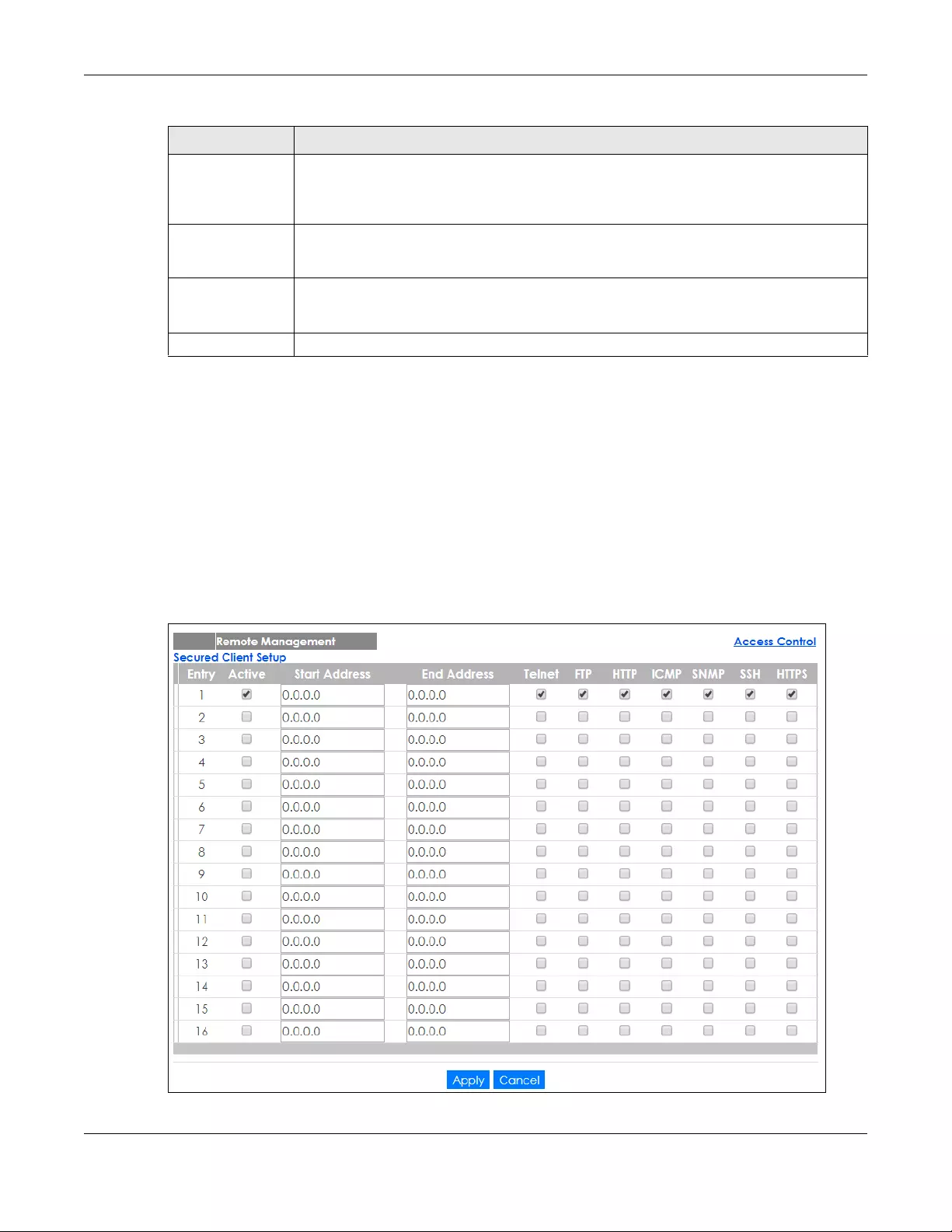
Chapter 40 Access Control
GS1920v2 Series User’s Guide
356
40.6 Remote Management
Use this screen to specify a group of one or more “trusted computers” from which an administrator may
use a service to manage the Switch.
Click Management > Access Control > Remote Management to view the screen as shown next.
You can specify a group of one or more “trusted computers” from which an administrator may use a
service to manage the Switch. Click Access Control to return to the Access Control screen.
Figure 259 Management > Access Control > Remote Management
Service Port For Telnet, SSH, FTP, HTTP or HTTPS services, you may change the default service port by typing
the new port number in the Service Port field. If you change the default port number then you
will have to let people (who wish to use the service) know the new port number for that
service.
Timeout Type how many minutes (from 1 to 255) a management session can be left idle before the
session times out. After it times out you have to log in with your password again. Very long idle
timeouts may have security risks.
Apply Click Apply to save your changes to the Switch’s run-time memory. The Switch loses these
changes if it is turned off or loses power, so use the Save link on the top navigation panel to
save your changes to the non-volatile memory when you are done configuring.
Cancel Click Cancel to begin configuring this screen afresh.
Table 175 Management > Access Control > Service Access Control (continued)
LABEL DESCRIPTION
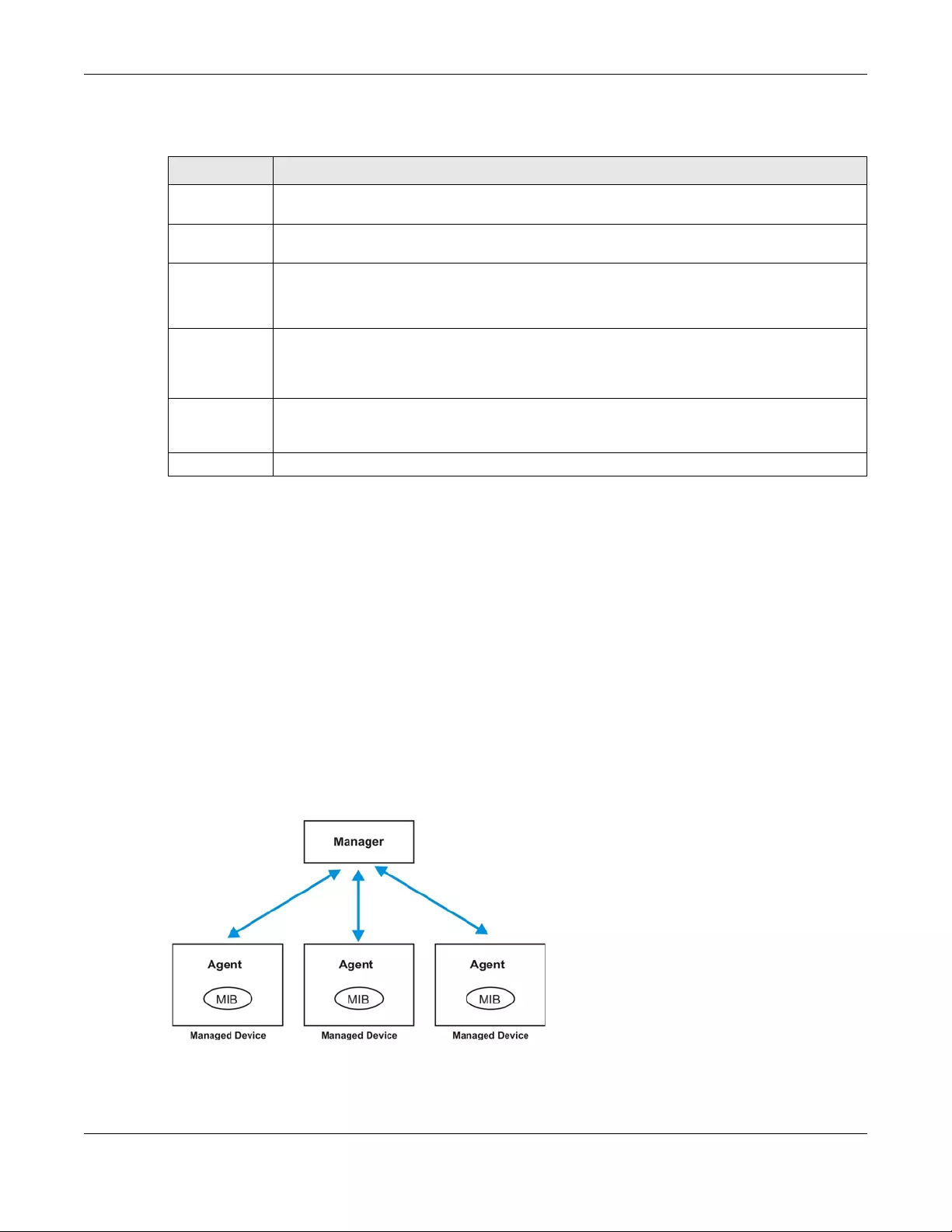
Chapter 40 Access Control
GS1920v2 Series User’s Guide
357
The following table describes the labels in this screen.
40.7 Technical Reference
This section provides technical background information on the topics discussed in this chapter.
40.7.1 About SNMP
Simple Network Management Protocol (SNMP) is an application layer protocol used to manage and
monitor TCP/IP-based devices. SNMP is used to exchange management information between the
network management system (NMS) and a network element (NE). A manager station can manage and
monitor the Switch through the network via SNMP version 1 (SNMPv1), SNMP version 2c or SNMP version
3. The next figure illustrates an SNMP management operation. SNMP is only available if TCP/IP is
configured.
Figure 260 SNMP Management Model
An SNMP managed network consists of two main components: agents and a manager.
Table 176 Management > Access Control > Remote Management
LABEL DESCRIPTION
Entry This is the client set index number. A “client set” is a group of one or more “trusted computers”
from which an administrator may use a service to manage the Switch.
Active Select this check box to activate this secured client set. Clear the check box if you wish to
temporarily disable the set without deleting it.
Start Address
End Address
Configure the IP address range of trusted computers from which you can manage this Switch.
The Switch checks if the client IP address of a computer requesting a service or protocol matches
the range set here. The Switch immediately disconnects the session if it does not match.
Telnet/FTP/
HTTP/ICMP/
SNMP/SSH/
HTTPS
Select services that may be used for managing the Switch from the specified trusted computers.
Apply Click Apply to save your changes to the Switch’s run-time memory. The Switch loses these
changes if it is turned off or loses power, so use the Save link on the top navigation panel to save
your changes to the non-volatile memory when you are done configuring.
Cancel Click Cancel to begin configuring this screen afresh.

Chapter 40 Access Control
GS1920v2 Series User’s Guide
358
An agent is a management software module that resides in a managed Switch (the Switch). An agent
translates the local management information from the managed Switch into a form compatible with
SNMP. The manager is the console through which network administrators perform network management
functions. It executes applications that control and monitor managed devices.
The managed devices contain object variables/managed objects that define each piece of
information to be collected about a Switch. Examples of variables include number of packets received,
node port status and so on. A Management Information Base (MIB) is a collection of managed objects.
SNMP allows a manager and agents to communicate for the purpose of accessing these objects.
SNMP itself is a simple request/response protocol based on the manager/agent model. The manager
issues a request and the agent returns responses using the following protocol operations:
SNMP v3 and Security
SNMP v3 enhances security for SNMP management. SNMP managers can be required to authenticate
with agents before conducting SNMP management sessions.
Security can be further enhanced by encrypting the SNMP messages sent from the managers.
Encryption protects the contents of the SNMP messages. When the contents of the SNMP messages are
encrypted, only the intended recipients can read them.
Supported MIBs
MIBs let administrators collect statistics and monitor status and performance.
The Switch supports the following MIBs:
• SNMP MIB II (RFC 1213)
• RFC 1157 SNMP v1
• RFC 1493 Bridge MIBs
• RFC 1643 Ethernet MIBs
• RFC 1155 SMI
• RFC 2674 SNMPv2, SNMPv2c
• RFC 1757 RMON
• SNMPv2, SNMPv2c or later version, compliant with RFC 2011 SNMPv2 MIB for IP, RFC 2012 SNMPv2 MIB
for TCP, RFC 2013 SNMPv2 MIB for UDP
Table 177 SNMP Commands
LABEL DESCRIPTION
Get Allows the manager to retrieve an object variable from the agent.
GetNext Allows the manager to retrieve the next object variable from a table or list within an agent. In
SNMPv1, when a manager wants to retrieve all elements of a table from an agent, it initiates a
Get operation, followed by a series of GetNext operations.
Set Allows the manager to set values for object variables within an agent.
Trap Used by the agent to inform the manager of some events.

Chapter 40 Access Control
GS1920v2 Series User’s Guide
359
SNMP Traps
The Switch sends traps to an SNMP manager when an event occurs. The following tables outline the
SNMP traps by category.
An OID (Object ID) that begins with “1.3.6.1.4.1.890.1.15” is defined in private MIBs. Otherwise, it is a
standard MIB OID.
Table 178 SNMP System Traps
OPTION OBJECT LABEL OBJECT ID DESCRIPTION
coldstart coldStart 1.3.6.1.6.3.1.1.5.1 This trap is sent when the Switch is turned
on.
warmstart warmStart 1.3.6.1.6.3.1.1.5.2 This trap is sent when the Switch restarts.
poe
(For PoE models
only)
pethPsePortOnOffNotificatio
n
1.3.6.1.2.1.105.0.1 This trap is sent when the PoE port delivers
power or delivers no power to a PD.
pethMainPowerUsageOnNo
tification
1.3.6.1.2.1.105.0.2 This trap is sent when the usage power is
above the usage indication threshold.
pethMainPowerUsageOffNo
tification
1.3.6.1.2.1.105.0.3 This trap is sent when the usage power is
below the usage indication threshold.
Table 179 SNMP Interface Traps
OPTION OBJECT LABEL OBJECT ID DESCRIPTION
linkup linkUp 1.3.6.1.6.3.1.1.5.4 This trap is sent when the Ethernet link
is up.
linkdown linkDown 1.3.6.1.6.3.1.1.5.3 This trap is sent when the Ethernet link
is down.
lldp lldpRemTablesChange 1.0.8802.1.1.2.0.0.1 The trap is sent when entries in the
remote database have any updates.
Link Layer Discovery Protocol (LLDP),
defined as IEEE 802.1ab, enables LAN
devices that support LLDP to
exchange their configured settings.
This helps eliminate configuration
mismatch issues.
Table 180 SNMP AAA Traps
OPTION OBJECT LABEL OBJECT ID DESCRIPTION
authentication authenticationFailure 1.3.6.1.6.3.1.1.5.5 This trap is sent when authentication
fails due to incorrect user name and/or
password.
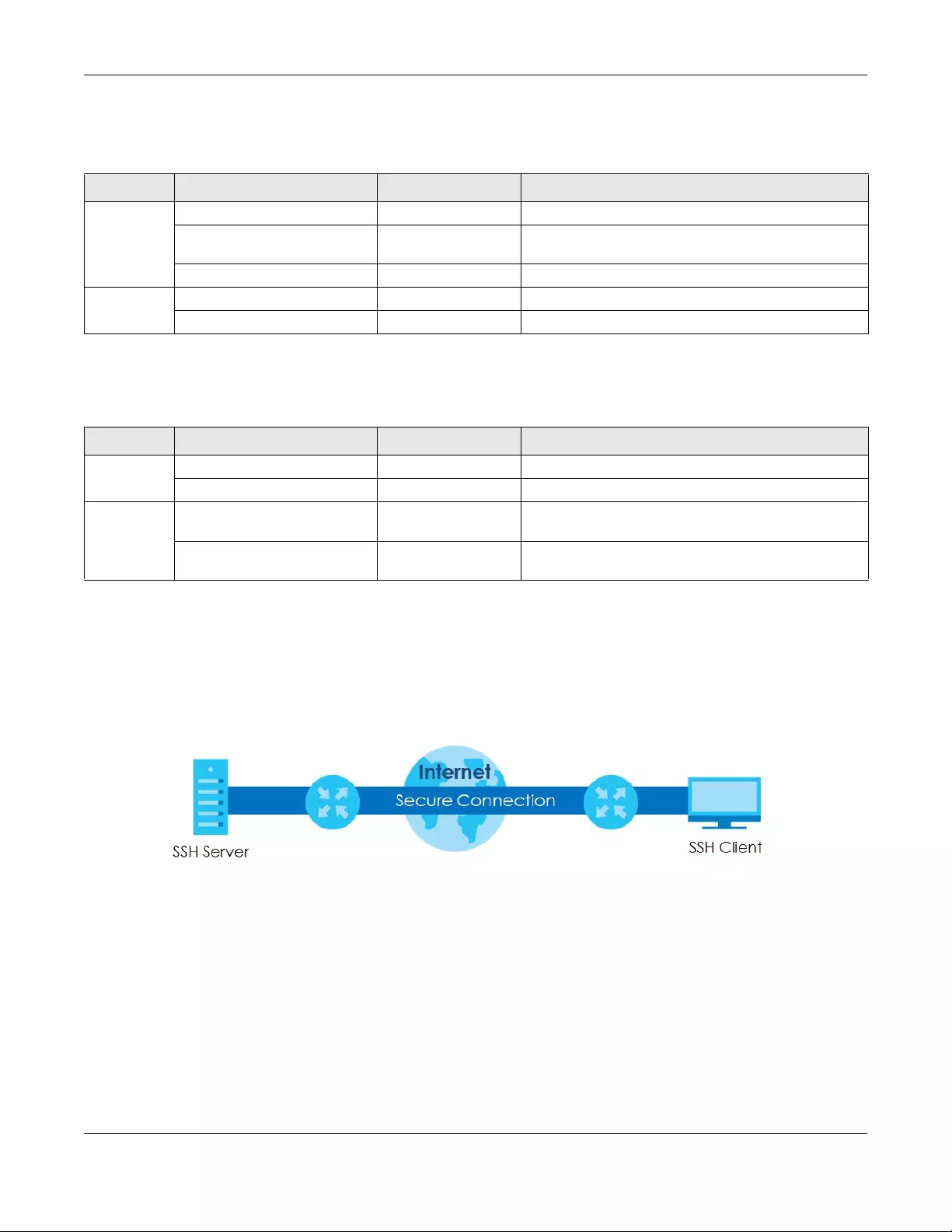
Chapter 40 Access Control
GS1920v2 Series User’s Guide
360
40.7.2 SSH Overview
Unlike Telnet or FTP, which transmit data in clear text, SSH (Secure Shell) is a secure communication
protocol that combines authentication and data encryption to provide secure encrypted
communication between two hosts over an unsecured network.
Figure 261 SSH Communication Example
40.7.2.1 How SSH works
The following table summarizes how a secure connection is established between two remote hosts.
Table 181 SNMP IP Traps
OPTION OBJECT LABEL OBJECT ID DESCRIPTION
ping pingProbeFailed 1.3.6.1.2.1.80.0.1 This trap is sent when a single ping probe fails.
pingTestFailed 1.3.6.1.2.1.80.0.2 This trap is sent when a ping test (consisting of a series of
ping probes) fails.
pingTestCompleted 1.3.6.1.2.1.80.0.3 This trap is sent when a ping test is completed.
traceroute traceRouteTestFailed 1.3.6.1.2.1.81.0.2 This trap is sent when a traceroute test fails.
traceRouteTestCompleted 1.3.6.1.2.1.81.0.3 This trap is sent when a traceroute test is completed.
Table 182 SNMP Switch Traps
OPTION OBJECT LABEL OBJECT ID DESCRIPTION
stp STPNewRoot 1.3.6.1.2.1.17.0.1 This trap is sent when the STP root switch changes.
STPTopologyChange 1.3.6.1.2.1.17.0.2 This trap is sent when the STP topology changes.
rmon RmonRisingAlarm 1.3.6.1.2.1.16.0.1 This trap is sent when a variable goes over the RMON
"rising" threshold.
RmonFallingAlarm 1.3.6.1.2.1.16.0.2 This trap is sent when the variable falls below the RMON
"falling" threshold.
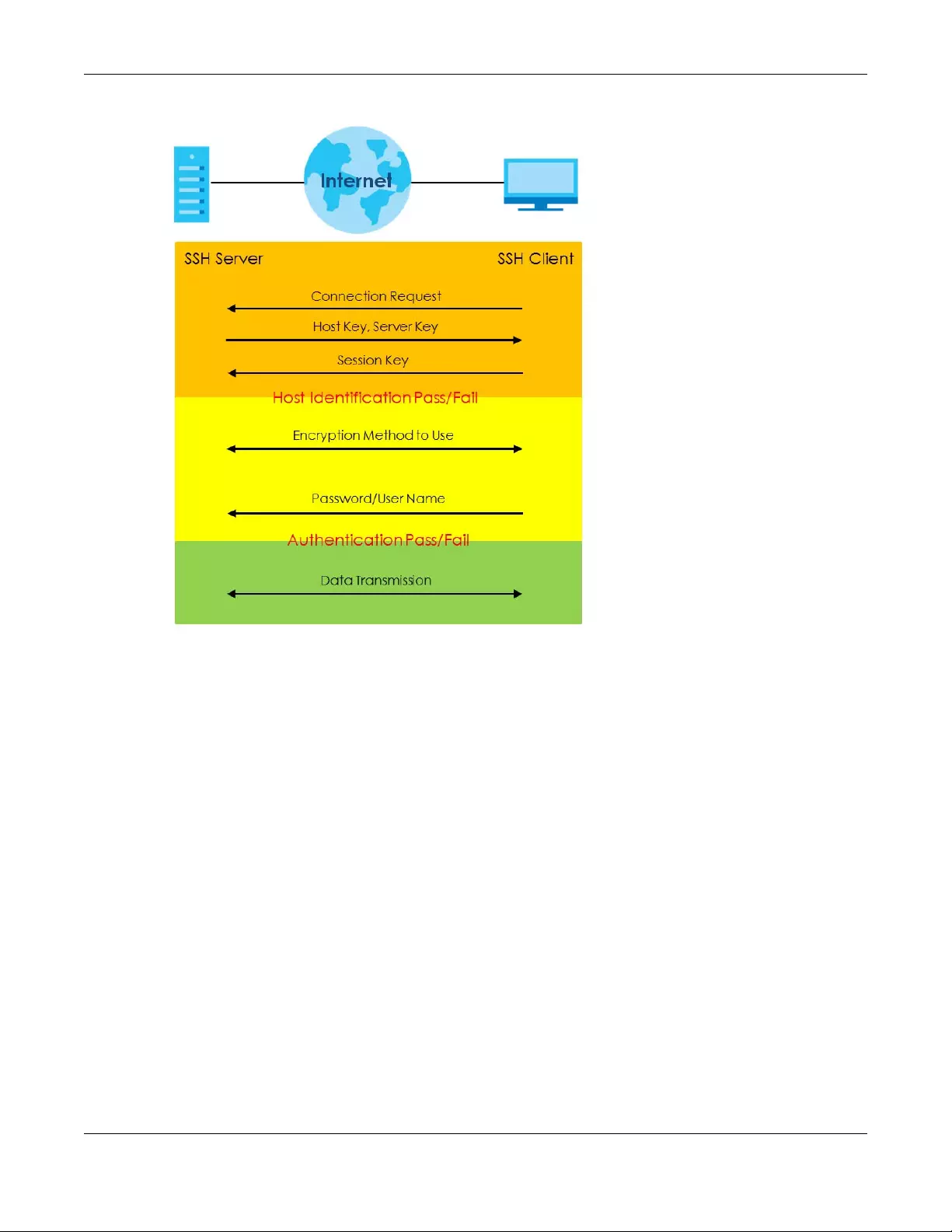
Chapter 40 Access Control
GS1920v2 Series User’s Guide
361
Figure 262 How SSH Works
1Host Identification
The SSH client sends a connection request to the SSH server. The server identifies itself with a host key. The
client encrypts a randomly generated session key with the host key and server key and sends the result
back to the server.
The client automatically saves any new server public keys. In subsequent connections, the server public
key is checked against the saved version on the client computer.
2Encryption Method
Once the identification is verified, both the client and server must agree on the type of encryption
method to use.
3Authentication and Data Transmission
After the identification is verified and data encryption activated, a secure tunnel is established between
the client and the server. The client then sends its authentication information (user name and password)
to the server to log in to the server.
40.7.2.2 SSH Implementation on the Switch
Your Switch supports SSH version 2 using RSA authentication and three encryption methods (DES, 3DES
and Blowfish). The SSH server is implemented on the Switch for remote management and file transfer on
port 22. Only one SSH connection is allowed at a time.
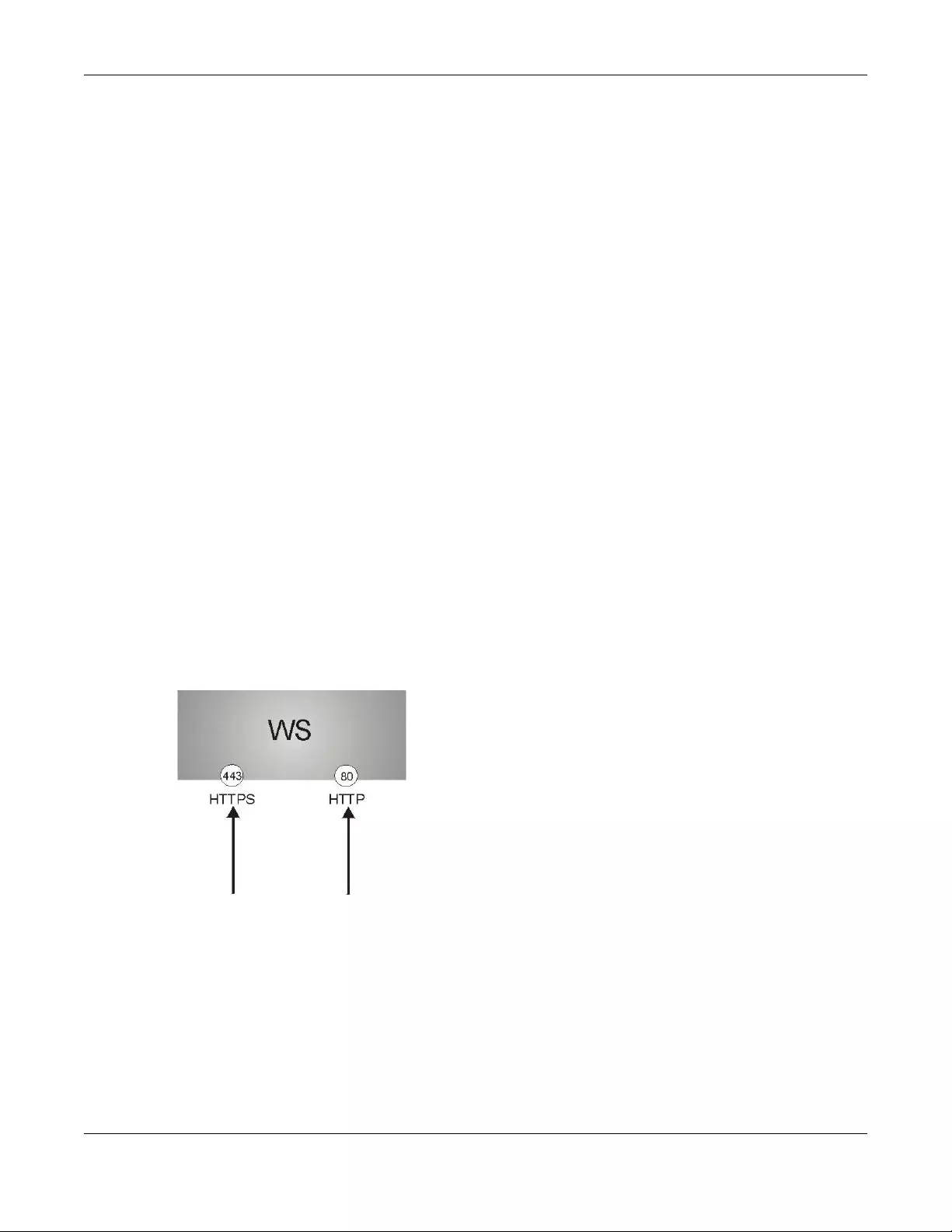
Chapter 40 Access Control
GS1920v2 Series User’s Guide
362
40.7.2.3 Requirements for Using SSH
You must install an SSH client program on a client computer (Windows or Linux operating system) that is
used to connect to the Switch over SSH.
40.7.3 Introduction to HTTPS
HTTPS (HyperText Transfer Protocol over Secure Socket Layer, or HTTP over SSL) is a web protocol that
encrypts and decrypts web pages. Secure Socket Layer (SSL) is an application-level protocol that
enables secure transactions of data by ensuring confidentiality (an unauthorized party cannot read the
transferred data), authentication (one party can identify the other party) and data integrity (you know if
data has been changed).
It relies upon certificates, public keys, and private keys.
HTTPS on the Switch is used so that you may securely access the Switch using the web configurator. The
SSL protocol specifies that the SSL server (the Switch) must always authenticate itself to the SSL client (the
computer which requests the HTTPS connection with the Switch), whereas the SSL client only should
authenticate itself when the SSL server requires it to do so. Authenticating client certificates is optional
and if selected means the SSL-client must send the Switch a certificate. You must apply for a certificate
for the browser from a Certificate Authority (CA) that is a trusted CA on the Switch.
Please refer to the following figure.
1HTTPS connection requests from an SSL-aware web browser go to port 443 (by default) on the Switch’s
WS (web server).
2HTTP connection requests from a web browser go to port 80 (by default) on the Switch’s WS (web
server).
Figure 263 HTTPS Implementation
Note: If you disable HTTP in the Service Access Control screen, then the Switch blocks all HTTP
connection attempts.
40.7.3.1 HTTPS Example
If you haven’t changed the default HTTPS port on the Switch, then in your browser enter “https://Switch
IP Address/” as the web site address where “Switch IP Address” is the IP address or domain name of the
Switch you wish to access.
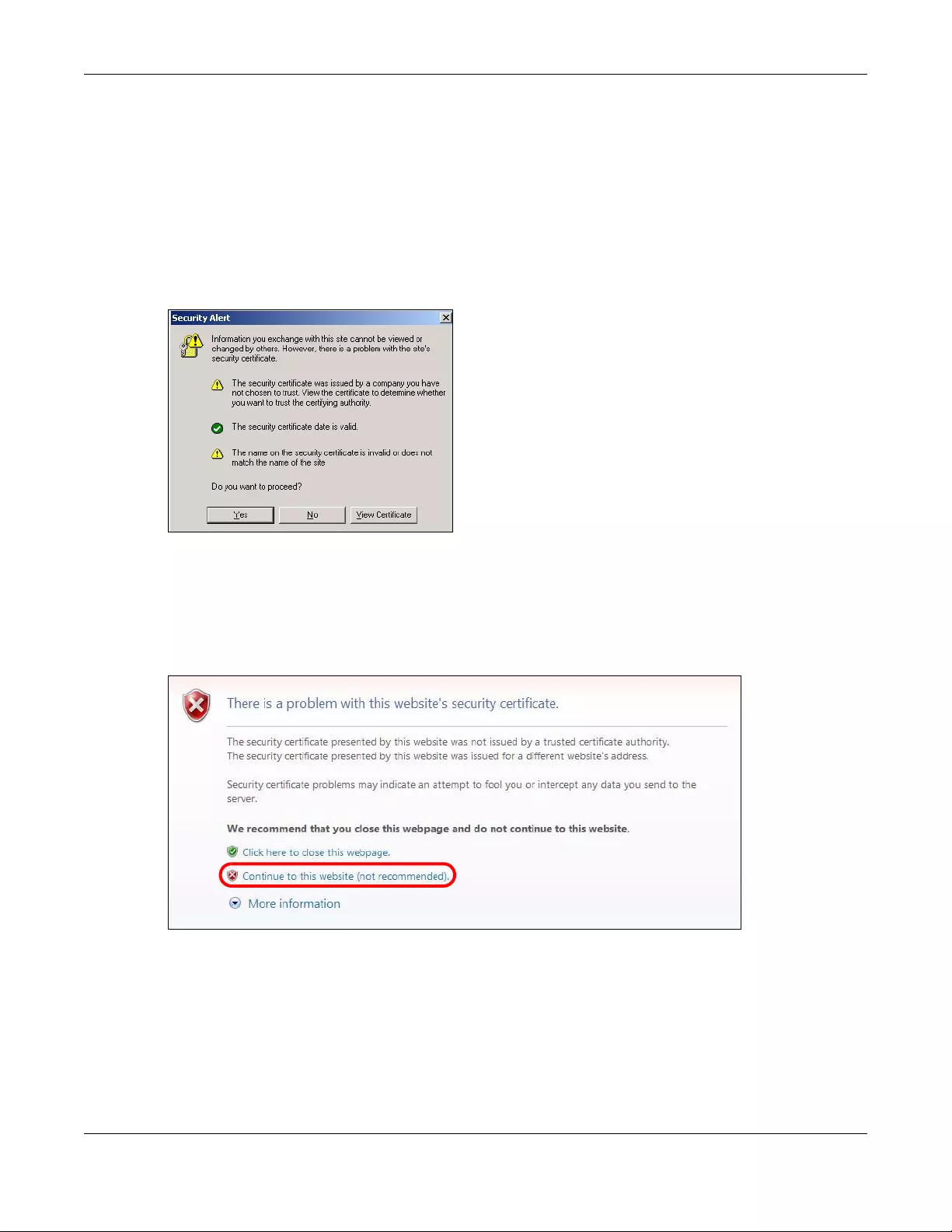
Chapter 40 Access Control
GS1920v2 Series User’s Guide
363
Internet Explorer Warning Messages
Internet Explorer 6
When you attempt to access the Switch HTTPS server, a Windows dialog box pops up asking if you trust
the server certificate.
You see the following Security Alert screen in Internet Explorer. Select Yes to proceed to the web
configurator login screen; if you select No, then web configurator access is blocked.
Figure 264 Security Alert Dialog Box (Internet Explorer 6)
Internet Explorer 7 or 8
When you attempt to access the Switch HTTPS server, a screen with the message "There is a problem
with this website's security certificate." may display. If that is the case, click Continue to this website (not
recommended) to proceed to the web configurator login screen.
Figure 265 Security Certificate Warning (Internet Explorer 7 or 8)
After you log in, you will see the red address bar with the message Certificate Error. Click on Certificate
Error next to the address bar and click View certificates.

Chapter 40 Access Control
GS1920v2 Series User’s Guide
364
Figure 266 Certificate Error (Internet Explorer 7 or 8)
Click Install Certificate... and follow the on-screen instructions to install the certificate in your browser.
Figure 267 Certificate (Internet Explorer 7 or 8)
Mozilla Firefox Warning Messages
When you attempt to access the Switch HTTPS server, a This Connection is Unstructed screen may
display. If that is the case, click I Understand the Risks and then the Add Exception... button.
EXAMPLE
EXAMPLE

Chapter 40 Access Control
GS1920v2 Series User’s Guide
365
Figure 268 Security Alert (Mozilla Firefox)
Confirm the HTTPS server URL matches. Click Confirm Security Exception to proceed to the web
configurator login screen.
Figure 269 Security Alert (Mozilla Firefox)
EXAMPLE
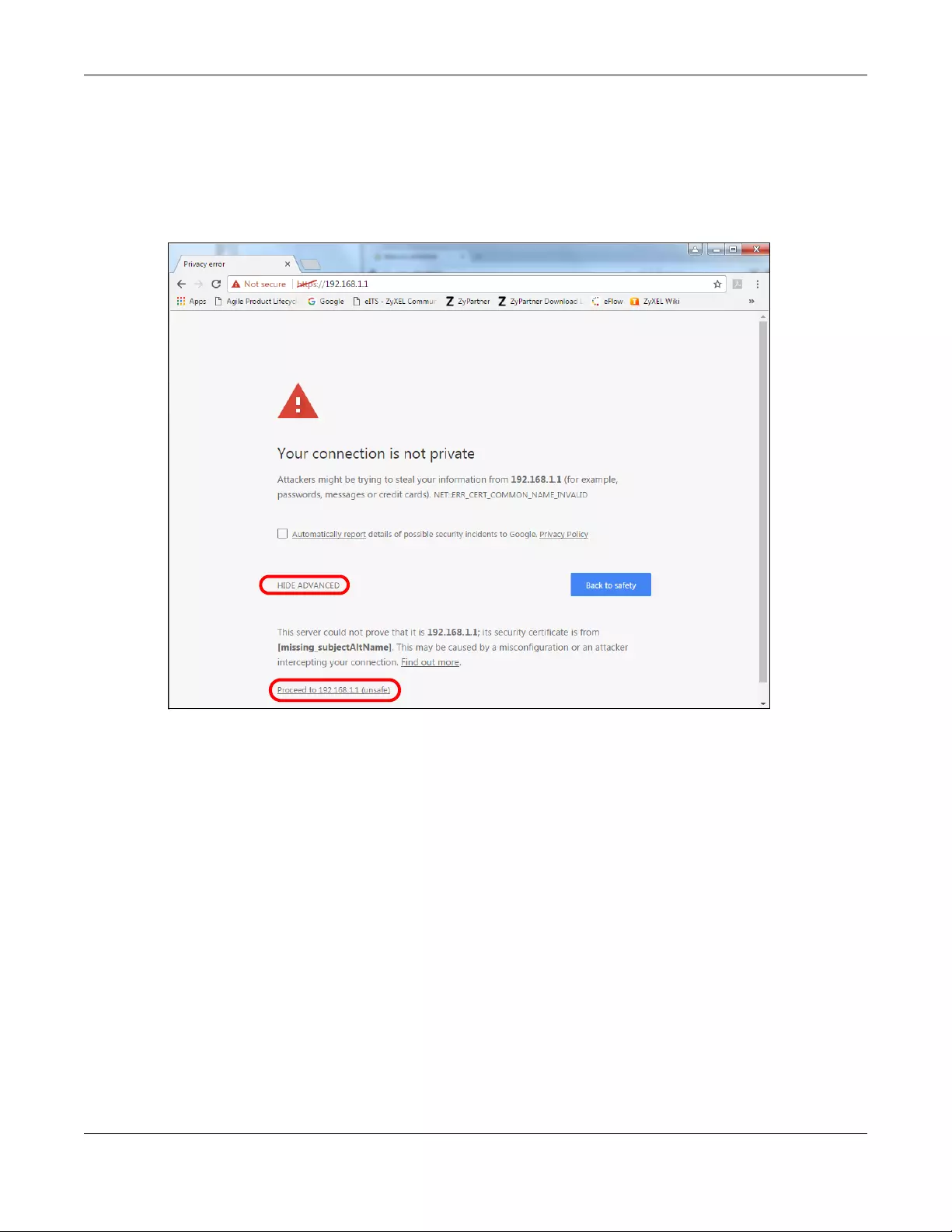
Chapter 40 Access Control
GS1920v2 Series User’s Guide
366
40.7.4 Google Chrome Warning Messages
When you attempt to access the Switch HTTPS server, a Your connection is not private screen may
display. If that is the case, click Advanced and then Proceed to x.x.x.x (unsafe) to proceed to the web
configurator login screen.
Figure 270 Security Alert (Google Chrome 58.0.3029.110)
40.7.4.1 The Main Screen
After you accept the certificate and enter the login username and password, the Switch main screen
appears. The lock displayed in the bottom right of the browser status bar or next to the website address
denotes a secure connection.

Chapter 40 Access Control
GS1920v2 Series User’s Guide
367
Figure 271 Example: Lock Denoting a Secure Connection
EXAMPLE

Chapter 41 Diagnostic
GS1920v2 Series User’s Guide
368
CHAPTER 41
Diagnostic
41.1 Overview
This chapter explains the Diagnostic screen. You can use this screen to help you identify problems.
41.2 Diagnostic
Click Management > Diagnostic in the navigation panel to open this screen. Use this screen to ping IP
addresses, run a traceroute, perform port tests or show the Switch’s location between devices.
Figure 272 Management > Diagnostic

Chapter 41 Diagnostic
GS1920v2 Series User’s Guide
369
The following table describes the labels in this screen.
Table 183 Management > Diagnostic
LABEL DESCRIPTION
Ping Test
IPv4 Select this option if you want to ping an IPv4 address, and select vlan to specify the ID
number of the VLAN to which the Switch is to send ping requests. Otherwise, select - to send
ping requests to all VLANs on the Switch.
IPv6 Select this option if you want to ping an IPv6 address. You can also select vlan and specify
the ID number of the VLAN to which the Switch is to send ping requests. Otherwise, select - to
send ping requests to all VLANs on the Switch.
IP Address/Host
Name Type the IP address or host name of a device that you want to ping in order to test a
connection.
Click Ping to have the Switch ping the IP address.
Count Enter the number of ICMP Echo Request (ping) messages the Switch continuously sends.
Trace Route Test
IPv4 Select this option if you want to trace the route packets take to a device with an IPv4
address, and select vlan to specify the ID number of the VLAN on which the Switch traces
the path. Otherwise, select - to trace the path on any VLAN.
Note: The device to which you want to run a traceroute must belong to the VLAN
you specify here.
IPv6 Select this option if you want to trace the route packets take to a device with an IPv6
address.
IP Address/Host
Name Enter the IP address or host name of a device to which you want to perform a traceroute.
Click Trace Route to have the Switch perform the traceroute function. This determines the
path a packet takes to the specified device.
TTL Enter the Time To Live (TTL) value for the ICMP Echo Request packets. This is to set the
maximum number of the hops (routers) a packet can travel through. Each router along the
path will decrement the TTL value by one and forward the packets. When the TTL value
becomes zero and the destination is not found, the router drops the packets and informs the
sender.
Wait Time Specify how many seconds the Switch waits for a response to a probe before running
another traceroute.
Queries Specify how many times the Switch performs the traceroute function.
Ethernet Port Test Enter a port number and click Po rt Test to perform an internal loopback test.
Port This is the number of the physical Ethernet port on the Switch.
Cable Diagnostics Enter a port number and click Diagnose to perform a physical wire-pair test of the Ethernet
connections on the specified port(s). The following fields display when you diagnose a port.
Port This is the number of the physical Ethernet port on the Switch.
Channel An Ethernet cable usually has four pairs of wires. A 10BASE-T or 100BASE-TX port only use and
test two pairs, while a 1000BASE-T port requires all four pairs.
This displays the descriptive name of the wire-pair in the cable.
Pair status Ok: The physical connection between the wire-pair is okay.
Open: There is no physical connection (an open circuit detected) between the wire-pair.
Short: There is an short circuit detected between the wire-pair.
Unknown: The Switch failed to run cable diagnostics on the cable connected this port.
Unsupported: The port is a fiber port or it is not active.

Chapter 41 Diagnostic
GS1920v2 Series User’s Guide
370
Cable length This displays the total length of the Ethernet cable that is connected to the port when the
Pair status is Ok and the Switch chipset supports this feature.
This shows N/A if the Pair status is Open or Short. Check the Distance to fault.
This shows Unsupported if the Switch chipset does not support to show the cable length.
Distance to
fault This displays the distance between the port and the location where the cable is open or
shorted.
This shows N/A if the Pair status is Ok.
This shows Unsupported if the Switch chipset does not support to show the distance.
Locator LED Enter a time interval (in minutes) and click Blink to show the actual location of the Switch
between several devices in a rack.
The default time interval is 30 minutes.
Click Stop to have the Switch terminate the blinking locater LED.
Table 183 Management > Diagnostic (continued)
LABEL DESCRIPTION

GS1920v2 Series User’s Guide
371
CHAPTER 42
System Log
42.1 Overview
A log message stores the information for viewing.
42.2 System Log
Click Management > System Log in the navigation panel to open this screen. Use this screen to check
current system logs.
Note: When a log reaches the maximum number of log messages, new log messages
automatically overwrite existing log messages, starting with the oldest existing log
message first.
Figure 273 Management > System Log
The summary table shows the time the log message was recorded and the reason the log message was
generated. Click Refresh to update this screen. Click Clear to clear the whole log, regardless of what is
currently displayed on the screen. Click Download to save the log to your computer.

Chapter 43 Syslog Setup
GS1920v2 Series User’s Guide
372
CHAPTER 43
Syslog Setup
43.1 Syslog Overview
This chapter explains the syslog screens.
The syslog protocol allows devices to send event notification messages across an IP network to syslog
servers that collect the event messages. A syslog-enabled device can generate a syslog message and
send it to a syslog server.
Syslog is defined in RFC 3164. The RFC defines the packet format, content and system log related
information of syslog messages. Each syslog message has a facility and severity level. The syslog facility
identifies a file in the syslog server. Refer to the documentation of your syslog program for details. The
following table describes the syslog severity levels.
43.1.1 What You Can Do
• Use the Syslog Setup screen (Section 43.2 on page 372) to configure the device’s system logging
settings and configure a list of external syslog servers.
43.2 Syslog Setup
The syslog feature sends logs to an external syslog server. Use this screen to configure the device’s
system logging settings and configure a list of external syslog servers.
Click Management > Syslog in the navigation panel to display this screen.
Table 184 Syslog Severity Levels
CODE SEVERITY
0 Emergency: The system is unusable.
1 Alert: Action must be taken immediately.
2 Critical: The system condition is critical.
3 Error: There is an error condition on the system.
4 Warning: There is a warning condition on the system.
5 Notice: There is a normal but significant condition on the system.
6 Informational: The syslog contains an informational message.
7 Debug: The message is intended for debug-level purposes.
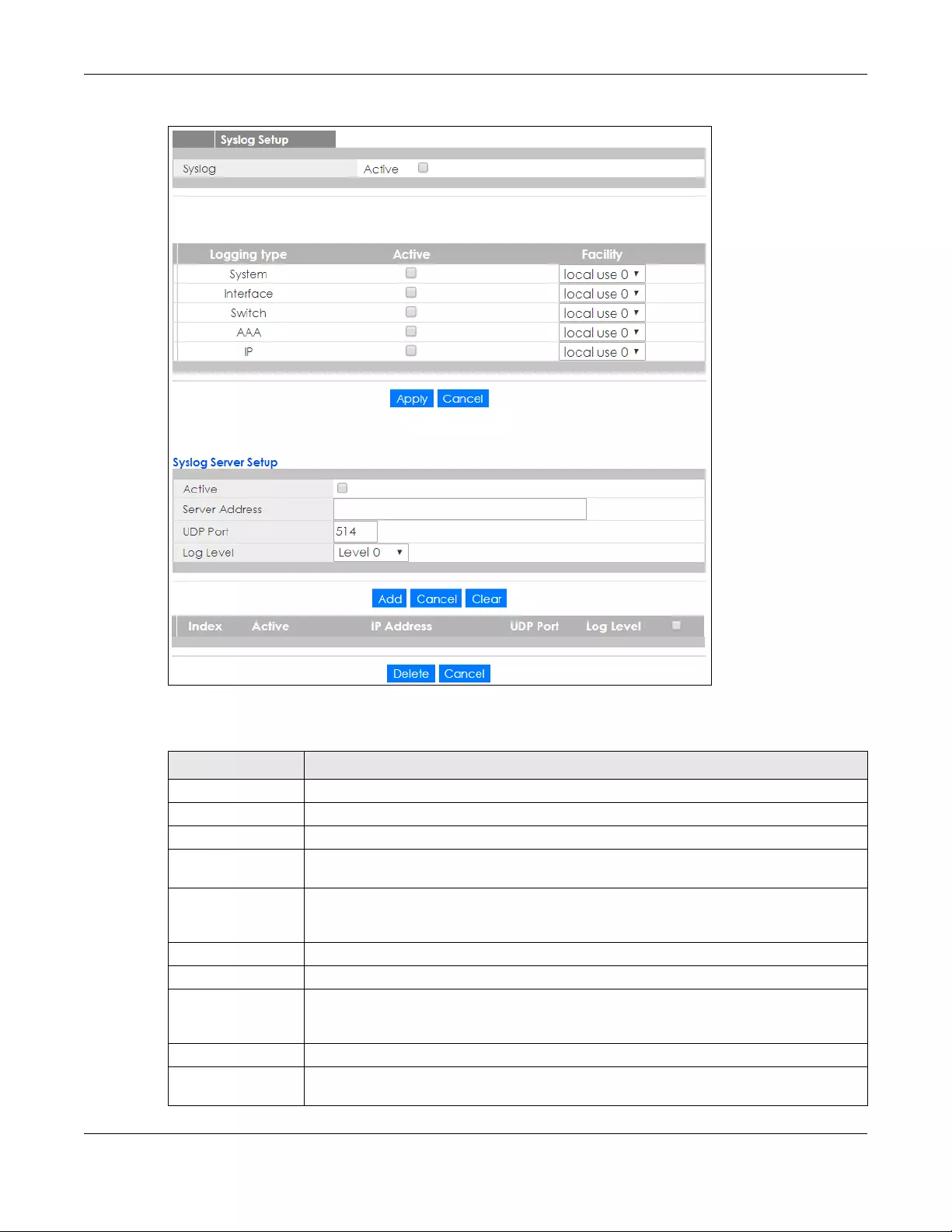
Chapter 43 Syslog Setup
GS1920v2 Series User’s Guide
373
Figure 274 Management > Syslog Setup
The following table describes the labels in this screen.
Table 185 Management > Syslog Setup
LABEL DESCRIPTION
Syslog Select Active to turn on syslog (system logging) and then configure the syslog setting
Logging Type This column displays the names of the categories of logs that the device can generate.
Active Select this option to set the device to generate logs for the corresponding category.
Facility The log facility allows you to send logs to different files in the syslog server. Refer to the
documentation of your syslog program for more details.
Apply Click Apply to save your changes to the Switch’s run-time memory. The Switch loses these
changes if it is turned off or loses power, so use the Save link on the top navigation panel to
save your changes to the non-volatile memory when you are done configuring.
Cancel Click Cancel to begin configuring this screen afresh.
Syslog Server Setup
Active Select this check box to have the device send logs to this syslog server. Clear the check box
if you want to create a syslog server entry but not have the device send logs to it (you can
edit the entry later).
Server Address Enter the IPv4 or IPv6 address of the syslog server.
UDP Port The default syslog server port is 514. If your syslog server uses a different port, configure the
one it uses here.

GS1920v2 Series User’s Guide
374
Log Level Select the severity level(s) of the logs that you want the device to send to this syslog server.
The lower the number, the more critical the logs are.
Add Click Add to save your changes to the Switch’s run-time memory. The Switch loses these
changes if it is turned off or loses power, so use the Save link on the top navigation panel to
save your changes to the non-volatile memory when you are done configuring.
Cancel Click Cancel to begin configuring this screen afresh.
Clear Click Clear to return the fields to the factory defaults.
Index This is the index number of a syslog server entry. Click this number to edit the entry.
Active This field displays Yes if the device is to send logs to the syslog server. No displays if the
device is not to send logs to the syslog server.
IP Address This field displays the IP address of the syslog server.
UDP Port This field displays the port of the syslog server.
Log Level This field displays the severity level of the logs that the device is to send to this syslog server.
Select an entry’s check box to select a specific entry. Otherwise, select the check box in the
table heading row to select all entries.
Delete Click Delete to remove the selected entry(ies).
Cancel Click Cancel to begin configuring this screen afresh.
Table 185 Management > Syslog Setup
LABEL DESCRIPTION

GS1920v2 Series User’s Guide
375
CHAPTER 44
Cluster Management
44.1 Cluster Management Overview
This chapter introduces cluster management.
Cluster Management allows you to manage switches through one Switch, called the cluster manager.
The switches must be directly connected and be in the same VLAN group so as to be able to
communicate with one another.
In the following example, switch A in the basement is the cluster manager and the other switches on the
upper floors of the building are cluster members.
Figure 275 Clustering Application Example
44.1.1 What You Can Do
• Use the Cluster Management screen (Section 44.2 on page 376) to view the role of the Switch within
the cluster and to access a cluster member switch’s web configurator.
Table 186 Zyxel Clustering Management Specifications
Maximum number of cluster members 24
Cluster Member Models Must be compatible with Zyxel cluster management
implementation.
Cluster Manager The switch through which you manage the cluster member
switches.
Cluster Members The switches being managed by the cluster manager switch.
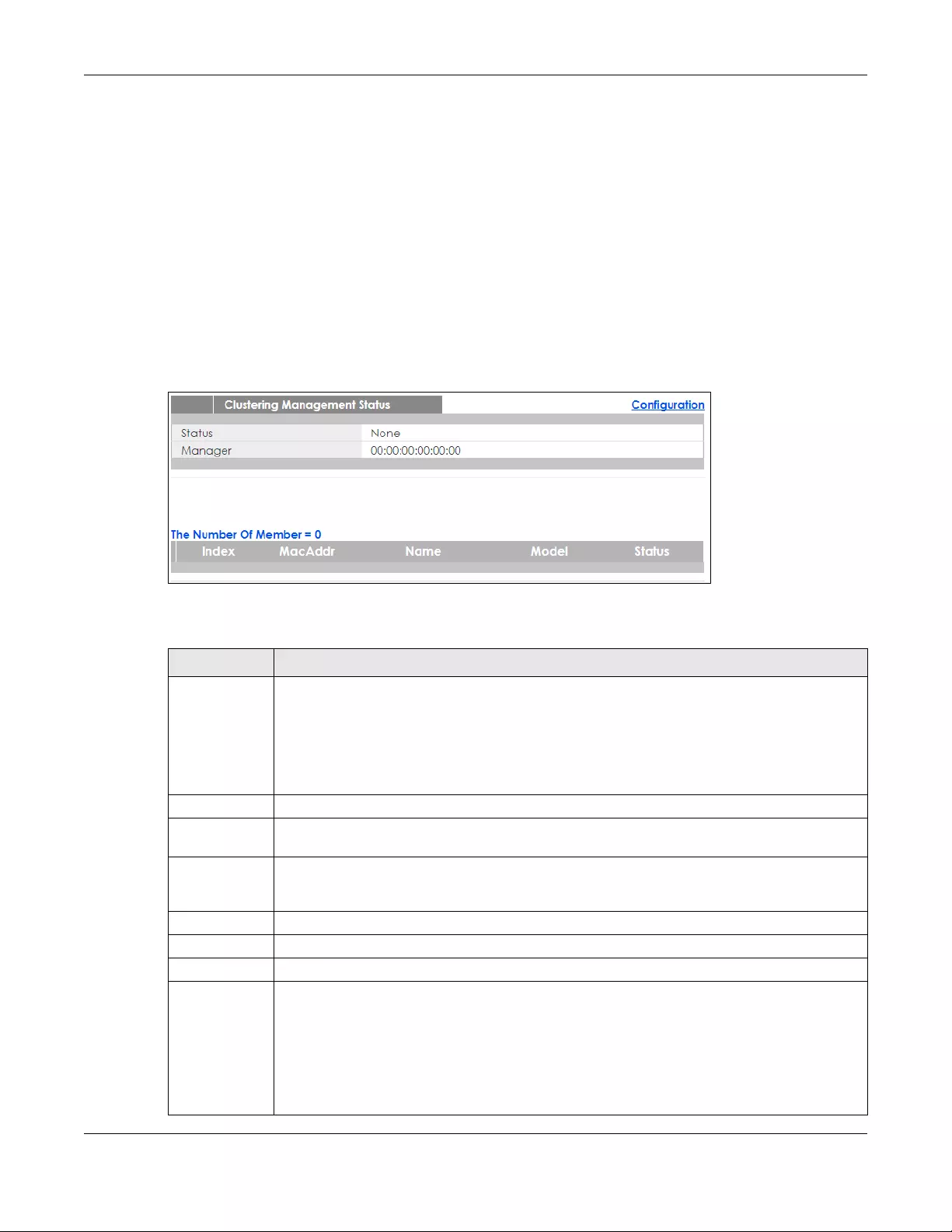
Chapter 44 Cluster Management
GS1920v2 Series User’s Guide
376
• Use the Clustering Management Configuration screen (Section 44.1 on page 375) to configure
clustering management.
44.2 Cluster Management Status
Use this screen to view the role of the Switch within the cluster and to access a cluster member switch’s
web configurator.
Click Management > Cluster Management in the navigation panel to display the following screen.
Note: A cluster can only have one manager.
Figure 276 Management > Cluster Management: Status
The following table describes the labels in this screen.
Table 187 Management > Cluster Management: Status
LABEL DESCRIPTION
Status This field displays the role of this Switch within the cluster.
Manager
Member (you see this if you access this screen in the cluster member switch directly and not via
the cluster manager)
None (neither a manager nor a member of a cluster)
Manager This field displays the cluster manager switch’s hardware MAC address.
The Number of
Member
This field displays the number of switches that make up this cluster. The following fields describe
the cluster member switches.
Index You can manage cluster member switches via the cluster manager switch. Each number in the
Index column is a hyperlink leading to the cluster member switch’s web configurator (see Figure
278 on page 379).
MacAddr This is the cluster member switch’s hardware MAC address.
Name This is the cluster member switch’s System Name.
Model This field displays the model name.
Status This field displays:
Online (the cluster member switch is accessible)
Error (for example the cluster member switch password was changed or the switch was set as the
manager and so left the member list, etc.)
Offline (the switch is disconnected - Offline shows approximately 1.5 minutes after the link
between cluster member and manager goes down)
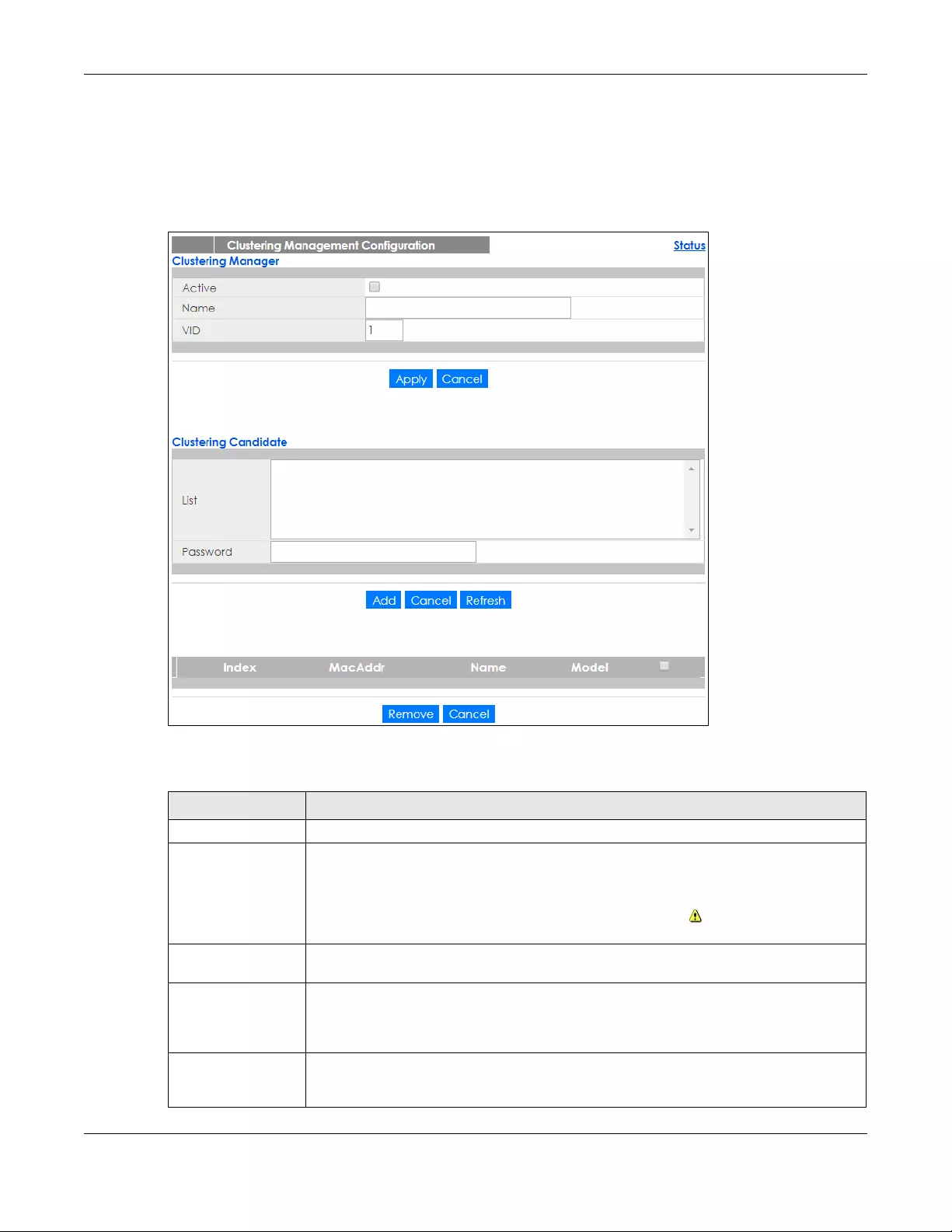
Chapter 44 Cluster Management
GS1920v2 Series User’s Guide
377
44.3 Clustering Management Configuration
Use this screen to configure clustering management. Click Management > Cluster Management >
Configuration to display the next screen.
Figure 277 Management > Cluster Management > Configuration
The following table describes the labels in this screen.
Table 188 Management > Cluster Management > Configuration
LABEL DESCRIPTION
Clustering Manager
Active Select Active to have this Switch become the cluster manager switch. A cluster can only
have one manager. Other (directly connected) switches that are set to be cluster
managers will not be visible in the Clustering Candidates list. If a switch that was previously a
cluster member is later set to become a cluster manager, then its Status is displayed as Error
in the Cluster Management Status screen and a warning icon ( ) appears in the member
summary list below.
Name Type a name to identify the Clustering M anager. You may use up to 32 printable characters
(spaces are allowed).
VID This is the VLAN ID and is only applicable if the Switch is set to 802.1Q VLAN. All switches must
be directly connected and in the same VLAN group to belong to the same cluster. Switches
that are not in the same VLAN group are not visible in the Clustering Candidates list. This
field is ignored if the Clustering Manager is using Port-based VLAN.
Apply Click Apply to save your changes to the Switch’s run-time memory. The Switch loses these
changes if it is turned off or loses power, so use the Save link on the top navigation panel to
save your changes to the non-volatile memory when you are done configuring.

GS1920v2 Series User’s Guide
378
44.4 Technical Reference
This section provides technical background information on the topics discussed in this chapter.
44.4.1 Cluster Member Switch Management
Go to the Clustering Management Status screen of the cluster manager switch and then select an Index
hyperlink from the list of members to go to that cluster member switch's web configurator home page.
This cluster member web configurator home page and the home page that you'd see if you accessed it
directly are different.
Cancel Click Cancel to begin configuring this screen afresh.
Clustering
Candidate
The following fields relate to the switches that are potential cluster members.
List A list of suitable candidates found by auto-discovery is shown here. The switches must be
directly connected. Directly connected switches that are set to be cluster managers will
not be visible in the Clustering Candidate list. Switches that are not in the same
management VLAN group will not be visible in the Clustering Candidate list.
Password Each cluster member’s password is its web configurator password. Select a member in the
Clustering Candidate list and then enter its web configurator password. If that switch
administrator changes the web configurator password afterwards, then it cannot be
managed from the Cluster Manager. Its Status is displayed as Error in the Cluster
Management Status screen.
If multiple devices have the same password then hold [SHIFT] and click those switches to
select them. Then enter their common web configurator password.
Add Click Add to save your changes to the Switch’s run-time memory. The Switch loses these
changes if it is turned off or loses power, so use the Save link on the top navigation panel to
save your changes to the non-volatile memory when you are done configuring.
Cancel Click Cancel to begin configuring this screen afresh.
Refresh Click Refresh to perform auto-discovery again to list potential cluster members.
The next summary table shows the information for the clustering members configured.
Index This is the index number of a cluster member switch.
MacAddr This is the cluster member switch’s hardware MAC address.
Name This is the cluster member switch’s System Name.
Model This is the cluster member switch’s model name.
Select an entry’s check box to select a specific entry. Otherwise, select the check box in
the table heading row to select all entries.
Remove Click the Remove button to remove the selected cluster member switch(es) from the
cluster.
Cancel Click Cancel to begin configuring this screen afresh.
Table 188 Management > Cluster Management > Configuration (continued)
LABEL DESCRIPTION
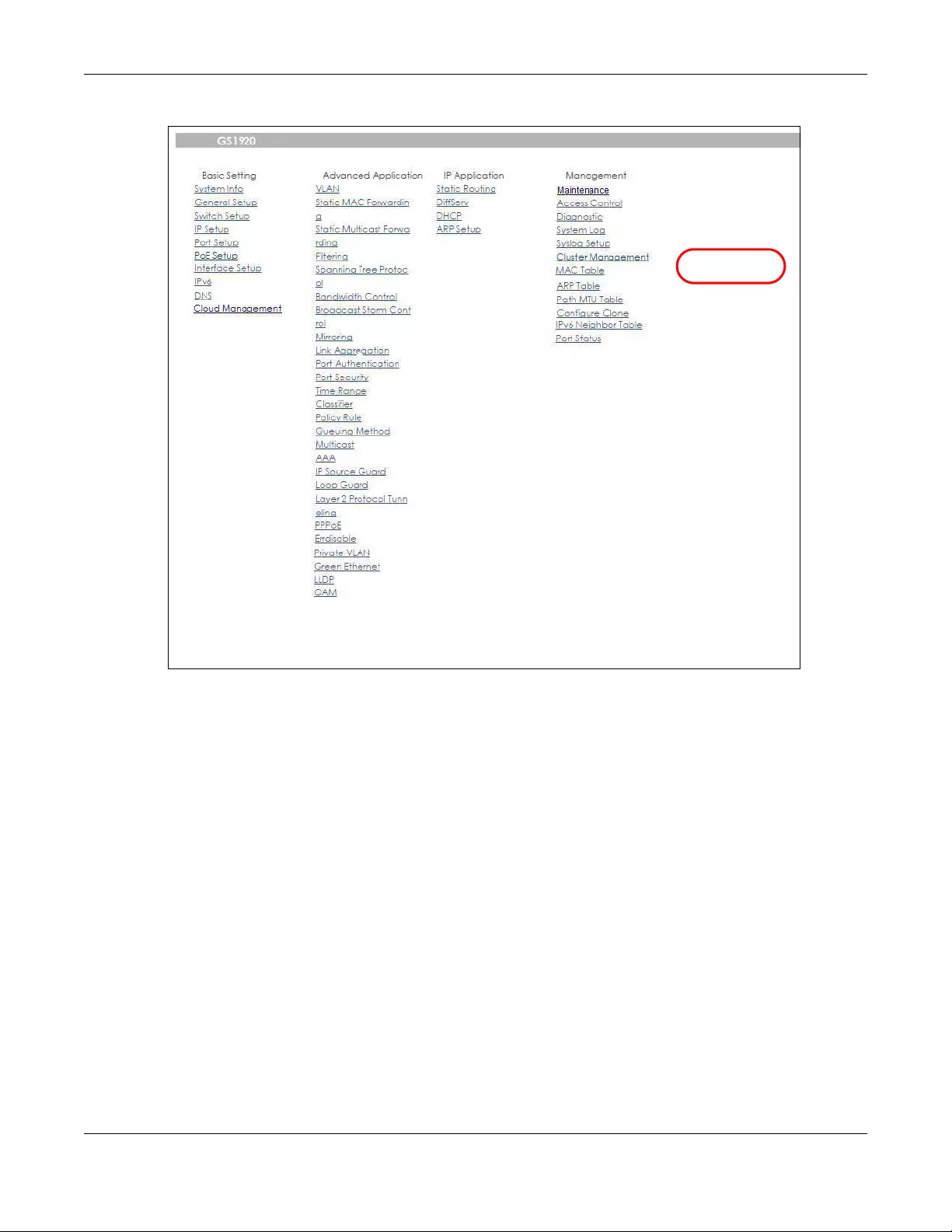
Chapter 44 Cluster Management
GS1920v2 Series User’s Guide
379
Figure 278 Cluster Management: Cluster Member Web Configurator Screen
44.4.1.1 Uploading Firmware to a Cluster Member Switch
You can use FTP to upload firmware to a cluster member switch through the cluster manager switch as
shown in the following example.
example

Chapter 44 Cluster Management
GS1920v2 Series User’s Guide
380
Figure 279 Example: Uploading Firmware to a Cluster Member Switch
The following table explains some of the FTP parameters.
C:\>ftp 192.168.1.1
Connected to 192.168.1.1.
220 Switch FTP version 1.0 ready at Thu Jan 1 00:58:46 1970
User (192.168.0.1:(none)): admin
331 Enter PASS command
Password:
230 Logged in
ftp> ls
200 Port command okay
150 Opening data connection for LIST
--w--w--w- 1 owner group 3042210 Jul 01 12:00 ras
-rw-rw-rw- 1 owner group 393216 Jul 01 12:00 config
--w--w--w- 1 owner group 0 Jul 01 12:00 fw-00-a0-c5-01-23-46
-rw-rw-rw- 1 owner group 0 Jul 01 12:00 config-00-a0-c5-01-23-46
226 File sent OK
ftp: 297 bytes received in 0.00Seconds 297000.00Kbytes/sec.
ftp> bin
200 Type I OK
ftp> put 430AAHW0.bin fw-00-a0-c5-01-23-46
200 Port command okay
150 Opening data connection for STOR fw-00-a0-c5-01-23-46
226 File received OK
ftp: 262144 bytes sent in 0.63Seconds 415.44Kbytes/sec.
ftp>
Table 189 FTP Upload to Cluster Member Example
FTP PARAMETER DESCRIPTION
User Enter “admin”.
Password The web configurator password default is 1234.
ls Enter this command to list the name of cluster member switch’s firmware and
configuration file.
430AAHW0.bin This is the name of the firmware file you want to upload to the cluster member
switch.
fw-00-a0-c5-01-23-46 This is the cluster member switch’s firmware name as seen in the cluster
manager switch.
config-00-a0-c5-01-23-46 This is the cluster member switch’s configuration file name as seen in the cluster
manager switch.

Chapter 45 MAC Table
GS1920v2 Series User’s Guide
381
CHAPTER 45
MAC Table
45.1 MAC Table Overview
This chapter introduces the MAC Table screen.
The MAC Table screen (a MAC table is also known as a filtering database) shows how frames are
forwarded or filtered across the Switch’s ports. It shows what device MAC address, belonging to what
VLAN group (if any) is forwarded to which port(s) and whether the MAC address is dynamic (learned by
the Switch) or static (manually entered in the Static MAC Forwarding screen).
45.1.1 What You Can Do
Use the MAC Table screen (Section 45.2 on page 382) to check whether the MAC address is dynamic or
static.
45.1.2 What You Need to Know
The Switch uses the MAC table to determine how to forward frames. See the following figure.
1The Switch examines a received frame and learns the port on which this source MAC address came.
2The Switch checks to see if the frame's destination MAC address matches a source MAC address
already learned in the MAC table.
• If the Switch has already learned the port for this MAC address, then it forwards the frame to that port.
• If the Switch has not already learned the port for this MAC address, then the frame is flooded to all
ports. Too much port flooding leads to network congestion.
• If the Switch has already learned the port for this MAC address, but the destination port is the same as
the port it came in on, then it filters the frame.

Chapter 45 MAC Table
GS1920v2 Series User’s Guide
382
Figure 280 MAC Table Flowchart
45.2 Viewing the MAC Table
Use this screen to check whether the MAC address is dynamic or static.
Click Management > MAC Table in the navigation panel to display the following screen.
Figure 281 Management > MAC Table

Chapter 45 MAC Table
GS1920v2 Series User’s Guide
383
The following table describes the labels in this screen.
Table 190 Management > MAC Table
LABEL DESCRIPTION
Condition Select one of the buttons and click Search to only display the data which matches the criteria
you specified.
Select All to display any entry in the MAC table of the Switch.
Select Static to display the MAC entries manually configured on the Switch.
Select MAC and enter a MAC address in the field provided to display a specified MAC entry.
Select VID and enter a VLAN ID in the field provided to display the MAC entries belonging to the
specified VLAN.
Select Port and enter a port number in the field provided to display the MAC addresses which
are forwarded on the specified port.
Sort by Define how the Switch displays and arranges the data in the summary table below.
Select MAC to display and arrange the data according to MAC address.
Select VID to display and arrange the data according to VLAN group.
Select PORT to display and arrange the data according to port number.
Transfer Type Select Dynamic to MAC forwarding and click the Transfer button to change all dynamically
learned MAC address entries in the summary table below into static entries. They also display in
the Static MAC Forwarding screen.
Select Dynamic to MAC filtering and click the Transfer button to change all dynamically learned
MAC address entries in the summary table below into MAC filtering entries. These entries will then
display only in the Filtering screen and the default filtering action is Discard source .
Search Click this to search data in the MAC table according to your input criteria.
Transfer Click this to perform the MAC address transferring you selected in the Transfer Type field.
Cancel Click Cancel to change the fields back to their last saved values.
Index This is the incoming frame index number.
MAC Address This is the MAC address of the device from which this incoming frame came.
VID This is the VLAN group to which this frame belongs.
Port This is the port where the above MAC address is forwarded.
Type This shows whether the MAC address is dynamic (learned by the Switch) or static (manually
entered in the Static MAC Forwarding screen).

GS1920v2 Series User’s Guide
384
CHAPTER 46
ARP Table
46.1 Overview
This chapter introduces ARP Table.
Address Resolution Protocol (ARP) is a protocol for mapping an Internet Protocol address (IP address) to
a physical machine address, also known as a Media Access Control or MAC address, on the local area
network.
An IP (version 4) address is 32 bits long. In an Ethernet LAN, MAC addresses are 48 bits long. The ARP
Table maintains an association between each MAC address and its corresponding IP address.
46.1.1 What You Can Do
Use the ARP Table screen (Section 46.2 on page 384) to view IP-to-MAC address mapping(s).
46.1.2 What You Need to Know
When an incoming packet destined for a host device on a local area network arrives at the Switch, the
Switch's ARP program looks in the ARP Table and if it finds the address, it sends it to the device.
If no entry is found for the IP address, ARP broadcasts the request to all the devices on the LAN. The
Switch fills in its own MAC and IP address in the sender address fields, and puts the known IP address of
the target in the target IP address field. In addition, the Switch puts all ones in the target MAC field
(FF.FF.FF.FF.FF.FF is the Ethernet broadcast address). The replying device (which is either the IP address of
the device being sought or the router that knows the way) replaces the broadcast address with the
target's MAC address, swaps the sender and target pairs, and unicasts the answer directly back to the
requesting machine. ARP updates the ARP Table for future reference and then sends the packet to the
MAC address that replied.
46.2 Viewing the ARP Table
Use the ARP table to view IP-to-MAC address mapping(s) and remove specific dynamic ARP entries.
Click Management > ARP Table in the navigation panel to open the following screen.

Chapter 46 ARP Table
GS1920v2 Series User’s Guide
385
Figure 282 Management > ARP Table
The following table describes the labels in this screen.
Table 191 Management > ARP Table
LABEL DESCRIPTION
Condition Specify how you want the Switch to remove ARP entries when you click Flush.
Select All to remove all of the dynamic entries from the ARP table.
Select IP Address and enter an IP address to remove the dynamic entries learned with the
specified IP address.
Select Port and enter a port number to remove the dynamic entries learned on the specified port.
Flush Click Flush to remove the ARP entries according to the condition you specified.
Cancel Click Cancel to return the fields to the factory defaults.
Index This is the ARP table entry number.
IP Address This is the IP address of a device connected to a Switch port with the corresponding MAC address
below.
MAC Address This is the MAC address of the device with the corresponding IP address above.
VID This field displays the VLAN to which the device belongs.
Port This field displays the port to which the device connects. CPU means this IP address is the Switch’s
management IP address.
Age(s) This field displays how long (in seconds) an entry can still remain in the ARP table before it ages out
and needs to be relearned. This shows 0 for a static entry.
Type This shows whether the IP address is dynamic (learned by the Switch) or static (manually
configured in the Basic Setting > IP Setup screen).
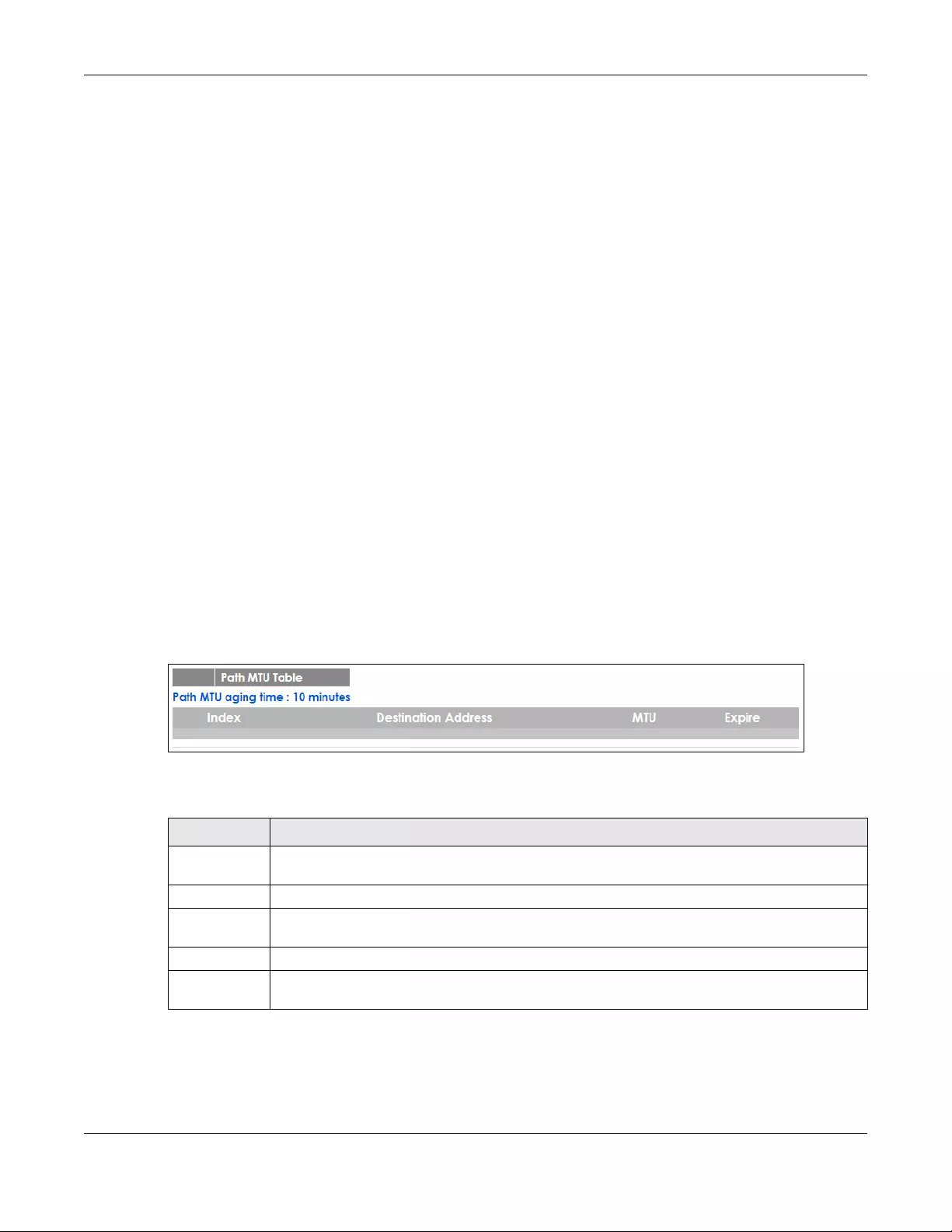
Chapter 47 Path MTU Table
GS1920v2 Series User’s Guide
386
CHAPTER 47
Path MTU Table
47.1 Path MTU Overview
This chapter introduces the IPv6 Path MTU table.
The largest size (in bytes) of a packet that can be transferred over a data link is called the maximum
transmission unit (MTU). The Switch uses Path MTU Discovery to discover Path MTU (PMTU), that is, the
minimum link MTU of all the links in a path to the destination. If the Switch receives an ICMPv6 Packet Too
Big error message after sending a packet, it fragments the next packet according to the suggested MTU
in the error message.
47.2 Viewing the Path MTU Table
Use this screen to view IPv6 path MTU information on the Switch. Click Management > Path MTU Table in
the navigation panel to display the screen as shown.
Figure 283 Management > Path MTU Table
The following table describes the labels in this screen.
Table 192 Management > Path MTU Table
LABEL DESCRIPTION
Path MTU
aging time
This field displays how long an entry remains in the Path MTU table before it ages out and needs to
be relearned.
Index This field displays the index number of each entry in the table.
Destination
Address
This field displays the destination IPv6 address of each path/entry.
MTU This field displays the maximum transmission unit of the links in the path.
Expire This field displays how long (in minutes) an entry can still remain in the Path MTU table before it
ages out and needs to be relearned.

GS1920v2 Series User’s Guide
387
CHAPTER 48
Configure Clone
48.1 Overview
This chapter shows you how you can copy the settings of one port onto other ports.
48.2 Configure Clone
Cloning allows you to copy the basic and advanced settings from a source port to a destination port or
ports. Click Management > Configure Clone to open the following screen.
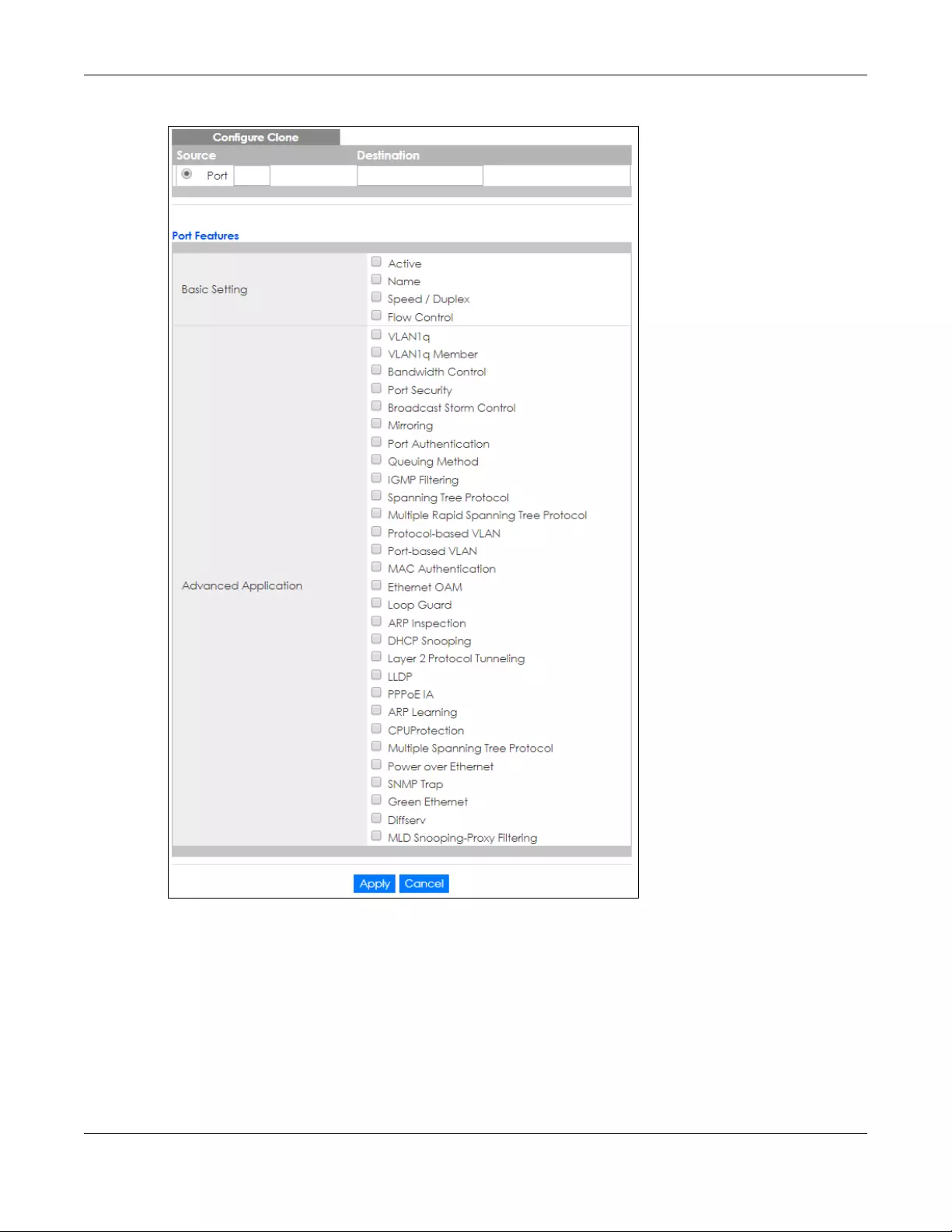
Chapter 48 Configure Clone
GS1920v2 Series User’s Guide
388
Figure 284 Management > Configure Clone

GS1920v2 Series User’s Guide
389
The following table describes the labels in this screen.
Table 193 Management > Configure Clone
LABEL DESCRIPTION
Source/
Destination
Port
Enter the source port under the Source label. This port’s attributes are copied.
Enter the destination port or ports under the Destination label. These are the ports which are going
to have the same attributes as the source port. You can enter individual ports separated by a
comma or a range of ports by using a dash.
Example:
2, 4, 6 indicates that ports 2, 4 and 6 are the destination ports.
2-6 indicates that ports 2 through 6 are the destination ports.
Basic Setting Select which port settings (you configured in the Basic Setting menus) should be copied to the
destination port(s).
Advanced
Application
Select which port settings (you configured in the Advanced Application menus) should be copied
to the destination ports.
Apply Click Apply to save your changes to the Switch’s run-time memory. The Switch loses these
changes if it is turned off or loses power, so use the Save link on the top navigation panel to save
your changes to the non-volatile memory when you are done configuring.
Cancel Click Cancel to begin configuring this screen afresh.

GS1920v2 Series User’s Guide
390
CHAPTER 49
IPv6 Neighbor Table
49.1 IPv6 Neighbor Table Overview
This chapter introduces the IPv6 neighbor table.
An IPv6 host is required to have a neighbor table. If there is an address to be resolved or verified, the
Switch sends out a neighbor solicitation message. When the Switch receives a neighbor advertisement
in response, it stores the neighbor’s link-layer address in the neighbor table. You can also manually
create a static IPv6 neighbor entry using the Basic Setting > IPv6 > IPv6 Configuration > IPv6 Neighbor
Setup screen.
When the Switch needs to send a packet, it first consults other table to determine the next hop. Once
the next hop IPv6 address is known, the Switch looks into the neighbor table to get the link-layer address
and sends the packet when the neighbor is reachable. If the Switch cannot find an entry in the
neighbor table or the state for the neighbor is not reachable, it starts the address resolution process. This
helps reduce the number of IPv6 solicitation and advertisement messages.
49.2 Viewing the IPv6 Neighbor Table
Use this screen to view IPv6 neighbor information on the Switch. Click Management > IPv6 Neighbor
Table in the navigation panel to display the screen as shown.
Figure 285 Management > IPv6 Neighbor Table
The following table describes the labels in this screen.
Table 194 Management > IPv6 Neighbor Table
LABEL DESCRIPTION
Sort by Select this to display and arrange the data according to IPv6 address (Address), MAC address
(MAC) or IPv6 interface (Interface). The information is then displayed in the summary table below.
Index This field displays the index number of each entry in the table.
Address This field displays the IPv6 address of the Switch or a neighboring device.
MAC This field displays the MAC address of the IPv6 interface on which the IPv6 address is configured or
the MAC address of the neighboring device.

Chapter 49 IPv6 Neighbor Table
GS1920v2 Series User’s Guide
391
Status This field displays whether the neighbor IPv6 interface is reachable. In IPv6, “reachable” means an
IPv6 packet can be correctly forwarded to a neighbor node (host or router) and the neighbor can
successfully receive and handle the packet. The available options in this field are:
• reachable (R): The interface of the neighboring device is reachable. (The Switch has received
a response to the initial request.)
• stale (S): The last reachable time has expired and the Switch is waiting for a response to
another initial request. The field displays this also when the Switch receives an unrequested
response from the neighbor’s interface.
• delay (D): The neighboring interface is no longer known to be reachable, and traffic has been
sent to the neighbor recently. The Switch delays sending request packets for a short to give
upper-layer protocols a chance to determine reachability.
• probe (P): The Switch is sending request packets and waiting for the neighbor’s response.
• invalid (IV): The neighbor address is with an invalid IPv6 address.
• unknown (?): The status of the neighboring interface can not be determined for some reason.
• incomplete (I): Address resolution is in progress and the link-layer address of the neighbor has
not yet been determined. The interface of the neighboring device did not give a complete
response.
Type This field displays the type of an address mapping to a neighbor interface. The available options in
this field are:
• other (O): none of the following type.
• local (L): A Switch interface is using the address.
• dynamic (D): The IP address to MAC address can be successfully resolved using IPv6 Neighbor
Discovery protocol. Is it similar as IPv4 ARP (Address Resolution protocol).
• static (S): The interface address is statically configured.
Interface This field displays the ID number of the IPv6 interface on which the IPv6 address is created or
through which the neighboring device can be reached.
Table 194 Management > IPv6 Neighbor Table (continued)
LABEL DESCRIPTION
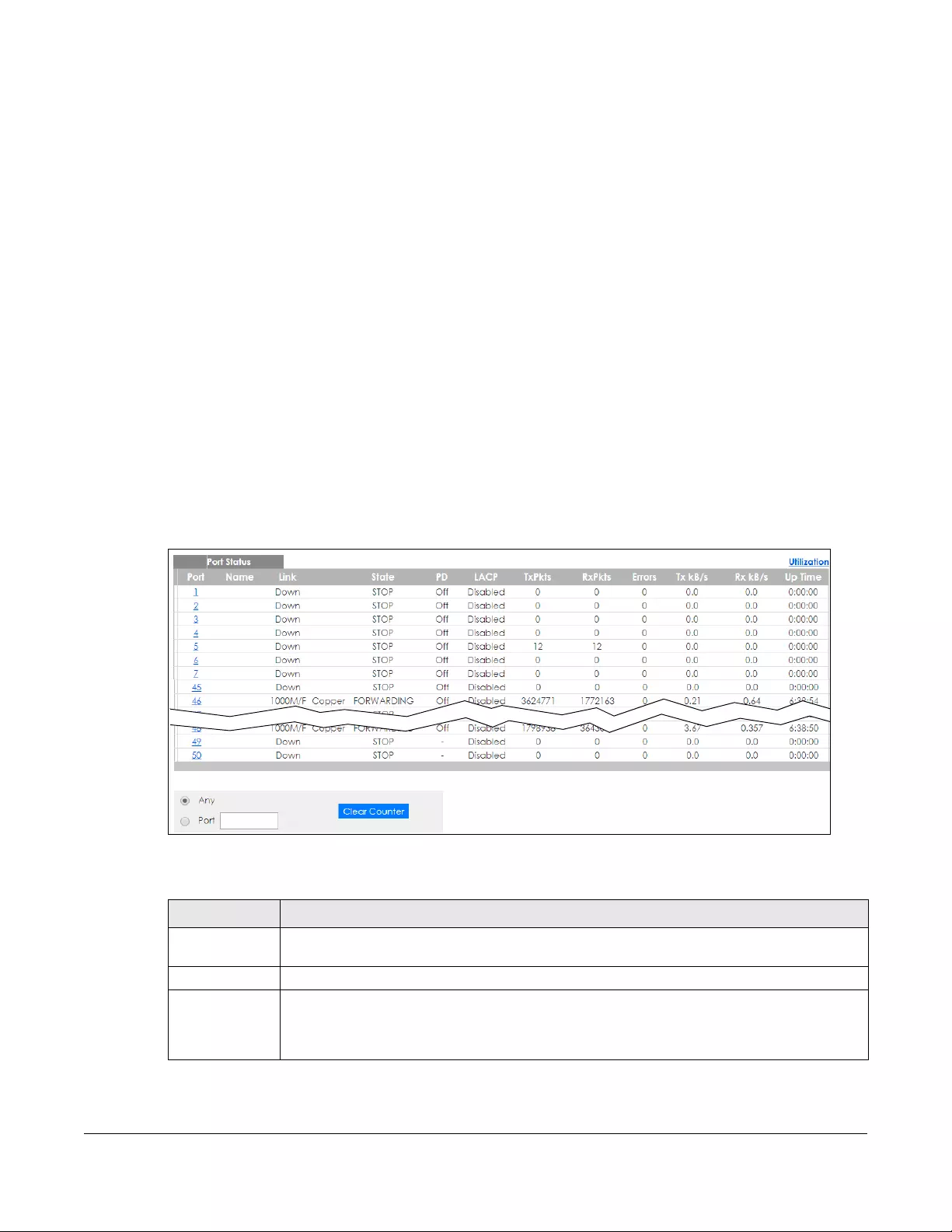
GS1920v2 Series User’s Guide
392
CHAPTER 50
Port Status
50.1 Overview
This chapter introduces the port status screens.
50.2 Port Status
This screen displays a port statistical summary with links to each port showing statistical details. To view
the port statistics, click Status in all web configurator screens and then the Port Status link in the Quick
Links section of the Status screen to display the Port Status screen as shown next. You can also click
Management > Port Status to see the following screen.
Figure 286 Port Status (for PoE model(s))
The following table describes the labels in this screen.
Table 195 Port Status
LABEL DESCRIPTION
Port This identifies the Ethernet port. Click a port number to display the Port Details screen (refer to
Figure 287 on page 394).
Name This is the name you assigned to this port in the Basic Setting > Port Setup screen.
Link This field displays the speed (either 10M for 10Mbps, 100M for 100Mbps, 1000M for 1000Mbps, or
10G for 10 Gbps) and the duplex (F for full duplex or H for half). It also shows the cable type
(Copper or Fiber) for the combo ports. This field displays Down if the port is not connected to any
device.

Chapter 50 Port Status
GS1920v2 Series User’s Guide
393
50.2.1 Port Details
Click a number in the Port column in the Port Status screen to display individual port statistics. Use this
screen to check status and detailed performance data about an individual port on the Switch.
State If STP (Spanning Tree Protocol) is enabled, this field displays the STP state of the port. SeeSection
13.1 on page 135 for more information.
If STP is disabled, this field displays FORWARDING if the link is up, otherwise, it displays STOP.
When LACP (Link Aggregation Control Protocol), STP, and dot1x are in blocking state, it displays
Blocking.
PD For PoE model(s) only.
This field displays whether or not a powered device (PD) is allowed to receive power from the
Switch on this port.
LACP This fields displays whether LACP (Link Aggregation Control Protocol) has been enabled on the
port.
TxPkts This field shows the number of transmitted frames on this port.
RxPkts This field shows the number of received frames on this port.
Errors This field shows the number of received errors on this port.
Tx KB/s This field shows the number of kilobytes per second transmitted on this port.
Rx KB/s This field shows the number of kilobytes per second received on this port.
Up Time This field shows the total amount of time in hours, minutes and seconds the port has been up.
Clear Counter Select Port, enter a port number and then click Clear Counter to erase the recorded statistical
information for that port, or select Any to clear statistics for all ports.
Table 195 Port Status (continued)
LABEL DESCRIPTION
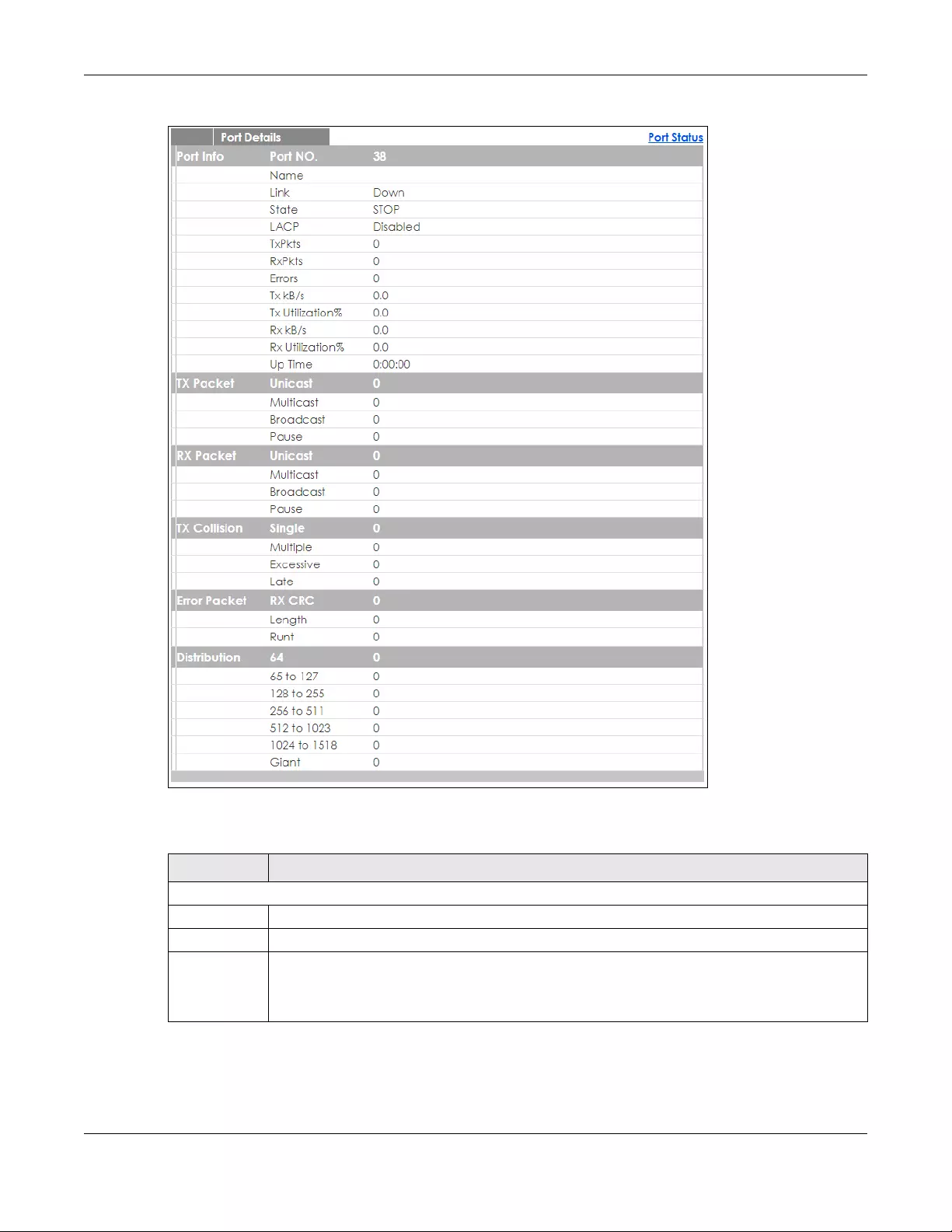
Chapter 50 Port Status
GS1920v2 Series User’s Guide
394
Figure 287 Port Status > Port Details
The following table describes the labels in this screen.
Table 196 Port Status: Port Details
LABEL DESCRIPTION
Port Info
Port NO. This field displays the port number you are viewing.
Name This field displays the name of the port.
Link This field displays the speed (either 10M for 10Mbps, 100M for 100Mbps, 1000M for 1000Mbps, or
10G for 10 Gbps) and the duplex (F for full duplex or H for half duplex). It also shows the cable type
(Copper or Fiber) for the combo ports. This field displays Down if the port is not connected to any
device.

Chapter 50 Port Status
GS1920v2 Series User’s Guide
395
State If STP (Spanning Tree Protocol) is enabled, this field displays the STP state of the port. SeeSection
13.1 on page 135 for more information.
If STP is disabled, this field displays FORWARDING if the link is up, otherwise, it displays STOP.
When LACP (Link Aggregation Control Protocol), STP, and dot1x are in blocking state, it displays
Blocking.
LACP This field shows if LACP is enabled on this port or not.
TxPkts This field shows the number of transmitted frames on this port
RxPkts This field shows the number of received frames on this port
Errors This field shows the number of received errors on this port.
Tx KB/s This field shows the number of kilobytes per second transmitted on this port.
Tx
Utilization% This field shows the percentage of actual transmitted frames on this port as a percentage of the
Link speed.
Rx KB/s This field shows the number of kilobytes per second received on this port.
Rx
Utilization% This field shows the percentage of actual received frames on this port as a percentage of the Link
speed.
Up Time This field shows the total amount of time the connection has been up.
Tx Packet
The following fields display detailed information about packets transmitted.
Unicast This field shows the number of good unicast packets transmitted.
Multicast This field shows the number of good multicast packets transmitted.
Broadcast This field shows the number of good broadcast packets transmitted.
Pause This field shows the number of 802.3x Pause packets transmitted.
Rx Packet
The following fields display detailed information about packets received.
Unicast This field shows the number of good unicast packets received.
Multicast This field shows the number of good multicast packets received.
Broadcast This field shows the number of good broadcast packets received.
Pause This field shows the number of 802.3x Pause packets received.
TX Collision
The following fields display information on collisions while transmitting.
Single This is a count of successfully transmitted packets for which transmission is inhibited by exactly one
collision.
Multiple This is a count of successfully transmitted packets for which transmission was inhibited by more
than one collision.
Excessive This is a count of packets for which transmission failed due to excessive collisions. Excessive
collision is defined as the number of maximum collisions before the retransmission count is reset.
Late This is the number of times a late collision is detected, that is, after 512 bits of the packets have
already been transmitted.
Error Packet The following fields display detailed information about packets received that were in error.
RX CRC This field shows the number of packets received with CRC (Cyclic Redundant Check) error(s).
Length This field shows the number of packets received with a length that was out of range.
Runt This field shows the number of packets received that were too short (shorter than 64 octets),
including the ones with CRC errors.
Table 196 Port Status: Port Details (continued)
LABEL DESCRIPTION
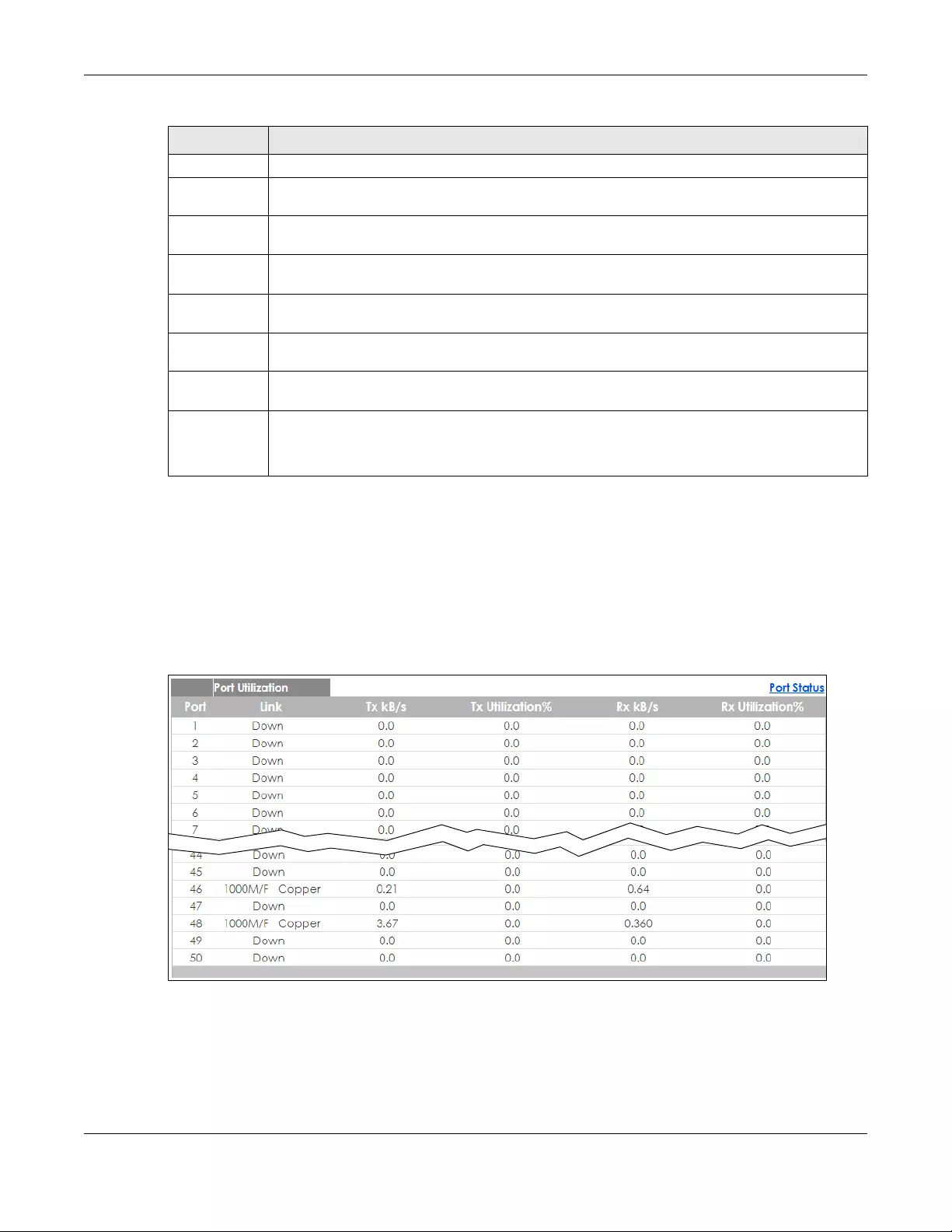
Chapter 50 Port Status
GS1920v2 Series User’s Guide
396
50.2.2 Port Utilization
This screen displays the percentage of actual transmitted or received frames on a port as a percentage
of the Link speed. To view port utilization, click Management > Port Status > Port Utilization to see the
following screen. Alternatively, click Status from any Web Configurator screen and then the Port Status
link in the Quick Links section of the Status screen to display the Port Status screen and then click the
Utilization link tab.
Figure 288 Management > Port Status > Utilization
Distribution
64 This field shows the number of packets (including bad packets) received that were 64 octets in
length.
65-127 This field shows the number of packets (including bad packets) received that were between 65
and 127 octets in length.
128-255 This field shows the number of packets (including bad packets) received that were between 128
and 255 octets in length.
256-511 This field shows the number of packets (including bad packets) received that were between 256
and 511 octets in length.
512-1023 This field shows the number of packets (including bad packets) received that were between 512
and 1023 octets in length.
1024-1518 This field shows the number of packets (including bad packets) received that were between 1024
and 1518 octets in length.
Giant This field shows the number of packets (including bad packets) received that were between 1519
octets and the maximum frame size.
The maximum frame size varies depending on your switch model.
Table 196 Port Status: Port Details (continued)
LABEL DESCRIPTION

Chapter 50 Port Status
GS1920v2 Series User’s Guide
397
The following table describes the labels in this screen.
Table 197 Port Status: Utilization
LABEL DESCRIPTION
Port This identifies the Ethernet port.
Link This field displays the speed (either 10M for Mbps, 100M for 100 Mbps, 1000M for 1000 Mbps, or 10G
for 10 Gbps) and the duplex (F for full duplex). It also shows the cable type (Copper or Fiber) for
the combo ports. This field displays Down if the port is not connected to any device.
Tx kB/s This field shows the transmission speed of data sent on this port in kilobytes per second.
Tx Utilization% This field shows the percentage of actual transmitted frames on this port as a percentage of the
Link speed.
Rx KB/s This field shows the transmission speed of data received on this port in kilobytes per second.
Rx Utilization% This field shows the percentage of actual received frames on this port as a percentage of the Link
speed.

GS1920v2 Series User’s Guide
398
CHAPTER 51
Troubleshooting
This chapter offers some suggestions to solve problems you might encounter. The potential problems are
divided into the following categories.
•Power, Hardware Connections, and LEDs
•Switch Access and Login
•Switch Configuration
51.1 Power, Hardware Connections, and LEDs
The Switch does not turn on. None of the LEDs turn on.
1Make sure you are using the power adaptor or cord included with the Switch.
2Make sure the power adaptor or cord is connected to the Switch and plugged in to an appropriate
power source. Make sure the power source is turned on.
3Disconnect and re-connect the power adaptor or cord to the Switch.
4If the problem continues, contact the vendor.
One of the LEDs does not behave as expected.
1Make sure you understand the normal behavior of the LED. See Section 3.3 on page 40.
2Check the hardware connections. See Section 51.1 on page 398.
3Inspect your cables for damage. Contact the vendor to replace any damaged cables.
4Disconnect and re-connect the power adaptor or cord to the Switch.
5If the problem continues, contact the vendor.

Chapter 51 Troubleshooting
GS1920v2 Series User’s Guide
399
51.2 Switch Access and Login
I forgot the IP address for the Switch.
1The default IP address is 192.168.1.1.
2If the Switch is removed from a site in Nebula, all the settings in the configuration file are reset to the
Nebula factory defaults except for the IP address. If you changed the default dynamic IP address to a
static IP address while the Switch was in a site in Nebula, the Switch will retain that static IP address after
you remove it from the site in Nebula.
3Use the NCC, the ZON utility, or the console port to find the IP address. The Switch must be registered
and added to a site in Nebula in order for it to be managed using Nebula.
4If this does not work, you have to reset the device to its factory defaults. See Section 4.6 on page 54.
I forgot the username and/or password.
1The default username is admin and the default password is 1234.
2If this does not work, you have to reset the device to its factory defaults. See Section 4.6 on page 54.
I cannot see or access the Login screen in the web configurator.
1Make sure you are using the correct IP address.
• The default IP address is 192.168.1.1.
• If you changed the IP address, use the new IP address.
• If you changed the IP address and have forgotten it, see the troubleshooting suggestions for I
forgot the IP address for the Switch.
2Check the hardware connections, and make sure the LEDs are behaving as expected. See Section 3.3
on page 40.
3Make sure your Internet browser does not block pop-up windows and has JavaScripts and Java
enabled.
4Make sure your computer is in the same subnet as the Switch. (If you know that there are routers
between your computer and the Switch, skip this step.)
5Reset the device to its factory defaults, and try to access the Switch with the default IP address. See
Section 4.6 on page 54.
6If the problem continues, contact the vendor, or try one of the advanced suggestions.

Chapter 51 Troubleshooting
GS1920v2 Series User’s Guide
400
Advanced Suggestions
• Try to access the Switch using another service, such as Telnet. If you can access the Switch, check the
remote management settings to find out why the Switch does not respond to HTTP.
I can see the Login screen, but I cannot log in to the Switch.
1Make sure you have entered the user name and password correctly. The default user name is admin,
and the default password is 1234. These fields are case-sensitive, so make sure [Caps Lock] is not on.
2You may have exceeded the maximum number of concurrent Telnet sessions. Close other Telnet
session(s) or try connecting again later.
Check that you have enabled logins for HTTP or Telnet. If you have configured a secured client IP
address, your computer’s IP address must match it. Refer to the chapter on access control for details.
3Disconnect and re-connect the cord to the Switch.
4If this does not work, you have to reset the device to its factory defaults. See Section 4.6 on page 54.
Pop-up Windows, JavaScripts and Java Permissions
In order to use the web configurator you need to allow:
• Web browser pop-up windows from your device.
• JavaScripts (enabled by default).
• Java permissions (enabled by default).
I cannot see some of Advanced Application submenus at the bottom of the navigation panel.
The recommended screen resolution is 1024 by 768 pixels. Adjust the value in your computer and then
you should see the rest of Advanced Application submenus at the bottom of the navigation panel.
There is unauthorized access to my Switch via telnet, HTTP and SSH.
Click the Display button in the System Log field in the Management > Diagnostic screen to check for
unauthorized access to your Switch. To avoid unauthorized access, configure the secured client setting
in the Management > Access Control > Remote Management screen for telnet, HTTP and SSH (see
Section 40.6 on page 356). Computers not belonging to the secured client set cannot get permission to
access the Switch.

Chapter 51 Troubleshooting
GS1920v2 Series User’s Guide
401
51.3 Switch Configuration
I lost my configuration settings after I restarted the Switch.
Make sure you save your configuration into the Switch’s
nonvolatile memory each time you make changes.
Click Save at the top right corner of the web configurator to save the configuration permanently. See
also Section 39.2.2 on page 341 for more information about how to save your configuration.
I accidentally unplugged the Switch. I’m not sure which configuration file will be loaded.
If you plug the power cable back to the Switch, it’ll reboot and load the configuration file that was used
the last time. For example, if Config 1 was used on the Switch before you accidentally unplugged the
Switch, Config 1 will be loaded when rebooting.

GS1920v2 Series User’s Guide
402
APPENDIX A
Customer Support
In the event of problems that cannot be solved by using this manual, you should contact your vendor. If
you cannot contact your vendor, then contact a Zyxel office for the region in which you bought the
device.
See http://www.zyxel.com/homepage.shtml and also
http://www.zyxel.com/about_zyxel/zyxel_worldwide.shtml for the latest information.
Please have the following information ready when you contact an office.
Required Information
• Product model and serial number.
• Warranty Information.
• Date that you received your device.
• Brief description of the problem and the steps you took to solve it.
Corporate Headquarters (Worldwide)
Taiwan
• Zyxel Communications Corporation
• http://www.zyxel.com
Asia
China
• Zyxel Communications (Shanghai) Corp.
Zyxel Communications (Beijing) Corp.
Zyxel Communications (Tianjin) Corp.
• http://www.zyxel.cn
India
•Zyxel Technology India Pvt Ltd
• http://www.zyxel.in
Kazakhstan
•Zyxel Kazakhstan
• http://www.zyxel.kz

Appendix A Customer Support
GS1920v2 Series User’s Guide
403
Korea
• Zyxel Korea Corp.
• http://www.zyxel.kr
Malaysia
• Zyxel Malaysia Sdn Bhd.
• http://www.zyxel.com.my
Pakistan
• Zyxel Pakistan (Pvt.) Ltd.
• http://www.zyxel.com.pk
Philippines
• Zyxel Philippines
• http://www.zyxel.com.ph
Singapore
• Zyxel Singapore Pte Ltd.
• http://www.zyxel.com.sg
Taiwan
• Zyxel Communications Corporation
• http://www.zyxel.com/tw/zh/
Thailand
• Zyxel Thailand Co., Ltd
• http://www.zyxel.co.th
Vietnam
• Zyxel Communications Corporation-Vietnam Office
• http://www.zyxel.com/vn/vi
Europe
Austria
•Zyxel Deutschland GmbH
• http://www.zyxel.de
Belarus
•Zyxel BY
• http://www.zyxel.by

Appendix A Customer Support
GS1920v2 Series User’s Guide
404
Belgium
• Zyxel Communications B.V.
• http://www.zyxel.com/be/nl/
• http://www.zyxel.com/be/fr/
Bulgaria
•Zyxel България
• http://www.zyxel.com/bg/bg/
Czech Republic
• Zyxel Communications Czech s.r.o
• http://www.zyxel.cz
Denmark
• Zyxel Communications A/S
• http://www.zyxel.dk
Estonia
• Zyxel Estonia
• http://www.zyxel.com/ee/et/
Finland
• Zyxel Communications
• http://www.zyxel.fi
France
•Zyxel France
• http://www.zyxel.fr
Germany
•Zyxel Deutschland GmbH
• http://www.zyxel.de
Hungary
• Zyxel Hungary & SEE
• http://www.zyxel.hu
Italy
• Zyxel Communications Italy
• http://www.zyxel.it/

Appendix A Customer Support
GS1920v2 Series User’s Guide
405
Latvia
•Zyxel Latvia
• http://www.zyxel.com/lv/lv/homepage.shtml
Lithuania
•Zyxel Lithuania
• http://www.zyxel.com/lt/lt/homepage.shtml
Netherlands
• Zyxel Benelux
• http://www.zyxel.nl
Norway
• Zyxel Communications
• http://www.zyxel.no
Poland
• Zyxel Communications Poland
• http://www.zyxel.pl
Romania
• Zyxel Romania
• http://www.zyxel.com/ro/ro
Russia
• Zyxel Russia
• http://www.zyxel.ru
Slovakia
• Zyxel Communications Czech s.r.o. organizacna zlozka
• http://www.zyxel.sk
Spain
• Zyxel Communications ES Ltd
• http://www.zyxel.es
Sweden
• Zyxel Communications
• http://www.zyxel.se
Switzerland
•Studerus AG

Appendix A Customer Support
GS1920v2 Series User’s Guide
406
• http://www.zyxel.ch/
Turkey
• Zyxel Turkey A.S.
• http://www.zyxel.com.tr
UK
• Zyxel Communications UK Ltd.
• http://www.zyxel.co.uk
Ukraine
•Zyxel Ukraine
• http://www.ua.zyxel.com
Latin America
Argentina
• Zyxel Communication Corporation
• http://www.zyxel.com/ec/es/
Brazil
• Zyxel Communications Brasil Ltda.
• https://www.zyxel.com/br/pt/
Ecuador
• Zyxel Communication Corporation
• http://www.zyxel.com/ec/es/
Middle East
Israel
• Zyxel Communication Corporation
• http://il.zyxel.com/homepage.shtml
Middle East
• Zyxel Communication Corporation
• http://www.zyxel.com/me/en/

Appendix A Customer Support
GS1920v2 Series User’s Guide
407
North America
USA
• Zyxel Communications, Inc. - North America Headquarters
• http://www.zyxel.com/us/en/
Oceania
Australia
• Zyxel Communications Corporation
• http://www.zyxel.com/au/en/
Africa
South Africa
• Nology (Pty) Ltd.
• http://www.zyxel.co.za

GS1920v2 Series User’s Guide
408
APPENDIX B
Common Services
The following table lists some commonly-used services and their associated protocols and port numbers.
For a comprehensive list of port numbers, ICMP type/code numbers and services, visit the IANA (Internet
Assigned Number Authority) web site.
•Name: This is a short, descriptive name for the service. You can use this one or create a different one,
if you like.
•Protocol: This is the type of IP protocol used by the service. If this is TCP/UDP, then the service uses the
same port number with TCP and UDP. If this is User-Defined, the Port(s) is the IP protocol number, not
the port number.
•Port(s): This value depends on the Protocol. Please refer to RFC 1700 for further information about port
numbers.
•If the Protocol is TCP, UDP, or TCP/UDP, this is the IP port number.
•If the Protocol is USER, this is the IP protocol number.
•Description: This is a brief explanation of the applications that use this service or the situations in which
this service is used.
Table 198 Commonly Used Services
NAME PROTOCOL PORT(S) DESCRIPTION
AH (IPSEC_TUNNEL) User-Defined 51 The IPSEC AH (Authentication Header) tunneling
protocol uses this service.
AIM/New-ICQ TCP 5190 AOL’s Internet Messenger service. It is also used
as a listening port by ICQ.
AUTH TCP 113 Authentication protocol used by some servers.
BGP TCP 179 Border Gateway Protocol.
BOOTP_CLIENT UDP 68 DHCP Client.
BOOTP_SERVER UDP 67 DHCP Server.
CU-SEEME TCP
UDP
7648
24032
A popular videoconferencing solution from
White Pines Software.
DNS TCP/UDP 53 Domain Name Server, a service that matches
web names (for example www.zyxel.com) to IP
numbers.
ESP (IPSEC_TUNNEL) User-Defined 50 The IPSEC ESP (Encapsulation Security Protocol)
tunneling protocol uses this service.
FINGER TCP 79 Finger is a UNIX or Internet related command
that can be used to find out if a user is logged
on.
FTP TCP
TCP
20
21
File Transfer Program, a program to enable fast
transfer of files, including large files that may not
be possible by e-mail.
H.323 TCP 1720 NetMeeting uses this protocol.
HTTP TCP 80 Hyper Text Transfer Protocol - a client/server
protocol for the world wide web.

Appendix B Common Services
GS1920v2 Series User’s Guide
409
HTTPS TCP 443 HTTPS is a secured http session often used in e-
commerce.
ICMP User-Defined 1Internet Control Message Protocol is often used
for diagnostic or routing purposes.
ICQ UDP 4000 This is a popular Internet chat program.
IGMP (MULTICAST) User-Defined 2Internet Group Multicast Protocol is used when
sending packets to a specific group of hosts.
IKE UDP 500 The Internet Key Exchange algorithm is used for
key distribution and management.
IRC TCP/UDP 6667 This is another popular Internet chat program.
MSN Messenger TCP 1863 Microsoft Networks’ messenger service uses this
protocol.
NEW-ICQ TCP 5190 An Internet chat program.
NEWS TCP 144 A protocol for news groups.
NFS UDP 2049 Network File System - NFS is a client/server
distributed file service that provides transparent
file sharing for network environments.
NNTP TCP 119 Network News Transport Protocol is the delivery
mechanism for the USENET newsgroup service.
PING User-Defined 1Packet INternet Groper is a protocol that sends
out ICMP echo requests to test whether or not a
remote host is reachable.
POP3 TCP 110 Post Office Protocol version 3 lets a client
computer get e-mail from a POP3 server through
a temporary connection (TCP/IP or other).
PPTP TCP 1723 Point-to-Point Tunneling Protocol enables secure
transfer of data over public networks. This is the
control channel.
PPTP_TUNNEL (GRE) User-Defined 47 PPTP (Point-to-Point Tunneling Protocol) enables
secure transfer of data over public networks. This
is the data channel.
RCMD TCP 512 Remote Command Service.
REAL_AUDIO TCP 7070 A streaming audio service that enables real time
sound over the web.
REXEC TCP 514 Remote Execution Daemon.
RLOGIN TCP 513 Remote Login.
RTELNET TCP 107 Remote Telnet.
RTSP TCP/UDP 554 The Real Time Streaming (media control)
Protocol (RTSP) is a remote control for multimedia
on the Internet.
SFTP TCP 115 Simple File Transfer Protocol.
SMTP TCP 25 Simple Mail Transfer Protocol is the message-
exchange standard for the Internet. SMTP
enables you to move messages from one e-mail
server to another.
SNMP TCP/UDP 161 Simple Network Management Program.
SNMP-TRAPS TCP/UDP 162 Traps for use with the SNMP (RFC:1215).
Table 198 Commonly Used Services (continued)
NAME PROTOCOL PORT(S) DESCRIPTION

Appendix B Common Services
GS1920v2 Series User’s Guide
410
SQL-NET TCP 1521 Structured Query Language is an interface to
access data on many different types of
database systems, including mainframes,
midrange systems, UNIX systems and network
servers.
SSH TCP/UDP 22 Secure Shell Remote Login Program.
STRM WORKS UDP 1558 Stream Works Protocol.
SYSLOG UDP 514 Syslog allows you to send system logs to a UNIX
server.
TACACS UDP 49 Login Host Protocol used for (Terminal Access
Controller Access Control System).
TELNET TCP 23 Telnet is the login and terminal emulation
protocol common on the Internet and in UNIX
environments. It operates over TCP/IP networks.
Its primary function is to allow users to log into
remote host systems.
TFTP UDP 69 Trivial File Transfer Protocol is an Internet file
transfer protocol similar to FTP, but uses the UDP
(User Datagram Protocol) rather than TCP
(Transmission Control Protocol).
VDOLIVE TCP 7000 Another videoconferencing solution.
Table 198 Commonly Used Services (continued)
NAME PROTOCOL PORT(S) DESCRIPTION

GS1920v2 Series User’s Guide
411
APPENDIX C
IPv6
Overview
IPv6 (Internet Protocol version 6), is designed to enhance IP address size and features. The increase in
IPv6 address size to 128 bits (from the 32-bit IPv4 address) allows up to 3.4 x 1038 IP addresses.
IPv6 Addressing
The 128-bit IPv6 address is written as eight 16-bit hexadecimal blocks separated by colons (:). This is an
example IPv6 address 2001:0db8:1a2b:0015:0000:0000:1a2f:0000.
IPv6 addresses can be abbreviated in two ways:
• Leading zeros in a block can be omitted. So 2001:0db8:1a2b:0015:0000:0000:1a2f:0000 can be
written as 2001:db8:1a2b:15:0:0:1a2f:0.
• Any number of consecutive blocks of zeros can be replaced by a double colon. A double colon can
only appear once in an IPv6 address. So 2001:0db8:0000:0000:1a2f:0000:0000:0015 can be
written as 2001:0db8::1a2f:0000:0000:0015, 2001:0db8:0000:0000:1a2f::0015,
2001:db8::1a2f:0:0:15 or 2001:db8:0:0:1a2f::15.
Prefix and Prefix Length
Similar to an IPv4 subnet mask, IPv6 uses an address prefix to represent the network address. An IPv6
prefix length specifies how many most significant bits (start from the left) in the address compose the
network address. The prefix length is written as “/x” where x is a number. For example,
2001:db8:1a2b:15::1a2f:0/32
means that the first 32 bits (2001:db8) is the subnet prefix.
Link-local Address
A link-local address uniquely identifies a device on the local network (the LAN). It is similar to a “private IP
address” in IPv4. You can have the same link-local address on multiple interfaces on a device. A link-
local unicast address has a predefined prefix of fe80::/10. The link-local unicast address format is as
follows.
Table 199 Link-local Unicast Address Format
Global Address
A global address uniquely identifies a device on the Internet. It is similar to a “public IP address” in IPv4. A
global unicast address starts with a 2 or 3.
1111 1110 10 0 Interface ID
10 bits 54 bits 64 bits

Appendix C IPv6
GS1920v2 Series User’s Guide
412
Unspecified Address
An unspecified address (0:0:0:0:0:0:0:0 or ::) is used as the source address when a device does not have
its own address. It is similar to “0.0.0.0” in IPv4.
Loopback Address
A loopback address (0:0:0:0:0:0:0:1 or ::1) allows a host to send packets to itself. It is similar to “127.0.0.1”
in IPv4.
Multicast Address
In IPv6, multicast addresses provide the same functionality as IPv4 broadcast addresses. Broadcasting is
not supported in IPv6. A multicast address allows a host to send packets to all hosts in a multicast group.
Multicast scope allows you to determine the size of the multicast group. A multicast address has a
predefined prefix of ff00::/8. The following table describes some of the predefined multicast addresses.
The following table describes the multicast addresses which are reserved and can not be assigned to a
multicast group.
Table 200 Predefined Multicast Address
MULTICAST ADDRESS DESCRIPTION
FF01:0:0:0:0:0:0:1 All hosts on a local node.
FF01:0:0:0:0:0:0:2 All routers on a local node.
FF02:0:0:0:0:0:0:1 All hosts on a local connected link.
FF02:0:0:0:0:0:0:2 All routers on a local connected link.
FF05:0:0:0:0:0:0:2 All routers on a local site.
FF05:0:0:0:0:0:1:3 All DHCP severs on a local site.
Table 201 Reserved Multicast Address
MULTICAST ADDRESS
FF00:0:0:0:0:0:0:0
FF01:0:0:0:0:0:0:0
FF02:0:0:0:0:0:0:0
FF03:0:0:0:0:0:0:0
FF04:0:0:0:0:0:0:0
FF05:0:0:0:0:0:0:0
FF06:0:0:0:0:0:0:0
FF07:0:0:0:0:0:0:0
FF08:0:0:0:0:0:0:0
FF09:0:0:0:0:0:0:0
FF0A:0:0:0:0:0:0:0
FF0B:0:0:0:0:0:0:0
FF0C:0:0:0:0:0:0:0
FF0D:0:0:0:0:0:0:0
FF0E:0:0:0:0:0:0:0
FF0F:0:0:0:0:0:0:0

Appendix C IPv6
GS1920v2 Series User’s Guide
413
Subnet Masking
Both an IPv6 address and IPv6 subnet mask compose of 128-bit binary digits, which are divided into
eight 16-bit blocks and written in hexadecimal notation. Hexadecimal uses four bits for each character
(1 ~ 10, A ~ F). Each block’s 16 bits are then represented by four hexadecimal characters. For example,
FFFF:FFFF:FFFF:FFFF:FC00:0000:0000:0000.
Interface ID
In IPv6, an interface ID is a 64-bit identifier. It identifies a physical interface (for example, an Ethernet
port) or a virtual interface (for example, the management IP address for a VLAN). One interface should
have a unique interface ID.
EUI-64
The EUI-64 (Extended Unique Identifier) defined by the IEEE (Institute of Electrical and Electronics
Engineers) is an interface ID format designed to adapt with IPv6. It is derived from the 48-bit (6-byte)
Ethernet MAC address as shown next. EUI-64 inserts the hex digits fffe between the third and fourth bytes
of the MAC address and complements the seventh bit of the first byte of the MAC address. See the
following example.
Stateless Autoconfiguration
With stateless autoconfiguration in IPv6, addresses can be uniquely and automatically generated.
Unlike DHCPv6 (Dynamic Host Configuration Protocol version six) which is used in IPv6 stateful
autoconfiguration, the owner and status of addresses don’t need to be maintained by a DHCP server.
Every IPv6 device is able to generate its own and unique IP address automatically when IPv6 is initiated
on its interface. It combines the prefix and the interface ID (generated from its own Ethernet MAC
address, see Interface ID and EUI-64) to form a complete IPv6 address.
When IPv6 is enabled on a device, its interface automatically generates a link-local address (beginning
with fe80).
When the interface is connected to a network with a router and the Switch is set to automatically obtain
an IPv6 network prefix from the router for the interface, it generates 3another address which combines
its interface ID and global and subnet information advertised from the router. This is a routable global IP
address.
DHCPv6
The Dynamic Host Configuration Protocol for IPv6 (DHCPv6, RFC 3315) is a server-client protocol that
allows a DHCP server to assign and pass IPv6 network addresses, prefixes and other configuration
information to DHCP clients. DHCPv6 servers and clients exchange DHCP messages using UDP.
Table 202
MAC 00 : 13 : 49 : 12 : 34 : 56
Table 203
EUI-64 02: 13 : 49 : FF : FE : 12 : 34 : 56
3. In IPv6, all network interfaces can be associated with several addresses.

Appendix C IPv6
GS1920v2 Series User’s Guide
414
Each DHCP client and server has a unique DHCP Unique IDentifier (DUID), which is used for identification
when they are exchanging DHCPv6 messages. The DUID is generated from the MAC address, time,
vendor assigned ID and/or the vendor's private enterprise number registered with the IANA. It should not
change over time even after you reboot the device.
Identity Association
An Identity Association (IA) is a collection of addresses assigned to a DHCP client, through which the
server and client can manage a set of related IP addresses. Each IA must be associated with exactly
one interface. The DHCP client uses the IA assigned to an interface to obtain configuration from a DHCP
server for that interface. Each IA consists of a unique IAID and associated IP information.
The IA type is the type of address in the IA. Each IA holds one type of address. IA_NA means an identity
association for non-temporary addresses and IA_TA is an identity association for temporary addresses.
An IA_NA option contains the T1 and T2 fields, but an IA_TA option does not. The DHCPv6 server uses T1
and T2 to control the time at which the client contacts with the server to extend the lifetimes on any
addresses in the IA_NA before the lifetimes expire. After T1, the client sends the server (S1) (from which
the addresses in the IA_NA were obtained) a Renew message. If the time T2 is reached and the server
does not respond, the client sends a Rebind message to any available server (S2). For an IA_TA, the
client may send a Renew or Rebind message at the client's discretion.
DHCP Relay Agent
A DHCP relay agent is on the same network as the DHCP clients and helps forward messages between
the DHCP server and clients. When a client cannot use its link-local address and a well-known multicast
address to locate a DHCP server on its network, it then needs a DHCP relay agent to send a message to
a DHCP server that is not attached to the same network.
The DHCP relay agent can add the remote identification (remote-ID) option and the interface-ID option
to the Relay-Forward DHCPv6 messages. The remote-ID option carries a user-defined string, such as the
system name. The interface-ID option provides slot number, port information and the VLAN ID to the
DHCPv6 server. The remote-ID option (if any) is stripped from the Relay-Reply messages before the relay
agent sends the packets to the clients. The DHCP server copies the interface-ID option from the Relay-
Forward message into the Relay-Reply message and sends it to the relay agent. The interface-ID should
not change even after the relay agent restarts.
Prefix Delegation
Prefix delegation enables an IPv6 router to use the IPv6 prefix (network address) received from the ISP (or
a connected uplink router) for its LAN. The Switch uses the received IPv6 prefix (for example, 2001:db2::/
48) to generate its LAN IP address. Through sending Router Advertisements (RAs) regularly by multicast,
the Switch passes the IPv6 prefix information to its LAN hosts. The hosts then can use the prefix to
generate their IPv6 addresses.
T1
T2
Renew Rebind
Rebind
to S1
Renew
to S1
Renew
to S1
Renew
to S1
Renew
to S1
Renew
to S1
to S2
to S2

Appendix C IPv6
GS1920v2 Series User’s Guide
415
ICMPv6
Internet Control Message Protocol for IPv6 (ICMPv6 or ICMP for IPv6) is defined in RFC 4443. ICMPv6 has
a preceding Next Header value of 58, which is different from the value used to identify ICMP for IPv4.
ICMPv6 is an integral part of IPv6. IPv6 nodes use ICMPv6 to report errors encountered in packet
processing and perform other diagnostic functions, such as "ping".
Neighbor Discovery Protocol (NDP)
The Neighbor Discovery Protocol (NDP) is a protocol used to discover other IPv6 devices and track
neighbor’s reachability in a network. An IPv6 device uses the following ICMPv6 messages types:
• Neighbor solicitation: A request from a host to determine a neighbor’s link-layer address (MAC
address) and detect if the neighbor is still reachable. A neighbor being “reachable” means it
responds to a neighbor solicitation message (from the host) with a neighbor advertisement message.
• Neighbor advertisement: A response from a node to announce its link-layer address.
• Router solicitation: A request from a host to locate a router that can act as the default router and
forward packets.
• Router advertisement: A response to a router solicitation or a periodical multicast advertisement from
a router to advertise its presence and other parameters.
IPv6 Cache
An IPv6 host is required to have a neighbor cache, destination cache, prefix list and default router list.
The Switch maintains and updates its IPv6 caches constantly using the information from response
messages. In IPv6, the Switch configures a link-local address automatically, and then sends a neighbor
solicitation message to check if the address is unique. If there is an address to be resolved or verified, the
Switch also sends out a neighbor solicitation message. When the Switch receives a neighbor
advertisement in response, it stores the neighbor’s link-layer address in the neighbor cache. When the
Switch uses a router solicitation message to query for a router and receives a router advertisement
message, it adds the router’s information to the neighbor cache, prefix list and destination cache. The
Switch creates an entry in the default router list cache if the router can be used as a default router.
When the Switch needs to send a packet, it first consults the destination cache to determine the next
hop. If there is no matching entry in the destination cache, the Switch uses the prefix list to determine
whether the destination address is on-link and can be reached directly without passing through a router.
If the address is onlink, the address is considered as the next hop. Otherwise, the Switch determines the
next-hop from the default router list or routing table. Once the next hop IP address is known, the Switch
looks into the neighbor cache to get the link-layer address and sends the packet when the neighbor is
reachable. If the Switch cannot find an entry in the neighbor cache or the state for the neighbor is not
reachable, it starts the address resolution process. This helps reduce the number of IPv6 solicitation and
advertisement messages.

Appendix C IPv6
GS1920v2 Series User’s Guide
416
Example - Enabling IPv6 on Windows XP/2003/Vista
By default, Windows XP and Windows 2003 support IPv6. This example shows you how to use the ipv6
install command on Windows XP/2003 to enable IPv6. This also displays how to use the ipconfig
command to see auto-generated IP addresses.
IPv6 is installed and enabled by default in Windows Vista. Use the ipconfig command to check your
automatic configured IPv6 address as well. You should see at least one IPv6 address available for the
interface on your computer.
Example - Enabling DHCPv6 on Windows XP
Windows XP does not support DHCPv6. If your network uses DHCPv6 for IP address assignment, you have
to additionally install a DHCPv6 client software on your Windows XP. (Note: If you use static IP addresses
or Router Advertisement for IPv6 address assignment in your network, ignore this section.)
This example uses Dibbler as the DHCPv6 client. To enable DHCPv6 client on your computer:
1Install Dibbler and select the DHCPv6 client option on your computer.
2After the installation is complete, select Start > All Programs > Dibbler-DHCPv6 > Client Install as service.
3Select Start > Control Panel > Administrative Tools > Services.
4Double click Dibbler - a DHCPv6 client.
C:\>ipv6 install
Installing...
Succeeded.
C:\>ipconfig
Windows IP Configuration
Ethernet adapter Local Area Connection:
Connection-specific DNS Suffix . :
IP Address. . . . . . . . . . . . : 10.1.1.46
Subnet Mask . . . . . . . . . . . : 255.255.255.0
IP Address. . . . . . . . . . . . : fe80::2d0:59ff:feb8:103c%4
Default Gateway . . . . . . . . . : 10.1.1.254
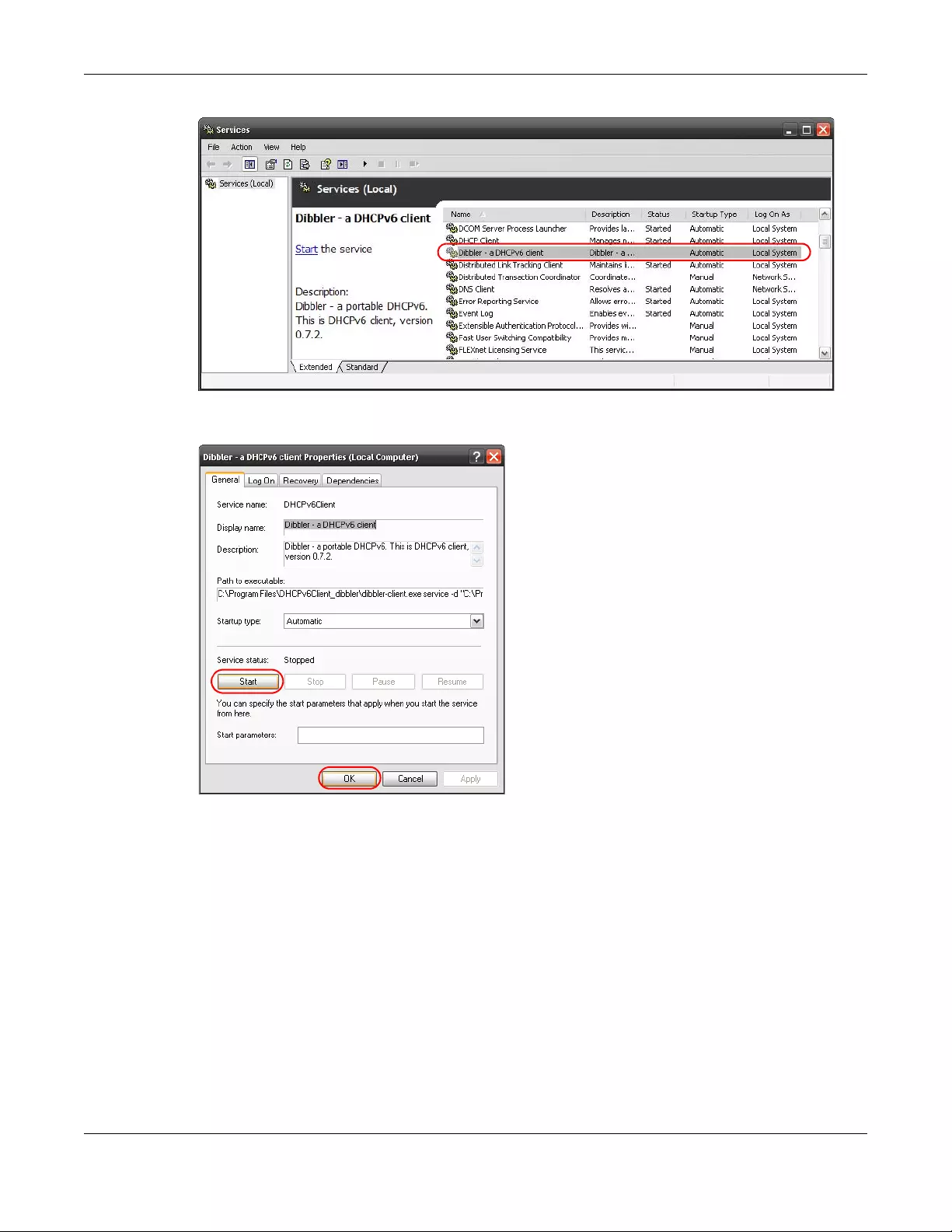
Appendix C IPv6
GS1920v2 Series User’s Guide
417
5Click Start and then OK.
6Now your computer can obtain an IPv6 address from a DHCPv6 server.
Example - Enabling IPv6 on Windows 7
Windows 7 supports IPv6 by default. DHCPv6 is also enabled when you enable IPv6 on a Windows 7
computer.
To enable IPv6 in Windows 7:
1Select Control Panel > Network and Sharing Center > Local Area Connection.
2Select the Internet Protocol Version 6 (TCP/IPv6) checkbox to enable it.
3Click OK to save the change.
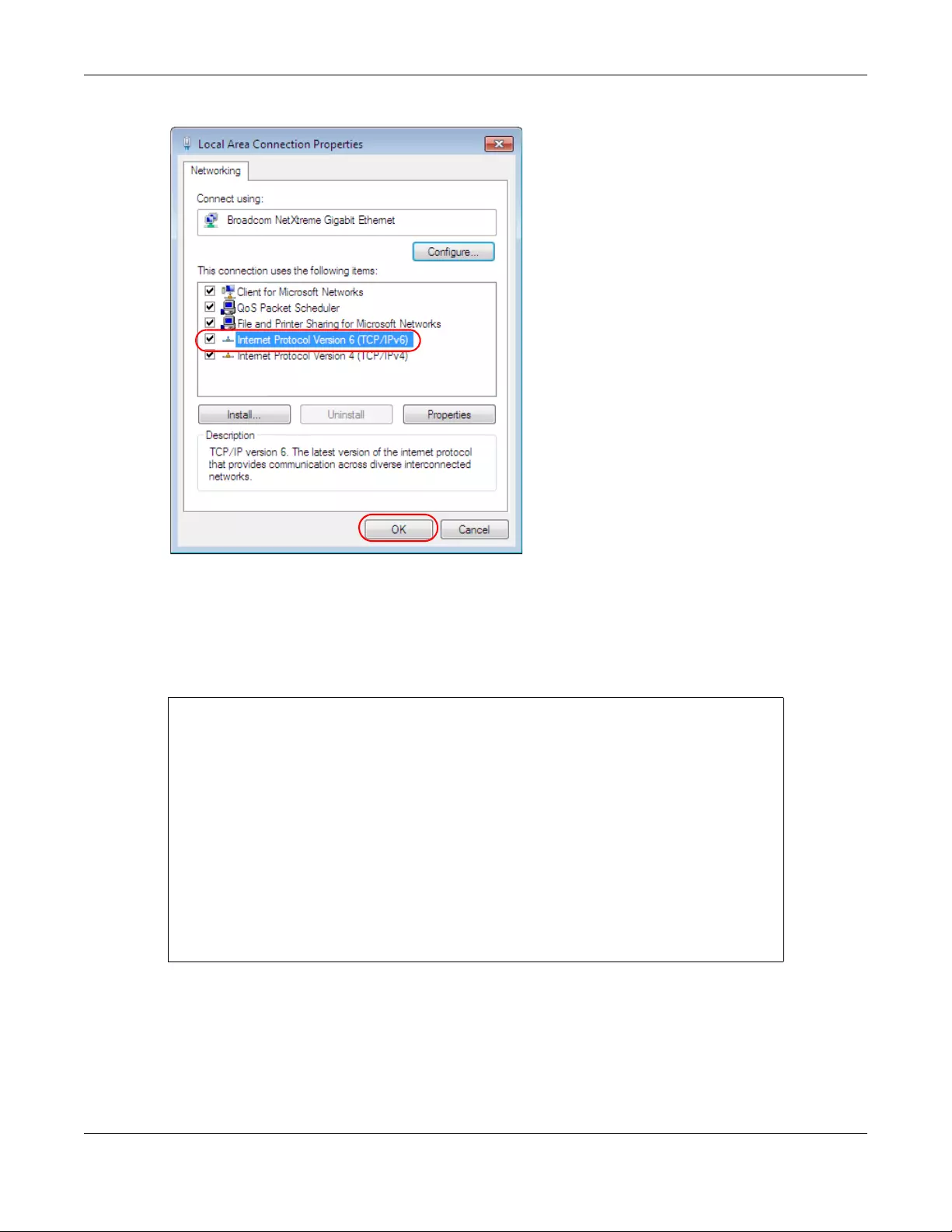
Appendix C IPv6
GS1920v2 Series User’s Guide
418
4Click Close to exit the Local Area Connection Status screen.
5Select Start > All Programs > Accessories > Command Prompt.
6Use the ipconfig command to check your dynamic IPv6 address. This example shows a global address
(2001:b021:2d::1000) obtained from a DHCP server.
C:\>ipconfig
Windows IP Configuration
Ethernet adapter Local Area Connection:
Connection-specific DNS Suffix . :
IPv6 Address. . . . . . . . . . . : 2001:b021:2d::1000
Link-local IPv6 Address . . . . . : fe80::25d8:dcab:c80a:5189%11
IPv4 Address. . . . . . . . . . . : 172.16.100.61
Subnet Mask . . . . . . . . . . . : 255.255.255.0
Default Gateway . . . . . . . . . : fe80::213:49ff:feaa:7125%11
172.16.100.254

GS1920v2 Series User’s Guide
419
APPENDIX D
Legal Information
Copyright
Copyright © 2018 by Zyxel Communications Corporation.
The contents of this publication may not be reproduced in any part or as a whole, transcribed, stored in a retrieval system, translated into any
language, or transmitted in any form or by any means, electronic, mechanical, magnetic, optical, chemical, photocopying, manual, or
otherwise, without the prior written permission of Zyxel Communications Corporation.
Published by Zyxel Communications Corporation. All rights reserved.
Disclaimer
Zyxel does not assume any liability arising out of the application or use of any products, or software described herein. Neither does it convey any
license under its patent rights nor the patent rights of others. Zyxel further reserves the right to make changes in any products described herein
without notice. This publication is subject to change without notice.
Regulatory Notice and Statement
United States of America
The following information applies if you use the product within USA area.
Federal Communications Commission (FCC) EMC Statement
• This device complies with Part 15 of FCC rules. Operation is subject to the following two conditions:
(1) This device may not cause harmful interference.
(2) This device must accept any interference received, including interference that may cause undesired operations.
• Changes or modifications not expressly approved by the party responsible for compliance could void the user’s authority to operate the
equipment.
• This equipment has been tested and found to comply with the limits for a Class A digital device, pursuant to part 15 of the FCC Rules. These
limits are designed to provide reasonable protection against harmful interference when the equipment is operated in a commercial
environment. This equipment generates, uses, and can radiate radio frequency energy and, if not installed and used in accordance with the
instruction manual, may cause harmful interference to radio communications. Operation of this equipment in a residential area is likely to
cause harmful interference in which case the user will be required to correct the interference at his own expense.
Canada The following information applies if you use the product within Canada area.
Industry Canada ICES statement
CAN ICES-3 (A)/NMB-3(A)
European Union
The following information applies if you use the product within the European Union.
CE EMC statement
WARNING: This equipment is compliant with Class A of EN55032. In a residential environment this equipment may cause radio interference.

Appendix D Legal Information
GS1920v2 Series User’s Guide
420
List of National Codes
Safety Warnings
• This product is designed for indoor use only in a temperature-controlled (0–50° C) and humidity-controlled (90% maximum relative humidity,
non-condensing) environment.
• Do not use this product near water, for example, in a wet basement or near a swimming pool.
• Do not expose your device to dampness, dust or corrosive liquids.
• Do not store things on the device.
• Do not obstruct the device ventilation slots as insufficient airflow may harm your device. For example, do not place the device in an
enclosed space such as a box or on a very soft surface such as a bed or sofa.
• Do not install, use, or service this device during a thunderstorm. There is a remote risk of electric shock from lightning.
• Connect ONLY suitable accessories to the device.
• Do not open the device or unit. Opening or removing covers can expose you to dangerous high voltage points or other risks. Only qualified
service personnel should service or disassemble this device. Please contact your vendor for further information.
• Make sure to connect the cables to the correct ports.
• Place connecting cables carefully so that no one will step on them or stumble over them.
• Always disconnect all cables from this device before servicing or disassembling.
• Do not remove the plug and connect it to a power outlet by itself; always attach the plug to the power adaptor first before connecting it to
a power outlet.
• Do not allow anything to rest on the power adaptor or cord and do NOT place the product where anyone can walk on the power adaptor
or cord.
• Please use the provided or designated connection cables/power cables/ adaptors. Connect it to the right supply voltage (for example,
110V AC in North America or 230V AC in Europe). If the power adaptor or cord is damaged, it might cause electrocution. Remove it from the
device and the power source, repairing the power adapter or cord is prohibited. Contact your local vendor to order a new one.
• Do not use the device outside, and make sure all the connections are indoors. There is a remote risk of electric shock from lightning.
• Caution: Risk of explosion if battery is replaced by an incorrect type, dispose of used batteries according to the instruction. Dispose them at
the applicable collection point for the recycling of electrical and electronic device. For detailed information about recycling of this product,
please contact your local city office, your household waste disposal service or the store where you purchased the product.
• Use ONLY power wires of the appropriate wire gauge for your device. Connect it to a power supply of the correct voltage.
• Fuse Warning! Replace a fuse only with a fuse of the same type and rating.
• The POE (Power over Ethernet) devices that supply or receive power and their connected Ethernet cables must all be completely indoors.
• The following warning statements apply, where the disconnect device is not incorporated in the device or where the plug on the power
supply cord is intended to serve as the disconnect device,
- For permanently connected devices, a readily accessible disconnect device shall be incorporated external to the device;
- For pluggable devices, the socket-outlet shall be installed near the device and shall be easily accessible.
• This device must be grounded. Never defeat the ground conductor or operate the device in the absence of a suitably installed ground
conductor. Contact the appropriate electrical inspection authority or an electrician if you are uncertain that suitable grounding is available.
• When connecting or disconnecting power to hot-pluggable power supplies, if offered with your system, observe the following guidelines:
- Install the power supply before connecting the power cable to the power supply.
- Unplug the power cable before removing the power supply.
- If the system has multiple sources of power, disconnect power from the system by unplugging all power cables from the power supply.
• CLASS 1 LASER PRODUCT
• APPAREIL À LASER DE CLASS 1
• PRODUCT COMPLIES WITH 21 CFR 1040.10 AND 1040.11.
• PRODUIT CONFORME SELON 21 CFR 1040.10 ET 1040.11.
COUNTRY ISO 3166 2 LETTER CODE COUNTRY ISO 3166 2 LETTER CODE
Austria AT Liechtenstein LI
Belgium BE Lithuania LT
Bulgaria BG Luxembourg LU
Croatia HR Malta MT
Cyprus CY Netherlands NL
Czech Republic CR Norway NO
Denmark DK Poland PL
Estonia EE Portugal PT
Finland FI Romania RO
France FR Serbia RS
Germany DE Slovakia SK
Greece GR Slovenia SI
Hungary HU Spain ES
Iceland IS Sweden SE
Ireland IE Switzerland CH
Italy IT Turkey TR
Latvia LV United Kingdom GB

Appendix D Legal Information
GS1920v2 Series User’s Guide
421
Environment Statement
European Union - Disposal and Recycling Information
The symbol below means that according to local regulations your product and/or its battery shall be disposed of separately from domestic
waste. If this product is end of life, take it to a recycling station designated by local authorities. At the time of disposal, the separate collection of
your product and/or its battery will help save natural resources and ensure that the environment is sustainable development.
Die folgende Symbol bedeutet, dass Ihr Produkt und/oder seine Batterie gemäß den örtlichen Bestimmungen getrennt vom Hausmüll entsorgt
werden muss. Wenden Sie sich an eine Recyclingstation, wenn dieses Produkt das Ende seiner Lebensdauer erreicht hat. Zum Zeitpunkt der
Entsorgung wird die getrennte Sammlung von Produkt und/oder seiner Batterie dazu beitragen, natürliche Ressourcen zu sparen und die Umwelt
und die menschliche Gesundheit zu schützen.
El símbolo de abajo indica que según las regulaciones locales, su producto y/o su batería deberán depositarse como basura separada de la
doméstica. Cuando este producto alcance el final de su vida útil, llévelo a un punto limpio. Cuando llegue el momento de desechar el
producto, la recogida por separado éste y/o su batería ayudará a salvar los recursos naturales y a proteger la salud humana y
medioambiental.
Le symbole ci-dessous signifie que selon les réglementations locales votre produit et/ou sa batterie doivent être éliminés séparément des ordures
ménagères. Lorsque ce produit atteint sa fin de vie, amenez-le à un centre de recyclage. Au moment de la mise au rebut, la collecte séparée
de votre produit et/ou de sa batterie aidera à économiser les ressources naturelles et protéger l'environnement et la santé humaine.
Il simbolo sotto significa che secondo i regolamenti locali il vostro prodotto e/o batteria deve essere smaltito separatamente dai rifiuti domestici.
Quando questo prodotto raggiunge la fine della vita di servizio portarlo a una stazione di riciclaggio. Al momento dello smaltimento, la raccolta
separata del vostro prodotto e/o della sua batteria aiuta a risparmiare risorse naturali e a proteggere l'ambiente e la salute umana.
Symbolen innebär att enligt lokal lagstiftning ska produkten och/eller dess batteri kastas separat från hushållsavfallet. När den här produkten når
slutet av sin livslängd ska du ta den till en återvinningsstation. Vid tiden för kasseringen bidrar du till en bättre miljö och mänsklig hälsa genom att
göra dig av med den på ett återvinningsställe.
台灣
警告使用者:
• 這是甲類的資訊產品,在居住的環境中使用時,可能會造成射頻干擾,在這種情況下,使用者會被要求採取某些適當的對策。」
安全警告 - 為了您的安全,請先閱讀以下警告及指示 :
• 請勿將此產品接近水、火焰或放置在高溫的環境。
• 避免設備接觸
- 任何液體 - 切勿讓設備接觸水、雨水、高濕度、污水腐蝕性的液體或其他水份。
- 灰塵及污物 - 切勿接觸灰塵、污物、沙土、食物或其他不合適的材料。
• 雷雨天氣時,不要安裝,使用或維修此設備。有遭受電擊的風險。
• 切勿重摔或撞擊設備,並勿使用不正確的電源變壓器。
• 若接上不正確的電源變壓器會有爆炸的風險。。
• 請勿隨意更換產品內的電池。
• 如果更換不正確之電池型式,會有爆炸的風險,請依製造商說明書處理使用過之電池。
• 請將廢電池丟棄在適當的電器或電子設備回收處。
• 請勿將設備解體。
• 請勿阻礙設備的散熱孔,空氣對流不足將會造成設備損害。
• 請插在正確的電壓供給插座 ( 如 : 北美 / 台灣電壓 110V AC,歐洲是 230V AC)。
• 假若電源變壓器或電源變壓器的纜線損壞,請從插座拔除,若您還繼續插電使用,會有觸電死亡的風險。
• 請勿試圖修理電源變壓器或電源變壓器的纜線,若有毀損,請直接聯絡您購買的店家,購買一個新的電源變壓器。
• 請勿將此設備安裝於室外,此設備僅適合放置於室內。
• 請勿隨一般垃圾丟棄。
• 請參閱產品背貼上的設備額定功率。
• 請參考產品型錄或是彩盒上的作業溫度。

Appendix D Legal Information
GS1920v2 Series User’s Guide
422
• 設備必須接地,接地導線不允許被破壞或沒有適當安裝接地導線,如果不確定接地方式是否符合要求可聯繫相應的電氣檢驗機構檢驗。
• 如果您提供的系統中有提供熱插拔電源,連接或斷開電源請遵循以下指導原則
- 先連接電源線至設備連,再連接電源。
- 先斷開電源再拔除連接至設備的電源線。
- 如果系統有多個電源,需拔除所有連接至電源的電源線再關閉設備電源。
• 產品沒有斷電裝置或者採用電源線的插頭視為斷電裝置的一部分,以下警語將適用 :
- 對永久連接之設備, 在設備外部須安裝可觸及之斷電裝置;
- 對插接式之設備, 插座必須接近安裝之地點而且是易於觸及的。
About the Symbols
Various symbols are used in this product to ensure correct usage, to prevent danger to the user and others, and to prevent property damage.
The meaning of these symbols are described below. It is important that you read these descriptions thoroughly and fully understand the
contents.
Explanation of the Symbols
Viewing Certifications
Go to http://www.zyxel.com to view this product’s documentation and certifications.
Zyxel Limited Warranty
Zyxel warrants to the original end user (purchaser) that this product is free from any defects in material or workmanship for a specific period (the
Warranty Period) from the date of purchase. The Warranty Period varies by region. Check with your vendor and/or the authorized Zyxel local
distributor for details about the Warranty Period of this product. During the warranty period, and upon proof of purchase, should the product
have indications of failure due to faulty workmanship and/or materials, Zyxel will, at its discretion, repair or replace the defective products or
components without charge for either parts or labor, and to whatever extent it shall deem necessary to restore the product or components to
proper operating condition. Any replacement will consist of a new or re-manufactured functionally equivalent product of equal or higher value,
and will be solely at the discretion of Zyxel. This warranty shall not apply if the product has been modified, misused, tampered with, damaged by
an act of God, or subjected to abnormal working conditions.
Note
Repair or replacement, as provided under this warranty, is the exclusive remedy of the purchaser. This warranty is in lieu of all other warranties,
express or implied, including any implied warranty of merchantability or fitness for a particular use or purpose. Zyxel shall in no event be held
liable for indirect or consequential damages of any kind to the purchaser.
To obtain the services of this warranty, contact your vendor. You may also refer to the warranty policy for the region in which you bought the
device at http://www.zyxel.com/web/support_warranty_info.php.
Registration
Register your product online to receive e-mail notices of firmware upgrades and information at www.zyxel.com for global products, or at
www.us.zyxel.com for North American products.
Trademarks
ZyNOS (Zyxel Network Operating System) and ZON (Zyxel One Network)are registered trademarks of Zyxel Communications, Inc. Other
trademarks mentioned in this publication are used for identification purposes only and may be properties of their respective owners.
SYMBOL EXPLANATION
Alternating current (AC):
AC is an electric current in which the flow of electric charge periodically reverses direction.
Direct current (DC):
DC if the unidirectional flow or movement of electric charge carriers.
Earth; ground:
A wiring terminal intended for connection of a Protective Earthing Conductor.
Class II equipment:
The method of protection against electric shock in the case of class II equipment is either double insulation
or reinforced insulation.

Index
GS1920v2 Series User’s Guide
423
Index
Numerics
802.1P priority 87
A
AAA 225
accounting 226
authentication 225
authorization 225
external server 225
RADIUS 225
TACACS+ 225
AAA (Authentication, Authorization and Accounting)
225
access control
limitations 348
login account 354
remote management 356
service port 355
SNMP 357
accounting
setup 230
Address Resolution Protocol (ARP) 335, 384, 387, 389
administrator password 47, 354
aging time 82
airflow 40
applications
backbone 24
bridging 24
IEEE 802.1Q VLAN 25
switched workgroup 25
ARP
how it works 335
learning mode 335
overview 335
setup 337
ARP (Address Resolution Protocol) 384
ARP inspection 236, 256
ARP-Reply 335
ARP-Request 336
authentication
setup 230
authentication, authorization and accounting 225
Authentication, Authorization and Accounting, see
AAA 225
authorization
setup 230
auto-crossover 36
automatic VLAN registration 108
B
back up, configuration file 344
bandwidth control 156
egress rate 157
ingress rate 157
setup 156
basic settings 77
basic setup tutorial 60
binding 235
binding table 235
building 236
BPDUs 136
Bridge Protocol Data Units (BPDUs) 136
broadcast storm control 158
C
CDP 264
certifications
viewing 422
CFI 108
CFI (Canonical Format Indicator) 108
changing the password 52
Cisco Discovery Protocol, see CDP
CIST 154

Index
GS1920v2 Series User’s Guide
424
Class of Service 319
classifier 185
and QoS 185
editing 190
example 192
logging 191
match order 191
overview 185
setup 186, 190
status 186
viewing 190
cloning a port See port cloning
cluster management 375
and switch passwords 378
cluster manager 375, 377
cluster member 375, 378
cluster member firmware upgrade 379
network example 375
setup 377
specification 375
status 376
switch models 375
VID 377
web configurator 378
cluster manager 375
cluster member 375
Common and Internal Spanning Tree, See CIST 154
configuration 316
change running config 341
saving 53
configuration file
backup 344
restore 343
saving 341
contact information 402
copying port settings, See port cloning
copyright 419
CoS 319
CPU management port 123
CPU protection 274
current date 80
current time 80
customer support 402
D
daylight saving time 81
default Ethernet settings 36
default IP 83
DHCP
configuration options 323
Dynamic Host Configuration Protocol 323
modes 323
Relay Agent Information format 325
setup 324
DHCP relay option 82 256
DHCP snooping 60, 236, 254
configuring 256
DHCP relay option 82 256
trusted ports 255
untrusted ports 255
DHCP snooping database 255
DHCPv4
global relay 327
global relay example 329
Option 82 325
option 82 profiles 326
Relay Agent Information 325
DHCPv4 relay 324
DHCPv6 relay 333
interface-ID 333
remote-ID 333
diagnostics 368
Ethernet port test 369
ping 369
Differentiated Service (DiffServ) 319
Differentiated Services 319
DiffServ 319
activate 320
DS field 319
DSCP 319
network example 320
PHB 319
service level 319
DiffServ Code Points 319
disclaimer 419
DNS 104
DNS (Domain Name System) 104
Domain Name System 104
DS (Differentiated Services) 319

Index
GS1920v2 Series User’s Guide
425
DSCP 319
what it does 319
dual firmware images 342
dynamic link aggregation 162
E
egress port 125
egress rate, and bandwidth control 157
errdisable status 277
error disable 274
control packets 276
CPU protection 277
detect 278
recovery 279
status 275
error-disable recovery 274
Ethernet broadcast address 335, 384
Ethernet MAC 78
Ethernet OAM 308
Ethernet port test 369
external authentication server 226
F
FCC interference statement 419
file transfer using FTP
command example 346
filename convention, configuration
configuration
file names 346
filtering 133
rules 133
filtering database, MAC table 381
firmware 78
upgrade 342, 379
flow control
back pressure 87
IEEE802.3x 87
forwarding
delay 148
frames
tagged 115
untagged 115
front panel 35
FTP 346
file transfer procedure 347
restrictions over WAN 347
G
GARP 108
GARP (Generic Attribute Registration Protocol) 108
GARP timer 82, 108
general setup 79
getting help 55
Gigabit ports 35
GMT (Greenwich Mean Time) 80
gratuitous ARP 336
green Ethernet 283
and uplink port 283
auto power down 283
EEE 283
short reach 283
GVRP 108, 115
and port assignment 115
GVRP (GARP VLAN Registration Protocol) 108
H
hardware installation 28
hardware monitor 78
hardware overview 35
hello time 148
high power 87
HTTPS 362
certificates 362
implementation 362
public keys, private keys 362
HTTPS example 362
I
IEEE 802.1x

Index
GS1920v2 Series User’s Guide
426
activate 172
port authentication 170
reauthentication 173
IEEE 802.3at 87
IEEE 802.3az 283
IGMP filtering
profile 210
IGMP leave timeout
fast 207
mormal 207
IGMP snooping 202
MVR 203
IGMP throttling 208
ingress port 125
ingress rate, and bandwidth control 157
initial setup 56
installation
desktop 28
precautions 30, 33
rack-mounting 32
transceivers 37
installation scenarios 28
Internet Protocol version 6, see IPv6
IP address 84
IP setup 83
IP source guard 235
ARP inspection 236, 256
DHCP snooping 236, 254
static bindings 236
IP subnet mask 84
IPv4 source guard 235
IPv6 411
addressing 411
EUI-64 413
global address 411
interface ID 413
link-local address 411
Neighbor Discovery Protocol 411
neighbor table 390
ping 411
prefix 411
prefix length 411
stateless autoconfiguration 413
unspecified address 412
IPv6 interface 93
DHCPv6 client 102
enable 98
global address 99
global unicast address 95
link-local address 98
link-local IP 95
neighbor discovery 100
neighbor table 101
stateless autoconfiguration 98
status 94
IPv6 multicast
211
status 211
IPv6 neighbor table 390
L
L2PT 262
access port 263
CDP 262
configuration 263
encapsulation 262
example 262
LACP 263
MAC address 262, 264
mode 263
overview 262
PAgP 263
point to point 263
STP 262
tunnel port 263
UDLD 263
VTP 262
LACP 162, 265
system priority 168
timeout 168
Layer 2 protocol tunneling, see L2PT
LEDs 40
link aggregation 162
dynamic 162
ID information 163
setup 164
traffic distribution algorithm 164
traffic distribution type 166
trunk group 162
Link Aggregation Control Protocol (LACP) 162
Link Layer Discovery Protocol 285
LLDP 285

Index
GS1920v2 Series User’s Guide
427
Basic TLV 300
global settings 299
local port status 289
organization-specific TLV 301
status of remote device 293
TLV 285
LLDP (Link Layer Discovery Protocol) 285
LLDP-MED 286
classes of endpoint devices 286
example 286
lockout 53
log message 371
login 44
password 52
login account
Administrator 354
non-administrator 354
login accounts 354
configuring via web configurator 354
multiple 354
number of 354
login password 354
loop guard 258
examples 259
port shut down 259
setup 260
vs. STP 258
M
MAC 78
MAC (Media Access Control) 78
MAC address 78, 384
maximum number per port 182
MAC address learning 82, 182
specify limit 182
MAC freeze 181
MAC table 381
display criteria 383
how it works 381
sorting criteria 383
transfer type 383
viewing 382
MAC-based VLAN 121
maintanence
configuration backup 344
firmware 342
restoring configuration 343
maintenance 339
current configuration 340
main screen 340
Management Information Base (MIB) 358
management IP address 83
management port 125
managing the device
good habits 27
using FTP. See FTP. 26
man-in-the-middle attacks 256
maximum transmission unit 386
Mbuf 345
Mbuf (Memory Buffer) 345
MDIX (Media Dependent Interface Crossover) 36
Media Access Control 78
Memory Buffer 345
MIB
and SNMP 358
supported MIBs 358
MIB (Management Information Base) 358
mirroring ports 160
MLD filtering profile 217
MLD snooping-proxy 212
filtering 215
filtering profile 217
port role 214
VLAN ID 213
monitor port 160
mounting brackets 30, 33
MRSTP
configuration 142
status 144
MST Instance, See MSTI 154
MST region 154
MSTI 148, 154
MSTI (Multiple Spanning Tree Instance) 148
MSTP 135, 137
bridge ID 151
configuration digest 152
forwarding delay 148
Hello Time 151
hello time 148
Max Age 148, 151

Index
GS1920v2 Series User’s Guide
428
maximum hops 148
revision level 148
status 150
MTU 386
MTU (Multi-Tenant Unit) 81
multicast
IGMP throttling 208
IP addresses 201
setup 205
multicast group 210
multicast MAC address 129
Multiple Spanning Tree Protocol, See MSTP 135, 137
Multiple STP 137
Multi-Tenant Unit 81
MVR 203
configuration 218
network example 203
MVR (Multicast VLAN Registration) 203
N
network applications 23
network management system (NMS) 357
NTP (RFC-1305) 80
O
OAM 308
details 309
discovery 308
discovery state 312
packets statistics 312
PDU size 311
port configuration 308
port operational state 309
remote loopback 308
remote-loopback 314
one-time schedule 183
Operations, Administration and Maintenance 308
Option 82 325
P
PAGP 265
password 52
administrator 47, 354
Path MTU 386
Path MTU Discovery 386
Per-Hop Behavior 319
PHB 319
ping, test connection 369
PoE
PD priority 92
power management mode 91
power-up mode 90
schedule 89
PoE Plus 87
policy 194
and classifier 194
and DiffServ 194
configuration 194
example 197
overview 194
rules 194
Port Aggregation Protocol, see PAgP
port authentication 170
guest VLAN 173
IEEE802.1x 172
MAC authentication 175
method 171
port cloning 387, 389
advanced settings 387, 389
basic settings 387, 389
port details 393
port mirroring 160
port redundancy 162
port security 180
limit MAC address learning 182
MAC address learning 180
overview 180
setup 180
port setup 85
port status 392
port details 393
port utilization 396
port utilization 396
port VLAN ID, see PVID 115

Index
GS1920v2 Series User’s Guide
429
port VLAN trunking 109
port-based VLAN 122
all connected 125
port isolation 125
settings wizard 125
ports
diagnostics 369, 370
mirroring 160
speed/duplex 86
standby 162
power
voltage 79
power connector 40
power status 79
PPPoE IA 266
agent sub-options 268
configuration 268
drop PPPoE packets 270
port state 268
sub-option format 267
tag format 266
trusted ports 268
untrusted ports 268
VLAN 272
PPPoE Intermediate Agent 266
priority level 83
priority queue assignment 83
private VLAN 281
configuration 281
isolated port 281
overview 281
promiscuous port 281
product registration 422
protocol based VLAN 118
and IEEE 802.1Q tagging 118
application example 118
configuration example 125
isolate traffic 118
priority 119
setup 119
un-tagged packets 118
PVID 108
Q
QoS 319
and classifier 185
Quality of Service 319
queue weight 199
queuing 198
SPQ 198
WRR 198
queuing method 198, 200
R
rack-mounting 32
RADIUS 226
advantages 226
and tunnel protocol attribute 233
setup 226
Rapid Spanning Tree Protocol, See RSTP. 135
rear panel connections 40
reboot
load configuration 341
reboot system 341
recurring schedule 183
registration
product 422
remote management 356
service 357
trusted computers 357
resetting 54, 340
to factory default settings 340
restoring configuration 54, 343
RFC 3164 372
Round Robin Scheduling 198
RSTP 135
configuration 139
rubber feet 29
running configuration 340
erase 340
reset 340
S
save configuration 53, 341
schedule
one-time 183

Index
GS1920v2 Series User’s Guide
430
recurring 183
type 184
Secure Shell See SSH
service access control 355
service port 356
Simple Network Management Protocol, see SNMP
Small Form-factor Pluggable (SFP) 36
SNMP 357
agent 358
and MIB 358
authentication 353
communities 47, 350
management model 357
manager 358
MIB 358
network components 357
object variables 358
protocol operations 358
security 353
setup 349
traps 350
users 352
version 3 and security 358
versions supported 357
SNMP traps 359
supported 359, 360
Spanning Tree Protocol, See STP. 135
SPQ (Strict Priority Queuing) 198
SSH
encryption methods 361
how it works 360
implementation 361
SSH (Secure Shell) 360
SSL (Secure Socket Layer) 362
standby ports 162
static bindings 236
static MAC address 127
static MAC forwarding 127
static multicast address 129
static multicast forwarding 129
static route
enable 317
metric 318
static routes 316
static VLAN 112
control 113
tagging 113
status 48, 68
MRSTP 144
MSTP 150
port 392
power 79
STP 141
VLAN 110
STP 135, 264
bridge ID 141, 145
bridge priority 140, 143
designated bridge 136
edge port 140, 144
forwarding delay 140
Hello BPDU 136
Hello Time 140, 141, 143, 145
how it works 136
Max Age 140, 141, 143, 145
path cost 136, 140, 144
port priority 140, 144
port role 142, 146
port state 137, 142, 145
root port 136
status 138, 141
terminology 136
vs. loop guard 258
subnet based VLAN
and DHCP VLAN 117
priority 117
setup 116
subnet based VLANs 115
switch lockout 53
switch reset 54
switch setup 82
syslog 372
protocol 372
settings 372
setup 372
severity levels 372
system information 77
system reboot 341
T
TACACS+ 225, 226
advantages 226
setup 228

Index
GS1920v2 Series User’s Guide
431
tagged VLAN 107
Tech-Support 344
log enhancement 344
temperature indicator 79
Terminal Access Controller Access-Control System Plus
225
time
current 80
Time (RFC-868) 80
time range 183
time server 80
time service protocol 80
format 80
ToS 319
trademarks 422
transceiver MultiSource Agreement (MSA) 36
transceivers 36
installation 37
removal 37
traps
destination 350
trunk group 162
trunking 162
trusted ports
DHCP snooping 255
PPPoE IA 268
tunnel protocol attribute
and RADIUS 233
tutorials 60
DHCP snooping 60
Type of Serivce 319
U
UDLD 265
UniDirectional Link Detection, see UDLD
untrusted ports
DHCP snooping 255
PPPoE IA 268
user name 45
default 45
user profiles 226
V
Vendor Specific Attribute, See VSA 232
ventilation holes 29
VID 111
number of possible VIDs 108
priority frame 108
VID (VLAN Identifier) 108
Virtual Local Area Network 81
VLAN 81
acceptable frame type 115
automatic registration 108
ID 107
ingress filtering 115
introduction 81, 107
number of VLANs 110
port number 111
port settings 114
port-based VLAN 122
port-based, all connected 125
port-based, isolation 125
port-based, wizard 125
PVID 115
static VLAN 112
status 110, 111
subnet based 115
tagged 107
terminology 109
trunking 109, 115
type 82, 109
VLAN (Virtual Local Area Network) 81
VLAN ID 84, 107
VLAN terminology 109
VLAN trunking 115
VLAN Trunking Protocol, see VTP
VLAN, protocol based, See protocol based VLAN 118
Voice VLAN 120
VSA 232
VTP 265
W
wall mounting 31
warranty 422
note 422

Index
GS1920v2 Series User’s Guide
432
web configurator
getting help 55
home 48
login 44
logout 54
navigation panel 49
weight, queuing 199
Weighted Round Robin Scheduling (WRR) 199
WRR (Weighted Round Robin Scheduling) 198
Z
ZDP 70
ZON neighbor management 75
ZON Utility 70
ZyNOS (ZyXEL Network Operating System) 346
ZyXEL Discovery Protocol 70